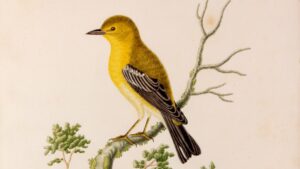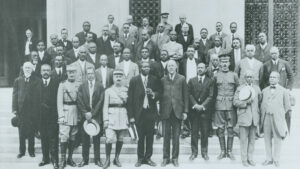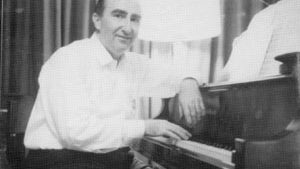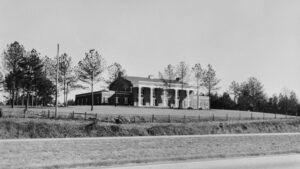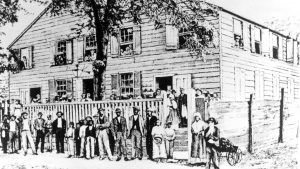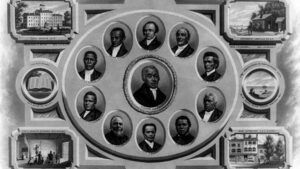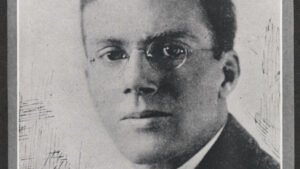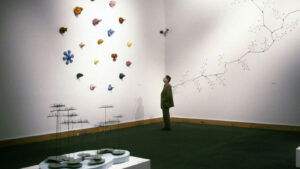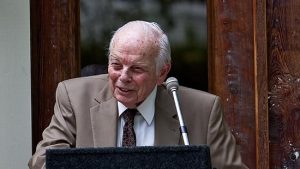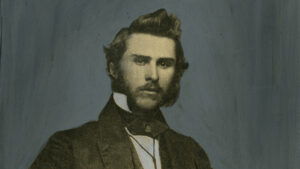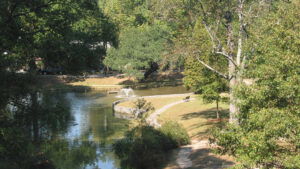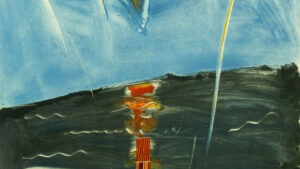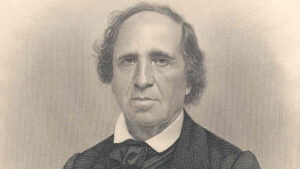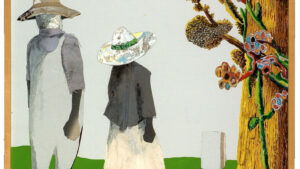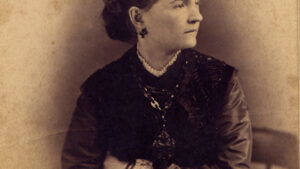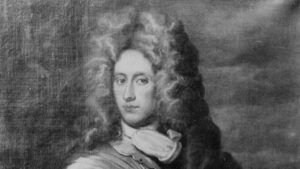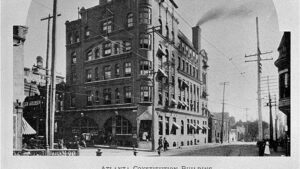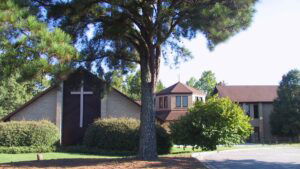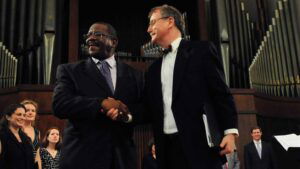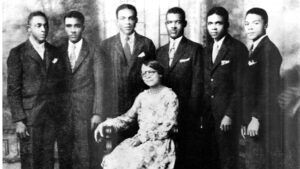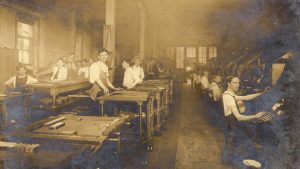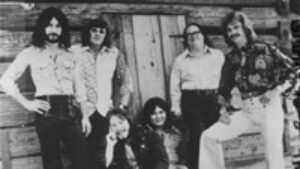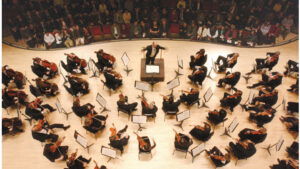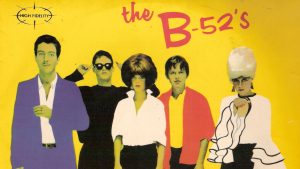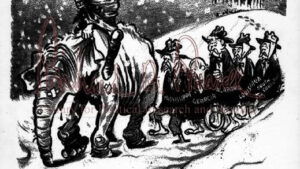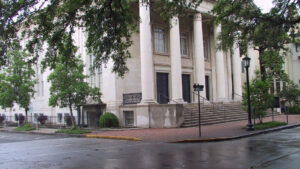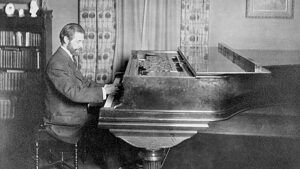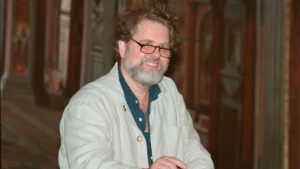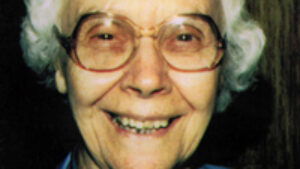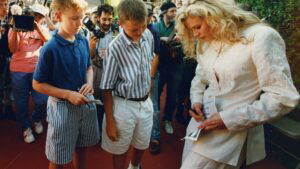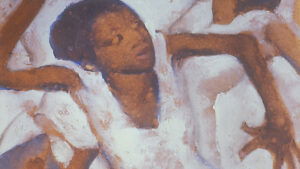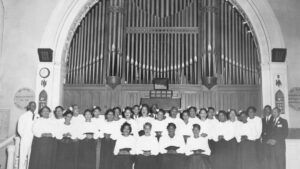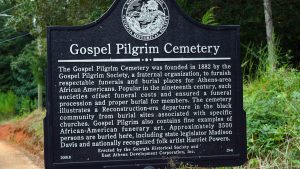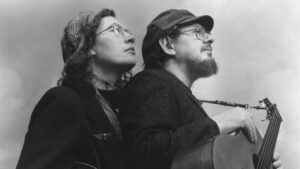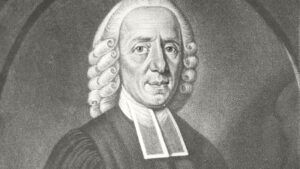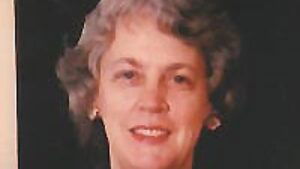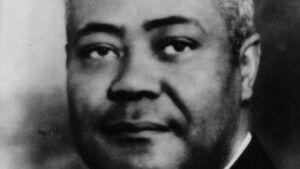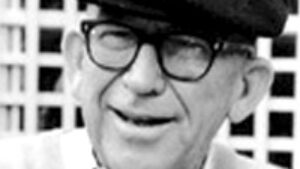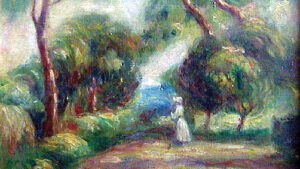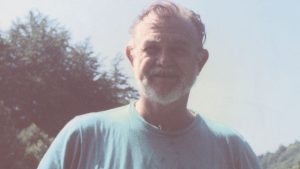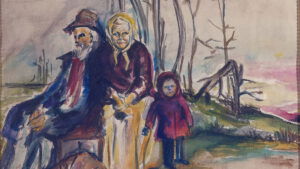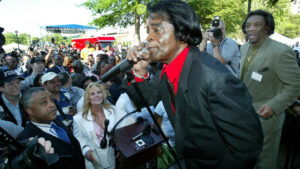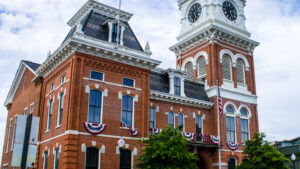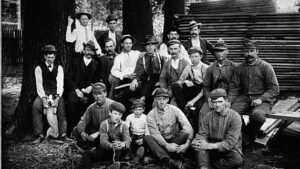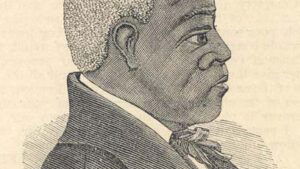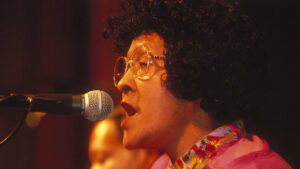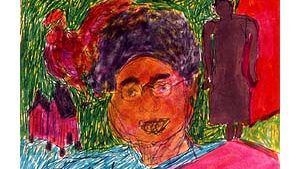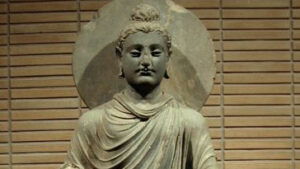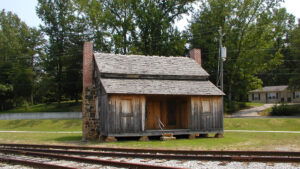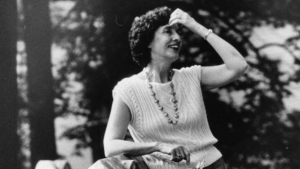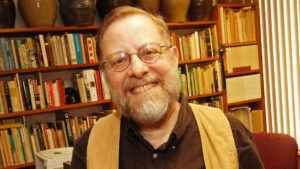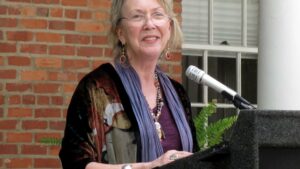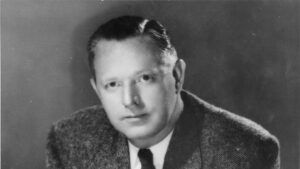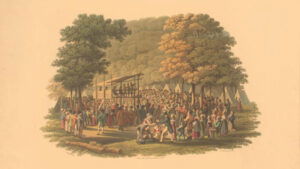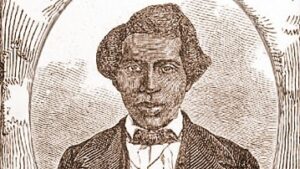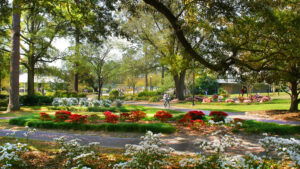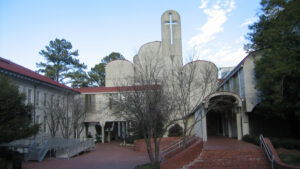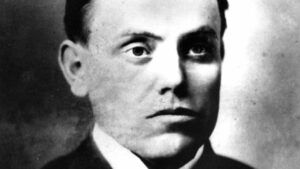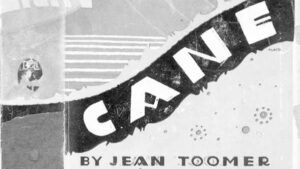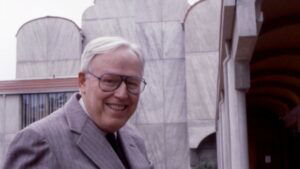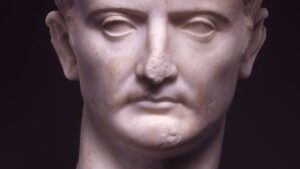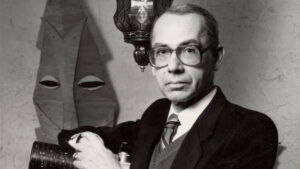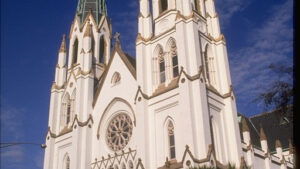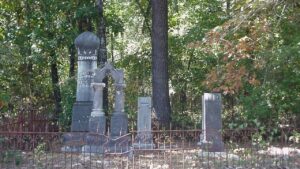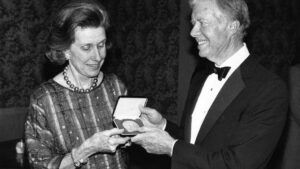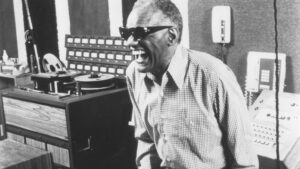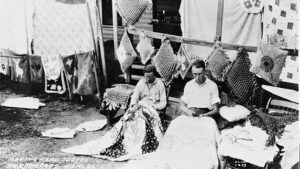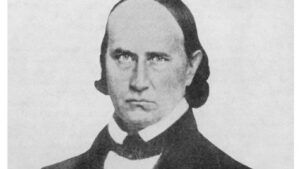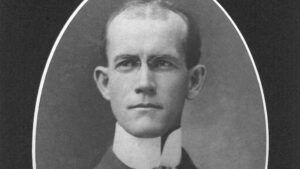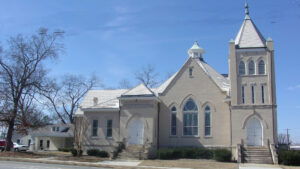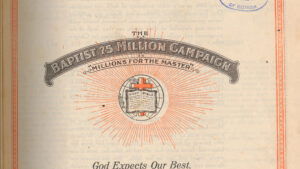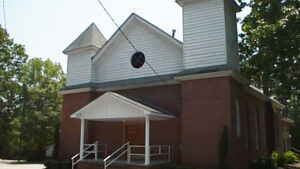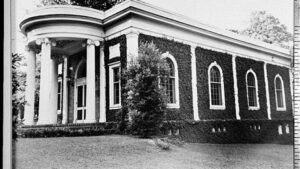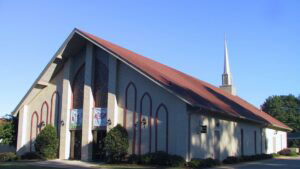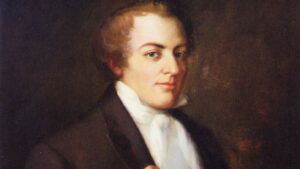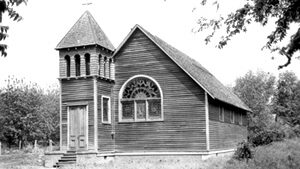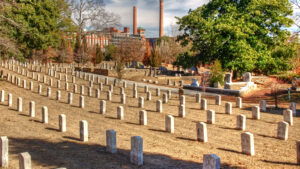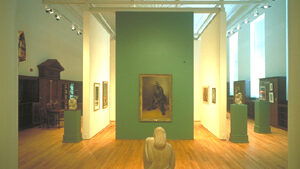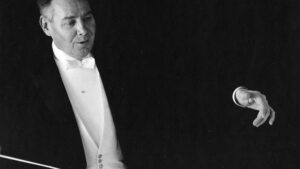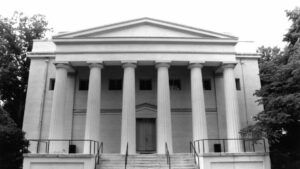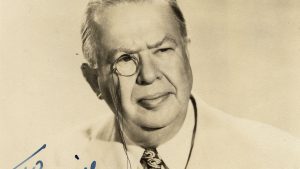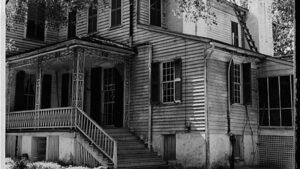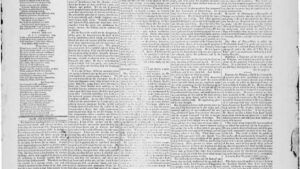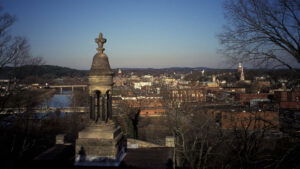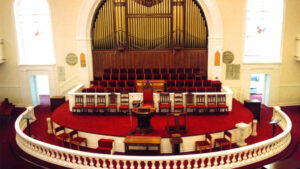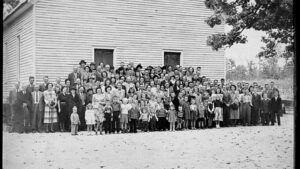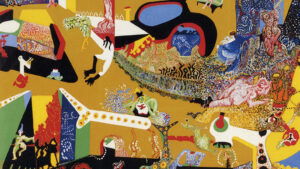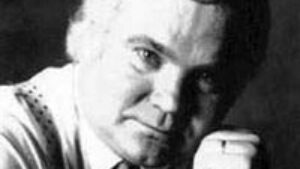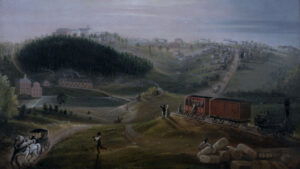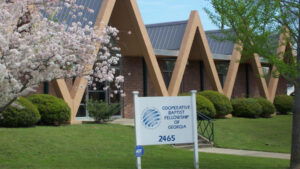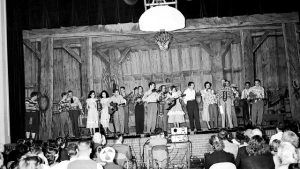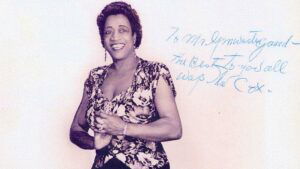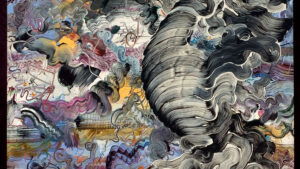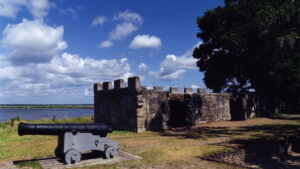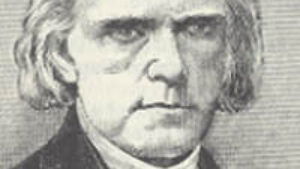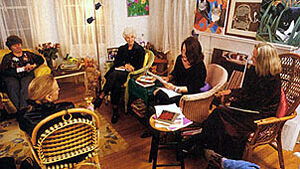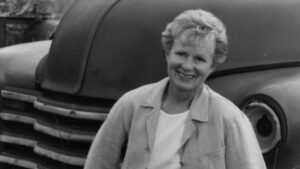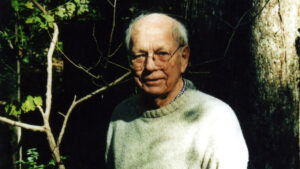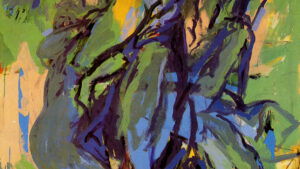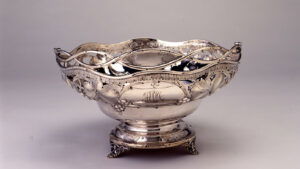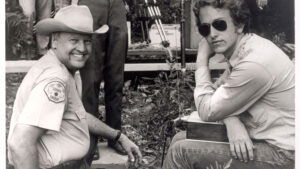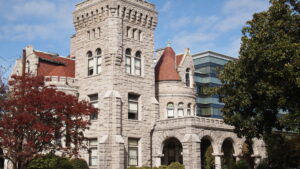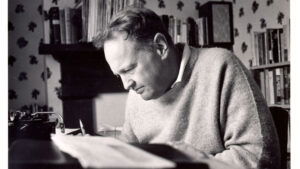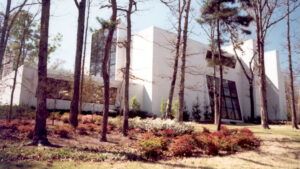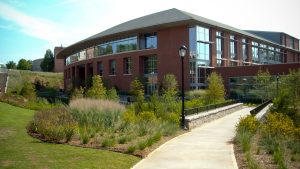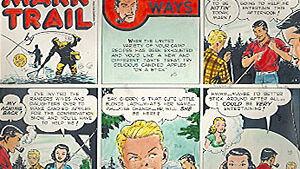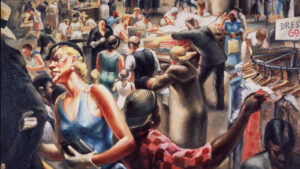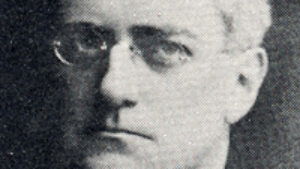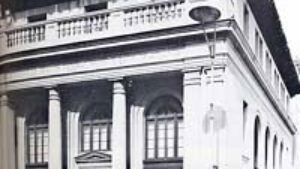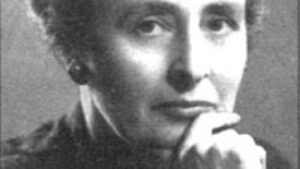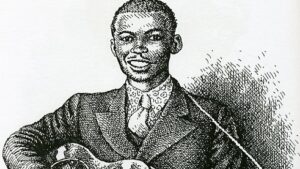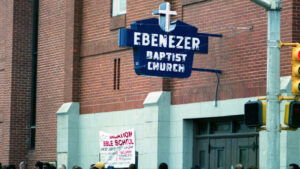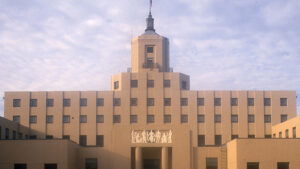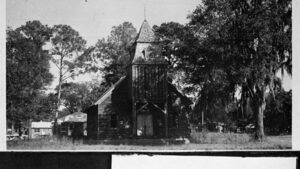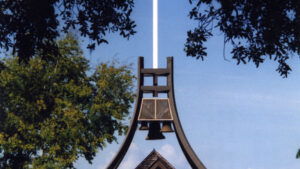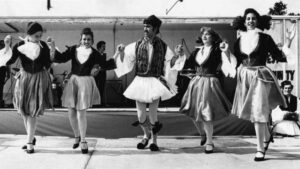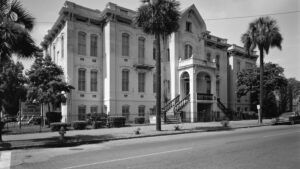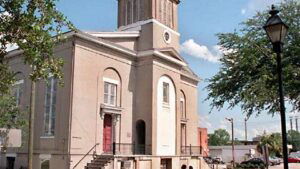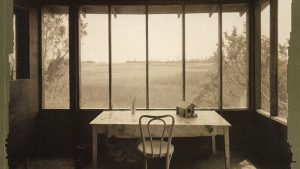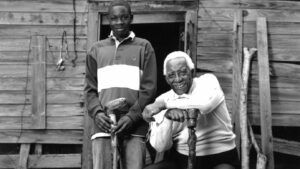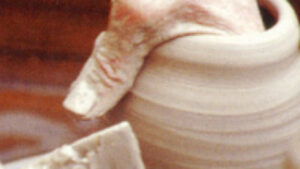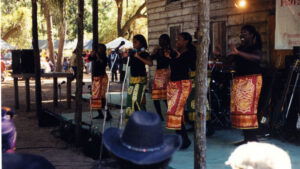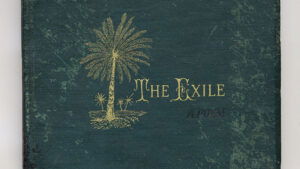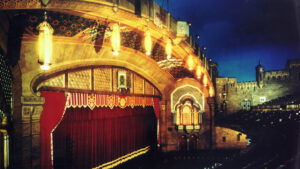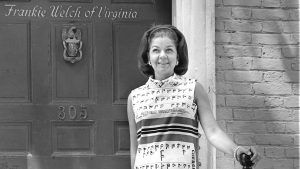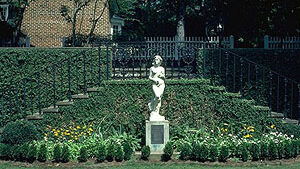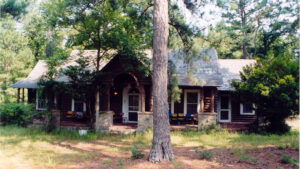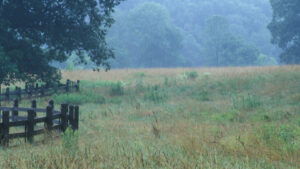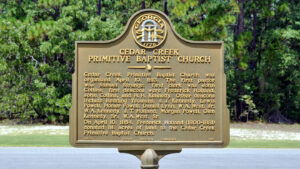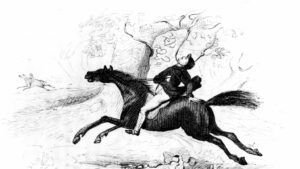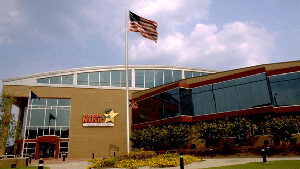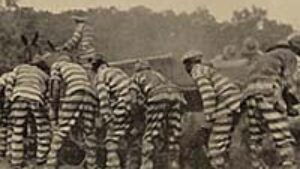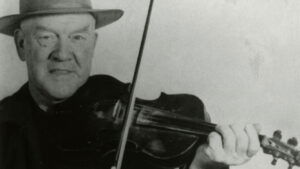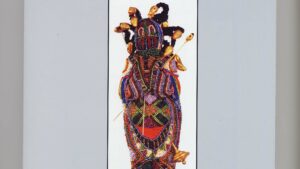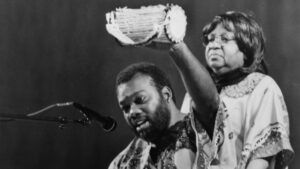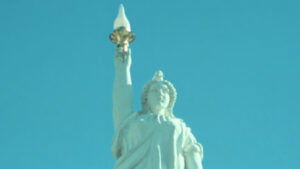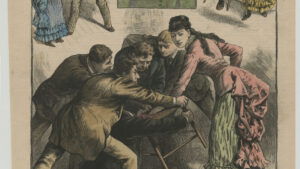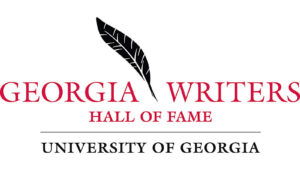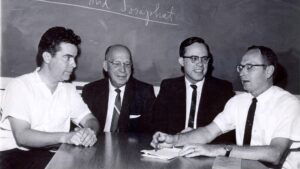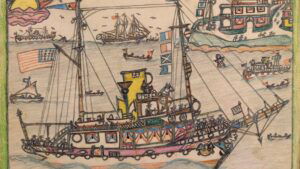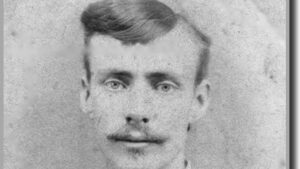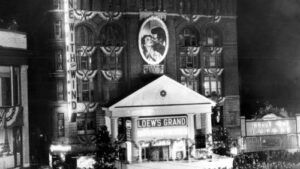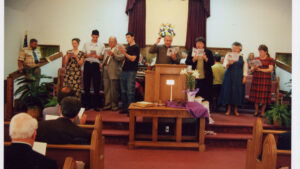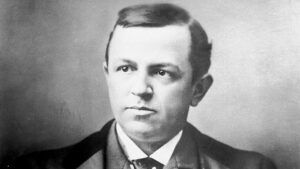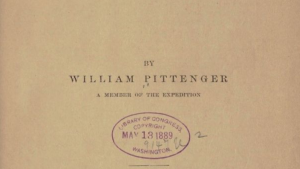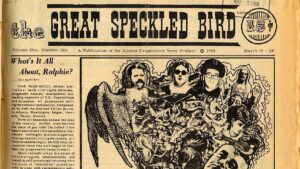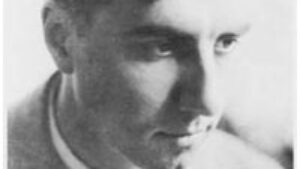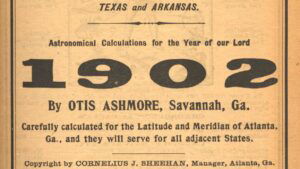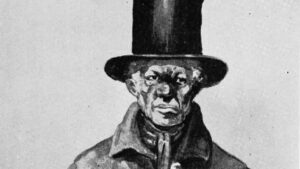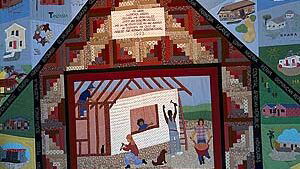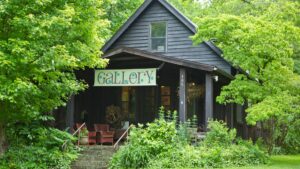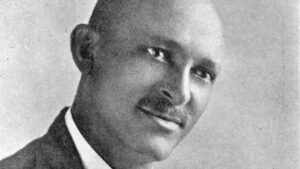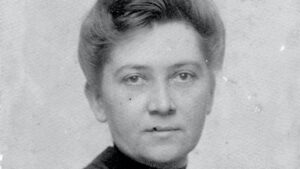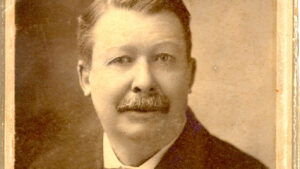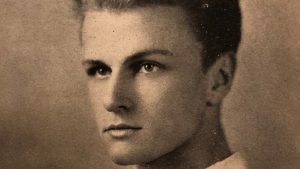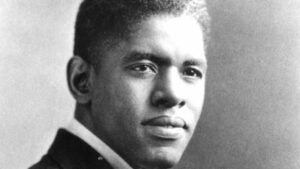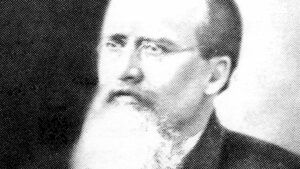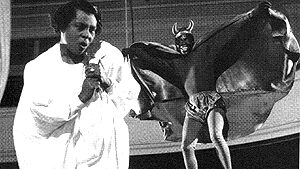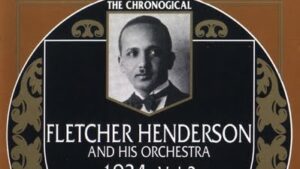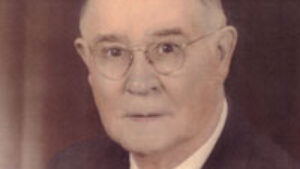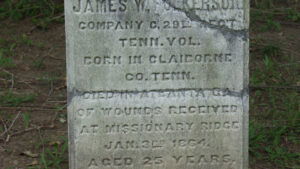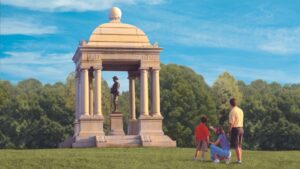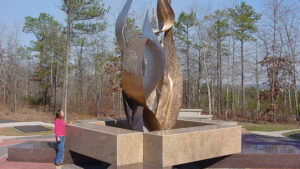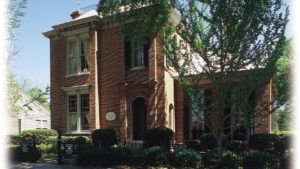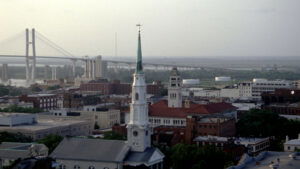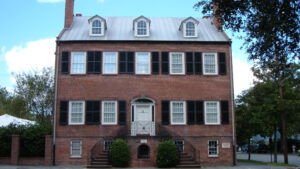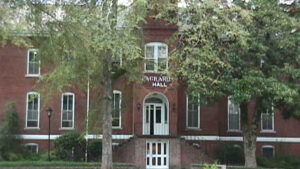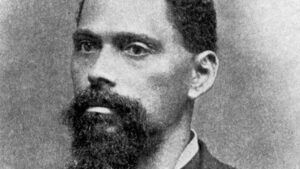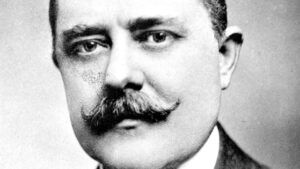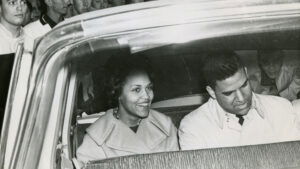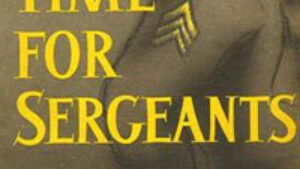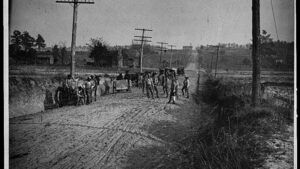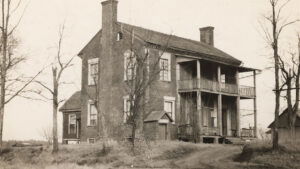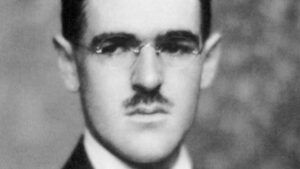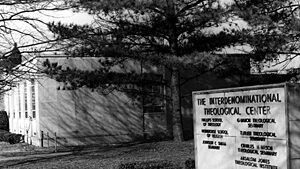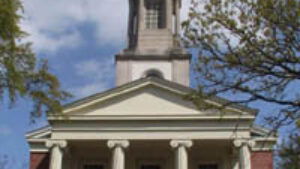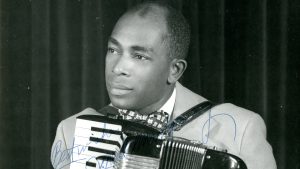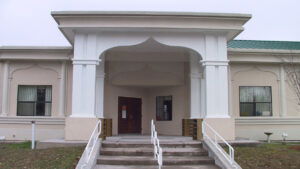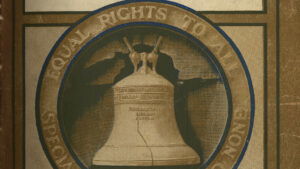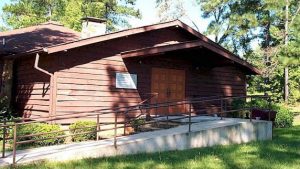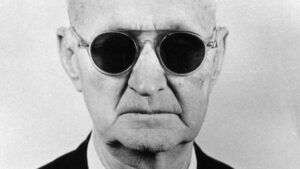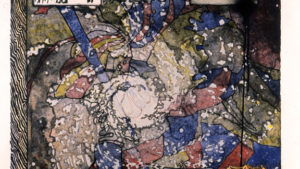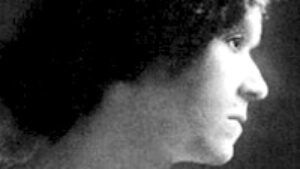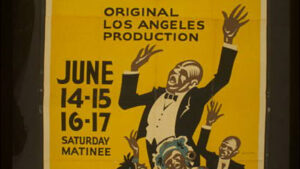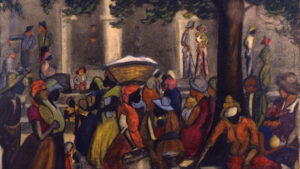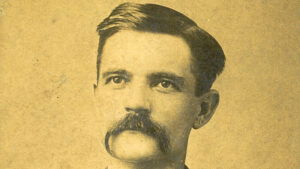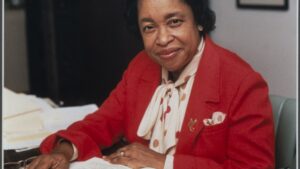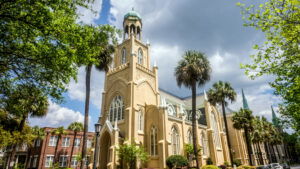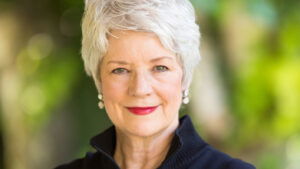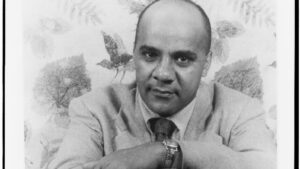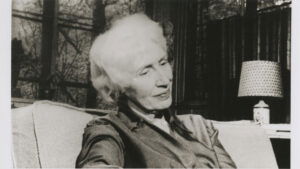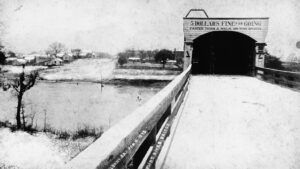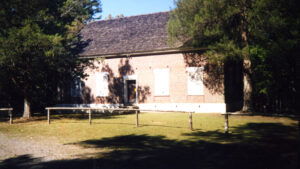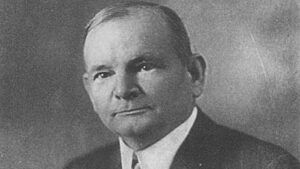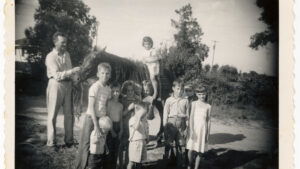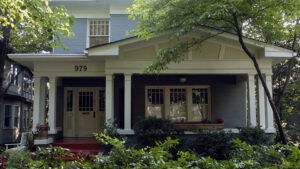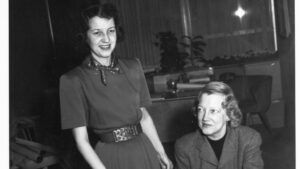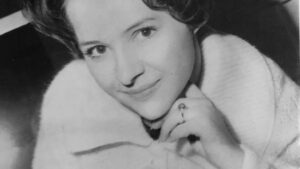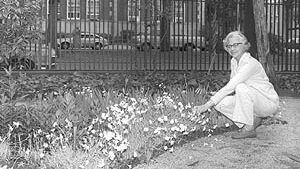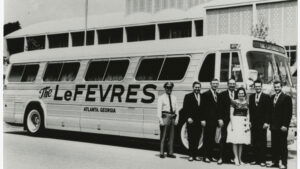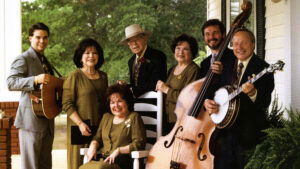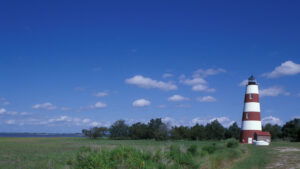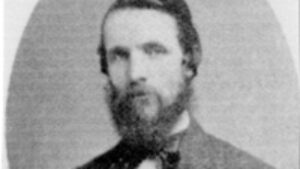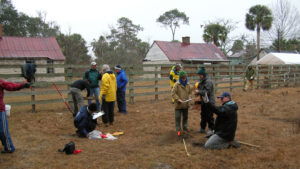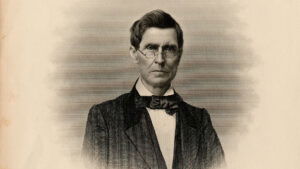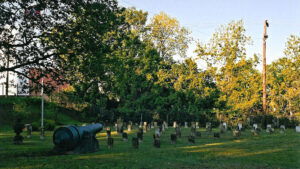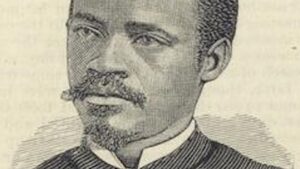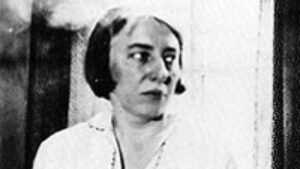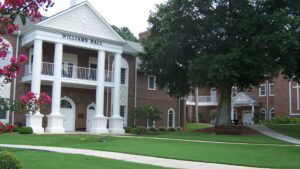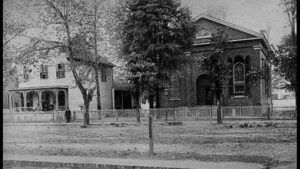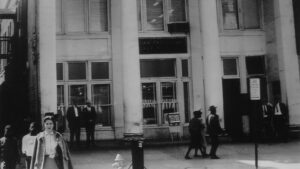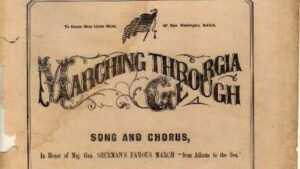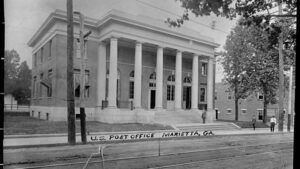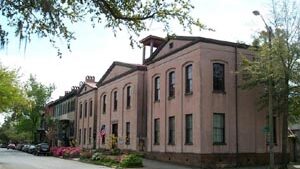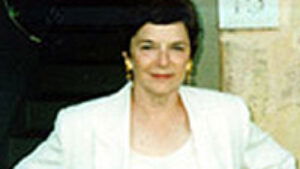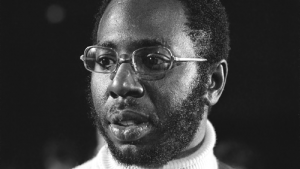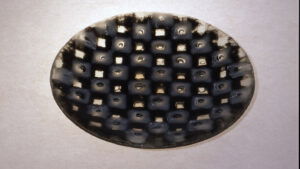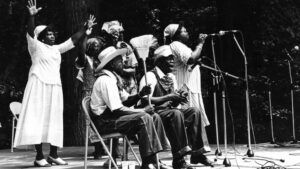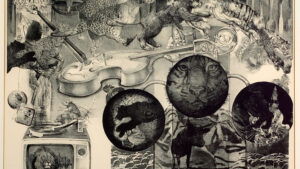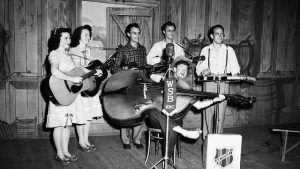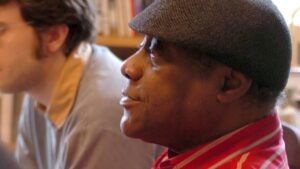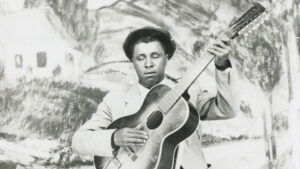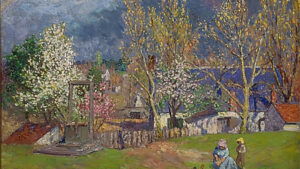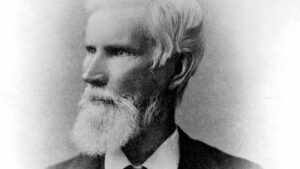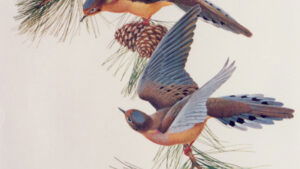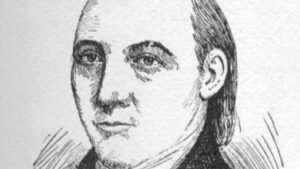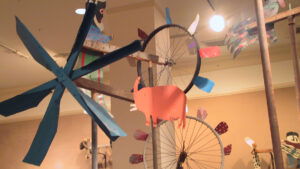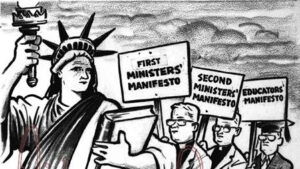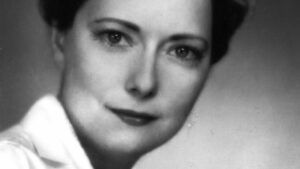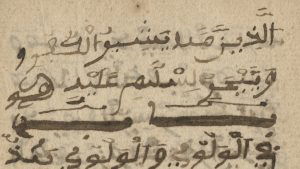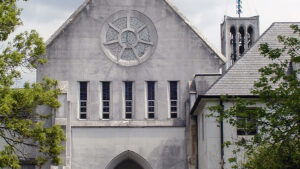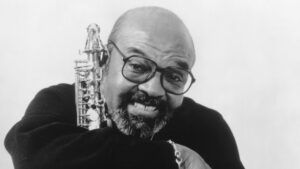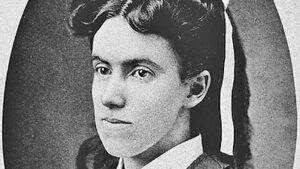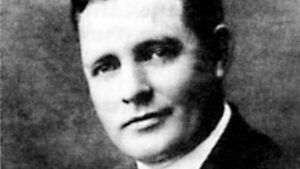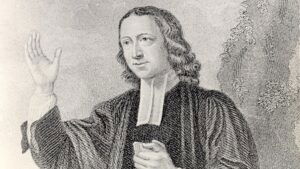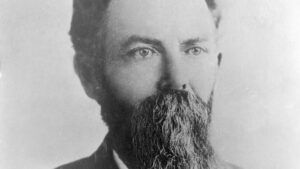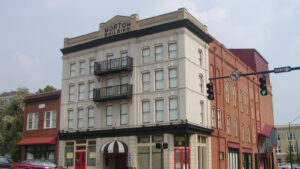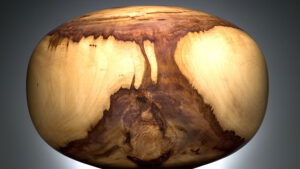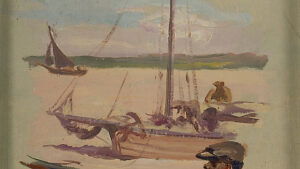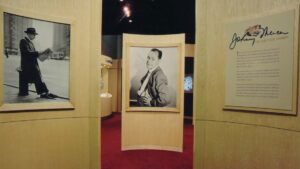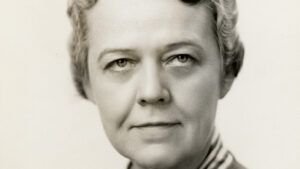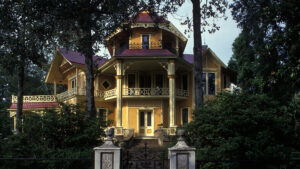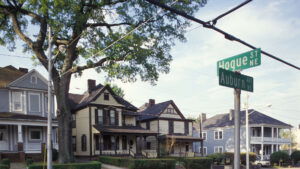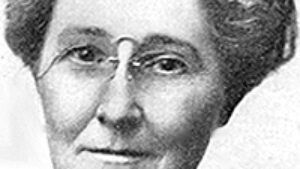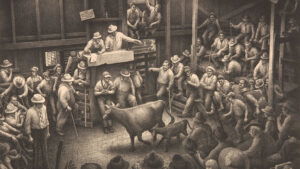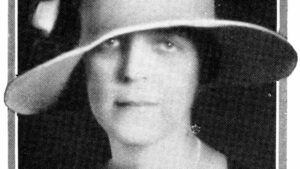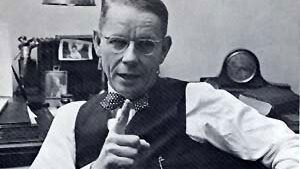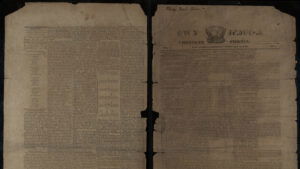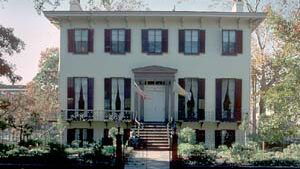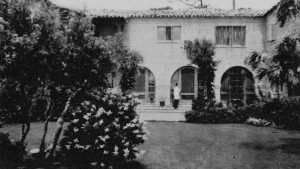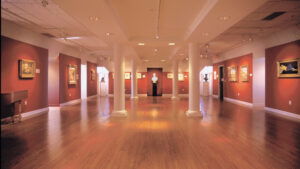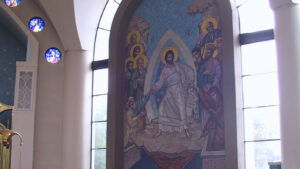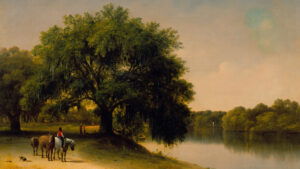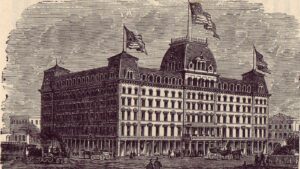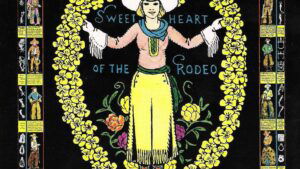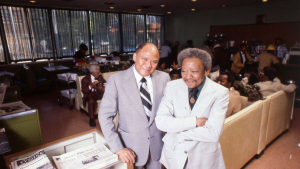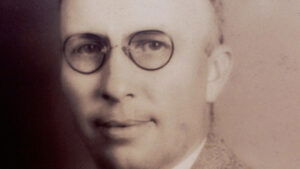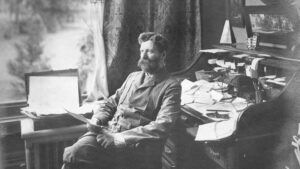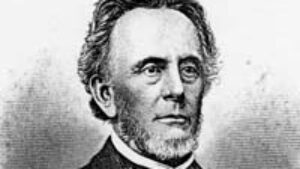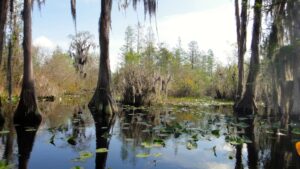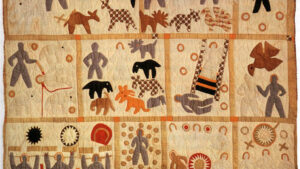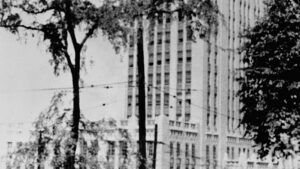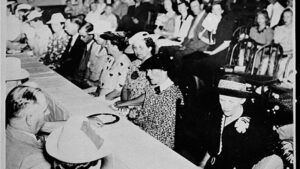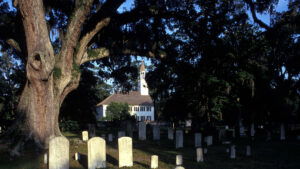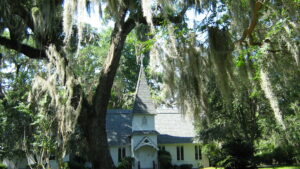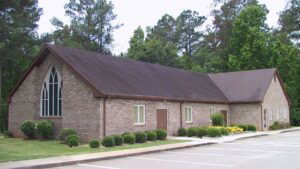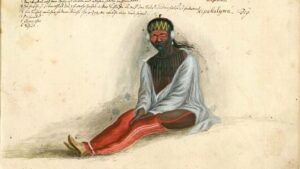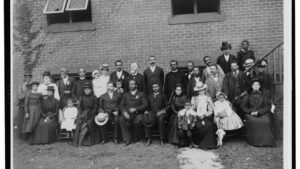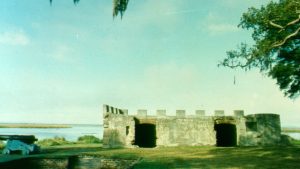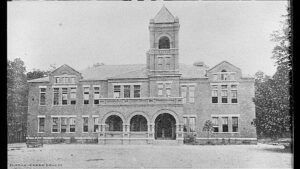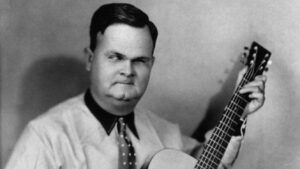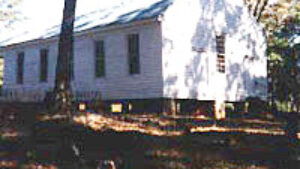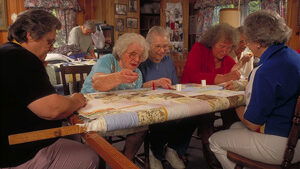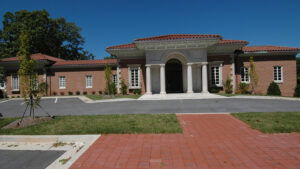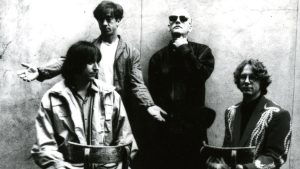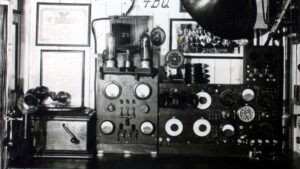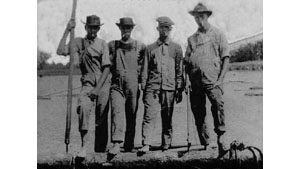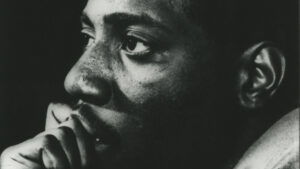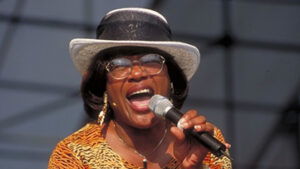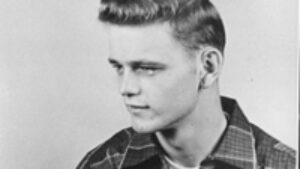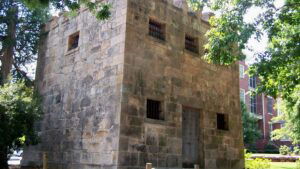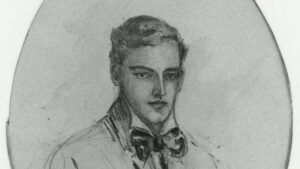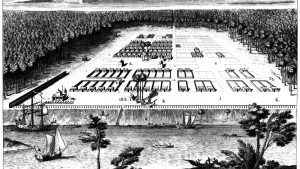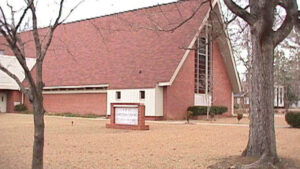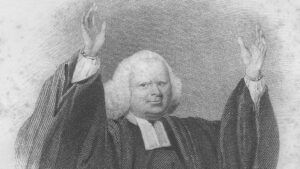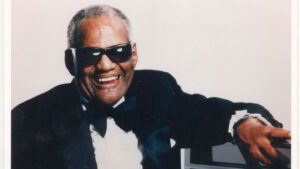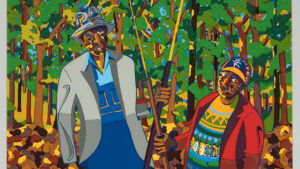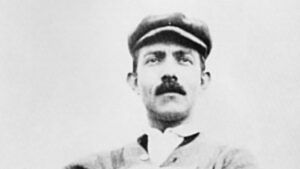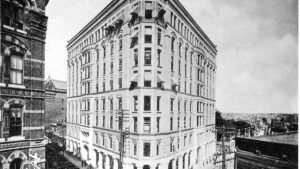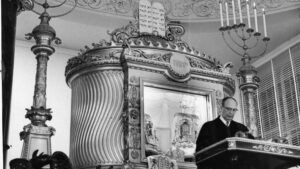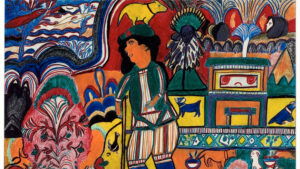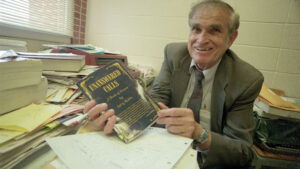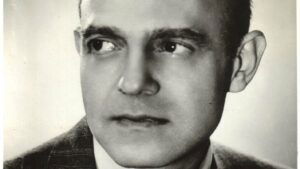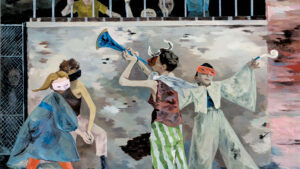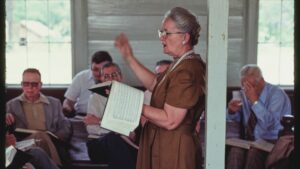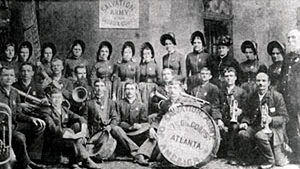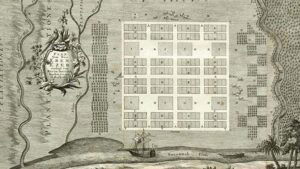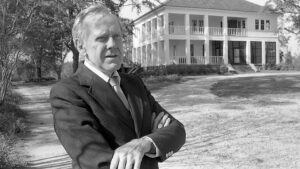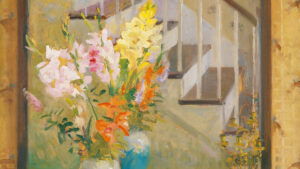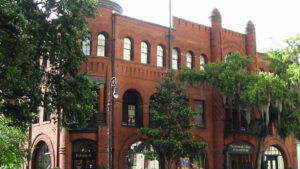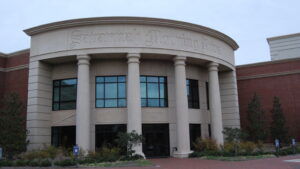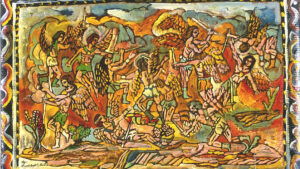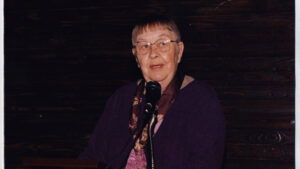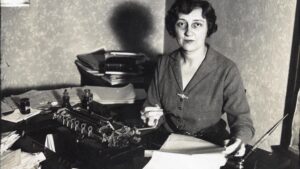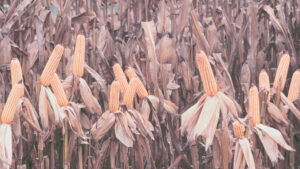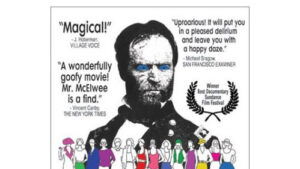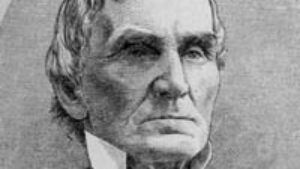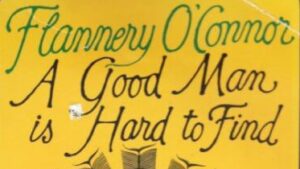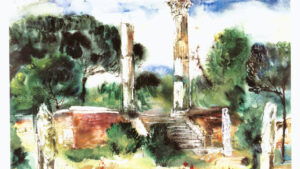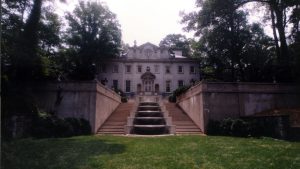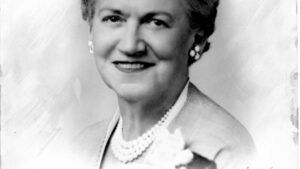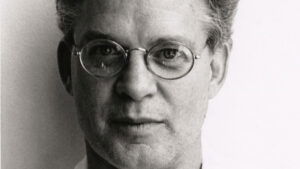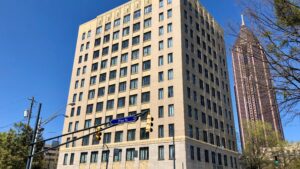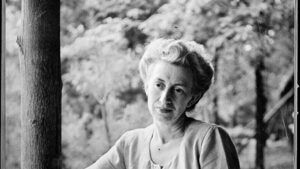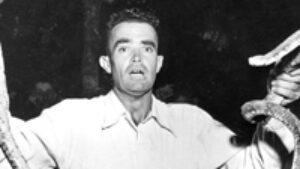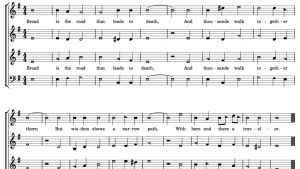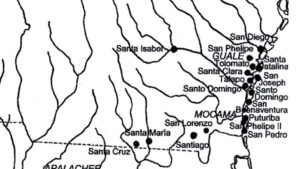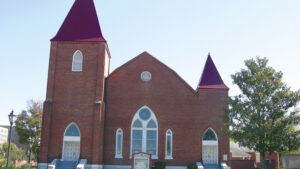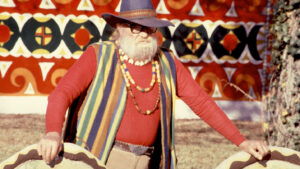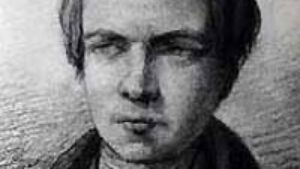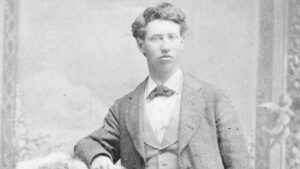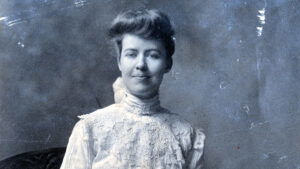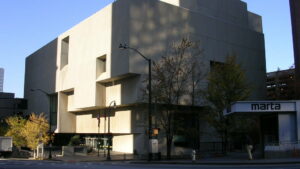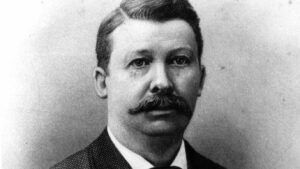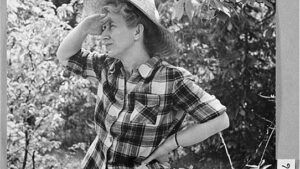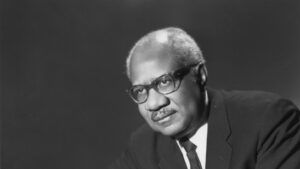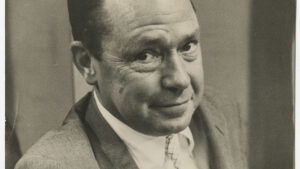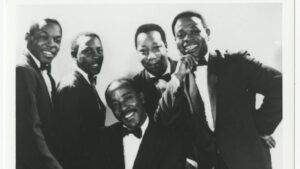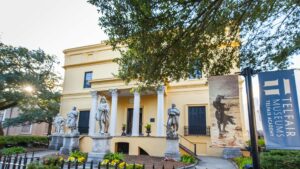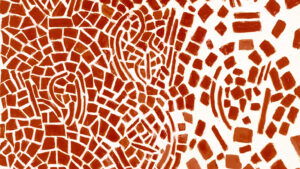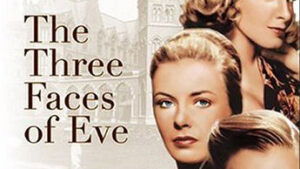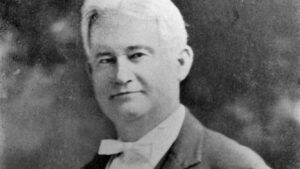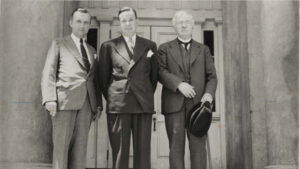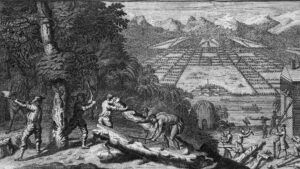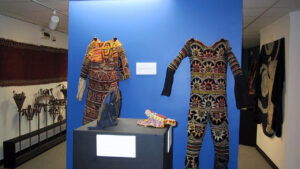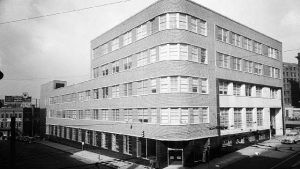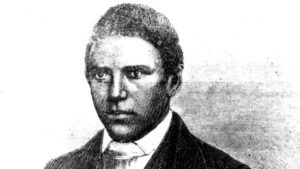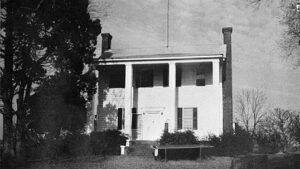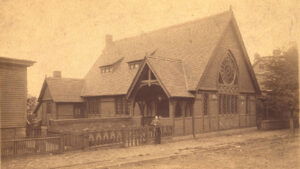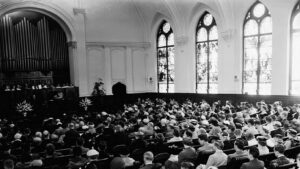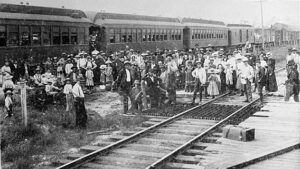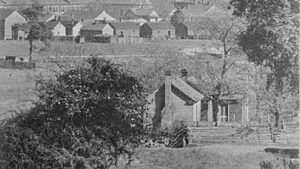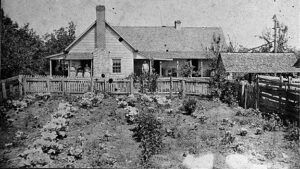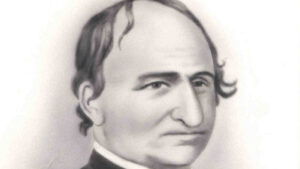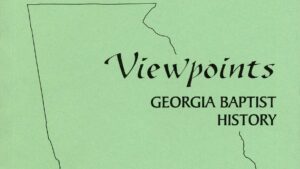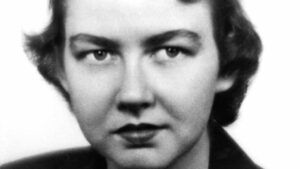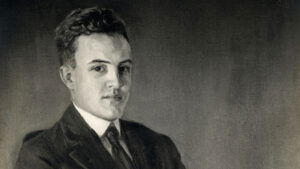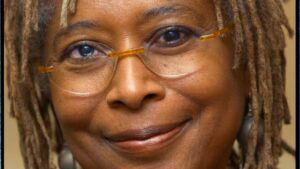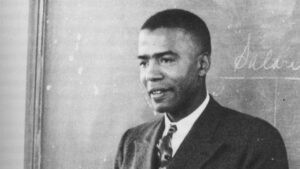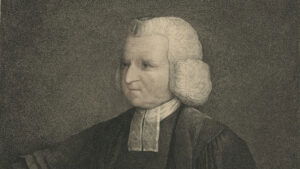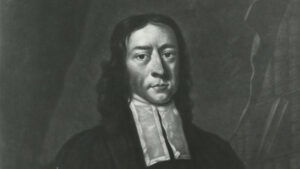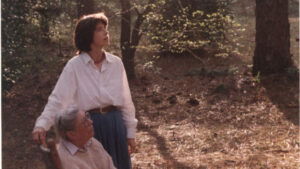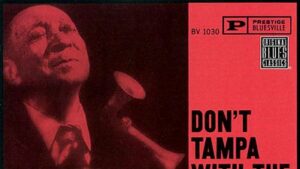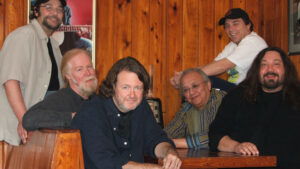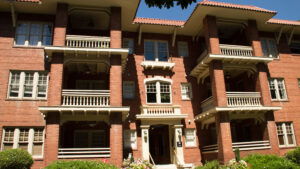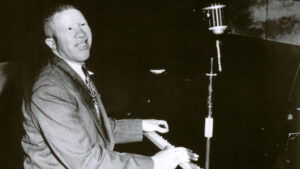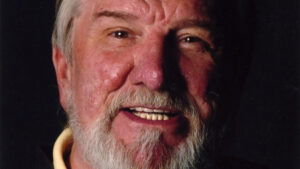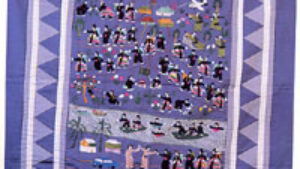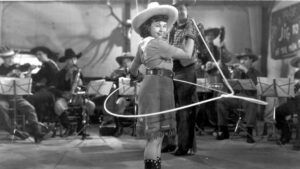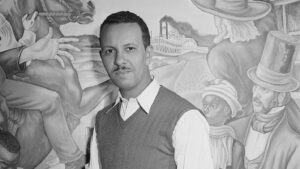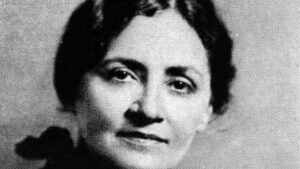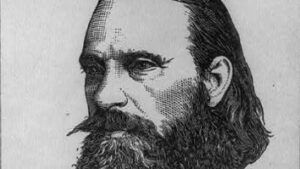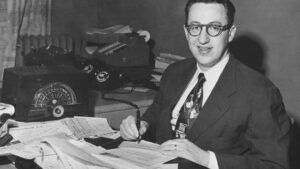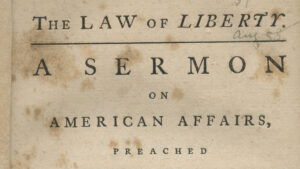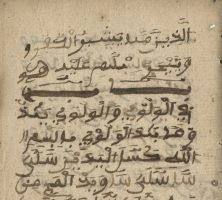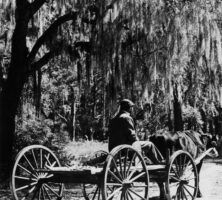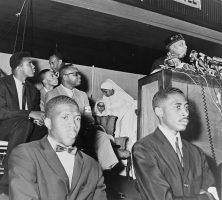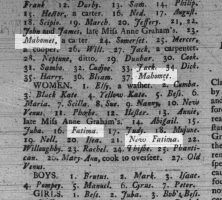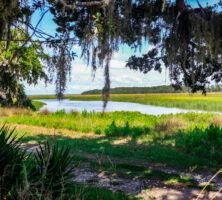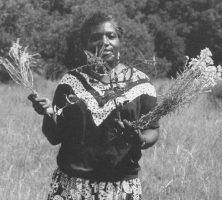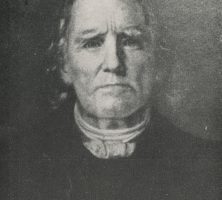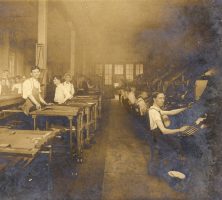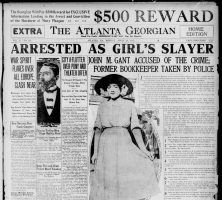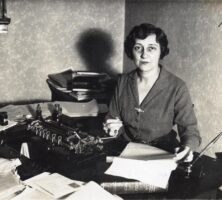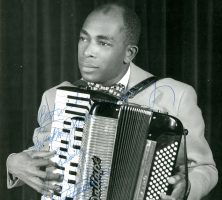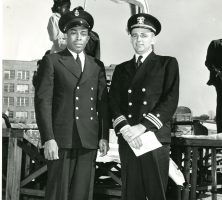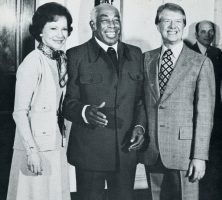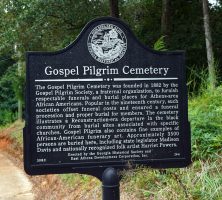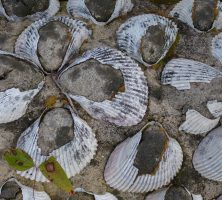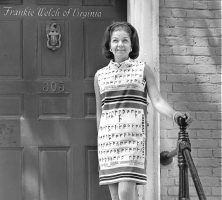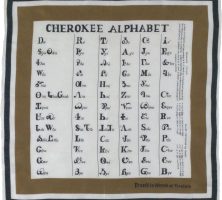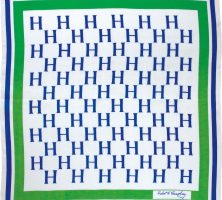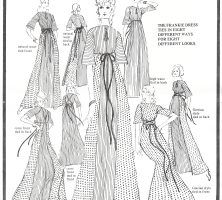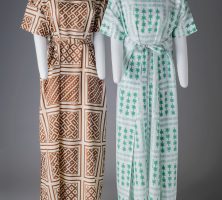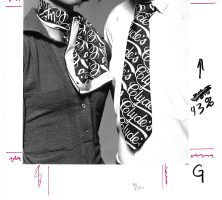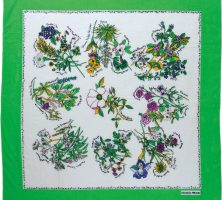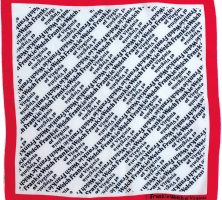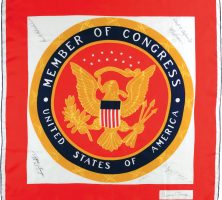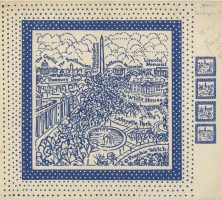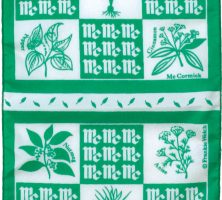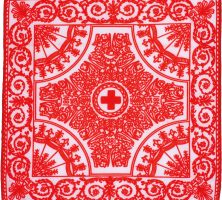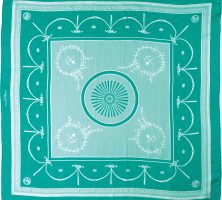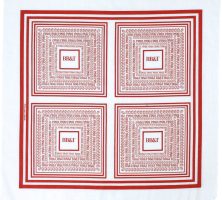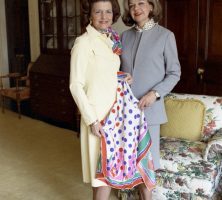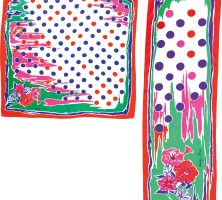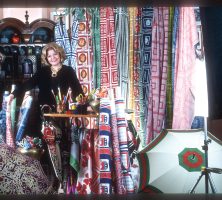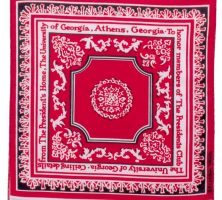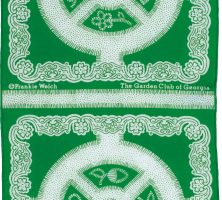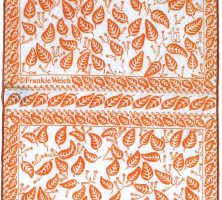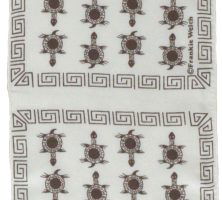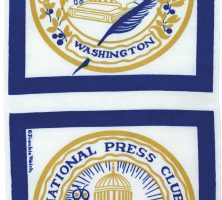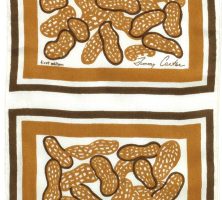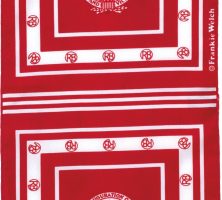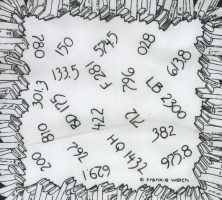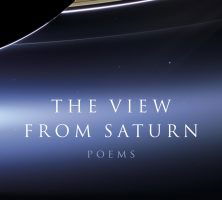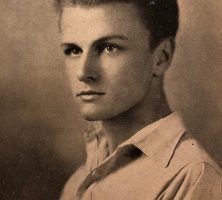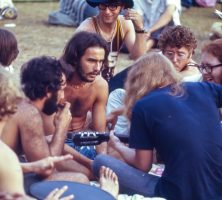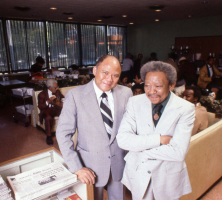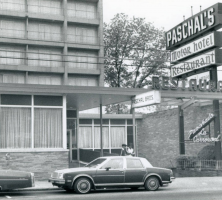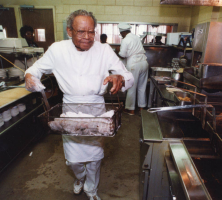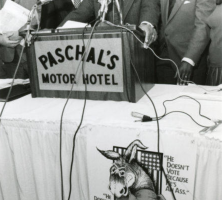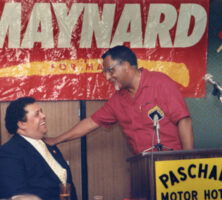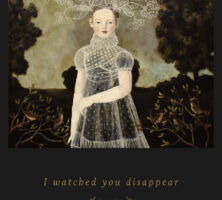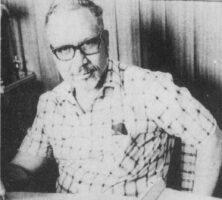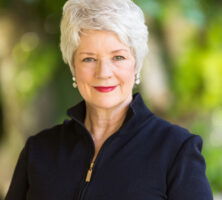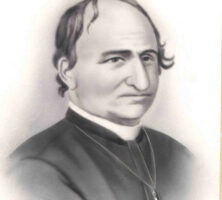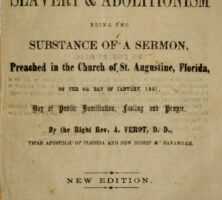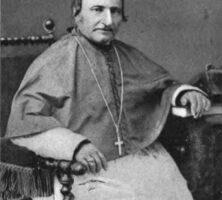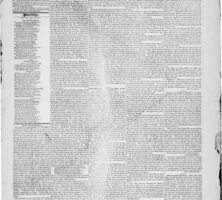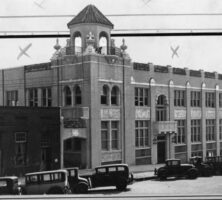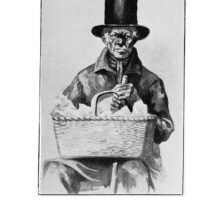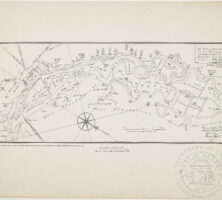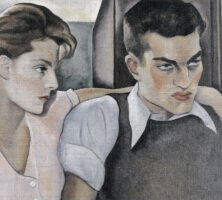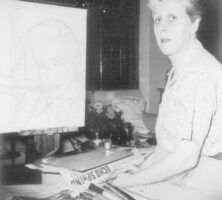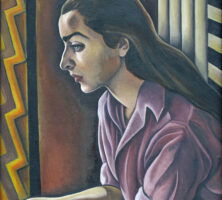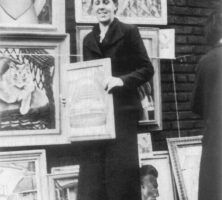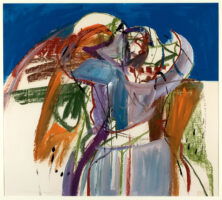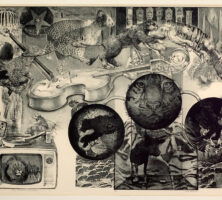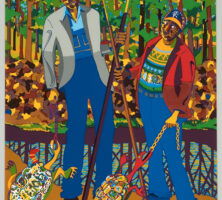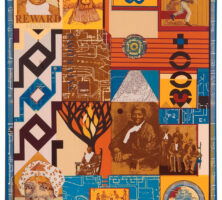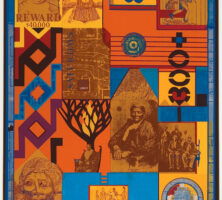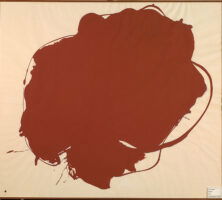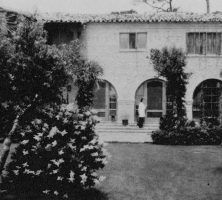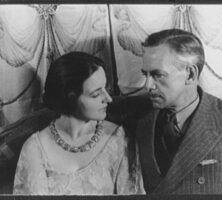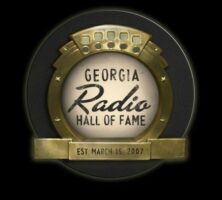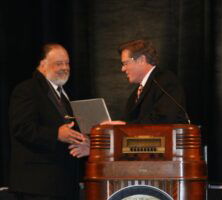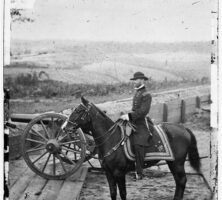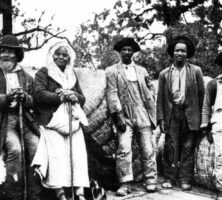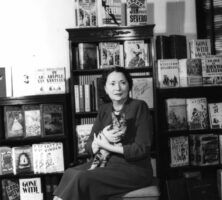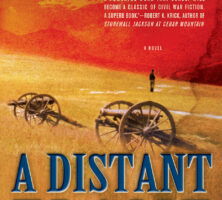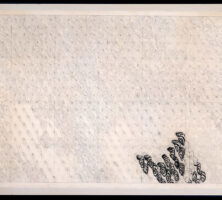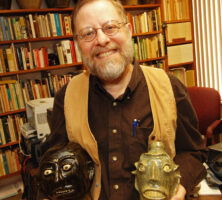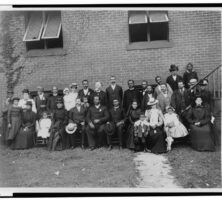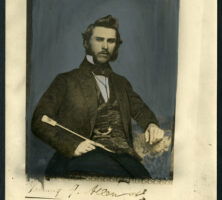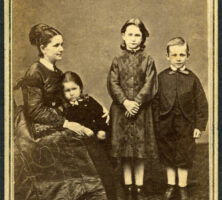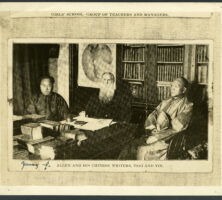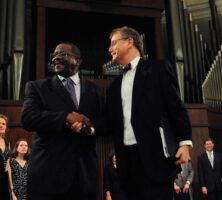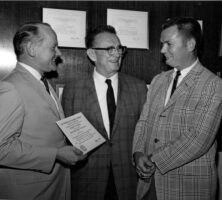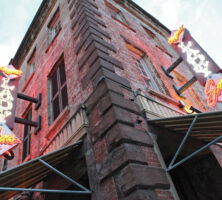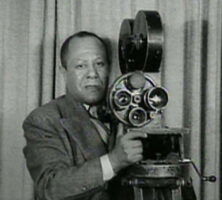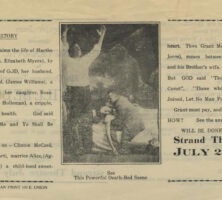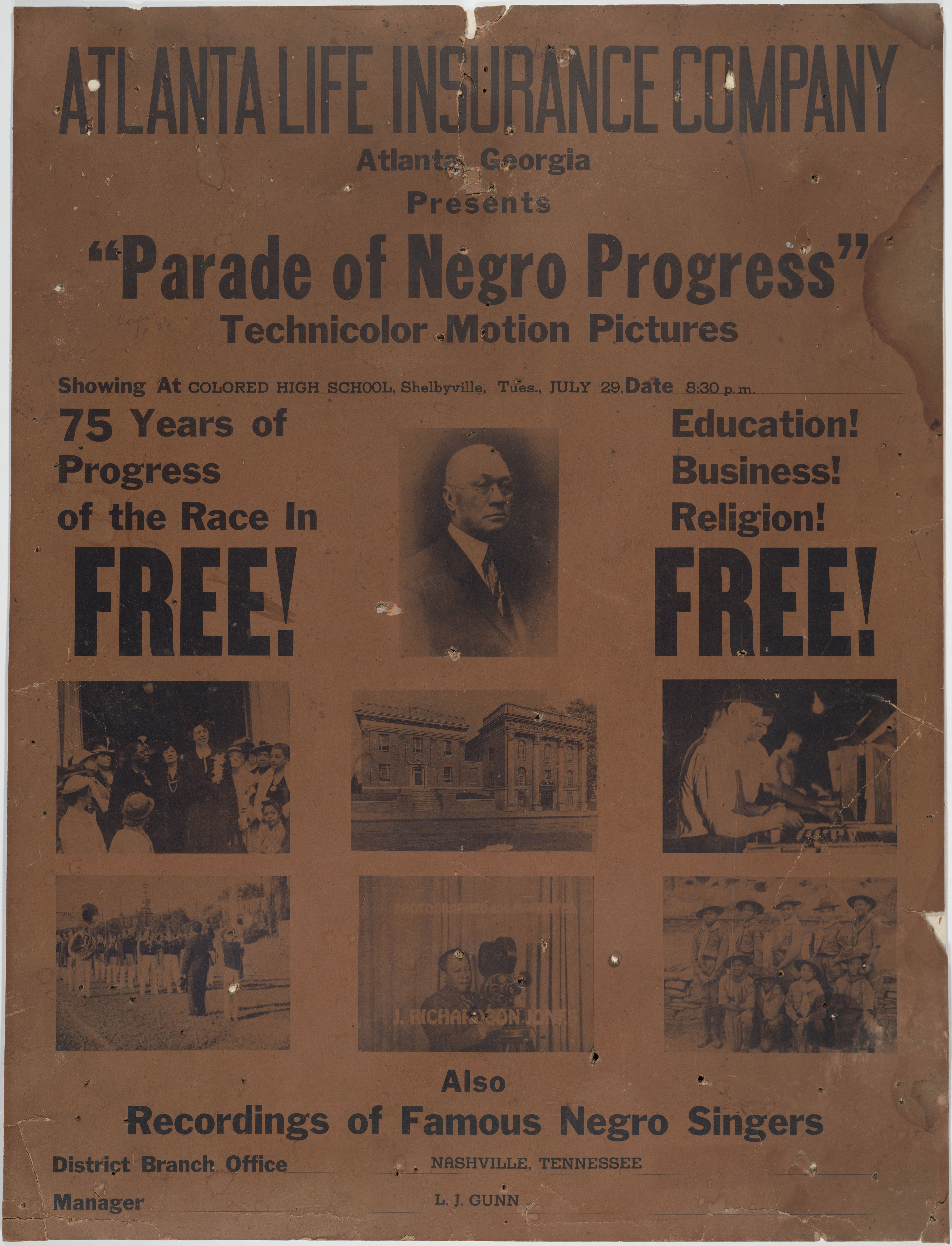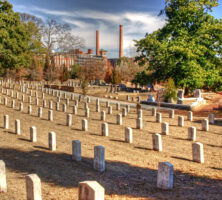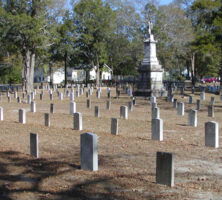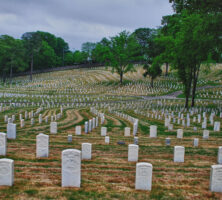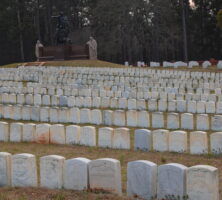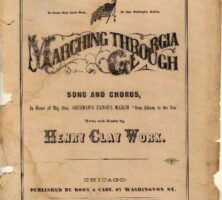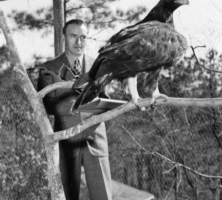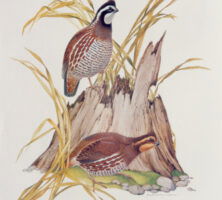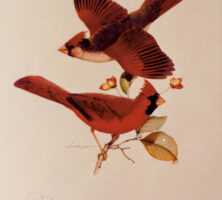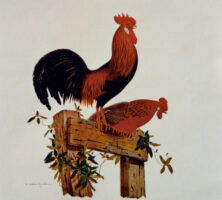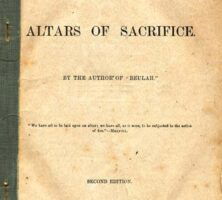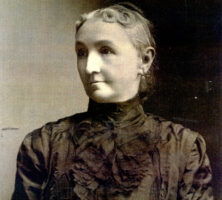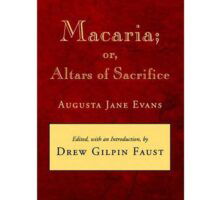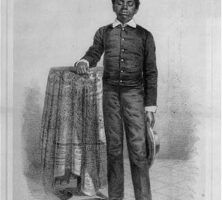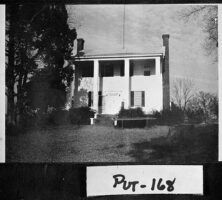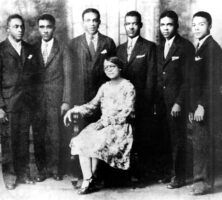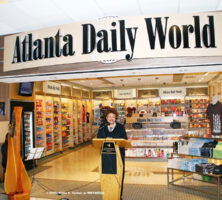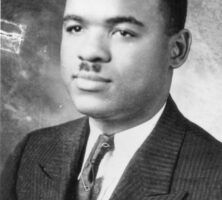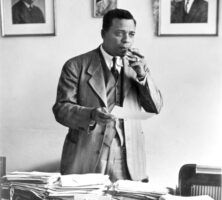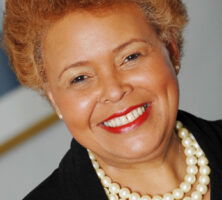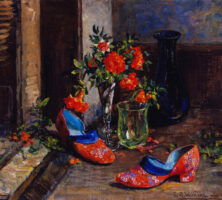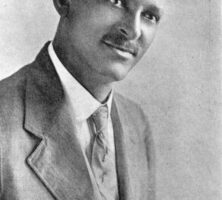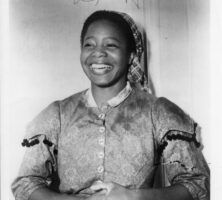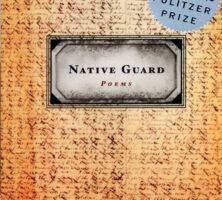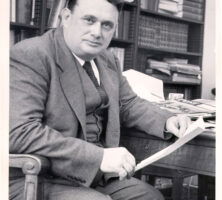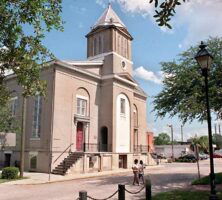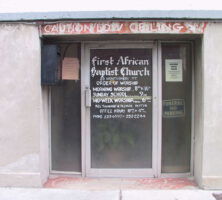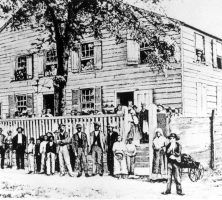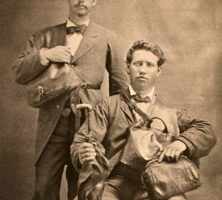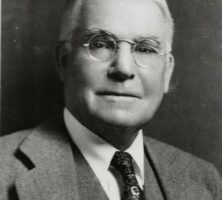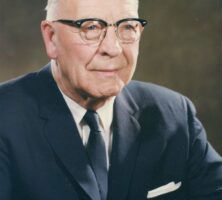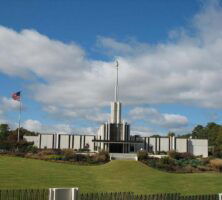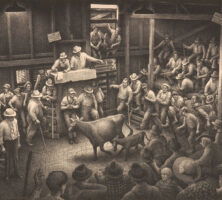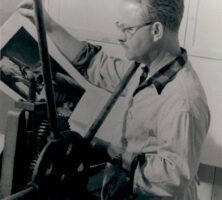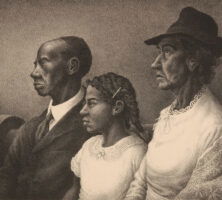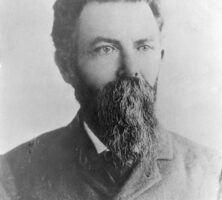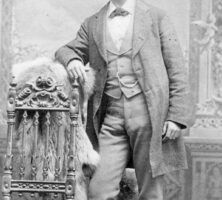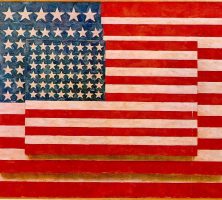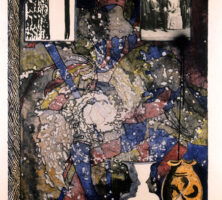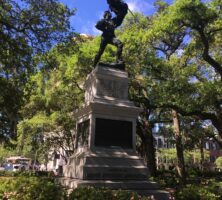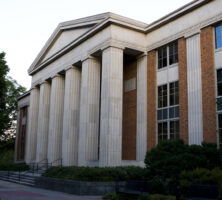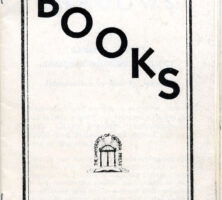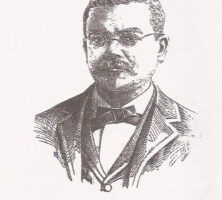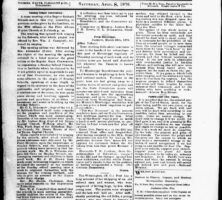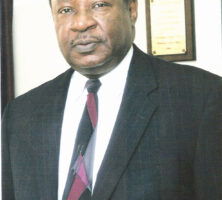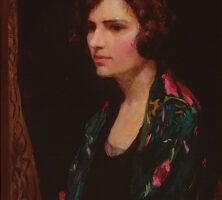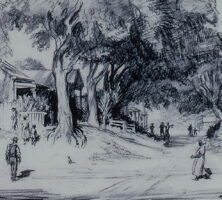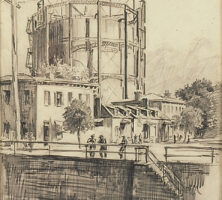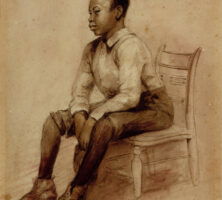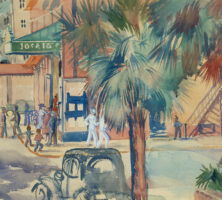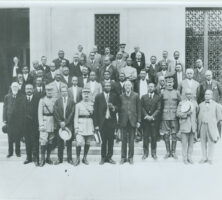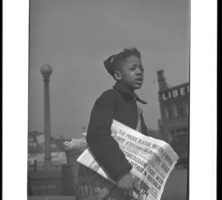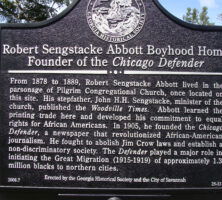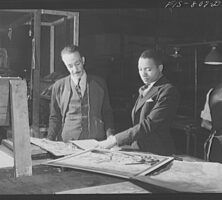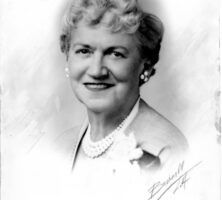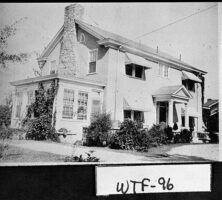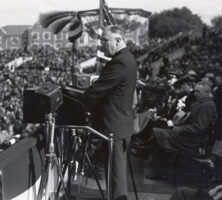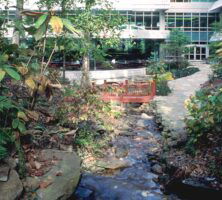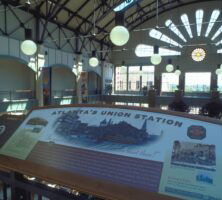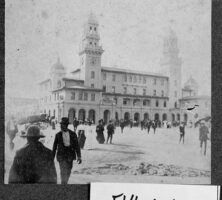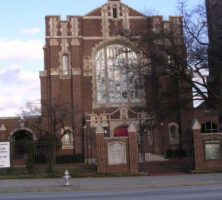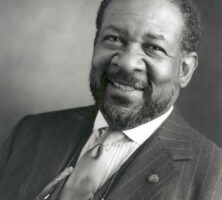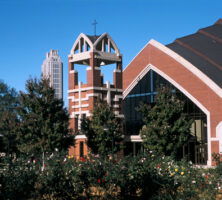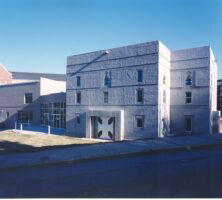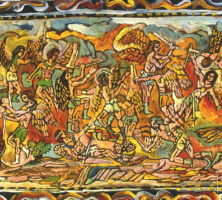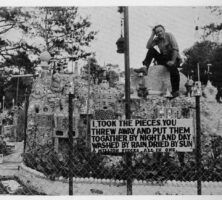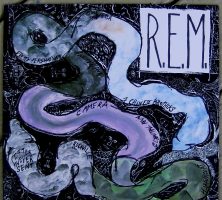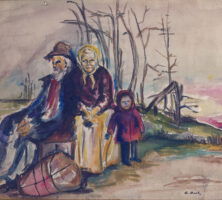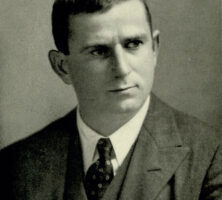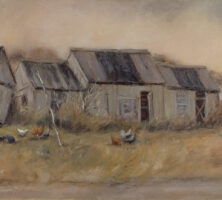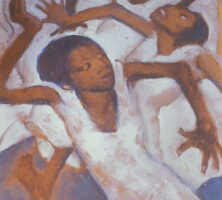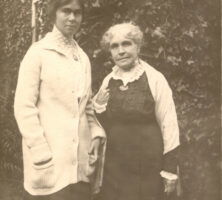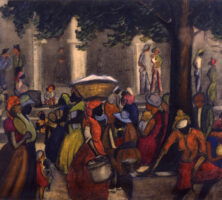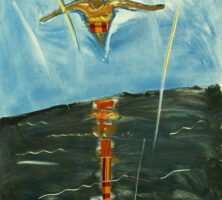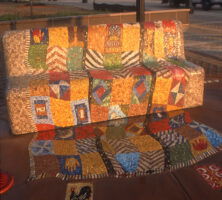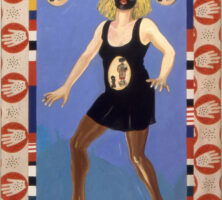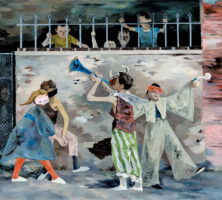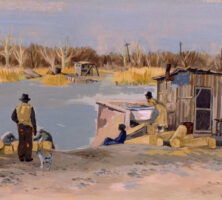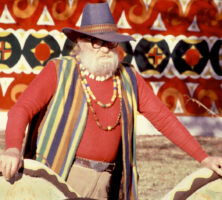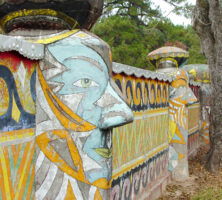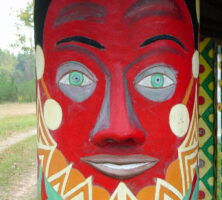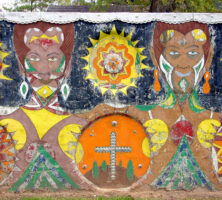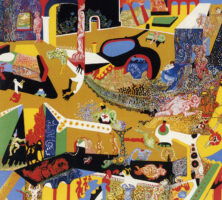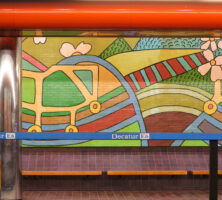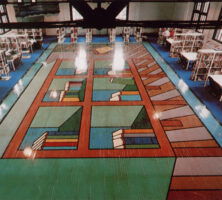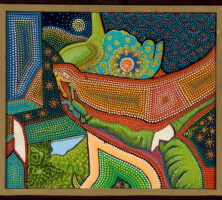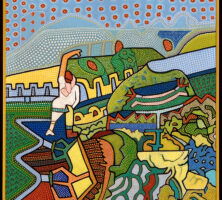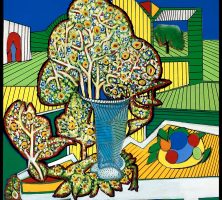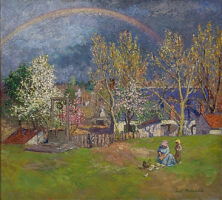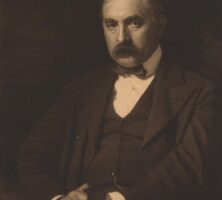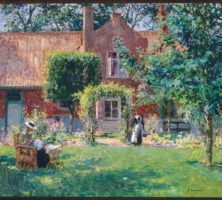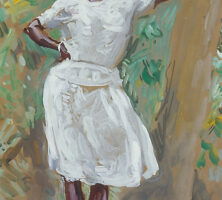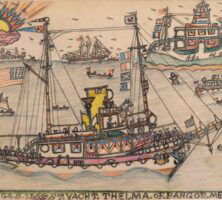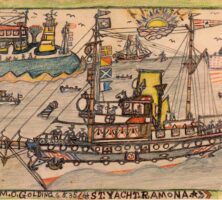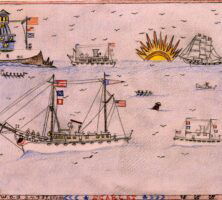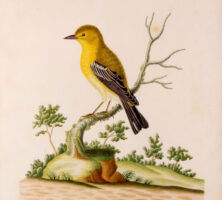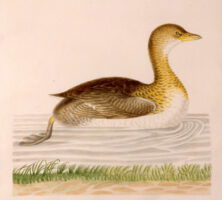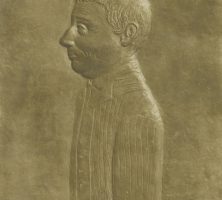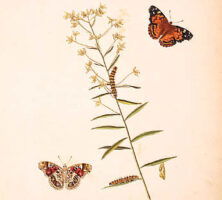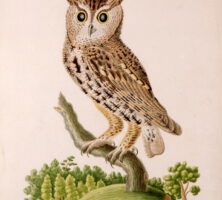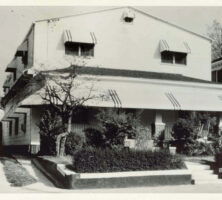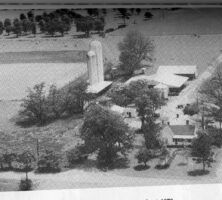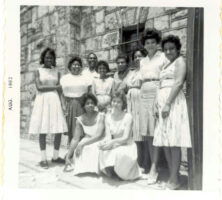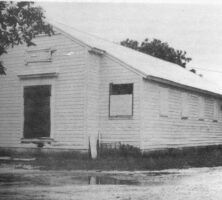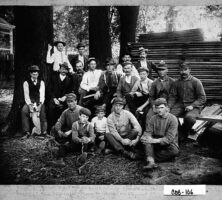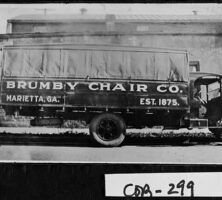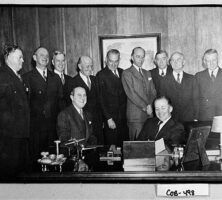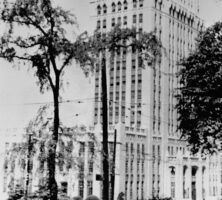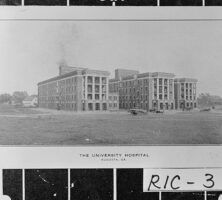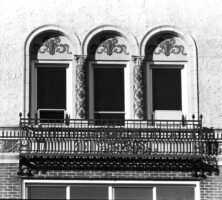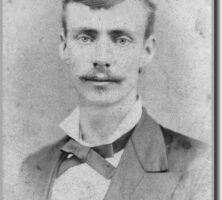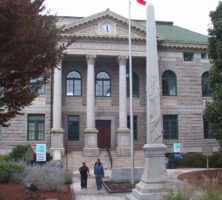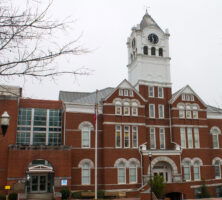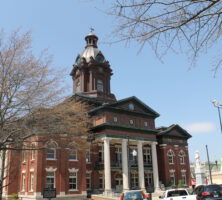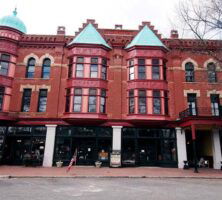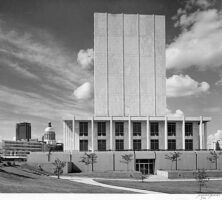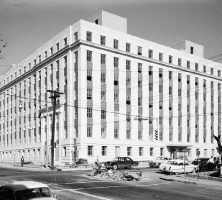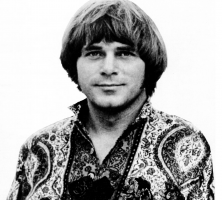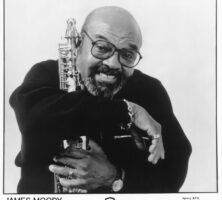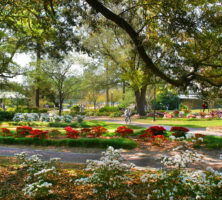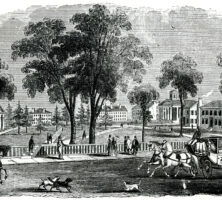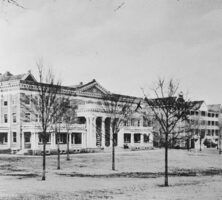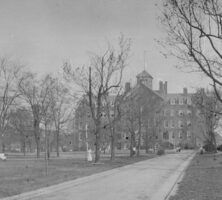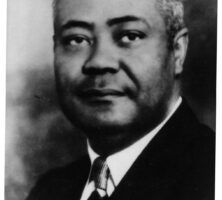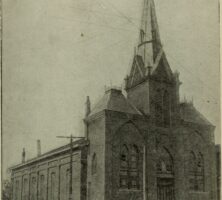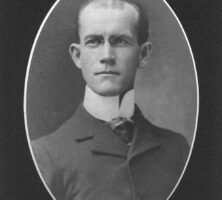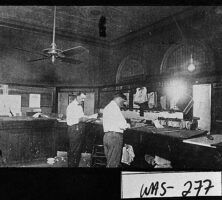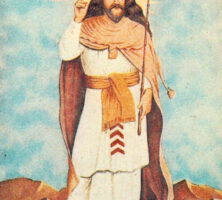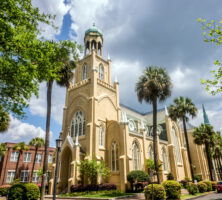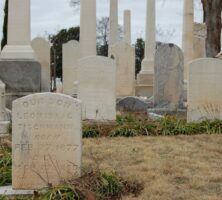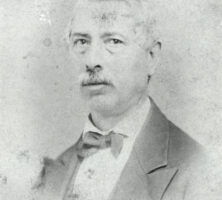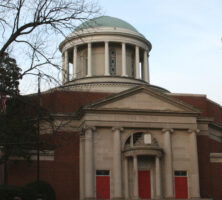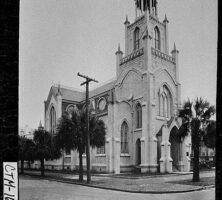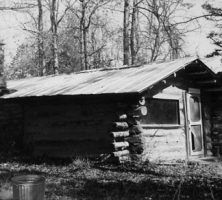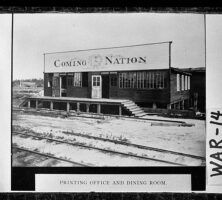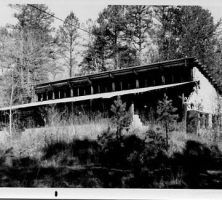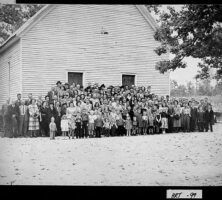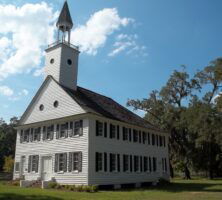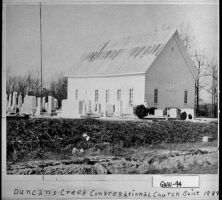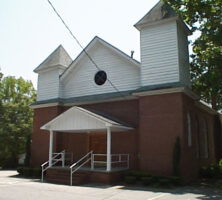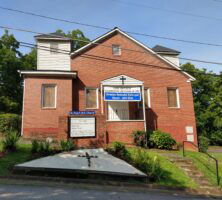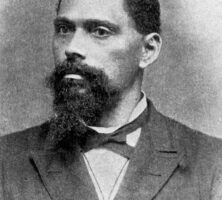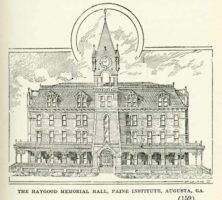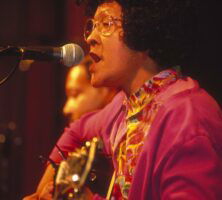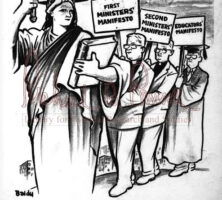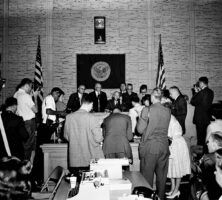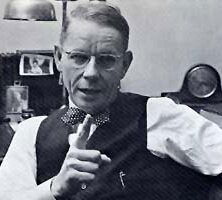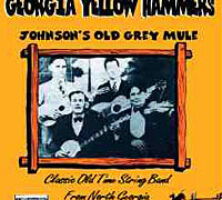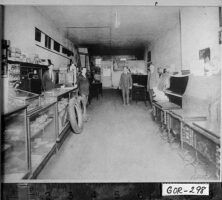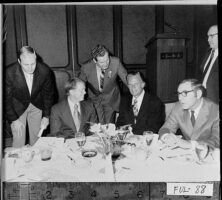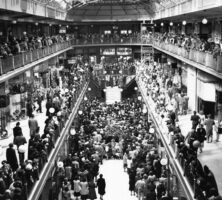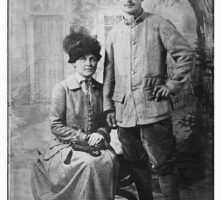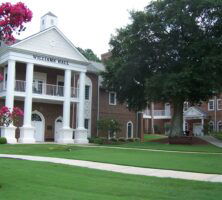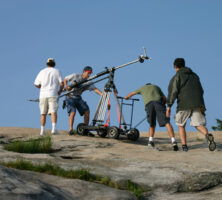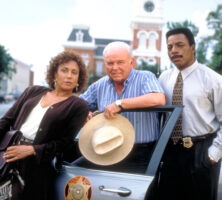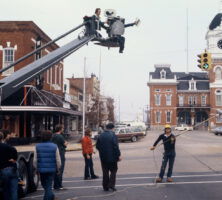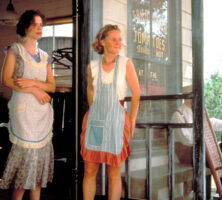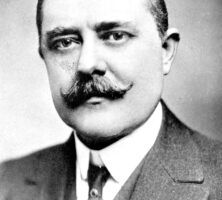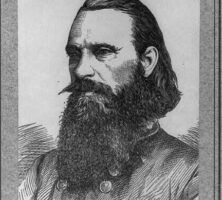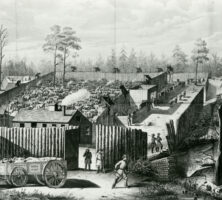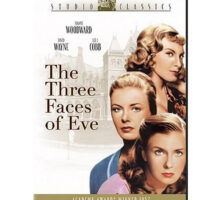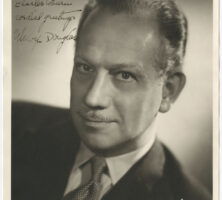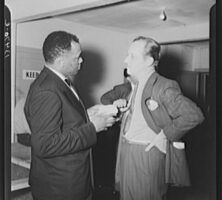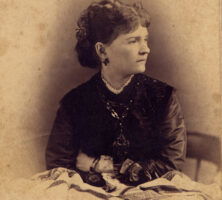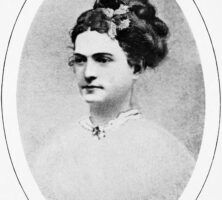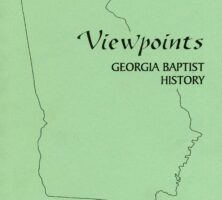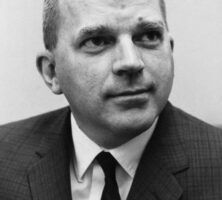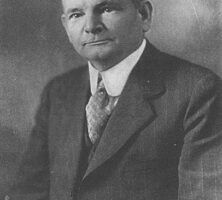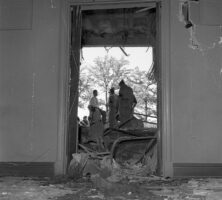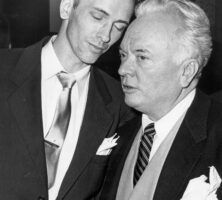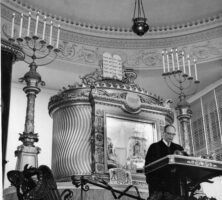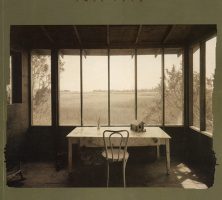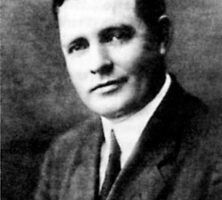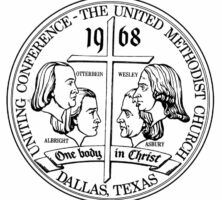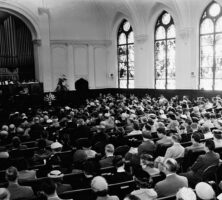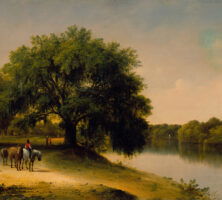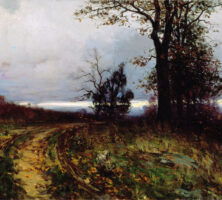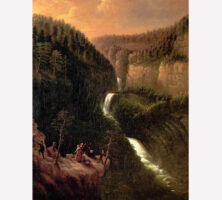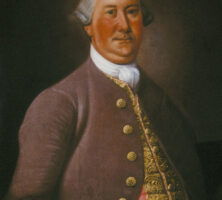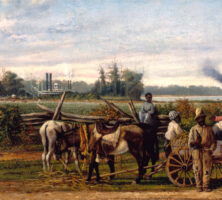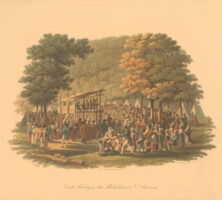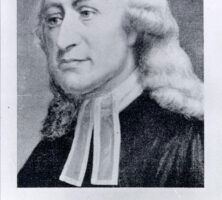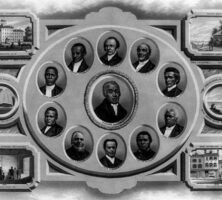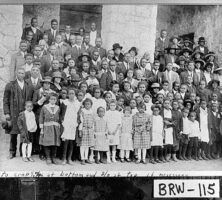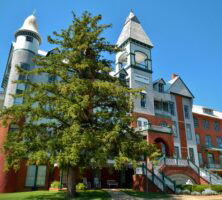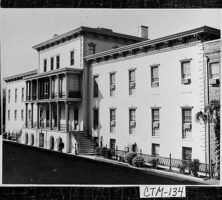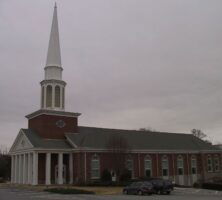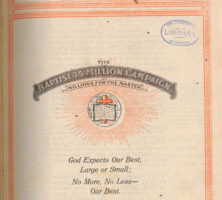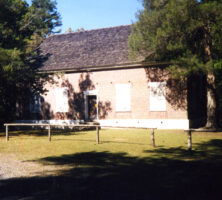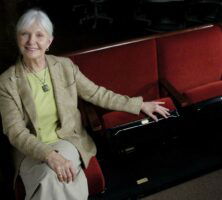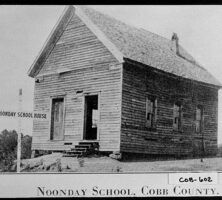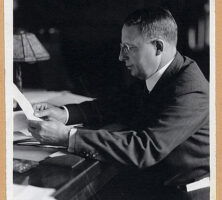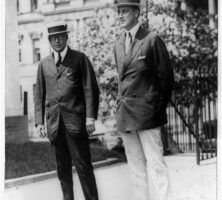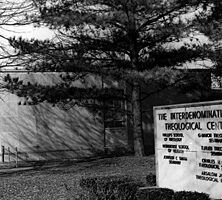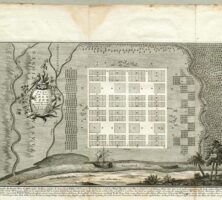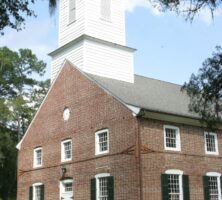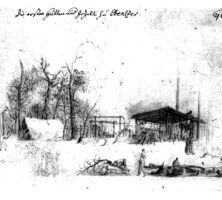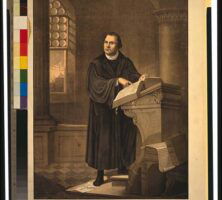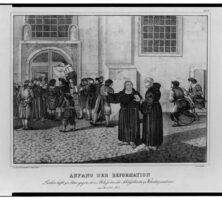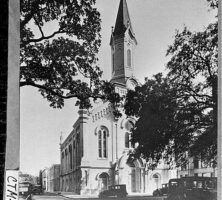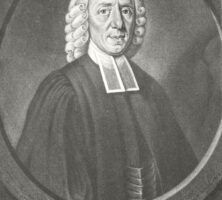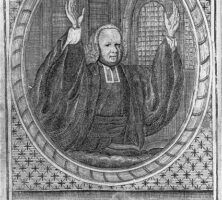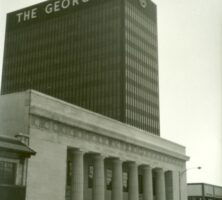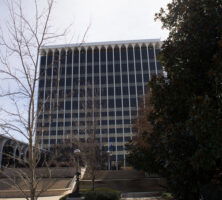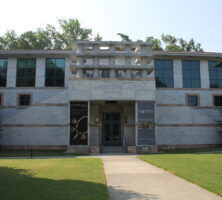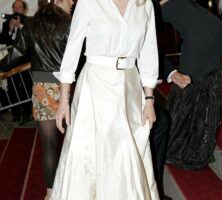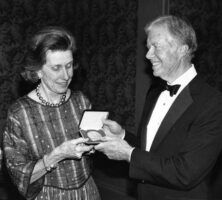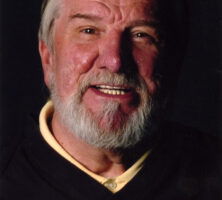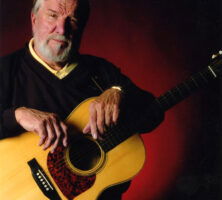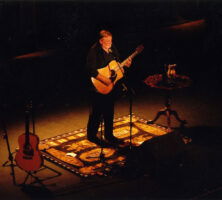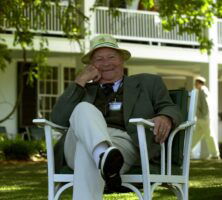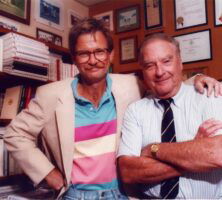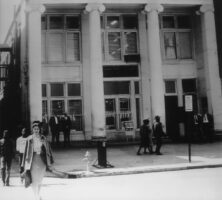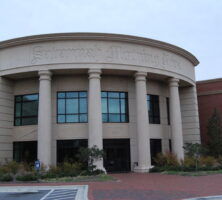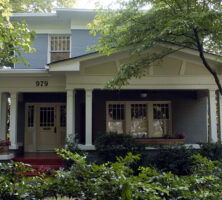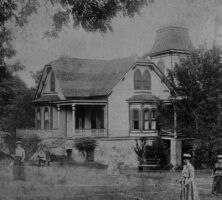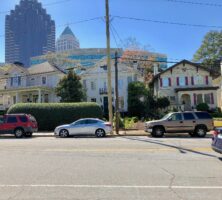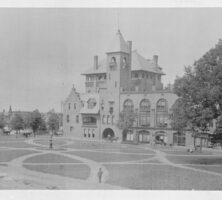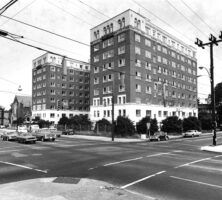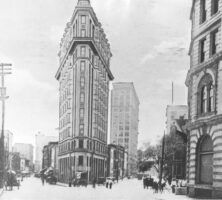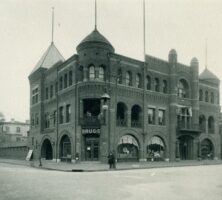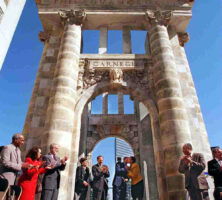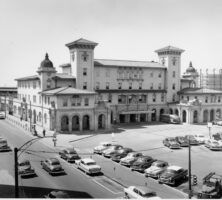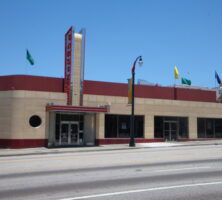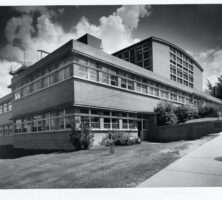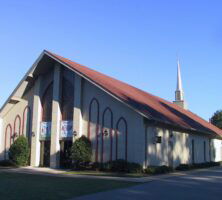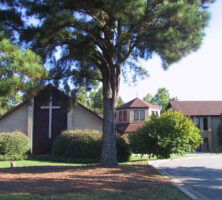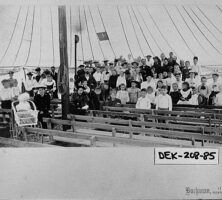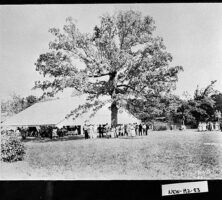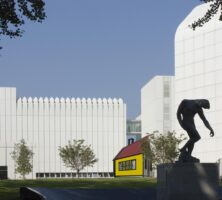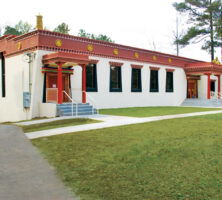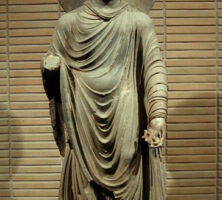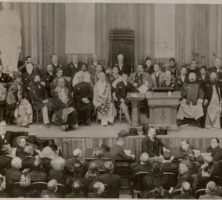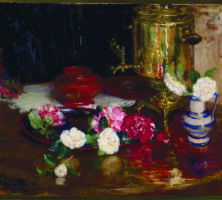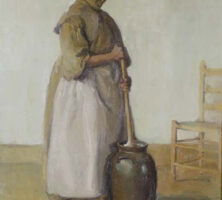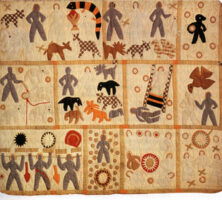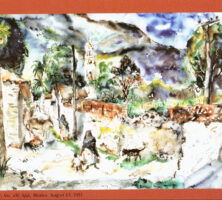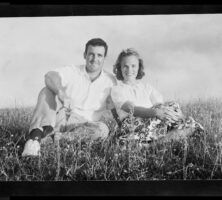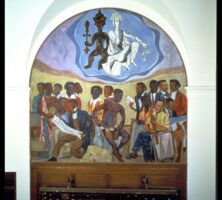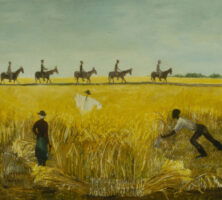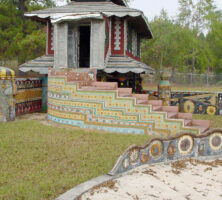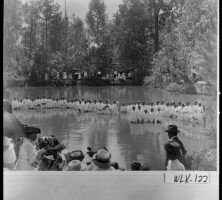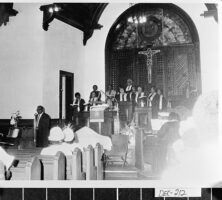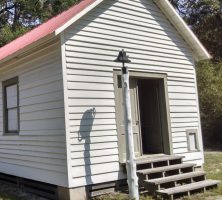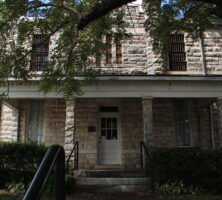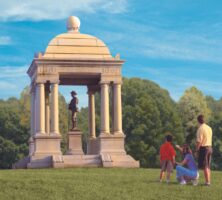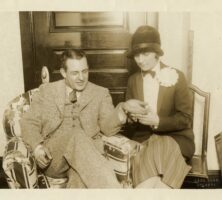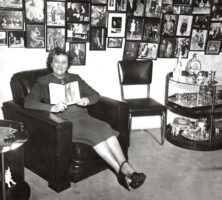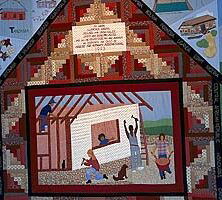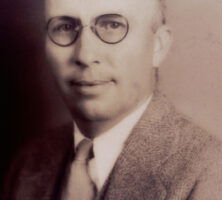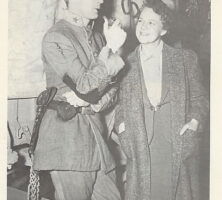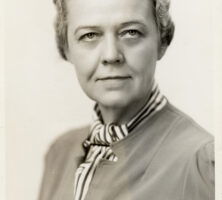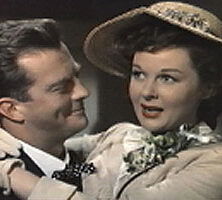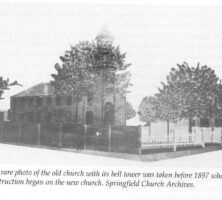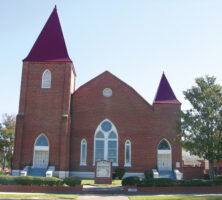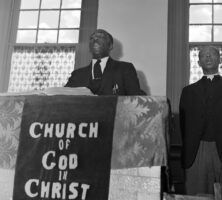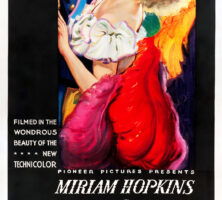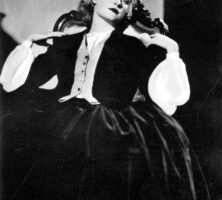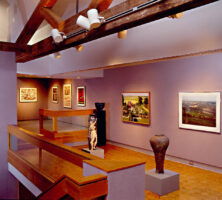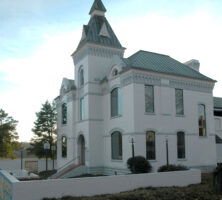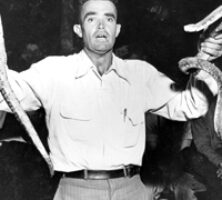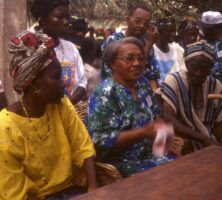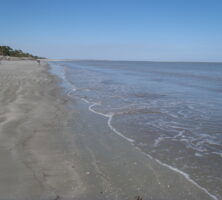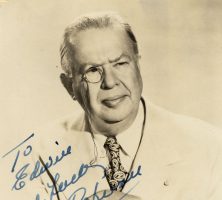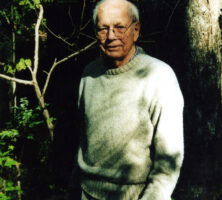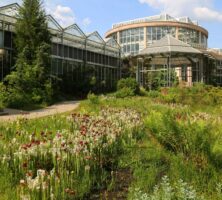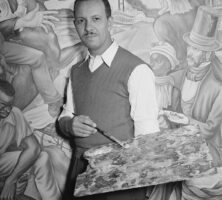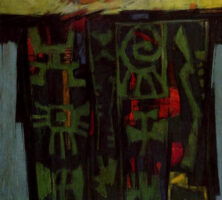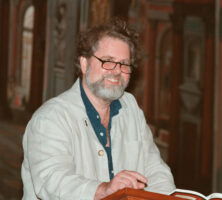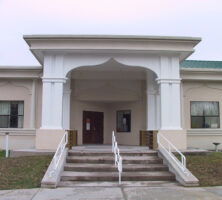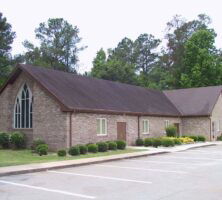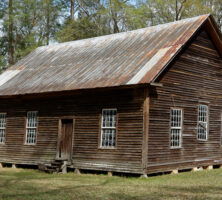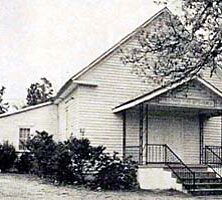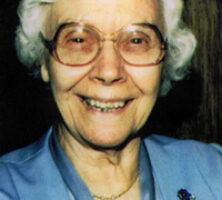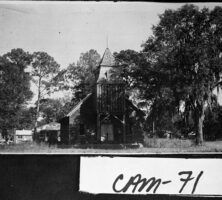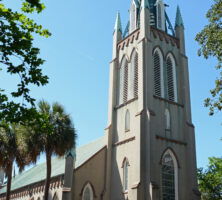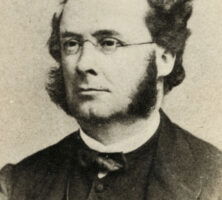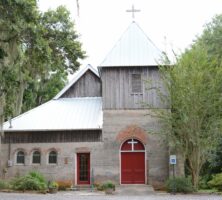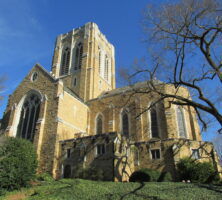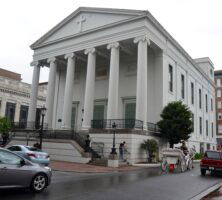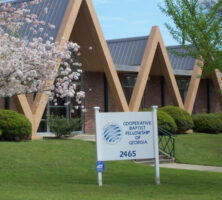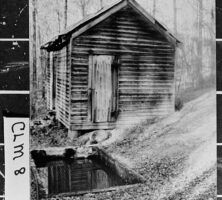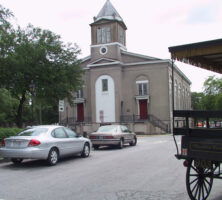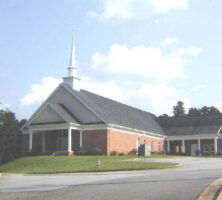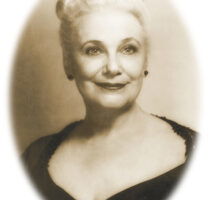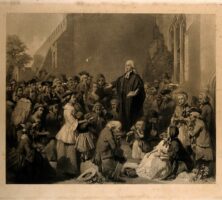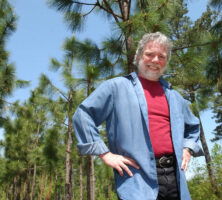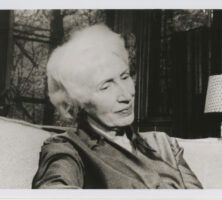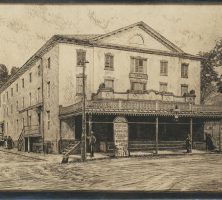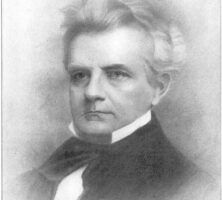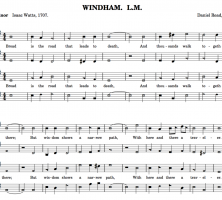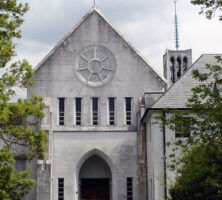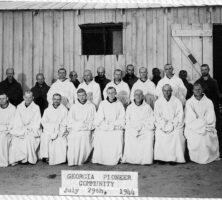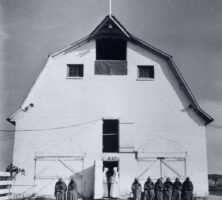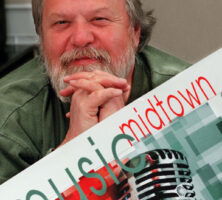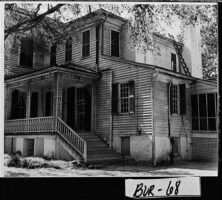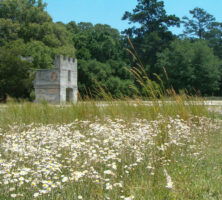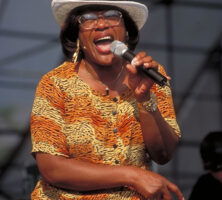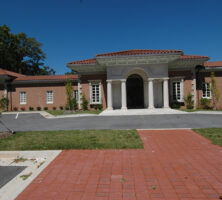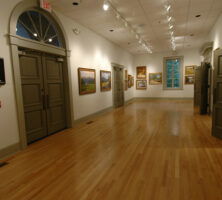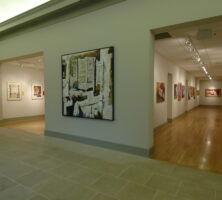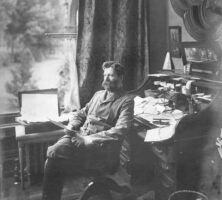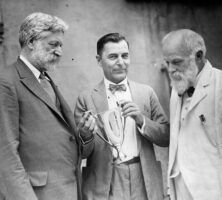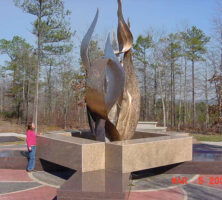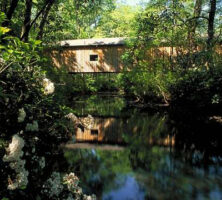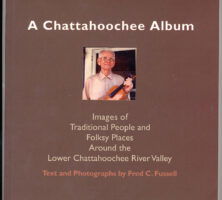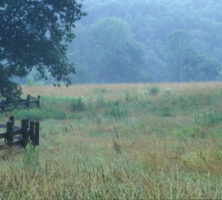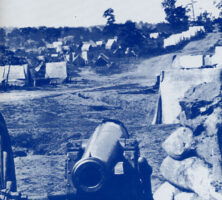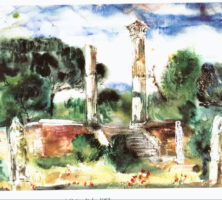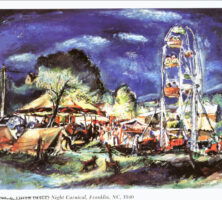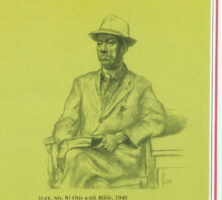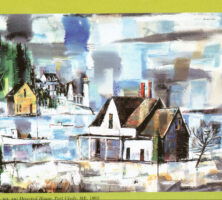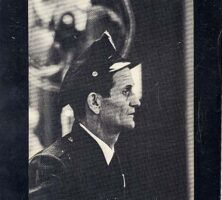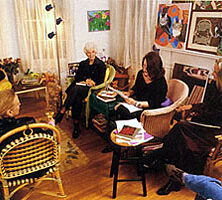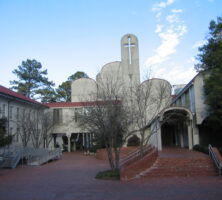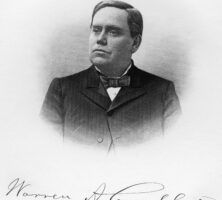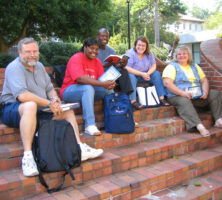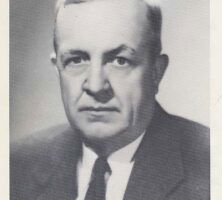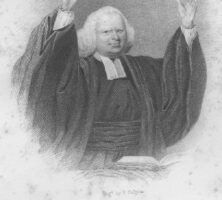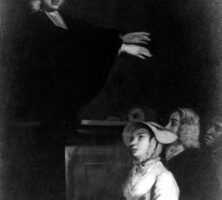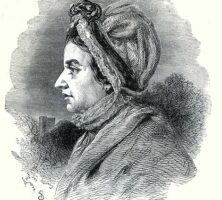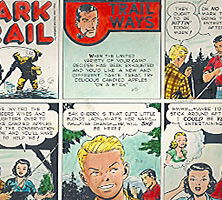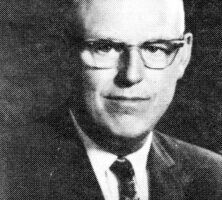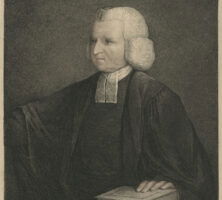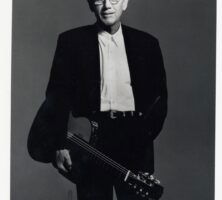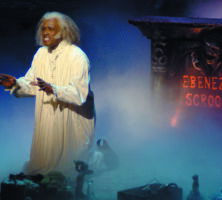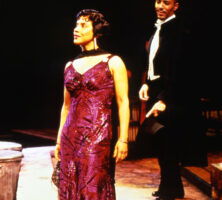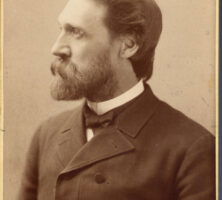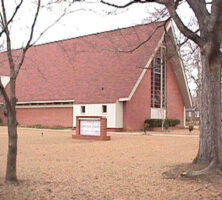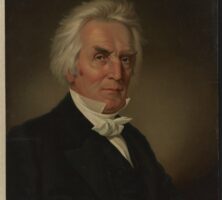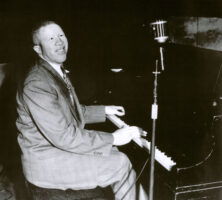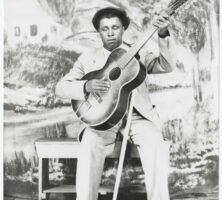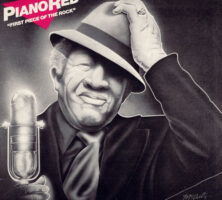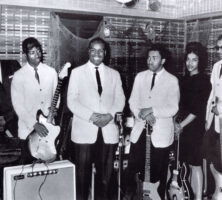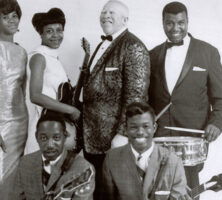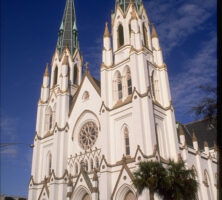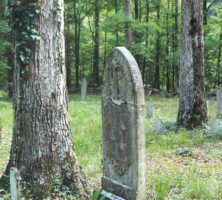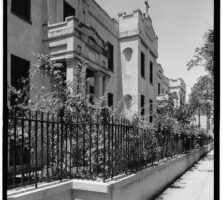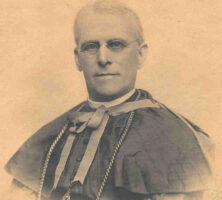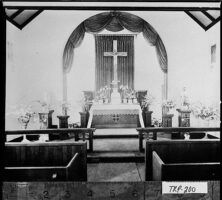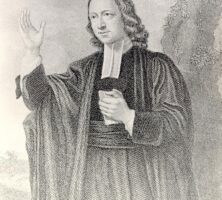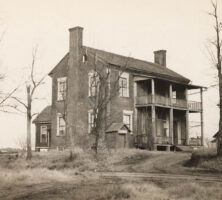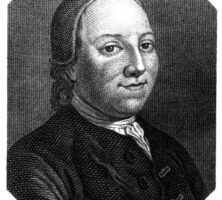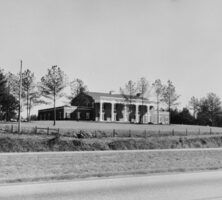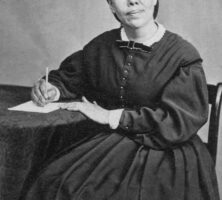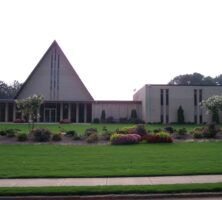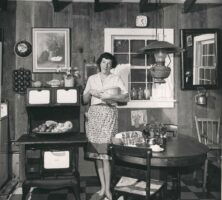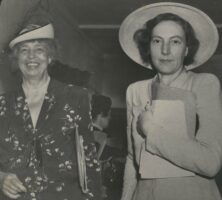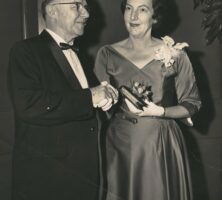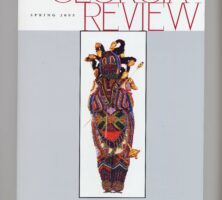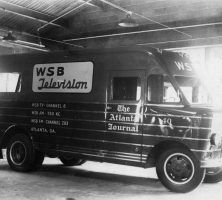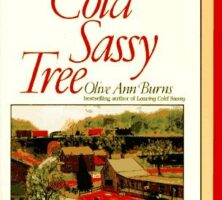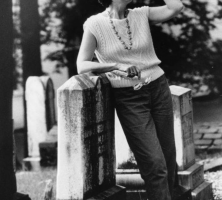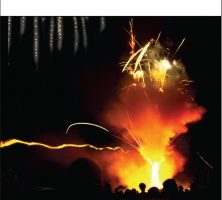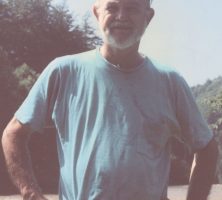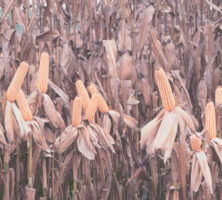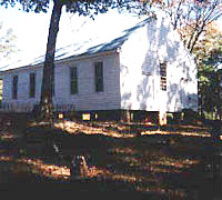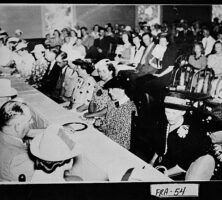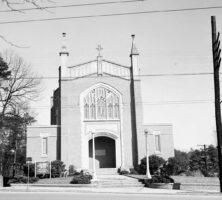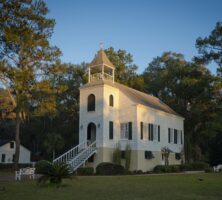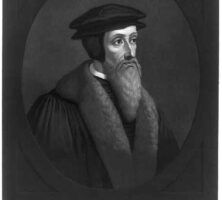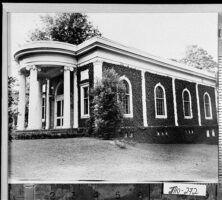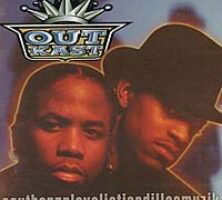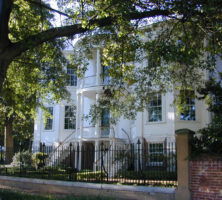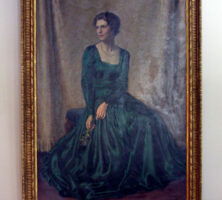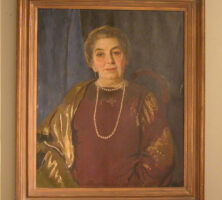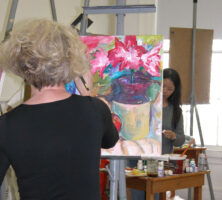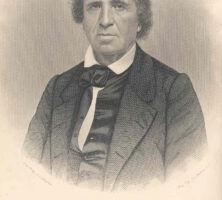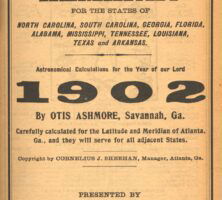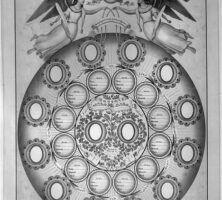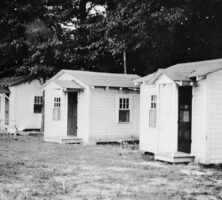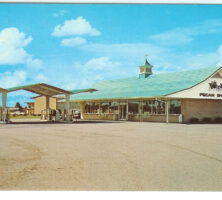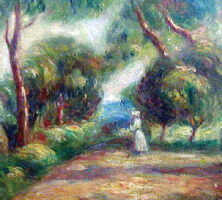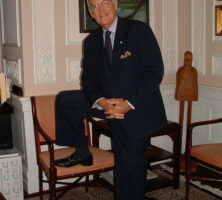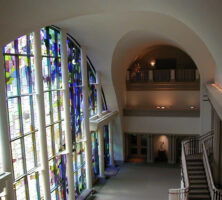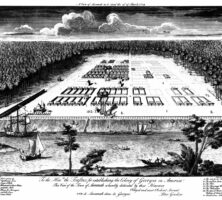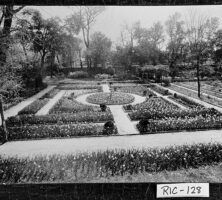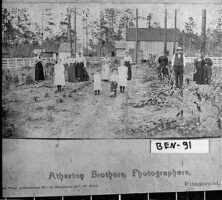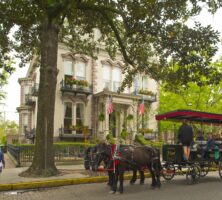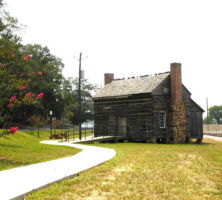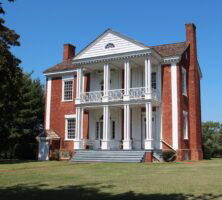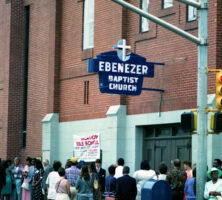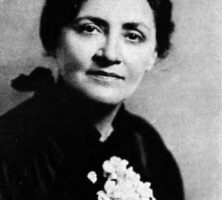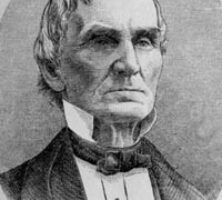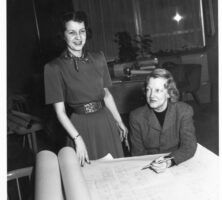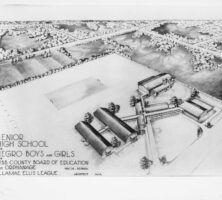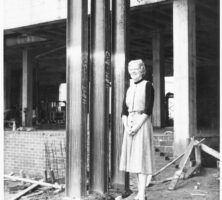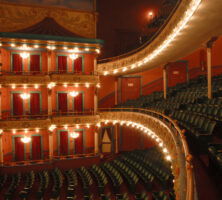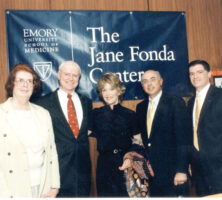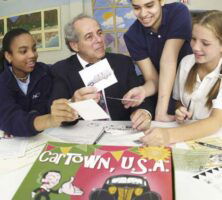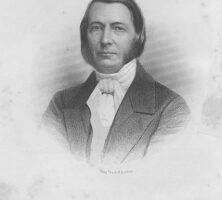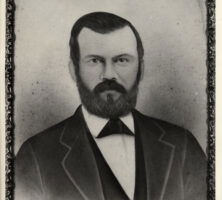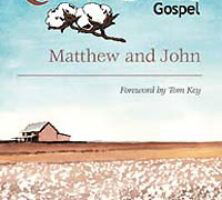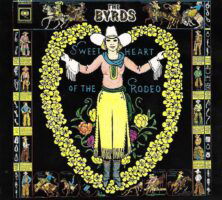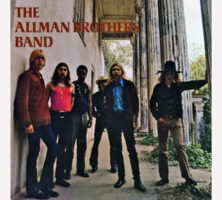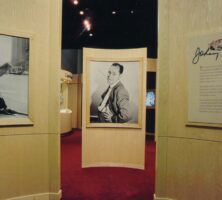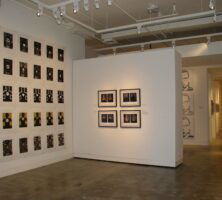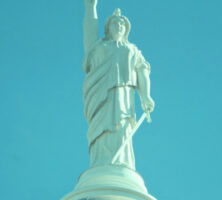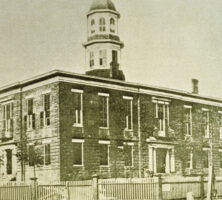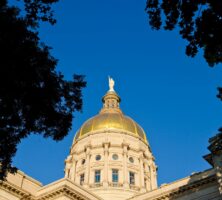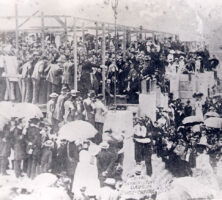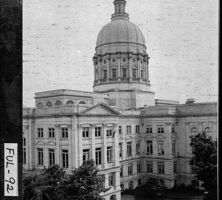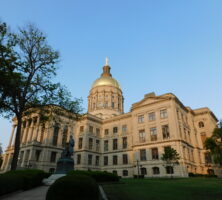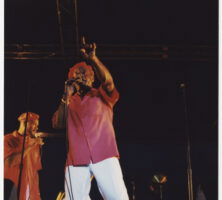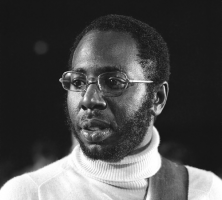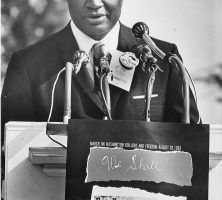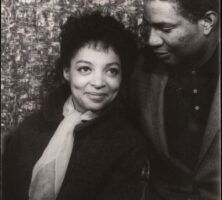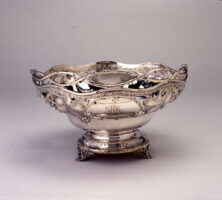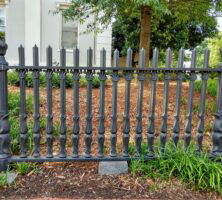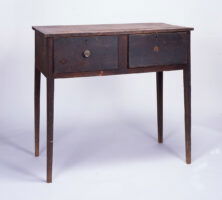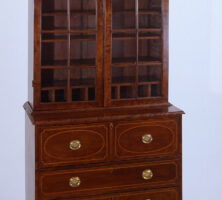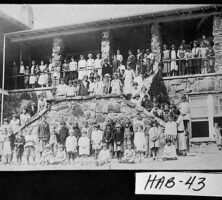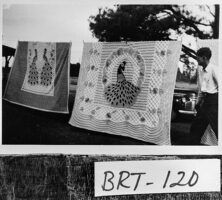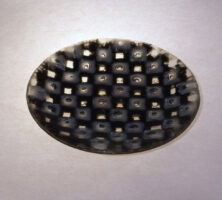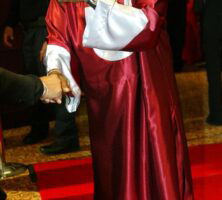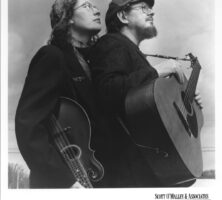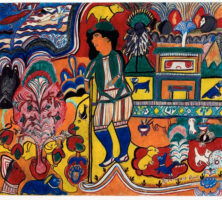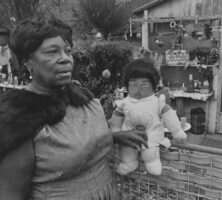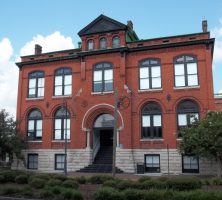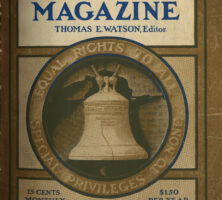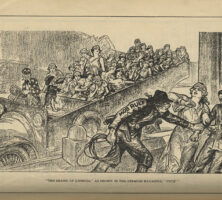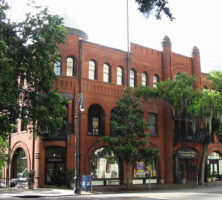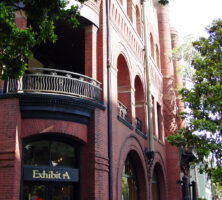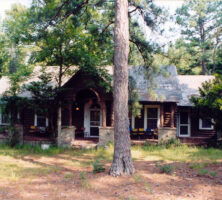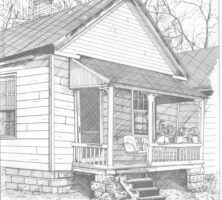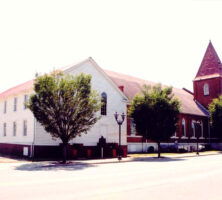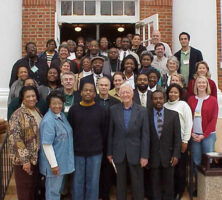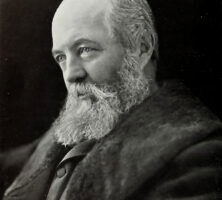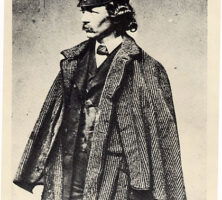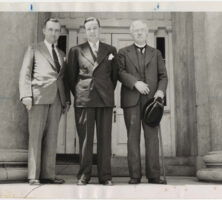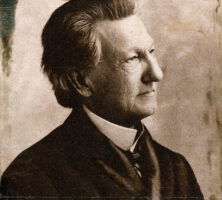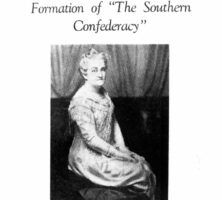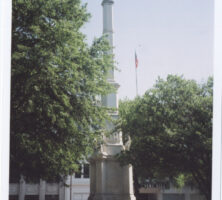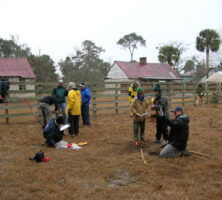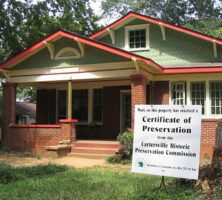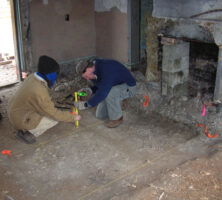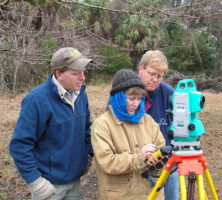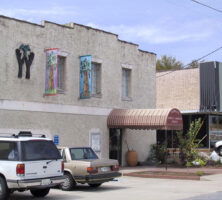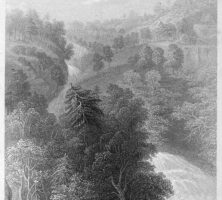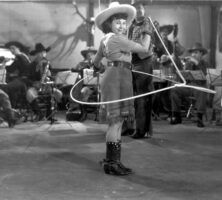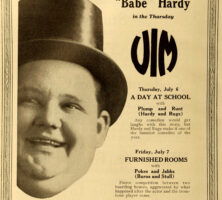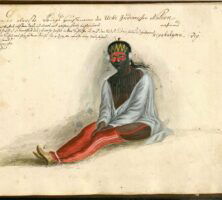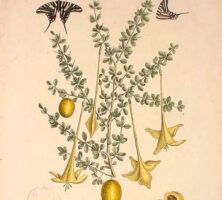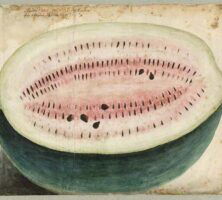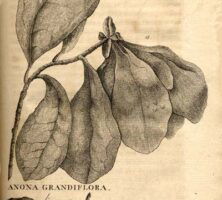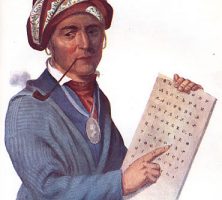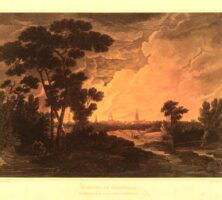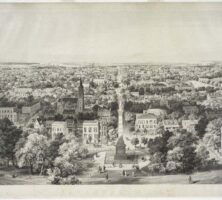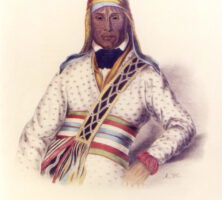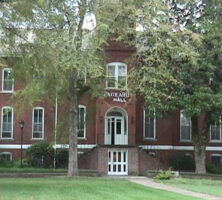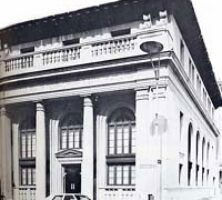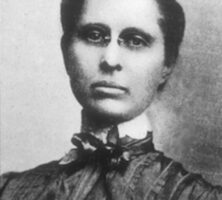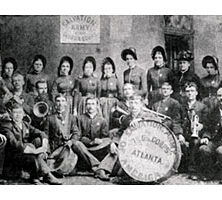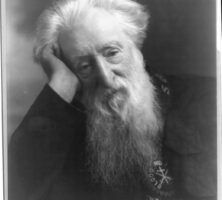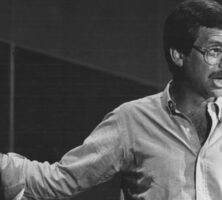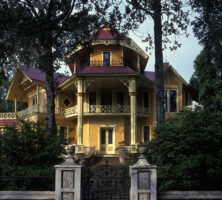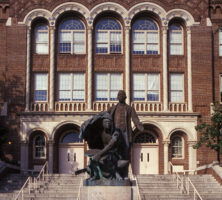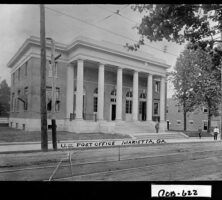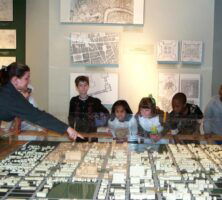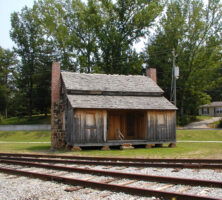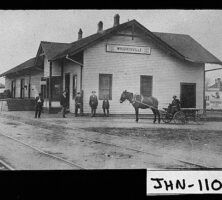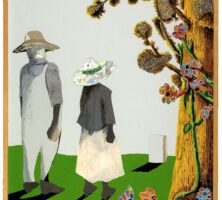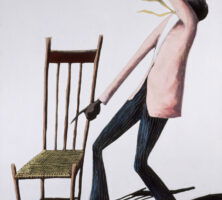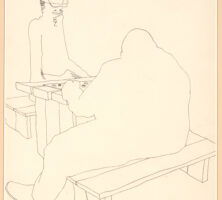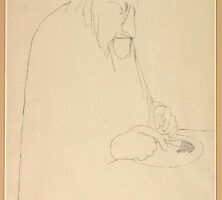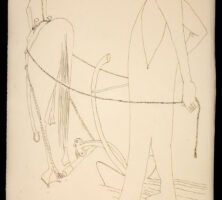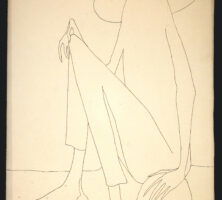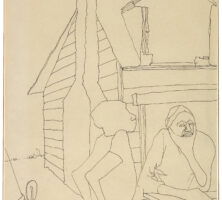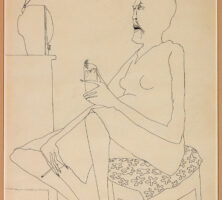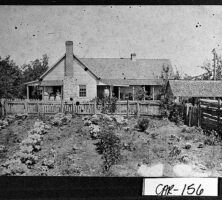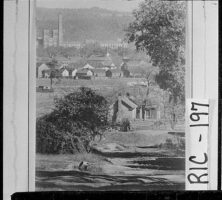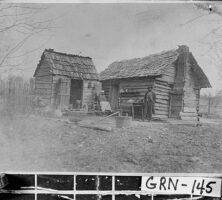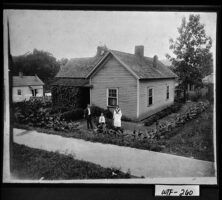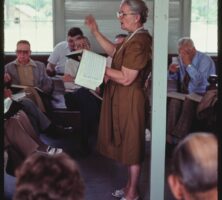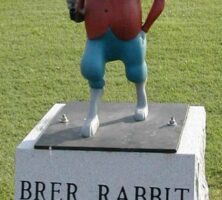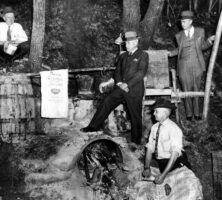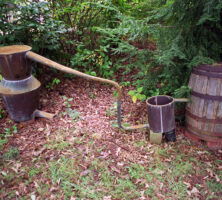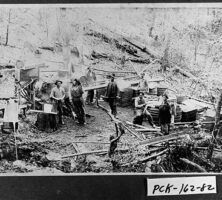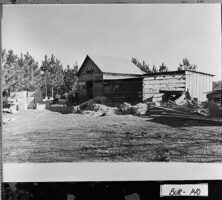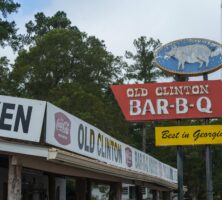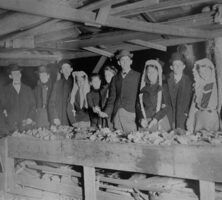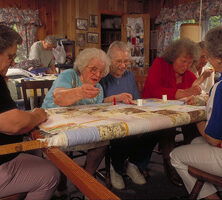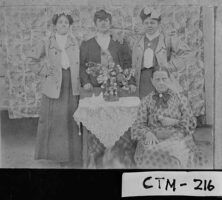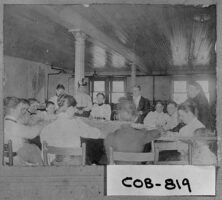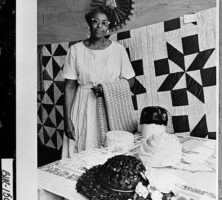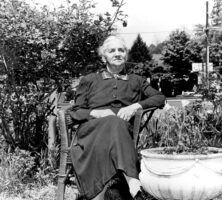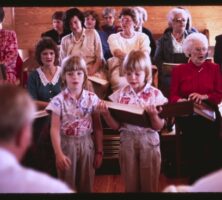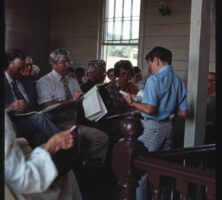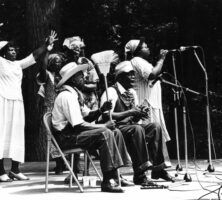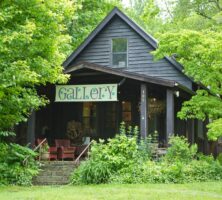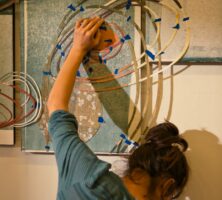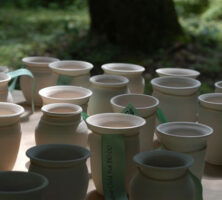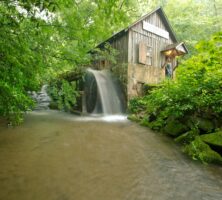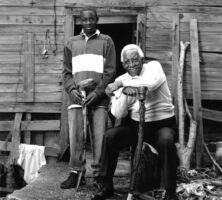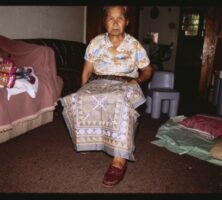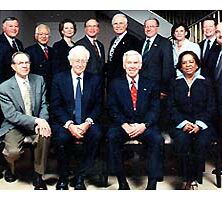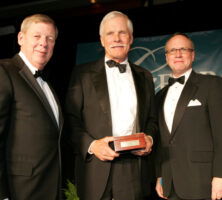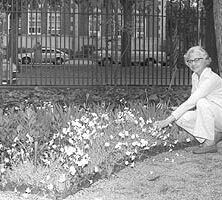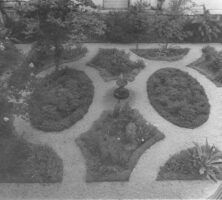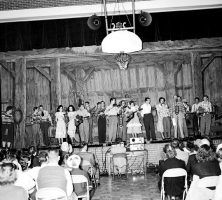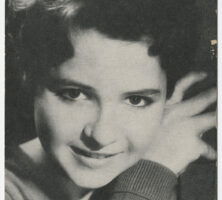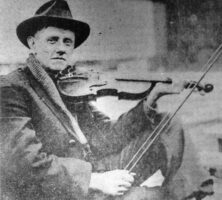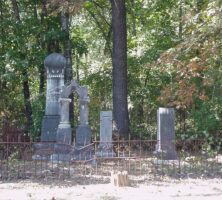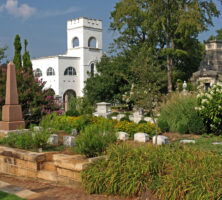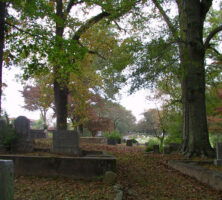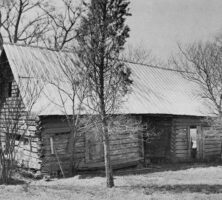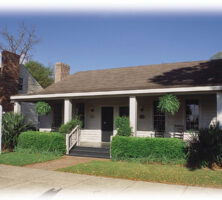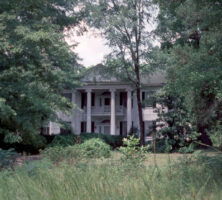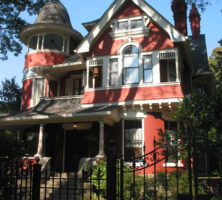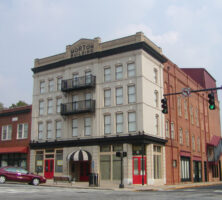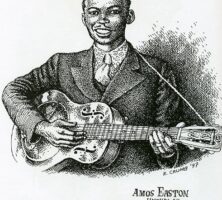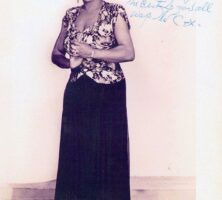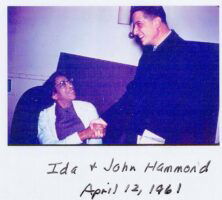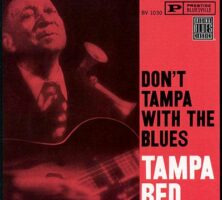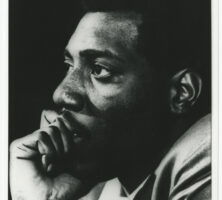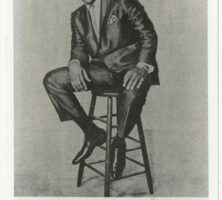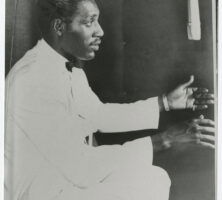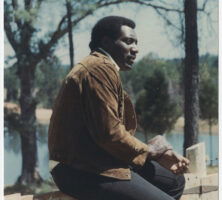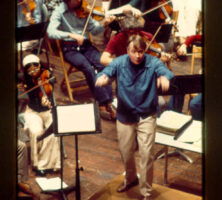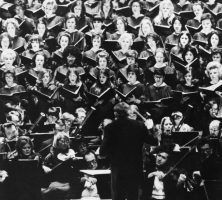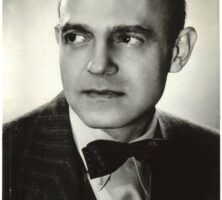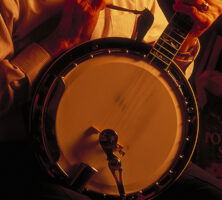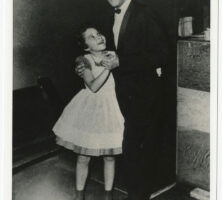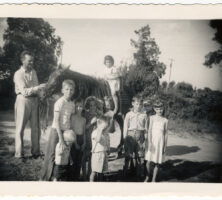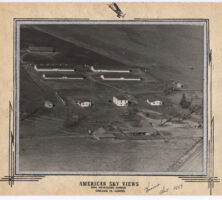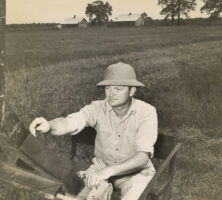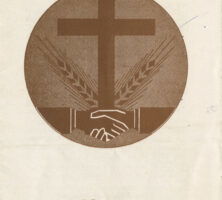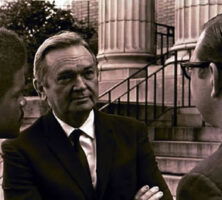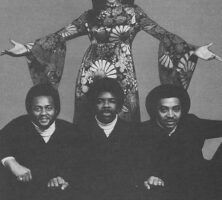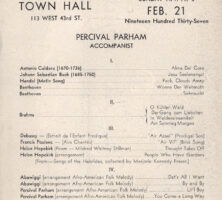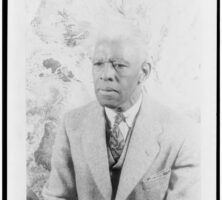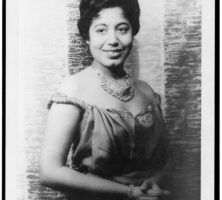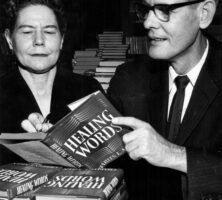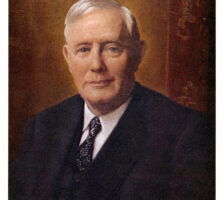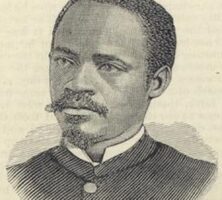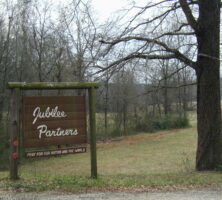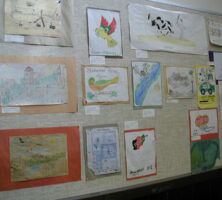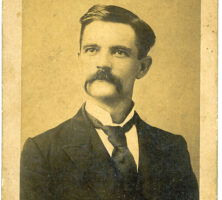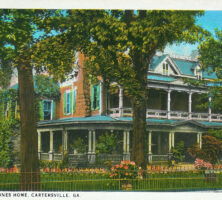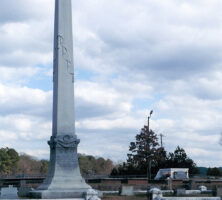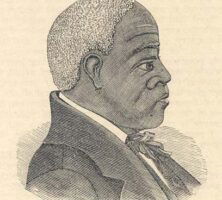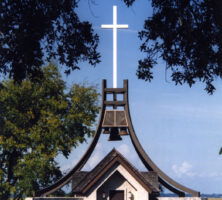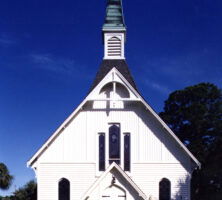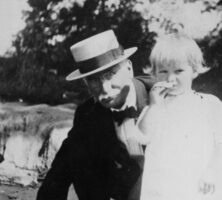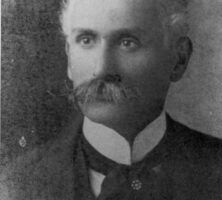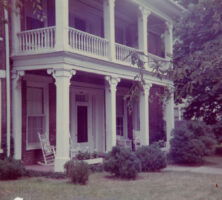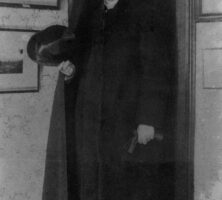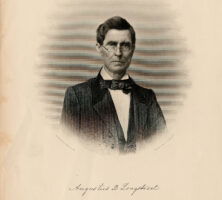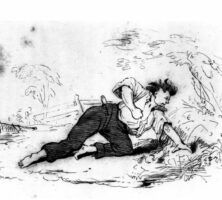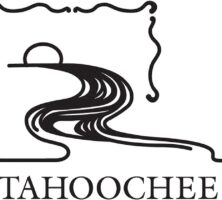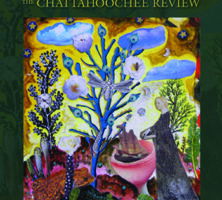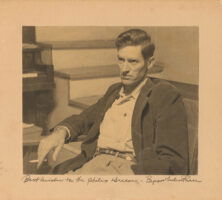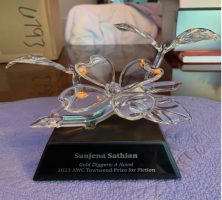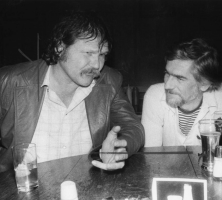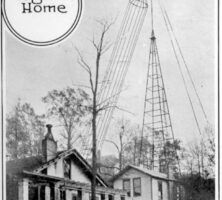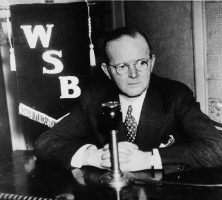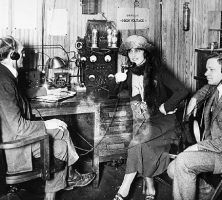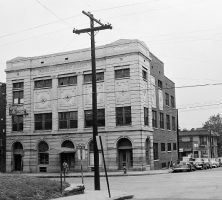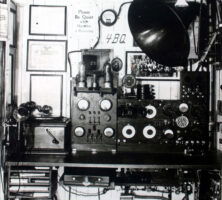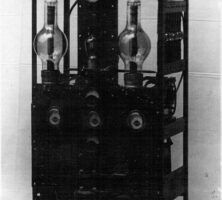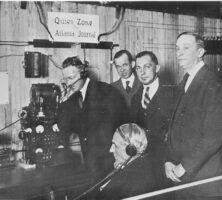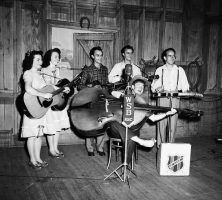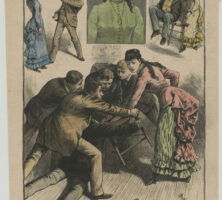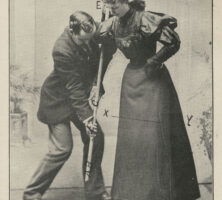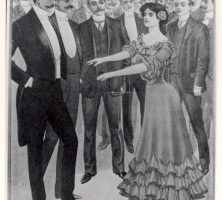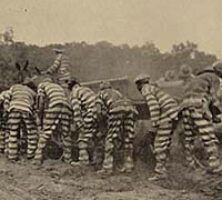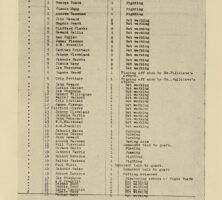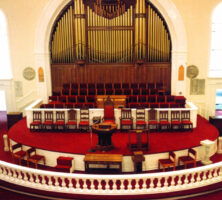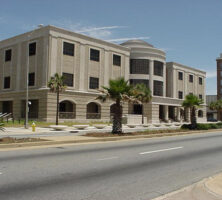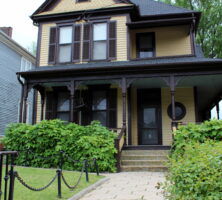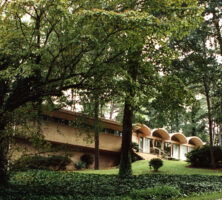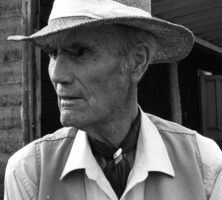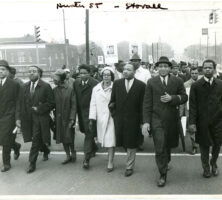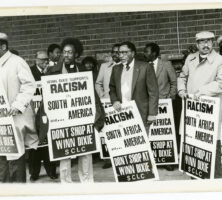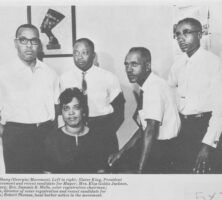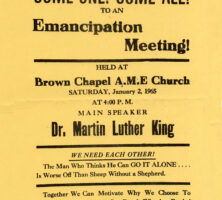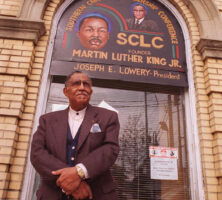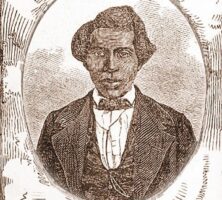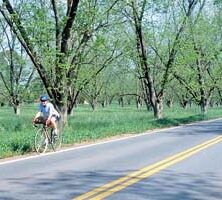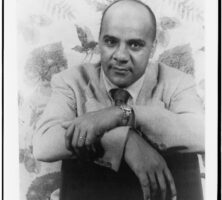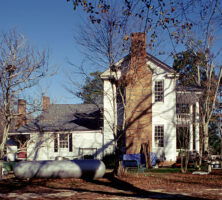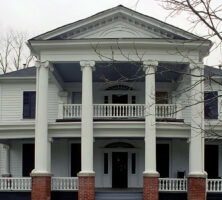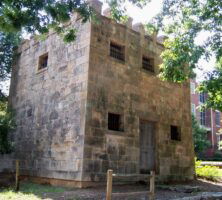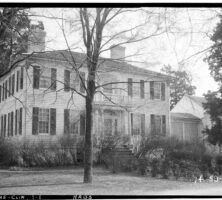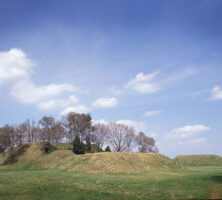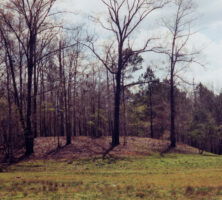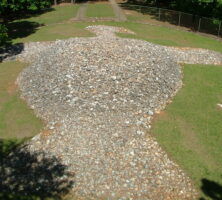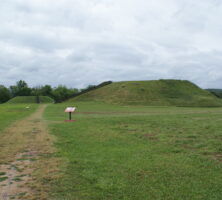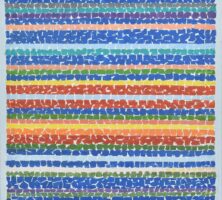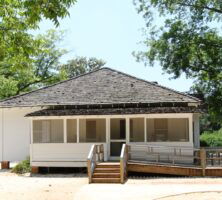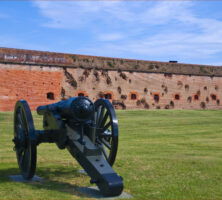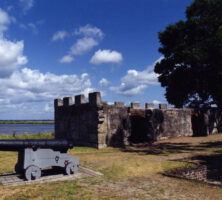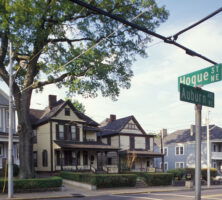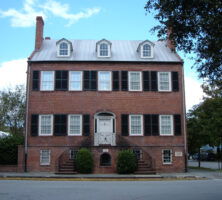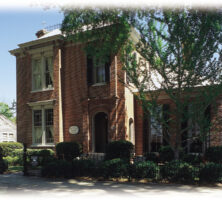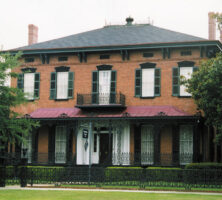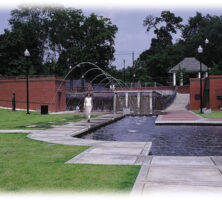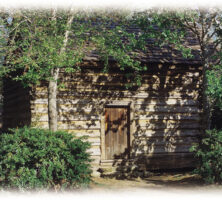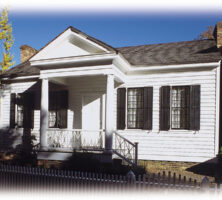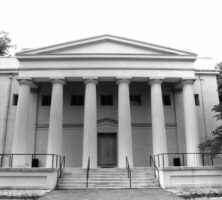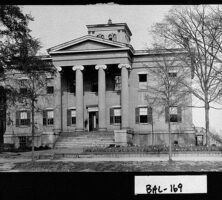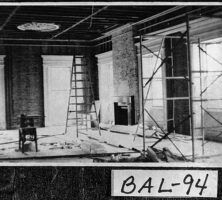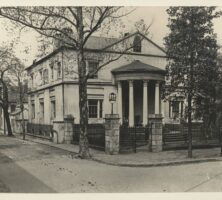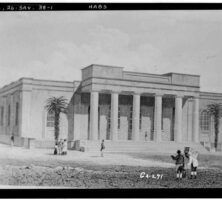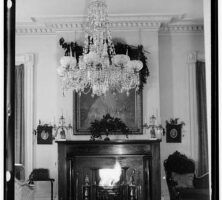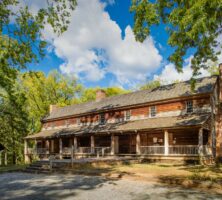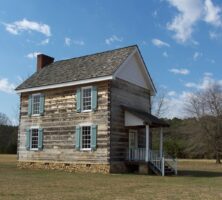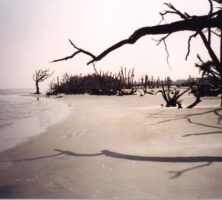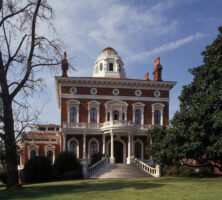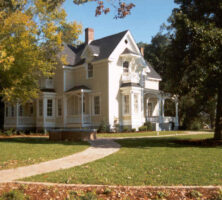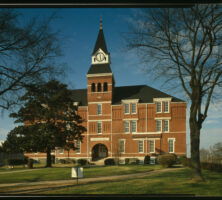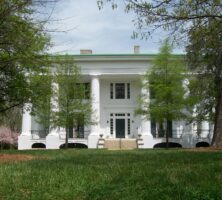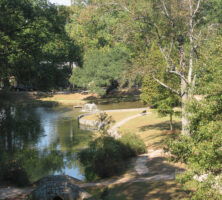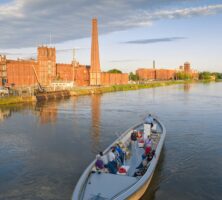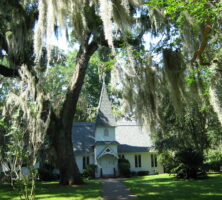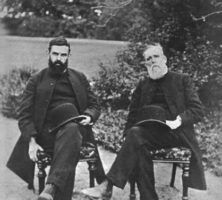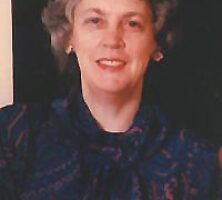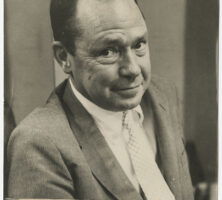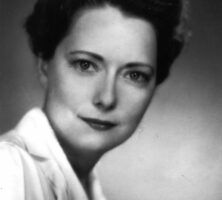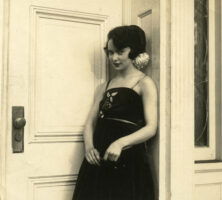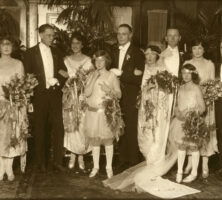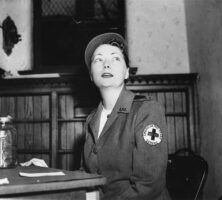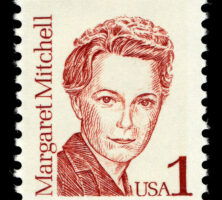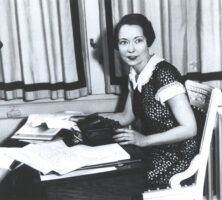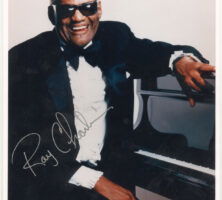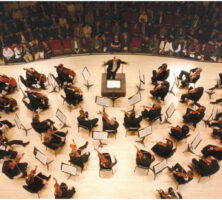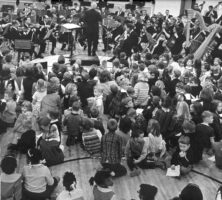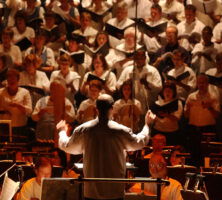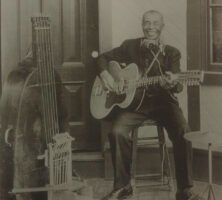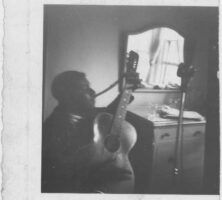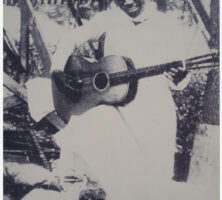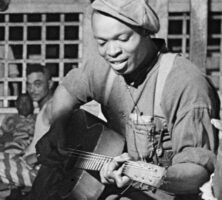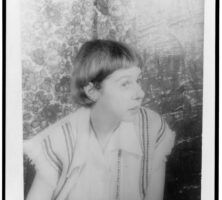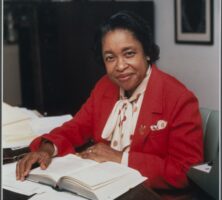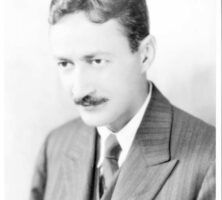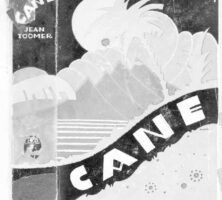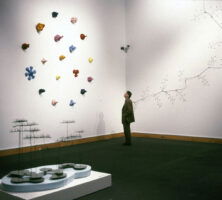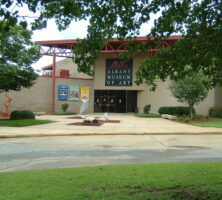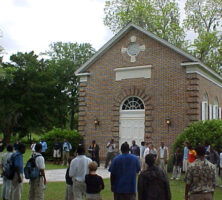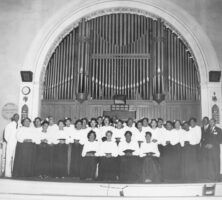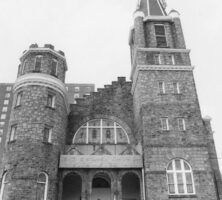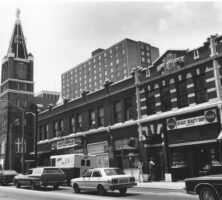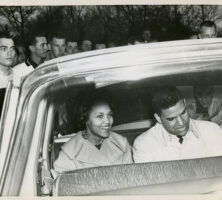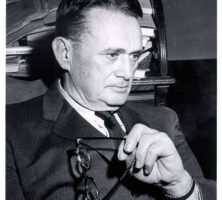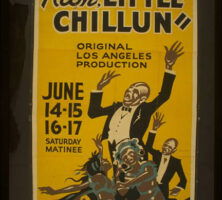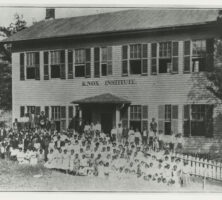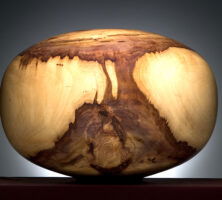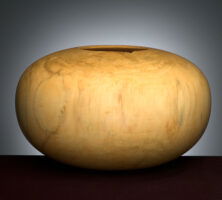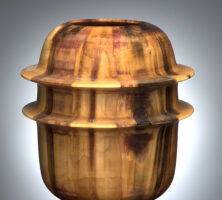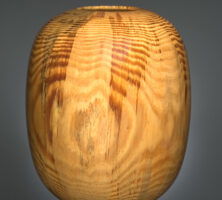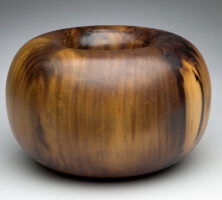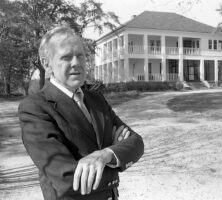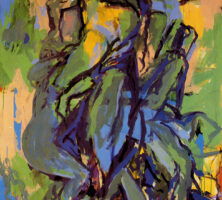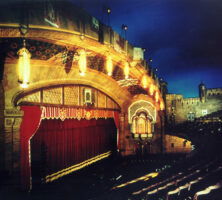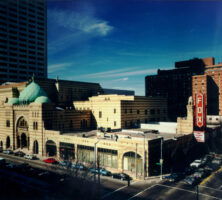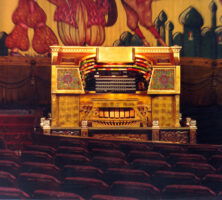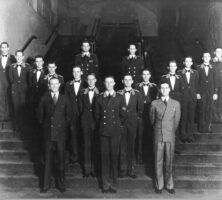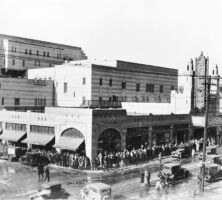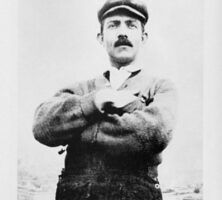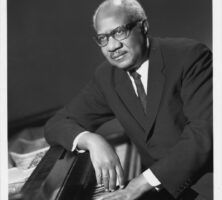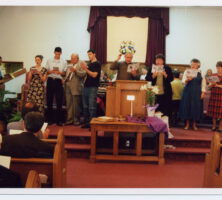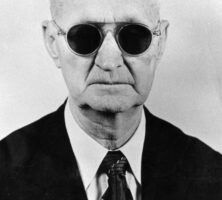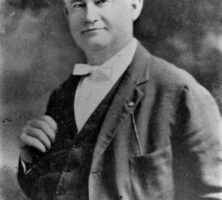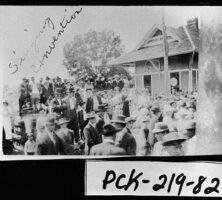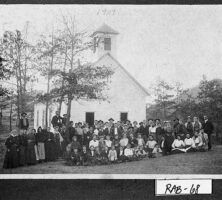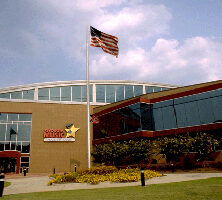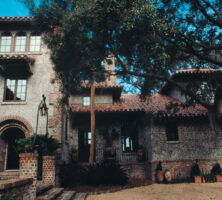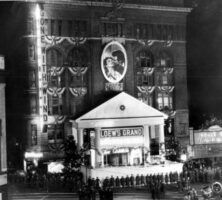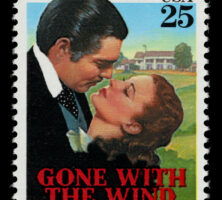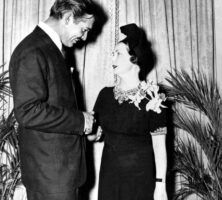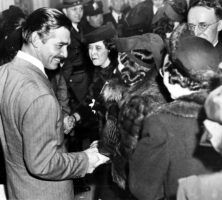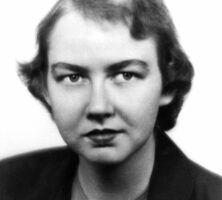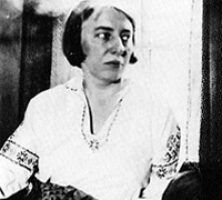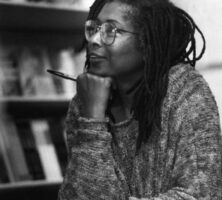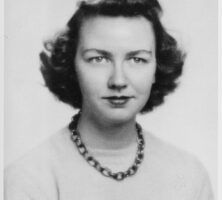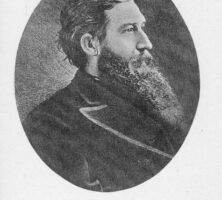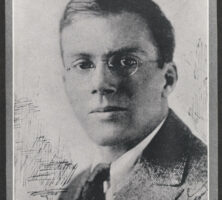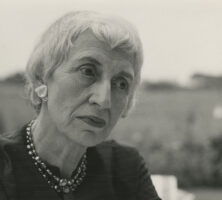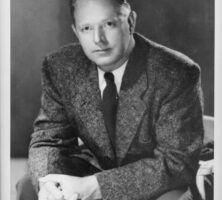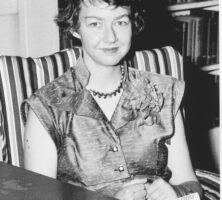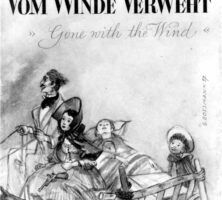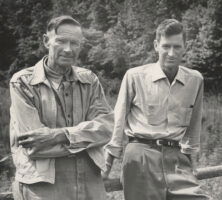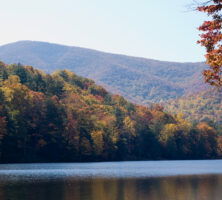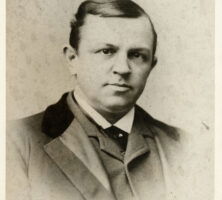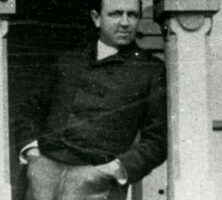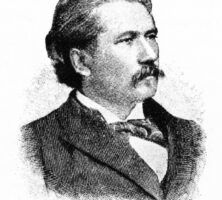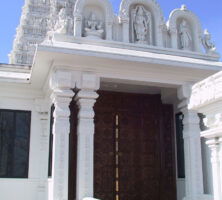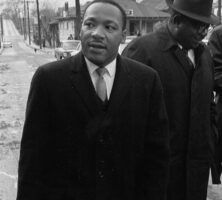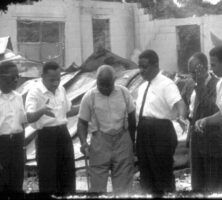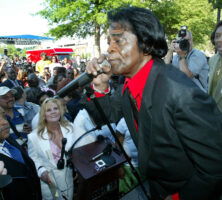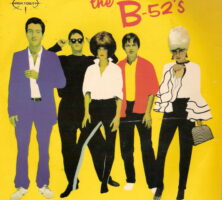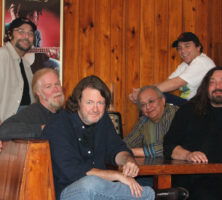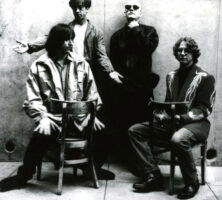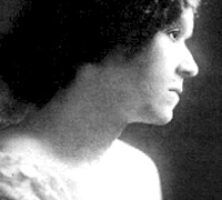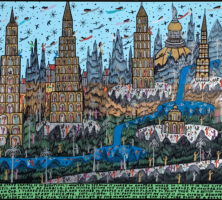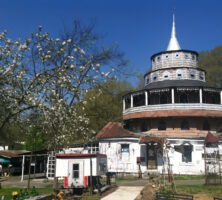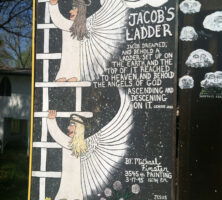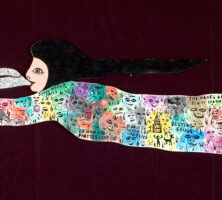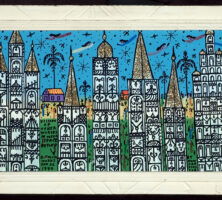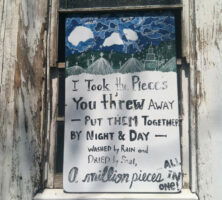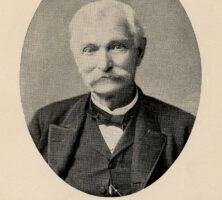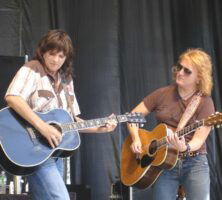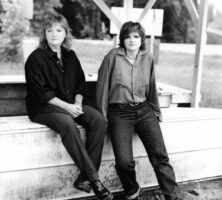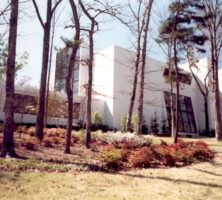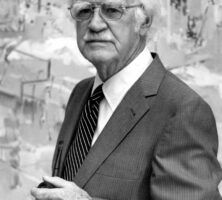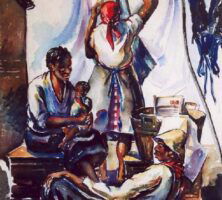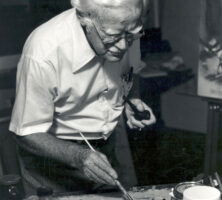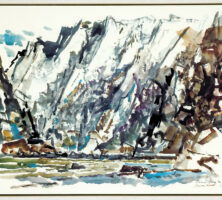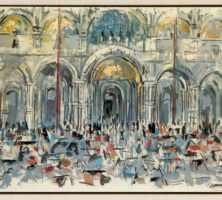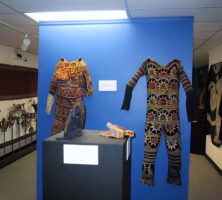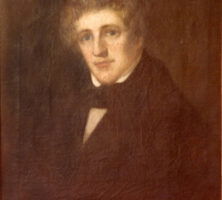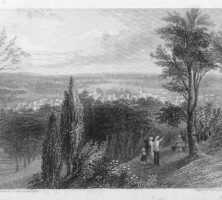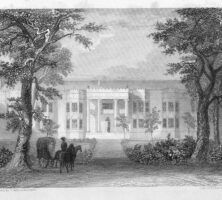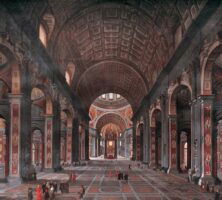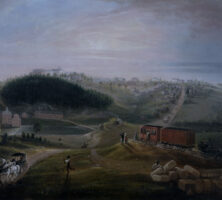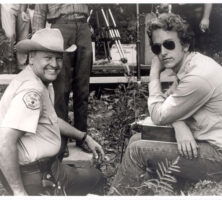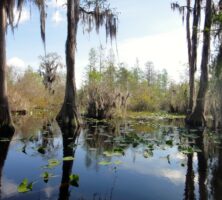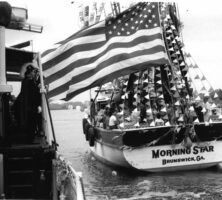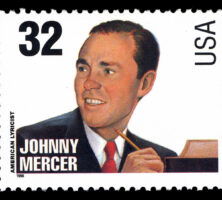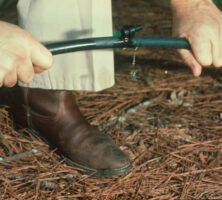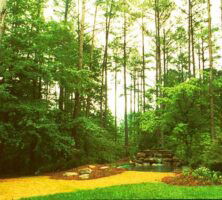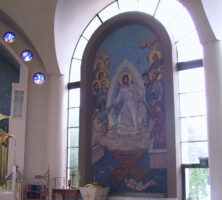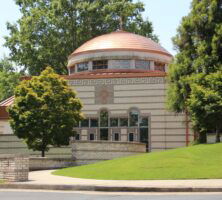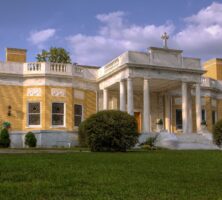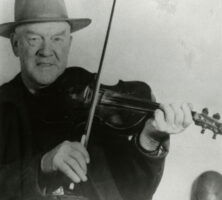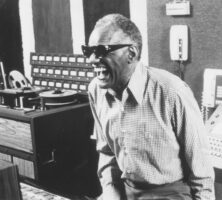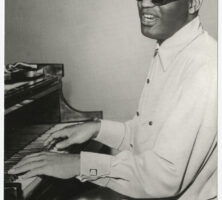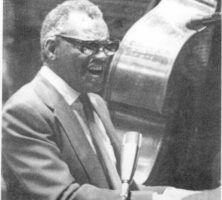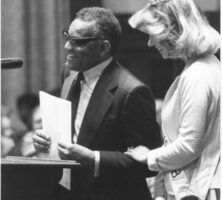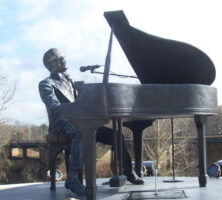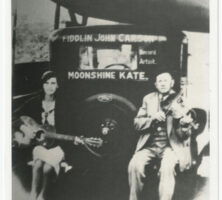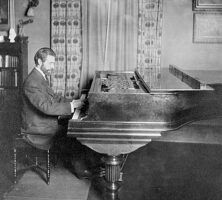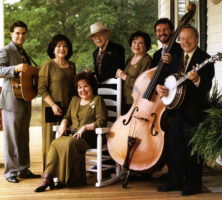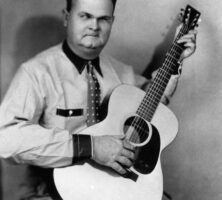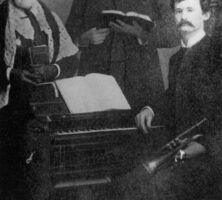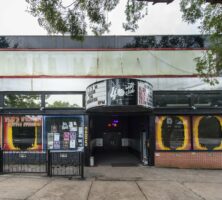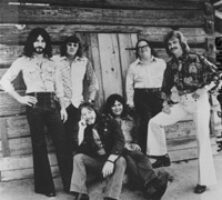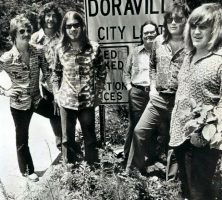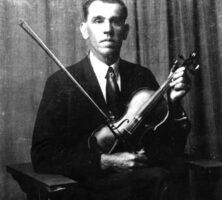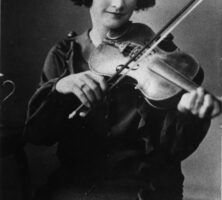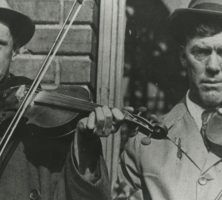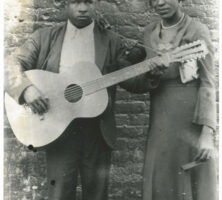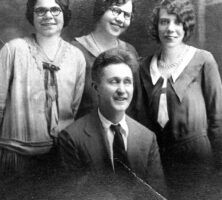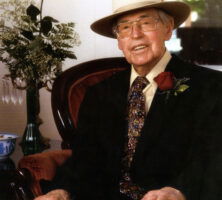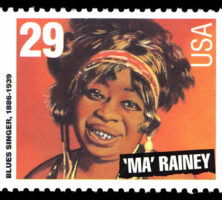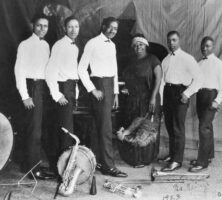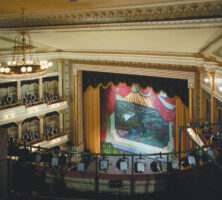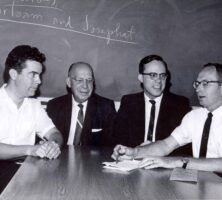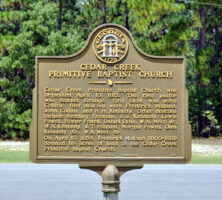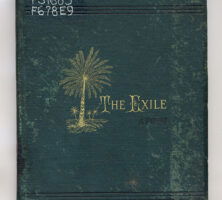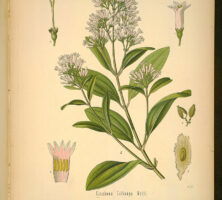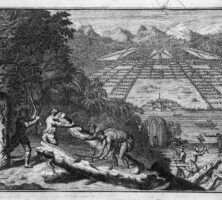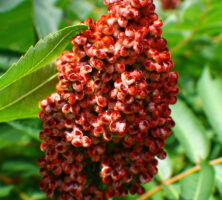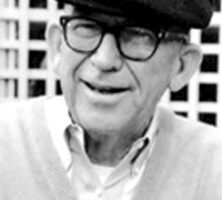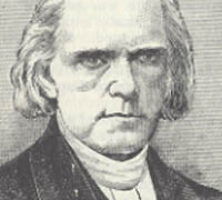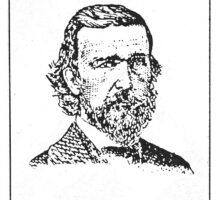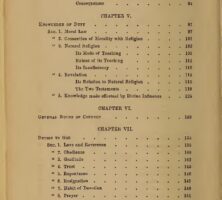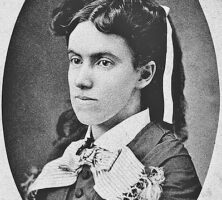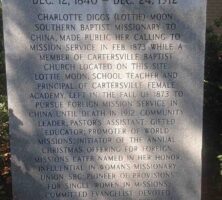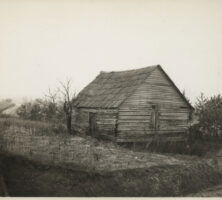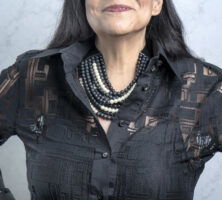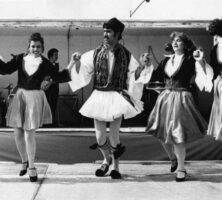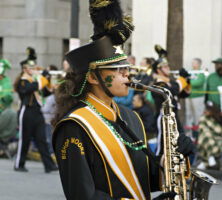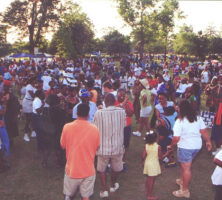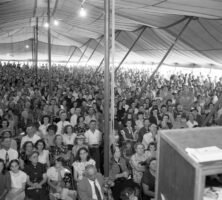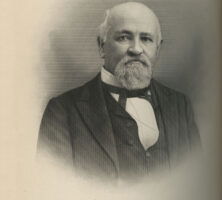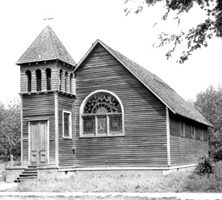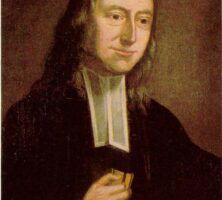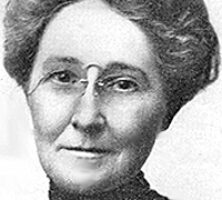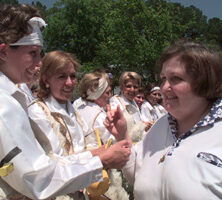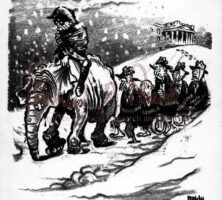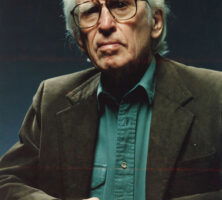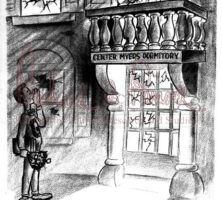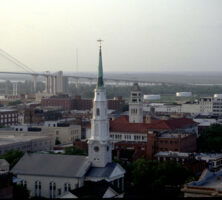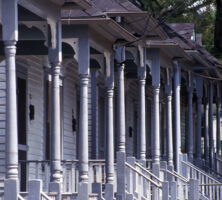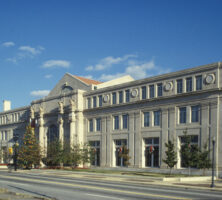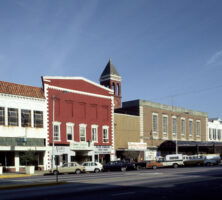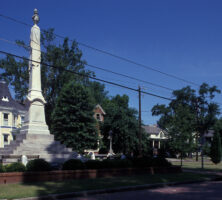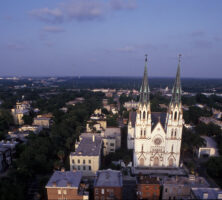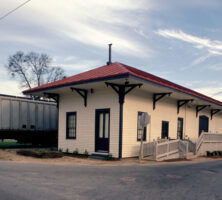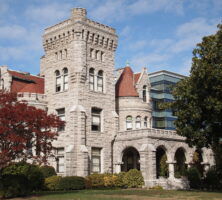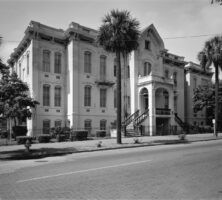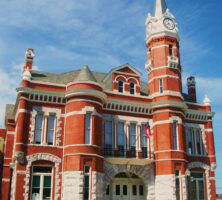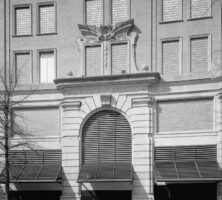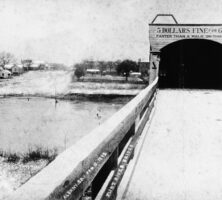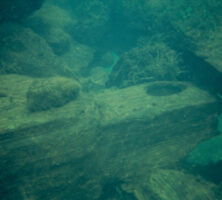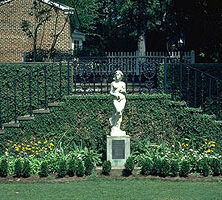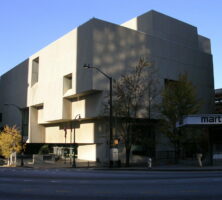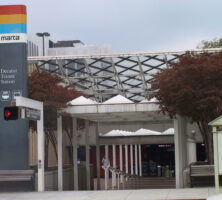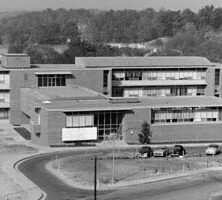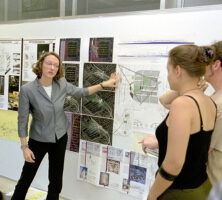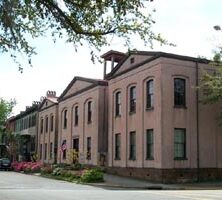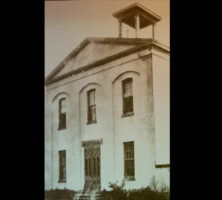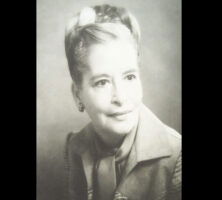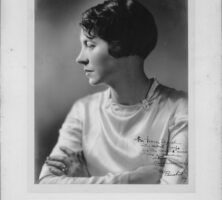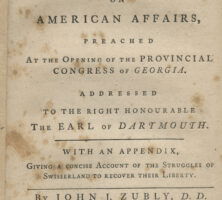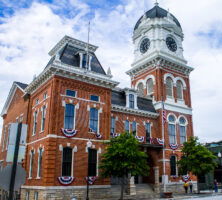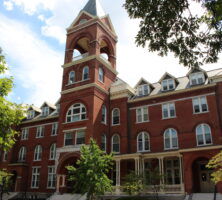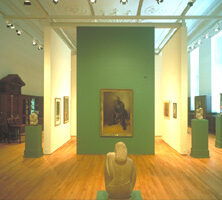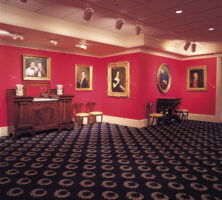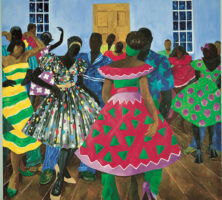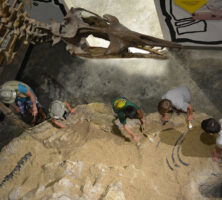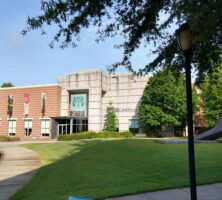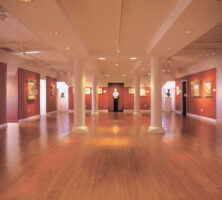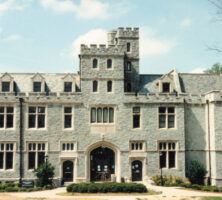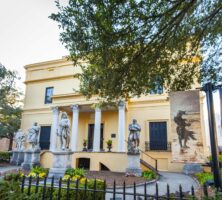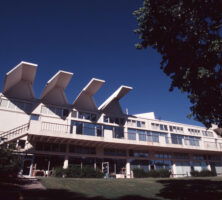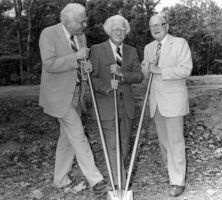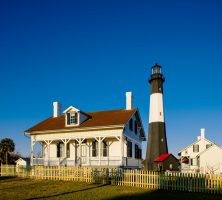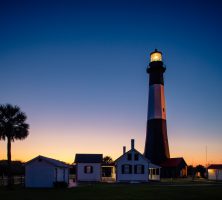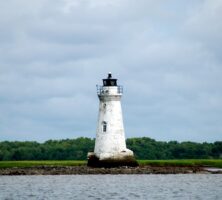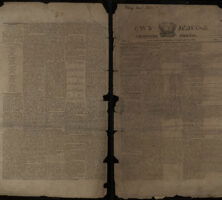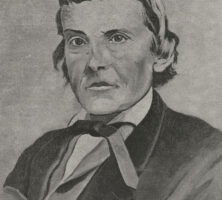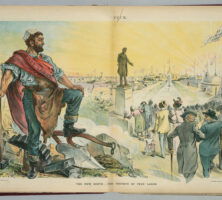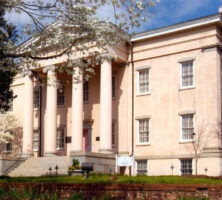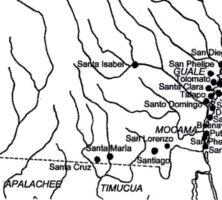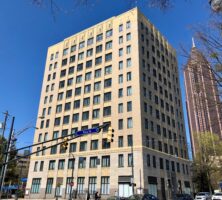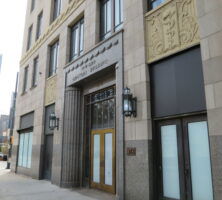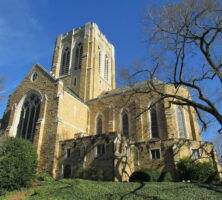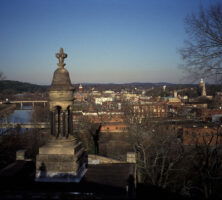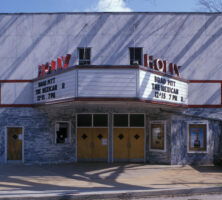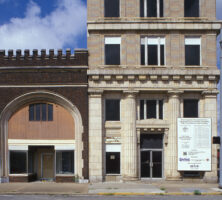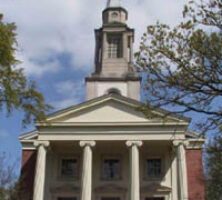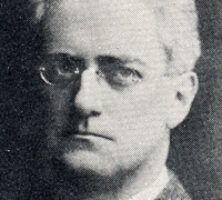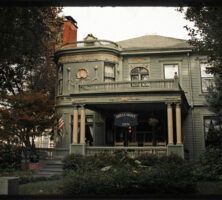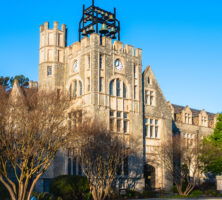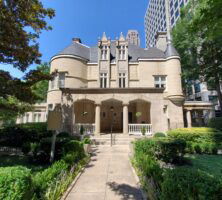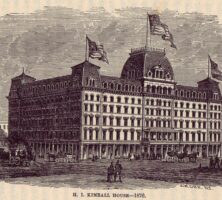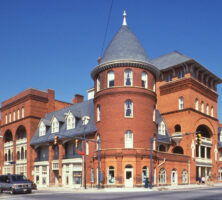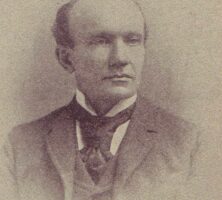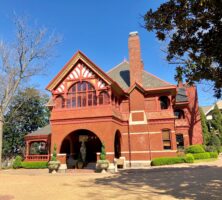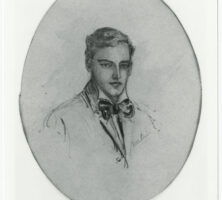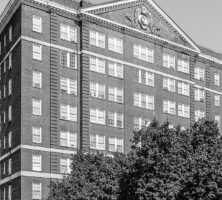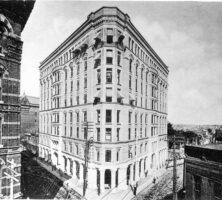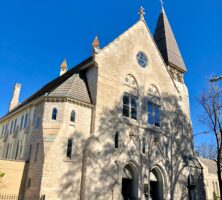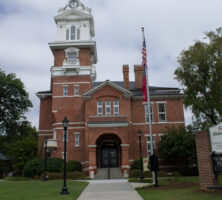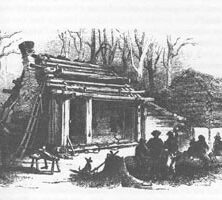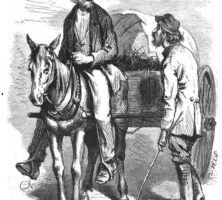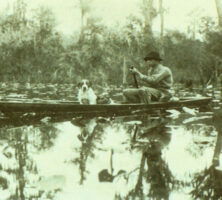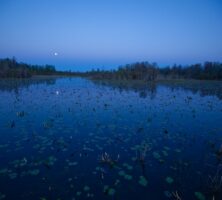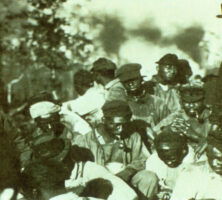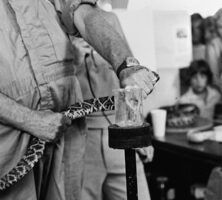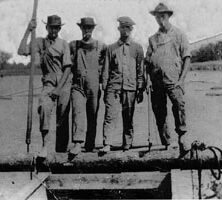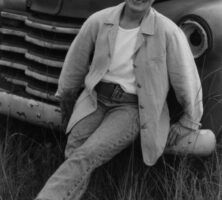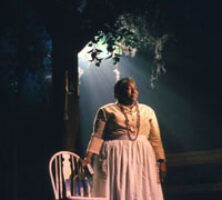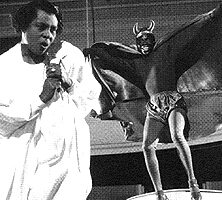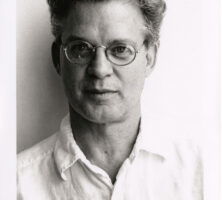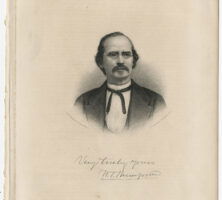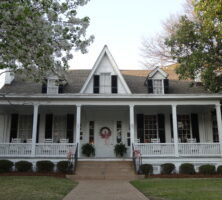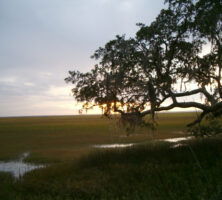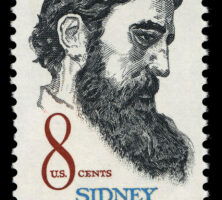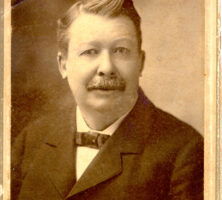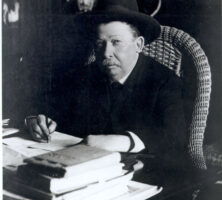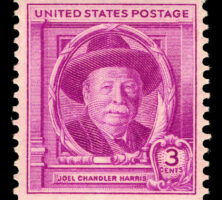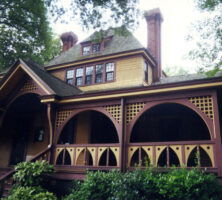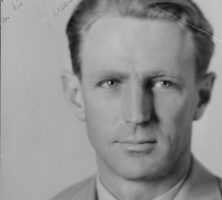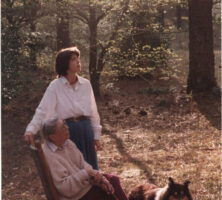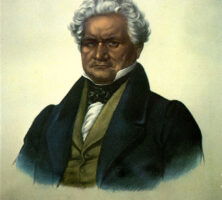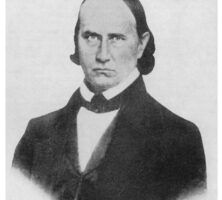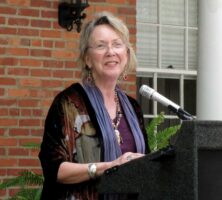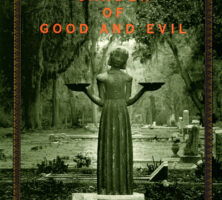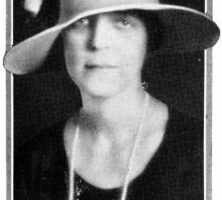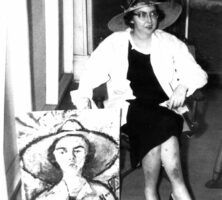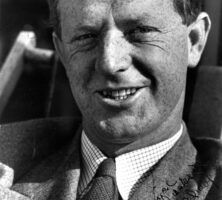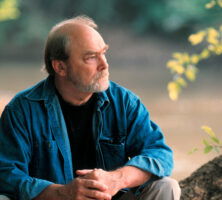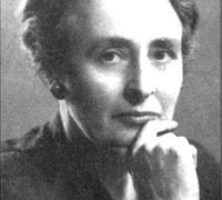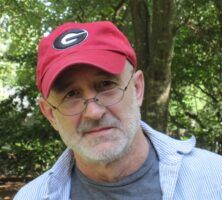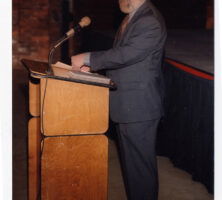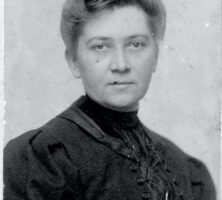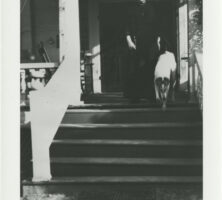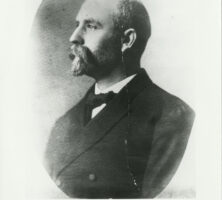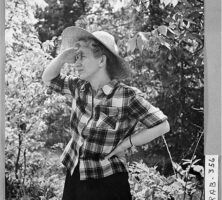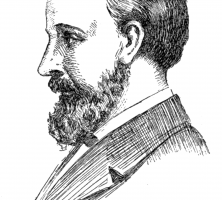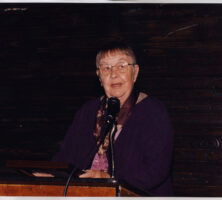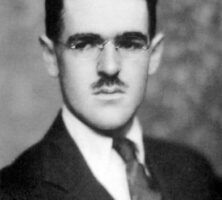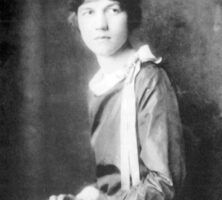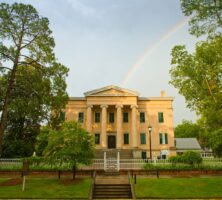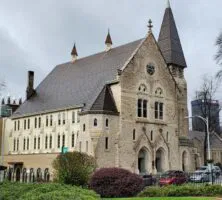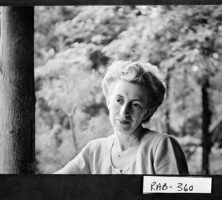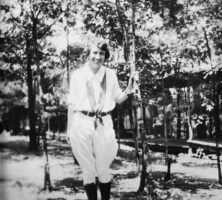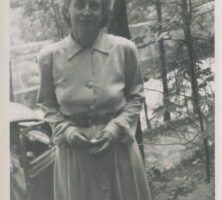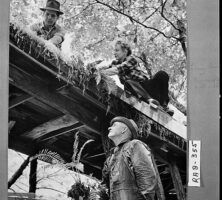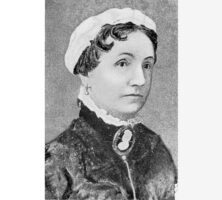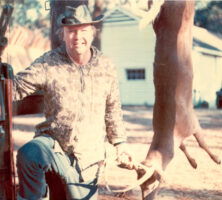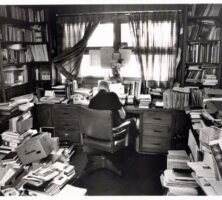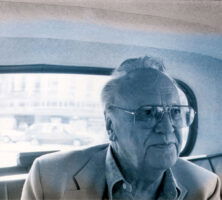The New Georgia Encyclopedia is supported by funding from A More Perfect Union, a special initiative of the National Endowment for the Humanities.
Jericho Brown is an award-winning poet and creator of the “Duplex” form. In 2024 he won a coveted “genius grant” from the MacArthur Foundation.
John D. and Catherine T. MacArthur Foundation
The New Georgia Encyclopedia does not hold the copyright for this media resource and can neither grant nor deny permission to republish or reproduce the image online or in print. All requests for permission to publish or reproduce the resource must be submitted to the rights holder.
Jericho Brown's third collection, The Tradition (2019), finds the poet in full bloom as he works with existing and new forms to examine cycles of violence and terror, love and loss. The collection earned Brown a Pulitzer Prize in 2020.
The New Georgia Encyclopedia does not hold the copyright for this media resource and can neither grant nor deny permission to republish or reproduce the image online or in print. All requests for permission to publish or reproduce the resource must be submitted to the rights holder.
RuPaul Andre Charles was born to Ernestine “Toni” Fontenette and Irving Charles in San Diego, California, on November 17, 1960. His parents, who relocated from the South during the Great Migration, named him after roux, a mixture of flour and fat common in Creole cooking.
Courtesy of Paula Gately Tillman
The New Georgia Encyclopedia does not hold the copyright for this media resource and can neither grant nor deny permission to republish or reproduce the image online or in print. All requests for permission to publish or reproduce the resource must be submitted to the rights holder.
In 1996 RuPaul became the first drag queen and the first openly gay person to host a national television show with the debut of The RuPaul Show on VH1. The show that launched RuPaul into superstardom, RuPaul’s Drag Race, aired its first episode in 2009. The show’s popularity has helped destigmatize the LGBTQ+ community and provided a platform for gay people to publicly discuss experiences of conversion therapy, becoming HIV positive, and coming out to their families and loved ones, among other important issues.
Courtesy of Paula Gately Tillman
The New Georgia Encyclopedia does not hold the copyright for this media resource and can neither grant nor deny permission to republish or reproduce the image online or in print. All requests for permission to publish or reproduce the resource must be submitted to the rights holder.
The television version of The American Music Show debuted on Atlanta’s People TV cable station in early 1981. Dick Richards and James Bond co-hosted, with camerawork and production by Potsy Duncan. When Bond left the show in the early 1980s, Potsy Duncan took over as co-host alongside Richards, while Bud “Beebo” Lowry ran the camera and simultaneously co-hosted, made visible on a monitor between Richards and Duncan.
Courtesy of Paula Gately Tillman
The New Georgia Encyclopedia does not hold the copyright for this media resource and can neither grant nor deny permission to republish or reproduce the image online or in print. All requests for permission to publish or reproduce the resource must be submitted to the rights holder.
Known as the “world’s most famous drag queen,” RuPaul George is a prominent entertainer and television personality. Though he’s most famous for hosting the award-winning RuPaul’s Drag Race, his career began with public access television and club performances in 1980s Atlanta.
Courtesy of Paula Gately Tillman
The New Georgia Encyclopedia does not hold the copyright for this media resource and can neither grant nor deny permission to republish or reproduce the image online or in print. All requests for permission to publish or reproduce the resource must be submitted to the rights holder.
A group of Georgia Muslim protestors hold prayer at the Lutheran Church of the Redeemer in Midtown Atlanta. Members of multiple faiths gathered there in 2017 to protest immigration restrictions against majority-Muslim nations. Since the September 11th attacks in 2001, many Muslim communities have been subjected to government scrutiny and prejudicial acts.
Courtesy of Special Collections & Archives, Georgia State University Library, Atlanta Area Photographers Collection.
The New Georgia Encyclopedia does not hold the copyright for this media resource and can neither grant nor deny permission to republish or reproduce the image online or in print. Requests for permission to publish or reproduce the resource should be submitted to Special Collections and Archives at Georgia State University.
Bilali Mohammed, an enslaved African who lived openly as a Muslim on Sapelo Island, has been a subject of scholarly and popular interest since the nineteenth century. His experience is reflected in the “Bilali Document,” a brief manuscript he wrote concerning Islamic regulations.
Courtesy of Hargrett Rare Book and Manuscript Library, University of Georgia Libraries, Francis R. Goulding papers.
The New Georgia Encyclopedia does not hold the copyright for this media resource and can neither grant nor deny permission to republish or reproduce the image online or in print. Requests for permission to publish or reproduce the resource should be submitted to the Hargrett Manuscript and Rare Book Library at the University of Georgia.
This photograph, taken by Malcolm and Muriel Bell, captures Julius Bailey driving an ox cart along a Sapelo Island road around 1939. The image graces the cover of Drums and Shadows, a study of Black culture in coastal Georgia. Originally published in 1940, the book was reissued by the University of Georgia Press in 1986.
Courtesy of Georgia Historical Society, Muriel Barrow Bell and Malcolm Bell, Jr. collection, #GHS 1283-PH-03-02-101.
The New Georgia Encyclopedia does not hold the copyright for this media resource and can neither grant nor deny permission to republish or reproduce the image online or in print. All requests for permission to publish or reproduce the resource must be submitted to Georgia Historical Society.
A native of Sandersville who grew up in Cordele, Elijah Poole moved north in the Great Migration to escape the depredations of Jim Crow. While in Detroit, he heard a speech by the Nation's founder, Wallace Fard Muhammad, that proposed Islam as a tool for Black empowerment. Poole joined the movement, changed his name to Elijah Muhammad and, upon Fard’s death, assumed leadership of the Nation of Islam. Elijah Muhammad, pictured here at a podium, preached Black self-sufficiency and pride, arguing that Blacks were God’s original people while whites sprang from the devil.
Image from Wikimedia
The New Georgia Encyclopedia does not hold the copyright for this media resource and can neither grant nor deny permission to republish or reproduce the image online or in print. All requests for permission to publish or reproduce the resource must be submitted to the rights holder.
As Georgia became more prosperous in the 1970s, an increasing number of Muslim immigrants settled in the state, especially around Atlanta. These immigrants often retained their cultural and organizational distinctiveness by establishing ethnic-oriented masjids (the proper Arabic term for mosques) to worship apart from previously established masjids dominated by African Americans.
Photograph by Engineering Design Technologies
The New Georgia Encyclopedia does not hold the copyright for this media resource and can neither grant nor deny permission to republish or reproduce the image online or in print. All requests for permission to publish or reproduce the resource must be submitted to the rights holder.
Among the names of enslaved laborers on this Savannah-area planation in 1781 were four with names associated with Islam: Mahomet and Fatima. Mahomet is a Latin version of the name Muhammad, while Fatima was Muhammad’s daughter. Through Islamic names in lists like these and advertisements seeking fugitives from slavery, it is possible to discern the presence of enslaved Muslims in the early South.
From the Royal Georgia Gazette, March 8, 1781.
The New Georgia Encyclopedia does not hold the copyright for this media resource and can neither grant nor deny permission to republish or reproduce the image online or in print. All requests for permission to publish or reproduce the resource must be submitted to the rights holder.
A scenic road cuts through the wilds of Sapelo Island. The barrier island is home to abundant plant and animal life.
Image from Kevin
The New Georgia Encyclopedia does not hold the copyright for this media resource and can neither grant nor deny permission to republish or reproduce the image online or in print. All requests for permission to publish or reproduce the resource must be submitted to the rights holder.
Cornelia Bailey gathers silver grass and life everlasting, an herb used by her grandfather to make medicinal tea, on Sapelo Island. Bailey received a 2004 Governor's Award in the Humanities for her efforts to preserve the island's Geechee culture.
Photograph by Richard Cheppy. Courtesy of Cornelia Bailey
The New Georgia Encyclopedia does not hold the copyright for this media resource and can neither grant nor deny permission to republish or reproduce the image online or in print. All requests for permission to publish or reproduce the resource must be submitted to the rights holder.
Thomas Spalding, a prominent planter and slaveholder, was an agricultural innovator, amateur architect, and businessman in McIntosh County. Spalding relied on enslaved labor to clear and develop Sapelo Island, which he owned.
The New Georgia Encyclopedia does not hold the copyright for this media resource and can neither grant nor deny permission to republish or reproduce the image online or in print. Requests for permission to publish or reproduce the resource should be submitted to the Hargrett Manuscript and Rare Book Library at the University of Georgia.
Famed newspaper magnate William Randolph Hearst purchased the Atlanta Georgian in 1912, expanding his media empire into the South for the first time. Hearst brought in staff from his other newspaper holdings across the country to populate the Atlanta newsroom and, by 1914, it had surpassed the Atlanta Constitution in circulation, making it the second most popular newspaper in Atlanta for a brief period.
Courtesy of Special Collections & Archives, Georgia State University Library, Edmond Torbush Papers, Southern Labor Archives.
The New Georgia Encyclopedia does not hold the copyright for this media resource and can neither grant nor deny permission to republish or reproduce the image online or in print. Requests for permission to publish or reproduce the resource should be submitted to Special Collections and Archives at Georgia State University.
The race massacre of 1906 made international headlines and threatened Atlanta's image as a thriving New South city. The incident, sparked by sensationalized accounts of Black violence, lasted for two nights and resulted in dozens of Black deaths. It was reported in the October 7, 1906, issue of the French publication Le Petit Journal. The original caption translates as "Lynchings in the United States."
The New Georgia Encyclopedia does not hold the copyright for this media resource and can neither grant nor deny permission to republish or reproduce the image online or in print. All requests for permission to publish or reproduce the resource must be submitted to the rights holder.
The Atlanta Georgian, which circulated daily from 1906 to 1939, was the first newspaper in the South owned by William Randolph Hearst and the most prominent example of yellow journalism in Georgia. Under his ownership, the paper expanded circulation to eight or more editions a day and printed increasingly scandalous headlines and illustrations that dramatized local crimes in Atlanta.
Courtesy of Digital Library of Georgia.
The New Georgia Encyclopedia does not hold the copyright for this media resource and can neither grant nor deny permission to republish or reproduce the image online or in print. Requests for permission to publish or reproduce the resource may need to be submitted to the Digital Library of Georgia.
Mildred Seydell was one of the first women in Georgia to work as a professional journalist. A native of Atlanta, Seydell began her career as a correspondent for a West Virginia newspaper before being hired in 1924 as a society-page writer for the Atlanta Georgian.
Courtesy of Stuart A. Rose Manuscript, Archives, and Rare Book Library, Emory University, Mildred Seydell Papers.
The New Georgia Encyclopedia does not hold the copyright for this media resource and can neither grant nor deny permission to republish or reproduce the image online or in print. For more information about this resource, contact the Stuart A. Rose Manuscript, Archives, and Rare Book Library at Emory University.
The American Music Show was a weekly television series created and broadcast in Atlanta from 1981 until 2005. One of the longest-running public access cable television programs, it acquired cult status and helped launch the career of RuPaul, who was an early regular on the show.
From Atlanta Studies
The New Georgia Encyclopedia does not hold the copyright for this media resource and can neither grant nor deny permission to republish or reproduce the image online or in print. All requests for permission to publish or reproduce the resource must be submitted to the rights holder.
The American Music Show's storylines and characters reflect southern tropes, often outrageously rendered, from the perspective of Atlanta’s urban milieu. The fictional Peek family multiplied comically until the family reached mythological proportions. DeAundra Peek, pictured here, went on to host her own cable access show, “DeAundra Peek’s Teenage Music Club,” and perform regularly in Atlanta throughout the 1990s.
Courtesy of Paula Gately Tillman
The New Georgia Encyclopedia does not hold the copyright for this media resource and can neither grant nor deny permission to republish or reproduce the image online or in print. All requests for permission to publish or reproduce the resource must be submitted to the rights holder.
Graham Jackson Sr. began his musical career with the jazz group the Seminole Syncopaters in Atlanta. He performed for Franklin D. Roosevelt over twenty-four times during his career, and at the president's funeral in 1945.
Courtesy of Auburn Avenue Research Library, Graham Washington Jackson, Sr. papers.
The New Georgia Encyclopedia does not hold the copyright for this media resource and can neither grant nor deny permission to republish or reproduce the image online or in print. All requests for permission to publish or reproduce the resource must be submitted to the rights holder.
As part of a campaign to expand the roles for African Americans during World War II, Jackson enlisted and served in the Navy from 1942 until the war's end, in 1945.
Courtesy of Auburn Avenue Research Library, Graham Washington Jackson, Sr. papers.
The New Georgia Encyclopedia does not hold the copyright for this media resource and can neither grant nor deny permission to republish or reproduce the image online or in print. All requests for permission to publish or reproduce the resource must be submitted to the rights holder.
Known as "The Ambassador of Good Will," Graham Jackson Sr. was invited to perform for U.S. presidents throughout his career. Jimmy Carter was the last president for whom Jackson performed.
Courtesy of Auburn Avenue Research Library, Graham Washington Jackson, Sr. papers.
The New Georgia Encyclopedia does not hold the copyright for this media resource and can neither grant nor deny permission to republish or reproduce the image online or in print. All requests for permission to publish or reproduce the resource must be submitted to the rights holder.
Graham Jackson Sr. performed nightly at Johnny Reb's Dixieland canteen and restaurant in Atlanta until 1967.
Courtesy of Special Collections & Archives, Georgia State University Library, Tracy O'Neal Photographic Collection, #N10-23_a.
The New Georgia Encyclopedia does not hold the copyright for this media resource and can neither grant nor deny permission to republish or reproduce the image online or in print. Requests for permission to publish or reproduce the resource should be submitted to Special Collections and Archives at Georgia State University.
The New Georgia Encyclopedia does not hold the copyright for this media resource and can neither grant nor deny permission to republish or reproduce the image online or in print. All requests for permission to publish or reproduce the resource must be submitted to the rights holder.
The New Georgia Encyclopedia does not hold the copyright for this media resource and can neither grant nor deny permission to republish or reproduce the image online or in print. All requests for permission to publish or reproduce the resource must be submitted to the rights holder.
Founded in 1882 by the Gospel Pilgrim Society, the Gospel Pilgrim Cemetery in Athens, GA provided burial spaces for formerly enslaved individuals.
Image from Wikimedia
The New Georgia Encyclopedia does not hold the copyright for this media resource and can neither grant nor deny permission to republish or reproduce the image online or in print. All requests for permission to publish or reproduce the resource must be submitted to the rights holder.
Seashells and broken pottery, like these at Antioch Baptist Cemetery in Fayetteville, Georgia, were often used to decorate the graves of African American and formerly enslaved people.
Courtesy of Marlene Koslowsky
The New Georgia Encyclopedia does not hold the copyright for this media resource and can neither grant nor deny permission to republish or reproduce the image online or in print. All requests for permission to publish or reproduce the resource must be submitted to the rights holder.
Frankie Welch wearing a Cherokee Alphabet dress in front of Duvall House, Alexandria, Virginia, 1968.
Courtesy of Hargrett Rare Book and Manuscript Library, University of Georgia Libraries, Collection of Frankie Welch, Peggy Welch Williams, and Genie Welch Leisure.
The New Georgia Encyclopedia does not hold the copyright for this media resource and can neither grant nor deny permission to republish or reproduce the image online or in print. Requests for permission to publish or reproduce the resource should be submitted to the Hargrett Manuscript and Rare Book Library at the University of Georgia.
Cherokee Alphabet scarf, 1967, silk.
Courtesy of Hargrett Rare Book and Manuscript Library, University of Georgia Libraries, Frankie Welch Textile Collection.
The New Georgia Encyclopedia does not hold the copyright for this media resource and can neither grant nor deny permission to republish or reproduce the image online or in print. Requests for permission to publish or reproduce the resource should be submitted to the Hargrett Manuscript and Rare Book Library at the University of Georgia.
Discover America scarf, ca. 1968, unidentified fabric.
Courtesy of Hargrett Rare Book and Manuscript Library, University of Georgia Libraries, Frankie Welch Textile Collection.
The New Georgia Encyclopedia does not hold the copyright for this media resource and can neither grant nor deny permission to republish or reproduce the image online or in print. Requests for permission to publish or reproduce the resource should be submitted to the Hargrett Manuscript and Rare Book Library at the University of Georgia.
Hubert H. Humphrey scarf, 1968, silk.
Courtesy of Hargrett Rare Book and Manuscript Library, University of Georgia Libraries, Frankie Welch Textile Collection.
The New Georgia Encyclopedia does not hold the copyright for this media resource and can neither grant nor deny permission to republish or reproduce the image online or in print. Requests for permission to publish or reproduce the resource should be submitted to the Hargrett Manuscript and Rare Book Library at the University of Georgia.
Hubert H. Humphrey dress, 1968.
Courtesy of Ashley Callahan
The New Georgia Encyclopedia does not hold the copyright for this media resource and can neither grant nor deny permission to republish or reproduce the image online or in print. All requests for permission to publish or reproduce the resource must be submitted to the rights holder.
Frankie flyer, ca. 1975.
Courtesy of Hargrett Rare Book and Manuscript Library, University of Georgia Libraries, Collection of Frankie Welch, Peggy Welch Williams, and Genie Welch Leisure.
The New Georgia Encyclopedia does not hold the copyright for this media resource and can neither grant nor deny permission to republish or reproduce the image online or in print. Requests for permission to publish or reproduce the resource should be submitted to the Hargrett Manuscript and Rare Book Library at the University of Georgia.
Basket Weave Frankie and Turtles Frankie, n.d.
Courtesy of Hargrett Rare Book and Manuscript Library, University of Georgia Libraries, Frankie Welch Textile Collection.
The New Georgia Encyclopedia does not hold the copyright for this media resource and can neither grant nor deny permission to republish or reproduce the image online or in print. Requests for permission to publish or reproduce the resource should be submitted to the Hargrett Manuscript and Rare Book Library at the University of Georgia.
Republican National Convention Frankie and pinafore, 1968.
Courtesy of Hargrett Rare Book and Manuscript Library, University of Georgia Libraries, (left) Frankie Welch Collection, Rome Area History Center and (right) Frankie Welch Textile Collection, Hargrett Rare Book and Manuscript Library, University of Georgia Libraries.
The New Georgia Encyclopedia does not hold the copyright for this media resource and can neither grant nor deny permission to republish or reproduce the image online or in print. Requests for permission to publish or reproduce the resource should be submitted to the Hargrett Manuscript and Rare Book Library at the University of Georgia.
Models wearing Clyde’s scarf and tie, ca. 1976.
Courtesy of Hargrett Rare Book and Manuscript Library, University of Georgia Libraries, Collection of Frankie Welch, Peggy Welch Williams, and Genie Welch Leisure.
The New Georgia Encyclopedia does not hold the copyright for this media resource and can neither grant nor deny permission to republish or reproduce the image online or in print. Requests for permission to publish or reproduce the resource should be submitted to the Hargrett Manuscript and Rare Book Library at the University of Georgia.
Fifty State Flowers scarf, 1970, cotton.
Courtesy of Hargrett Rare Book and Manuscript Library, University of Georgia Libraries, Collection of Frankie Welch, Peggy Welch Williams, and Genie Welch Leisure.
The New Georgia Encyclopedia does not hold the copyright for this media resource and can neither grant nor deny permission to republish or reproduce the image online or in print. Requests for permission to publish or reproduce the resource should be submitted to the Hargrett Manuscript and Rare Book Library at the University of Georgia.
National Cherry Blossom Festival, Washington, D.C., scarf, 1970, unidentified fabric.
Courtesy of Hargrett Rare Book and Manuscript Library, University of Georgia Libraries, Frankie Welch Collection, Rome Area History Center.
The New Georgia Encyclopedia does not hold the copyright for this media resource and can neither grant nor deny permission to republish or reproduce the image online or in print. Requests for permission to publish or reproduce the resource should be submitted to the Hargrett Manuscript and Rare Book Library at the University of Georgia.
Frankie Welch of Virginia scarf, 1969, silk.
Courtesy of Hargrett Rare Book and Manuscript Library, University of Georgia Libraries, Frankie Welch Textile Collection.
The New Georgia Encyclopedia does not hold the copyright for this media resource and can neither grant nor deny permission to republish or reproduce the image online or in print. Requests for permission to publish or reproduce the resource should be submitted to the Hargrett Manuscript and Rare Book Library at the University of Georgia.
Member of Congress scarf, 1969, silk.
Courtesy of Hargrett Rare Book and Manuscript Library, University of Georgia Libraries, Frankie Welch Collection, Historic Clothing and Textile Collection, College of Family and Consumer Science, University of Georgia.
The New Georgia Encyclopedia does not hold the copyright for this media resource and can neither grant nor deny permission to republish or reproduce the image online or in print. Requests for permission to publish or reproduce the resource should be submitted to the Hargrett Manuscript and Rare Book Library at the University of Georgia.
Washington, D.C., scarf design, ca. 1978.
Courtesy of Hargrett Rare Book and Manuscript Library, University of Georgia Libraries, Collection of Frankie Welch, Peggy Welch Williams, and Genie Welch Leisure.
The New Georgia Encyclopedia does not hold the copyright for this media resource and can neither grant nor deny permission to republish or reproduce the image online or in print. Requests for permission to publish or reproduce the resource should be submitted to the Hargrett Manuscript and Rare Book Library at the University of Georgia.
McDonald’s scarf, 1976, Qiana.
Courtesy of Ashley Callahan
The New Georgia Encyclopedia does not hold the copyright for this media resource and can neither grant nor deny permission to republish or reproduce the image online or in print. All requests for permission to publish or reproduce the resource must be submitted to the rights holder.
McCormick scarf, 1977, Qiana.
Courtesy of Hargrett Rare Book and Manuscript Library, University of Georgia Libraries, Frankie Welch Textile Collection.
The New Georgia Encyclopedia does not hold the copyright for this media resource and can neither grant nor deny permission to republish or reproduce the image online or in print. Requests for permission to publish or reproduce the resource should be submitted to the Hargrett Manuscript and Rare Book Library at the University of Georgia.
McCormick scarf, 1978, polyester.
Courtesy of Hargrett Rare Book and Manuscript Library, University of Georgia Libraries, Frankie Welch Textile Collection.
The New Georgia Encyclopedia does not hold the copyright for this media resource and can neither grant nor deny permission to republish or reproduce the image online or in print. Requests for permission to publish or reproduce the resource should be submitted to the Hargrett Manuscript and Rare Book Library at the University of Georgia.
Red Cross napachief, 1981, unidentified synthetic fabric.
Courtesy of Hargrett Rare Book and Manuscript Library, University of Georgia Libraries, Frankie Welch Textile Collection.
The New Georgia Encyclopedia does not hold the copyright for this media resource and can neither grant nor deny permission to republish or reproduce the image online or in print. Requests for permission to publish or reproduce the resource should be submitted to the Hargrett Manuscript and Rare Book Library at the University of Georgia.
National Treasures (Mount Vernon) scarf, 1993, silk.
Courtesy of Hargrett Rare Book and Manuscript Library, University of Georgia Libraries, Collection of Frankie Welch, Peggy Welch Williams, and Genie Welch Leisure.
The New Georgia Encyclopedia does not hold the copyright for this media resource and can neither grant nor deny permission to republish or reproduce the image online or in print. Requests for permission to publish or reproduce the resource should be submitted to the Hargrett Manuscript and Rare Book Library at the University of Georgia.
BB&T bandana, n.d., cotton.
Courtesy of Hargrett Rare Book and Manuscript Library, University of Georgia Libraries, Collection of Frankie Welch, Peggy Welch Williams, and Genie Welch Leisure.
The New Georgia Encyclopedia does not hold the copyright for this media resource and can neither grant nor deny permission to republish or reproduce the image online or in print. Requests for permission to publish or reproduce the resource should be submitted to the Hargrett Manuscript and Rare Book Library at the University of Georgia.
Betty Ford and Frankie Welch with the Betty Ford scarf, 1975.
U.S. National Archives and Records Administration, U.S. National Archives and Records Administration.
The New Georgia Encyclopedia does not hold the copyright for this media resource and can neither grant nor deny permission to republish or reproduce the image online or in print. All requests for permission to publish or reproduce the resource must be submitted to the rights holder.
Betty Ford scarf/scarves, 1975, Qiana.
Courtesy of Hargrett Rare Book and Manuscript Library, University of Georgia Libraries, Collection of Frankie Welch, Peggy Welch Williams, and Genie Welch Leisure.
The New Georgia Encyclopedia does not hold the copyright for this media resource and can neither grant nor deny permission to republish or reproduce the image online or in print. Requests for permission to publish or reproduce the resource should be submitted to the Hargrett Manuscript and Rare Book Library at the University of Georgia.
Frankie Welch, 1987.
Courtesy of Hargrett Rare Book and Manuscript Library, University of Georgia Libraries, Collection of Frankie Welch, Peggy Welch Williams, and Genie Welch Leisure.
The New Georgia Encyclopedia does not hold the copyright for this media resource and can neither grant nor deny permission to republish or reproduce the image online or in print. Requests for permission to publish or reproduce the resource should be submitted to the Hargrett Manuscript and Rare Book Library at the University of Georgia.
University of Georgia scarf for the President’s Club, 1982, polyester.
Courtesy of Ashley Callahan
The New Georgia Encyclopedia does not hold the copyright for this media resource and can neither grant nor deny permission to republish or reproduce the image online or in print. All requests for permission to publish or reproduce the resource must be submitted to the rights holder.
Garden Club of Georgia scarf, 1978, polyester.
Courtesy of Hargrett Rare Book and Manuscript Library, University of Georgia Libraries, Frankie Welch Textile Collection.
The New Georgia Encyclopedia does not hold the copyright for this media resource and can neither grant nor deny permission to republish or reproduce the image online or in print. Requests for permission to publish or reproduce the resource should be submitted to the Hargrett Manuscript and Rare Book Library at the University of Georgia.
Tobacco Institute scarf, 1978, cotton.
Courtesy of Hargrett Rare Book and Manuscript Library, University of Georgia Libraries, Frankie Welch Textile Collection.
The New Georgia Encyclopedia does not hold the copyright for this media resource and can neither grant nor deny permission to republish or reproduce the image online or in print. Requests for permission to publish or reproduce the resource should be submitted to the Hargrett Manuscript and Rare Book Library at the University of Georgia.
Turtles scarf, designed ca. 1971, Qiana.
Courtesy of Hargrett Rare Book and Manuscript Library, University of Georgia Libraries, Collection of Frankie Welch, Peggy Welch Williams, and Genie Welch Leisure.
The New Georgia Encyclopedia does not hold the copyright for this media resource and can neither grant nor deny permission to republish or reproduce the image online or in print. Requests for permission to publish or reproduce the resource should be submitted to the Hargrett Manuscript and Rare Book Library at the University of Georgia.
Thirteen Original States scarf, designed 1975, Qiana.
Courtesy of Hargrett Rare Book and Manuscript Library, University of Georgia Libraries, Collection of Frankie Welch, Peggy Welch Williams, and Genie Welch Leisure.
The New Georgia Encyclopedia does not hold the copyright for this media resource and can neither grant nor deny permission to republish or reproduce the image online or in print. Requests for permission to publish or reproduce the resource should be submitted to the Hargrett Manuscript and Rare Book Library at the University of Georgia.
National Press Club scarf, 1973, unidentified fabric.
Courtesy of Hargrett Rare Book and Manuscript Library, University of Georgia Libraries, Collection of Frankie Welch, Peggy Welch Williams, and Genie Welch Leisure.
The New Georgia Encyclopedia does not hold the copyright for this media resource and can neither grant nor deny permission to republish or reproduce the image online or in print. Requests for permission to publish or reproduce the resource should be submitted to the Hargrett Manuscript and Rare Book Library at the University of Georgia.
Peanut scarf for Governor and Mrs. Jimmy Carter, 1973, silk.
Courtesy of Ashley Callahan
The New Georgia Encyclopedia does not hold the copyright for this media resource and can neither grant nor deny permission to republish or reproduce the image online or in print. All requests for permission to publish or reproduce the resource must be submitted to the rights holder.
Scarf for the inauguration of Ronald Reagan and George H. W. Bush, 1980, polyester.
Courtesy of Hargrett Rare Book and Manuscript Library, University of Georgia Libraries, Frankie Welch Textile Collection.
The New Georgia Encyclopedia does not hold the copyright for this media resource and can neither grant nor deny permission to republish or reproduce the image online or in print. Requests for permission to publish or reproduce the resource should be submitted to the Hargrett Manuscript and Rare Book Library at the University of Georgia.
Georgia Libraries Association scarf, 1971, Qiana.
Courtesy of Hargrett Rare Book and Manuscript Library, University of Georgia Libraries, Frankie Welch Textile Collection.
The New Georgia Encyclopedia does not hold the copyright for this media resource and can neither grant nor deny permission to republish or reproduce the image online or in print. Requests for permission to publish or reproduce the resource should be submitted to the Hargrett Manuscript and Rare Book Library at the University of Georgia.
Award-winning author and Poet Laureate of Georgia Chelsea Rathburn has served as an ambassador for the literary arts at events across the state. Since 2019, Rathburn has taught creative writing at Mercer University in Macon and continues to work actively in Georgia's literary community.
From Chelsea Rathburn
The New Georgia Encyclopedia does not hold the copyright for this media resource and can neither grant nor deny permission to republish or reproduce the image online or in print. All requests for permission to publish or reproduce the resource must be submitted to the rights holder.
In her third collection of poems, Still Life with Mother and Knife (2019), Chelsea Rathburn navigates themes of women's sexuality, mental health, and healing from adolescence to adulthood. The collection was named one of the "Books All Georgians Should Read" by the Georgia Center for the Book and received the 2020 Eric Hoffer Book Award in Poetry.
From Chelsea Rathburn
The New Georgia Encyclopedia does not hold the copyright for this media resource and can neither grant nor deny permission to republish or reproduce the image online or in print. All requests for permission to publish or reproduce the resource must be submitted to the rights holder.
Chelsea Rathburn's second book, A Raft of Grief (2013), was awarded the 2012 Autumn Press Poetry Prize. In this collection, Rathburn abandons iambics and rhyme in her exploration of personal themes such as marital dysfunction, alcoholism, self-reclamation, and love.
From Chelsea Rathburn
The New Georgia Encyclopedia does not hold the copyright for this media resource and can neither grant nor deny permission to republish or reproduce the image online or in print. All requests for permission to publish or reproduce the resource must be submitted to the rights holder.
William Walsh's award-winning book of poetry, Fly Fishing in Times Square (2020), centers on themes of place and memory as the speaker seeks to reconcile their past and present.
Courtesy of William Walsh
The New Georgia Encyclopedia does not hold the copyright for this media resource and can neither grant nor deny permission to republish or reproduce the image online or in print. All requests for permission to publish or reproduce the resource must be submitted to the rights holder.
Author, professor, and editor William Walsh is known for his work as a southern narrative poet and as an interviewer of contemporary authors.
Courtesy of William Walsh
The New Georgia Encyclopedia does not hold the copyright for this media resource and can neither grant nor deny permission to republish or reproduce the image online or in print. All requests for permission to publish or reproduce the resource must be submitted to the rights holder.
William Walsh's second book, Lost in the White Ruins (2014), examines childhood, regrets of loss, and the search "to find what makes us whole."
Courtesy of William Walsh
The New Georgia Encyclopedia does not hold the copyright for this media resource and can neither grant nor deny permission to republish or reproduce the image online or in print. All requests for permission to publish or reproduce the resource must be submitted to the rights holder.
William Walsh's first novel, Lakewood, was published in 2022.
Courtesy of William Walsh
The New Georgia Encyclopedia does not hold the copyright for this media resource and can neither grant nor deny permission to republish or reproduce the image online or in print. All requests for permission to publish or reproduce the resource must be submitted to the rights holder.
Environmental concerns figure prominently in the work of Georgia author Taylor Brown.
Photograph by Benjamin Galland
The New Georgia Encyclopedia does not hold the copyright for this media resource and can neither grant nor deny permission to republish or reproduce the image online or in print. All requests for permission to publish or reproduce the resource must be submitted to the rights holder.
Taylor Brown's first novel, Fallen Land (2016), follows two youths as they travel from Virginia to the Georgia coast during the Civil War.
St. Martin's Press
The New Georgia Encyclopedia does not hold the copyright for this media resource and can neither grant nor deny permission to republish or reproduce the image online or in print. All requests for permission to publish or reproduce the resource must be submitted to the rights holder.
Taylor Brown's fourth novel, Pride of Eden (2020), takes place in an animal sanctuary on the Georgia coast and explores the plight of wild animals in the modern world.
St. Martin's Press
The New Georgia Encyclopedia does not hold the copyright for this media resource and can neither grant nor deny permission to republish or reproduce the image online or in print. All requests for permission to publish or reproduce the resource must be submitted to the rights holder.
Alice Friman entered the Georgia literary scene in 2001 when she read her work for the Georgia Poetry Circuit. A prolific and accomplished writer, she has earned numerous awards including the Pushcart Prize and the Ezra Pound Poetry Award.
Photograph by Lillian Elaine Wilson
The New Georgia Encyclopedia does not hold the copyright for this media resource and can neither grant nor deny permission to republish or reproduce the image online or in print. All requests for permission to publish or reproduce the resource must be submitted to the rights holder.
In her book The View From Saturn: Poems (2014), Alice Friman explores loss, existentialism, and the natural world.
The New Georgia Encyclopedia does not hold the copyright for this media resource and can neither grant nor deny permission to republish or reproduce the image online or in print. All requests for permission to publish or reproduce the resource must be submitted to the rights holder.
Poet and Bozart Press publisher Ernest Hartsock was an important figure in Atlanta's literary community during the 1920s.
Courtesy of Philip Weltner Library, Oglethorpe University.
The New Georgia Encyclopedia does not hold the copyright for this media resource and can neither grant nor deny permission to republish or reproduce the image online or in print. Requests for permission to publish or reproduce the resource should be submitted to the Philip Weltner Library at Oglethorpe University.
Organizers of the second Atlanta International Pop Festival initially required tickets to enter the gated festival, shown here on opening day, July 3, 1970. However, unruly crowds soon prompted the organizers to allow free entry.
Photograph by Earl McGehee
The New Georgia Encyclopedia does not hold the copyright for this media resource and can neither grant nor deny permission to republish or reproduce the image online or in print. All requests for permission to publish or reproduce the resource must be submitted to the rights holder.
The crowd at the second Atlanta International Pop Festival in Byron. Estimates vary, but the festival likely attracted between 200,000 and 300,000 people.
Courtesy of Atlanta Journal-Constitution.
The New Georgia Encyclopedia does not hold the copyright for this media resource and can neither grant nor deny permission to republish or reproduce the image online or in print. All requests for permission to publish or reproduce the resource must be submitted to the Atlanta Journal-Constitution.
Alex Cooley, pictured in 1978, owned and operated a number of the best-known rock venues in Atlanta, including Alex Cooley's Electric Ballroom and the Tabernacle. In 1987 Cooley was inducted as a nonperformer into the Georgia Music Hall of Fame.
Courtesy of Atlanta Journal-Constitution.
The New Georgia Encyclopedia does not hold the copyright for this media resource and can neither grant nor deny permission to republish or reproduce the image online or in print. All requests for permission to publish or reproduce the resource must be submitted to the Atlanta Journal-Constitution.
This homemade blacklight poster is designed after the 1970 cover of the Second Annual Atlanta International Pop Festival newspaper.
Photograph by Earl McGehee
The New Georgia Encyclopedia does not hold the copyright for this media resource and can neither grant nor deny permission to republish or reproduce the image online or in print. All requests for permission to publish or reproduce the resource must be submitted to the rights holder.
This centerfold from the second Atlanta International Pop Festival program showcases artists including Jimi Hendrix, B.B. King, and The Allman Brothers Band.
Photograph by Earl McGehee
The New Georgia Encyclopedia does not hold the copyright for this media resource and can neither grant nor deny permission to republish or reproduce the image online or in print. All requests for permission to publish or reproduce the resource must be submitted to the rights holder.
The second Atlanta International Pop Festival took place July 3-5, 1970, in Byron.
Photograph by Earl McGehee
The New Georgia Encyclopedia does not hold the copyright for this media resource and can neither grant nor deny permission to republish or reproduce the image online or in print. All requests for permission to publish or reproduce the resource must be submitted to the rights holder.
Scorching temperatures and high winds marked the second Atlanta International Pop Festival. Firetrucks were brought in to hose down attendees while medics treated sunburns.
Photograph by Earl McGehee
The New Georgia Encyclopedia does not hold the copyright for this media resource and can neither grant nor deny permission to republish or reproduce the image online or in print. All requests for permission to publish or reproduce the resource must be submitted to the rights holder.
Litter quickly covered the ground at the second Atlanta International Pop Festival in Byron.
Photograph by Earl McGehee
The New Georgia Encyclopedia does not hold the copyright for this media resource and can neither grant nor deny permission to republish or reproduce the image online or in print. All requests for permission to publish or reproduce the resource must be submitted to the rights holder.
James and Robert Paschal opened Paschal Brothers Soda, a thirty-seat luncheonette at 837 West Hunter Street, in 1947. They are pictured here in 1978.
Courtesy of Special Collections & Archives, Georgia State University Library, Atlanta Journal-Constitution Photographic Archive.
The New Georgia Encyclopedia does not hold the copyright for this media resource and can neither grant nor deny permission to republish or reproduce the image online or in print. Requests for permission to publish or reproduce the resource should be submitted to Special Collections and Archives at Georgia State University.
In 1967 Paschal’s underwent a major expansion with the addition of a six-story, 120-room motel. Paschal’s Motor Hotel was the first Black-owned hotel in Atlanta.
Courtesy of Special Collections & Archives, Georgia State University Library, Atlanta Journal-Constitution Photographic Archive.
The New Georgia Encyclopedia does not hold the copyright for this media resource and can neither grant nor deny permission to republish or reproduce the image online or in print. Requests for permission to publish or reproduce the resource should be submitted to Special Collections and Archives at Georgia State University.
Robert Paschal prepares the restaurant's famous fried chicken, the recipe for which remains a secret to this day.
Courtesy of Special Collections & Archives, Georgia State University Library, Atlanta Journal-Constitution Photographic Archive.
The New Georgia Encyclopedia does not hold the copyright for this media resource and can neither grant nor deny permission to republish or reproduce the image online or in print. Requests for permission to publish or reproduce the resource should be submitted to Special Collections and Archives at Georgia State University.
Representative John Lewis speaks for Atlanta' Concerned Black Clergy at Paschal's Restaurant in 1988. The relationships that James and Robert Paschal built within the city’s Black community made Paschal’s a central meeting spot during the civil rights movement and helped earn the restaurant its reputation as Atlanta’s “Black City Hall.”
Courtesy of Special Collections & Archives, Georgia State University Library, Atlanta Journal-Constitution Photographic Archive.
The New Georgia Encyclopedia does not hold the copyright for this media resource and can neither grant nor deny permission to republish or reproduce the image online or in print. Requests for permission to publish or reproduce the resource should be submitted to Special Collections and Archives at Georgia State University.
Reverend Joseph E. Lowery (right) and mayoral candidate Maynard Jackson at a 1989 campaign event at Paschal's Motor Hotel. Paschal’s was a hotbed of political activity for Atlanta’s African American community.
Courtesy of Special Collections & Archives, Georgia State University Library, Atlanta Journal-Constitution Photographic Archive.
The New Georgia Encyclopedia does not hold the copyright for this media resource and can neither grant nor deny permission to republish or reproduce the image online or in print. Requests for permission to publish or reproduce the resource should be submitted to Special Collections and Archives at Georgia State University.
Shay Younblood is pictured at a Yaddo artist residency in Saratoga Springs, New York. A graduate of Clark College (later Clark Atlanta University), Youngblood has received numerous honors, including a Pushcart Prize, a Lorraine Hansberry Playwriting Award, and several NAACP Theater Awards.
Courtesy of Shay Youngblood, Photograph by Carol Bullard.
The New Georgia Encyclopedia does not hold the copyright for this media resource and can neither grant nor deny permission to republish or reproduce the image online or in print. All requests for permission to publish or reproduce the resource must be submitted to the rights holder.
Shay Youngblood, from Columbus, writes novels, plays, and shorts stories that center on the lives of Black women. Her plays have been staged in theaters across the country, including numerous productions in Atlanta.
Courtesy of Shay Youngblood, Photograph by Miriam Phields.
The New Georgia Encyclopedia does not hold the copyright for this media resource and can neither grant nor deny permission to republish or reproduce the image online or in print. All requests for permission to publish or reproduce the resource must be submitted to the rights holder.
Lauren Gunderson, from Decatur, is one of the most produced playwrights in the United States. Atlanta's Essential Theatre produced her first play when she was still in high school.
The New Georgia Encyclopedia does not hold the copyright for this media resource and can neither grant nor deny permission to republish or reproduce the image online or in print. All requests for permission to publish or reproduce the resource must be submitted to the rights holder.
Anya Krugovoy Silver, a poet and longtime professor at Mercer University, was the author of four collections of poetry. She was named a Guggenheim Fellow in 2018.
Photograph from Mercer University
The New Georgia Encyclopedia does not hold the copyright for this media resource and can neither grant nor deny permission to republish or reproduce the image online or in print. All requests for permission to publish or reproduce the resource must be submitted to the rights holder.
Silver's second book, I Watched You Disappear (2014), won the Georgia Author of the Year award for poetry.
The New Georgia Encyclopedia does not hold the copyright for this media resource and can neither grant nor deny permission to republish or reproduce the image online or in print. All requests for permission to publish or reproduce the resource must be submitted to the rights holder.
Michael Bishop was named to the Georgia Writers Hall of Fame in 2018.
The New Georgia Encyclopedia does not hold the copyright for this media resource and can neither grant nor deny permission to republish or reproduce the image online or in print. All requests for permission to publish or reproduce the resource must be submitted to the rights holder.
Like many of Bishop's works, the 1985 novel Ancient of Days is set in Georgia.
The New Georgia Encyclopedia does not hold the copyright for this media resource and can neither grant nor deny permission to republish or reproduce the image online or in print. All requests for permission to publish or reproduce the resource must be submitted to the rights holder.
The Secret Ascension: Philip K. Dick is Dead, Alas (1987) imagines a parallel universe in which President Richard Nixon, serving his fourth term, has turned the country into a totalitarian police state.
The New Georgia Encyclopedia does not hold the copyright for this media resource and can neither grant nor deny permission to republish or reproduce the image online or in print. All requests for permission to publish or reproduce the resource must be submitted to the rights holder.
Augusta native Frank Yerby came to be known as "king of the costume novel" for his successful works of historical fiction.
Courtesy of Digital Library of Georgia, Georgia Historic Newspapers.
The New Georgia Encyclopedia does not hold the copyright for this media resource and can neither grant nor deny permission to republish or reproduce the image online or in print. Requests for permission to publish or reproduce the resource may need to be submitted to the Digital Library of Georgia.
Sue Monk Kidd is the author of multiple novels, including The Secret Life of Bees and The Invention of Wings.
The New Georgia Encyclopedia does not hold the copyright for this media resource and can neither grant nor deny permission to republish or reproduce the image online or in print. All requests for permission to publish or reproduce the resource must be submitted to the rights holder.
Augustin Verot, known as the "Rebel Bishop" for his support of the Confederacy during the Civil War, became bishop of the Diocese of Savannah in 1861 and led the Catholic community through the turbulent years of war and Reconstruction.
Courtesy of Catholic Diocese of Savannah Archives
The New Georgia Encyclopedia does not hold the copyright for this media resource and can neither grant nor deny permission to republish or reproduce the image online or in print. All requests for permission to publish or reproduce the resource must be submitted to the rights holder.
On January 4, 1861 Augustin Verot delivered a sermon defending the practice of slavery and condemning abolitionism. It was later reprinted as a Confederate tract and circulated throughout the region, earning Verot wide acclaim in southern states.
The New Georgia Encyclopedia does not hold the copyright for this media resource and can neither grant nor deny permission to republish or reproduce the image online or in print. All requests for permission to publish or reproduce the resource must be submitted to the rights holder.
In the aftermath of the Civil War, Augustin Verot called for Catholic bishops to support the construction of schools and churches for freedmen.
The New Georgia Encyclopedia does not hold the copyright for this media resource and can neither grant nor deny permission to republish or reproduce the image online or in print. All requests for permission to publish or reproduce the resource must be submitted to the rights holder.
Mirabeau B. Lamar established the Columbus Enquirer as a four-page weekly newspaper in 1828, the same year the Georgia legislature incorporated the city of Columbus. The issue seen here dates from May of that year.
Courtesy of Digital Library of Georgia.
The New Georgia Encyclopedia does not hold the copyright for this media resource and can neither grant nor deny permission to republish or reproduce the image online or in print. Requests for permission to publish or reproduce the resource may need to be submitted to the Digital Library of Georgia.
Julian Harris, editor and co-owner, with his wife, Julia, of the Columbus Enquirer-Sun, reads mail at his desk in the late 1920s. Harris, the son of Georgia folklorist Joel Chandler Harris, and his wife jointly won a Pulitzer Prize in 1926 for their reporting in the Enquirer-Sun on state officials with ties to the Ku Klux Klan.
Courtesy of Georgia Archives, Vanishing Georgia, #
ful0939-85.
The New Georgia Encyclopedia does not hold the copyright for this media resource and can neither grant nor deny permission to republish or reproduce the image online or in print. Requests for permission to publish or reproduce the resource should be submitted to the Georgia Archives.
The Ledger-Enquirer Building, seen here in the 1930s, was designed by local architecture firm Smith & Biggers. The building was purchased by Columbus State University in 2014.
Courtesy of Atlanta Journal-Constitution.
The New Georgia Encyclopedia does not hold the copyright for this media resource and can neither grant nor deny permission to republish or reproduce the image online or in print. All requests for permission to publish or reproduce the resource must be submitted to the Atlanta Journal-Constitution.
Steve Penley's second book, Ronald Reagan and the American Ideal, was published in 2010.
From Ronald Reagan and the American Ideal, Steve Penley
The New Georgia Encyclopedia does not hold the copyright for this media resource and can neither grant nor deny permission to republish or reproduce the image online or in print. All requests for permission to publish or reproduce the resource must be submitted to the rights holder.
This portrait was published with the Life of William Grimes, the Runaway Slave. The book, the first slave narrative printed in the U.S., was first published in New York City in 1825.
Photograph from Dwight C. Kilbourne, The Bench and Bar of Litchfield County, Connecticut, 1709-1909: Biographical Sketches of Members, History and Catalogue of the Litchfield Law School Historical Notes
The New Georgia Encyclopedia does not hold the copyright for this media resource and can neither grant nor deny permission to republish or reproduce the image online or in print. All requests for permission to publish or reproduce the resource must be submitted to the rights holder.
This map of Savannah River-area rice plantations was created in 1825, the same year William Grimes first published his narrative in New York City. Grimes served six enslavers in Savannah between 1811 and 1815 before escaping to freedom in New England.
Chatham County Map Portfolio, compiled by workers of the Writers program of the Works Projects Administration in the State of Georgia. Sponsored by the Georgia Society of the Colonial Dames of America.
The New Georgia Encyclopedia does not hold the copyright for this media resource and can neither grant nor deny permission to republish or reproduce the image online or in print. All requests for permission to publish or reproduce the resource must be submitted to the rights holder.
The Student was painted circa 1937. This was about five years after Hutchinson's first large-scale solo exhibition, which was at the High Musuem of Art in Atlanta. She lived in New York at the time.
Courtesy of Archives Division, Auburn Avenue Research Library on African American Culture and History, Atlanta-Fulton Public Library System
The New Georgia Encyclopedia does not hold the copyright for this media resource and can neither grant nor deny permission to republish or reproduce the image online or in print. All requests for permission to publish or reproduce the resource must be submitted to the rights holder.
The High Museum of Art in Atlanta acquired this painting, painted circa 1933, in 1934 and prominently displayed it through the 1930s. After many years in storage, the museum deaccessioned the work.
Courtesy of Jason Schoen
The New Georgia Encyclopedia does not hold the copyright for this media resource and can neither grant nor deny permission to republish or reproduce the image online or in print. All requests for permission to publish or reproduce the resource must be submitted to the rights holder.
Mary E. Hutchinson working on a portrait of Don Sheldon, a personal friend, in 1950.
The New Georgia Encyclopedia does not hold the copyright for this media resource and can neither grant nor deny permission to republish or reproduce the image online or in print. For more information about this resource, contact the Stuart A. Rose Manuscript, Archives, and Rare Book Library at Emory University.
Mary E. Hutchinson's Dream of Violets is a self-portrait she painted circa 1942.
Courtesy of Hutchinson Estate Private Collection
The New Georgia Encyclopedia does not hold the copyright for this media resource and can neither grant nor deny permission to republish or reproduce the image online or in print. All requests for permission to publish or reproduce the resource must be submitted to the rights holder.
Joanna Lanza, pictured, was Hutchinson's first partner and primary model from 1931 to 1935.
Courtesy of Hutchinson Estate Private Collection
The New Georgia Encyclopedia does not hold the copyright for this media resource and can neither grant nor deny permission to republish or reproduce the image online or in print. All requests for permission to publish or reproduce the resource must be submitted to the rights holder.
Don Sheldon was Hutchinson's personal friend. He worked as a window dresser for Rich's Department Store in Atlanta. This portrait was made in 1950.
Courtesy of Hutchinson Estate Private Collection
The New Georgia Encyclopedia does not hold the copyright for this media resource and can neither grant nor deny permission to republish or reproduce the image online or in print. All requests for permission to publish or reproduce the resource must be submitted to the rights holder.
Mary E. Hutchinson attending the Washington Square Sidewalk Show in New York City, circa 1932. Hutchinson's first solo New York exhibition was in 1934. She moved back to Atlanta in 1945.
The New Georgia Encyclopedia does not hold the copyright for this media resource and can neither grant nor deny permission to republish or reproduce the image online or in print. For more information about this resource, contact the Stuart A. Rose Manuscript, Archives, and Rare Book Library at Emory University.
Space Station III (1989) by Joseph Perrin is part of Georgia's State Art Collection. Acrylic, 44 x 37 inches
Courtesy of Georgia Council for the Arts, Georgia's State Art Collection.
The New Georgia Encyclopedia does not hold the copyright for this media resource and can neither grant nor deny permission to republish or reproduce the image online or in print. Requests for permission to publish or reproduce the resource should be submitted to the Georgia Council for the Arts.
Chroma (1974) by Joseph Perrin is part of Georgia's State Art Collection. Mixed media, 48 x 60 inches
Courtesy of Georgia Council for the Arts, Georgia's State Art Collection.
The New Georgia Encyclopedia does not hold the copyright for this media resource and can neither grant nor deny permission to republish or reproduce the image online or in print. Requests for permission to publish or reproduce the resource should be submitted to the Georgia Council for the Arts.
Chroma #160 (1989) by Joseph Perrin is part of Georgia's State Art Collection. Print (silkscreen), 37 1/4 x 25 1/2 inches
Courtesy of Georgia Council for the Arts, Georgia's State Art Collection.
The New Georgia Encyclopedia does not hold the copyright for this media resource and can neither grant nor deny permission to republish or reproduce the image online or in print. Requests for permission to publish or reproduce the resource should be submitted to the Georgia Council for the Arts.
Shapes and Sky by James McRae is part of Georgia's State Art Collection. Acrylic, 30 x 27 1/2 inches
Courtesy of Georgia Council for the Arts, Georgia's State Art Collection.
The New Georgia Encyclopedia does not hold the copyright for this media resource and can neither grant nor deny permission to republish or reproduce the image online or in print. Requests for permission to publish or reproduce the resource should be submitted to the Georgia Council for the Arts.
Cooking Utensils by Ivan F. Bailey is part of Georgia's State Art Collection. Iron
Courtesy of Georgia Council for the Arts, Georgia's State Art Collection.
The New Georgia Encyclopedia does not hold the copyright for this media resource and can neither grant nor deny permission to republish or reproduce the image online or in print. Requests for permission to publish or reproduce the resource should be submitted to the Georgia Council for the Arts.
Untitled (1977) by Ivan F. Bailey is part of Georgia's State Art Collection. Iron, 11 1/2 x 18 x 8 inches
Courtesy of Georgia Council for the Arts, Georgia's State Art Collection.
The New Georgia Encyclopedia does not hold the copyright for this media resource and can neither grant nor deny permission to republish or reproduce the image online or in print. Requests for permission to publish or reproduce the resource should be submitted to the Georgia Council for the Arts.
Hey Diddle Fiddle (1970) by Byron McKeeby is part of Georgia's State Art Collection. Print, 28 x 20 1/4 inches
Courtesy of Georgia Council for the Arts, Georgia's State Art Collection.
The New Georgia Encyclopedia does not hold the copyright for this media resource and can neither grant nor deny permission to republish or reproduce the image online or in print. Requests for permission to publish or reproduce the resource should be submitted to the Georgia Council for the Arts.
Turtlemen with Turtlehooks (1985) by John T. Riddle Jr. is part of Georgia's State Art Collection. Print (silkscreen), 28 x 20 inches
Courtesy of Georgia Council for the Arts, Georgia's State Art Collection.
The New Georgia Encyclopedia does not hold the copyright for this media resource and can neither grant nor deny permission to republish or reproduce the image online or in print. Requests for permission to publish or reproduce the resource should be submitted to the Georgia Council for the Arts.
Clubs Is Trumps (date unknown) by John T. Riddle Jr. is part of Georgia's State Art Collection. Mixed media, 49 x 35 inches
Courtesy of Georgia Council for the Arts, Georgia's State Art Collection.
The New Georgia Encyclopedia does not hold the copyright for this media resource and can neither grant nor deny permission to republish or reproduce the image online or in print. Requests for permission to publish or reproduce the resource should be submitted to the Georgia Council for the Arts.
Harriet Tubman: Carrying Out the Plan (1981) by John T. Riddle Jr. is part of Georgia's State Art Collection. Print
Courtesy of Georgia Council for the Arts, Georgia's State Art Collection.
The New Georgia Encyclopedia does not hold the copyright for this media resource and can neither grant nor deny permission to republish or reproduce the image online or in print. Requests for permission to publish or reproduce the resource should be submitted to the Georgia Council for the Arts.
Harriet Tubman: Carrying Out the Plan (1981) by John T. Riddle Jr. is part of Georgia's State Art Collection. Print
Courtesy of Georgia Council for the Arts, Georgia's State Art Collection.
The New Georgia Encyclopedia does not hold the copyright for this media resource and can neither grant nor deny permission to republish or reproduce the image online or in print. Requests for permission to publish or reproduce the resource should be submitted to the Georgia Council for the Arts.
Untitled #74 (date unknown) by Herbert Creecy is part of Georgia's State Art Collection. Acrylic, 37 x 37 inches
Courtesy of Georgia Council for the Arts, Georgia's State Art Collection.
The New Georgia Encyclopedia does not hold the copyright for this media resource and can neither grant nor deny permission to republish or reproduce the image online or in print. Requests for permission to publish or reproduce the resource should be submitted to the Georgia Council for the Arts.
Cube (date unknown) by Herbert Creecy is part of Georgia's State Art Collection. Acrylic, 42 x 46 1/2 inches
Courtesy of Georgia Council for the Arts, Georgia's State Art Collection.
The New Georgia Encyclopedia does not hold the copyright for this media resource and can neither grant nor deny permission to republish or reproduce the image online or in print. Requests for permission to publish or reproduce the resource should be submitted to the Georgia Council for the Arts.
Study #8 (date unknown) by Herbert Creecy is part of Georgia's State Art Collection. Acrylic, 40 1/2 x 36 inches
Courtesy of Georgia Council for the Arts, Georgia's State Art Collection.
The New Georgia Encyclopedia does not hold the copyright for this media resource and can neither grant nor deny permission to republish or reproduce the image online or in print. Requests for permission to publish or reproduce the resource should be submitted to the Georgia Council for the Arts.
Study #44 (date unknown) by Herbert Creecy is part of Georgia's State Art Collection. Acrylic, 30 1/2 x 27 inches
Courtesy of Georgia Council for the Arts, Georgia's State Art Collection.
The New Georgia Encyclopedia does not hold the copyright for this media resource and can neither grant nor deny permission to republish or reproduce the image online or in print. Requests for permission to publish or reproduce the resource should be submitted to the Georgia Council for the Arts.
Study #17 (date unknown) by Herbert Creecy is part of Georgia's State Art Collection. Print (silkscreen), 31 x 27 inches
Courtesy of Georgia Council for the Arts, Georgia's State Art Collection.
The New Georgia Encyclopedia does not hold the copyright for this media resource and can neither grant nor deny permission to republish or reproduce the image online or in print. Requests for permission to publish or reproduce the resource should be submitted to the Georgia Council for the Arts.
The Walking Dead televsion series is adaptated from a comic book created in 2003 by Robert Kirkman and Tony Moore. The series premiered on the AMC cable network on October 31, 2010.
The New Georgia Encyclopedia does not hold the copyright for this media resource and can neither grant nor deny permission to republish or reproduce the image online or in print. All requests for permission to publish or reproduce the resource must be submitted to the rights holder.
The Walking Dead comic book series, created by writer Robert Kirkman and artist Tony Moore, was first published in 2003. The popularity of the comic increased dramatically with the premiere of The Walking Dead television series in 2010, and two years later it had become the best-selling independent comic book series.
The New Georgia Encyclopedia does not hold the copyright for this media resource and can neither grant nor deny permission to republish or reproduce the image online or in print. All requests for permission to publish or reproduce the resource must be submitted to the rights holder.
Carlotta O'Neill, the wife of playwright Eugene O'Neill, stands outside Casa Genotta, their home on Sea Island. The O'Neills built the house in 1932 and lived there until 1936.
Courtesy of National Park Service
The New Georgia Encyclopedia does not hold the copyright for this media resource and can neither grant nor deny permission to republish or reproduce the image online or in print. All requests for permission to publish or reproduce the resource must be submitted to the rights holder.
Eugene O'Neill, a prominent playwright, and his wife, Carlotta, are pictured in a portrait by Carl Van Vechten in September 1933. In 1932 the O'Neills built a new home, Casa Genotta, on Sea Island and lived there until 1936. O'Neill wrote several plays during their residence, including his only comedy, Ah Wilderness!, and the first draft of A Touch of the Poet.
Courtesy of Library of Congress, Prints and Photographs Division, Photograph by Carl Van Vechten.
The New Georgia Encyclopedia does not hold the copyright for this media resource and can neither grant nor deny permission to republish or reproduce the image online or in print. All requests for permission to publish or reproduce the resource must be submitted to the rights holder.
The Georgia Radio Hall of Fame was founded in 2007 to honor the work of Georgia's radio professionals and to preserve the history of Georgia radio.
Courtesy of the Georgia Radio Hall of Fame
The New Georgia Encyclopedia does not hold the copyright for this media resource and can neither grant nor deny permission to republish or reproduce the image online or in print. All requests for permission to publish or reproduce the resource must be submitted to the rights holder.
Elmo Ellis's 1950s campaign, "Removing the Rust from Radio," encouraged the revitalization of radio in the wake of television's growing popularity. Ellis was honored with a Peabody Award and was inducted into the Georgia Association of Broadcasters Hall of Fame.
Courtesy of History of WSB Radio
The New Georgia Encyclopedia does not hold the copyright for this media resource and can neither grant nor deny permission to republish or reproduce the image online or in print. All requests for permission to publish or reproduce the resource must be submitted to the rights holder.
Sam Hale, cofounder of the Georgia Radio Hall of Fame, welcomes guests to the organization's inaugural induction awards ceremony, held in Atlanta in 2007.
Courtesy of the Georgia Radio Hall of Fame
The New Georgia Encyclopedia does not hold the copyright for this media resource and can neither grant nor deny permission to republish or reproduce the image online or in print. All requests for permission to publish or reproduce the resource must be submitted to the rights holder.
John Long (left), cofounder of the Georgia Radio Hall of Fame, accepts a commendation from Georgia governor Sonny Perdue (not pictured) at the organization's inaugural induction awards ceremony, held in Atlanta in 2007.
Courtesy of Georgia Radio Hall of Fame
The New Georgia Encyclopedia does not hold the copyright for this media resource and can neither grant nor deny permission to republish or reproduce the image online or in print. All requests for permission to publish or reproduce the resource must be submitted to the rights holder.
In this photograph, taken by George N. Barnard, Union general William T. Sherman sits astride his horse at Federal Fort No. 7 in Atlanta. Sherman's Atlanta campaign, which lasted through the spring and summer of 1864, resulted in the fall of the city on September 2.
Courtesy of Library of Congress, Prints and Photographs Division, Photograph by George N. Barnard, #LC-DIG-cwpb-03628.
The New Georgia Encyclopedia does not hold the copyright for this media resource and can neither grant nor deny permission to republish or reproduce the image online or in print. All requests for permission to publish or reproduce the resource must be submitted to the rights holder.
Five enslaved people are pictured at Turnwold Plantation, the Eatonton estate of Joseph Addison Turner. Writer Joel Chandler Harris, who lived at Turnwold during the Civil War, drew upon his experiences there to write his Uncle Remus tales, as well as his autobiographical novel On the Plantation.
The New Georgia Encyclopedia does not hold the copyright for this media resource and can neither grant nor deny permission to republish or reproduce the image online or in print. For more information about this resource, contact the Stuart A. Rose Manuscript, Archives, and Rare Book Library at Emory University.
Margaret Mitchell's epic Civil War love story, Gone With the Wind, was published in June 1936. Mitchell was awarded the Pulitzer Prize for the novel in May 1937.
Courtesy of Atlanta Journal-Constitution.
The New Georgia Encyclopedia does not hold the copyright for this media resource and can neither grant nor deny permission to republish or reproduce the image online or in print. All requests for permission to publish or reproduce the resource must be submitted to the Atlanta Journal-Constitution.
Philip Lee Williams, a native of Madison, won the 2004 Michael Shaara Prize for Civil War Fiction for his novel A Distant Flame (2004). The novel chronicles the experiences of protagonist Charlie Merrill before, during, and after the Atlanta campaign of 1864.
The New Georgia Encyclopedia does not hold the copyright for this media resource and can neither grant nor deny permission to republish or reproduce the image online or in print. All requests for permission to publish or reproduce the resource must be submitted to the rights holder.
December 26, 1972, 8:29 by Maurice Clifford is part of Georgia's State Art Collection. Pencil, 30 x 22 3/8 inches
Courtesy of Georgia Council for the Arts, Georgia's State Art Collection.
The New Georgia Encyclopedia does not hold the copyright for this media resource and can neither grant nor deny permission to republish or reproduce the image online or in print. Requests for permission to publish or reproduce the resource should be submitted to the Georgia Council for the Arts.
C Series #2 (1977) by Freddie L. Styles is part of Georgia's State Art Collection. Acrylic, 34 x 45 inches
Courtesy of Georgia Council for the Arts, Georgia's State Art Collection.
The New Georgia Encyclopedia does not hold the copyright for this media resource and can neither grant nor deny permission to republish or reproduce the image online or in print. Requests for permission to publish or reproduce the resource should be submitted to the Georgia Council for the Arts.
A folklorist and professor of English at Georgia State University in Atlanta, John A. Burrison has helped shape an entire academic field of specialty, that of folk pottery. He holds a couple of face "jugs."
Courtesy of John Burrison. Photograph by Carolyn Richardson
The New Georgia Encyclopedia does not hold the copyright for this media resource and can neither grant nor deny permission to republish or reproduce the image online or in print. All requests for permission to publish or reproduce the resource must be submitted to the rights holder.
Mossy Creek potter Lanier Meaders (left) with folklorist John A. Burrison in 1970. The painted vases on the kiln were made by Lanier's mother, Arie Meaders. The Meaders family is one of the best-known traditional potter families in northeast Georgia.
Courtesy of John Burrison. Photograph by Dick Pillsbury
The New Georgia Encyclopedia does not hold the copyright for this media resource and can neither grant nor deny permission to republish or reproduce the image online or in print. All requests for permission to publish or reproduce the resource must be submitted to the rights holder.
Members of the First Congregational Church, including the Reverend Henry Hugh Proctor (standing seventh from left), in Atlanta are pictured circa 1899. Today the church is an affiliate of the United Church of Christ, which formed in 1957.
Courtesy of Library of Congress, Prints and Photographs Division
The New Georgia Encyclopedia does not hold the copyright for this media resource and can neither grant nor deny permission to republish or reproduce the image online or in print. All requests for permission to publish or reproduce the resource must be submitted to the rights holder.
Henry Hugh Proctor, the minister at First Congregational Church in Atlanta from 1894 until 1920, is pictured circa 1900. In 1910 Proctor founded the Atlanta Colored Music Festival Association, which produced annual concerts by classically trained African American performers for nearly a decade.
Courtesy of Library of Congress, Prints and Photographs Division
The New Georgia Encyclopedia does not hold the copyright for this media resource and can neither grant nor deny permission to republish or reproduce the image online or in print. All requests for permission to publish or reproduce the resource must be submitted to the rights holder.
DeForest Kelley, an Atlanta native, was an actor best known for playing the role of Dr. Leonard "Bones" McCoy in the television series Star Trek and feature films.
From the collections of the Margaret Herrick Library
The New Georgia Encyclopedia does not hold the copyright for this media resource and can neither grant nor deny permission to republish or reproduce the image online or in print. All requests for permission to publish or reproduce the resource must be submitted to the rights holder.
Young John Allen, born in Burke County and raised in Meriwether County, traveled as a Methodist missionary to Shanghai, China, in 1860 and remained there for much of his life. In addition to his ministry, Allen worked as a journalist and founded a college in Shanghai.
The New Georgia Encyclopedia does not hold the copyright for this media resource and can neither grant nor deny permission to republish or reproduce the image online or in print. For more information about this resource, contact the Stuart A. Rose Manuscript, Archives, and Rare Book Library at Emory University.
Mary Houston Allen, the wife of Young John Allen, a Methodist missionary to China, is pictured with her children, circa 1870. Before her marriage, Allen attended Wesleyan College in Macon.
The New Georgia Encyclopedia does not hold the copyright for this media resource and can neither grant nor deny permission to republish or reproduce the image online or in print. For more information about this resource, contact the Stuart A. Rose Manuscript, Archives, and Rare Book Library at Emory University.
Young John Allen (center), a Georgia native and Methodist missionary to Shanghai, China, is pictured with two Chinese writers, identified as Tsai and Yin, circa 1900. During his many decades in China, Allen founded the publication (Church News) and translated books.
The New Georgia Encyclopedia does not hold the copyright for this media resource and can neither grant nor deny permission to republish or reproduce the image online or in print. For more information about this resource, contact the Stuart A. Rose Manuscript, Archives, and Rare Book Library at Emory University.
The Reverend Dwight Andrews (left), of First Congregational Church, and Steven Darsey, of Meridian Herald, are pictured at the Atlanta Music Festival in 2009. The two cofounded the festival in 2001.
Courtesy of Meridian Herald
The New Georgia Encyclopedia does not hold the copyright for this media resource and can neither grant nor deny permission to republish or reproduce the image online or in print. All requests for permission to publish or reproduce the resource must be submitted to the rights holder.
The Atlanta Auditorium and Armory (later Atlanta Municipal Auditorium), pictured circa 1916, was the venue in 1910 for the first concert presented by the Atlanta Colored Music Festival Association. The concerts continued annually until about 1918.
Courtesy of Georgia Archives, Vanishing Georgia, # ful0183.
The New Georgia Encyclopedia does not hold the copyright for this media resource and can neither grant nor deny permission to republish or reproduce the image online or in print. Requests for permission to publish or reproduce the resource should be submitted to the Georgia Archives.
Atlanta Constitution journalists and Pulitzer Prize winners Gene Patterson (left), Ralph McGill (center), and Jack Nelson are pictured circa 1967, the year Patterson received the award.
Courtesy of Atlanta Journal-Constitution.
The New Georgia Encyclopedia does not hold the copyright for this media resource and can neither grant nor deny permission to republish or reproduce the image online or in print. All requests for permission to publish or reproduce the resource must be submitted to the Atlanta Journal-Constitution.
Gene Patterson, pictured in 2002, was an influential editor of the Atlanta Constitution during the civil rights movement and later founded Georgia Trend magazine.
Courtesy of Atlanta Journal-Constitution.
The New Georgia Encyclopedia does not hold the copyright for this media resource and can neither grant nor deny permission to republish or reproduce the image online or in print. All requests for permission to publish or reproduce the resource must be submitted to the Atlanta Journal-Constitution.
Albany native Paula Deen, a well-known restaurateur and television personality, is the host of Paula's Home Cooking, which premiered on the Food Network in 2002. Her restaurant, The Lady and Sons, is a popular tourist destination in Savannah.
Photograph from Paula Deen
The New Georgia Encyclopedia does not hold the copyright for this media resource and can neither grant nor deny permission to republish or reproduce the image online or in print. All requests for permission to publish or reproduce the resource must be submitted to the rights holder.
Paula Deen's iconic restaurant The Lady and Sons opened in downtown Savannah in 1996 and features such southern favorites as fried green tomatoes and hoecakes. In 2004 she opened another restaurant in Savannah, Uncle Bubba's Oyster House, with her younger brother.
Image from Steven Miller
The New Georgia Encyclopedia does not hold the copyright for this media resource and can neither grant nor deny permission to republish or reproduce the image online or in print. All requests for permission to publish or reproduce the resource must be submitted to the rights holder.
Paula Deen published her first cookbook, The Lady and Sons: Savannah Country Cookbook, in 1997, one year after opening The Lady and Sons restaurant in Savannah. She became well known outside the South by selling the cookbook on QVC, a home-shopping television network.
The New Georgia Encyclopedia does not hold the copyright for this media resource and can neither grant nor deny permission to republish or reproduce the image online or in print. All requests for permission to publish or reproduce the resource must be submitted to the rights holder.
Atlanta-based Alton Brown, the host and producer of the Food Network's television series Good Eats, has written numerous books about cooking, including I'm Just Here for the Food (2002) and Good Eats: The Early Years (2009).
The New Georgia Encyclopedia does not hold the copyright for this media resource and can neither grant nor deny permission to republish or reproduce the image online or in print. All requests for permission to publish or reproduce the resource must be submitted to the rights holder.
Alton Brown, raised in White County, is a food television personality and producer based in Atlanta. His cooking show, Good Eats, premiered in 1999 and received a George Foster Peabody Award from the University of Georgia in 2007.
Photograph from UGA Today
The New Georgia Encyclopedia does not hold the copyright for this media resource and can neither grant nor deny permission to republish or reproduce the image online or in print. All requests for permission to publish or reproduce the resource must be submitted to the rights holder.
Southern Poetry Review, one of the oldest literary journals in the Southeast, was founded in Florida in 1958 and has been based at Armstrong State University in Savannah since 2002. Pictured is the cover of the journal's fall 2006 issue, featuring a photograph by Dave Beckerman entitled The Secret Garden.
The New Georgia Encyclopedia does not hold the copyright for this media resource and can neither grant nor deny permission to republish or reproduce the image online or in print. All requests for permission to publish or reproduce the resource must be submitted to the rights holder.
J. Richardson Jones, an Atlanta native, was a journalist, filmmaker, and entertainer whose work both challenged segregation and celebrated African American life during the Jim Crow era.
Courtesy of Atlanta History Center.
The New Georgia Encyclopedia does not hold the copyright for this media resource and can neither grant nor deny permission to republish or reproduce the image online or in print. Requests for permission to publish or reproduce the resource should be submitted to the Atlanta History Center.
J. Richardson Jones, kneeling right, is pictured on a handbill from the 1925 production of his play Thy Will Be Done at the Strand Theatre in Jacksonville, Florida. The play was later produced in July 1926 at the Douglass Theatre in Macon. An Atlanta native, Jones began his career in vaudeville and radio, and later became a journalist for the Atlanta Daily World.
Courtesy of Middle Georgia Archives, Washington Memorial Library.
The New Georgia Encyclopedia does not hold the copyright for this media resource and can neither grant nor deny permission to republish or reproduce the image online or in print. Requests for permission to publish or reproduce the resource may need to be submitted to the Middle Georgia Archives at Washington Memorial Library.
A poster advertises Parade of Negro Progress, a Technicolor feature film based on a short newsreel produced in 1939 by J. Richardson Jones as an advertisement for the Atlanta Life Insurance Company. The feature played in all-Black theaters around the South in 1941-42.
Courtesy of Archives Division, Auburn Avenue Research Library on African American Culture and History, Atlanta-Fulton Public Library System
The New Georgia Encyclopedia does not hold the copyright for this media resource and can neither grant nor deny permission to republish or reproduce the image online or in print. All requests for permission to publish or reproduce the resource must be submitted to the rights holder.
Oakland Cemetery in Atlanta is the final resting place for 6,900 Confederate soliders, including 5 generals, as well as 16 Union soldiers.
Ren and Helen Davis
The New Georgia Encyclopedia does not hold the copyright for this media resource and can neither grant nor deny permission to republish or reproduce the image online or in print. All requests for permission to publish or reproduce the resource must be submitted to the rights holder.
Around 500 Confederate soldiers and 1 Union soldier are buried at the Stonewall Confederate Cemetery in Griffin.
Photograph by Melinda Smith Mullikin, New Georgia Encyclopedia
The New Georgia Encyclopedia does not hold the copyright for this media resource and can neither grant nor deny permission to republish or reproduce the image online or in print. All requests for permission to publish or reproduce the resource must be submitted to the rights holder.
The Confederate section of Linwood Cemetery in Columbus holds around 200 Confederate soldiers killed during the Civil War.
Courtesy of Historic Linwood Foundation, Inc.
The New Georgia Encyclopedia does not hold the copyright for this media resource and can neither grant nor deny permission to republish or reproduce the image online or in print. All requests for permission to publish or reproduce the resource must be submitted to the rights holder.
The Marietta National Cemetery is located at 500 Washington Avenue in Marietta. There are more than 10,000 Union soldiers buried here, with approximately 3,000 of them unknown. Confederate soldiers were interred at a separate Confederate cemetery in Marietta.
Image from Ron Zanoni
The New Georgia Encyclopedia does not hold the copyright for this media resource and can neither grant nor deny permission to republish or reproduce the image online or in print. All requests for permission to publish or reproduce the resource must be submitted to the rights holder.
Andersonville National Cemetery in Macon County holds approximately 13,000 Union soldiers who died while imprisoned at Andersonville Prison in 1864-65. It was designated a national cemetery in 1866 and is managed today by the National Park Service.
Image from Bubba73 (talk), Jud McCranie
The New Georgia Encyclopedia does not hold the copyright for this media resource and can neither grant nor deny permission to republish or reproduce the image online or in print. All requests for permission to publish or reproduce the resource must be submitted to the rights holder.
Marching through Georgia, one of the best-known songs of the Civil War, was composed in 1865 by Henry Clay Work. The song celebrates the success of Union general William T. Sherman's march to the sea in 1864.
The New Georgia Encyclopedia does not hold the copyright for this media resource and can neither grant nor deny permission to republish or reproduce the image online or in print. All requests for permission to publish or reproduce the resource must be submitted to the rights holder.
Athos Menaboni's 1962 lithograph Mourning Dove (26" x 20") is housed at the Morris Museum of Art in Augusta. Menaboni is best known for his detailed paintings of birds, usually portrayed in pairs in their natural habitats.
Courtesy of Morris Museum of Art
The New Georgia Encyclopedia does not hold the copyright for this media resource and can neither grant nor deny permission to republish or reproduce the image online or in print. All requests for permission to publish or reproduce the resource must be submitted to the rights holder.
Athos Menaboni, pictured in 1945, stands in his aviary studying a golden eagle.
Courtesy of Special Collections & Archives, Georgia State University Library, Atlanta Journal-Constitution Photographic Archive.
The New Georgia Encyclopedia does not hold the copyright for this media resource and can neither grant nor deny permission to republish or reproduce the image online or in print. Requests for permission to publish or reproduce the resource should be submitted to Special Collections and Archives at Georgia State University.
Artist Athos Menaboni was renowned for his detailed paintings of birds. He and his wife, Sara, obtained permits to capture rare and protected species for study at their home near Atlanta. Menaboni's 1962 lithograph Bobwhite (26" x 20") is housed at the Morris Museum of Art in Augusta.
Courtesy of Morris Museum of Art
The New Georgia Encyclopedia does not hold the copyright for this media resource and can neither grant nor deny permission to republish or reproduce the image online or in print. All requests for permission to publish or reproduce the resource must be submitted to the rights holder.
Artist Athos Menaboni made his first bird painting in 1937, when he painted a cardinal from memory during a lull in commissioned work. His c. 1948 lithograph Cardinals (13 1/4" x 10 1/2") is housed at the Morris Museum of Art in Augusta.
Courtesy of Morris Museum of Art
The New Georgia Encyclopedia does not hold the copyright for this media resource and can neither grant nor deny permission to republish or reproduce the image online or in print. All requests for permission to publish or reproduce the resource must be submitted to the rights holder.
Athos Menaboni, renowned for his bird paintings, reached the height of his career during the 1940s and 1950s. His 1956 lithograph Brown Leghorn (22" x 17 1/2") is housed at the Morris Museum of Art in Augusta.
Courtesy of Morris Museum of Art
The New Georgia Encyclopedia does not hold the copyright for this media resource and can neither grant nor deny permission to republish or reproduce the image online or in print. All requests for permission to publish or reproduce the resource must be submitted to the rights holder.
American Bald Eagle by Athos Menaboni is part of Georgia's State Art Collection. Lithograph, 23 x 30 inches
Courtesy of Georgia Council for the Arts, Georgia's State Art Collection.
The New Georgia Encyclopedia does not hold the copyright for this media resource and can neither grant nor deny permission to republish or reproduce the image online or in print. Requests for permission to publish or reproduce the resource should be submitted to the Georgia Council for the Arts.
Title page of the original edition of Macaria; or, Altars of Sacrifice, a novel by Columbus native Augusta Jane Evans. Published in 1864, during the Civil War, the novel was sympathetic to the Confederate cause and redefined the roles available to Southern women during the war.
From Documenting the American South, the University of North Carolina at Chapel Hill Libraries
The New Georgia Encyclopedia does not hold the copyright for this media resource and can neither grant nor deny permission to republish or reproduce the image online or in print. All requests for permission to publish or reproduce the resource must be submitted to the rights holder.
Augusta Jane Evans Wilson wrote nine novels that were among the most popular fiction in nineteenth-century America. Her most successful novel, St. Elmo (1866), sold a million copies within four months of its appearance and remained in print well into the twentieth century.
Courtesy of State Archives of Alabama
The New Georgia Encyclopedia does not hold the copyright for this media resource and can neither grant nor deny permission to republish or reproduce the image online or in print. All requests for permission to publish or reproduce the resource must be submitted to the rights holder.
Augusta Jane Evans, a native of Columbus, published Macaria; or, Altars of Sacrifice, in 1864, during the Civil War. In 1992 historian Drew Gilpin Faust edited a new edition of the text, restoring passages that had been dropped from reissues of the narrative.
The New Georgia Encyclopedia does not hold the copyright for this media resource and can neither grant nor deny permission to republish or reproduce the image online or in print. All requests for permission to publish or reproduce the resource must be submitted to the rights holder.
Thomas "Blind Tom" Wiggins, pictured circa 1880, was a musical prodigy. He was born into slave status in Columbus and spent most of his life performing on the piano for audiences around the country. He also wrote original compositions, including the famous "Battle of Manassas."
Courtesy of Library of Congress, Prints and Photographs Division
The New Georgia Encyclopedia does not hold the copyright for this media resource and can neither grant nor deny permission to republish or reproduce the image online or in print. All requests for permission to publish or reproduce the resource must be submitted to the rights holder.
Thomas "Blind Tom" Wiggins, pictured circa 1860 at about the age of ten, was born into slave status in Columbus. He was recognized as a musical prodigy by his owner, James Bethune, and was hired out as a child to traveling showman Perry Oliver. During the presidency of James Buchanan (1857-61), Blind Tom became the first African American musician to perform at the White House.
Courtesy of Library of Congress, Prints and Photographs Division
The New Georgia Encyclopedia does not hold the copyright for this media resource and can neither grant nor deny permission to republish or reproduce the image online or in print. All requests for permission to publish or reproduce the resource must be submitted to the rights holder.
Tyler Perry, a native of New Orleans, Louisiana, is an Atlanta-based filmmaker, playwright, and performer. His Tyler Perry Studios, established in Atlanta in 2008, is the first major film studio in the nation to be solely owned by an African American.
Photograph from AMFM STUDIOS LLC
The New Georgia Encyclopedia does not hold the copyright for this media resource and can neither grant nor deny permission to republish or reproduce the image online or in print. All requests for permission to publish or reproduce the resource must be submitted to the rights holder.
The New Georgia Encyclopedia does not hold the copyright for this media resource and can neither grant nor deny permission to republish or reproduce the image online or in print. All requests for permission to publish or reproduce the resource must be submitted to the rights holder.
Turnwold Plantation in Eatonton was the home of Joseph Addison Turner, who published a Confederate newspaper called The Countryman during the Civil War. It is also the setting of On the Plantation, a fictionalized account by Joel Chandler Harris of his experiences as a young typesetter at Turnwold.
Courtesy of Georgia Archives, Vanishing Georgia, #
put168.
The New Georgia Encyclopedia does not hold the copyright for this media resource and can neither grant nor deny permission to republish or reproduce the image online or in print. Requests for permission to publish or reproduce the resource should be submitted to the Georgia Archives.
Journalist Deborah Norville, pictured in 2007, is a native of Dalton and a graduate of the University of Georgia. She became host of the news and entertainment television program Inside Edition in 1995.
Courtesy of Atlanta Journal-Constitution.
The New Georgia Encyclopedia does not hold the copyright for this media resource and can neither grant nor deny permission to republish or reproduce the image online or in print. All requests for permission to publish or reproduce the resource must be submitted to the Atlanta Journal-Constitution.
Deborah Norville is pictured in 1997 at a signing for her self-help book Back on Track. A Georgia native, Norville is the host of the television news program Inside Edition and the author of several books.
Courtesy of Atlanta Journal-Constitution.
The New Georgia Encyclopedia does not hold the copyright for this media resource and can neither grant nor deny permission to republish or reproduce the image online or in print. All requests for permission to publish or reproduce the resource must be submitted to the Atlanta Journal-Constitution.
Journalist Deborah Norville, a native of Dalton, published her third motivational book, The Power of Respect, in 2009. Norville has also published knitting and children's books.
The New Georgia Encyclopedia does not hold the copyright for this media resource and can neither grant nor deny permission to republish or reproduce the image online or in print. All requests for permission to publish or reproduce the resource must be submitted to the rights holder.
As part of the top 10 percent of naval aviators, Cecil Alexander volunteered for the marines and became a dive bomber pilot during World War II. The future Atlanta architect flew a total of sixty missions and was twice awarded the Distinguished Flying Cross.
Courtesy of Cecil Alexander
The New Georgia Encyclopedia does not hold the copyright for this media resource and can neither grant nor deny permission to republish or reproduce the image online or in print. All requests for permission to publish or reproduce the resource must be submitted to the rights holder.
A prominent Atlanta architect and principal of the FABRAP architectural firm before his retirement, Cecil Alexander was a leader in the movement to desegregate Atlanta's public housing and businesses. He is pictured in 2008.
Reprinted by permission of Stephen H. Moore (http://www.shmoore.com/)
The New Georgia Encyclopedia does not hold the copyright for this media resource and can neither grant nor deny permission to republish or reproduce the image online or in print. All requests for permission to publish or reproduce the resource must be submitted to the rights holder.
The BellSouth Telecommunications Building, located at 675 West Peachtree Street in Atlanta, was built in 1980 by the Atlanta-based firm FABRAP, in conjunction with Skidmore Owings and Merrill of New York. It served as headquarters for both Southern Bell and BellSouth. In 2006 BellSouth was absorbed by AT&T, and today the building is part of the AT&T Midtown Center.
Courtesy of AT&T
The New Georgia Encyclopedia does not hold the copyright for this media resource and can neither grant nor deny permission to republish or reproduce the image online or in print. All requests for permission to publish or reproduce the resource must be submitted to the rights holder.
Coca-Cola's headquarters in Atlanta, designed by the architectural firm FABRAP, house the corporate offices as well as the offices for the Coca-Cola Foundation.
Photograph by David A. Pike
The New Georgia Encyclopedia does not hold the copyright for this media resource and can neither grant nor deny permission to republish or reproduce the image online or in print. All requests for permission to publish or reproduce the resource must be submitted to the rights holder.
The Atlanta-Fulton County Stadium hosts the opening night of the World Series in October 1995. The stadium, jointly designed by the architecture firms FABRAP and Heery and Heery, was completed in 1965 and attracted two professional teams, the Atlanta Braves and the Atlanta Falcons, to the city.
Courtesy of Atlanta Journal-Constitution.
The New Georgia Encyclopedia does not hold the copyright for this media resource and can neither grant nor deny permission to republish or reproduce the image online or in print. All requests for permission to publish or reproduce the resource must be submitted to the Atlanta Journal-Constitution.
The architect Cecil Alexander, a founding partner of the firm FABRAP, and his second wife, Helen, pictured at their home in Atlanta in 2007.
Reprinted by permission of Stephen H. Moore (http://www.shmoore.com/)
The New Georgia Encyclopedia does not hold the copyright for this media resource and can neither grant nor deny permission to republish or reproduce the image online or in print. All requests for permission to publish or reproduce the resource must be submitted to the rights holder.
Emmeline Southall Scott is surrounded by her sons in a family photograph. From left: Emel Julius, Aurelius Southall, Lewis Augustus, William Alexander (W. A.) II, Cornelius Adolphus (C. A.), and Daniel Marcellus. W. A. Scott founded the Atlanta World (later Atlanta Daily World) in 1928, around the time this photograph was taken. C. A. Scott assumed the editorship in 1934, following his brother's death.
Courtesy of Atlanta Daily World
The New Georgia Encyclopedia does not hold the copyright for this media resource and can neither grant nor deny permission to republish or reproduce the image online or in print. All requests for permission to publish or reproduce the resource must be submitted to the rights holder.
M. Alexis Scott, president of the Atlanta Daily World, speaks at one of three newsstands that opened at the Hartsfield-Jackson Atlanta International Airport in 2009. Scott is the granddaughter of W. A. Scott II, who founded the newspaper in 1928.
Courtesy of Atlanta Daily World. Photograph by Willie E. Tucker Jr.
The New Georgia Encyclopedia does not hold the copyright for this media resource and can neither grant nor deny permission to republish or reproduce the image online or in print. All requests for permission to publish or reproduce the resource must be submitted to the rights holder.
The Atlanta Daily World, Atlanta's oldest African American newspaper, was established in 1928 by W. A. Scott II. The paper has remained in the hands of the Scott family since its founding.
Photograph by Wally Gobetz
The New Georgia Encyclopedia does not hold the copyright for this media resource and can neither grant nor deny permission to republish or reproduce the image online or in print. All requests for permission to publish or reproduce the resource must be submitted to the rights holder.
William Alexander (W. A.) Scott II founded the Atlanta World newspaper in 1928. In 1932 the publication became the Atlanta Daily World, one of the nation's first Black daily newspapers.
Courtesy of Atlanta Daily World
The New Georgia Encyclopedia does not hold the copyright for this media resource and can neither grant nor deny permission to republish or reproduce the image online or in print. All requests for permission to publish or reproduce the resource must be submitted to the rights holder.
Cornelius Adolphus (C. A.) Scott served as editor of the Atlanta Daily World from 1934 until his retirement in 1997. Although more conservative than many Black editors of his time, Scott spoke out about Georgia's white primary system and advocated school integration and Black suffrage in the pages of the newspaper.
Courtesy of Atlanta Daily World. Photograph by Griff Davis
The New Georgia Encyclopedia does not hold the copyright for this media resource and can neither grant nor deny permission to republish or reproduce the image online or in print. All requests for permission to publish or reproduce the resource must be submitted to the rights holder.
The New Georgia Encyclopedia does not hold the copyright for this media resource and can neither grant nor deny permission to republish or reproduce the image online or in print. All requests for permission to publish or reproduce the resource must be submitted to the rights holder.
M. Alexis Scott became president and chair of the board of directors for the Atlanta Daily World in 1997, after twenty years as a journalist with the Atlanta Journal-Constitution and Cox Enterprises. Her grandfather W. A. Scott founded the publication, Atlanta's oldest Black newspaper, in 1928.
Courtesy of Atlanta Daily World
The New Georgia Encyclopedia does not hold the copyright for this media resource and can neither grant nor deny permission to republish or reproduce the image online or in print. All requests for permission to publish or reproduce the resource must be submitted to the rights holder.
The New Georgia Encyclopedia does not hold the copyright for this media resource and can neither grant nor deny permission to republish or reproduce the image online or in print. All requests for permission to publish or reproduce the resource must be submitted to the rights holder.
The New Georgia Encyclopedia does not hold the copyright for this media resource and can neither grant nor deny permission to republish or reproduce the image online or in print. All requests for permission to publish or reproduce the resource must be submitted to the rights holder.
The Hyatt Regency Hotel in Atlanta, designed by John Portman, was completed in 1967. The structure features a twenty-two-story lobby and served as a model for other atrium hotels built in the 1970s and after.
Courtesy of Hyatt Press Photo Library
The New Georgia Encyclopedia does not hold the copyright for this media resource and can neither grant nor deny permission to republish or reproduce the image online or in print. All requests for permission to publish or reproduce the resource must be submitted to the rights holder.
John Portman, pictured in 2006, is a graduate of the architecture school at Georgia Tech and founder of the Atlanta firm Portman and Associates. Portman designed numerous buildings in the city, including the Peachtree Center Office Building, Westin Peachtree Plaza Hotel, and Atlanta Marriott Marquis.
Courtesy of Atlanta Journal-Constitution.
The New Georgia Encyclopedia does not hold the copyright for this media resource and can neither grant nor deny permission to republish or reproduce the image online or in print. All requests for permission to publish or reproduce the resource must be submitted to the Atlanta Journal-Constitution.
The New Georgia Encyclopedia does not hold the copyright for this media resource and can neither grant nor deny permission to republish or reproduce the image online or in print. All requests for permission to publish or reproduce the resource must be submitted to the rights holder.
Savannah native Emma Cheves Wilkins's undated Red Shoes, Blue Vase, Glass and Carnations (oil on canvas, 20 1/4" x 24 1/8") is part of the collection at the Morris Museum of Art in Augusta.
Courtesy of Morris Museum of Art
The New Georgia Encyclopedia does not hold the copyright for this media resource and can neither grant nor deny permission to republish or reproduce the image online or in print. All requests for permission to publish or reproduce the resource must be submitted to the rights holder.
Emma Cheves Wilkins, the third generation in a family of Savannah artists, specialized in painting portraits, landscapes, and still lifes. Her undated Blue Jug and Camellias (oil on canvas, 23" x 21") is part of the collection at the Morris Museum of Art in Augusta.
Courtesy of Morris Museum of Art
The New Georgia Encyclopedia does not hold the copyright for this media resource and can neither grant nor deny permission to republish or reproduce the image online or in print. All requests for permission to publish or reproduce the resource must be submitted to the rights holder.
Youngster Sitting atop Hawks Bill, N.C. was painted by Savannah native Emma Cheves Wilkins, who is known for her impressionistic landscapes. The undated painting (pastel on sandpaper, 14 5/8" x 11 5/8") is part of the collection at the Morris Museum of Art in Augusta.
Courtesy of Morris Museum of Art
The New Georgia Encyclopedia does not hold the copyright for this media resource and can neither grant nor deny permission to republish or reproduce the image online or in print. All requests for permission to publish or reproduce the resource must be submitted to the rights holder.
The New Georgia Encyclopedia does not hold the copyright for this media resource and can neither grant nor deny permission to republish or reproduce the image online or in print. All requests for permission to publish or reproduce the resource must be submitted to the rights holder.
Prominent Atlanta builder Alexander D. Hamilton, circa 1919. Hamilton and his father, Alexander Hamilton, formed the contracting firm Alexander Hamilton and Son in 1890.
Image from Richardson, Clement , ed. (1919) The National Cyclopedia of the Colored Race, Montgomery: National Publishing Company, Inc.
The New Georgia Encyclopedia does not hold the copyright for this media resource and can neither grant nor deny permission to republish or reproduce the image online or in print. All requests for permission to publish or reproduce the resource must be submitted to the rights holder.
The New Georgia Encyclopedia does not hold the copyright for this media resource and can neither grant nor deny permission to republish or reproduce the image online or in print. All requests for permission to publish or reproduce the resource must be submitted to the rights holder.
Actress Butterfly McQueen is best known for her portrayal of Prissy in the film Gone With the Wind (1939). McQueen spent her childhood and many of her adult years in Augusta, where she died in 1995.
Courtesy of Atlanta History Center.
The New Georgia Encyclopedia does not hold the copyright for this media resource and can neither grant nor deny permission to republish or reproduce the image online or in print. Requests for permission to publish or reproduce the resource should be submitted to the Atlanta History Center.
Impressionist painter Hattie Saussy completed In the Hall (oil on board, 20" x 24") in 1927. Saussy spent much of her career in her native Savannah, where she was an active member of the Savannah Art Association.
Courtesy of Morris Museum of Art
The New Georgia Encyclopedia does not hold the copyright for this media resource and can neither grant nor deny permission to republish or reproduce the image online or in print. All requests for permission to publish or reproduce the resource must be submitted to the rights holder.
Hattie Saussy, a Savannah native, established herself as an impressionistic painter following study in Savannah, New York City, and Paris in the 1910s. She is depicted in this undated portrait (oil on canvas, 21 7/8" x 18") by fellow Savannah artist Christopher Murphy Jr.
Courtesy of Morris Museum of Art
The New Georgia Encyclopedia does not hold the copyright for this media resource and can neither grant nor deny permission to republish or reproduce the image online or in print. All requests for permission to publish or reproduce the resource must be submitted to the rights holder.
Impressionist painter Hattie Saussy's undated Stream in Wooded Landscape (oil on canvas board, 15 7/8" x 11 7/8") is one example of the landscape paintings for which she is well known. Saussy traveled throughout the region of her native Savannah, painting landscapes outdoors, from the 1920s through the 1970s.
Courtesy of Morris Museum of Art
The New Georgia Encyclopedia does not hold the copyright for this media resource and can neither grant nor deny permission to republish or reproduce the image online or in print. All requests for permission to publish or reproduce the resource must be submitted to the rights holder.
Hattie Saussy painted Portrait—Girl in Red (oil on board, 24" x 20") in 1935. A Savannah native, Saussy painted numerous portraits, as well as impressionistic landscapes, during her long career.
Courtesy of Morris Museum of Art
The New Georgia Encyclopedia does not hold the copyright for this media resource and can neither grant nor deny permission to republish or reproduce the image online or in print. All requests for permission to publish or reproduce the resource must be submitted to the rights holder.
Natasha Trethewey, a graduate of the University of Georgia and professor at Emory University, won the Pulitzer Prize in poetry for her third collection of poems, Native Guard (2006).
The New Georgia Encyclopedia does not hold the copyright for this media resource and can neither grant nor deny permission to republish or reproduce the image online or in print. All requests for permission to publish or reproduce the resource must be submitted to the rights holder.
Journalist Ralph McGill won the Pulitzer Prize for editorial writing in 1959. As editor and publisher of the Atlanta Constitution, McGill broke the code of silence on the subject of segregation.
Courtesy of Atlanta Journal-Constitution.
The New Georgia Encyclopedia does not hold the copyright for this media resource and can neither grant nor deny permission to republish or reproduce the image online or in print. All requests for permission to publish or reproduce the resource must be submitted to the Atlanta Journal-Constitution.
Mike Luckovich, a native of Seattle, Washington, became the editorial cartoonist for the Atlanta Journal-Constitution in 1989. Luckovich has twice won the Pulitzer Prize, in 1995 and 2006, for his nationally syndicated work.
Courtesy of Atlanta Journal-Constitution.
The New Georgia Encyclopedia does not hold the copyright for this media resource and can neither grant nor deny permission to republish or reproduce the image online or in print. All requests for permission to publish or reproduce the resource must be submitted to the Atlanta Journal-Constitution.
First African Baptist Church, which was established during the 1770s, played an important part in the Savannah civil rights movement. The stained-glass windows in the current church building, located at 23 Montgomery Street in Savannah, feature prominent Black leaders.
Photograph by Carl Elmore. Courtesy of Savannah Morning News
The New Georgia Encyclopedia does not hold the copyright for this media resource and can neither grant nor deny permission to republish or reproduce the image online or in print. All requests for permission to publish or reproduce the resource must be submitted to the rights holder.
A museum housing artifacts and church memorabilia dating to the eighteenth century is housed on the grounds of First African Baptist Church in Savannah. One of the oldest Black churches in the nation, First African has occupied its current site on Montgomery Street since 1859.
Photograph by Sarah E. McKee, New Georgia Encyclopedia
The New Georgia Encyclopedia does not hold the copyright for this media resource and can neither grant nor deny permission to republish or reproduce the image online or in print. All requests for permission to publish or reproduce the resource must be submitted to the rights holder.
This post-Civil War sketch depicts members of Savannah's First Bryan Baptist Church, named after early Baptist minister Andrew Bryan, congregating outside the church building. The church is one of the oldest Black churches in North America.
Photograph by James M. Simms
The New Georgia Encyclopedia does not hold the copyright for this media resource and can neither grant nor deny permission to republish or reproduce the image online or in print. All requests for permission to publish or reproduce the resource must be submitted to the rights holder.
Joseph Smith founded the Church of Jesus Christ of Latter-day Saints in 1830. Adherents of the church, known as Mormons, sent missionaries to Georgia first in the 1840s, and then again after the Civil War (1861-65).
Courtesy of the Church Archives, the Church of Jesus Christ of Latter-day Saints
The New Georgia Encyclopedia does not hold the copyright for this media resource and can neither grant nor deny permission to republish or reproduce the image online or in print. All requests for permission to publish or reproduce the resource must be submitted to the rights holder.
Mormon missionaries Rudger Clawson (left) and Joseph Standing are pictured in 1878. In 1879 Standing was killed by a mob in Whitfield County as he and Clawson were traveling to a church conference in Chattooga County.
Image from Church History Library
The New Georgia Encyclopedia does not hold the copyright for this media resource and can neither grant nor deny permission to republish or reproduce the image online or in print. All requests for permission to publish or reproduce the resource must be submitted to the rights holder.
Charles Callis directed the Southern States Mission of the Church of Jesus Christ of Latter-day Saints in Atlanta from 1919 to early 1934, when he left for Salt Lake City, Utah, to fulfull his 1933 calling to be one of the church's Quorum of Twelve Apostles.
Photograph by American Foto News. Courtesy of the Church Archives, the Church of Jesus Christ of Latter-day Saints
The New Georgia Encyclopedia does not hold the copyright for this media resource and can neither grant nor deny permission to republish or reproduce the image online or in print. All requests for permission to publish or reproduce the resource must be submitted to the rights holder.
LeGrand Richards succeeded Charles Callis in 1934 as the president of the Southern States Mission of the Church of Jesus Christ of Latter-day Saints in Atlanta.
Courtesy of the Church Archives, the Church of Jesus Christ of Latter-day Saints
The New Georgia Encyclopedia does not hold the copyright for this media resource and can neither grant nor deny permission to republish or reproduce the image online or in print. All requests for permission to publish or reproduce the resource must be submitted to the rights holder.
The Atlanta Georgia Temple, pictured circa 2009 and located in Sandy Springs, was the first Mormon temple erected in the South. Georgia governor George Busbee spoke at the building's groundbreaking in 1981, and the facility was dedicated two years later.
Photograph by Ray Luce
The New Georgia Encyclopedia does not hold the copyright for this media resource and can neither grant nor deny permission to republish or reproduce the image online or in print. All requests for permission to publish or reproduce the resource must be submitted to the rights holder.
A chapel of the Church of Jesus Christ of Latter-day Saints, pictured in 1952, was erected in Atlanta at the corner of Boulevard and North Avenue in 1925. The building served both as a meeting house and as the office for the Southern States Mission.
The New Georgia Encyclopedia does not hold the copyright for this media resource and can neither grant nor deny permission to republish or reproduce the image online or in print. Requests for permission to publish or reproduce the resource should be submitted to Special Collections and Archives at Georgia State University.
Jackson Lee Nesbitt created the lithograph Auction Barn (15" x 19 1/2") in Atlanta with master printer Wayne Kline in 1989. The image is a composite of several sketches of Arkansas cattle auctions in the 1940s. Nesbitt added a Coca-Cola bottle, which sits on a rafter behind the auctioneer.
Courtesy of Morris Museum of Art
The New Georgia Encyclopedia does not hold the copyright for this media resource and can neither grant nor deny permission to republish or reproduce the image online or in print. All requests for permission to publish or reproduce the resource must be submitted to the rights holder.
Jackson Lee Nesbitt, pictured circa 1955, was a native of the Midwest and a well-regarded printmaker and painter for much of the twentieth century. In 1957 he moved to Atlanta and gave up his art to work in advertising, but in 1987 he resumed printmaking at Rolling Stone Press in Atlanta.
Courtesy of Morris Museum of Art
The New Georgia Encyclopedia does not hold the copyright for this media resource and can neither grant nor deny permission to republish or reproduce the image online or in print. All requests for permission to publish or reproduce the resource must be submitted to the rights holder.
Jackson Lee Nesbitt's 1990 lithograph The Matthew W. Johnston Family (12 1/4" x 15") is composed of a mother and daughter whom Nesbitt knew during his childhood in Oklahoma. The man in the image was a model from the Kansas City Art Institute, where Nesbitt studied from 1933 to 1938.
Courtesy of Morris Museum of Art
The New Georgia Encyclopedia does not hold the copyright for this media resource and can neither grant nor deny permission to republish or reproduce the image online or in print. All requests for permission to publish or reproduce the resource must be submitted to the rights holder.
John Morgan, pictured in 1890, arrived in Georgia as a missionary of the Church of Jesus Christ of Latter-day Saints in 1876. Two years later he was given authority over the church's Southern States Mission, headquarterd in Rome.
Courtesy of Special Collections Department, J. Willard Marriott Library, University of Utah
The New Georgia Encyclopedia does not hold the copyright for this media resource and can neither grant nor deny permission to republish or reproduce the image online or in print. All requests for permission to publish or reproduce the resource must be submitted to the rights holder.
Joseph Standing was sent as a Mormon missionary to Georgia in 1878. The following year he was killed by a mob in Whitfield County while traveling with fellow missionary Rudger Clawson. A memorial park at the murder site was dedicated to Standing in 1952.
Courtesy of Special Collections Department, J. Willard Marriott Library, University of Utah
The New Georgia Encyclopedia does not hold the copyright for this media resource and can neither grant nor deny permission to republish or reproduce the image online or in print. All requests for permission to publish or reproduce the resource must be submitted to the rights holder.
The encaustic painting "Three Flags" (1958) is representative of the distinctive style and subject matter that characterized Jasper Johns's work during the peak of the pop art movement. Johns mixed pigment with wax in order to achieve a faster drying time and create a textured, layered surface that emphasizes the artist's strokes against the canvas. The three canvases are stacked on top of each other, projecting into a three dimensional space to create an effect that contrasts with centuries of classical presentations of art.
Image from Wikimedia
The New Georgia Encyclopedia does not hold the copyright for this media resource and can neither grant nor deny permission to republish or reproduce the image online or in print. All requests for permission to publish or reproduce the resource must be submitted to the rights holder.
Since 1895 artists have convened to exhibit the most important works of their day at the Venice Biennale in Venice, Italy. Though Jasper Johns was first included at the twenty-ninth Biennale, in 1958, this image depicts the unloading of one of his paintings for the thirty-second Venice Biennale, held in 1964.
Courtesy of the Smithsonian Institution Archives
The New Georgia Encyclopedia does not hold the copyright for this media resource and can neither grant nor deny permission to republish or reproduce the image online or in print. All requests for permission to publish or reproduce the resource must be submitted to the rights holder.
Jasper Johns donated the 1994 lithograph American Center Paris, 1994 (42" x 36 1/16") to Brenau University Galleries in honor of his aunts Gladys and Eunice Johns, both alumnae of the university, whose childhood images appear in the upper right corner.
Art (c) Jasper Johns/Licensed by VAGA, New York, N.Y. Courtesy of Brenau University Galleries
The New Georgia Encyclopedia does not hold the copyright for this media resource and can neither grant nor deny permission to republish or reproduce the image online or in print. All requests for permission to publish or reproduce the resource must be submitted to the rights holder.
A statue of William Jasper, a Revolutionary War hero who was killed during the Siege of Savannah in 1779, stands on Madison Square in Savannah. The town of Jasper, the seat of Pickens County, was named in his honor.
Image from Disc wheel
The New Georgia Encyclopedia does not hold the copyright for this media resource and can neither grant nor deny permission to republish or reproduce the image online or in print. All requests for permission to publish or reproduce the resource must be submitted to the rights holder.
The main library at the University of Georgia is located on the historic north campus. UGA's library system contains more than 3.9 million volumes, making it the largest academic library in Georgia. The library is also home to the University of Georgia Press.
Photograph from Zlatko Unger
The New Georgia Encyclopedia does not hold the copyright for this media resource and can neither grant nor deny permission to republish or reproduce the image online or in print. All requests for permission to publish or reproduce the resource must be submitted to the rights holder.
The New Georgia Encyclopedia does not hold the copyright for this media resource and can neither grant nor deny permission to republish or reproduce the image online or in print. All requests for permission to publish or reproduce the resource must be submitted to the rights holder.
The University of Georgia Press, founded in 1938, produced its first catalog of books in 1940. At that time the press had published eight books, including its first title, Segments of Southern Thought, by Edd Winfield Parks, and its first volume of poetry, Marguerite, the Sister and Wife of Kings, by Rae S. Neely.
Courtesy of University of Georgia Press
The New Georgia Encyclopedia does not hold the copyright for this media resource and can neither grant nor deny permission to republish or reproduce the image online or in print. All requests for permission to publish or reproduce the resource must be submitted to the rights holder.
Shoppers browse books at the Leed's Books display at the Decatur Book Festival in 2011.
Image from TimothyJ
The New Georgia Encyclopedia does not hold the copyright for this media resource and can neither grant nor deny permission to republish or reproduce the image online or in print. All requests for permission to publish or reproduce the resource must be submitted to the rights holder.
The New Georgia Encyclopedia does not hold the copyright for this media resource and can neither grant nor deny permission to republish or reproduce the image online or in print. All requests for permission to publish or reproduce the resource must be submitted to the rights holder.
The New Georgia Encyclopedia does not hold the copyright for this media resource and can neither grant nor deny permission to republish or reproduce the image online or in print. All requests for permission to publish or reproduce the resource must be submitted to the rights holder.
The New Georgia Encyclopedia does not hold the copyright for this media resource and can neither grant nor deny permission to republish or reproduce the image online or in print. All requests for permission to publish or reproduce the resource must be submitted to the rights holder.
The New Georgia Encyclopedia does not hold the copyright for this media resource and can neither grant nor deny permission to republish or reproduce the image online or in print. All requests for permission to publish or reproduce the resource must be submitted to the rights holder.
John H. Deveaux, a native of Savannah, was the first owner and editor of the Colored Tribune, which he founded in 1875. In 1878 he was forced to close the paper because white printers in the city refused to print it, but he reopened the publication, known today as the Savannah Tribune, in 1886.
Courtesy of Savannah Tribune
The New Georgia Encyclopedia does not hold the copyright for this media resource and can neither grant nor deny permission to republish or reproduce the image online or in print. All requests for permission to publish or reproduce the resource must be submitted to the rights holder.
Sol C. Johnson, the second editor and owner of the Savannah Tribune, was a Savannah native. During his long editorship, from 1889 until 1954, the newspaper covered the injustices of the Jim Crow era, including segregation, lynchings, and the convict lease system.
Courtesy of Savannah Tribune
The New Georgia Encyclopedia does not hold the copyright for this media resource and can neither grant nor deny permission to republish or reproduce the image online or in print. All requests for permission to publish or reproduce the resource must be submitted to the rights holder.
The New Georgia Encyclopedia does not hold the copyright for this media resource and can neither grant nor deny permission to republish or reproduce the image online or in print. All requests for permission to publish or reproduce the resource must be submitted to the rights holder.
The Colored Tribune, a weekly newspaper in Savannah, was founded in 1875 as the by John H. Deveaux, whose stated purpose was to defend "the rights of colored people, and their elevation to the highest plane of citizenship."From the Georgia Newspaper Project.
Courtesy of Digital Library of Georgia.
The New Georgia Encyclopedia does not hold the copyright for this media resource and can neither grant nor deny permission to republish or reproduce the image online or in print. Requests for permission to publish or reproduce the resource may need to be submitted to the Digital Library of Georgia.
In 1973 Robert E. James, pictured in 2008, reestablished the , which had closed in 1960. He served as owner and publisher of the newspaper until 1983, when his wife, Shirley B. James, became the publisher and sole owner.
Courtesy of Savannah Tribune
The New Georgia Encyclopedia does not hold the copyright for this media resource and can neither grant nor deny permission to republish or reproduce the image online or in print. All requests for permission to publish or reproduce the resource must be submitted to the rights holder.
Shirley B. James, pictured in 2008, has owned and published the Savannah Tribune since 1983. Under her direction, the newspaper covers local and national news of interest to the African American community in Savannah.
Courtesy of Savannah Tribune
The New Georgia Encyclopedia does not hold the copyright for this media resource and can neither grant nor deny permission to republish or reproduce the image online or in print. All requests for permission to publish or reproduce the resource must be submitted to the rights holder.
Savannah artist Christopher Murphy Jr.'s undated painting Mosquito Fleet (oil on board, 11" x 13 3/4") depicts the vessels used by African American fishermen along the Georgia coast. Murphy is known for creating paintings and etchings that capture the activity in the streets and along the waterfront of his native Savannah.
Courtesy of Morris Museum of Art
The New Georgia Encyclopedia does not hold the copyright for this media resource and can neither grant nor deny permission to republish or reproduce the image online or in print. All requests for permission to publish or reproduce the resource must be submitted to the rights holder.
Christopher Murphy Jr., captured in this undated self-portrait (oil on board, 23 3/4" x 18"), was a prominent Savannah artist and teacher for much of the twentieth century. He is known particularly for his depictions of Savannah daily life and architecture, as well as for his portraiture.
Courtesy of Morris Museum of Art
The New Georgia Encyclopedia does not hold the copyright for this media resource and can neither grant nor deny permission to republish or reproduce the image online or in print. All requests for permission to publish or reproduce the resource must be submitted to the rights holder.
Christopher Murphy Jr., a Savannah native and artist, painted a number of portraits, such as his undated Green Kimono (oil on canvas, 22" x 18"). The painting's dark background and the serene expression of the sitter contrast with the vibrant pattern of her kimono.
Courtesy of Morris Museum of Art
The New Georgia Encyclopedia does not hold the copyright for this media resource and can neither grant nor deny permission to republish or reproduce the image online or in print. All requests for permission to publish or reproduce the resource must be submitted to the rights holder.
Joe Street, Savannah (charcoal on paper, 9 3/4" x 15 1/2"), an undated etching by Savannah artist Christopher Murphy Jr., was chosen in 1935 by the Print Club of Rochester in New York as its second annual presentation print.
Courtesy of Morris Museum of Art
The New Georgia Encyclopedia does not hold the copyright for this media resource and can neither grant nor deny permission to republish or reproduce the image online or in print. All requests for permission to publish or reproduce the resource must be submitted to the rights holder.
Christopher Murphy Jr.'s undated drawing Different Levels (graphite on paper, 10" x 7 3/4") was the source for one of the thirty-seven illustrations Murphy created for the book Savannah (1947), which was written by Savannah historian Walter Charlton Hartridge.
Courtesy of Morris Museum of Art
The New Georgia Encyclopedia does not hold the copyright for this media resource and can neither grant nor deny permission to republish or reproduce the image online or in print. All requests for permission to publish or reproduce the resource must be submitted to the rights holder.
The subject of Black Man Seated on a Chair (1910), a sepia wash on paper by Savannah artist Lucile Desbouillons Murphy, may have been an employee of the Telfair Academy of Arts and Sciences, where Murphy studied under Carl Brandt in the 1890s.
Courtesy of Morris Museum of Art
The New Georgia Encyclopedia does not hold the copyright for this media resource and can neither grant nor deny permission to republish or reproduce the image online or in print. All requests for permission to publish or reproduce the resource must be submitted to the rights holder.
Margaret Augusta Murphy, the daughter of Savannah artists Lucile Desbouillons and Christopher P. H. Murphy, painted the watercolor Street Scene, Savannah between 1930 and 1940. Her watercolor technique developed under the tutelage of Eliot O'Hara, a visiting artist at the Telfair Academy of Arts and Sciences.
Courtesy of Morris Museum of Art
The New Georgia Encyclopedia does not hold the copyright for this media resource and can neither grant nor deny permission to republish or reproduce the image online or in print. All requests for permission to publish or reproduce the resource must be submitted to the rights holder.
Robert S. Abbott, a Georgia native, was a prominent journalist who founded the Chicago Defender in 1905. He is pictured (second row, fifth from right) in June 1918 at a meeting of Black leaders in Washington, D.C. Prominent historian and educator W. E. B. Du Bois stands in the first row, fourth from the right.
Courtesy of Special Collections and University Archives, University of Massachusetts Amherst Libraries
The New Georgia Encyclopedia does not hold the copyright for this media resource and can neither grant nor deny permission to republish or reproduce the image online or in print. All requests for permission to publish or reproduce the resource must be submitted to the rights holder.
A newsboy sells copies in April 1942 of the Chicago Defender, a leading Black newspaper founded in 1905 by Georgia native Robert S. Abbott. The publication covered events and issues in Chicago's Black community, but also reported on racial news from the South and encouraged southern Blacks to move north after World War I.
Courtesy of Library of Congress, Prints and Photographs Division
The New Georgia Encyclopedia does not hold the copyright for this media resource and can neither grant nor deny permission to republish or reproduce the image online or in print. All requests for permission to publish or reproduce the resource must be submitted to the rights holder.
The Georgia Historical Society erected a historical marker at the site of newspaper editor Robert S. Abbott's childhood home in Savannah on August 26, 2008. In 1905 Abbott founded the Chicago Defender, which quickly became one of the most important Black newspapers in the first half of the twentieth century.
Courtesy of Georgia Historical Society, Historical Marker Program.
The New Georgia Encyclopedia does not hold the copyright for this media resource and can neither grant nor deny permission to republish or reproduce the image online or in print. All requests for permission to publish or reproduce the resource must be submitted to Georgia Historical Society.
John H. Sengstacke (right), a Savannah native and nephew of Robert S. Abbott, assumed management of the Chicago Defender in 1940 upon the death of Abbott, who founded the newspaper in 1905. Sengstacke is pictured in March 1942 at the Defender's office in Chicago.
Courtesy of Library of Congress, Prints and Photographs Division, Farm Security Administration - Office of War Information Photograph Collection, #LC-USW3-000802-D.
The New Georgia Encyclopedia does not hold the copyright for this media resource and can neither grant nor deny permission to republish or reproduce the image online or in print. All requests for permission to publish or reproduce the resource must be submitted to the rights holder.
Marian McCamy Sims, a fiction writer, was a native of Dalton and an alumnae of Agnes Scott College in Decatur. Her novels and short stories, written in North Carolina during the 1930s and 1940s, focus primarily on the lives of white, middle-class southerners.
Reprinted by permission of University of North Carolina at Charlotte Library, Marian McCamy Sims Papers.
The New Georgia Encyclopedia does not hold the copyright for this media resource and can neither grant nor deny permission to republish or reproduce the image online or in print. All requests for permission to publish or reproduce the resource must be submitted to the rights holder.
The family home of writer Marian McCamy Sims, pictured circa 1921, was built in Dalton around 1918. Originally located on South Thornton Avenue, the house was later moved to another site.
Courtesy of Georgia Archives, Vanishing Georgia, #
wtf096.
The New Georgia Encyclopedia does not hold the copyright for this media resource and can neither grant nor deny permission to republish or reproduce the image online or in print. Requests for permission to publish or reproduce the resource should be submitted to the Georgia Archives.
The Atlanta Business Chronicle, founded by Bob Gray and Mike Weingart in 1978, is a weekly journal that covers business and industry news in Atlanta. Today the publication is owned by American City Business Journals.
The New Georgia Encyclopedia does not hold the copyright for this media resource and can neither grant nor deny permission to republish or reproduce the image online or in print. All requests for permission to publish or reproduce the resource must be submitted to the rights holder.
Natasha Trethewey was named poet laureate of the United States in 2012. A native of Mississippi, Trethewey graduated from the University of Georgia in 1989. Her third volume of poetry, Native Guard, won the Pulitzer Prize in 2007.
Courtesy of Emory University
The New Georgia Encyclopedia does not hold the copyright for this media resource and can neither grant nor deny permission to republish or reproduce the image online or in print. All requests for permission to publish or reproduce the resource must be submitted to the rights holder.
Poet Natasha Trethewey signs books following a reading at the University of Georgia on January 16, 2008. Trethewey read selections from Native Guard, which won the Pulitzer Prize for poetry in 2007.
Photograph by Sarah E. McKee, New Georgia Encyclopedia
The New Georgia Encyclopedia does not hold the copyright for this media resource and can neither grant nor deny permission to republish or reproduce the image online or in print. All requests for permission to publish or reproduce the resource must be submitted to the rights holder.
Domestic Work (2000), by Natasha Trethewey, was selected by former U.S. poet laureate Rita Dove to be the first winner of the Cave Canem Prize, awarded each year to the best first collection of poems by an African American poet.
The New Georgia Encyclopedia does not hold the copyright for this media resource and can neither grant nor deny permission to republish or reproduce the image online or in print. All requests for permission to publish or reproduce the resource must be submitted to the rights holder.
U.S. president Franklin D. Roosevelt speaks in Atlanta at the dedication ceremony for Techwood Homes, the nation's first public housing project, on November 29, 1935.
Courtesy of Georgia Info, Digital Library of Georgia.
The New Georgia Encyclopedia does not hold the copyright for this media resource and can neither grant nor deny permission to republish or reproduce the image online or in print. Requests for permission to publish or reproduce the resource may need to be submitted to the Digital Library of Georgia.
The New Georgia Encyclopedia does not hold the copyright for this media resource and can neither grant nor deny permission to republish or reproduce the image online or in print. All requests for permission to publish or reproduce the resource must be submitted to the rights holder.
The New Georgia Encyclopedia does not hold the copyright for this media resource and can neither grant nor deny permission to republish or reproduce the image online or in print. All requests for permission to publish or reproduce the resource must be submitted to the rights holder.
The New Georgia Encyclopedia does not hold the copyright for this media resource and can neither grant nor deny permission to republish or reproduce the image online or in print. All requests for permission to publish or reproduce the resource must be submitted to the rights holder.
The New Georgia Encyclopedia does not hold the copyright for this media resource and can neither grant nor deny permission to republish or reproduce the image online or in print. All requests for permission to publish or reproduce the resource must be submitted to the rights holder.
The New Georgia Encyclopedia does not hold the copyright for this media resource and can neither grant nor deny permission to republish or reproduce the image online or in print. All requests for permission to publish or reproduce the resource must be submitted to the rights holder.
The Promenade Two tower, built in Midtown Atlanta in 1990, was designed by the architectural firm Thompson, Ventulett, Stainback, and Associates. A steel spire tops the thirty-eight-story building, which is covered in rose-colored glass.
Photograph by Mary Ann Sullivan
The New Georgia Encyclopedia does not hold the copyright for this media resource and can neither grant nor deny permission to republish or reproduce the image online or in print. All requests for permission to publish or reproduce the resource must be submitted to the rights holder.
The Omni Coliseum, an arena completed in 1972, was the first major project for the Atlanta architectural firm Thompson, Ventulett, Stainback, and Associates. The arena held 16,500 spectators and was home to the Atlanta Hawks basketball team, as well as the site for numerous other sporting events and concerts.
Postcard from Scenic Card Company, Bessemer, Alabama. Photograph by J. H. Robinson
The New Georgia Encyclopedia does not hold the copyright for this media resource and can neither grant nor deny permission to republish or reproduce the image online or in print. All requests for permission to publish or reproduce the resource must be submitted to the rights holder.
The Georgia World Congress Center, viewed from the south, was built in Atlanta in 1976 by the architectural firm Thompson, Ventulett, Stainback, and Associates. By 2002 the center had expanded to include more than 1 million square feet.
Photograph by Mary Ann Sullivan
The New Georgia Encyclopedia does not hold the copyright for this media resource and can neither grant nor deny permission to republish or reproduce the image online or in print. All requests for permission to publish or reproduce the resource must be submitted to the rights holder.
The UPS Foundation headquarters are located in Atlanta at the UPS corporate office building, designed by the architectural firm Thompson, Ventulett, Stainback, and Associates. The foundation, which was established in 1951, provides grant money to organizations working to combat hunger and illiteracy, and also encourages volunteerism among UPS employees.
Courtesy of UPS
The New Georgia Encyclopedia does not hold the copyright for this media resource and can neither grant nor deny permission to republish or reproduce the image online or in print. All requests for permission to publish or reproduce the resource must be submitted to the rights holder.
The New Georgia Encyclopedia does not hold the copyright for this media resource and can neither grant nor deny permission to republish or reproduce the image online or in print. All requests for permission to publish or reproduce the resource must be submitted to the rights holder.
The New Georgia Encyclopedia does not hold the copyright for this media resource and can neither grant nor deny permission to republish or reproduce the image online or in print. All requests for permission to publish or reproduce the resource must be submitted to the rights holder.
Phipps Plaza, an upscale shopping mall in the Buckhead area of Atlanta, was built in 1969 by the architectural firm FABRAP. The mall was expanded and renovated in the early 1990s by the firm Thompson, Ventulett, Stainback, and Associates.
Courtesy of Georgia Department of Economic Development.
The New Georgia Encyclopedia does not hold the copyright for this media resource and can neither grant nor deny permission to republish or reproduce the image online or in print. Requests for permission to publish or reproduce the resource may need to be submitted to the Georgia Department of Economic Development.
The New Georgia Encyclopedia does not hold the copyright for this media resource and can neither grant nor deny permission to republish or reproduce the image online or in print. All requests for permission to publish or reproduce the resource must be submitted to the rights holder.
The food court at the Mall of Georgia, built in Buford during the late 1990s, was designed to recall the Union Station train depot in Atlanta. The largest shopping center in Georgia, the mall covers 1.7 million square feet on a 500-acre site.
Courtesy of Georgia Department of Economic Development.
The New Georgia Encyclopedia does not hold the copyright for this media resource and can neither grant nor deny permission to republish or reproduce the image online or in print. Requests for permission to publish or reproduce the resource may need to be submitted to the Georgia Department of Economic Development.
The original Southern Bell Telephone Building in Atlanta, pictured in 2008, was designed by architect P. Thornton Marye in the late 1920s. The art deco-style building was advertised as the city's "first modernistic skyscraper." The building's original six stories were extended to fourteen in the 1940s and topped with a tower in the 1960s.
Photograph by Mary Ann Sullivan
The New Georgia Encyclopedia does not hold the copyright for this media resource and can neither grant nor deny permission to republish or reproduce the image online or in print. All requests for permission to publish or reproduce the resource must be submitted to the rights holder.
The Atlanta Terminal Station, pictured circa 1905, was designed in a Renaissance revival style by architect P. Thornton Marye. The structure, a pioneer work in reinforced concrete, was razed in 1971.
Courtesy of Georgia Archives, Vanishing Georgia, #
ful0100.
The New Georgia Encyclopedia does not hold the copyright for this media resource and can neither grant nor deny permission to republish or reproduce the image online or in print. Requests for permission to publish or reproduce the resource should be submitted to the Georgia Archives.
The New Georgia Encyclopedia does not hold the copyright for this media resource and can neither grant nor deny permission to republish or reproduce the image online or in print. All requests for permission to publish or reproduce the resource must be submitted to the rights holder.
St. Luke's Episcopal Church in Atlanta, pictured in 2005, was built in 1906. The church was designed in the Gothic revival style by architect P. Thornton Marye, in association with A. Ten Eyck Brown.
Courtesy of Atlanta Time Machine
The New Georgia Encyclopedia does not hold the copyright for this media resource and can neither grant nor deny permission to republish or reproduce the image online or in print. All requests for permission to publish or reproduce the resource must be submitted to the rights holder.
The Fox Theatre in Atlanta, pictured from the south in 2002, was originally designed as the Yaraab Temple by the architectural firm Marye, Alger, and Vinour. The building opened as a theater in 1929.
Photograph by Mary Ann Sullivan
The New Georgia Encyclopedia does not hold the copyright for this media resource and can neither grant nor deny permission to republish or reproduce the image online or in print. All requests for permission to publish or reproduce the resource must be submitted to the rights holder.
The Great Locomotive Chase, a Disney film released in 1956, depicts the events of the Andrews Raid of 1862, in which Union raiders seized a Confederate train in north Georgia during the Civil War. The film is an adaptation of the written accounts of William Pittenger, a Union participant in the raid.
Courtesy of Library of Congress
The New Georgia Encyclopedia does not hold the copyright for this media resource and can neither grant nor deny permission to republish or reproduce the image online or in print. All requests for permission to publish or reproduce the resource must be submitted to the rights holder.
Silent film comedian Buster Keaton directed and starred in The General (1927), a fictionalized account of the famous Andrews Raid of 1862, in which Union raiders seized a Confederate train in north Georgia during the Civil War.
Photograph from www.filmreference.com
The New Georgia Encyclopedia does not hold the copyright for this media resource and can neither grant nor deny permission to republish or reproduce the image online or in print. All requests for permission to publish or reproduce the resource must be submitted to the rights holder.
Designed jointly by the architectural firms Stanley, Love-Stanley, and Thompson, Ventulett, and Stainback (TVS), the United Way of Metropolitan Atlanta parking garage received an Atlanta Urban Design Commission award in 1996.
Courtesy of Stanley, Love-Stanley, P.C.
The New Georgia Encyclopedia does not hold the copyright for this media resource and can neither grant nor deny permission to republish or reproduce the image online or in print. All requests for permission to publish or reproduce the resource must be submitted to the rights holder.
William J. "Bill" Stanley, a native of Atlanta, was the first African American to graduate from Georgia Tech with a degree in architecture. In 1978 he and his wife, Ivenue Love-Stanley, established the architectural firm Stanley, Love-Stanley in Atlanta, where he handles marketing and design.
Courtesy of Stanley, Love-Stanley, P.C.
The New Georgia Encyclopedia does not hold the copyright for this media resource and can neither grant nor deny permission to republish or reproduce the image online or in print. All requests for permission to publish or reproduce the resource must be submitted to the rights holder.
Ivenue Love-Stanley, a native of Mississippi, was the first African American woman to receive a degree in architecture from Georgia Tech. She is the cofounder, with her husband, Bill Stanley, of the Atlanta architectural firm Stanley, Love-Stanley, for which she serves as business manager and principal in charge of production.
Courtesy of Stanley, Love-Stanley, P.C.
The New Georgia Encyclopedia does not hold the copyright for this media resource and can neither grant nor deny permission to republish or reproduce the image online or in print. All requests for permission to publish or reproduce the resource must be submitted to the rights holder.
Ebenezer Baptist Church in Atlanta is currently housed in the Horizon Sanctuary, which seats 2,000 people and is situated across the street from the historic church building, today known as the Heritage Sanctuary. The Horizon Sanctuary was desiged by the Atlanta firm Stanley, Love-Stanley.
Courtesy of Georgia Department of Economic Development.
The New Georgia Encyclopedia does not hold the copyright for this media resource and can neither grant nor deny permission to republish or reproduce the image online or in print. Requests for permission to publish or reproduce the resource may need to be submitted to the Georgia Department of Economic Development.
The Lyke House Catholic Student Center at the Atlanta University Center was built in 1999 by the architectural firm Stanley, Love-Stanley. The center includes a chapel (pictured), as well as a student center and priest's rectory.
Courtesy of Stanley, Love-Stanley, P.C.
The New Georgia Encyclopedia does not hold the copyright for this media resource and can neither grant nor deny permission to republish or reproduce the image online or in print. All requests for permission to publish or reproduce the resource must be submitted to the rights holder.
Rudolph Valentino Bostic, a self-taught artist from Savannah, painted Fighting Angels between 1991 and 1997. Bostic is known for rendering biblical and popular culture scenes through the technique of chiaroscuro, which uses light and shade to create depth.
Courtesy of Telfair Museums.
The New Georgia Encyclopedia does not hold the copyright for this media resource and can neither grant nor deny permission to republish or reproduce the image online or in print. All requests for permission to publish or reproduce the resource must be submitted to Telfair Museums.
Laura Pope Forrester, a self-taught artist from south Georgia, created one of the state's first outdoor art environments during the 1940s and 1950s. Her concrete figures, depicting such historical and literary personages as Nancy Hart and Scarlett O'Hara, came to be known as "Mrs. Pope's Museum."
Courtesy of Georgia Council for the Arts, Photograph by Marty Stupich..
The New Georgia Encyclopedia does not hold the copyright for this media resource and can neither grant nor deny permission to republish or reproduce the image online or in print. Requests for permission to publish or reproduce the resource should be submitted to the Georgia Council for the Arts.
William Rogers, a preacher and self-taught artist from Darien, carved this wooden walking staff around 1935. Rogers is known for his walking sticks and animal carvings, which are reminiscent of African art.
Courtesy of Columbus Museum. Museum purchase made possible by the Endowment Fund in honor of D. A. Turner. 87.15.165
The New Georgia Encyclopedia does not hold the copyright for this media resource and can neither grant nor deny permission to republish or reproduce the image online or in print. All requests for permission to publish or reproduce the resource must be submitted to the rights holder.
The New Georgia Encyclopedia does not hold the copyright for this media resource and can neither grant nor deny permission to republish or reproduce the image online or in print. All requests for permission to publish or reproduce the resource must be submitted to the rights holder.
Arthur "Pete" Dilbert, a woodworker from the Savannah region, carves a dragon in preparation for an exhibition. Dilbert is well known for his canes, as well as relief sculptures and freestanding figures such as birds and alligators.
Courtesy of Telfair Museums.
The New Georgia Encyclopedia does not hold the copyright for this media resource and can neither grant nor deny permission to republish or reproduce the image online or in print. All requests for permission to publish or reproduce the resource must be submitted to Telfair Museums.
The Devil and the Drunk Man, a sculpture by self-taught artist Dilmus Hall, is pictured in 1986. Hall created a sculptural yard at his home in Athens, featuring concrete, metal, and wood figures, as well as drawings inspired by the Old Testament.
Courtesy of Judith McWillie
The New Georgia Encyclopedia does not hold the copyright for this media resource and can neither grant nor deny permission to republish or reproduce the image online or in print. All requests for permission to publish or reproduce the resource must be submitted to the rights holder.
The New Georgia Encyclopedia does not hold the copyright for this media resource and can neither grant nor deny permission to republish or reproduce the image online or in print. All requests for permission to publish or reproduce the resource must be submitted to the rights holder.
Howard Finster, a self-taught artist from Chattooga County, sits atop his "Paradise Garden," a sculpture garden filled with mixed-media creations next to his home in Pennville. Finster began work on the garden in 1961.
Courtesy of Georgia Council for the Arts, Photograph by Bud Lee..
The New Georgia Encyclopedia does not hold the copyright for this media resource and can neither grant nor deny permission to republish or reproduce the image online or in print. Requests for permission to publish or reproduce the resource should be submitted to the Georgia Council for the Arts.
The New Georgia Encyclopedia does not hold the copyright for this media resource and can neither grant nor deny permission to republish or reproduce the image online or in print. All requests for permission to publish or reproduce the resource must be submitted to the rights holder.
The cover art for Reckoning (1984), the second album by rock group R.E.M, features a painting by folk artist Howard Finster.
Photograph by Bradley Loos
The New Georgia Encyclopedia does not hold the copyright for this media resource and can neither grant nor deny permission to republish or reproduce the image online or in print. All requests for permission to publish or reproduce the resource must be submitted to the rights holder.
Realist painter Alexander Brook's undated work Dispossessed (watercolor on paper, 14 1/4" x 16 3/8") depicts the dignity of a desperate family by capturing the expression of the woman in a pensive moment, amid what appear to be bleak prospects.
Courtesy of Morris Museum of Art
The New Georgia Encyclopedia does not hold the copyright for this media resource and can neither grant nor deny permission to republish or reproduce the image online or in print. All requests for permission to publish or reproduce the resource must be submitted to the rights holder.
Alexander Brook, a native of New York, was a prominent figurative painter during the first half of the twentieth century. Between 1938 and 1948 he lived sporadically in Savannah, where he executed numerous sketches that became the basis for paintings exhibited nationwide.
Courtesy of Morris Museum of Art
The New Georgia Encyclopedia does not hold the copyright for this media resource and can neither grant nor deny permission to republish or reproduce the image online or in print. All requests for permission to publish or reproduce the resource must be submitted to the rights holder.
Alexander Brook's undated sketch of a woman living in the Yamacraw district of Savannah was used for the central figure in the foreground of his finished work, Georgia Jungle. Brook was awarded first prize at the Carnegie International exhibition for the painting in 1939.
Courtesy of Morris Museum of Art
The New Georgia Encyclopedia does not hold the copyright for this media resource and can neither grant nor deny permission to republish or reproduce the image online or in print. All requests for permission to publish or reproduce the resource must be submitted to the rights holder.
Alexander Brook, a prominent New York painter, was fascinated with the rural landscape and vernacular architecture on the outskirts of Savannah. The horizontal line of the leaning shacks in his undated painting Savannah Chickens and Shacks (oil on canvas, 12" x 26") is enhanced by far-off smoke as the chickens give the only living presence to the scene.
Courtesy of Morris Museum of Art
The New Georgia Encyclopedia does not hold the copyright for this media resource and can neither grant nor deny permission to republish or reproduce the image online or in print. All requests for permission to publish or reproduce the resource must be submitted to the rights holder.
Hilda Belcher, a prominent artist, painted Run Little Chillun, Run, Fo' de Devil's Done Loose (oil on board, 13 7/8" x 11 3/4") in 1931. Belcher, a native of Vermont, attended services at several African American churches around Savannah during her frequent visits to the city. In this work, which was also the basis for a 1935 oil painting of the same name, she captures the energy of a Savannah choir.
Courtesy of Morris Museum of Art
The New Georgia Encyclopedia does not hold the copyright for this media resource and can neither grant nor deny permission to republish or reproduce the image online or in print. All requests for permission to publish or reproduce the resource must be submitted to the rights holder.
Hilda Belcher (left) poses with her mother, Martha Wood Belcher, in 1913 at Daventry, England. Hilda Belcher, a native of Vermont, traveled frequently to Georgia during her career to sketch scenes, particularly in Savannah, and to paint commissioned portraits.
Reprinted by permission of the Belcher family
The New Georgia Encyclopedia does not hold the copyright for this media resource and can neither grant nor deny permission to republish or reproduce the image online or in print. All requests for permission to publish or reproduce the resource must be submitted to the rights holder.
Nell Choate Jones's Court Day, Marietta (charcoal, pencil, ink, and gouache on tracing paper, 19" x 24") depicts a crowd of people, shown without individual features, as they congregate around the courthouse, which is barely visible in the background. Action and gesture take precedence in this vividly colored, undated work.
Courtesy of Morris Museum of Art
The New Georgia Encyclopedia does not hold the copyright for this media resource and can neither grant nor deny permission to republish or reproduce the image online or in print. All requests for permission to publish or reproduce the resource must be submitted to the rights holder.
The oil painting Georgia Red Clay (25" x 30") was made by Georgia native Nell Choate Jones in 1946. The painting exemplifies several aspects of her style, including strong contours and shapes, as well as a modernist emphasis on color.
Courtesy of Morris Museum of Art
The New Georgia Encyclopedia does not hold the copyright for this media resource and can neither grant nor deny permission to republish or reproduce the image online or in print. All requests for permission to publish or reproduce the resource must be submitted to the rights holder.
Nell Choate Jones, pictured at her 100th birthday party in 1979, was a prominent artist whose paintings were exhibited widely from 1925 until 1979. A Hawkinsville native, Jones drew inspiration for her work from southern landscapes and culture.
Courtesy of Mrs. Thomas S. Potts
The New Georgia Encyclopedia does not hold the copyright for this media resource and can neither grant nor deny permission to republish or reproduce the image online or in print. All requests for permission to publish or reproduce the resource must be submitted to the rights holder.
Hawkinsville native Nell Choate Jones painted Cotton Blooms (mixed media on paper, 21 3/8" x 17 7/8") circa 1936. This still life depicts a plant commonly seen in Georgia but rarely found in the colder climates where the artist spent most of her long life.
Courtesy of Morris Museum of Art
The New Georgia Encyclopedia does not hold the copyright for this media resource and can neither grant nor deny permission to republish or reproduce the image online or in print. All requests for permission to publish or reproduce the resource must be submitted to the rights holder.
Sea Dive (monoprint with African fabric collage, 29 1/2" x 20 3/4"), created in 1989 by Atlanta native Emma Amos, depicts a clothed figure hovering in midair above a body of water, which is divided by a strip of African fabric. Action lines in the air and water enhance the sense of the figure's movement.
Courtesy of Morris Museum of Art
The New Georgia Encyclopedia does not hold the copyright for this media resource and can neither grant nor deny permission to republish or reproduce the image online or in print. All requests for permission to publish or reproduce the resource must be submitted to the rights holder.
This glass mosaic bench (1996) forms part of an art installation designed by artist Emma Amos for the Ralph David Abernathy Memorial Plaza in Atlanta, which commemorates the legacy of the civil rights leader. Amos's installation also includes a bronze chair and a gazebo.
Courtesy of Emma Amos
The New Georgia Encyclopedia does not hold the copyright for this media resource and can neither grant nor deny permission to republish or reproduce the image online or in print. All requests for permission to publish or reproduce the resource must be submitted to the rights holder.
Emma Amos, an Atlanta native and acclaimed artist, worked in a variety of media, including printmaking, painting, textiles, and collage. Her work explored issues of politics, race, gender, and cultural history. Amos was a professor and former chair at the Mason Gross School of the Arts at Rutgers University in New Jersey.
Courtesy of Emma Amos
The New Georgia Encyclopedia does not hold the copyright for this media resource and can neither grant nor deny permission to republish or reproduce the image online or in print. All requests for permission to publish or reproduce the resource must be submitted to the rights holder.
Emma Amos, an acclaimed artist and Atlanta native, painted Does Black Wear Off? (oil on canvas, African fabric, and photo transfers, 90" x 56") in 1999. A cloth border imprinted with hands and minstrel's white gloves encloses a strip of woven fabric from Burkina Faso. The multi-hued female figure wears a minstrel's black face with images of figurines repeated around her.
Courtesy of Morris Museum of Art
The New Georgia Encyclopedia does not hold the copyright for this media resource and can neither grant nor deny permission to republish or reproduce the image online or in print. All requests for permission to publish or reproduce the resource must be submitted to the rights holder.
Children's Mardi Gras (oil on canvas, 29 1/2" x 34 1/2") was painted by Andree Ruellan in 1949. Although seemingly playful, the painting is executed in a dark palette and is more somber than the artist's work prior to World War II.
Courtesy of Columbus Museum. Museum purchase made possible by Norman S. Rothschild in honor of his parents, Aleen and Irwin B. Rothschild
The New Georgia Encyclopedia does not hold the copyright for this media resource and can neither grant nor deny permission to republish or reproduce the image online or in print. All requests for permission to publish or reproduce the resource must be submitted to the rights holder.
Andree Ruellan's mural Spring in Georgia, commissioned by the U.S. Treasury Department's Section of Fine Arts, was installed at the Lawrenceville post office in 1942. Today the mural is housed in the R. G. Stephens Federal Building in Athens.
Courtesy of U.S. General Services Administration, Public Buildings Service, Fine Arts Collection.
The New Georgia Encyclopedia does not hold the copyright for this media resource and can neither grant nor deny permission to republish or reproduce the image online or in print. All requests for permission to publish or reproduce the resource must be submitted to the rights holder.
Artist Andree Ruellan's Morning on the River (gouache on paper, 12 1/4" x 18 1/2"), executed in 1940, captures the Savannah River in morning light and includes several people and shanties along the water's edge.
Courtesy of Morris Museum of Art
The New Georgia Encyclopedia does not hold the copyright for this media resource and can neither grant nor deny permission to republish or reproduce the image online or in print. All requests for permission to publish or reproduce the resource must be submitted to the rights holder.
Artist and Georgia native Eddie Owens Martin, also known as St. EOM, poses at Pasaquan, the visionary art site that he established in Marion County around 1957.
Courtesy of Pasaquan Preservation Society
The New Georgia Encyclopedia does not hold the copyright for this media resource and can neither grant nor deny permission to republish or reproduce the image online or in print. All requests for permission to publish or reproduce the resource must be submitted to the rights holder.
The studio building of folk artist St. EOM (Eddie Owens Martin) is attached to the original family farmhouse. Every surface of St. EOM's estate, Pasaquan, in Marion County is covered by his art, inside and out.
Courtesy of Pasaquan Preservation Society, www.pasaquan.com
The New Georgia Encyclopedia does not hold the copyright for this media resource and can neither grant nor deny permission to republish or reproduce the image online or in print. All requests for permission to publish or reproduce the resource must be submitted to the rights holder.
The walls of Pasaquan, the estate of the Buena Vista folk artist known as St. EOM, vary in height, width, and length. They are created with wire mesh and concrete in detailed relief.
Courtesy of Pasaquan Preservation Society, www.pasaquan.com
The New Georgia Encyclopedia does not hold the copyright for this media resource and can neither grant nor deny permission to republish or reproduce the image online or in print. All requests for permission to publish or reproduce the resource must be submitted to the rights holder.
The folk artist known as St. EOM (Eddie Owens Martin) was fascinated by the human face. The artwork at Pasaquan, Martin's Marion County estate, includes more than 100 faces.
Courtesy of Pasaquan Preservation Society, www.pasaquan.com
The New Georgia Encyclopedia does not hold the copyright for this media resource and can neither grant nor deny permission to republish or reproduce the image online or in print. All requests for permission to publish or reproduce the resource must be submitted to the rights holder.
The folk artist Eddie Owens Martin, also known as St. EOM, constructed his visionary art site Pasaquan in Marion County in the 1950s. Martin's work, including this hammered tin wall at Pasaquan, reveals the influence of international icons and images.
Courtesy of Pasaquan Preservation Society, www.pasaquan.com
The New Georgia Encyclopedia does not hold the copyright for this media resource and can neither grant nor deny permission to republish or reproduce the image online or in print. All requests for permission to publish or reproduce the resource must be submitted to the rights holder.
Artist Larry Connatser's untitled painting (acrylic on wood, 13" x 13"), created circa 1980, is a complex composition containing numerous figures in an architectural setting. Identifiable furniture is juxtaposed with fantasy elements.
Courtesy of Morris Museum of Art
The New Georgia Encyclopedia does not hold the copyright for this media resource and can neither grant nor deny permission to republish or reproduce the image online or in print. All requests for permission to publish or reproduce the resource must be submitted to the rights holder.
Larry Connatser, a self-taught artist who spent much of his life in Georgia, created 2,500 paintings, 800 drawings, and numerous murals over the course of his career. Hallmarks of his expressionistic style include bright colors, fantasy figures, and dreamlike spaces.
Courtesy of the Joan Cobitz Estate
The New Georgia Encyclopedia does not hold the copyright for this media resource and can neither grant nor deny permission to republish or reproduce the image online or in print. All requests for permission to publish or reproduce the resource must be submitted to the rights holder.
A section of the mural at the Decatur MARTA station (paint on architectural brick, twin murals each 66' x 26') are visible to passengers at both the concourse and platform levels. The mural was created by Georgia artist Larry Connatser in 1981 and depicts stylized renderings of the mountains and sea as vacation destinations.
Image from Joel Mann
The New Georgia Encyclopedia does not hold the copyright for this media resource and can neither grant nor deny permission to republish or reproduce the image online or in print. All requests for permission to publish or reproduce the resource must be submitted to the rights holder.
Of his twin murals painted at the MARTA station in Decatur, artist Larry Connatser explained, "Stylized fantasies of the two favorite American vacations--escapes to the mountain and sea, were my theme. . . . A stylized ocean and mountain flowers enhance these expressions."
Courtesy of MARTA
The New Georgia Encyclopedia does not hold the copyright for this media resource and can neither grant nor deny permission to republish or reproduce the image online or in print. All requests for permission to publish or reproduce the resource must be submitted to the rights holder.
All That Jazz Party, a mural designed by artist Larry Connatser and created with the help of students in 1980, covered the floor of the original library in Poetter Hall at the Savannah College of Art and Design. The mural remains intact at Poetter Hall, which today houses administrative offices.
Courtesy of the Savannah College of Art and Design
The New Georgia Encyclopedia does not hold the copyright for this media resource and can neither grant nor deny permission to republish or reproduce the image online or in print. All requests for permission to publish or reproduce the resource must be submitted to the rights holder.
#1764 (1974) by Larry Connatser is part of Georgia's State Art Collection. Acrylic, 21 x 24 inches
Courtesy of Georgia Council for the Arts, Georgia's State Art Collection.
The New Georgia Encyclopedia does not hold the copyright for this media resource and can neither grant nor deny permission to republish or reproduce the image online or in print. Requests for permission to publish or reproduce the resource should be submitted to the Georgia Council for the Arts.
#2149 (1977) by Larry Connatser is part of Georgia's State Art Collection. Acrylic, 26 x 26 inches
Courtesy of Georgia Council for the Arts, Georgia's State Art Collection.
The New Georgia Encyclopedia does not hold the copyright for this media resource and can neither grant nor deny permission to republish or reproduce the image online or in print. Requests for permission to publish or reproduce the resource should be submitted to the Georgia Council for the Arts.
Untitled by Larry Connatser is part of Georgia's State Art Collection. Acrylic, 48 1/4 x 48 1/4 inches
Courtesy of Georgia Council for the Arts, Georgia's State Art Collection.
The New Georgia Encyclopedia does not hold the copyright for this media resource and can neither grant nor deny permission to republish or reproduce the image online or in print. Requests for permission to publish or reproduce the resource should be submitted to the Georgia Council for the Arts.
Painter Gari Melchers's Rainbow (oil on canvas, 27 1/4" x 30"), an example of the artist's impressionistic style, was created circa 1925.
Courtesy of Morris Museum of Art
The New Georgia Encyclopedia does not hold the copyright for this media resource and can neither grant nor deny permission to republish or reproduce the image online or in print. All requests for permission to publish or reproduce the resource must be submitted to the rights holder.
Gari Melchers, pictured circa 1900, was a prominent painter in the late nineteenth and early twentieth centuries. A native of Michigan, he established studios in the Netherlands, Virginia, and New York City over the course of his career. In 1906 he was appointed fine arts advisor to the Telfair Academy of Arts and Sciences in Savannah, for which he acquired more than seventy works of art.
Image from Frank Scott Clark
The New Georgia Encyclopedia does not hold the copyright for this media resource and can neither grant nor deny permission to republish or reproduce the image online or in print. All requests for permission to publish or reproduce the resource must be submitted to the rights holder.
Gari Melchers's oil painting The Unpretentious Garden (33 5/8" x 40 1/2") was created around 1905 and is an example of the artist's impressionistic style.
Courtesy of Telfair Museums.
The New Georgia Encyclopedia does not hold the copyright for this media resource and can neither grant nor deny permission to republish or reproduce the image online or in print. All requests for permission to publish or reproduce the resource must be submitted to Telfair Museums.
Artist Gari Melchers painted Marie (West Indian) (gouache on paper, 18 1/2" x 11") around 1925, during a trip to the West Indies. The subject of the painting, whom Melchers called "Ma Petite," was one of the painter's favorite models.
Courtesy of Morris Museum of Art
The New Georgia Encyclopedia does not hold the copyright for this media resource and can neither grant nor deny permission to republish or reproduce the image online or in print. All requests for permission to publish or reproduce the resource must be submitted to the rights holder.
William O. Golding, a Savannah native who spent most of his life at sea, created around sixty drawings of ships and ports while a patient at the U.S. Marine Hospital in Savannah. He completed St. Yacht Thelma, Bangor, Maine, June 12, 1935 (crayon and graphite on paper, 9" x 12") in 1935.
Courtesy of Morris Museum of Art
The New Georgia Encyclopedia does not hold the copyright for this media resource and can neither grant nor deny permission to republish or reproduce the image online or in print. All requests for permission to publish or reproduce the resource must be submitted to the rights holder.
William O. Golding's St. Yacht Ramona (crayon and pencil on paper, 8 3/4 " x 11 3/4") depicts ships in American waters and features a lighthouse and flags, both recurring images in the artist's work.
Courtesy of Morris Museum of Art
The New Georgia Encyclopedia does not hold the copyright for this media resource and can neither grant nor deny permission to republish or reproduce the image online or in print. All requests for permission to publish or reproduce the resource must be submitted to the rights holder.
African American artist William O. Golding drew his Merchant Ship—Scarlet (crayon and pencil on paper, 9" x 12") in 1934. In a variation on his distinctive image of the sun partially hidden by a cloud, a recurring image in the artist's work, Golding places the sun at the horizon in this drawing.
Courtesy of Morris Museum of Art
The New Georgia Encyclopedia does not hold the copyright for this media resource and can neither grant nor deny permission to republish or reproduce the image online or in print. All requests for permission to publish or reproduce the resource must be submitted to the rights holder.
The New Georgia Encyclopedia does not hold the copyright for this media resource and can neither grant nor deny permission to republish or reproduce the image online or in print. All requests for permission to publish or reproduce the resource must be submitted to the rights holder.
John Abbot painted his Yellow Breasted Finch (watercolor on paper, 11 1/8" x 8 3/4") in 1790, fifteen years after moving from Virginia to Georgia. A native of England, Abbot traveled to America in 1773 and spent the remainder of his life collecting and drawing specimens of New World birds, insects, and butterflies.
Courtesy of Morris Museum of Art
The New Georgia Encyclopedia does not hold the copyright for this media resource and can neither grant nor deny permission to republish or reproduce the image online or in print. All requests for permission to publish or reproduce the resource must be submitted to the rights holder.
Painter John Abbot's Grebe, Didapper, or Water Witch (watercolor on paper, 11 1/8" x 8 3/4") is housed at the Morris Museum of Art in Augusta.
Courtesy of Morris Museum of Art
The New Georgia Encyclopedia does not hold the copyright for this media resource and can neither grant nor deny permission to republish or reproduce the image online or in print. All requests for permission to publish or reproduce the resource must be submitted to the rights holder.
This bronze plaque depicting the naturalist and illustrator John Abbot graces a monument erected in 1957 by the Georgia Historical Society and the Georgia Historical Commission in Bulloch County. Abbot, a British native, collected and drew numerous specimens of birds, insects, butterflies, and moths during his nearly sixty-five years in Georgia.
Courtesy of Georgia Historical Society, Georgia Historical Society collection of photographs, #GHS 1361PH-24-01-4588.
The New Georgia Encyclopedia does not hold the copyright for this media resource and can neither grant nor deny permission to republish or reproduce the image online or in print. All requests for permission to publish or reproduce the resource must be submitted to Georgia Historical Society.
This watercolor of a butterfly, today identified as the American Painted Lady, is one of many images depicting butterflies and moths by John Abbot, a British collector and illustrator who lived and worked in Georgia from 1775 until around 1840.
From The Natural History of the Rarer Lepidopterous Insects of Georgia, by J. Abbot
The New Georgia Encyclopedia does not hold the copyright for this media resource and can neither grant nor deny permission to republish or reproduce the image online or in print. All requests for permission to publish or reproduce the resource must be submitted to the rights holder.
John Abbot, a painter and naturalist, created Little Horn Owl or Screech Owl (watercolor on paper, 11 1/8" x 8 3/4") in 1790. From 1775 until 1818 Abbot lived and worked in present-day Burke County, sending specimens and illustrations of New World species to collectors in his homeland of England.
Courtesy of Morris Museum of Art
The New Georgia Encyclopedia does not hold the copyright for this media resource and can neither grant nor deny permission to republish or reproduce the image online or in print. All requests for permission to publish or reproduce the resource must be submitted to the rights holder.
The Mennonite House, pictured in 1962, was located on Houston Street in Atlanta and served as a residence and headquarters for Mennonites active in the civil rights movement. The house was established by Vincent Harding, a Mennonite minister, and his wife, Rosemarie.
Reprinted by permission of Mennonite Church USA Historical Committee
The New Georgia Encyclopedia does not hold the copyright for this media resource and can neither grant nor deny permission to republish or reproduce the image online or in print. All requests for permission to publish or reproduce the resource must be submitted to the rights holder.
Menno L. Yoder's farm in Macon County, pictured circa 1970, is one of the farms comprising the Mennonite community in Montezuma. Mennonites maintain a rural, communal lifestyle, often choosing to limit the use of modern technology, dress, and entertainment.
Photograph from The Amish Mennonites of Macon County, Georgia, by E. S. Yoder
The New Georgia Encyclopedia does not hold the copyright for this media resource and can neither grant nor deny permission to republish or reproduce the image online or in print. All requests for permission to publish or reproduce the resource must be submitted to the rights holder.
An interracial Mennonite Bible school teaching team poses in Atlanta in 1963. These volunteers were part of a project sponsored in Atlanta by the Mennonite Central Commitee, which sent minister Vincent Harding to organize desegregation efforts in the South.
Reprinted by permission of Mennonite Church USA Historical Committee
The New Georgia Encyclopedia does not hold the copyright for this media resource and can neither grant nor deny permission to republish or reproduce the image online or in print. All requests for permission to publish or reproduce the resource must be submitted to the rights holder.
Residents of the Mennonite House, a center of civil rights activity in Atlanta from 1961 to 1964, gather around the "black and white table." The table, built in 1962 by Mennonites Vincent Harding and Bill Cooper, was made of light maple and dark mahogany or cherry, symbolizing racial unity.
Reprinted by permission of Mennonite Church USA Historical Committee
The New Georgia Encyclopedia does not hold the copyright for this media resource and can neither grant nor deny permission to republish or reproduce the image online or in print. All requests for permission to publish or reproduce the resource must be submitted to the rights holder.
The first meetinghouse used by the Mennonite community in Montezuma is pictured in 1981. The community was established in 1953 and today supports three schools and three churches.
Photograph from The Amish Mennonites of Macon County, Georgia, by E. S. Yoder
The New Georgia Encyclopedia does not hold the copyright for this media resource and can neither grant nor deny permission to republish or reproduce the image online or in print. All requests for permission to publish or reproduce the resource must be submitted to the rights holder.
Workers at the Brumby Chair Company in Marietta pause for their noon break in the summer of 1903. Under the leadership of Thomas Brumby, who helmed the company from 1888 to 1923, the Brumby Chair Company became one of the largest employers in Marietta and one of the largest chair factories in the Southeast.
Courtesy of Georgia Archives, Vanishing Georgia, #
cob106.
The New Georgia Encyclopedia does not hold the copyright for this media resource and can neither grant nor deny permission to republish or reproduce the image online or in print. Requests for permission to publish or reproduce the resource should be submitted to the Georgia Archives.
A Brumby Chair Company delivery truck is pictured, circa 1928. The Brumby Chair Company, based in Marietta, was incorporated in 1884 by brothers Jim and Thomas Brumby. The company, which the family continues to operate, is best known for its iconic rocking chair.
Courtesy of Georgia Archives, Vanishing Georgia, #
cob299.
The New Georgia Encyclopedia does not hold the copyright for this media resource and can neither grant nor deny permission to republish or reproduce the image online or in print. Requests for permission to publish or reproduce the resource should be submitted to the Georgia Archives.
Marietta leaders gather in the law office of Rip Blair (seated right) to honor Niles Trammel (seated left), circa 1940. Otis Brumby Sr. (standing far left) was the vice president of Brumby Chair Company. Also standing, from left: Stanton Read, Ed Massey, Jake Northcutt, Eugene McNeel Sr., unknown, Ryburn Clay, J. J. Daniell, Morgan McNeel.
Courtesy of Georgia Archives, Vanishing Georgia, #
cob498.
The New Georgia Encyclopedia does not hold the copyright for this media resource and can neither grant nor deny permission to republish or reproduce the image online or in print. Requests for permission to publish or reproduce the resource should be submitted to the Georgia Archives.
Atlanta City Hall, pictured in 1942, was designed by G. Lloyd Preacher in the neo-Gothic style. Completed in 1930, the building stands at the corner of Washington and Mitchell streets.
Courtesy of Georgia Archives, Vanishing Georgia, # ful0154.
The New Georgia Encyclopedia does not hold the copyright for this media resource and can neither grant nor deny permission to republish or reproduce the image online or in print. Requests for permission to publish or reproduce the resource should be submitted to the Georgia Archives.
University Hospital in Augusta, pictured in the 1920s, was designed by Atlanta architect G. Lloyd Preacher. The building was completed in 1915 and razed in 1991.
Courtesy of Georgia Archives, Vanishing Georgia, #
ric003.
The New Georgia Encyclopedia does not hold the copyright for this media resource and can neither grant nor deny permission to republish or reproduce the image online or in print. Requests for permission to publish or reproduce the resource should be submitted to the Georgia Archives.
Architect G. Lloyd Preacher's Briarcliff Hotel, also known as the "Seven Fifty," was built in Atlanta on the corner of Ponce de Leon and North Highland avenues in 1924-25.
Courtesy of Atlanta Journal-Constitution.
The New Georgia Encyclopedia does not hold the copyright for this media resource and can neither grant nor deny permission to republish or reproduce the image online or in print. All requests for permission to publish or reproduce the resource must be submitted to the Atlanta Journal-Constitution.
The Georgia Dome in Atlanta was designed by architect George T. Heery's firm in collaboration with Rosser Fabrap International (formerly FABRAP). Completed in 1992 and demolished in 2017, the stadium was home to the Atlanta Falcons football team and also served as a venue for numerous other events.
Image from Michael Barera
The New Georgia Encyclopedia does not hold the copyright for this media resource and can neither grant nor deny permission to republish or reproduce the image online or in print. All requests for permission to publish or reproduce the resource must be submitted to the rights holder.
The Georgia Power Building in downtown Atlanta, designed by Heery Architects and Engineers, houses the headquarters for both the Georgia Power Company and the Georgia Power Foundation. In 2004 the Georgia Power Foundation awarded $5 million in grants to organizations primarily in the state of Georgia.
Image from Counse
The New Georgia Encyclopedia does not hold the copyright for this media resource and can neither grant nor deny permission to republish or reproduce the image online or in print. All requests for permission to publish or reproduce the resource must be submitted to the rights holder.
The Atlanta History Museum, located on the campus of the Atlanta History Center, is one of the Southeast's largest history museums. The 30,000-square-foot facility, designed by architect George T. Heery, opened in 1993 and houses four permanent exhibitions, as well as two galleries for traveling exhibitions.
Courtesy of Atlanta History Center.
The New Georgia Encyclopedia does not hold the copyright for this media resource and can neither grant nor deny permission to republish or reproduce the image online or in print. Requests for permission to publish or reproduce the resource should be submitted to the Atlanta History Center.
J. W. Golucke was born in June 1857. Working from Atlanta, he built thirty-one county courthouses in Georgia and Alabama.
Courtesy of Union County Historical Society
The New Georgia Encyclopedia does not hold the copyright for this media resource and can neither grant nor deny permission to republish or reproduce the image online or in print. All requests for permission to publish or reproduce the resource must be submitted to the rights holder.
DeKalb County's fourth courthouse, built in 1916 and known today as the Old Courthouse, sits on the historic square in Decatur. A small park and bandstand surround the building, which today houses the DeKalb History Center. The courthouse, pictured in 2003, was designed by J. W. Golucke, the most prolific architect of Georgia courthouses.
Photograph by Melinda G. Smith, New Georgia Encyclopedia
The New Georgia Encyclopedia does not hold the copyright for this media resource and can neither grant nor deny permission to republish or reproduce the image online or in print. All requests for permission to publish or reproduce the resource must be submitted to the rights holder.
The Henry County Courthouse in McDonough, designed in the Romanesque revival style by architect J. W. Golucke, was completed in 1897. A Confederate monument stands in front of the courthouse, which was placed on the National Register of Historic Places in 1980.
Courtesy of Don Bowman
The New Georgia Encyclopedia does not hold the copyright for this media resource and can neither grant nor deny permission to republish or reproduce the image online or in print. All requests for permission to publish or reproduce the resource must be submitted to the rights holder.
The Coweta County courthouse, located in Newnan, was built in 1904. The structure, designed by J. W. Golucke in the neoclassical revival style, was refurbished in 1975, and both its interior and exterior were rehabilitated in 1989-90.
Courtesy of Don Bowman
The New Georgia Encyclopedia does not hold the copyright for this media resource and can neither grant nor deny permission to republish or reproduce the image online or in print. All requests for permission to publish or reproduce the resource must be submitted to the rights holder.
The Fitzpatrick Hotel, pictured in 2006, is a historic hotel in Washington, the seat of Wilkes County. The building, constructed in 1898, is credited to architect J. W. Golucke, a native of Wilkes County.
Courtesy of the Fitzpatrick Hotel
The New Georgia Encyclopedia does not hold the copyright for this media resource and can neither grant nor deny permission to republish or reproduce the image online or in print. All requests for permission to publish or reproduce the resource must be submitted to the rights holder.
The Georgia Archives building, built in 1965 on Capitol Avenue in downtown Atlanta, was designed by A. Thomas Bradbury, the architect for several government buildings around the state capitol. In 2003 the archives relocated to a new site in Morrow.
Courtesy of Georgia Archives.
The New Georgia Encyclopedia does not hold the copyright for this media resource and can neither grant nor deny permission to republish or reproduce the image online or in print. Requests for permission to publish or reproduce the resource should be submitted to the Georgia Archives.
The New Georgia Encyclopedia does not hold the copyright for this media resource and can neither grant nor deny permission to republish or reproduce the image online or in print. All requests for permission to publish or reproduce the resource must be submitted to the rights holder.
The Labor Building in Atlanta, pictured in 1955, was designed by A. Thomas Bradbury, a native of the city and graduate of the architecture school at Georgia Tech. Bradbury also designed the buildings housing the departments of human resources and transportation in Atlanta.
The New Georgia Encyclopedia does not hold the copyright for this media resource and can neither grant nor deny permission to republish or reproduce the image online or in print. Requests for permission to publish or reproduce the resource should be submitted to Special Collections and Archives at Georgia State University.
The Governor's Mansion, completed in 1967, was designed in the Greek revival style by Atlanta architect A. Thomas Bradbury. The thirty-room home, located in the Buckhead area of Atlanta, was first occupied by Governor Lester Maddox.
Photograph from Georgia.gov
The New Georgia Encyclopedia does not hold the copyright for this media resource and can neither grant nor deny permission to republish or reproduce the image online or in print. All requests for permission to publish or reproduce the resource must be submitted to the rights holder.
Musician Joe South created the country soul genre in the 1960s. His songs were performed by major country and rock-and-roll singers and groups in the 1960s and 1970s.
Courtesy of Hargrett Rare Book and Manuscript Library, University of Georgia Libraries, Georgia Music Hall of Fame Collection.
The New Georgia Encyclopedia does not hold the copyright for this media resource and can neither grant nor deny permission to republish or reproduce the image online or in print. Requests for permission to publish or reproduce the resource should be submitted to the Hargrett Manuscript and Rare Book Library at the University of Georgia.
Songwriter and musician Joe South won two Grammy Awards for his hit song "Games People Play" in 1969. While working as a studio musician in Muscle Shoals, Alabama, and Nashville, Tennessee, South also played on recordings by such legendary performers as Aretha Franklin, Wilson Pickett, Marty Robbins, and Simon and Garfunkel.
Image from Capitol Records
The New Georgia Encyclopedia does not hold the copyright for this media resource and can neither grant nor deny permission to republish or reproduce the image online or in print. All requests for permission to publish or reproduce the resource must be submitted to the rights holder.
The New Georgia Encyclopedia does not hold the copyright for this media resource and can neither grant nor deny permission to republish or reproduce the image online or in print. All requests for permission to publish or reproduce the resource must be submitted to the rights holder.
The Statesmen were a renowned gospel group formed in 1948 by Hovie Lister. Over the years the lineup of the group changed many times. Pictured is the last configuration of the performers. Seated left to right, Jack Toney (lead), Hovie Lister (pianist), and Wallace Nelms (tenor); standing left to right, Doug Young (bass) and Rick Fair (baritone).
The New Georgia Encyclopedia does not hold the copyright for this media resource and can neither grant nor deny permission to republish or reproduce the image online or in print. All requests for permission to publish or reproduce the resource must be submitted to the rights holder.
Savannah-born James Moody was one of the early innovators of bebop. The jazz saxophonist, composer, and band leader recorded more than fifty albums.
The New Georgia Encyclopedia does not hold the copyright for this media resource and can neither grant nor deny permission to republish or reproduce the image online or in print. All requests for permission to publish or reproduce the resource must be submitted to the rights holder.
The New Georgia Encyclopedia does not hold the copyright for this media resource and can neither grant nor deny permission to republish or reproduce the image online or in print. All requests for permission to publish or reproduce the resource must be submitted to the rights holder.
Jazz musician James Moody, a native of Savannah, performs in 2007 at his eighty-second birthday celebration, held in New York City.
Photograph by Ned Radinsky. Courtesy of rockymountainjazz.com
The New Georgia Encyclopedia does not hold the copyright for this media resource and can neither grant nor deny permission to republish or reproduce the image online or in print. All requests for permission to publish or reproduce the resource must be submitted to the rights holder.
The 634-acre campus of Georgia Southern University in Statesboro features landscaped lawns, pine forests, and two lakes. Walkways wind through the campus and connect the main academic buildings.
Courtesy of Georgia Southern University
The New Georgia Encyclopedia does not hold the copyright for this media resource and can neither grant nor deny permission to republish or reproduce the image online or in print. All requests for permission to publish or reproduce the resource must be submitted to the rights holder.
An early sketch, circa 1850, of the University of Georgia in Athens depicts the Franklin College quadrangle as seen from the southwest across Broad Street. The architecture of the campus was modeled after that of Yale University in Connecticut, the alma mater of Abraham Baldwin, UGA's first president.
The New Georgia Encyclopedia does not hold the copyright for this media resource and can neither grant nor deny permission to republish or reproduce the image online or in print. Requests for permission to publish or reproduce the resource should be submitted to the Hargrett Manuscript and Rare Book Library at the University of Georgia.
The New Georgia Encyclopedia does not hold the copyright for this media resource and can neither grant nor deny permission to republish or reproduce the image online or in print. All requests for permission to publish or reproduce the resource must be submitted to the rights holder.
Georgia Normal and Industrial College in Milledgeville, circa 1913. The college, known today as Georgia College and State University, was founded in 1889. The campus employs a quadrangle design on land originally used for a state prison.
Courtesy of Georgia Archives, Vanishing Georgia, #bal001.
The New Georgia Encyclopedia does not hold the copyright for this media resource and can neither grant nor deny permission to republish or reproduce the image online or in print. Requests for permission to publish or reproduce the resource should be submitted to the Georgia Archives.
Spelman Seminary in Atlanta, pictured circa 1912-13, was founded in 1881 and became Spelman College in 1924. Five years later, the Atlanta University Center formed, joining the school with other African American institutions in the city.
Courtesy of Georgia Archives, Vanishing Georgia, # ful0992c-86.
The New Georgia Encyclopedia does not hold the copyright for this media resource and can neither grant nor deny permission to republish or reproduce the image online or in print. Requests for permission to publish or reproduce the resource should be submitted to the Georgia Archives.
The Reverend William Holmes Borders served as pastor of Wheat Street Baptist Church in Atlanta from 1937 to 1988. In the late 1950s he led the Love, Law, and Liberation Movement to desegregate the city's bus system, and in the 1960s he arranged for the construction of a low-income housing project, Wheat Street Gardens.
Courtesy of Wheat Street Baptist Church; Estate of the Reverend William Holmes Borders Sr.
The New Georgia Encyclopedia does not hold the copyright for this media resource and can neither grant nor deny permission to republish or reproduce the image online or in print. All requests for permission to publish or reproduce the resource must be submitted to the rights holder.
Wheat Street Baptist Church, located in the Sweet Auburn district of Atlanta, was founded in 1869. The church building, located at the corner of Auburn Avenue and Yonge Street (later William Holmes Borders Drive), was constructed between 1921 and 1939. William Holmes Borders, a prominent civil rights activist, was pastor of the church from 1937 to 1988.
From The United Negro: His Problems and His Progress: Containing the Addresses and Proceedings the Negro Young People's Christian and Educational Congress, Held August 6-11, 1902, by Irvine Garland Penn and John W. E. Bowen Sr.
The New Georgia Encyclopedia does not hold the copyright for this media resource and can neither grant nor deny permission to republish or reproduce the image online or in print. All requests for permission to publish or reproduce the resource must be submitted to the rights holder.
Members of the National Association for the Advancement of Colored People gather in February 1957 for civil rights hearings held before the U.S. Senate in Washington, D.C. Prominent leaders from Georgia include A. T. Walden (second row, fourth from left) and the Reverend William Holmes Borders (second row, fifth from left).
Courtesy of Library of Congress, Prints and Photographs Division, Visual Materials from the National Association for the Advancement of Colored People Records, #LC-USZ62-126520.
The New Georgia Encyclopedia does not hold the copyright for this media resource and can neither grant nor deny permission to republish or reproduce the image online or in print. All requests for permission to publish or reproduce the resource must be submitted to the rights holder.
Leaders of the movement to desegregate the bus system in Atlanta gather in the office of Rev. William Holmes Borders (seated) at Wheat Street Baptist Church. From left, Rev. R. B. Shorts, Rev. R. Joseph Johnson, Rev. Howard T. Bussey, and Rev. Ray Williams.
Courtesy of Wheat Street Baptist Church; Estate of the Reverend William Holmes Borders Sr.
The New Georgia Encyclopedia does not hold the copyright for this media resource and can neither grant nor deny permission to republish or reproduce the image online or in print. All requests for permission to publish or reproduce the resource must be submitted to the rights holder.
Charles E. Choate, a native of Houston County, was a Methodist minister and architect in the late nineteenth and early twentieth centuries. He designed several churches throughout the state, as well as commercial buildings and residences, particularly in Washington County.
Courtesy of the Washington County Chamber of Commerce
The New Georgia Encyclopedia does not hold the copyright for this media resource and can neither grant nor deny permission to republish or reproduce the image online or in print. All requests for permission to publish or reproduce the resource must be submitted to the rights holder.
Tennille Baptist Church, pictured in the 1960s, was built in Washington County in 1900. The building was designed in the Romanesque revival style by Georgia architect Charles E. Choate, who was also a Methodist minister.
Courtesy of Georgia Archives, Vanishing Georgia, #was365.
The New Georgia Encyclopedia does not hold the copyright for this media resource and can neither grant nor deny permission to republish or reproduce the image online or in print. Requests for permission to publish or reproduce the resource should be submitted to the Georgia Archives.
The building for the Tennille Banking Company, pictured circa 1915, was designed by Georgia architect Charles E. Choate and completed in 1900. The building was added to the National Register of Historic Places in 1994.
Courtesy of Georgia Archives, Vanishing Georgia, #
was277.
The New Georgia Encyclopedia does not hold the copyright for this media resource and can neither grant nor deny permission to republish or reproduce the image online or in print. Requests for permission to publish or reproduce the resource should be submitted to the Georgia Archives.
The teachings of the prophet Zarathushtra, also known as Zoroaster, form the basis for the ancient monotheistic religion Zoroastrianism. Zarathushtra is thought by most scholars to have lived in what is now Iran sometime between 1500 and 1000 B.C. An active Zoroastrian community has existed in Atlanta since the early 1990s.
Courtesy of Alliance of Religions and Conservation
The New Georgia Encyclopedia does not hold the copyright for this media resource and can neither grant nor deny permission to republish or reproduce the image online or in print. All requests for permission to publish or reproduce the resource must be submitted to the rights holder.
The faravahar, a prominent motif in Middle Eastern art, functions as a symbol of the Zoroastrian faith. Interpretations of the symbol vary. Zoroastrianism is an ancient religion practiced around the world, with approximately 250 adherents in Georgia as of 2007.
Image from Wikimedia
The New Georgia Encyclopedia does not hold the copyright for this media resource and can neither grant nor deny permission to republish or reproduce the image online or in print. All requests for permission to publish or reproduce the resource must be submitted to the rights holder.
The main sanctuary of New Birth Missionary Baptist Church, a megachurch in Atlanta, holds 7,500 people. The use of state-of-the-art technology, including lighting, sound systems, and wide-screen video monitors, is a hallmark of the worship experience in many megachurches.
Courtesy of the Sizemore Group, the Architects
The New Georgia Encyclopedia does not hold the copyright for this media resource and can neither grant nor deny permission to republish or reproduce the image online or in print. All requests for permission to publish or reproduce the resource must be submitted to the rights holder.
The New Georgia Encyclopedia does not hold the copyright for this media resource and can neither grant nor deny permission to republish or reproduce the image online or in print. All requests for permission to publish or reproduce the resource must be submitted to the rights holder.
Savannah Christian Church, a megachurch in Savannah, operates a bookstore on the church campus. Many megachurches offer a variety of services and facilities to their members, including bookstores, gymnasiums, information centers, and shuttle services.
Courtesy of Savannah Christian Church
The New Georgia Encyclopedia does not hold the copyright for this media resource and can neither grant nor deny permission to republish or reproduce the image online or in print. All requests for permission to publish or reproduce the resource must be submitted to the rights holder.
Congregation Mickve Israel in Savannah is the oldest Jewish congregation in the South and the third oldest in the United States. The congregation was founded during the establishment of the colony in 1733, and the current temple building was completed in 1878.
Photograph by Mark Kortum
The New Georgia Encyclopedia does not hold the copyright for this media resource and can neither grant nor deny permission to republish or reproduce the image online or in print. All requests for permission to publish or reproduce the resource must be submitted to the rights holder.
The New Georgia Encyclopedia does not hold the copyright for this media resource and can neither grant nor deny permission to republish or reproduce the image online or in print. All requests for permission to publish or reproduce the resource must be submitted to the rights holder.
The Jewish section of Oakland Cemetery in Atlanta is included in a database of cemeteries and burial sites compiled by the Jewish Cemetery Association of Georgia. The association was founded by volunteers at the William Breman Jewish Heritage Museum in Atlanta.
Photograph by Kate Wrightson
The New Georgia Encyclopedia does not hold the copyright for this media resource and can neither grant nor deny permission to republish or reproduce the image online or in print. All requests for permission to publish or reproduce the resource must be submitted to the rights holder.
During the antebellum period in Atlanta, most Jews supported the Confederacy, including David Mayer. Mayer served as Governor Joseph E. Brown's commissary officer, and later became a founding and longtime member of Atlanta's school board.
The New Georgia Encyclopedia does not hold the copyright for this media resource and can neither grant nor deny permission to republish or reproduce the image online or in print. All requests for permission to publish or reproduce the resource must be submitted to the William Breman Jewish Heritage Museum.
Detectives investigate the damage at the side entrance of the Hebrew Benevolent Congregation, commonly known as "the Temple," in Atlanta. The Temple was bombed on October 12, 1958, probably in response to the civil rights activism of the congregation's rabbi, Jacob Rothschild.
Courtesy of Atlanta Journal-Constitution.
The New Georgia Encyclopedia does not hold the copyright for this media resource and can neither grant nor deny permission to republish or reproduce the image online or in print. All requests for permission to publish or reproduce the resource must be submitted to the Atlanta Journal-Constitution.
The New Georgia Encyclopedia does not hold the copyright for this media resource and can neither grant nor deny permission to republish or reproduce the image online or in print. All requests for permission to publish or reproduce the resource must be submitted to the rights holder.
The Hebrew Benevolent Congregation, which first organized in 1860 as the Hebrew Benevolent Society, began construction in 1875 on a synagogue in Atlanta. The Temple, as it came to be known, continues to serve the Jewish community in the city.
Photograph by David
The New Georgia Encyclopedia does not hold the copyright for this media resource and can neither grant nor deny permission to republish or reproduce the image online or in print. All requests for permission to publish or reproduce the resource must be submitted to the rights holder.
The New Georgia Encyclopedia does not hold the copyright for this media resource and can neither grant nor deny permission to republish or reproduce the image online or in print. All requests for permission to publish or reproduce the resource must be submitted to the rights holder.
Herman Myers, a prominent member of the Jewish community in Savannah, was mayor of that city during the 1890s.
Photograph by Wikimedia
The New Georgia Encyclopedia does not hold the copyright for this media resource and can neither grant nor deny permission to republish or reproduce the image online or in print. All requests for permission to publish or reproduce the resource must be submitted to the rights holder.
The New Georgia Encyclopedia does not hold the copyright for this media resource and can neither grant nor deny permission to republish or reproduce the image online or in print. All requests for permission to publish or reproduce the resource must be submitted to the rights holder.
The New Georgia Encyclopedia does not hold the copyright for this media resource and can neither grant nor deny permission to republish or reproduce the image online or in print. All requests for permission to publish or reproduce the resource must be submitted to the rights holder.
Congregation Mickve Israel, founded in 1733, is the oldest Jewish congregation in the South. The current synagogue, erected in Savannah between 1876 and 1878, is designed in the Gothic style and features a museum documenting the congregation's history.
Photograph by Kelly Caudle, New Georgia Encyclopedia
The New Georgia Encyclopedia does not hold the copyright for this media resource and can neither grant nor deny permission to republish or reproduce the image online or in print. All requests for permission to publish or reproduce the resource must be submitted to the rights holder.
Congregation Mickve Israel, pictured circa 1930, was built in 1878 on Bull Street, on the east side of Monterey Square. The synagogue is listed on the National Register of Historic Places.
Courtesy of Georgia Archives, Vanishing Georgia, #
ctm162.
The New Georgia Encyclopedia does not hold the copyright for this media resource and can neither grant nor deny permission to republish or reproduce the image online or in print. Requests for permission to publish or reproduce the resource should be submitted to the Georgia Archives.
Scott Wilson, an Atlanta native, was an actor with credits in more than fifty feature films and in numerous television productions. His filmography includes In the Heat of the Night (1967), In Cold Blood (1967), The Great Gatsby (1974), Dead Man Walking (1995), Pearl Harbor (2001), and Junebug (2005).
Courtesy of Scott Wilson
The New Georgia Encyclopedia does not hold the copyright for this media resource and can neither grant nor deny permission to republish or reproduce the image online or in print. All requests for permission to publish or reproduce the resource must be submitted to the rights holder.
The New Georgia Encyclopedia does not hold the copyright for this media resource and can neither grant nor deny permission to republish or reproduce the image online or in print. All requests for permission to publish or reproduce the resource must be submitted to the rights holder.
Former members of the dissolved Ruskin Commonwealth, a utopian community in Dickson County, Tennessee, arrive at the Ware County railroad station in September 1899 to join the Duke Colony, a cooperative farming community located eight miles southwest of Waycross.
Courtesy of Georgia Archives, Vanishing Georgia, #
war002.
The New Georgia Encyclopedia does not hold the copyright for this media resource and can neither grant nor deny permission to republish or reproduce the image online or in print. Requests for permission to publish or reproduce the resource should be submitted to the Georgia Archives.
A cabin built by members of the Macedonia Cooperative Community during the 1940s is pictured in 1975. The community was founded in Habersham County in 1937 and practiced communal living, spiritual searching, and pacifism.
Photograph by W. Edward Orser
The New Georgia Encyclopedia does not hold the copyright for this media resource and can neither grant nor deny permission to republish or reproduce the image online or in print. All requests for permission to publish or reproduce the resource must be submitted to the rights holder.
The printing office for the Coming Nation, the newspaper published by the Ruskin Commonwealth in Ware County, also served as a community dining room. A cooperative farm community, the Ruskin Commonwealth was incorporated in 1899 and disbanded in 1902.
Courtesy of Georgia Archives, Vanishing Georgia, #
war014.
The New Georgia Encyclopedia does not hold the copyright for this media resource and can neither grant nor deny permission to republish or reproduce the image online or in print. Requests for permission to publish or reproduce the resource should be submitted to the Georgia Archives.
The workshop for Community Playthings, a toy and furniture business run by members of the Macedonia Cooperative Community, is pictured in 1975. The Macedonia community, located in Habersham County, was founded in 1937 and disbanded in 1957.
Photograph by W. Edward Orser
The New Georgia Encyclopedia does not hold the copyright for this media resource and can neither grant nor deny permission to republish or reproduce the image online or in print. All requests for permission to publish or reproduce the resource must be submitted to the rights holder.
Members of the Liberty Congregational Church in Hart County gather for a homecoming photograph, circa 1948. The church was likely established around 1878 by Moses Gordon Fleming and continues to be an active congregation.
Courtesy of Georgia Archives, Vanishing Georgia, #
hrt099.
The New Georgia Encyclopedia does not hold the copyright for this media resource and can neither grant nor deny permission to republish or reproduce the image online or in print. Requests for permission to publish or reproduce the resource should be submitted to the Georgia Archives.
The New Georgia Encyclopedia does not hold the copyright for this media resource and can neither grant nor deny permission to republish or reproduce the image online or in print. All requests for permission to publish or reproduce the resource must be submitted to the rights holder.
Midway Congregational Church, located in Liberty County, was founded in 1754 and is one of the oldest Congregational churches in the state. The current building was erected in 1792 to replace the church's first structure, which was burned in 1778 during the Revolutionary War.
Image from Ebyabe
The New Georgia Encyclopedia does not hold the copyright for this media resource and can neither grant nor deny permission to republish or reproduce the image online or in print. All requests for permission to publish or reproduce the resource must be submitted to the rights holder.
Duncan's Creek Congregational Church, pictured in 1955, was built in Gwinnett County in 1889. The Congregational denomination has maintained a presence in Georgia since the eighteenth century.
Courtesy of Georgia Archives, Vanishing Georgia, #
gwn094.
The New Georgia Encyclopedia does not hold the copyright for this media resource and can neither grant nor deny permission to republish or reproduce the image online or in print. Requests for permission to publish or reproduce the resource should be submitted to the Georgia Archives.
Mulberry Christian Methodist Episcopal Church was built in 1873 and offered church services and a school to Black residents of Lincolnton, the seat of Lincoln County. A congregation of approximately 200 members continues to meet in the church.
Courtesy of Lincolnton-Lincoln County Chamber of Commerce
The New Georgia Encyclopedia does not hold the copyright for this media resource and can neither grant nor deny permission to republish or reproduce the image online or in print. All requests for permission to publish or reproduce the resource must be submitted to the rights holder.
St. Paul Christian Methodist Episcopal Church, pictured in 2007, is located in Athens. The Christian Methodist Episcopal Church (CME Church) is a historically Black denomination established in 1870. Originally known as the Colored Methodist Episcopal Church, the denomination officially changed its name in 1956.
Photograph by Katie Korth
The New Georgia Encyclopedia does not hold the copyright for this media resource and can neither grant nor deny permission to republish or reproduce the image online or in print. All requests for permission to publish or reproduce the resource must be submitted to the rights holder.
As bishop of the Colored Methodist Episcopal Church, Lucius Holsey oversaw the growth of the denomination in his native state of Georgia. He was also instrumental in the establishment of Paine Institute (later Paine College), which opened in Augusta in 1884.
Photograph by Mathew B. Brady. Courtesy of National Archives and Records Administration
The New Georgia Encyclopedia does not hold the copyright for this media resource and can neither grant nor deny permission to republish or reproduce the image online or in print. All requests for permission to publish or reproduce the resource must be submitted to the rights holder.
Paine Institute (later Paine College) was founded in Augusta by leaders of the Colored Methodist Episcopal Church, including Lucius Holsey, in 1884. Haygood Memorial Hall (pictured) is known today as Haygood Holsey Hall and houses administrative offices.
Used with permission of Documenting the American South, the University of North Carolina at Chapel Hill Libraries
The New Georgia Encyclopedia does not hold the copyright for this media resource and can neither grant nor deny permission to republish or reproduce the image online or in print. All requests for permission to publish or reproduce the resource must be submitted to the rights holder.
The New Georgia Encyclopedia does not hold the copyright for this media resource and can neither grant nor deny permission to republish or reproduce the image online or in print. All requests for permission to publish or reproduce the resource must be submitted to the rights holder.
Traditional gospel singer and songwriter Dottie Peoples is also a record producer and the host of the radio show The Dottie Peoples Showcase.
Photograph from Dottie Peoples
The New Georgia Encyclopedia does not hold the copyright for this media resource and can neither grant nor deny permission to republish or reproduce the image online or in print. All requests for permission to publish or reproduce the resource must be submitted to the rights holder.
Protesters march down Broad Street in Albany during the Albany Movement, one of the largest civil rights campaigns in Georgia. From 1961 to 1962 Black residents protested the city's segregationist practices. Around 1,200 protesters were imprisoned as a result of their activities during the movement.
Courtesy of Georgia Archives, Vanishing Georgia, #dgh231-86.
The New Georgia Encyclopedia does not hold the copyright for this media resource and can neither grant nor deny permission to republish or reproduce the image online or in print. Requests for permission to publish or reproduce the resource should be submitted to the Georgia Archives.
Babbie Mason is an award-winning contemporary Christian singer and songwriter.
Courtesy of Babbie Mason
The New Georgia Encyclopedia does not hold the copyright for this media resource and can neither grant nor deny permission to republish or reproduce the image online or in print. All requests for permission to publish or reproduce the resource must be submitted to the rights holder.
Blues musician Precious Bryant performs at the Atlanta History Center Blues Festival. Born in Talbot County in 1942, Bryant learned to play guitar as a child and began performing publicly in the 1960s.
Courtesy of Georgia Department of Economic Development.
The New Georgia Encyclopedia does not hold the copyright for this media resource and can neither grant nor deny permission to republish or reproduce the image online or in print. Requests for permission to publish or reproduce the resource may need to be submitted to the Georgia Department of Economic Development.
The New Georgia Encyclopedia does not hold the copyright for this media resource and can neither grant nor deny permission to republish or reproduce the image online or in print. All requests for permission to publish or reproduce the resource must be submitted to the rights holder.
This cartoon, by well-known political cartoonist Clifford "Baldy" Baldowski, refers to the Ministers' Manifesto, a statement issued by the Atlanta Christian Council in 1957 to urge the peaceful integration of public schools. A second manifesto, encouraging racial moderation, was issued in the wake of the Temple bombing in 1958. The cartoon, published in 1960, appeared in the Atlanta Constitution.
Courtesy of Richard B. Russell Library for Political Research and Studies, University of Georgia Libraries, Clifford Baldowski Editorial Cartoon Collection.
The New Georgia Encyclopedia does not hold the copyright for this media resource and can neither grant nor deny permission to republish or reproduce the image online or in print. Requests for permission to publish or reproduce the resource may need to be submitted to the Richard B. Russell Library for Political Research and Studies at the University of Georgia.
Atlanta mayor William B. Hartsfield speaks about the bombing of "the Temple" in Atlanta on October 13, 1958, the day after a dynamite blast destroyed portions of the Hebrew Benevolent Congregation's synagogue. Hartsfield denounced the act, accusing the bombers of giving "a bad name to the South."
Courtesy of Atlanta Journal-Constitution.
The New Georgia Encyclopedia does not hold the copyright for this media resource and can neither grant nor deny permission to republish or reproduce the image online or in print. All requests for permission to publish or reproduce the resource must be submitted to the Atlanta Journal-Constitution.
Reporters gather at Atlanta's city hall on August 30, 1961, the day that the city's schools were officially integrated. The recommendations of the Sibley Commission to the state legislature in 1960 contributed to the desegregation of schools across Georgia.
Courtesy of Special Collections & Archives, Georgia State University Library, Lane Brothers Commercial Photographers Photographic Collection.
The New Georgia Encyclopedia does not hold the copyright for this media resource and can neither grant nor deny permission to republish or reproduce the image online or in print. Requests for permission to publish or reproduce the resource should be submitted to Special Collections and Archives at Georgia State University.
Louie D. Newton, pictured in 1949 in his office at Druid Hills Baptist Church in Atlanta, was a prominent Baptist preacher, author, editor, radio personality, and denominational leader. A native of Screven County, Newton was the pastor at Druid Hills from 1929 until his retirement in 1968.
Courtesy of Christian Index
The New Georgia Encyclopedia does not hold the copyright for this media resource and can neither grant nor deny permission to republish or reproduce the image online or in print. All requests for permission to publish or reproduce the resource must be submitted to the rights holder.
An old-time string band from Gordon County, the Georgia Yellow Hammers made many recordings in the 1920s.
The New Georgia Encyclopedia does not hold the copyright for this media resource and can neither grant nor deny permission to republish or reproduce the image online or in print. All requests for permission to publish or reproduce the resource must be submitted to the rights holder.
Located on South Wall Street in Calhoun, the Moss Music Company was owned by Lawrence Moss, the stepfather of Phil Reeve of the Georgia Yellow Hammers. In the photograph pianos can be seen in the right background and sewing machines in the right foreground. Pictured, left to right: the Harper brothers, Phil Reeve, and Moss.
Courtesy of Georgia Archives, Vanishing Georgia, #
gor298.
The New Georgia Encyclopedia does not hold the copyright for this media resource and can neither grant nor deny permission to republish or reproduce the image online or in print. Requests for permission to publish or reproduce the resource should be submitted to the Georgia Archives.
Southern gospel music songwriter and performer Lee Roy Abernathy was an innovator. He invented a music typesetting system, pioneered the use of public address systems in gospel concerts, and wrote the first singing commercials.
Courtesy of Hargrett Rare Book and Manuscript Library, University of Georgia Libraries, Georgia Music Hall of Fame Collection.
The New Georgia Encyclopedia does not hold the copyright for this media resource and can neither grant nor deny permission to republish or reproduce the image online or in print. Requests for permission to publish or reproduce the resource should be submitted to the Hargrett Manuscript and Rare Book Library at the University of Georgia.
Renowned evangelist Billy Graham, pictured in 1966, first brought his crusade to Georgia in 1948, when he visited Augusta. He returned to Georgia in 1950, drawing 25,000 people to his crusade at Ponce de Leon Ballpark in Atlanta. Later crusades in Atlanta were held in 1973 and 1994, attracting crowds of approximately 40,000 and 300,000 respectively.
Courtesy of Library of Congress, Prints and Photographs Division
The New Georgia Encyclopedia does not hold the copyright for this media resource and can neither grant nor deny permission to republish or reproduce the image online or in print. All requests for permission to publish or reproduce the resource must be submitted to the rights holder.
Billy Graham (fourth from left) attends a prayer breakfast in Atlanta with Georgia governor Jimmy Carter (second from left) in the early 1970s. State representative Dorsey Matthews stands between Carter and Graham.
Courtesy of Georgia Archives, Vanishing Georgia, #ful0088.
The New Georgia Encyclopedia does not hold the copyright for this media resource and can neither grant nor deny permission to republish or reproduce the image online or in print. Requests for permission to publish or reproduce the resource should be submitted to the Georgia Archives.
Evangelist minister Billy Graham holds a noon prayer meeting at the Peachtree Arcade in Atlanta during his six-week crusade to the city in 1950. The arcade, built in 1916-17, is an example of the Beaux-Arts style of architecture popular during the late Victorian period. It was designed by A. Ten Eyck Brown, a prominent Atlanta architect.
Courtesy of Atlanta Journal-Constitution.
The New Georgia Encyclopedia does not hold the copyright for this media resource and can neither grant nor deny permission to republish or reproduce the image online or in print. All requests for permission to publish or reproduce the resource must be submitted to the Atlanta Journal-Constitution.
Julia Harris (left) poses with artist Marcel Lenoir. An Atlanta native, Harris was co-owner of the Columbus Enquirer-Sun, along with her husband, Julian Harris, during the 1920s. The couple's editorials against the Ku Klux Klan won a Pulitzer Prize in 1926, and in 1998 Harris was inducted into Georgia Women of Achievement.
Courtesy of Library of Congress, Prints and Photographs Division
The New Georgia Encyclopedia does not hold the copyright for this media resource and can neither grant nor deny permission to republish or reproduce the image online or in print. All requests for permission to publish or reproduce the resource must be submitted to the rights holder.
The New Georgia Encyclopedia does not hold the copyright for this media resource and can neither grant nor deny permission to republish or reproduce the image online or in print. All requests for permission to publish or reproduce the resource must be submitted to the rights holder.
Sherman's March (1986), a documentary film by Ross McElwee, chronicles the filmmaker's search for love in the modern South while loosely retracing Sherman's 1864 march to the sea. Portions of the film take place on Stone Mountain, near Atlanta, and on the Georgia coast, near Savannah.
The New Georgia Encyclopedia does not hold the copyright for this media resource and can neither grant nor deny permission to republish or reproduce the image online or in print. All requests for permission to publish or reproduce the resource must be submitted to the rights holder.
Filmmaker and professor Ross McElwee is pictured during the filming of Bright Leaves. In 1986 McElwee's documentary Sherman's March, much of which was filmed in Georgia, was released to critical acclaim.
Image from AdrianMcElwee
The New Georgia Encyclopedia does not hold the copyright for this media resource and can neither grant nor deny permission to republish or reproduce the image online or in print. All requests for permission to publish or reproduce the resource must be submitted to the rights holder.
Williams Hall, on the campus of Luther Rice University in Lithonia, houses administrative and faculty offices, as well as classroom space. Founded in Jacksonville, Florida, in 1962 as Luther Rice Seminary, the university moved to its current campus in 1988 and offers both an undergraduate Bible college and a graduate-level seminary.
Photograph by Russ Sorrow
The New Georgia Encyclopedia does not hold the copyright for this media resource and can neither grant nor deny permission to republish or reproduce the image online or in print. All requests for permission to publish or reproduce the resource must be submitted to the rights holder.
A film crew shoots a commercial for Georgia tourism at Stone Mountain in 2006. Commercial production increased dramatically in the state during the first years of the twenty-first century, with such major corporations as Coca-Cola, Delta, Ford Motor Company, and General Electric choosing to film in Georgia.
Courtesy of Georgia Department of Economic Development.
The New Georgia Encyclopedia does not hold the copyright for this media resource and can neither grant nor deny permission to republish or reproduce the image online or in print. Requests for permission to publish or reproduce the resource may need to be submitted to the Georgia Department of Economic Development.
A camera operator works on a film set in Georgia, where the film industry has generated more than $4 billion for the state's economy since the 1970s. The Georgia Film, Video, and Music Office, established in 1973 by then-governor Jimmy Carter, recruited more than 550 major projects between 1973 and 2007.
Courtesy of Georgia Department of Economic Development.
The New Georgia Encyclopedia does not hold the copyright for this media resource and can neither grant nor deny permission to republish or reproduce the image online or in print. Requests for permission to publish or reproduce the resource may need to be submitted to the Georgia Department of Economic Development.
The New Georgia Encyclopedia does not hold the copyright for this media resource and can neither grant nor deny permission to republish or reproduce the image online or in print. All requests for permission to publish or reproduce the resource must be submitted to the rights holder.
Sally Fields (left) and Burt Reynolds are pictured during the filming of Smokey and the Bandit (1977). An enormous commercial success, the film was one of several projects that Reynolds brought to Georgia during the 1970s.
Courtesy of Georgia Department of Economic Development.
The New Georgia Encyclopedia does not hold the copyright for this media resource and can neither grant nor deny permission to republish or reproduce the image online or in print. Requests for permission to publish or reproduce the resource may need to be submitted to the Georgia Department of Economic Development.
Cast members of the television series In the Heat of the Night pose during the filming of an episode in downtown Covington, circa 1994. From left, Denise Nicholas (Harriet DeLong), Carroll O'Connor (Sheriff Bill Gillespie), and Carl Weathers (Chief Hampton Forbes).
Courtesy of Georgia Department of Economic Development.
The New Georgia Encyclopedia does not hold the copyright for this media resource and can neither grant nor deny permission to republish or reproduce the image online or in print. Requests for permission to publish or reproduce the resource may need to be submitted to the Georgia Department of Economic Development.
Crew members shoot an episode of The Dukes of Hazzard in Covington, circa 1979. The first several episodes of the series were filmed in Covington before production moved to California. The famous shot of the airborne General Lee, the Duke cousins' muscle car, was filmed at nearby Oxford College.
Courtesy of Georgia Department of Economic Development.
The New Georgia Encyclopedia does not hold the copyright for this media resource and can neither grant nor deny permission to republish or reproduce the image online or in print. Requests for permission to publish or reproduce the resource may need to be submitted to the Georgia Department of Economic Development.
Mary-Louise Parker (left) and Mary Stuart Masterson are pictured during the filming of Fried Green Tomatoes (1991), adapted from a novel by Fannie Flagg. Although set in Alabama, the film was shot in the small town of Juliette, in Monroe County. Portions of the film set, including the Whistle Stop Cafe, are now open to visitors.
Courtesy of Georgia Department of Economic Development.
The New Georgia Encyclopedia does not hold the copyright for this media resource and can neither grant nor deny permission to republish or reproduce the image online or in print. Requests for permission to publish or reproduce the resource may need to be submitted to the Georgia Department of Economic Development.
Robert Redford (right), the director of The Legend of Bagger Vance (2000), demonstrates a golf swing to the film's stars, Matt Damon (left) and Will Smith (second from left). The film was shot in the streets and country clubs of Savannah.
Courtesy of Georgia Department of Economic Development.
The New Georgia Encyclopedia does not hold the copyright for this media resource and can neither grant nor deny permission to republish or reproduce the image online or in print. Requests for permission to publish or reproduce the resource may need to be submitted to the Georgia Department of Economic Development.
The New Georgia Encyclopedia does not hold the copyright for this media resource and can neither grant nor deny permission to republish or reproduce the image online or in print. All requests for permission to publish or reproduce the resource must be submitted to the rights holder.
Students in the video production program at West Georgia Technical College in LaGrange work on a class project. In addition to producing three television series, students at the college have won awards for two documentaries, Soaring with Eagles and Helping to Build Hope.
Courtesy of Technical College System of Georgia
The New Georgia Encyclopedia does not hold the copyright for this media resource and can neither grant nor deny permission to republish or reproduce the image online or in print. All requests for permission to publish or reproduce the resource must be submitted to the rights holder.
Attendees of the 2006 Savannah Film Festival congregate outside the historic Trustees Theatre, which was restored by the Savannah College of Art and Design. The festival, which is hosted by SCAD each fall, offers feature-length, short, and documentary films from around the world.
Courtesy of Savannah College of Art and Design
The New Georgia Encyclopedia does not hold the copyright for this media resource and can neither grant nor deny permission to republish or reproduce the image online or in print. All requests for permission to publish or reproduce the resource must be submitted to the rights holder.
The Athens-based rock band R.E.M. has filmed some of their music videos in Georgia over the years, including collaborations with Chattooga County artist Howard Finster and Hall County artist R. A. Miller. From left, Peter Buck, Michael Stipe, and Mike Mills.
Courtesy of Warner Brothers Records
The New Georgia Encyclopedia does not hold the copyright for this media resource and can neither grant nor deny permission to republish or reproduce the image online or in print. All requests for permission to publish or reproduce the resource must be submitted to the rights holder.
With increased financial incentives to film in Georgia, international studios invested resources to produce in the state. These three photographs show the Pinewood Atlanta Studios site in Fayette County before, during, and after construction. Originally part-owned by British Pinewood Studios, the Fayette location has since become an independent venture named Trilith Studios.
From USDA-FSA Aerial Photography Field Office. Collage by Jonathan D. Hepworth, New Georgia Encyclopedia.
The New Georgia Encyclopedia does not hold the copyright for this media resource and can neither grant nor deny permission to republish or reproduce the image online or in print. All requests for permission to publish or reproduce the resource must be submitted to the rights holder.
With a generous state tax credit passed in 2008, Atlanta became known as “the Hollywood of the South.” Here, a parking lot across from the Richard B. Russell Federal Building becomes a Lagos, Nigeria, street scene in filming the movie Captain America: Civil War in 2015.
From torontokid2, Wikimedia Commons
The New Georgia Encyclopedia does not hold the copyright for this media resource and can neither grant nor deny permission to republish or reproduce the image online or in print. All requests for permission to publish or reproduce the resource must be submitted to the rights holder.
A portrait of journalist Clark Howell who served as a bridge from Georgia to the rest of the nation in matters political and journalistic.
Georgia Historical Quarterly
The New Georgia Encyclopedia does not hold the copyright for this media resource and can neither grant nor deny permission to republish or reproduce the image online or in print. All requests for permission to publish or reproduce the resource must be submitted to the rights holder.
The New Georgia Encyclopedia does not hold the copyright for this media resource and can neither grant nor deny permission to republish or reproduce the image online or in print. All requests for permission to publish or reproduce the resource must be submitted to the rights holder.
Ambrose Wright, a native of Jefferson County, served as a general in the Confederate army during the Civil War. In 1866 he became part owner and editor of the Augusta Chronicle and Sentinel newspaper, which he used to protest radical Republican policies during Reconstruction.
Courtesy of Library of Congress, Prints and Photographs Division
The New Georgia Encyclopedia does not hold the copyright for this media resource and can neither grant nor deny permission to republish or reproduce the image online or in print. All requests for permission to publish or reproduce the resource must be submitted to the rights holder.
The television film Andersonville (1996), directed by John Frankenheimer, portrays the experiences of Union soldiers held at Andersonville Prison, the notorious Civil War prison located in Sumter County. The miniseries, starring Carmen Argenziano, Jarrod Emick, Frederic Forrest, and Ted Marcoux, was filmed partially in Coweta County.
The New Georgia Encyclopedia does not hold the copyright for this media resource and can neither grant nor deny permission to republish or reproduce the image online or in print. All requests for permission to publish or reproduce the resource must be submitted to the rights holder.
The New Georgia Encyclopedia does not hold the copyright for this media resource and can neither grant nor deny permission to republish or reproduce the image online or in print. All requests for permission to publish or reproduce the resource must be submitted to the rights holder.
A sketch of the Andersonville prison, by John B. Walker (1864). The set of Andersonville, a 1996 television film directed by John Frankenheimer, was modeled on the buildings of the original prison.
Courtesy of Georgia Historical Society, Georgia Historical Society Collection of Photographs, 1870-1960, #GHS 1361PH-21-13-4296.
The New Georgia Encyclopedia does not hold the copyright for this media resource and can neither grant nor deny permission to republish or reproduce the image online or in print. All requests for permission to publish or reproduce the resource must be submitted to Georgia Historical Society.
Warm Springs (2005), a film produced by Home Box Office, chronicles the experiences of Franklin D. Roosevelt at his home in Warm Springs during the 1920s. The film, which stars Kenneth Branagh as Roosevelt and Cynthia Nixon as Roosevelt's wife, Eleanor, was filmed on location at Warm Springs, in Meriwether County.
The New Georgia Encyclopedia does not hold the copyright for this media resource and can neither grant nor deny permission to republish or reproduce the image online or in print. All requests for permission to publish or reproduce the resource must be submitted to the rights holder.
Franklin D. Roosevelt first visited Warm Springs in 1924, after contracting polio, and soon thereafter bought a home in the area. The house later became known as the "Little White House," after Roosevelt's election as U.S. president in 1932.
Courtesy of Explore Georgia, Photograph by Ralph Daniel.
The New Georgia Encyclopedia does not hold the copyright for this media resource and can neither grant nor deny permission to republish or reproduce the image online or in print. Requests for permission to publish or reproduce the resource may need to be submitted to Explore Georgia.
The Three Faces of Eve (1957), a film starring Georgia native Joanne Woodward, is an adaptation of a book by the same name, written by doctors Corbett H. Thigpen and Hervey M. Cleckley. The narrative chronicles the experiences of a young housewife with multiple personalities, who was initially diagnosed and treated at the Medical College of Georgia (later Georgia Health Sciences University) in Augusta. The film was produced and directed by Nunnally Johnson, another Georgia native.
The New Georgia Encyclopedia does not hold the copyright for this media resource and can neither grant nor deny permission to republish or reproduce the image online or in print. All requests for permission to publish or reproduce the resource must be submitted to the rights holder.
The New Georgia Encyclopedia does not hold the copyright for this media resource and can neither grant nor deny permission to republish or reproduce the image online or in print. All requests for permission to publish or reproduce the resource must be submitted to the rights holder.
The front page of the inaugural issue of the Great Speckled Bird, a countercultural newspaper published in Atlanta from March 1968 to October 1976, features a mock obituary for Atlanta Constitution editor Ralph McGill, lamenting his support for the use of nuclear weapons in Vietnam.
The New Georgia Encyclopedia does not hold the copyright for this media resource and can neither grant nor deny permission to republish or reproduce the image online or in print. Requests for permission to publish or reproduce the resource should be submitted to the Hargrett Manuscript and Rare Book Library at the University of Georgia.
The New Georgia Encyclopedia does not hold the copyright for this media resource and can neither grant nor deny permission to republish or reproduce the image online or in print. All requests for permission to publish or reproduce the resource must be submitted to the rights holder.
Melvyn Douglas was a prominent film, television, and theater actor in the mid-twentieth century, and one of the few to win an Oscar, an Emmy, and a Tony award. Born in Macon, Douglas first entered show business at the age of two, when he won first prize at the 1903 Georgia State Fair Baby Show.
The New Georgia Encyclopedia does not hold the copyright for this media resource and can neither grant nor deny permission to republish or reproduce the image online or in print. Requests for permission to publish or reproduce the resource should be submitted to the Hargrett Manuscript and Rare Book Library at the University of Georgia.
Actor Melvyn Douglas (right), a Macon native, chats with actor Paul Robeson at a benefit in Washington, D.C., in June 1942. Earlier that year Douglas, an active member of the Democratic Party, was appointed head of the Office of Civilian Defense Arts Council, which enlisted the help of artists to support the war effort during World War II.
Courtesy of Library of Congress, Prints and Photographs Division
The New Georgia Encyclopedia does not hold the copyright for this media resource and can neither grant nor deny permission to republish or reproduce the image online or in print. All requests for permission to publish or reproduce the resource must be submitted to the rights holder.
The New Georgia Encyclopedia does not hold the copyright for this media resource and can neither grant nor deny permission to republish or reproduce the image online or in print. All requests for permission to publish or reproduce the resource must be submitted to the rights holder.
Melvyn Douglas (seated) starred as Henry Drummond in a stage production of Inherit the Wind during the 1950s.
The New Georgia Encyclopedia does not hold the copyright for this media resource and can neither grant nor deny permission to republish or reproduce the image online or in print. Requests for permission to publish or reproduce the resource should be submitted to the Hargrett Manuscript and Rare Book Library at the University of Georgia.
Eliza Frances Andrews (pictured ca. 1879) was a writer of journals, novels, newspaper reports, botany articles and textbooks, and editorials. Her published diary, War-Time Journal of a Georgia Girl, 1864-1865, is one of the most compelling first-person accounts of the Civil War home front.
Courtesy of University of Tennessee at Chattanooga Lupton Library Special Collections
The New Georgia Encyclopedia does not hold the copyright for this media resource and can neither grant nor deny permission to republish or reproduce the image online or in print. All requests for permission to publish or reproduce the resource must be submitted to the rights holder.
Image of Eliza Frances Andrews in the War-Time Journal of a Georgia Girl, 1864-1865, one of the most compelling first-person accounts of the Civil War (1861-65) home front, published in 1908. Eliza Frances Andrews was a writer, newspaper reporter, editor, columnist, social critic, scientist, and educator. By the time of her death in 1931 in Rome, Georgia, Andrews had written three novels, more than a dozen scientific articles on botany, two internationally recognized botany textbooks, and dozens of articles, commentaries, and reports on topics ranging from politics to environmental issues.
Image from The War Time Journal of a Georgia Girl (1908)
The New Georgia Encyclopedia does not hold the copyright for this media resource and can neither grant nor deny permission to republish or reproduce the image online or in print. All requests for permission to publish or reproduce the resource must be submitted to the rights holder.
Viewpoints, the historical journal for Georgia Baptists, is published every two years by the Georgia Baptist Historical Society and the Georgia Baptist Historical Commission. First published in 1968, Viewpoints is housed at the Georgia Baptist History Repository in the Jack Tarver Library of Mercer University in Macon.
The New Georgia Encyclopedia does not hold the copyright for this media resource and can neither grant nor deny permission to republish or reproduce the image online or in print. All requests for permission to publish or reproduce the resource must be submitted to the rights holder.
Journalist Millard Grimes, a Georgia native, wrote for a number of publications in the state, including the Athens Daily News, the Columbus Ledger, and the Red and Black, the student newspaper at the University of Georgia. Grimes also twice owned the business magazine Georgia Trend, which he sold for the second time in 1999.
Courtesy of Hargrett Rare Book and Manuscript Library, University of Georgia Libraries, Georgia Photo File.
The New Georgia Encyclopedia does not hold the copyright for this media resource and can neither grant nor deny permission to republish or reproduce the image online or in print. Requests for permission to publish or reproduce the resource should be submitted to the Hargrett Manuscript and Rare Book Library at the University of Georgia.
Journalist Lucian Lamar Knight worked as a literary editor for the Atlanta Constitution and as an associate editor for the Atlanta Georgian before becoming the founder and first director of the Georgia Department of Archives and History (later Georgia Archives).
Courtesy of Georgia Archives,
Ad Hoc Collection, #
ah00134.
The New Georgia Encyclopedia does not hold the copyright for this media resource and can neither grant nor deny permission to republish or reproduce the image online or in print. Requests for permission to publish or reproduce the resource should be submitted to the Georgia Archives.
Damage to the synagogue of the Hebrew Benevolent Congregation in Atlanta, known as "the Temple," is pictured on October 12, 1958, the day that fifty sticks of dynamite destroyed portions of the building, including part of the sanctuary.
Courtesy of Special Collections & Archives, Georgia State University Library, Atlanta Journal-Constitution Photographic Archive.
The New Georgia Encyclopedia does not hold the copyright for this media resource and can neither grant nor deny permission to republish or reproduce the image online or in print. Requests for permission to publish or reproduce the resource should be submitted to Special Collections and Archives at Georgia State University.
Atlanta mayor William Hartsfield (left) and Jacob Rothschild, rabbi of the Hebrew Benevolent Congregation in Atlanta, examine rubble on October 13, 1958, the day after the bombing of the congregation's synagogue, known as "the Temple."
Courtesy of Atlanta Journal-Constitution.
The New Georgia Encyclopedia does not hold the copyright for this media resource and can neither grant nor deny permission to republish or reproduce the image online or in print. All requests for permission to publish or reproduce the resource must be submitted to the Atlanta Journal-Constitution.
Atlanta police officials W. K. Perry (left) and I. G. Cowan investigate the synagogue of the Hebrew Benevolent Congregation in Atlanta, which was dynamited on October 12, 1958. The involvement of the Temple's rabbi, Jacob Rothschild, in the civil rights movement may have been the motivation behind the bombing.
Courtesy of Atlanta Journal-Constitution.
The New Georgia Encyclopedia does not hold the copyright for this media resource and can neither grant nor deny permission to republish or reproduce the image online or in print. All requests for permission to publish or reproduce the resource must be submitted to the Atlanta Journal-Constitution.
Observers investigate damage to "the Temple," the synagogue of the Hebrew Benevolent Congregation in Atlanta, on October 13, 1958, the day after the building was bombed. Although no one was injured in the blast, damage amounted to $100,000.
Courtesy of Atlanta Journal-Constitution.
The New Georgia Encyclopedia does not hold the copyright for this media resource and can neither grant nor deny permission to republish or reproduce the image online or in print. All requests for permission to publish or reproduce the resource must be submitted to the Atlanta Journal-Constitution.
George Bright (left), a suspect in the bombing of the Hebrew Benevolent Congregation's synagogue in Atlanta, stands with his attorney, Reuben Garland, during his January 1959 trial. Much to the dismay of Atlanta's Jewish community, Garland won an acquittal for Bright, the only suspect ever brought to trial.
Courtesy of Atlanta Journal-Constitution.
The New Georgia Encyclopedia does not hold the copyright for this media resource and can neither grant nor deny permission to republish or reproduce the image online or in print. All requests for permission to publish or reproduce the resource must be submitted to the Atlanta Journal-Constitution.
Jacob Rothschild, who served as rabbi for the Hebrew Benevolent Congregation in Atlanta from 1946 to 1973, reads during a Rosh Hashanah service. During his tenure Rothschild was an advocate for civil rights and developed a close friendship with Martin Luther King Jr.
Courtesy of Atlanta Journal-Constitution.
The New Georgia Encyclopedia does not hold the copyright for this media resource and can neither grant nor deny permission to republish or reproduce the image online or in print. All requests for permission to publish or reproduce the resource must be submitted to the Atlanta Journal-Constitution.
The Georgia Writers Association, founded by volunteers in 1994, supports and encourages literary efforts in the state by educating writers about the publishing industry, promoting the works of writers to the public, and sponsoring events. The organization also publishes a bimonthly journal, Georgia Writers News/Mag.
Courtesy of Georgia Writers Association
The New Georgia Encyclopedia does not hold the copyright for this media resource and can neither grant nor deny permission to republish or reproduce the image online or in print. All requests for permission to publish or reproduce the resource must be submitted to the rights holder.
Anthony Grooms is the author of a collection of poetry, Ice Poems (1988), a collection of stories, Trouble No More (1995), and two novels, Bombingham (2001) and The Vain Conversation (2018).
Photograph by J. D. Scott
The New Georgia Encyclopedia does not hold the copyright for this media resource and can neither grant nor deny permission to republish or reproduce the image online or in print. All requests for permission to publish or reproduce the resource must be submitted to the rights holder.
The New Georgia Encyclopedia does not hold the copyright for this media resource and can neither grant nor deny permission to republish or reproduce the image online or in print. All requests for permission to publish or reproduce the resource must be submitted to the rights holder.
Founded by poet and novelist David Bottoms and fiction writer Pam Durban, Five Points printed their first issue in the fall of 1996.
The New Georgia Encyclopedia does not hold the copyright for this media resource and can neither grant nor deny permission to republish or reproduce the image online or in print. All requests for permission to publish or reproduce the resource must be submitted to the rights holder.
Poet Alfred Corn's collection Contradictions was published in 2002 by Copper Canyon Press. Corn, born in Bainbridge, has published several collections of poetry as well as essays, translations, and other writings.
The New Georgia Encyclopedia does not hold the copyright for this media resource and can neither grant nor deny permission to republish or reproduce the image online or in print. All requests for permission to publish or reproduce the resource must be submitted to the rights holder.
The New Georgia Encyclopedia does not hold the copyright for this media resource and can neither grant nor deny permission to republish or reproduce the image online or in print. All requests for permission to publish or reproduce the resource must be submitted to the rights holder.
The New Georgia Encyclopedia does not hold the copyright for this media resource and can neither grant nor deny permission to republish or reproduce the image online or in print. All requests for permission to publish or reproduce the resource must be submitted to the rights holder.
The Cross and Flame of the United Methodist Church represent the denomination's relationship to Christ and the Holy Spirit, respectively. The image also symbolizes founder John Wesley's epiphany during a Moravian meeting in 1738, when he felt his "heart strangely warmed."
Reprinted by permission of General Council on Finance and Administration of The United Methodist Church
The New Georgia Encyclopedia does not hold the copyright for this media resource and can neither grant nor deny permission to republish or reproduce the image online or in print. All requests for permission to publish or reproduce the resource must be submitted to the rights holder.
The New Georgia Encyclopedia does not hold the copyright for this media resource and can neither grant nor deny permission to republish or reproduce the image online or in print. All requests for permission to publish or reproduce the resource must be submitted to the rights holder.
The New Georgia Encyclopedia does not hold the copyright for this media resource and can neither grant nor deny permission to republish or reproduce the image online or in print. All requests for permission to publish or reproduce the resource must be submitted to the rights holder.
Arthur Moore was a prominent Methodist bishop in the Atlanta area from 1940 until his retirement in 1960. Before coming to Atlanta, Moore served as the pastor of churches in Texas and Alabama and, while bishop of the Pacific Coast area, led the Bishops' Crusade in 1937.
Courtesy of Moore Methodist Museum
The New Georgia Encyclopedia does not hold the copyright for this media resource and can neither grant nor deny permission to republish or reproduce the image online or in print. All requests for permission to publish or reproduce the resource must be submitted to the rights holder.
The 1968 Uniting Conference, held in Dallas, Texas, joined the Methodist Church and the Evangelical United Brethren, a Midwestern denomination, to form the United Methodist Church.
The New Georgia Encyclopedia does not hold the copyright for this media resource and can neither grant nor deny permission to republish or reproduce the image online or in print. All requests for permission to publish or reproduce the resource must be submitted to the rights holder.
The New Georgia Encyclopedia does not hold the copyright for this media resource and can neither grant nor deny permission to republish or reproduce the image online or in print. All requests for permission to publish or reproduce the resource must be submitted to the rights holder.
A congregation gathers in 1954 at Saint Mark United Methodist Church in Midtown Atlanta. The church was formed in 1872 as the Peachtree Street Mission (or the City Mission) of the First Methodist Church in Atlanta, and by 1875 was known as the Sixth Methodist Church. The congregation adopted its present name in 1902, the same year in which its current church building, designed by W. F. Denny, was constructed.
Courtesy of Special Collections & Archives, Georgia State University Library, Lane Brothers Commercial Photographers Photographic Collection.
The New Georgia Encyclopedia does not hold the copyright for this media resource and can neither grant nor deny permission to republish or reproduce the image online or in print. Requests for permission to publish or reproduce the resource should be submitted to Special Collections and Archives at Georgia State University.
The New Georgia Encyclopedia does not hold the copyright for this media resource and can neither grant nor deny permission to republish or reproduce the image online or in print. All requests for permission to publish or reproduce the resource must be submitted to the rights holder.
British artist Thomas Addison Richards painted River Plantation (1855-60) from sketches made in Georgia during his travels through the South in the 1840s. Oil on canvas (20 1/4" x 30").
Courtesy of Morris Museum of Art
The New Georgia Encyclopedia does not hold the copyright for this media resource and can neither grant nor deny permission to republish or reproduce the image online or in print. All requests for permission to publish or reproduce the resource must be submitted to the rights holder.
Henry Ossawa Turner employed a French Barbizon-influenced palette and brushstrokes to create his Georgia Landscape (ca. 1889). Turner, born in Pennsylvania, lived in Atlanta for two years, during which time he opened a photography studio and taught painting and drawing at Clark University.
Courtesy of Morris Museum of Art
The New Georgia Encyclopedia does not hold the copyright for this media resource and can neither grant nor deny permission to republish or reproduce the image online or in print. All requests for permission to publish or reproduce the resource must be submitted to the rights holder.
George Cooke's Tallulah Falls (1841) features elements typical of the Hudson River School of landscape painting, particularly in its depiction of the picturesque and sublime. Tallulah Falls, located in the northeast Georgia mountains, comprises four waterfalls, three of which Cooke captures in his painting. Oil on canvas (35 3/4" x 28 3/4").
Courtesy of Georgia Museum of Art, University of Georgia; gift of Mrs. William Lorenzo Moss. GMOA 1959.646
The New Georgia Encyclopedia does not hold the copyright for this media resource and can neither grant nor deny permission to republish or reproduce the image online or in print. All requests for permission to publish or reproduce the resource must be submitted to the rights holder.
A portrait of James Habersham Sr., president of the state legislature and acting governor during the colonial era, was painted by artist Jeremiah Theus in the 1770s. Theus, a native of Switzerland, lived and worked in Charleston, South Carolina, for several decades and established himself as a prominent southern painter. Oil on canvas.
Courtesy of Telfair Museums.
The New Georgia Encyclopedia does not hold the copyright for this media resource and can neither grant nor deny permission to republish or reproduce the image online or in print. All requests for permission to publish or reproduce the resource must be submitted to Telfair Museums.
Plantation Portrait (1885) was painted by William Aiken Walker, a well-known itinerant painter best known for his depictions of everyday life in the South. Oil on canvas (14" x 24").
Courtesy of Morris Museum of Art
The New Georgia Encyclopedia does not hold the copyright for this media resource and can neither grant nor deny permission to republish or reproduce the image online or in print. All requests for permission to publish or reproduce the resource must be submitted to the rights holder.
The New Georgia Encyclopedia does not hold the copyright for this media resource and can neither grant nor deny permission to republish or reproduce the image online or in print. All requests for permission to publish or reproduce the resource must be submitted to the rights holder.
A hand-colored aquatint by M. Dubourg depicts a Methodist camp meeting held in North America, circa 1819. Camp meetings were a common event during the years of the Second Great Awakening, a series of Protestant revivals held between 1790 and 1830.
Courtesy of Library of Congress, Prints and Photographs Division
The New Georgia Encyclopedia does not hold the copyright for this media resource and can neither grant nor deny permission to republish or reproduce the image online or in print. All requests for permission to publish or reproduce the resource must be submitted to the rights holder.
John Wesley, a native of England, served as Anglican rector to the Georgia colony between 1735 and 1737. During this time, Wesley's interactions with Moravian settlers influenced his theological perspective, which eventually led to the formal establishment of the Methodist Church in England in 1784. His teachings also spread throughout the colonies, and the Methodist denomination in America was formalized that same year.
The New Georgia Encyclopedia does not hold the copyright for this media resource and can neither grant nor deny permission to republish or reproduce the image online or in print. For more information about this resource, contact the Stuart A. Rose Manuscript, Archives, and Rare Book Library at Emory University.
The New Georgia Encyclopedia does not hold the copyright for this media resource and can neither grant nor deny permission to republish or reproduce the image online or in print. All requests for permission to publish or reproduce the resource must be submitted to the rights holder.
The New Georgia Encyclopedia does not hold the copyright for this media resource and can neither grant nor deny permission to republish or reproduce the image online or in print. All requests for permission to publish or reproduce the resource must be submitted to the rights holder.
Richard Allen (center), the founder of the African Methodist Episcopal denomination, is depicted with other bishops in an 1876 lithograph. Established in Pennsylvania in 1816, the AME Church arrived in Georgia at the close of the Civil War, as missionaries from the denomination entered the state with Union troops.
Courtesy of Library of Congress, Prints and Photographs Division
The New Georgia Encyclopedia does not hold the copyright for this media resource and can neither grant nor deny permission to republish or reproduce the image online or in print. All requests for permission to publish or reproduce the resource must be submitted to the rights holder.
Members of the Bush Chapel African Methodist Episcopal Zion Church congregation in Barrow County pose at the church on Easter Sunday, 1925. The AME Zion denomination was founded in New York City in 1821 and arrived in the South to minister to freedpeople during the Civil War.
Courtesy of Georgia Archives, Vanishing Georgia, #
brw115.
The New Georgia Encyclopedia does not hold the copyright for this media resource and can neither grant nor deny permission to republish or reproduce the image online or in print. Requests for permission to publish or reproduce the resource should be submitted to the Georgia Archives.
Old Main Hall on the campus of Andrew College, a two-year institution in Cuthbert. Founded in 1854 as a women's college, today the school offers a liberal arts curriculum to approximately 400 male and female students. Named for Methodist bishop James Osgood Andrew, the school is affiliated with the United Methodist Church.
Image from Rivers Langley
The New Georgia Encyclopedia does not hold the copyright for this media resource and can neither grant nor deny permission to republish or reproduce the image online or in print. All requests for permission to publish or reproduce the resource must be submitted to the rights holder.
The Orphan's Home, pictured circa 1910, was founded in Norcross in 1871 but moved soon thereafter to its current location in Decatur. Known today as the United Methodist Children's Home, the institution houses around 70 children and provides a variety of social services to approximately 3,000 children each year.
Courtesy of Georgia Archives, Vanishing Georgia, #dek420-85.
The New Georgia Encyclopedia does not hold the copyright for this media resource and can neither grant nor deny permission to republish or reproduce the image online or in print. Requests for permission to publish or reproduce the resource should be submitted to the Georgia Archives.
Warren A. Candler Hospital, pictured in the early 1960s, was founded as a seaman's hospital in Savannah in 1803 and was acquired by the Methodist Episcopal Church, South, in 1930. The Methodists named the facility in honor of Bishop Warren A. Candler.
Courtesy of Georgia Archives, Vanishing Georgia, #
ctm134.
The New Georgia Encyclopedia does not hold the copyright for this media resource and can neither grant nor deny permission to republish or reproduce the image online or in print. Requests for permission to publish or reproduce the resource should be submitted to the Georgia Archives.
The New Georgia Encyclopedia does not hold the copyright for this media resource and can neither grant nor deny permission to republish or reproduce the image online or in print. All requests for permission to publish or reproduce the resource must be submitted to the rights holder.
Poet Turner Cassity, a Mississippi native, worked for nearly thirty years as a librarian at Emory University's Robert W. Woodruff Library. Cassity's verse tends toward the New Formalist school and offers a broad interpretation of modern "southernness."
The New Georgia Encyclopedia does not hold the copyright for this media resource and can neither grant nor deny permission to republish or reproduce the image online or in print. For more information about this resource, contact the Stuart A. Rose Manuscript, Archives, and Rare Book Library at Emory University.
Tayari Jones, an Atlanta native, writes short stories, articles, and novels, many of which focus on African American life in her hometown after the civil rights movement. A graduate of Spelman College, Jones has received fellowships from the Bread Loaf Writers' Conference and the Corporation of Yaddo, among others.
Photograph by Richard Powers
The New Georgia Encyclopedia does not hold the copyright for this media resource and can neither grant nor deny permission to republish or reproduce the image online or in print. All requests for permission to publish or reproduce the resource must be submitted to the rights holder.
Leaving Atlanta, the debut novel of Atlanta native Tayari Jones, chronicles the child murders of 1979-81 in Atlanta's Black community. Told from the perspective of three elementary school children, the novel received several awards and honors, including the Lillian Smith Book Award in 2005.
The New Georgia Encyclopedia does not hold the copyright for this media resource and can neither grant nor deny permission to republish or reproduce the image online or in print. All requests for permission to publish or reproduce the resource must be submitted to the rights holder.
The Untelling, published in 2005, is the second novel by Atlanta native Tayari Jones. Through a narrative focusing on a young African American woman's work among the poor in Atlanta, Jones explores the changing dynamics of race, class, and gender in the urban South.
The New Georgia Encyclopedia does not hold the copyright for this media resource and can neither grant nor deny permission to republish or reproduce the image online or in print. All requests for permission to publish or reproduce the resource must be submitted to the rights holder.
Mars Hill Baptist Church, located in Watkinsville, was founded in 1799. Pictured in 2006, the church is affiliated with the Southern Baptist Convention, which formed in Augusta in 1845.
Photograph by Kate Howard, New Georgia Encyclopedia
The New Georgia Encyclopedia does not hold the copyright for this media resource and can neither grant nor deny permission to republish or reproduce the image online or in print. All requests for permission to publish or reproduce the resource must be submitted to the rights holder.
The New Georgia Encyclopedia does not hold the copyright for this media resource and can neither grant nor deny permission to republish or reproduce the image online or in print. All requests for permission to publish or reproduce the resource must be submitted to the rights holder.
The New Georgia Encyclopedia does not hold the copyright for this media resource and can neither grant nor deny permission to republish or reproduce the image online or in print. All requests for permission to publish or reproduce the resource must be submitted to the rights holder.
The Christian Index, the official newspaper of the Georgia Baptist Convention, has a circulation of around 62,000. This issue, dated Thursday, April 7, 1921, is volume 101, number 14.
The New Georgia Encyclopedia does not hold the copyright for this media resource and can neither grant nor deny permission to republish or reproduce the image online or in print. All requests for permission to publish or reproduce the resource must be submitted to the rights holder.
Kiokee Baptist Church, located today in Appling, is the oldest Baptist church still active in Georgia. Pictured is the church's third building, which was constructed in 1808 several miles outside Appling in Columbia County.
Courtesy of Jarrett Burch
The New Georgia Encyclopedia does not hold the copyright for this media resource and can neither grant nor deny permission to republish or reproduce the image online or in print. All requests for permission to publish or reproduce the resource must be submitted to the rights holder.
Jehovah's Witnesses, an indigenous American religious group, hold services in buildings known as "kingdom halls." Pictured is the Kingdom Hall of Jehovah's Witnesses in Monticello.
Photograph by Benny Hawthorne
The New Georgia Encyclopedia does not hold the copyright for this media resource and can neither grant nor deny permission to republish or reproduce the image online or in print. All requests for permission to publish or reproduce the resource must be submitted to the rights holder.
Charles Taze Russell, pictured in 1917, founded the Watch Tower Bible and Tract Society, the forerunner of the modern-day Jehovah's Witnesses, in Pennsylvania in 1884. As of 2005 approximately 16,000 Witnesses made Georgia their home.
Courtesy of Library of Congress, Prints and Photographs Division, Historic American Buildings Survey, #HABS GA,107-SPLA,1-1.
The New Georgia Encyclopedia does not hold the copyright for this media resource and can neither grant nor deny permission to republish or reproduce the image online or in print. All requests for permission to publish or reproduce the resource must be submitted to the rights holder.
Joanne Woodward, born in Thomasville and raised in Marietta, became a major film star during the 1950s. Known for playing southern characters, Woodward won an Oscar in 1958 for her portrayal of a Georgia woman with multiple personality disorder in The Three Faces of Eve.
Photograph by Fran Collin
The New Georgia Encyclopedia does not hold the copyright for this media resource and can neither grant nor deny permission to republish or reproduce the image online or in print. All requests for permission to publish or reproduce the resource must be submitted to the rights holder.
Joanne Woodward, a Georgia native, married fellow actor Paul Newman in 1958 and starred with him in a number of films, including The Long Hot Summer (1958), The Drowning Pool (1975), and Mr. and Mrs. Bridge (1990). The couple also established the food-products line Newman's Own, which donates all proceeds to charity, as well as the Scott Newman Foundation, which works to prevent drug abuse.
Courtesy of Westport Country Playhouse
The New Georgia Encyclopedia does not hold the copyright for this media resource and can neither grant nor deny permission to republish or reproduce the image online or in print. All requests for permission to publish or reproduce the resource must be submitted to the rights holder.
The New Georgia Encyclopedia does not hold the copyright for this media resource and can neither grant nor deny permission to republish or reproduce the image online or in print. All requests for permission to publish or reproduce the resource must be submitted to the rights holder.
Joanne Woodward, a well-known film actor and Georgia native, sits in the auditorium of the Westport Country Playhouse in Westport, Connecticut. Woodward served as the company's artistic director from 2000 through 2005.
Courtesy of Westport Country Playhouse
The New Georgia Encyclopedia does not hold the copyright for this media resource and can neither grant nor deny permission to republish or reproduce the image online or in print. All requests for permission to publish or reproduce the resource must be submitted to the rights holder.
A public school building in Washington, the seat of Wilkes County, is pictured in the late 1800s.
Courtesy of Georgia Archives, Vanishing Georgia, #
wlk076.
The New Georgia Encyclopedia does not hold the copyright for this media resource and can neither grant nor deny permission to republish or reproduce the image online or in print. Requests for permission to publish or reproduce the resource should be submitted to the Georgia Archives.
The New Georgia Encyclopedia does not hold the copyright for this media resource and can neither grant nor deny permission to republish or reproduce the image online or in print. All requests for permission to publish or reproduce the resource must be submitted to the rights holder.
Noonday School in Cobb County was one of many one-room schoolhouses found throughout Georgia during the nineteenth century. The bank of side windows is a typical feature of such structures.
Courtesy of Georgia Archives, Vanishing Georgia, #
cob602.
The New Georgia Encyclopedia does not hold the copyright for this media resource and can neither grant nor deny permission to republish or reproduce the image online or in print. Requests for permission to publish or reproduce the resource should be submitted to the Georgia Archives.
The headquarters for Georgia Public Broadcasting (GPB), which comprises GPB Television, GPB Radio, and the Education and Technology Services Division, are located in Atlanta. As of 2006 the network operated nine television stations and sixteen radio stations across the state.
Courtesy of Atlanta Journal-Constitution.
The New Georgia Encyclopedia does not hold the copyright for this media resource and can neither grant nor deny permission to republish or reproduce the image online or in print. All requests for permission to publish or reproduce the resource must be submitted to the Atlanta Journal-Constitution.
Masani (left), the host of The Jazz Spot, a series on GPB Radio, conducts an interview. The studios for GPB Radio, one component of the Georgia Public Broadcasting network, are located in Atlanta.
Courtesy of Georgia Public Broadcasting.
The New Georgia Encyclopedia does not hold the copyright for this media resource and can neither grant nor deny permission to republish or reproduce the image online or in print. Requests for permission to publish or reproduce the resource should be submitted to Georgia Public Broadcasting.
James McMahon Cox Jr., pictured in 1973, inherited control of Cox Enterprises in 1957, upon the death of his father, James Middleton Cox. Under his leadership, the company acquired its first cable television station in 1962 and also entered into the publishing, film, and automobile auction industries.
Courtesy of Atlanta Journal-Constitution.
The New Georgia Encyclopedia does not hold the copyright for this media resource and can neither grant nor deny permission to republish or reproduce the image online or in print. All requests for permission to publish or reproduce the resource must be submitted to the Atlanta Journal-Constitution.
James Middleton Cox is pictured at his desk in 1920, during his third term as the governor of Ohio. Although Cox never lived in Georgia, his 1939 purchase of the Atlanta Journal and the Atlanta Georgian gave him significant political power in the state. Cox also acquired WSB, the South's first radio station, in the deal.
Courtesy of Library of Congress, Prints and Photographs Division
The New Georgia Encyclopedia does not hold the copyright for this media resource and can neither grant nor deny permission to republish or reproduce the image online or in print. All requests for permission to publish or reproduce the resource must be submitted to the rights holder.
James M. Cox (left), the governor of Ohio and founder of Cox Enterprises, is pictured at the White House with Franklin D. Roosevelt in 1920. That year Roosevelt, who was elected president of the United States in 1932, ran as Cox's vice presidential candidate during Cox's unsuccessful bid for the presidency.
Courtesy of Library of Congress, Prints and Photographs Division
The New Georgia Encyclopedia does not hold the copyright for this media resource and can neither grant nor deny permission to republish or reproduce the image online or in print. All requests for permission to publish or reproduce the resource must be submitted to the rights holder.
An employee of Cox Communications, a subsidiary of Cox Enterprises, installs telecommunications wire. The nation's third-largest cable company in 2006, Cox Communications offers multiservice broadband communications to 6.7 million customers around the nation.
Courtesy of Cox Communications
The New Georgia Encyclopedia does not hold the copyright for this media resource and can neither grant nor deny permission to republish or reproduce the image online or in print. All requests for permission to publish or reproduce the resource must be submitted to the rights holder.
A consortium of six institutions, the Interdenominational Theological Center has provided theological training and graduate study to African Americans since 1958.
Courtesy of Atlanta Journal-Constitution.
The New Georgia Encyclopedia does not hold the copyright for this media resource and can neither grant nor deny permission to republish or reproduce the image online or in print. All requests for permission to publish or reproduce the resource must be submitted to the Atlanta Journal-Constitution.
German artist Philip Georg Friedrich von Reck drew a map of New Ebenezer during his visit to the settlement in 1736. New Ebenezer, located on the bluffs above the Savannah River, was the second settlement established by the Georgia Salzburgers, a group of Protestants expelled from the Catholic province of Salzburg in 1731.
Illustration by Philip Georg Friedrich von Reck
The New Georgia Encyclopedia does not hold the copyright for this media resource and can neither grant nor deny permission to republish or reproduce the image online or in print. All requests for permission to publish or reproduce the resource must be submitted to the rights holder.
Jerusalem Church was established by the Salzburgers in Ebenezer during the 1730s. Ebenezer, left in ruins after the Revolutionary War, had disappeared by 1855, but Jerusalem Church, now known as Jerusalem Evangelical Lutheran Church, still stands. It is one of the few buildings in Georgia left intact after the Revolutionary War.
Photograph by Bruce Tuten
The New Georgia Encyclopedia does not hold the copyright for this media resource and can neither grant nor deny permission to republish or reproduce the image online or in print. All requests for permission to publish or reproduce the resource must be submitted to the rights holder.
This sketch of the early Ebenezer settlement was drawn in 1736 by Philip Georg Friedrich von Reck. That same year the Salzburger settlement moved to a location closer to the Savannah River, where conditions were better for farming.
Print from Von Reck Archive, Royal Library of Denmark, Copenhagen
The New Georgia Encyclopedia does not hold the copyright for this media resource and can neither grant nor deny permission to republish or reproduce the image online or in print. All requests for permission to publish or reproduce the resource must be submitted to the rights holder.
The German Lutheran Church in Augusta, pictured in 1895, was one of the many Lutheran churches to spring up around the state during the late nineteenth and early twentieth centuries.
Courtesy of Georgia Archives, Vanishing Georgia, #
ric205.
The New Georgia Encyclopedia does not hold the copyright for this media resource and can neither grant nor deny permission to republish or reproduce the image online or in print. Requests for permission to publish or reproduce the resource should be submitted to the Georgia Archives.
Martin Luther, depicted in an 1882 painting by F. W. Wehle, reads from the pulpit. A German monk, Luther began the Protestant movement in 1517 by rebelling against the authority of the Catholic Church. He was excommunicated by the Catholic Church in 1521 and went on to found "the churches of the Augsburg confession," the precursor to the Lutheran Church.
Courtesy of Library of Congress, Prints and Photographs Division
The New Georgia Encyclopedia does not hold the copyright for this media resource and can neither grant nor deny permission to republish or reproduce the image online or in print. All requests for permission to publish or reproduce the resource must be submitted to the rights holder.
Legend holds that Martin Luther, the founder of Protestantism and the Lutheran Church, nailed ninety-five theses, or opinions, of dissent to the door of the Catholic church in Wittenberg, Germany, on October 31, 1517.
Courtesy of Library of Congress, Prints and Photographs Division
The New Georgia Encyclopedia does not hold the copyright for this media resource and can neither grant nor deny permission to republish or reproduce the image online or in print. All requests for permission to publish or reproduce the resource must be submitted to the rights holder.
Lutheran Church of the Ascension, pictured circa 1930, was built in Savannah during the 1870s in the Romanesque-Gothic style. Lutheran congregations struggled in the years after the Civil War to retain and attract members, but by the end of the nineteenth century, the denomination experienced a renewed growth in the state.
Courtesy of Georgia Archives, Vanishing Georgia, #ctm157.
The New Georgia Encyclopedia does not hold the copyright for this media resource and can neither grant nor deny permission to republish or reproduce the image online or in print. Requests for permission to publish or reproduce the resource should be submitted to the Georgia Archives.
Lutheran minister Johann Martin Boltzius, along with religious refugees from Salzburger, founded the settlement of Ebenezer near Savannah in the early 1730s as a religious utopia. Boltzius hoped to create a successful economic system that was not dependent upon slavery.
The New Georgia Encyclopedia does not hold the copyright for this media resource and can neither grant nor deny permission to republish or reproduce the image online or in print. Requests for permission to publish or reproduce the resource should be submitted to the Hargrett Manuscript and Rare Book Library at the University of Georgia.
An engraving of Anglican minister George Whitefield, created in 1774, depicts him preaching at a church in New York. A popular figure of the eighteenth-century Great Awakening in America, Whitefield founded the Bethesda orphanage near Savannah in 1740.
Courtesy of Library of Congress, Prints and Photographs Division
The New Georgia Encyclopedia does not hold the copyright for this media resource and can neither grant nor deny permission to republish or reproduce the image online or in print. All requests for permission to publish or reproduce the resource must be submitted to the rights holder.
The High Museum of Art, located on Peachtree Street in Midtown Atlanta, houses a permanent collection of more than 11,000 pieces, including nineteenth- and twentieth-century American collections, folk art, and African art. Its current building, designed in 1983 by Richard Meier, has received awards and honors for its architectural excellence.
Courtesy of High Museum of Art
The New Georgia Encyclopedia does not hold the copyright for this media resource and can neither grant nor deny permission to republish or reproduce the image online or in print. All requests for permission to publish or reproduce the resource must be submitted to the rights holder.
The Georgia Railroad Bank Building, known today as the Wells Fargo Building, was erected in 1967 on Broad Street in Augusta to serve as headquarters for the First Railroad and Banking Company of Georgia. The building was designed by architect Robert McCreary.
Courtesy of Augusta Richmond County Historical Society, Reese Library Loose Photographs Collection, Broad Street Series.
The New Georgia Encyclopedia does not hold the copyright for this media resource and can neither grant nor deny permission to republish or reproduce the image online or in print. All requests for permission to publish or reproduce the resource must be submitted to the rights holder.
Designed by Richard Meier in the modernist style, the High Museum of Art in Atlanta was completed in 1983. In 2005 an addition to the museum, designed by architect Renzo Piano, opened to the public.
Courtesy of Explore Georgia, Photograph by Ralph Daniel.
The New Georgia Encyclopedia does not hold the copyright for this media resource and can neither grant nor deny permission to republish or reproduce the image online or in print. Requests for permission to publish or reproduce the resource may need to be submitted to Explore Georgia.
A "Save the Fox" poster from 1976 advertises "An Evening at the Fox" fund-raising event held by Delta Zeta sorority. During the 1970s, the theater was threatened with demolition, but efforts by Atlanta historic preservation groups prevented its destruction.
Courtesy of Fox Theatre. Copyright Delta Zeta Sorority
The New Georgia Encyclopedia does not hold the copyright for this media resource and can neither grant nor deny permission to republish or reproduce the image online or in print. All requests for permission to publish or reproduce the resource must be submitted to the rights holder.
Atlanta's Shrine of the Immaculate Conception, built in 1873-80, helped to establish William H. Parkins as one of Georgia's leading architects. More than a century later, in 1982-84, the building was restored by architect Henry Howard Smith, the son of renowned Atlanta architect Francis Palmer Smith, after the church was damaged by fire.
Image from Warren LeMay
The New Georgia Encyclopedia does not hold the copyright for this media resource and can neither grant nor deny permission to republish or reproduce the image online or in print. All requests for permission to publish or reproduce the resource must be submitted to the rights holder.
The Muscogee County Courthouse in Columbus was constructed in the early 1970s, after the Columbus and Muscogee governments merged to form a consolidated government. Designed by Edward W. Neal, the building is an example of the New Formalist style of modern architecture.
Courtesy of Don Bowman
The New Georgia Encyclopedia does not hold the copyright for this media resource and can neither grant nor deny permission to republish or reproduce the image online or in print. All requests for permission to publish or reproduce the resource must be submitted to the rights holder.
The architecture building at the Georgia Institute of Technology in Atlanta, completed in 1979, is an example of the Brutalist style of modern architecture. It was designed by architect Cooper Carry.
Photograph by Aria Ritz Finkelstein
The New Georgia Encyclopedia does not hold the copyright for this media resource and can neither grant nor deny permission to republish or reproduce the image online or in print. All requests for permission to publish or reproduce the resource must be submitted to the rights holder.
The Michael C. Carlos Museum at Emory University in Atlanta, designed by notable architect Michael Graves, offers numerous lectures, workshops, and performances as part of its educational program. Around 20,000 Georgia children visit the museum each year, and many more participate in Art Odyssey, the museum's outreach program.
Image from Gary Todd
The New Georgia Encyclopedia does not hold the copyright for this media resource and can neither grant nor deny permission to republish or reproduce the image online or in print. All requests for permission to publish or reproduce the resource must be submitted to the rights holder.
The New Georgia Encyclopedia does not hold the copyright for this media resource and can neither grant nor deny permission to republish or reproduce the image online or in print. All requests for permission to publish or reproduce the resource must be submitted to the rights holder.
Hollywood actor Kim Basinger signs autographs in 1991 at the University of Georgia's Henry Field Stadium tennis complex. An Athens native, Basinger donated a lighting system to the facility.
Courtesy of Atlanta Journal-Constitution.
The New Georgia Encyclopedia does not hold the copyright for this media resource and can neither grant nor deny permission to republish or reproduce the image online or in print. All requests for permission to publish or reproduce the resource must be submitted to the Atlanta Journal-Constitution.
Kim Basinger arrives at the Ritz-Carlton Hotel in Buckhead, circa 1990. Born in Athens, Basinger is a well-known Hollywood actor, as well as a fashion model and recording artist.
Courtesy of Atlanta Journal-Constitution.
The New Georgia Encyclopedia does not hold the copyright for this media resource and can neither grant nor deny permission to republish or reproduce the image online or in print. All requests for permission to publish or reproduce the resource must be submitted to the Atlanta Journal-Constitution.
Kim Basinger attends a 2006 benefit for the Metropolitan Museum of Art in New York City. The Oscar-winning actor and former model is a native of Athens. In 1989 the actress purchased the town of Braselton in Jackson County, with plans to build a movie studio and begin a film festival there. In 1994 she sold the town.
Photograph by Corbis
The New Georgia Encyclopedia does not hold the copyright for this media resource and can neither grant nor deny permission to republish or reproduce the image online or in print. All requests for permission to publish or reproduce the resource must be submitted to the rights holder.
The New Georgia Encyclopedia does not hold the copyright for this media resource and can neither grant nor deny permission to republish or reproduce the image online or in print. All requests for permission to publish or reproduce the resource must be submitted to the rights holder.
Anne Cox Chambers accepts the Human Relations Award in 1984 from U.S. president Jimmy Carter. Chambers received the award during the annual banquet of the Institute of Human Relations of the American Jewish Committee.
Courtesy of Atlanta Journal-Constitution.
The New Georgia Encyclopedia does not hold the copyright for this media resource and can neither grant nor deny permission to republish or reproduce the image online or in print. All requests for permission to publish or reproduce the resource must be submitted to the Atlanta Journal-Constitution.
Larry Jon Wilson, an Augusta-based singer, songwriter, and composer, began his musical career in 1975 with the release of his first album, New Beginnings. His work is described by critics as a blend of country, soul, and folk.
Courtesy of Larry Jon Wilson
The New Georgia Encyclopedia does not hold the copyright for this media resource and can neither grant nor deny permission to republish or reproduce the image online or in print. All requests for permission to publish or reproduce the resource must be submitted to the rights holder.
Georgia singer, songwriter Larry Jon Wilson with his guitar. WIlson's released his first album in 1975 and released six more before his death in 2010.
Courtesy of Larry Jon Wilson
The New Georgia Encyclopedia does not hold the copyright for this media resource and can neither grant nor deny permission to republish or reproduce the image online or in print. All requests for permission to publish or reproduce the resource must be submitted to the rights holder.
Singer, Songwriter Larry Jon Wilson performing on stage. Wilson taught himself to play the guitar at age thirty and soon transferred from a career in chemistry to one in music.
Courtesy of Larry Jon Wilson
The New Georgia Encyclopedia does not hold the copyright for this media resource and can neither grant nor deny permission to republish or reproduce the image online or in print. All requests for permission to publish or reproduce the resource must be submitted to the rights holder.
Furman Bisher, a prolific and highly regarded sportswriter and editor, began his career in North Carolina, his home state. In 1950 he became sports editor at the Atlanta Constitution and continued with the paper until his retirement in 2009. Bisher also wrote for such national periodicals as Sports Illustrated and the Sporting News, in addition to publishing several books.
Courtesy of Atlanta Journal-Constitution.
The New Georgia Encyclopedia does not hold the copyright for this media resource and can neither grant nor deny permission to republish or reproduce the image online or in print. All requests for permission to publish or reproduce the resource must be submitted to the Atlanta Journal-Constitution.
Sportswriter Furman Bisher is pictured during the Masters Tournament at the Augusta National Golf Club in 2000. Bisher began his career in 1938 and covered the Masters each year for the rest of his life.
Courtesy of Atlanta Journal-Constitution.
The New Georgia Encyclopedia does not hold the copyright for this media resource and can neither grant nor deny permission to republish or reproduce the image online or in print. All requests for permission to publish or reproduce the resource must be submitted to the Atlanta Journal-Constitution.
Lewis Grizzard (left) and Furman Bisher, sportswriters and columnists for the Atlanta Constitution, are pictured in 1990.
Courtesy of Atlanta Journal-Constitution.
The New Georgia Encyclopedia does not hold the copyright for this media resource and can neither grant nor deny permission to republish or reproduce the image online or in print. All requests for permission to publish or reproduce the resource must be submitted to the Atlanta Journal-Constitution.
The Macon Telegraph was housed in this building, pictured in the early 1950s, during the editorship of Peyton Anderson Jr.
Courtesy of Peyton Anderson Foundation
The New Georgia Encyclopedia does not hold the copyright for this media resource and can neither grant nor deny permission to republish or reproduce the image online or in print. All requests for permission to publish or reproduce the resource must be submitted to the rights holder.
The headquarters for Cox Communications, pictured in 2006, are located in Atlanta. The third-largest cable-television provider as of 2006, the company serves 6.7 million customers around the country. In addition to cable television, Cox offers telephone and Internet services.
Courtesy of Cox Communications
The New Georgia Encyclopedia does not hold the copyright for this media resource and can neither grant nor deny permission to republish or reproduce the image online or in print. All requests for permission to publish or reproduce the resource must be submitted to the rights holder.
Cox Communications employee Paul Voutsinas talks with elementary students in Las Vegas, Nevada, as part of the company's Careers on Wheels program. Cox is also involved with public education through its Cable in the Classroom program, which provides commercial-free programming to schools.
Courtesy of Cox Communications
The New Georgia Encyclopedia does not hold the copyright for this media resource and can neither grant nor deny permission to republish or reproduce the image online or in print. All requests for permission to publish or reproduce the resource must be submitted to the rights holder.
Bill Shipp, pictured in 2006, served as a prominent Georgia journalist and political commentator. His journalistic career stretched over half a century, and his pronouncements and predictions were heeded by policymakers and activists at all levels of government.
Courtesy of Bill Shipp Enterprises, Inc.
The New Georgia Encyclopedia does not hold the copyright for this media resource and can neither grant nor deny permission to republish or reproduce the image online or in print. All requests for permission to publish or reproduce the resource must be submitted to the rights holder.
The Savannah Morning News, founded in 1850 by William Tappan Thompson, covers news for the coastal region of Georgia, as well as for a number of inland counties. The paper has a daily circulation of 56,000 during the week, and 70,000 on Sundays.
Image from Josh Hallett
The New Georgia Encyclopedia does not hold the copyright for this media resource and can neither grant nor deny permission to republish or reproduce the image online or in print. All requests for permission to publish or reproduce the resource must be submitted to the rights holder.
Built in the 1920s on Rupley Street in Virginia Highland, an Atlanta neighborhood, this home is an example of the architecture inspired by Gustav Stickley through his magazine, The Craftsman, published from 1901 until 1916.
Courtesy of Atlanta Journal-Constitution.
The New Georgia Encyclopedia does not hold the copyright for this media resource and can neither grant nor deny permission to republish or reproduce the image online or in print. All requests for permission to publish or reproduce the resource must be submitted to the Atlanta Journal-Constitution.
The post office in Savannah, pictured circa 1900, was built in 1898 at the corner of Bull and Whitaker streets. Architect William Aiken designed the building in the Renaissance-revival style.
Courtesy of Georgia Archives, Vanishing Georgia, # ctm087.
The New Georgia Encyclopedia does not hold the copyright for this media resource and can neither grant nor deny permission to republish or reproduce the image online or in print. Requests for permission to publish or reproduce the resource should be submitted to the Georgia Archives.
Women play badminton at the home of Dr. Hickman in Sand Hills, an Augusta neighborhood, circa 1898. During the late Victorian period (1895-1920), smaller cottages in the Sand Hills area were replaced with larger homes.
Courtesy of Georgia Archives, Vanishing Georgia, # ric158.
The New Georgia Encyclopedia does not hold the copyright for this media resource and can neither grant nor deny permission to republish or reproduce the image online or in print. Requests for permission to publish or reproduce the resource should be submitted to the Georgia Archives.
Ansley Park, a late-Victorian suburban development in Atlanta, was established in 1904. During the first two decades of the twentieth century, several new neighborhoods grew up around downtown Atlanta, including Druid Hills, Morningside, Garden Hills, and Brookwood.
Image from Warren LeMay
The New Georgia Encyclopedia does not hold the copyright for this media resource and can neither grant nor deny permission to republish or reproduce the image online or in print. All requests for permission to publish or reproduce the resource must be submitted to the rights holder.
The Ponce de Leon Apartments, designed by W. L. Stoddart and completed in 1913, was the premier apartment building in Atlanta during the late Victorian period.
Courtesy of Atlanta Journal-Constitution.
The New Georgia Encyclopedia does not hold the copyright for this media resource and can neither grant nor deny permission to republish or reproduce the image online or in print. All requests for permission to publish or reproduce the resource must be submitted to the Atlanta Journal-Constitution.
The New Georgia Encyclopedia does not hold the copyright for this media resource and can neither grant nor deny permission to republish or reproduce the image online or in print. All requests for permission to publish or reproduce the resource must be submitted to the rights holder.
The Windsor Hotel (1892) in Americus was designed by G. L. Norrman in the Queen Anne style. It was conceived as an attraction for wealthy northerners looking for summer accommodations. The hotel was renovated and restored in the early 1990s.
Image from Wikimedia Commons
The New Georgia Encyclopedia does not hold the copyright for this media resource and can neither grant nor deny permission to republish or reproduce the image online or in print. All requests for permission to publish or reproduce the resource must be submitted to the rights holder.
The New Georgia Encyclopedia does not hold the copyright for this media resource and can neither grant nor deny permission to republish or reproduce the image online or in print. All requests for permission to publish or reproduce the resource must be submitted to the rights holder.
The Briarcliff Hotel in Atlanta, pictured in 1979, was designed by G. Lloyd Preacher. Also known as the "Seven Fifty," the hotel was built on the corner of Ponce de Leon and North Highland avenues in 1924-25.
Courtesy of Atlanta Journal-Constitution.
The New Georgia Encyclopedia does not hold the copyright for this media resource and can neither grant nor deny permission to republish or reproduce the image online or in print. All requests for permission to publish or reproduce the resource must be submitted to the Atlanta Journal-Constitution.
Considered to be Atlanta's first skyscraper, the eight-story Equitable Building (1892, razed in 1971) was designed by John Wellborn Root in the Chicago School style. It was the first fireproof office building in the Southeast, and is the only building Root designed in Georgia.
Courtesy of Library of Congress, Prints and Photographs Division, Historic American Buildings Survey, #HABS GA,61-ATLA,13--1.
The New Georgia Encyclopedia does not hold the copyright for this media resource and can neither grant nor deny permission to republish or reproduce the image online or in print. All requests for permission to publish or reproduce the resource must be submitted to the rights holder.
The Flatiron Building, pictured in 1911, is the oldest standing skyscraper in Atlanta. Built in 1897, the building was designed by Bradford Gilbert, a New York architect.
Courtesy of Atlanta Journal-Constitution.
The New Georgia Encyclopedia does not hold the copyright for this media resource and can neither grant nor deny permission to republish or reproduce the image online or in print. All requests for permission to publish or reproduce the resource must be submitted to the Atlanta Journal-Constitution.
The Savannah Volunteer Guards Armory (photographed here circa 1902) was designed by William G. Preston in the Romanesque revival style. The Savannah College of Art and Design purchased the Bull Street structure in 1979. After restoration, the building was renamed Poetter Hall for two of the school's cofounders.
Courtesy of Georgia Southern University, Image from Art Work of Savannah and Augusta, Georgia
The New Georgia Encyclopedia does not hold the copyright for this media resource and can neither grant nor deny permission to republish or reproduce the image online or in print. All requests for permission to publish or reproduce the resource must be submitted to the rights holder.
The New Georgia Encyclopedia does not hold the copyright for this media resource and can neither grant nor deny permission to republish or reproduce the image online or in print. All requests for permission to publish or reproduce the resource must be submitted to the rights holder.
From left (inside arch), Corporation for Olympic Development in Atlanta president Clara Axam, Georgia State University president Carl Patton, Atlanta mayor Bill Campbell, and Spelman College president Johnnetta Cole attend the 1997 dedication of the Carnegie Education Pavilion in Atlanta. The arch, designed by Henri Jova, incorporates a fragment of the Carnegie Library, built in Atlanta by Ackerman and Ross in 1900-1902.
Courtesy of Atlanta Journal-Constitution.
The New Georgia Encyclopedia does not hold the copyright for this media resource and can neither grant nor deny permission to republish or reproduce the image online or in print. All requests for permission to publish or reproduce the resource must be submitted to the Atlanta Journal-Constitution.
Atlanta's Terminal Station, pictured in 1955, was designed in the Beaux-Arts style by P. Thornton Marye. Completed in 1905, the station was renovated and expanded in 1947.
Courtesy of Atlanta Journal-Constitution.
The New Georgia Encyclopedia does not hold the copyright for this media resource and can neither grant nor deny permission to republish or reproduce the image online or in print. All requests for permission to publish or reproduce the resource must be submitted to the Atlanta Journal-Constitution.
The Georgia Industrial Institute, later the Georgia State Prison, in Reidsville was completed in 1936. Pictured in 2013, the building was designed by the Atlanta architectural firm Tucker and Howell.
Courtesy of Robert M. Craig
The New Georgia Encyclopedia does not hold the copyright for this media resource and can neither grant nor deny permission to republish or reproduce the image online or in print. All requests for permission to publish or reproduce the resource must be submitted to the rights holder.
The design for Grady Memorial Hospital, pictured here in 2014, was completed in 1948 and construction was completed in 1958. Robert and Company designed the building in the modern style.
Courtesy of Robert M. Craig
The New Georgia Encyclopedia does not hold the copyright for this media resource and can neither grant nor deny permission to republish or reproduce the image online or in print. All requests for permission to publish or reproduce the resource must be submitted to the rights holder.
The Varsity restaurant, pictured here in 2009, first opened in Atlanta in 1928. In 1940 it was renovated by architect Jules Grey in the streamlined modern style.
Courtesy of Robert M. Craig
The New Georgia Encyclopedia does not hold the copyright for this media resource and can neither grant nor deny permission to republish or reproduce the image online or in print. All requests for permission to publish or reproduce the resource must be submitted to the rights holder.
The Hinman Research Building, built in 1939 as part of the "academic village" at Georgia Tech, was designed in the Bauhaus modern style by Paul M. Heffernan. Today the building houses the School of Earth and Atmospheric Sciences.
The New Georgia Encyclopedia does not hold the copyright for this media resource and can neither grant nor deny permission to republish or reproduce the image online or in print. Requests for permission to publish or reproduce the resource should be submitted to the Georgia Institute of Technology Library and Information Center.
The New Georgia Encyclopedia does not hold the copyright for this media resource and can neither grant nor deny permission to republish or reproduce the image online or in print. All requests for permission to publish or reproduce the resource must be submitted to the rights holder.
The Briar Hills Apartments, built in 1946-47, are an example of the modern architectural aesthetic. The apartments, known today as Briar Hills Condominiums, are located on the border of the Druid Hills and Virginia Highland neighborhoods in Atlanta.
Image from James Lin
The New Georgia Encyclopedia does not hold the copyright for this media resource and can neither grant nor deny permission to republish or reproduce the image online or in print. All requests for permission to publish or reproduce the resource must be submitted to the rights holder.
The Cornerstone Church of God in Athens, pictured in 2006, is one of more than 500 Church of God congregations across the state. A Pentecostal denomination, the Church of God was founded in Tennessee in the late nineteeenth century and has maintained a presence in Georgia since 1903.
Photograph by Kate Howard, New Georgia Encyclopedia
The New Georgia Encyclopedia does not hold the copyright for this media resource and can neither grant nor deny permission to republish or reproduce the image online or in print. All requests for permission to publish or reproduce the resource must be submitted to the rights holder.
The Athens First Assembly of God, located in Athens, is one of more than 200 Assemblies of God congregations across the state. A Pentecostal denomination, the Assemblies of God formed in Arkansas in 1914 and began to grow in Georgia, primarily in rural areas, after 1945.
Photograph by Kate Howard, New Georgia Encyclopedia
The New Georgia Encyclopedia does not hold the copyright for this media resource and can neither grant nor deny permission to republish or reproduce the image online or in print. All requests for permission to publish or reproduce the resource must be submitted to the rights holder.
St. Paul AME Church in Macon is one of more than 500 African Methodist Episcopal churches in Georgia today. Pictured is the congregation's second structure, which was located on the site of the present-day Macon Coliseum. In 2006 the church moved into a new building on Shurling Drive.
Courtesy of Georgia Archives, Vanishing Georgia, # bib234.
The New Georgia Encyclopedia does not hold the copyright for this media resource and can neither grant nor deny permission to republish or reproduce the image online or in print. Requests for permission to publish or reproduce the resource should be submitted to the Georgia Archives.
The Shrine of the Black Madonna in Atlanta was founded in 1975 as the ninth congregation of the Pan African Orthodox Christian Church. The tradition combines elements of Roman Catholic, charismatic, and African religious rituals, and each church operates a cultural center and bookstore.
Photograph by Darby Carl Sanders, New Georgia Encyclopedia
The New Georgia Encyclopedia does not hold the copyright for this media resource and can neither grant nor deny permission to republish or reproduce the image online or in print. All requests for permission to publish or reproduce the resource must be submitted to the rights holder.
Bill Lowery began his career in Atlanta as a disc jockey and broadcaster for Georgia Tech football games at radio station WGST in 1948. His weekly programs at the station included Musical Tune and Uncle Ebenezer Brown.
The New Georgia Encyclopedia does not hold the copyright for this media resource and can neither grant nor deny permission to republish or reproduce the image online or in print. Requests for permission to publish or reproduce the resource should be submitted to Special Collections and Archives at Georgia State University.
Bill Lowery, pictured in 1969, poses at Bill Lowery Enterprises, which included the Lowery Music Company and the National Recording Corporation. Lowery, known as "Mr. Atlanta Music," was a prominent disc jockey, producer, manager, and music publisher in the city from 1948 until his death in 2004. He was one of the first two inductees into the Georgia Music Hall of Fame, which he also helped to establish.
The New Georgia Encyclopedia does not hold the copyright for this media resource and can neither grant nor deny permission to republish or reproduce the image online or in print. Requests for permission to publish or reproduce the resource should be submitted to Special Collections and Archives at Georgia State University.
The New Georgia Encyclopedia does not hold the copyright for this media resource and can neither grant nor deny permission to republish or reproduce the image online or in print. All requests for permission to publish or reproduce the resource must be submitted to the rights holder.
Participants in a camp meeting, held in DeKalb County around 1900, gather for a photograph inside the tabernacle. The first documented camp meeting in Georgia occurred in 1803 on Shoulderbone Creek in Hancock County.
Courtesy of Georgia Archives, Vanishing Georgia, #
dek208-85.
The New Georgia Encyclopedia does not hold the copyright for this media resource and can neither grant nor deny permission to republish or reproduce the image online or in print. Requests for permission to publish or reproduce the resource should be submitted to the Georgia Archives.
The tabernacle, or arbor, at Salem Camp Ground in Newton County, pictured in 1931, is representative of the architectural form that served as the centerpiece of camp meeting grounds throughout the South. Salem Camp Ground, which was added to the National Register of Historic Places in 1998, continues to hold annual meetings.
Courtesy of Georgia Archives, Vanishing Georgia, #
new192-83.
The New Georgia Encyclopedia does not hold the copyright for this media resource and can neither grant nor deny permission to republish or reproduce the image online or in print. Requests for permission to publish or reproduce the resource should be submitted to the Georgia Archives.
Atlantic Station, a development on the west side of Atlanta, was built on a reclaimed brownfield and designed according to the principles of New Urbanism, an architectural movement that offers an alternative to the suburban, automobile-dependent lifestyle.
Courtesy of Atlantic Station
The New Georgia Encyclopedia does not hold the copyright for this media resource and can neither grant nor deny permission to republish or reproduce the image online or in print. All requests for permission to publish or reproduce the resource must be submitted to the rights holder.
The New Georgia Encyclopedia does not hold the copyright for this media resource and can neither grant nor deny permission to republish or reproduce the image online or in print. All requests for permission to publish or reproduce the resource must be submitted to the rights holder.
Three new buildings, including the Anne Cox Chambers Wing (left) and Wieland Pavilion (back right), were added to the High Museum's main building (front right) in 2005. Art in the foreground is a fabrication of Roy Lichtenstein's House III (1997) and a cast of Auguste Rodin's The Shade (circa 1880).
Photograph by Jonathan Hillyer
The New Georgia Encyclopedia does not hold the copyright for this media resource and can neither grant nor deny permission to republish or reproduce the image online or in print. All requests for permission to publish or reproduce the resource must be submitted to the rights holder.
The Peachtree Street residence of Harriet Harwell Wilson High was donated to the Atlanta Art Association in 1926 to house a museum. The High Museum remained in the home until 1955, when it moved into a new brick building next to the house.
Courtesy of High Museum of Art
The New Georgia Encyclopedia does not hold the copyright for this media resource and can neither grant nor deny permission to republish or reproduce the image online or in print. All requests for permission to publish or reproduce the resource must be submitted to the rights holder.
The Drepung Loseling Monastery in Atlanta, the North American branch of Drepung Loseling Monastery in India, is a major Buddhist center in Georgia. Affiliated with Emory University, the center offers training in meditation and Tibetan Buddhist arts and sciences.
Courtesy of Drepung Loseling Monastery
The New Georgia Encyclopedia does not hold the copyright for this media resource and can neither grant nor deny permission to republish or reproduce the image online or in print. All requests for permission to publish or reproduce the resource must be submitted to the rights holder.
A statue, made around the second century A.D., depicts Siddhartha Gautama, also known as the Buddha. The teachings of Siddhartha in India around the fifth century B.C. form the foundation of modern Buddhism.
The New Georgia Encyclopedia does not hold the copyright for this media resource and can neither grant nor deny permission to republish or reproduce the image online or in print. All requests for permission to publish or reproduce the resource must be submitted to the rights holder.
The formal arrival of Buddhism in the West took place in 1893 at the World's Parliament of Religions, an interreligious forum held in Chicago, Illinois. Since that time the practice of Buddhism has become more widespread in the United States, and a number of temples and community centers have organized in Georgia.
Image from Wikimedia Commons
The New Georgia Encyclopedia does not hold the copyright for this media resource and can neither grant nor deny permission to republish or reproduce the image online or in print. All requests for permission to publish or reproduce the resource must be submitted to the rights holder.
The New Georgia Encyclopedia does not hold the copyright for this media resource and can neither grant nor deny permission to republish or reproduce the image online or in print. All requests for permission to publish or reproduce the resource must be submitted to the rights holder.
The headquarters for Turner Broadcasting System, founded by Ted Turner in 1970, are located in Atlanta. Today the system comprises a variety of television networks, including TBS Superstation, CNN, Turner Classic Movies, and Cartoon Network, as well as Internet sites and radio networks.
Courtesy of Turner Broadcasting
The New Georgia Encyclopedia does not hold the copyright for this media resource and can neither grant nor deny permission to republish or reproduce the image online or in print. All requests for permission to publish or reproduce the resource must be submitted to the rights holder.
In 1970 Ted Turner bought WJRJ-TV, an independent television station in Atlanta, and changed the call letters to WTCG, for Turner Communications Group. In 1976 the station became the first national "superstation," distributing its programs via satellite to cable stations around the country.
Courtesy of Turner Broadcasting
The New Georgia Encyclopedia does not hold the copyright for this media resource and can neither grant nor deny permission to republish or reproduce the image online or in print. All requests for permission to publish or reproduce the resource must be submitted to the rights holder.
Cable News Network, or CNN, began broadcasting news twenty-four hours a day in June 1980. The network was conceived by Ted Turner, the founder of Turner Broadcasting System in Atlanta, and reaches around 1 billion people worldwide.
Courtesy of Turner Broadcasting
The New Georgia Encyclopedia does not hold the copyright for this media resource and can neither grant nor deny permission to republish or reproduce the image online or in print. All requests for permission to publish or reproduce the resource must be submitted to the rights holder.
Mike Luckovich, the editorial cartoonist for the Atlanta Journal-Constitution, drew Liberty Mourns in 2001 as a commentary on the events of September 11, when the World Trade Center in New York City was attacked by members of Al Qaeda.
Courtesy of Atlanta Journal-Constitution.
The New Georgia Encyclopedia does not hold the copyright for this media resource and can neither grant nor deny permission to republish or reproduce the image online or in print. All requests for permission to publish or reproduce the resource must be submitted to the Atlanta Journal-Constitution.
Playing with Reds (Camellias) (oil on canvas, 25 1/8" x 32 7/8"), an oil painting by Emma Cheves Wilkins, was purchased by the Telfair Academy of Arts and Sciences (later Telfair Museums) in Savannah in 1931, around the time of the work's completion. Wilkins began her training at the Telfair and then studied in Paris, France, before returning to Savannah.
Courtesy of Telfair Museums.
The New Georgia Encyclopedia does not hold the copyright for this media resource and can neither grant nor deny permission to republish or reproduce the image online or in print. All requests for permission to publish or reproduce the resource must be submitted to Telfair Museums.
Lucy May Stanton made several paintings of "Aunt Liza," one of her neighbors in Athens. In each, Aunt Liza is shown with a brooding expression, dressed in a headscarf and shawl. The solid, modeled forms of the figure, drapery, and furniture are achieved with an economy of large brushstrokes.
Courtesy of Georgia Museum of Art, University of Georgia; Gift of Frances Forbes Heyn
The New Georgia Encyclopedia does not hold the copyright for this media resource and can neither grant nor deny permission to republish or reproduce the image online or in print. All requests for permission to publish or reproduce the resource must be submitted to the rights holder.
Harriet Powers finished her Bible Quilt around 1886 in Athens. The third panel in the second row depicts the story of Jacob's dream, when "he lay on the ground." Enslaved African Americans identified with Jacob, for he was homeless, hunted, and weary of his journey.
Courtesy of National Museum of American History, Smithsonian Institution
The New Georgia Encyclopedia does not hold the copyright for this media resource and can neither grant nor deny permission to republish or reproduce the image online or in print. All requests for permission to publish or reproduce the resource must be submitted to the rights holder.
Ben Shute, cofounder of the Atlanta College of Art, arrived in Atlanta in 1928. He played an important role in that city's art community as a teacher, portrait painter, and chair of the Southeastern Annual Exhibition. His Ajiji, Mexico (watercolor and ink on paper) was made in 1951.
Courtesy of Betty Plummer Woodruff Collection
The New Georgia Encyclopedia does not hold the copyright for this media resource and can neither grant nor deny permission to republish or reproduce the image online or in print. All requests for permission to publish or reproduce the resource must be submitted to the rights holder.
The carving on Stone Mountain depicts the Confederate icons Robert E. Lee, Thomas "Stonewall" Jackson, and Jefferson Davis. Commissioned by the president of the United Daughters of the Confederacy, the sculptor Gutzon Borglum began work on the relief in 1915. He was fired in 1925, and Augustus Lukeman completed the carving.
Photograph by Mark Griffin, Wikimedia
The New Georgia Encyclopedia does not hold the copyright for this media resource and can neither grant nor deny permission to republish or reproduce the image online or in print. All requests for permission to publish or reproduce the resource must be submitted to the rights holder.
Husband and wife Malcolm Bell Jr. and Muriel Barrow Bell pose in 1938. Two years later, the couple's photographs were published in Drums and Shadows, a photographic study of African American culture along the Georgia coast commissioned by the Federal Writers' Project.
Courtesy of Library of Congress, Prints and Photographs Division
The New Georgia Encyclopedia does not hold the copyright for this media resource and can neither grant nor deny permission to republish or reproduce the image online or in print. All requests for permission to publish or reproduce the resource must be submitted to the rights holder.
Georgia Sunset (watercolor on paper, 15" x 22") was painted by Eliot O'Hara, a teacher at the Telfair Academy of Arts and Sciences (later Telfair Museums) in Savannah during the 1930s. The painting was acquired by the Telfair in 1934. O'Hara also authored several books on watercolor technique.
Courtesy of Telfair Museums.
The New Georgia Encyclopedia does not hold the copyright for this media resource and can neither grant nor deny permission to republish or reproduce the image online or in print. All requests for permission to publish or reproduce the resource must be submitted to Telfair Museums.
Lamar Dodd, founder of the art school at the University of Georgia in Athens, painted Copperhill (oil and egg tempera on linen canvas) in 1938. The painting is characteristic of the evocative landscapes that dominated his work in the 1930s and early 1940s.
Courtesy of Georgia Museum of Art, University of Georgia. Extended loan from the University of Georgia Foundation; Gift of Mary and Lamar Dodd GMOA 1974.3F
The New Georgia Encyclopedia does not hold the copyright for this media resource and can neither grant nor deny permission to republish or reproduce the image online or in print. All requests for permission to publish or reproduce the resource must be submitted to the rights holder.
This detail of Robin Hood appears on the mural at the main branch of the Savannah public library on Bull Street. The mural, which was painted in 1934 by husband and wife artists William Hoffmann and Martina Steere, depicts Robin Hood before the queen's court. Originally painted for the children's room, the mural was restored in 2000 and is found today in the library's auditorium.
Courtesy of Live Oak Public Libraries
The New Georgia Encyclopedia does not hold the copyright for this media resource and can neither grant nor deny permission to republish or reproduce the image online or in print. All requests for permission to publish or reproduce the resource must be submitted to the rights holder.
This detail of the king and queen appears on the mural at the main branch of the Savannah public library on Bull Street. The mural, painted in 1934 by husband and wife artists William Hoffmann and Martina Steere, depicts Robin Hood before the queen's court.
Courtesy of Live Oak Public Libraries
The New Georgia Encyclopedia does not hold the copyright for this media resource and can neither grant nor deny permission to republish or reproduce the image online or in print. All requests for permission to publish or reproduce the resource must be submitted to the rights holder.
This detail of the queen's court appears on the mural at the main branch of the Savannah public library on Bull Street. The mural, painted in 1934 by husband and wife artists William Hoffmann and Martina Steere, depicts Robin Hood before the queen's court.
Courtesy of Live Oak Public Libraries
The New Georgia Encyclopedia does not hold the copyright for this media resource and can neither grant nor deny permission to republish or reproduce the image online or in print. All requests for permission to publish or reproduce the resource must be submitted to the rights holder.
Inspired by the Mexican muralists, Hale Woodruff, a nationally recognized African American artist, completed three mural series over the course of his career. Art of the Negro was completed around 1951 and hangs in the gallery at Clark Atlanta University, where Woodruff taught art for fifteen years. His other murals are entitled The Amistad Mutiny (1939) and The Negro in California History (1949).
Courtesy of Clark Atlanta University Art Galleries
The New Georgia Encyclopedia does not hold the copyright for this media resource and can neither grant nor deny permission to republish or reproduce the image online or in print. All requests for permission to publish or reproduce the resource must be submitted to the rights holder.
Anna Hunter, an art critic for the Savannah News-Press, took up painting during the late 1940s, while in her fifties. Her Recessional (oil on canvas) was completed around 1949 and is housed by Telfair Museums in Savannah.
Courtesy of Telfair Museums.
The New Georgia Encyclopedia does not hold the copyright for this media resource and can neither grant nor deny permission to republish or reproduce the image online or in print. All requests for permission to publish or reproduce the resource must be submitted to Telfair Museums.
The Marion County folk artist known as St. EOM built Pasaquan, a complex of decorated concrete buildings, beginning in the mid-1950s. He used a variety of materials in his work, including decorated tin, wire, wood, brick, roofing shingles, and floor tile.
Courtesy of Pasaquan Preservation Society, www.pasaquan.com
The New Georgia Encyclopedia does not hold the copyright for this media resource and can neither grant nor deny permission to republish or reproduce the image online or in print. All requests for permission to publish or reproduce the resource must be submitted to the rights holder.
The New Georgia Encyclopedia does not hold the copyright for this media resource and can neither grant nor deny permission to republish or reproduce the image online or in print. All requests for permission to publish or reproduce the resource must be submitted to the rights holder.
The New Georgia Encyclopedia does not hold the copyright for this media resource and can neither grant nor deny permission to republish or reproduce the image online or in print. All requests for permission to publish or reproduce the resource must be submitted to the rights holder.
Forty-eight new adherents are baptized by the Reverend R. W. White in 1913 at New Salem Baptist Church in Wilkes County. The baptism ritual is a significant rite within the Baptist faith, symbolizing the individual's commitment of faith.
Courtesy of Georgia Archives, Vanishing Georgia, #
wlk122.
The New Georgia Encyclopedia does not hold the copyright for this media resource and can neither grant nor deny permission to republish or reproduce the image online or in print. Requests for permission to publish or reproduce the resource should be submitted to the Georgia Archives.
The choir of the First African Baptist Church in Bainbridge sings during a worship service in 1976. Music, beginning with the spirituals sung during the years of slavery, has long been an important aspect of the Black Baptist community.
Courtesy of Georgia Archives, Vanishing Georgia, #
dec212.
The New Georgia Encyclopedia does not hold the copyright for this media resource and can neither grant nor deny permission to republish or reproduce the image online or in print. Requests for permission to publish or reproduce the resource should be submitted to the Georgia Archives.
The First African Baptist Church, constructed in 1937, is on the northern end of Cumberland Island.
Photograph from National Park Service
The New Georgia Encyclopedia does not hold the copyright for this media resource and can neither grant nor deny permission to republish or reproduce the image online or in print. All requests for permission to publish or reproduce the resource must be submitted to the rights holder.
The rap musician Ludacris poses in 2003 outside the Def Jam South offices in Midtown Atlanta. Ludacris signed with Def Jam in 2000 and later that year released the album Back for the First Time, which contained his first national hit, "What's Your Fantasy?"
Courtesy of Atlanta Journal-Constitution.
The New Georgia Encyclopedia does not hold the copyright for this media resource and can neither grant nor deny permission to republish or reproduce the image online or in print. All requests for permission to publish or reproduce the resource must be submitted to the Atlanta Journal-Constitution.
Ludacris, a rapper in the "Dirty South" style, performs during the 2005 Vibe Music Festival at the Georgia Dome in Atlanta. Ludacris began his career as a disc jockey in Atlanta and relased his first album, Incognegro, in 2000. The following year he established the Ludacris Foundation for underprivileged children in Atlanta.
Courtesy of Atlanta Journal-Constitution.
The New Georgia Encyclopedia does not hold the copyright for this media resource and can neither grant nor deny permission to republish or reproduce the image online or in print. All requests for permission to publish or reproduce the resource must be submitted to the Atlanta Journal-Constitution.
Usher, a native of Chattanooga, Tennessee, began his recording career in 1994 with Atlanta-based LaFace Records. In 2001 the artist received two Grammy awards. Usher has also starred in several feature films.
Courtesy of Atlanta Journal-Constitution.
The New Georgia Encyclopedia does not hold the copyright for this media resource and can neither grant nor deny permission to republish or reproduce the image online or in print. All requests for permission to publish or reproduce the resource must be submitted to the Atlanta Journal-Constitution.
The Old Pickens County Jail in Jasper was built in 1906 and is listed on the National Register of Historic Places. Marble from the nearby Delaware Quarry was used for the front of the building. The jail, which contains a gallows that was never used, closed in 1980.
Image from Thomson M
The New Georgia Encyclopedia does not hold the copyright for this media resource and can neither grant nor deny permission to republish or reproduce the image online or in print. All requests for permission to publish or reproduce the resource must be submitted to the rights holder.
The Chickamauga and Chattanooga National Military Park was established in 1895 to commemorate the 1863 Battle of Chickamauga. Both Union and Confederate forces sustained some of their heaviest casualties in this battle, which was a victory for the Confederacy.
Courtesy of Explore Georgia.
The New Georgia Encyclopedia does not hold the copyright for this media resource and can neither grant nor deny permission to republish or reproduce the image online or in print. Requests for permission to publish or reproduce the resource may need to be submitted to Explore Georgia.
The New Georgia Encyclopedia does not hold the copyright for this media resource and can neither grant nor deny permission to republish or reproduce the image online or in print. All requests for permission to publish or reproduce the resource must be submitted to the rights holder.
Journalist Mildred Seydell looks at the hand of Harold E. "Red" Grange, a well-known football player, during the 1925 Scopes trial, her first major news story for the Atlanta Georgian. Seydell performed celebrity hand readings as a gimmick for the paper during the early years of her career. Photograph by Lane Brothers Studio, Atlanta.
Courtesy of Stuart A. Rose Manuscript, Archives, and Rare Book Library, Emory University, Mildred Seydell Papers.
The New Georgia Encyclopedia does not hold the copyright for this media resource and can neither grant nor deny permission to republish or reproduce the image online or in print. For more information about this resource, contact the Stuart A. Rose Manuscript, Archives, and Rare Book Library at Emory University.
Mildred Seydell, one of the first women journalists in Georgia, published two books in the 1930s and founded a journal, the Seydell Quarterly, in 1948.
Courtesy of Stuart A. Rose Manuscript, Archives, and Rare Book Library, Emory University, Mildred Seydell Papers.
The New Georgia Encyclopedia does not hold the copyright for this media resource and can neither grant nor deny permission to republish or reproduce the image online or in print. For more information about this resource, contact the Stuart A. Rose Manuscript, Archives, and Rare Book Library at Emory University.
Atlanta native and journalist Mildred Seydell published the Think Tank, a newsletter featuring a variety of short articles, reviews, and poetry, from 1940 until 1947.
The New Georgia Encyclopedia does not hold the copyright for this media resource and can neither grant nor deny permission to republish or reproduce the image online or in print. All requests for permission to publish or reproduce the resource must be submitted to the rights holder.
A quilt depicting the building activities of Habitat for Humanity International hangs at the organization's headquarters in Americus. Since 1976 volunteers with Habitat have built affordable housing for families in need throughout the United States and around the world.
Courtesy of Georgia Department of Economic Development.
The New Georgia Encyclopedia does not hold the copyright for this media resource and can neither grant nor deny permission to republish or reproduce the image online or in print. Requests for permission to publish or reproduce the resource may need to be submitted to the Georgia Department of Economic Development.
The New Georgia Encyclopedia does not hold the copyright for this media resource and can neither grant nor deny permission to republish or reproduce the image online or in print. All requests for permission to publish or reproduce the resource must be submitted to the rights holder.
Former Georgia governor and U.S. president Jimmy Carter works with Habitat for Humanity volunteers to construct a home. Carter, who became involved with the organization at the invitation of founder Millard Fuller in 1984, has served as both spokesperson and work crew leader for Habitat.
Courtesy of Gregg Pachkowski and Habitat for Humanity International
The New Georgia Encyclopedia does not hold the copyright for this media resource and can neither grant nor deny permission to republish or reproduce the image online or in print. All requests for permission to publish or reproduce the resource must be submitted to the rights holder.
William C. Pauley, a landscape architect, designed numerous parks and college grounds in Georgia and the Southeast during the twentieth century. In 1919 he became the first landscape architect to establish a practice in Atlanta. Among his most important projects in the state are the Gardens at Bankshaven in Newnan and Hurt Park in Atlanta.
Courtesy of Spencer Tunnell
The New Georgia Encyclopedia does not hold the copyright for this media resource and can neither grant nor deny permission to republish or reproduce the image online or in print. All requests for permission to publish or reproduce the resource must be submitted to the rights holder.
Susan Myrick, a journalist for the Macon Telegraph, stands with actor Leslie Howard on the film set for Gone With the Wind in 1939. Myrick, at the request of novelist Margaret Mitchell, served as the southern "arbiter of manners and customs" during the filming.
The New Georgia Encyclopedia does not hold the copyright for this media resource and can neither grant nor deny permission to republish or reproduce the image online or in print. All requests for permission to publish or reproduce the resource must be submitted to the rights holder.
Susan Myrick, a prominent journalist and columnist, wrote for the Macon Telegraph from the 1920s until her death in 1978. Myrick began her career with an advice column entitled "Life in a Tangle." She later covered World War II as the paper's war editor and promoted soil conservation as farm editor.
The New Georgia Encyclopedia does not hold the copyright for this media resource and can neither grant nor deny permission to republish or reproduce the image online or in print. For more information about this resource, contact the Stuart A. Rose Manuscript, Archives, and Rare Book Library at Emory University.
William Lundigan and Susan Hayward played the newly married couple William and Mary Thompson in the 1951 film I'd Climb the Highest Mountain, which was filmed in north Georgia around Cleveland and Helen. Hayward was honored by the state senate as an "adopted daughter of Georgia" during the film's Atlanta premiere.
Courtesy of Twentieth Century Fox Film Corporation
The New Georgia Encyclopedia does not hold the copyright for this media resource and can neither grant nor deny permission to republish or reproduce the image online or in print. All requests for permission to publish or reproduce the resource must be submitted to the rights holder.
Susan Hayward, a successful Hollywood actress during the 1940s and 1950s, poses for a publicity portrait, circa 1939. Hayward starred in I'd Climb the Highest Mountain (1951), written and produced by Lamar Trotti, a Georgia native. The film was based on The Circuit Rider's Wife (1910), a novel written by Georgia author Corra Harris.
Image from Wikimedia
The New Georgia Encyclopedia does not hold the copyright for this media resource and can neither grant nor deny permission to republish or reproduce the image online or in print. All requests for permission to publish or reproduce the resource must be submitted to the rights holder.
Susan Hayward received an Academy Award for her portrayal of convicted murderer Barbara Graham in I Want to Live! (1958). Hayward, a native of New York, moved to Carrollton with her husband in the late 1950s and remained until her death in 1975.
Image from Insomnia Cured Here
The New Georgia Encyclopedia does not hold the copyright for this media resource and can neither grant nor deny permission to republish or reproduce the image online or in print. All requests for permission to publish or reproduce the resource must be submitted to the rights holder.
Purchased by Springfield Baptist Church in 1844, the Asbury Chapel of St. John Methodist Church in Augusta was built in 1801. It served as the church building for Springfield Baptist until around 1897, when construction began on a new structure.
From Old Springfield: Race and Religion in Augusta, Georgia, by E. Cashin
The New Georgia Encyclopedia does not hold the copyright for this media resource and can neither grant nor deny permission to republish or reproduce the image online or in print. All requests for permission to publish or reproduce the resource must be submitted to the rights holder.
Springfield Baptist Church in Augusta, founded in 1773, is one of the oldest Black congregations in the United States. The cornerstone for the current church building was laid in 1897.
Courtesy of Augusta Convention and Visitors Bureau
The New Georgia Encyclopedia does not hold the copyright for this media resource and can neither grant nor deny permission to republish or reproduce the image online or in print. All requests for permission to publish or reproduce the resource must be submitted to the rights holder.
Springfield Baptist Church, pictured in 2005, is one of the oldest African American churches in the country. The sanctuary features stained glass windows and a baptismal font.
Courtesy of Augusta Convention and Visitors Bureau
The New Georgia Encyclopedia does not hold the copyright for this media resource and can neither grant nor deny permission to republish or reproduce the image online or in print. All requests for permission to publish or reproduce the resource must be submitted to the rights holder.
A minister preaches in 1942 at the Church of God in Christ in Washington, D.C. The largest Black Pentecostal denomination in the United States, the Church of God in Christ began in Mississippi during the 1890s and by the 1920s had founded twenty-one congregations in Georgia.
Courtesy of Library of Congress, Prints and Photographs Division
The New Georgia Encyclopedia does not hold the copyright for this media resource and can neither grant nor deny permission to republish or reproduce the image online or in print. All requests for permission to publish or reproduce the resource must be submitted to the rights holder.
The New Georgia Encyclopedia does not hold the copyright for this media resource and can neither grant nor deny permission to republish or reproduce the image online or in print. All requests for permission to publish or reproduce the resource must be submitted to the rights holder.
The New Georgia Encyclopedia does not hold the copyright for this media resource and can neither grant nor deny permission to republish or reproduce the image online or in print. All requests for permission to publish or reproduce the resource must be submitted to the rights holder.
Georgia native Miriam Hopkins received an Oscar nomination for her performance in Becky Sharp (1935), the first full-length color film made in Hollywood. A few years later Hopkins was disappointed to be passed over for the role of Scarlett O'Hara in the film adaptation of Gone With the Wind (1939).
Image from Wikimedia
The New Georgia Encyclopedia does not hold the copyright for this media resource and can neither grant nor deny permission to republish or reproduce the image online or in print. All requests for permission to publish or reproduce the resource must be submitted to the rights holder.
Actress Miriam Hopkins was born in Savannah and grew up in Bainbridge. She began her career in the 1920s as a dancer and vaudeville performer before finding success as a Hollywood actress during the 1930s. Hopkins appeared in thirty-six feature films over the course of her career.
Image from Wikimedia
The New Georgia Encyclopedia does not hold the copyright for this media resource and can neither grant nor deny permission to republish or reproduce the image online or in print. All requests for permission to publish or reproduce the resource must be submitted to the rights holder.
LaGrange Art Museum in LaGrange houses four galleries, in addition to classrooms, a sculpture garden, and a gift shop. The museum's collection focuses on twentieth-century art, with an emphasis on southern art.
Courtesy of LaGrange Art Museum
The New Georgia Encyclopedia does not hold the copyright for this media resource and can neither grant nor deny permission to republish or reproduce the image online or in print. All requests for permission to publish or reproduce the resource must be submitted to the rights holder.
The LaGrange Art Museum, founded in 1963 in LaGrange, is housed in an 1892 Victorian home on Lafayette Square. The museum offers art classes for adults and children and sponsors Affair on the Square, a nationally juried arts show, and the LaGrange National, a juried art exhibition.
Courtesy of LaGrange Art Museum
The New Georgia Encyclopedia does not hold the copyright for this media resource and can neither grant nor deny permission to republish or reproduce the image online or in print. All requests for permission to publish or reproduce the resource must be submitted to the rights holder.
A participant in the Ben Hill Art Camp at Chattahoochee Valley Art Museum (later LaGrange Art Museum) draws her self-portrait in 2004. The camp is an after-school program held during the summer in collaboration with the LaGrange Housing Authority.
Courtesy of LaGrange Art Museum
The New Georgia Encyclopedia does not hold the copyright for this media resource and can neither grant nor deny permission to republish or reproduce the image online or in print. All requests for permission to publish or reproduce the resource must be submitted to the rights holder.
The ritual of snake handling, practiced mainly by Pentecostal congregations, began in East Tennessee during the early 1900s and spread into Georgia's Berrien and Cook counties by 1920. Today congregations in Kingston and Cartersville are the most well known practitioners in the state.
Courtesy of Atlanta Journal-Constitution.
The New Georgia Encyclopedia does not hold the copyright for this media resource and can neither grant nor deny permission to republish or reproduce the image online or in print. All requests for permission to publish or reproduce the resource must be submitted to the Atlanta Journal-Constitution.
Singers perform during the Sapelo Island Cultural Day, held each October on the island. The festival celebrates the songs, stories, dances, and food of the Geechee and Gullah culture, which developed on the Sea Islands among enslaved West Africans between 1750 and 1865.
Photograph by Jennifer Cruse Sanders
The New Georgia Encyclopedia does not hold the copyright for this media resource and can neither grant nor deny permission to republish or reproduce the image online or in print. All requests for permission to publish or reproduce the resource must be submitted to the rights holder.
In the same manner as their enslaved ancestors, women on Sapelo Island hull rice with a mortar and pestle, circa 1925. Language and cultural traditions from West Africa were retained in the Geechee culture that developed in the Sea Islands.
Courtesy of Georgia Archives, Vanishing Georgia, #
sap093.
The New Georgia Encyclopedia does not hold the copyright for this media resource and can neither grant nor deny permission to republish or reproduce the image online or in print. Requests for permission to publish or reproduce the resource should be submitted to the Georgia Archives.
The New Georgia Encyclopedia does not hold the copyright for this media resource and can neither grant nor deny permission to republish or reproduce the image online or in print. All requests for permission to publish or reproduce the resource must be submitted to the rights holder.
The New Georgia Encyclopedia does not hold the copyright for this media resource and can neither grant nor deny permission to republish or reproduce the image online or in print. All requests for permission to publish or reproduce the resource must be submitted to the rights holder.
Praise houses were built on plantations by enslaved people for worship services. These services often included the ring shout, in which rhythmic hand clapping and counterclockwise dancing were performed to spirituals.
Image from Richard N Horne
The New Georgia Encyclopedia does not hold the copyright for this media resource and can neither grant nor deny permission to republish or reproduce the image online or in print. All requests for permission to publish or reproduce the resource must be submitted to the rights holder.
Baindu Jabati (left) and Mary Moran were the only two women to remember a Mende funeral song performed as part of the village tradition in Senehun Ngola, Sierra Leone. The song was passed down through Moran's family in Georgia from her enslaved ancestors, who were related to Jabati's ancestors in Sierra Leone.
Photograph by Sharon Maybarduk
The New Georgia Encyclopedia does not hold the copyright for this media resource and can neither grant nor deny permission to republish or reproduce the image online or in print. All requests for permission to publish or reproduce the resource must be submitted to the rights holder.
The Georgia Sea Islands are the site of the unique Geechee and Gullah culture, which retains ethnic traditions from West Africa brought to America during the years of the Atlantic slave trade. Although elements of the culture persist, its survival is threatened by development on the islands.
Photograph by WIDTTF
The New Georgia Encyclopedia does not hold the copyright for this media resource and can neither grant nor deny permission to republish or reproduce the image online or in print. All requests for permission to publish or reproduce the resource must be submitted to the rights holder.
Georgia native Julia Roberts, an established Hollywood icon, has starred in numerous films, most notably Pretty Woman (1990) and Erin Brockovich (2000), for which she received an Academy Award. Roberts, pictured in 2005, also owns a production company and is known for her philanthropic work with UNICEF and the International Rett Syndrome Association.
Photograph from Corbis
The New Georgia Encyclopedia does not hold the copyright for this media resource and can neither grant nor deny permission to republish or reproduce the image online or in print. All requests for permission to publish or reproduce the resource must be submitted to the rights holder.
The New Georgia Encyclopedia does not hold the copyright for this media resource and can neither grant nor deny permission to republish or reproduce the image online or in print. All requests for permission to publish or reproduce the resource must be submitted to the rights holder.
The New Georgia Encyclopedia does not hold the copyright for this media resource and can neither grant nor deny permission to republish or reproduce the image online or in print. All requests for permission to publish or reproduce the resource must be submitted to the rights holder.
The character actor Charles Coburn began his acting career as a young boy in Savannah. In 1896 he moved to New York City and established himself as a stage actor. About forty years later, after the death of his wife, Coburn moved to California and worked in radio, television, and film.
The New Georgia Encyclopedia does not hold the copyright for this media resource and can neither grant nor deny permission to republish or reproduce the image online or in print. Requests for permission to publish or reproduce the resource should be submitted to the Hargrett Manuscript and Rare Book Library at the University of Georgia.
The New Georgia Encyclopedia does not hold the copyright for this media resource and can neither grant nor deny permission to republish or reproduce the image online or in print. All requests for permission to publish or reproduce the resource must be submitted to the rights holder.
Edward Daugherty, pictured in 2006, is a prominent Atlanta landscape architect. Among his many projects in Georgia are the Atlanta Botanical Garden and the grounds of the Georgia Institute of Technology, where he also studied before earning his bachelor's and master's degrees from Harvard University.
The New Georgia Encyclopedia does not hold the copyright for this media resource and can neither grant nor deny permission to republish or reproduce the image online or in print. All requests for permission to publish or reproduce the resource must be submitted to the rights holder.
Landscape architect Edward Daugherty contributed to the design of the Atlanta Botanical Garden grounds from 1981 until 1995. The garden, which offers displays, tours, and classes to the public, opened in the 1970s.
Image from JR P
The New Georgia Encyclopedia does not hold the copyright for this media resource and can neither grant nor deny permission to republish or reproduce the image online or in print. All requests for permission to publish or reproduce the resource must be submitted to the rights holder.
Hale Woodruff, a member of the Atlanta University (later Clark Atlanta University) faculty from 1931 until 1946, stands before one of his murals. Woodruff trained in Paris, France, and became a nationally known printmaker, draftsman, and painter during his career.
Courtesy of Library of Congress, Prints and Photographs Division, Farm Security Administration - Office of War Information photograph collection, Photograph by Arthur Rothstein.
The New Georgia Encyclopedia does not hold the copyright for this media resource and can neither grant nor deny permission to republish or reproduce the image online or in print. All requests for permission to publish or reproduce the resource must be submitted to the rights holder.
Hale Woodruff's 1953 work Celestial Gate (oil on canvas, 50" x 40") hangs in the gallery of the Spelman College Museum of Fine Art. During the 1930s and 1940s, Woodruff, a prominent African American artist, was a member of Atlanta University's faculty and taught classes at Spelman.
Courtesy of Spelman College Museum of Fine Art
The New Georgia Encyclopedia does not hold the copyright for this media resource and can neither grant nor deny permission to republish or reproduce the image online or in print. All requests for permission to publish or reproduce the resource must be submitted to the rights holder.
Coleman Barks, professor emeritus of literature at the University of Georgia, is renowned both for his translations of the thirteenth-century poet Rumi and for his own verse.
Courtesy of University of Georgia Photographic Services
The New Georgia Encyclopedia does not hold the copyright for this media resource and can neither grant nor deny permission to republish or reproduce the image online or in print. All requests for permission to publish or reproduce the resource must be submitted to the rights holder.
The New Georgia Encyclopedia does not hold the copyright for this media resource and can neither grant nor deny permission to republish or reproduce the image online or in print. All requests for permission to publish or reproduce the resource must be submitted to the rights holder.
The New Georgia Encyclopedia does not hold the copyright for this media resource and can neither grant nor deny permission to republish or reproduce the image online or in print. All requests for permission to publish or reproduce the resource must be submitted to the rights holder.
Coleman Barks reads his poem "Some Orange Juice" from the book (1993).
Video by Darby Carl Sanders, New Georgia Encyclopedia
The New Georgia Encyclopedia does not hold the copyright for this media resource and can neither grant nor deny permission to republish or reproduce the image online or in print. All requests for permission to publish or reproduce the resource must be submitted to the rights holder.
Coleman Barks discusses the sophisticated way he attempts to “get out of theway” of himself when translating Rumi’s poetry.
Video by Darby Carl Sanders and Joshua Borger, the New Georgia Encyclopedia.
The New Georgia Encyclopedia does not hold the copyright for this media resource and can neither grant nor deny permission to republish or reproduce the image online or in print. All requests for permission to publish or reproduce the resource must be submitted to the rights holder.
Coleman Barks describes Rumi’s sense of what falling in love means.
Video by Darby Carl Sanders and Joshua Borger, the New Georgia Encyclopedia.
The New Georgia Encyclopedia does not hold the copyright for this media resource and can neither grant nor deny permission to republish or reproduce the image online or in print. All requests for permission to publish or reproduce the resource must be submitted to the rights holder.
Hapeville native Jeff Foxworthy performs at Chestnut Mountain in 2005. A stand-up comedian and writer, Foxworthy is best known for his You Might Be a Redneck If . . . comedy routines and book series.
Courtesy of Atlanta Journal-Constitution.
The New Georgia Encyclopedia does not hold the copyright for this media resource and can neither grant nor deny permission to republish or reproduce the image online or in print. All requests for permission to publish or reproduce the resource must be submitted to the Atlanta Journal-Constitution.
Country musician Travis Tritt performs at the Country Fair 2000 in his hometown of Marietta. That year, Tritt released Down the Road I Go, his eighth new album and the first with Columbia Records.
Courtesy of Atlanta Journal-Constitution.
The New Georgia Encyclopedia does not hold the copyright for this media resource and can neither grant nor deny permission to republish or reproduce the image online or in print. All requests for permission to publish or reproduce the resource must be submitted to the Atlanta Journal-Constitution.
Travis Tritt, a native of Marietta, is a Grammy Award-winning country musician and member of the Grand Ole Opry. In 1999 he was inducted into the Georgia Music Hall of Fame. Tritt's platinum-selling albums include Country Club (1990), It's All about to Change (1991), and T-R-O-U-B-L-E (1994).
Courtesy of Atlanta Journal-Constitution.
The New Georgia Encyclopedia does not hold the copyright for this media resource and can neither grant nor deny permission to republish or reproduce the image online or in print. All requests for permission to publish or reproduce the resource must be submitted to the Atlanta Journal-Constitution.
The New Georgia Encyclopedia does not hold the copyright for this media resource and can neither grant nor deny permission to republish or reproduce the image online or in print. All requests for permission to publish or reproduce the resource must be submitted to the rights holder.
The Spelman College Museum of Fine Art, dedicated in 1996 on the campus of Spelman College in Atlanta, includes approximately 450 works in its permanent collection. The primary focus of the collection is twentieth-century painting and sculpture by African American artists.
Courtesy of Spelman College Museum of Fine Art
The New Georgia Encyclopedia does not hold the copyright for this media resource and can neither grant nor deny permission to republish or reproduce the image online or in print. All requests for permission to publish or reproduce the resource must be submitted to the rights holder.
The Jain Temple in Norcross, pictured in 2006, was built in the late 1990s by the Jain Society of Greater Atlanta, a group that practices the Indian religion Jainism. The temple was the first of its kind to be constructed in the state.
Photograph by Kate Howard, New Georgia Encyclopedia
The New Georgia Encyclopedia does not hold the copyright for this media resource and can neither grant nor deny permission to republish or reproduce the image online or in print. All requests for permission to publish or reproduce the resource must be submitted to the rights holder.
River Chapel Primitive Baptist Church in Columbus is one of the approximately 425 Primitive Baptist congregations, comprising around 13,500 members, that were established in Georgia as of 2005.
Photograph by Kate Howard, New Georgia Encyclopedia
The New Georgia Encyclopedia does not hold the copyright for this media resource and can neither grant nor deny permission to republish or reproduce the image online or in print. All requests for permission to publish or reproduce the resource must be submitted to the rights holder.
Bethlehem Primitive Baptist Church in Quitman was initially established in 1834 about a mile away from the site of the pictured building, which was constructed in the mid-1860s. Primitive Baptists formed as a separate denomination early in the nineteenth century.
Image from Jud McCranie
The New Georgia Encyclopedia does not hold the copyright for this media resource and can neither grant nor deny permission to republish or reproduce the image online or in print. All requests for permission to publish or reproduce the resource must be submitted to the rights holder.
The New Georgia Encyclopedia does not hold the copyright for this media resource and can neither grant nor deny permission to republish or reproduce the image online or in print. All requests for permission to publish or reproduce the resource must be submitted to the rights holder.
The Double Branch Free Will Baptist Church in Dooly County, pictured in 1972, was founded in 1896. The Free Will Baptist denomination, which emphasizes mission work and education, was established in Georgia in the 1830s by John Travis Brodnax and Cyrus White.
Courtesy of Geraldine Waid, Georgia Free Will Baptist Historical Society
The New Georgia Encyclopedia does not hold the copyright for this media resource and can neither grant nor deny permission to republish or reproduce the image online or in print. All requests for permission to publish or reproduce the resource must be submitted to the rights holder.
Laura Belle Barnard, a native of Glennville, was a Free Will Baptist missionary to India between 1935 and 1957. There she worked primarily with the "untouchables," the lowest class in the Hindu caste system. Also a prolific writer, Barnard was a professor at the Free Will Baptist College from 1960 until 1972.
Courtesy of Matt Pinson
The New Georgia Encyclopedia does not hold the copyright for this media resource and can neither grant nor deny permission to republish or reproduce the image online or in print. All requests for permission to publish or reproduce the resource must be submitted to the rights holder.
The New Georgia Encyclopedia does not hold the copyright for this media resource and can neither grant nor deny permission to republish or reproduce the image online or in print. All requests for permission to publish or reproduce the resource must be submitted to the rights holder.
An Episcopal church in St. Marys, identified as the Episcopal Colored Church, is pictured in 1954. During the 1950s and 1960s, Episcopalians in Georgia struggled with issues of segregation, along with the rest of the nation.
Courtesy of Georgia Archives, Vanishing Georgia, #
cam071.
The New Georgia Encyclopedia does not hold the copyright for this media resource and can neither grant nor deny permission to republish or reproduce the image online or in print. Requests for permission to publish or reproduce the resource should be submitted to the Georgia Archives.
One of the first Gothic revival churches in the state was St. John's Episcopal in Savannah, designed in 1850 by New York architect Calvin Otis and supervised by architect Calvin Fay. St. John's has distinctive pointed arches, buttresses, and great hammerbeam trusses on its interior.
Image from Jud McCranie
The New Georgia Encyclopedia does not hold the copyright for this media resource and can neither grant nor deny permission to republish or reproduce the image online or in print. All requests for permission to publish or reproduce the resource must be submitted to the rights holder.
St. Paul's Church was established in Augusta in 1750. Along with Christ Church in Savannah and Christ Church on St. Simons Island, St. Paul's was part of the first Anglican (later Episcopalian) diocese in Georgia.
Image from J. Stephen Conn
The New Georgia Encyclopedia does not hold the copyright for this media resource and can neither grant nor deny permission to republish or reproduce the image online or in print. All requests for permission to publish or reproduce the resource must be submitted to the rights holder.
In 1841 Stephen Elliott Jr. was appointed the first Episcopal bishop in Georgia. During the Civil War, Elliott led the movement that formed the Episcopal Church in the Confederate States of America. He was later instrumental in reconciling Northern and Southern churches at the war's end in 1865.
Courtesy of Hargrett Rare Book and Manuscript Library, University of Georgia Libraries, Georgia Photo File.
The New Georgia Encyclopedia does not hold the copyright for this media resource and can neither grant nor deny permission to republish or reproduce the image online or in print. Requests for permission to publish or reproduce the resource should be submitted to the Hargrett Manuscript and Rare Book Library at the University of Georgia.
St. Cyprian's Episcopal Church in Darien was built in 1876 for the area's Black congregation by the Reverend James Wentworth Leigh, who also served as pastor for the white congregation of St. Andrew's Episcopal Church. The church was constructed of tabby and named for an African saint.
Photograph by Judson McCranie
The New Georgia Encyclopedia does not hold the copyright for this media resource and can neither grant nor deny permission to republish or reproduce the image online or in print. All requests for permission to publish or reproduce the resource must be submitted to the rights holder.
The Cathedral of St. Philip in Atlanta serves as the seat of the Diocese of Atlanta, which comprises approximately 100 Episcopal congregations in north Georgia. St. Philip's was founded in 1846, and construction of the cathedral, which was dedicated in 1962, began in 1947.
Image from John Phelan
The New Georgia Encyclopedia does not hold the copyright for this media resource and can neither grant nor deny permission to republish or reproduce the image online or in print. All requests for permission to publish or reproduce the resource must be submitted to the rights holder.
Christ Church of Savannah, the first Anglican church to be established in the Georgia colony, was founded by Henry Herbert in 1733. The current church building, the third to be constructed on the site since 1744, was completed in 1838.
Image from Roman Eugeniusz
The New Georgia Encyclopedia does not hold the copyright for this media resource and can neither grant nor deny permission to republish or reproduce the image online or in print. All requests for permission to publish or reproduce the resource must be submitted to the rights holder.
The headquarters for the Cooperative Baptist Fellowship of Georgia are located in Macon. The national fellowship, founded in Atlanta in 1991, was formed as an alternative to the more fundmentalist doctrine of the Southern Baptist Convention.
Courtesy of Cooperative Baptist Fellowship of Georgia
The New Georgia Encyclopedia does not hold the copyright for this media resource and can neither grant nor deny permission to republish or reproduce the image online or in print. All requests for permission to publish or reproduce the resource must be submitted to the rights holder.
Daniel Vestal served as chair of the steering committee that resulted in the founding of the Cooperative Baptist Fellowship in 1991. A native of Texas, Vestal was a minister at the Dunwoody Baptist Church in Atlanta at the time of the fellowship's inception.
Courtesy of Cooperative Baptist Fellowship of Georgia
The New Georgia Encyclopedia does not hold the copyright for this media resource and can neither grant nor deny permission to republish or reproduce the image online or in print. All requests for permission to publish or reproduce the resource must be submitted to the rights holder.
Volunteers paint a Georgia home during the March Mission Madness program sponsored by the Cooperative Baptist Fellowship. In addition to supporting mission work, the fellowship operates several summer camps and publishes a newsletter.
Courtesy of Cooperative Baptist Fellowship of Georgia
The New Georgia Encyclopedia does not hold the copyright for this media resource and can neither grant nor deny permission to republish or reproduce the image online or in print. All requests for permission to publish or reproduce the resource must be submitted to the rights holder.
First Baptist Church in Savannah, constructed on Chippewa Square in 1833, is the oldest church building in the city. The congregation formed in 1800 under pastor Henry Holcombe.
Photograph by Sarah E. McKee, New Georgia Encyclopedia
The New Georgia Encyclopedia does not hold the copyright for this media resource and can neither grant nor deny permission to republish or reproduce the image online or in print. All requests for permission to publish or reproduce the resource must be submitted to the rights holder.
The dressing room for baptismal candidates stands beside the baptismal pool of the Kiokee Baptist Church in Columbia County. The church, founded in 1772, is the first continuing Baptist church to be established in the state.
Courtesy of Georgia Archives, Vanishing Georgia, #
clm008.
The New Georgia Encyclopedia does not hold the copyright for this media resource and can neither grant nor deny permission to republish or reproduce the image online or in print. Requests for permission to publish or reproduce the resource should be submitted to the Georgia Archives.
The New Georgia Encyclopedia does not hold the copyright for this media resource and can neither grant nor deny permission to republish or reproduce the image online or in print. All requests for permission to publish or reproduce the resource must be submitted to the rights holder.
First African Baptist Church in Savannah, founded around 1777, is one of the oldest Black congregations in the United States. The church's current building was constructed in 1859 and houses a museum containing the church archives and historical artifacts.
Photograph by Sarah E. McKee, New Georgia Encyclopedia
The New Georgia Encyclopedia does not hold the copyright for this media resource and can neither grant nor deny permission to republish or reproduce the image online or in print. All requests for permission to publish or reproduce the resource must be submitted to the rights holder.
The New Georgia Encyclopedia does not hold the copyright for this media resource and can neither grant nor deny permission to republish or reproduce the image online or in print. All requests for permission to publish or reproduce the resource must be submitted to the rights holder.
The New Georgia Encyclopedia does not hold the copyright for this media resource and can neither grant nor deny permission to republish or reproduce the image online or in print. All requests for permission to publish or reproduce the resource must be submitted to the rights holder.
Shallowford Free Will Baptist Church in Marietta offers a variety of ministries to its congregation and the community, including Bible study, counseling, choir, and missions. An emphasis on both mission work and education forms a central tenet of the Free Will denomination.
Courtesy of Sean C. Powell
The New Georgia Encyclopedia does not hold the copyright for this media resource and can neither grant nor deny permission to republish or reproduce the image online or in print. All requests for permission to publish or reproduce the resource must be submitted to the rights holder.
Dancers in the Atlanta Ballet perform Sinfonietta Giocosa, scored by Czech composer Bohuslav Martinu in 1940 and written by British choreographer Christopher Hampson. Commissioned by the Atlanta Ballet, the work premiered at the Fox Theatre in 2005.
Photograph by Charlie McCullers. Courtesy of Atlanta Ballet
The New Georgia Encyclopedia does not hold the copyright for this media resource and can neither grant nor deny permission to republish or reproduce the image online or in print. All requests for permission to publish or reproduce the resource must be submitted to the rights holder.
In 1929 Dorothy Alexander founded the Dorothy Alexander Dance Art Group, the first regional ballet company in the nation, in Atlanta. Known since 1967 as the Atlanta Ballet, the company is the longest continuously running ballet organization in the United States.
Courtesy of Atlanta Ballet
The New Georgia Encyclopedia does not hold the copyright for this media resource and can neither grant nor deny permission to republish or reproduce the image online or in print. All requests for permission to publish or reproduce the resource must be submitted to the rights holder.
Members of the Atlanta Ballet perform Peter Pan in Atlanta. The ballet was choreographed by John McFall, who became the company's artistic director in 1994, and was performed in London, England, during the 1999 Royal Festival Hall's Christmas season.
Photograph by Kim Kenney. Courtesy of Atlanta Ballet
The New Georgia Encyclopedia does not hold the copyright for this media resource and can neither grant nor deny permission to republish or reproduce the image online or in print. All requests for permission to publish or reproduce the resource must be submitted to the rights holder.
The New Georgia Encyclopedia does not hold the copyright for this media resource and can neither grant nor deny permission to republish or reproduce the image online or in print. All requests for permission to publish or reproduce the resource must be submitted to the rights holder.
James Oglethorpe, along with a twenty-one-member Board of Trustees, founded the colony of Georgia in 1733 and directed its development for nearly a decade. Although the board appointed Anglican clergy to the new colony, Oglethorpe welcomed settlers of a variety of religious persuasions.
Courtesy of Oglethorpe University
The New Georgia Encyclopedia does not hold the copyright for this media resource and can neither grant nor deny permission to republish or reproduce the image online or in print. All requests for permission to publish or reproduce the resource must be submitted to the rights holder.
John Wesley, appointed an Anglican rector for the Georgia colony in 1735, served at Christ Church in Savannah. Influenced by his interactions with Moravians during his time in Georgia, Wesley founded Methodism after his return to England in 1737.
Photograph from Wellcome Trust, Wikimedia
The New Georgia Encyclopedia does not hold the copyright for this media resource and can neither grant nor deny permission to republish or reproduce the image online or in print. All requests for permission to publish or reproduce the resource must be submitted to the rights holder.
Chuck Leavell stands among the longleaf pines on Charlane Plantation, his timber farm and hunting preserve in Twiggs County. Leavell and his wife, Rose, have received state and national awards recognizing their efforts in conservation.
Courtesy of Atlanta Journal-Constitution.
The New Georgia Encyclopedia does not hold the copyright for this media resource and can neither grant nor deny permission to republish or reproduce the image online or in print. All requests for permission to publish or reproduce the resource must be submitted to the Atlanta Journal-Constitution.
Pianist Chuck Leavell, a resident of Twiggs County since the early 1980s, has played with such notable acts as the Allman Brothers Band and the Rolling Stones. Inducted into the Georgia Music Hall of Fame in 2004, Leavell has also released several solo albums.
Courtesy of Atlanta Journal-Constitution.
The New Georgia Encyclopedia does not hold the copyright for this media resource and can neither grant nor deny permission to republish or reproduce the image online or in print. All requests for permission to publish or reproduce the resource must be submitted to the Atlanta Journal-Constitution.
The author Lillian Smith, a longtime resident of Clayton, is best known for her novel Strange Fruit, published in 1944, and her nonfiction treatise Killers of the Dream, first published in 1949 and reissued in 1961. Both works are strong denunciations of racism and segregation in the South.
The New Georgia Encyclopedia does not hold the copyright for this media resource and can neither grant nor deny permission to republish or reproduce the image online or in print. Requests for permission to publish or reproduce the resource should be submitted to the Hargrett Manuscript and Rare Book Library at the University of Georgia.
The New Georgia Encyclopedia does not hold the copyright for this media resource and can neither grant nor deny permission to republish or reproduce the image online or in print. All requests for permission to publish or reproduce the resource must be submitted to the rights holder.
The Savannah Theatre opened in late 1818, with productions of the comedies Soldier's Daughter and Raising the Wind, and incorporated twenty years later. Theater was the predominant form of entertainment in antebellum Georgia, and performances often incorporated popular songs of the day.
Courtesy of Georgia Historical Society, Cordray-Foltz Photography Studio photographs, #GHS 1360-03-06-06.
The New Georgia Encyclopedia does not hold the copyright for this media resource and can neither grant nor deny permission to republish or reproduce the image online or in print. All requests for permission to publish or reproduce the resource must be submitted to Georgia Historical Society.
Lowell Mason, known as the "Father of School Music" influenced the development of urban sacred music, as well as music education, in antebellum Georgia. A native of Massachusetts, Mason led the "better music movement," which favored the works of European classical composers, in his adopted home of Savannah.
From What We Hear in Music, by A. S. Faulkner
The New Georgia Encyclopedia does not hold the copyright for this media resource and can neither grant nor deny permission to republish or reproduce the image online or in print. All requests for permission to publish or reproduce the resource must be submitted to the rights holder.
Jesse Mercer, a prominent Baptist leader in Georgia, served as president of the Georgia Baptist Convention from 1822 until his death in 1841. Also an active publisher, Mercer compiled a hymnal in 1810 and edited the Christian Index, a Baptist newspaper, from 1833 to 1840. In 1833 he founded Mercer Institute, which later became Mercer University.
The New Georgia Encyclopedia does not hold the copyright for this media resource and can neither grant nor deny permission to republish or reproduce the image online or in print. All requests for permission to publish or reproduce the resource must be submitted to the rights holder.
The shape-note system in The Sacred Harp uses a different shape to represent each of the four syllables in the musical scale: a triangle (fa), a circle (sol), a rectangle (la), and a diamond (mi).
The tune "Windham" as it appears in The Sacred Harp, 1911 edition. Image from Wikimedia.
The New Georgia Encyclopedia does not hold the copyright for this media resource and can neither grant nor deny permission to republish or reproduce the image online or in print. All requests for permission to publish or reproduce the resource must be submitted to the rights holder.
At the age of nineteen, Frederic Ozanam organized the Conference of Charity in Paris, France, to provide assistance to the poor of the city. He chose the sixteenth-century cleric St. Vincent de Paul as patron of the organization, which later adopted its current name, the St. Vincent de Paul Society.
From Famille Vincentienne Internationale Web site
The New Georgia Encyclopedia does not hold the copyright for this media resource and can neither grant nor deny permission to republish or reproduce the image online or in print. All requests for permission to publish or reproduce the resource must be submitted to the rights holder.
The New Georgia Encyclopedia does not hold the copyright for this media resource and can neither grant nor deny permission to republish or reproduce the image online or in print. All requests for permission to publish or reproduce the resource must be submitted to the rights holder.
The church at the Monastery of the Holy Spirit, completed in 1960, was built by the community of monks in Conyers. The monastery was established in 1944 by Trappist monks who moved from a monastery in Gethsemani, Kentucky, to found a new community in Georgia.
Courtesy of Our Lady of the Holy Spirit Monastery
The New Georgia Encyclopedia does not hold the copyright for this media resource and can neither grant nor deny permission to republish or reproduce the image online or in print. All requests for permission to publish or reproduce the resource must be submitted to the rights holder.
The Trappist monks at the Monastery of the Holy Spirit in Conyers are members of the Order of the Cistercians of the Strict Observance, a sect of Cistercian monks that originated in France and follows the teachings of the seventeenth-century abbot Armand de Rance.
Courtesy of Our Lady of the Holy Spirit Monastery
The New Georgia Encyclopedia does not hold the copyright for this media resource and can neither grant nor deny permission to republish or reproduce the image online or in print. All requests for permission to publish or reproduce the resource must be submitted to the rights holder.
The founders of the Monastery of the Holy Spirit in Conyers, pictured in 1944, traveled to Georgia from Kentucky in that year to establish a new Trappist monastery, which became the first in the country to form as a "daughter" community to another monastery within the United States.
Courtesy of Our Lady of the Holy Spirit Monastery
The New Georgia Encyclopedia does not hold the copyright for this media resource and can neither grant nor deny permission to republish or reproduce the image online or in print. All requests for permission to publish or reproduce the resource must be submitted to the rights holder.
Trappist monks settled in this barn in Conyers and began work on a monastery in 1944. By the end of that year, they had completed a temporary housing structure, and in 1959 the community members moved into the Monastery of the Holy Spirit, where they reside today.
Courtesy of Our Lady of the Holy Spirit Monastery
The New Georgia Encyclopedia does not hold the copyright for this media resource and can neither grant nor deny permission to republish or reproduce the image online or in print. All requests for permission to publish or reproduce the resource must be submitted to the rights holder.
Alex Cooley gives an interview to the Atlanta Journal-Constitution in 1998. Cooley became a concert promoter during the late 1960s and founded the city's Midtown Music Festival in 1994.
Courtesy of Atlanta Journal-Constitution.
The New Georgia Encyclopedia does not hold the copyright for this media resource and can neither grant nor deny permission to republish or reproduce the image online or in print. All requests for permission to publish or reproduce the resource must be submitted to the Atlanta Journal-Constitution.
The original home of Francis Jones, a colonial settler in Georgia, stands on the site of his Birdsville plantation in Jenkins County and represents one of the few colonial residential dwellings still standing in the state. The home was added to the National Register of Historic Places in 1971.
Courtesy of Georgia Archives, Vanishing Georgia, #
bur068.
The New Georgia Encyclopedia does not hold the copyright for this media resource and can neither grant nor deny permission to republish or reproduce the image online or in print. Requests for permission to publish or reproduce the resource should be submitted to the Georgia Archives.
The tabby ruins of Fort Frederica, which was established by James Oglethorpe in 1736 on St. Simons Island, are among the oldest architectural remnants left from the colonial period in the state.
Image from UncleBucko
The New Georgia Encyclopedia does not hold the copyright for this media resource and can neither grant nor deny permission to republish or reproduce the image online or in print. All requests for permission to publish or reproduce the resource must be submitted to the rights holder.
The Midway Congregational Church was erected in 1792 to replace a church built by Puritans in 1756. The walled cemetery on the church grounds is the only remaining structure that dates from the colonial community at Midway.
Courtesy of Explore Georgia, Photograph by Ralph Daniel.
The New Georgia Encyclopedia does not hold the copyright for this media resource and can neither grant nor deny permission to republish or reproduce the image online or in print. Requests for permission to publish or reproduce the resource may need to be submitted to Explore Georgia.
The New Georgia Encyclopedia does not hold the copyright for this media resource and can neither grant nor deny permission to republish or reproduce the image online or in print. All requests for permission to publish or reproduce the resource must be submitted to the rights holder.
Francine Reed performs at Music Midtown, an annual festival in Atlanta begun in 1990s. A native of Illinois, Reed became known as Atlanta's "queen of the blues" following her move to Georgia in the early 1990s.
Courtesy of Georgia Department of Economic Development.
The New Georgia Encyclopedia does not hold the copyright for this media resource and can neither grant nor deny permission to republish or reproduce the image online or in print. Requests for permission to publish or reproduce the resource may need to be submitted to the Georgia Department of Economic Development.
The Quinlan Visual Arts Center in Gainesville opened in 1962. The building, constructed on land donated by Gainesville resident Leslie Quinlan, houses the gallery and classroom space of the Gainesville Art Association, which organized in 1947.
Courtesy of Quinlan Visual Arts Center
The New Georgia Encyclopedia does not hold the copyright for this media resource and can neither grant nor deny permission to republish or reproduce the image online or in print. All requests for permission to publish or reproduce the resource must be submitted to the rights holder.
The Green Street Gallery at the Quinlan Visual Arts Center in Gainesville originally served as the lobby when the center was constructed in 1962. The center has displayed the work of many local artists, including Lamar Dodd, a professor at the University of Georgia, and Ed Dodd, creator of the comic strip Mark Trail.
Courtesy of Quinlan Visual Arts Center
The New Georgia Encyclopedia does not hold the copyright for this media resource and can neither grant nor deny permission to republish or reproduce the image online or in print. All requests for permission to publish or reproduce the resource must be submitted to the rights holder.
The Jim and Peggy Walters Lobby opened in 2004, following the expansion and renovation of the Quinlan Visual Arts Center in Gainesville. Other additions include classroom and gallery space, a conference room, and a gift shop.
Courtesy of Quinlan Visual Arts Center
The New Georgia Encyclopedia does not hold the copyright for this media resource and can neither grant nor deny permission to republish or reproduce the image online or in print. All requests for permission to publish or reproduce the resource must be submitted to the rights holder.
The financier and philanthropist George Foster Peabody, a native of Columbus, made significant contributions to the University of Georgia beginning in the late 1800s. In 1906 he was named a life trustee of and awarded an honorary degree by the university.
Courtesy of Hargrett Rare Book and Manuscript Library, University of Georgia Libraries, John Brown Gordon Family Papers.
The New Georgia Encyclopedia does not hold the copyright for this media resource and can neither grant nor deny permission to republish or reproduce the image online or in print. Requests for permission to publish or reproduce the resource should be submitted to the Hargrett Manuscript and Rare Book Library at the University of Georgia.
George Foster Peabody (left) and University of Georgia chancellor David C. Barrow (right) honor Harry Hodgson, a businessman and trustee of the University of Georgia, for his leadership of an endowment campaign for the school, circa 1920.
The New Georgia Encyclopedia does not hold the copyright for this media resource and can neither grant nor deny permission to republish or reproduce the image online or in print. Requests for permission to publish or reproduce the resource should be submitted to the Hargrett Manuscript and Rare Book Library at the University of Georgia.
The George Foster Peabody Award is given annually by the Grady College of Journalism and Mass Communication at the University of Georgia to honor "distinguished achievement and meritorious service" by individuals, networks, stations, and organizations in the media industry.
Courtesy of University of Georgia Photographic Services
The New Georgia Encyclopedia does not hold the copyright for this media resource and can neither grant nor deny permission to republish or reproduce the image online or in print. All requests for permission to publish or reproduce the resource must be submitted to the rights holder.
Sacred Fire, a twenty-five-foot sculpture of stainless steel and bronze, stands outside the Chattahoochee Indian Heritage Center in Fort Mitchell, Alabama. The heritage center is a project of the Historic Chattahoochee Commission, a joint preservation agency of Alabama and Georgia.
Courtesy of Historic Chattahoochee Commission
The New Georgia Encyclopedia does not hold the copyright for this media resource and can neither grant nor deny permission to republish or reproduce the image online or in print. All requests for permission to publish or reproduce the resource must be submitted to the rights holder.
Located nine miles southwest of Blakely, in Early County, the Coheelee Creek Covered Bridge is the southernmost covered bridge in the United States. It was built in 1891 and is listed on the National Register of Historic Places.
Courtesy of Georgia Department of Economic Development.
The New Georgia Encyclopedia does not hold the copyright for this media resource and can neither grant nor deny permission to republish or reproduce the image online or in print. Requests for permission to publish or reproduce the resource may need to be submitted to the Georgia Department of Economic Development.
The New Georgia Encyclopedia does not hold the copyright for this media resource and can neither grant nor deny permission to republish or reproduce the image online or in print. All requests for permission to publish or reproduce the resource must be submitted to the rights holder.
The Historic Chattahoochee Commission has published several educational titles, including A Chattahoochee Album (2000), by Fred C. Fussell.
The New Georgia Encyclopedia does not hold the copyright for this media resource and can neither grant nor deny permission to republish or reproduce the image online or in print. All requests for permission to publish or reproduce the resource must be submitted to the rights holder.
The first major engagement of Union general William T. Sherman's Atlanta campaign occurred in 1864 at Resaca, near Dalton. Through the efforts of the Georgia Civil War Commission, which seeks to preserve sites associated with the war, the state purchased 508 acres of the battlefield in 2000.
The New Georgia Encyclopedia does not hold the copyright for this media resource and can neither grant nor deny permission to republish or reproduce the image online or in print. Requests for permission to publish or reproduce the resource may need to be submitted to the Georgia Department of Community Affairs, Historic Preservation Division.
The Georgia Civil War Commission, which coordinates the preservation of battle sites in the state, compiled Crossroads of Conflict: A Guide for Touring Civil War Sites in Georgia in 1994. The guidebook is organized by geographical region and offers historical background and directions to sites around the state. A revised edition was published in 2010.
The New Georgia Encyclopedia does not hold the copyright for this media resource and can neither grant nor deny permission to republish or reproduce the image online or in print. All requests for permission to publish or reproduce the resource must be submitted to the rights holder.
Ben Shute, a prominent Atlanta artist, is well known for his landscape portraits of such diverse locales as Mexico, Italy, and the Georgia coast. Ostia, Italy (1962), casein and ink on paper.
Courtesy of Betty Plummer Woodruff Collection
The New Georgia Encyclopedia does not hold the copyright for this media resource and can neither grant nor deny permission to republish or reproduce the image online or in print. All requests for permission to publish or reproduce the resource must be submitted to the rights holder.
Acclaimed artist Ben Shute, a cofounder of the Atlanta College of Art, lived in Atlanta from 1928 until his death in 1986. His 1940 work Night Carnival, Franklin, N.C., casein and ink on paper, is housed in the permanent collection of the Georgia Museum of Art in Athens.
Courtesy of Georgia Museum of Art, University of Georgia; Gift of Betty Plummer Potts Woodruff GMOA 2004.7
The New Georgia Encyclopedia does not hold the copyright for this media resource and can neither grant nor deny permission to republish or reproduce the image online or in print. All requests for permission to publish or reproduce the resource must be submitted to the rights holder.
Acclaimed artist Ben Shute, a Wisconsin native, lived for the majority of his career in Atlanta, where he earned a reputation as an accomplished portrait artist. His Otis with Bible, charcoal on paper, was completed in 1940.
Courtesy of Georgia Musuem of Art, University of Georgia; Gift of Betty Plummer Potts Woodruff GMOA 2004.6
The New Georgia Encyclopedia does not hold the copyright for this media resource and can neither grant nor deny permission to republish or reproduce the image online or in print. All requests for permission to publish or reproduce the resource must be submitted to the rights holder.
Beginning in the early 1950s, Atlanta artist Ben Shute traveled to coastal Maine, where he painted elements of the landscape using a shifting cubist perspective. Deserted House, Port Clyde, Maine (1965), casein and ink on paper.
Courtesy of Betty Plummer Woodruff Collection
The New Georgia Encyclopedia does not hold the copyright for this media resource and can neither grant nor deny permission to republish or reproduce the image online or in print. All requests for permission to publish or reproduce the resource must be submitted to the rights holder.
Atticus G. Haygood, a bishop of the Methodist Episcopal Church, South, rose to national prominence around 1880 with a Thanksgiving speech and a book extolling the contributions of African Americans since emancipation. Haygood served as president of Emory College in Oxford from 1875 until 1884.
Courtesy of Moore Methodist Museum
The New Georgia Encyclopedia does not hold the copyright for this media resource and can neither grant nor deny permission to republish or reproduce the image online or in print. All requests for permission to publish or reproduce the resource must be submitted to the rights holder.
Walter Griffin, pictured in 2005, founded the Atlanta Poets Workshop in 1972 and conducted meetings until 1998. Griffin had more than 400 publications to his credit and was named the master poet-in-residence by the Georgia Council for the Arts and Humanities in 1978.
Courtesy of Walter Griffin
The New Georgia Encyclopedia does not hold the copyright for this media resource and can neither grant nor deny permission to republish or reproduce the image online or in print. All requests for permission to publish or reproduce the resource must be submitted to the rights holder.
In 1976 Walter Griffin, an Atlanta poet, published Port Authority: Selected Poems, 1965-1976. Another of his published collections, Night Music (1974), won the International Small Press Book Award and the Georgia Poet of the Year Award.
The New Georgia Encyclopedia does not hold the copyright for this media resource and can neither grant nor deny permission to republish or reproduce the image online or in print. All requests for permission to publish or reproduce the resource must be submitted to the rights holder.
Georgia poet Rosemary Daniell leads a Zona Rosa workshop at her home in Savannah. Daniell founded this creative-writing forum for women in 1981 and christened it Zona Rosa, which is Spanish for "pink zone," in 1983. Similar workshops also operate in Atlanta, Daniell's hometown, and in Charleston, South Carolina.
Courtesy of Southern Living
The New Georgia Encyclopedia does not hold the copyright for this media resource and can neither grant nor deny permission to republish or reproduce the image online or in print. All requests for permission to publish or reproduce the resource must be submitted to the rights holder.
The New Georgia Encyclopedia does not hold the copyright for this media resource and can neither grant nor deny permission to republish or reproduce the image online or in print. All requests for permission to publish or reproduce the resource must be submitted to the rights holder.
The Woman Who Spilled Words All Over Herself (1997) is a writing guidebook for women by Rosemary Daniell. Daniell, the founder of the Zona Rosa workshops in Savannah, Atlanta, and Charleston, South Carolina, presents the writing process as an opportunity for women's healing and empowerment.
The New Georgia Encyclopedia does not hold the copyright for this media resource and can neither grant nor deny permission to republish or reproduce the image online or in print. All requests for permission to publish or reproduce the resource must be submitted to the rights holder.
Rudolph Courtyard, surrounded by Bishops Hall (left), Cannon Chapel (center), and the Pitts Theology Library (right), forms the center of campus for the Candler School of Theology at Emory University in Atlanta. Founded in 1914, the school is affiliated with the United Methodist Church.
Courtesy of Candler School of Theology, Emory University
The New Georgia Encyclopedia does not hold the copyright for this media resource and can neither grant nor deny permission to republish or reproduce the image online or in print. All requests for permission to publish or reproduce the resource must be submitted to the rights holder.
Warren Akin Candler, a bishop in the Methodist Church and the brother of Coca-Cola founder Asa Candler, was appointed the first chancellor of the Candler School of Theology in 1914. The new school was founded to replace the denomination's loss of Vanderbilt University in Nashville, Tennessee.
Courtesy of Archives, Pitts Theology Library, Emory University
The New Georgia Encyclopedia does not hold the copyright for this media resource and can neither grant nor deny permission to republish or reproduce the image online or in print. All requests for permission to publish or reproduce the resource must be submitted to the rights holder.
Students of the Candler School of Theology at Emory University in Atlanta gather on campus. While more than half of the school's approximately 540 students are members of the United Methodist church, more than thirty other denominations are represented as well within the student body.
Courtesy of Candler School of Theology, Emory University
The New Georgia Encyclopedia does not hold the copyright for this media resource and can neither grant nor deny permission to republish or reproduce the image online or in print. All requests for permission to publish or reproduce the resource must be submitted to the rights holder.
John Donald Wade posed for this portrait by Kate F. Edwards in the early 1910s. Wade, a great-great-grandson of John Adam Treutlen, the state's first governor, was an important participant in the Vanderbilt Agrarian movement of the 1930s. Also a noted biographer, Wade published works on the lives of Augustus Baldwin Longstreet and John Wesley.
The New Georgia Encyclopedia does not hold the copyright for this media resource and can neither grant nor deny permission to republish or reproduce the image online or in print. Requests for permission to publish or reproduce the resource should be submitted to the Hargrett Manuscript and Rare Book Library at the University of Georgia.
Native Georgian John Donald Wade contributed to I'll Take My Stand (1930), the manifesto of the Agrarian literary movement, while teaching at Vanderbilt University in Nashville, Tennessee. In 1934 Wade returned to the University of Georgia, where his academic career began, and twelve years later founded the Georgia Review, a renowned literary journal.
From Selected Essays and Other Writings, edited by D. Davidson
The New Georgia Encyclopedia does not hold the copyright for this media resource and can neither grant nor deny permission to republish or reproduce the image online or in print. All requests for permission to publish or reproduce the resource must be submitted to the rights holder.
George Whitefield, an Anglican minister, was the central figure of the Great Awakening, which occurred from about 1720 to 1780 in America. The series of revivals sparked a move away from formal, outward religion to inward, personal religion.
The New Georgia Encyclopedia does not hold the copyright for this media resource and can neither grant nor deny permission to republish or reproduce the image online or in print. All requests for permission to publish or reproduce the resource must be submitted to the rights holder.
With funds raised primarily in his native England, Anglican minister George Whitefield opened the Bethesda Orphan House in Savannah in 1740. In 1791 the state assumed control of the orphanage and later opened an academy.
The New Georgia Encyclopedia does not hold the copyright for this media resource and can neither grant nor deny permission to republish or reproduce the image online or in print. Requests for permission to publish or reproduce the resource should be submitted to the Hargrett Manuscript and Rare Book Library at the University of Georgia.
John Wesley, one of the founders of Methodism, traveled to Georgia from England with his brother Charles in 1735 and served as the Anglican rector of Christ Church in Savannah until 1738. Upon his return to England, Wesley experienced a conversion, influenced in part by the Moravain settlers he encountered while in Georgia, that marked the beginning of his evangelical work.
The New Georgia Encyclopedia does not hold the copyright for this media resource and can neither grant nor deny permission to republish or reproduce the image online or in print. Requests for permission to publish or reproduce the resource should be submitted to the Hargrett Manuscript and Rare Book Library at the University of Georgia.
Susanna Wesley was the mother of John and Charles Wesley, the cofounders of Methodism during the eighteenth century. Wesley provided an early education to her sons during their boyhood in England, and both continued their studies at Christ Church College at Oxford University before traveling to Georgia in 1735.
Photograph by Wikimedia
The New Georgia Encyclopedia does not hold the copyright for this media resource and can neither grant nor deny permission to republish or reproduce the image online or in print. All requests for permission to publish or reproduce the resource must be submitted to the rights holder.
The New Georgia Encyclopedia does not hold the copyright for this media resource and can neither grant nor deny permission to republish or reproduce the image online or in print. All requests for permission to publish or reproduce the resource must be submitted to the rights holder.
The comic strip Mark Trail was created by Ed Dodd in 1946. By the 1960s and 1970s the strip, which chronicles the adventures of naturalist Mark Trail and promotes wilderness education, appeared in hundreds of newspapers. It continues to run today.
Courtesy of Northeast Georgia History Center
The New Georgia Encyclopedia does not hold the copyright for this media resource and can neither grant nor deny permission to republish or reproduce the image online or in print. All requests for permission to publish or reproduce the resource must be submitted to the rights holder.
The New Georgia Encyclopedia does not hold the copyright for this media resource and can neither grant nor deny permission to republish or reproduce the image online or in print. All requests for permission to publish or reproduce the resource must be submitted to the rights holder.
The New Georgia Encyclopedia does not hold the copyright for this media resource and can neither grant nor deny permission to republish or reproduce the image online or in print. All requests for permission to publish or reproduce the resource must be submitted to the rights holder.
The New Georgia Encyclopedia does not hold the copyright for this media resource and can neither grant nor deny permission to republish or reproduce the image online or in print. All requests for permission to publish or reproduce the resource must be submitted to the rights holder.
William Ragsdale Cannon, a United Methodist bishop from 1968 until 1984, stands outside of Emory University's Cannon Chapel. The chapel was consecrated in 1981 and named in honor of the bishop, who had previously served as dean of the university's Candler School of Theology.
Courtesy of Emory University Photography
The New Georgia Encyclopedia does not hold the copyright for this media resource and can neither grant nor deny permission to republish or reproduce the image online or in print. All requests for permission to publish or reproduce the resource must be submitted to the rights holder.
William Ragsdale Cannon, a United Methodist minister and educator, was dean of the Candler School of Theology at Emory University from 1953 to 1968. He was named a bishop in 1968 and served areas in Georgia, North Carolina, and Virginia during his sixteen-year tenure.
Courtesy of Moore Methodist Museum
The New Georgia Encyclopedia does not hold the copyright for this media resource and can neither grant nor deny permission to republish or reproduce the image online or in print. All requests for permission to publish or reproduce the resource must be submitted to the rights holder.
Charles Wesley is best known as one of the founders of Methodism in the eighteenth century. In 1735, along with his brother John, Wesley traveled from England to Georgia, where he served as secretary to James Oglethorpe and as chaplain at Fort Frederica.
The New Georgia Encyclopedia does not hold the copyright for this media resource and can neither grant nor deny permission to republish or reproduce the image online or in print. Requests for permission to publish or reproduce the resource should be submitted to the Hargrett Manuscript and Rare Book Library at the University of Georgia.
Fletcher Henderson, a native of Randolph County, formed the first big band orchestra around 1920 in New York City. In 1921 Fletcher's orchestra began making records, and the group played at the Roseland Ballroom in New York for the rest of the decade.
The New Georgia Encyclopedia does not hold the copyright for this media resource and can neither grant nor deny permission to republish or reproduce the image online or in print. All requests for permission to publish or reproduce the resource must be submitted to the rights holder.
Fletcher Henderson, an accomplished pianist and native of Cuthbert, is credited with forming the first big band orchestra in New York City during the 1920s. His musical contributions laid the foundation for swing music.
Image from Wikimedia
The New Georgia Encyclopedia does not hold the copyright for this media resource and can neither grant nor deny permission to republish or reproduce the image online or in print. All requests for permission to publish or reproduce the resource must be submitted to the rights holder.
The New Georgia Encyclopedia does not hold the copyright for this media resource and can neither grant nor deny permission to republish or reproduce the image online or in print. All requests for permission to publish or reproduce the resource must be submitted to the rights holder.
A publicity photo of Chet Atkins, a famed country music star credited with increasing country music's mainstream popularity. He won more than a dozen Grammy awards over his lifetime, and was inducted into the Georgia Music Hall of Fame in 1995.
Copyright 1997 SonyMusic Entertainment Inc.
The New Georgia Encyclopedia does not hold the copyright for this media resource and can neither grant nor deny permission to republish or reproduce the image online or in print. All requests for permission to publish or reproduce the resource must be submitted to the rights holder.
Kenny Leon, the artistic director of the Alliance Theatre from 1990 until 2001, performs the role of Ebenezer Scrooge in the company's 2002 production of A Christmas Carol.
Photograph by Eric Richardson
The New Georgia Encyclopedia does not hold the copyright for this media resource and can neither grant nor deny permission to republish or reproduce the image online or in print. All requests for permission to publish or reproduce the resource must be submitted to the rights holder.
The Snoogle-Fleejer, played by Bart Hansard, befriends Jeremy, played by Zachary Solomon, in the Alliance Children's Theatre's production of The Little Baby Snoogle-Fleejer in 2005. The play is based on a children's book written by Jimmy Carter and his daughter, Amy.
Photograph by Christopher Oquendo
The New Georgia Encyclopedia does not hold the copyright for this media resource and can neither grant nor deny permission to republish or reproduce the image online or in print. All requests for permission to publish or reproduce the resource must be submitted to the rights holder.
Actors Phylicia Rashad and Mark Young portray the characters Angel and Guy in the Alliance Theatre's 1995 production of Blues for an Alabama Sky, written by Georgia playwright Pearl Cleage.
Photograph by Jennifer Lester
The New Georgia Encyclopedia does not hold the copyright for this media resource and can neither grant nor deny permission to republish or reproduce the image online or in print. All requests for permission to publish or reproduce the resource must be submitted to the rights holder.
The United Liberal Church in Atlanta reopened as an integrated congregation in 1954, after being closed by the American Unitarian Association in 1951 for practicing racial segregation. Members of the new church became active in the civil rights movement.
Courtesy of Unitarian Universalist Congregation of Atlanta Records, Pitts Theology Library, Emory University
The New Georgia Encyclopedia does not hold the copyright for this media resource and can neither grant nor deny permission to republish or reproduce the image online or in print. All requests for permission to publish or reproduce the resource must be submitted to the rights holder.
Church of Our Father, the first Unitarian church in Atlanta, was established in 1883 by George Leonard Chaney. Today the Atlanta-Fulton County Public Library stands on the church's original property at North Forsyth and Church streets.
Courtesy of Unitarian Universalist Congregation of Atlanta Records, Pitts Theology Library, Emory University
The New Georgia Encyclopedia does not hold the copyright for this media resource and can neither grant nor deny permission to republish or reproduce the image online or in print. All requests for permission to publish or reproduce the resource must be submitted to the rights holder.
George Leonard Chaney established the first Unitarian church in Atlanta in 1883. Chaney worked to create educational opportunities for African Americans in the city by serving on the board of trustees for the Atlanta University Center and by opening the first free lending library for Blacks.
Courtesy of Unitarian Universalist Congregation of Atlanta Records, Pitts Theology Library, Emory University
The New Georgia Encyclopedia does not hold the copyright for this media resource and can neither grant nor deny permission to republish or reproduce the image online or in print. All requests for permission to publish or reproduce the resource must be submitted to the rights holder.
First Christian Church of Dublin is one of nearly seventy Christian Church (Disciples of Christ) congregations in Georgia. This Protestant group was founded in 1832 by the union of the "Christians" in Kentucky and the "Disciples of Christ" in Pennsylvania.
Courtesy of Christian Church (Disciples of Christ) in Georgia
The New Georgia Encyclopedia does not hold the copyright for this media resource and can neither grant nor deny permission to republish or reproduce the image online or in print. All requests for permission to publish or reproduce the resource must be submitted to the rights holder.
In 1809 Alexander Campbell arrived in Pennsylvania from Scotland to join his father, Thomas Campbell, a Presbyterian minister who organized the Disciples of Christ in 1807. The Campbells' group united with the "Christians" of Kentucky in 1832, becoming the Christian Church (Disciples of Christ). Today around seventy congregations of this fellowship exist in Georgia.
Courtesy of Library of Congress, Prints and Photographs division
The New Georgia Encyclopedia does not hold the copyright for this media resource and can neither grant nor deny permission to republish or reproduce the image online or in print. All requests for permission to publish or reproduce the resource must be submitted to the rights holder.
The New Georgia Encyclopedia does not hold the copyright for this media resource and can neither grant nor deny permission to republish or reproduce the image online or in print. All requests for permission to publish or reproduce the resource must be submitted to the rights holder.
Willie Lee, or "Piano Red," Perryman was a blues pianist who played in the barrelhouse style. His professional music career began in the early 1930s and continued until the late 1960s.
Photograph from booklet "Piano Red, Dr. Feelgood," by Norbert Hess
The New Georgia Encyclopedia does not hold the copyright for this media resource and can neither grant nor deny permission to republish or reproduce the image online or in print. All requests for permission to publish or reproduce the resource must be submitted to the rights holder.
Blind Willie McTell, a native of Thomson, was a great blues musician of the 1920s and 1930s. Based in Atlanta, he displayed an extraordinary range on the twelve-string guitar.
The New Georgia Encyclopedia does not hold the copyright for this media resource and can neither grant nor deny permission to republish or reproduce the image online or in print. Requests for permission to publish or reproduce the resource should be submitted to the Hargrett Manuscript and Rare Book Library at the University of Georgia.
First Piece of the Rock was released in 1983 as a tribute to Willie Lee Perryman, a blues musician known as "Piano Red" for much of his career. Two of Perryman's songs, "Rockin' with Red" and "Red's Boogie," were recorded in Atlanta in 1950 and made the national charts.
Print by Mike McCarty. Courtesy of Lowery Group
The New Georgia Encyclopedia does not hold the copyright for this media resource and can neither grant nor deny permission to republish or reproduce the image online or in print. All requests for permission to publish or reproduce the resource must be submitted to the rights holder.
Willie Lee Perryman, a blues pianist, created the Dr. Feelgood persona for his WAOK radio show, and he performed under the name with his band, the Interns. From left, Perryman, Curtis Smith, Bobby Lee Tuggle, Roy Lee Johnson, Beverly Watkins, and Howard Hobbs.
Photograph from booklet "Piano Red, Dr. Feelgood," by Norbert Hess
The New Georgia Encyclopedia does not hold the copyright for this media resource and can neither grant nor deny permission to republish or reproduce the image online or in print. All requests for permission to publish or reproduce the resource must be submitted to the rights holder.
Willie Lee Perryman, also known as "Dr. Feelgood," poses in the early 1960s with his band, the Interns.
Photograph from booklet "Piano Red, Dr. Feelgood," by Norbert Hess
The New Georgia Encyclopedia does not hold the copyright for this media resource and can neither grant nor deny permission to republish or reproduce the image online or in print. All requests for permission to publish or reproduce the resource must be submitted to the rights holder.
First Christian Church of Sandersville is a congregation within the Christian Church (Disciples of Christ) fellowship, a Protestant group with roots in the Restoration Movement of the early nineteenth century.
Courtesy of Christian Church (Disciples of Christ) in Georgia
The New Georgia Encyclopedia does not hold the copyright for this media resource and can neither grant nor deny permission to republish or reproduce the image online or in print. All requests for permission to publish or reproduce the resource must be submitted to the rights holder.
Emily Tubman of Augusta, an early adherent of what is known today as the Christian Church (Disciples of Christ), poses for a photograph in the 1880s. Tubman generously supported the work of the Christian Church in Georgia by contributing funds to build and repair meeting places.
Courtesy of Georgia Archives, Vanishing Georgia, # ric089.
The New Georgia Encyclopedia does not hold the copyright for this media resource and can neither grant nor deny permission to republish or reproduce the image online or in print. Requests for permission to publish or reproduce the resource should be submitted to the Georgia Archives.
The New Georgia Encyclopedia does not hold the copyright for this media resource and can neither grant nor deny permission to republish or reproduce the image online or in print. All requests for permission to publish or reproduce the resource must be submitted to the rights holder.
The New Georgia Encyclopedia does not hold the copyright for this media resource and can neither grant nor deny permission to republish or reproduce the image online or in print. All requests for permission to publish or reproduce the resource must be submitted to the rights holder.
The New Georgia Encyclopedia does not hold the copyright for this media resource and can neither grant nor deny permission to republish or reproduce the image online or in print. All requests for permission to publish or reproduce the resource must be submitted to the rights holder.
St. John the Baptist in Savannah, the oldest Catholic cathedral in Georgia, opened in 1876 after three years of construction. After burning in 1898, the cathedral was rebuilt with funds donated from both Catholics and non-Catholics around the state.
Courtesy of Georgia Department of Economic Development.
The New Georgia Encyclopedia does not hold the copyright for this media resource and can neither grant nor deny permission to republish or reproduce the image online or in print. Requests for permission to publish or reproduce the resource may need to be submitted to the Georgia Department of Economic Development.
The first Catholic community in Georgia was established at Locust Grove, near modern-day Sharon, in the early 1790s. All that remains of the settlement today is a cemetery in Taliaferro County.
Courtesy of Catholic Diocese of Savannah Archives
The New Georgia Encyclopedia does not hold the copyright for this media resource and can neither grant nor deny permission to republish or reproduce the image online or in print. All requests for permission to publish or reproduce the resource must be submitted to the rights holder.
From 1820 until 1842, John England served as bishop of the Diocese of Charleston, which was created to support Catholic communities in Georgia, North Carolina, and South Carolina. During his tenure he founded an order of nuns called the Sisters of Mercy, who arrived in Georgia during the 1940s.
Courtesy of Catholic Diocese of Charleston Archives
The New Georgia Encyclopedia does not hold the copyright for this media resource and can neither grant nor deny permission to republish or reproduce the image online or in print. All requests for permission to publish or reproduce the resource must be submitted to the rights holder.
St. Vincent's Academy in Savannah was founded in the 1840s by the Sisters of Mercy, an order of nuns established by John England during his time as bishop of the Diocese of Charleston. The academy continues to operate as an all-girls' Catholic school in Savannah.
Courtesy of Library of Congress, Prints and Photographs Division, Historic American Engineering Record Collection, #HABS GA,26-SAV,81-1.
The New Georgia Encyclopedia does not hold the copyright for this media resource and can neither grant nor deny permission to republish or reproduce the image online or in print. All requests for permission to publish or reproduce the resource must be submitted to the rights holder.
Benjamin Keiley, named the seventh bishop of the Diocese of Savannah in 1900, was admired by Georgians of all faiths for his service in the army of Confederate general Robert E. Lee during the Civil War. Keiley served as bishop of the diocese until 1922.
Courtesy of Catholic Diocese of Savannah Archives
The New Georgia Encyclopedia does not hold the copyright for this media resource and can neither grant nor deny permission to republish or reproduce the image online or in print. All requests for permission to publish or reproduce the resource must be submitted to the rights holder.
Flowers decorate the altar of a Catholic church in LaGrange around 1936. In recognition of the growing number of Catholics in the Atlanta area, the Diocese of Savannah was reorganized into the Diocese of Savannah-Atlanta in 1937.
Courtesy of Georgia Archives, Vanishing Georgia, #
trp200.
The New Georgia Encyclopedia does not hold the copyright for this media resource and can neither grant nor deny permission to republish or reproduce the image online or in print. Requests for permission to publish or reproduce the resource should be submitted to the Georgia Archives.
John Wesley, the founder of Methodism, traveled with his brother Charles from England to the Georgia colony in 1736. During their passage, the brothers befriended a group of Moravian missionaries, who would prove to have a significant theological influence on Wesley.
The New Georgia Encyclopedia does not hold the copyright for this media resource and can neither grant nor deny permission to republish or reproduce the image online or in print. For more information about this resource, contact the Stuart A. Rose Manuscript, Archives, and Rare Book Library at Emory University.
The home of Cherokee chief James Vann was located north of the Moravian Mission at Spring Place. Invited by Vann and other Cherokee leaders, the Moravians provided a school for Cherokee children and housed 114 students between 1804 and 1833.
The New Georgia Encyclopedia does not hold the copyright for this media resource and can neither grant nor deny permission to republish or reproduce the image online or in print. Requests for permission to publish or reproduce the resource should be submitted to the Hargrett Manuscript and Rare Book Library at the University of Georgia.
The New Georgia Encyclopedia does not hold the copyright for this media resource and can neither grant nor deny permission to republish or reproduce the image online or in print. All requests for permission to publish or reproduce the resource must be submitted to the rights holder.
Count Nicolaus Ludwig von Zinzendorf helped to lead the Moravian missionary efforts in Georgia from 1735 to 1745. The Moravian settlers, part of a Protestant sect founded in the fifteenth century in the present-day Czech Republic, settled in Savannah during their time in Georgia.
The New Georgia Encyclopedia does not hold the copyright for this media resource and can neither grant nor deny permission to republish or reproduce the image online or in print. Requests for permission to publish or reproduce the resource should be submitted to the Hargrett Manuscript and Rare Book Library at the University of Georgia.
The headquarters of the Georgia-Cumberland Conference of the Seventh-Day Adventist Church, pictured in 1976, is located in Calhoun. The conference includes churches in Georgia, North Carolina, and Tennessee.
Courtesy of Georgia Archives, Vanishing Georgia, # gor068.
The New Georgia Encyclopedia does not hold the copyright for this media resource and can neither grant nor deny permission to republish or reproduce the image online or in print. Requests for permission to publish or reproduce the resource should be submitted to the Georgia Archives.
The writings of Ellen G. White, who was considered to have prophetic powers as the result of divine revelations, were an important influence in the development of the Seventh-Day Adventist Church during the mid-nineteenth century. In 1892 White published her best-selling book, Steps to Christ.
Courtesy of Ellen G. White Estate, Inc.
The New Georgia Encyclopedia does not hold the copyright for this media resource and can neither grant nor deny permission to republish or reproduce the image online or in print. All requests for permission to publish or reproduce the resource must be submitted to the rights holder.
The Belvedere Seventh-Day Adventist Church in Decatur was founded in 1888 and is today part of the Georgia-Cumberland Conference.
Photograph by Yale A. Douce
The New Georgia Encyclopedia does not hold the copyright for this media resource and can neither grant nor deny permission to republish or reproduce the image online or in print. All requests for permission to publish or reproduce the resource must be submitted to the rights holder.
Celestine Sibley, a noted author and journalist, poses in 1967 at Sweet Apple, her cabin in Roswell. Sibley's memoir A Place Called Sweet Apple (1967) details her efforts to restore the rustic cabin.
Courtesy of Sibley Fleming
The New Georgia Encyclopedia does not hold the copyright for this media resource and can neither grant nor deny permission to republish or reproduce the image online or in print. All requests for permission to publish or reproduce the resource must be submitted to the rights holder.
Celestine Sibley stands at the corner of Peachtree and Forsyth streets in Atlanta, date unknown. Sibley was a well-known reporter and columnist for the Atlanta Constitution from 1941 until her death in 1999.
Courtesy of Sibley Fleming
The New Georgia Encyclopedia does not hold the copyright for this media resource and can neither grant nor deny permission to republish or reproduce the image online or in print. All requests for permission to publish or reproduce the resource must be submitted to the rights holder.
Eleanor Roosevelt (left) poses with Celestine Sibley, a journalist with the Atlanta Constitution for almost sixty years. Sibley reported on a wide range of topics, including front-page news, politics, and celebrities over the course of her career.
Courtesy of Sibley Fleming
The New Georgia Encyclopedia does not hold the copyright for this media resource and can neither grant nor deny permission to republish or reproduce the image online or in print. All requests for permission to publish or reproduce the resource must be submitted to the rights holder.
William B. Hartsfield, the mayor of Atlanta for six terms between 1937 and 1961, chats with Celestine Sibley, a renowned author and Atlanta Constitution journalist.
Courtesy of Sibley Fleming
The New Georgia Encyclopedia does not hold the copyright for this media resource and can neither grant nor deny permission to republish or reproduce the image online or in print. All requests for permission to publish or reproduce the resource must be submitted to the rights holder.
Celestine Sibley, a prominent Atlanta writer and journalist, receives an honorary doctorate from Emory University in 1996.
Courtesy of Sibley Fleming
The New Georgia Encyclopedia does not hold the copyright for this media resource and can neither grant nor deny permission to republish or reproduce the image online or in print. All requests for permission to publish or reproduce the resource must be submitted to the rights holder.
Alfred Uhry, a native of Atlanta, is the author of several successful plays, including Driving Miss Daisy (1987), The Last Night of Ballyhoo (1997), and Parade (1998). Uhry has received a Pulitzer Prize, an Academy Award, and several Tony Awards over the course of his career.
Photograph by Carol Rosseg
The New Georgia Encyclopedia does not hold the copyright for this media resource and can neither grant nor deny permission to republish or reproduce the image online or in print. All requests for permission to publish or reproduce the resource must be submitted to the rights holder.
The New Georgia Encyclopedia does not hold the copyright for this media resource and can neither grant nor deny permission to republish or reproduce the image online or in print. All requests for permission to publish or reproduce the resource must be submitted to the rights holder.
The spring 2005 issue of the Georgia Review features the work of Savannah artist Nancy Terry Hooten. A photograph of her beaded figure, The One Who Came Before (1998), appears on the cover. A literary journal founded in 1947 at the University of Georgia, the Georgia Review features fiction, poetry, book reviews, and full-color visual art.
The New Georgia Encyclopedia does not hold the copyright for this media resource and can neither grant nor deny permission to republish or reproduce the image online or in print. All requests for permission to publish or reproduce the resource must be submitted to the rights holder.
Stanley Lindberg served as editor of the Georgia Review from 1977 until his death in 2000. He is credited with transforming this regional literary magazine into an award-winning journal that regularly publishes the work of some of the nation's most renowned writers.
Courtesy of University of Georgia Photographic Services
The New Georgia Encyclopedia does not hold the copyright for this media resource and can neither grant nor deny permission to republish or reproduce the image online or in print. All requests for permission to publish or reproduce the resource must be submitted to the rights holder.
A WSB television broadcast van painted with call signs and channels for WSB's stations.
Courtesy of Special Collections & Archives, Georgia State University Library, Popular Music and Culture Collection.
The New Georgia Encyclopedia does not hold the copyright for this media resource and can neither grant nor deny permission to republish or reproduce the image online or in print. Requests for permission to publish or reproduce the resource should be submitted to Special Collections and Archives at Georgia State University.
During a bus driver strike in 1949, Atlanta television station WSB broadcast Rich's in Your Home, a call-in program filmed at Rich's Department Store that allowed customers to place orders for merchandise to be delivered directly to their homes. From left, unidentified cameraman, producer Elmo Ellis, engineer Oliver Heely, and emcee Dwight Horton.
Courtesy of Atlanta Journal-Constitution, WSB-TV Archives.
The New Georgia Encyclopedia does not hold the copyright for this media resource and can neither grant nor deny permission to republish or reproduce the image online or in print. All requests for permission to publish or reproduce the resource must be submitted to the Atlanta Journal-Constitution.
The original headquarters for CNN were located in a former country club in Atlanta. CNN was based at the club from its start in 1980 until 1987, when it moved into its current headquarters: the Omni International complex.
Courtesy of Georgia Info, Digital Library of Georgia.
The New Georgia Encyclopedia does not hold the copyright for this media resource and can neither grant nor deny permission to republish or reproduce the image online or in print. Requests for permission to publish or reproduce the resource may need to be submitted to the Digital Library of Georgia.
After a career in journalism, Olive Ann Burns was inspired to write her first novel, Cold Sassy Tree, after being diagnosed with cancer in 1975. The book was published in 1984 by Ticknor and Fields; the cover of the 1986 paperback reprint by Dell is pictured.
The New Georgia Encyclopedia does not hold the copyright for this media resource and can neither grant nor deny permission to republish or reproduce the image online or in print. All requests for permission to publish or reproduce the resource must be submitted to the rights holder.
Olive Ann Burns, a native of Banks County, began her writing career as a journalist for the Atlanta Journal and Constitution Magazine in 1946. She is best known for her novel Cold Sassy Tree (1984), which is set in the fictional town of Cold Sassy, Georgia, and draws upon Burns's family history.
Courtesy of Atlanta Journal-Constitution.
The New Georgia Encyclopedia does not hold the copyright for this media resource and can neither grant nor deny permission to republish or reproduce the image online or in print. All requests for permission to publish or reproduce the resource must be submitted to the Atlanta Journal-Constitution.
Poet Van K. Brock's most recent collection of poetry, Lightered: New and Selected Poems, was published in 2005 by Anhinga Press. Anhinga, founded by Brock in 1972, publishes poetry chapbooks and holds a national poetry competition each year.
Courtesy of Anhinga Press
The New Georgia Encyclopedia does not hold the copyright for this media resource and can neither grant nor deny permission to republish or reproduce the image online or in print. All requests for permission to publish or reproduce the resource must be submitted to the rights holder.
Van K. Brock, a Thomas County native, began writing poetry during the 1950s while studying and working at Emory University in Atlanta. In addition to publishing several books of poetry, Brock served as poetry editor for the journal National Forum and as editor for International Quarterly.
Courtesy of Anhinga Press
The New Georgia Encyclopedia does not hold the copyright for this media resource and can neither grant nor deny permission to republish or reproduce the image online or in print. All requests for permission to publish or reproduce the resource must be submitted to the rights holder.
Journalist Walter J. Brown graduated from the journalism school at the University of Georgia and went on to establish his own news bureau and eventually his own broadcast empire in Georgia and South Carolina. The Walter J. Brown Media Archives, housed in the main library at UGA, are named in his honor.
Courtesy of the Watson-Brown Foundation, Inc.
The New Georgia Encyclopedia does not hold the copyright for this media resource and can neither grant nor deny permission to republish or reproduce the image online or in print. All requests for permission to publish or reproduce the resource must be submitted to the rights holder.
Several varieties of corn, including flour, flint, dent, pop, and sweet, are grown in Georgia during the summer months. Although the pop and sweet varieties are produced for human consumption, most of the corn raised in Georgia is used for animal feed.
Courtesy of Dewey Lee
The New Georgia Encyclopedia does not hold the copyright for this media resource and can neither grant nor deny permission to republish or reproduce the image online or in print. All requests for permission to publish or reproduce the resource must be submitted to the rights holder.
A replica of the original Quaker meetinghouse stands in Wrightsborough, which was founded in 1768 as a Quaker community in present-day McDuffie County. Opposed to slavery and therefore unable to compete in Georgia's economy, the Quakers, or Religious Society of Friends, began to leave the area during the late eighteenth century.
Courtesy of Sarah Shaw
The New Georgia Encyclopedia does not hold the copyright for this media resource and can neither grant nor deny permission to republish or reproduce the image online or in print. All requests for permission to publish or reproduce the resource must be submitted to the rights holder.
The New Georgia Encyclopedia does not hold the copyright for this media resource and can neither grant nor deny permission to republish or reproduce the image online or in print. All requests for permission to publish or reproduce the resource must be submitted to the rights holder.
Little remains of the Quaker settlement of Wrightsborough, located in present-day McDuffie County.
Courtesy of Forrest Shropshire
The New Georgia Encyclopedia does not hold the copyright for this media resource and can neither grant nor deny permission to republish or reproduce the image online or in print. All requests for permission to publish or reproduce the resource must be submitted to the rights holder.
The New Georgia Encyclopedia does not hold the copyright for this media resource and can neither grant nor deny permission to republish or reproduce the image online or in print. All requests for permission to publish or reproduce the resource must be submitted to the rights holder.
Members of the Hebron Presbyterian Church in Banks County take communion during a service in the 1930s. Founded in 1796, Hebron is believed to be the oldest Presbyterian church in the county.
Courtesy of Georgia Archives, Vanishing Georgia, #
fra054.
The New Georgia Encyclopedia does not hold the copyright for this media resource and can neither grant nor deny permission to republish or reproduce the image online or in print. Requests for permission to publish or reproduce the resource should be submitted to the Georgia Archives.
Covenant Presbyterian Church in Atlanta, founded in 1874, is a member of the Presbyterian Church in the United States, which is the largest Presbyterian body in Georgia.
Courtesy of Special Collections & Archives, Georgia State University Library, Lane Brothers Commercial Photographers Photographic Collection, 1920-1976.
The New Georgia Encyclopedia does not hold the copyright for this media resource and can neither grant nor deny permission to republish or reproduce the image online or in print. Requests for permission to publish or reproduce the resource should be submitted to Special Collections and Archives at Georgia State University.
The New Georgia Encyclopedia does not hold the copyright for this media resource and can neither grant nor deny permission to republish or reproduce the image online or in print. All requests for permission to publish or reproduce the resource must be submitted to the rights holder.
The New Georgia Encyclopedia does not hold the copyright for this media resource and can neither grant nor deny permission to republish or reproduce the image online or in print. All requests for permission to publish or reproduce the resource must be submitted to the rights holder.
The First Presbyterian Church of St. Marys is the oldest Presbyterian church building in the state of Georgia. It is also the oldest building in Georgia that has been in continuous use as a church since its erection in 1808.
Courtesy of Explore Georgia.
The New Georgia Encyclopedia does not hold the copyright for this media resource and can neither grant nor deny permission to republish or reproduce the image online or in print. Requests for permission to publish or reproduce the resource may need to be submitted to Explore Georgia.
John Calvin, a sixteenth-century French theologian, founded the Calvinist movement, which emphasizes a doctrine of predestination. The Calvinist theological tradition is the basis of the present-day Presbyterian Church belief system.
Courtesy of Library of Congress, Prints and Photographs Division
The New Georgia Encyclopedia does not hold the copyright for this media resource and can neither grant nor deny permission to republish or reproduce the image online or in print. All requests for permission to publish or reproduce the resource must be submitted to the rights holder.
The First Church of Christ Scientist in Thomasville, pictured around 1940, was dedicated in 1918. The Christian Science movement, founded in Massachusetts during the 1860s by Mary Baker Eddy, first arrived in Georgia in 1886, when Julia S. Bartlett, a follower of Eddy's, delivered a lecture in Atlanta.
Courtesy of Georgia Archives, Vanishing Georgia, #
tho272.
The New Georgia Encyclopedia does not hold the copyright for this media resource and can neither grant nor deny permission to republish or reproduce the image online or in print. Requests for permission to publish or reproduce the resource should be submitted to the Georgia Archives.
Mary Baker Eddy founded the Christian Scientists Association in 1876, one year after publishing her book Science and Health with Key to the Scriptures. Eddy claimed that, through direct revelation, she had acquired an understanding of healing.
Courtesy of Library of Congress, Prints and Photographs Division
The New Georgia Encyclopedia does not hold the copyright for this media resource and can neither grant nor deny permission to republish or reproduce the image online or in print. All requests for permission to publish or reproduce the resource must be submitted to the rights holder.
Jessica Tandy (as Daisy Werthan) and Morgan Freeman (as Hoke Colburn) on location in Georgia while filming Driving Miss Daisy (1989).
Courtesy of Georgia Department of Economic Development.
The New Georgia Encyclopedia does not hold the copyright for this media resource and can neither grant nor deny permission to republish or reproduce the image online or in print. Requests for permission to publish or reproduce the resource may need to be submitted to the Georgia Department of Economic Development.
The New Georgia Encyclopedia does not hold the copyright for this media resource and can neither grant nor deny permission to republish or reproduce the image online or in print. All requests for permission to publish or reproduce the resource must be submitted to the rights holder.
The New Georgia Encyclopedia does not hold the copyright for this media resource and can neither grant nor deny permission to republish or reproduce the image online or in print. All requests for permission to publish or reproduce the resource must be submitted to the rights holder.
The New Georgia Encyclopedia does not hold the copyright for this media resource and can neither grant nor deny permission to republish or reproduce the image online or in print. All requests for permission to publish or reproduce the resource must be submitted to the rights holder.
Burt Reynolds was an actor and filmmaker recognized around the world. Over the course of his career, Reynolds made a number of films in Georgia, including Deliverance (1972), Smokey and the Bandit (1977), The Cannonball Run (1981), and Sharky's Machine (1981).
The New Georgia Encyclopedia does not hold the copyright for this media resource and can neither grant nor deny permission to republish or reproduce the image online or in print. All requests for permission to publish or reproduce the resource must be submitted to the rights holder.
The New Georgia Encyclopedia does not hold the copyright for this media resource and can neither grant nor deny permission to republish or reproduce the image online or in print. All requests for permission to publish or reproduce the resource must be submitted to the rights holder.
Antwan Patton, known as "Big Boi," performs in Atlanta in 2011. Big Boi is one member of the Atlanta hip-hop duo OutKast, which he formed with Andre Benjamin in the early 1990s.
Courtesy of Mike White | DEADLYDESIGNS.COM
The New Georgia Encyclopedia does not hold the copyright for this media resource and can neither grant nor deny permission to republish or reproduce the image online or in print. All requests for permission to publish or reproduce the resource must be submitted to the rights holder.
The hip-hop duo Andre Benjamin and Antwan Patton, known as OutKast, released their first album, Southernplayalisticadillacmuzik, in 1994 on LaFace Records, an Atlanta-based label. Their debut effort sold more than a million copies.
The New Georgia Encyclopedia does not hold the copyright for this media resource and can neither grant nor deny permission to republish or reproduce the image online or in print. All requests for permission to publish or reproduce the resource must be submitted to the rights holder.
Andre Benjamin, known by his stage name Andre 3000, performs at Austin City Limits Festival in 2014. Benjamin is known for his mystical, abstemious "poet" persona in contrast to fellow OutKast member Big Boi's image as a partying, womanizing "player."
Photograph by Ultra 5280
The New Georgia Encyclopedia does not hold the copyright for this media resource and can neither grant nor deny permission to republish or reproduce the image online or in print. All requests for permission to publish or reproduce the resource must be submitted to the rights holder.
The Gertrude Herbert Institute of Art, founded in 1937, is housed in the former home of Nicholas Ware, the mayor of Augusta at the time of the home's construction in 1818. Today the Ware house is listed on the National Register of Historic Places.
Courtesy of Gertrude Herbert Institute of Art
The New Georgia Encyclopedia does not hold the copyright for this media resource and can neither grant nor deny permission to republish or reproduce the image online or in print. All requests for permission to publish or reproduce the resource must be submitted to the rights holder.
Gertrude Herbert Dunn was the daughter of Olivia A. Herbert, who founded the Augusta Art Club in 1937. Located in the historic Ware house, the club was later renamed the Gertrude Herbert Institute of Art and today displays visiting exhibitions of regional and local artists.
Courtesy of Gertrude Herbert Institute of Art
The New Georgia Encyclopedia does not hold the copyright for this media resource and can neither grant nor deny permission to republish or reproduce the image online or in print. All requests for permission to publish or reproduce the resource must be submitted to the rights holder.
The Gertrude Herbert Institute of Art in Augusta is named for the daughter of Olivia A. Herbert, who founded the Augusta Art Club, the institute's predecessor, in 1937.
Courtesy of Gertrude Herbert Institute of Art
The New Georgia Encyclopedia does not hold the copyright for this media resource and can neither grant nor deny permission to republish or reproduce the image online or in print. All requests for permission to publish or reproduce the resource must be submitted to the rights holder.
An artist participates in an acrylics workshop at the Gertrude Herbert Institute of Art in Augusta. The institute offers a variety of classes and worshops in its studios, classrooms, and darkrooms.
Courtesy of Gertrude Herbert Institute of Art
The New Georgia Encyclopedia does not hold the copyright for this media resource and can neither grant nor deny permission to republish or reproduce the image online or in print. All requests for permission to publish or reproduce the resource must be submitted to the rights holder.
Duane Allman was the guitarist for the Allman Brothers Band, which he formed with his younger brother, Gregg, in 1969. The band released its first album on Capricorn Records, a label based in Macon. Allman died in 1971 after being injured in a motorcycle accident.
The New Georgia Encyclopedia does not hold the copyright for this media resource and can neither grant nor deny permission to republish or reproduce the image online or in print. All requests for permission to publish or reproduce the resource must be submitted to the rights holder.
The New Georgia Encyclopedia does not hold the copyright for this media resource and can neither grant nor deny permission to republish or reproduce the image online or in print. All requests for permission to publish or reproduce the resource must be submitted to the rights holder.
James Osgood Andrew presided as senior bishop over the Methodist Episcopal Church, South, from 1846 until his death. Andrew College in Cuthbert was named for him.
Courtesy of Andrew College
The New Georgia Encyclopedia does not hold the copyright for this media resource and can neither grant nor deny permission to republish or reproduce the image online or in print. All requests for permission to publish or reproduce the resource must be submitted to the rights holder.
Grier's Almanac, one of Georgia's longest-running publications, was first published in 1807 and is named for amateur astronomer Robert Grier, who provided astronomical calculations for the almanac until his death in 1848. The 1902 edition was produced during the tenure of Otis Ashmore, who served as editor of the almanac from 1882 to 1934.
The New Georgia Encyclopedia does not hold the copyright for this media resource and can neither grant nor deny permission to republish or reproduce the image online or in print. Requests for permission to publish or reproduce the resource should be submitted to the Hargrett Manuscript and Rare Book Library at the University of Georgia.
This advertisement for Cheney's Expectorant appeared in the 1906 issue of Grier's Almanac, which has been published in Georgia since 1807. Advertisements for the product appeared frequently in the almanac during the late 1800s and early 1900s. In 1912 the Atlanta drug company John B. Daniel Inc., which sold the expectorant, purchased the almanac.
The New Georgia Encyclopedia does not hold the copyright for this media resource and can neither grant nor deny permission to republish or reproduce the image online or in print. Requests for permission to publish or reproduce the resource should be submitted to the Hargrett Manuscript and Rare Book Library at the University of Georgia.
This blank "planetary photographic record" was published around 1869 and functioned as a family tree. The keeping of records and the tracing of ancestral lineage was primarily done in earlier centuries to establish a family's nobility. Today these records form an integral part of the historical record.
Courtesy of Library of Congress, Prints and Photographs Division
The New Georgia Encyclopedia does not hold the copyright for this media resource and can neither grant nor deny permission to republish or reproduce the image online or in print. All requests for permission to publish or reproduce the resource must be submitted to the rights holder.
The Georgia Historical Society, housed in Hodgson Hall in Savannah, holds one of the largest collections of genealogical records in the state.
Courtesy of Georgia Historical Society.
The New Georgia Encyclopedia does not hold the copyright for this media resource and can neither grant nor deny permission to republish or reproduce the image online or in print. All requests for permission to publish or reproduce the resource must be submitted to Georgia Historical Society.
This family record chart was marketed to African American families during the 1880s. Because detailed family records were not typically kept for enslaved people prior to the Civil War, conducting genealogical research has often posed a challenge for Black families. This difficulty is depicted by the chart's pictorial representations of life before and after the war.
Courtesy of Library of Congress, Prints and Photographs Division
The New Georgia Encyclopedia does not hold the copyright for this media resource and can neither grant nor deny permission to republish or reproduce the image online or in print. All requests for permission to publish or reproduce the resource must be submitted to the rights holder.
A Pure Oil Company service station, pictured in 1937, sells tires, motor oil, and gasoline to motorists in Dalton. The Pure Oil Company built standardized gas stations, designed to look like English cottages, across Georgia during the 1920s and 1930s.
Courtesy of Georgia Archives, Vanishing Georgia, #
wtf334.
The New Georgia Encyclopedia does not hold the copyright for this media resource and can neither grant nor deny permission to republish or reproduce the image online or in print. Requests for permission to publish or reproduce the resource should be submitted to the Georgia Archives.
The Rosier's Tourist Court in Midway, on U.S. Highway 17, is pictured in 1936.
Courtesy of Georgia Archives, Vanishing Georgia, # lib021.
The New Georgia Encyclopedia does not hold the copyright for this media resource and can neither grant nor deny permission to republish or reproduce the image online or in print. Requests for permission to publish or reproduce the resource should be submitted to the Georgia Archives.
Fred's Famous Peanuts is a roadside stand in White County that sells a variety of peanuts--including boiled, roasted, and fried--to travelers headed to and from Helen. The store, open spring through autumn, also offers jams, honeys, mountain crafts, and a racquetball court.
Courtesy of Explore Georgia, Photograph by Geoff L. Johnson.
The New Georgia Encyclopedia does not hold the copyright for this media resource and can neither grant nor deny permission to republish or reproduce the image online or in print. Requests for permission to publish or reproduce the resource may need to be submitted to Explore Georgia.
The Stuckey's restaurant and store chain began as a roadside pecan stand outside of Eastman in the early 1930s. By the 1960s, the stores, which catered to travelers, had spread across the country. This Stuckey's location, located in Altamont, Illinois, features the chain's distinctive teal roof.
Courtesy of Stuckey's Corporation
The New Georgia Encyclopedia does not hold the copyright for this media resource and can neither grant nor deny permission to republish or reproduce the image online or in print. All requests for permission to publish or reproduce the resource must be submitted to the rights holder.
New automobiles are displayed at a Pontiac showroom in Fulton County in 1941. Such showrooms were often located in downtown areas until the 1950s, when dealerships began to open along major thoroughfares heading away from towns.
Courtesy of Georgia Archives, Vanishing Georgia, #
ful0093.
The New Georgia Encyclopedia does not hold the copyright for this media resource and can neither grant nor deny permission to republish or reproduce the image online or in print. Requests for permission to publish or reproduce the resource should be submitted to the Georgia Archives.
A peanut sculpture, featuring a replica of U.S. president Jimmy Carter's famous smile, stands at the entrance of Plains, Carter's hometown. Before entering state politics in the early 1960s, Carter ran his family's peanut farm and warehousing business. He was elected president in 1976.
Courtesy of Library of Congress Prints and Photographs Division Washington
The New Georgia Encyclopedia does not hold the copyright for this media resource and can neither grant nor deny permission to republish or reproduce the image online or in print. All requests for permission to publish or reproduce the resource must be submitted to the rights holder.
Impressionist painter Pierre-Auguste Renoir's Girl on a Path (no date) is housed by the Brenau University Galleries in Gainesville. The collection was initiated in 1986 and today comprises more than 1,100 paintings, sculptures, artifacts, and prints.
Courtesy of Brenau University
The New Georgia Encyclopedia does not hold the copyright for this media resource and can neither grant nor deny permission to republish or reproduce the image online or in print. All requests for permission to publish or reproduce the resource must be submitted to the rights holder.
Soon after becoming president of Brenau University in Gainesville in 1985, John S. Burd began the process of opening an art gallery to display student and faculty artwork. The gallery was first housed in a converted chapel in the university's Pearce Auditorium.
Courtesy of Brenau University
The New Georgia Encyclopedia does not hold the copyright for this media resource and can neither grant nor deny permission to republish or reproduce the image online or in print. All requests for permission to publish or reproduce the resource must be submitted to the rights holder.
The John S. Burd Center for the Performing Arts opened in March 2002 on the campus of Brenau University in Gainesville and houses the Leo Castelli Gallery. The gallery displays long-term exhibitions of art from the university's permanent collection.
Courtesy of Brenau University
The New Georgia Encyclopedia does not hold the copyright for this media resource and can neither grant nor deny permission to republish or reproduce the image online or in print. All requests for permission to publish or reproduce the resource must be submitted to the rights holder.
Mattiwilda Dobbs, an Atlanta native and renowned soprano, performed the role of Olympia in the Metropolitan Opera's 1959 production of The Tales of Hoffman by Jacques Offenbach. Dobbs joined the Metropolitan Opera in 1956 and sang with the company for eight seasons.
Photograph by Louis Melancon
The New Georgia Encyclopedia does not hold the copyright for this media resource and can neither grant nor deny permission to republish or reproduce the image online or in print. All requests for permission to publish or reproduce the resource must be submitted to the rights holder.
Jessye Norman, an Augusta native, began her career as an opera singer in 1969 with the Deutsche Oper Berlin in Germany. She subsequently performed in Milan, Italy, and London, England, before making her debut at the New York Metropolitan Opera in 1983.
Image from the Walters Art Museum in Baltimore
The New Georgia Encyclopedia does not hold the copyright for this media resource and can neither grant nor deny permission to republish or reproduce the image online or in print. All requests for permission to publish or reproduce the resource must be submitted to the rights holder.
The original caption of this print by Paul Fourdrinier reads: "A View of Savannah as it stood on the 29th of March 1734. To the Hon[orable] Trustees for establishing the Colony of Georgia in America. This View of the Town of Savannah is humbly dedicated by their Honours Obliged and most Obedient Servant, Peter Gordon."
The New Georgia Encyclopedia does not hold the copyright for this media resource and can neither grant nor deny permission to republish or reproduce the image online or in print. Requests for permission to publish or reproduce the resource should be submitted to the Hargrett Manuscript and Rare Book Library at the University of Georgia.
This formal garden (no date available) in Richmond County is characteristic of the high-style landscape designs preferred by the wealthy in eighteenth- and nineteenth-century Georgia. Styles in landscape design change over time and reflect the various social, economic, and political situations around the state.
Courtesy of Georgia Archives, Vanishing Georgia, #
ric128.
The New Georgia Encyclopedia does not hold the copyright for this media resource and can neither grant nor deny permission to republish or reproduce the image online or in print. Requests for permission to publish or reproduce the resource should be submitted to the Georgia Archives.
Settlers in Fitzgerald stand in their garden in 1896. Domestic yards from the colonial period to the twentieth century in Georgia were used primarily for such sustenance activities as gardening, cooking, and laundering.
Courtesy of Georgia Archives, Vanishing Georgia, #
ben091.
The New Georgia Encyclopedia does not hold the copyright for this media resource and can neither grant nor deny permission to republish or reproduce the image online or in print. Requests for permission to publish or reproduce the resource should be submitted to the Georgia Archives.
Known as the "Grand Victorian Lady," the Hamilton-Turner Inn in Savannah embodies the Victorian style of the nineteenth century in both its architecture and landscaping. Owned today by the Historic Savannah Foundation, the inn was built in 1873.
Courtesy of Explore Georgia, Photograph by Ralph Daniel.
The New Georgia Encyclopedia does not hold the copyright for this media resource and can neither grant nor deny permission to republish or reproduce the image online or in print. Requests for permission to publish or reproduce the resource may need to be submitted to Explore Georgia.
The cemetery at Midway Church in Liberty County was established soon after the first church building was completed in 1756. Georgia's Cemetery and Burial Ground Policy Act of 1991 protects such cemeteries, which are defined as an irreplaceable part of the state's cultural heritage.
Courtesy of Georgia Historical Society.
The New Georgia Encyclopedia does not hold the copyright for this media resource and can neither grant nor deny permission to republish or reproduce the image online or in print. All requests for permission to publish or reproduce the resource must be submitted to Georgia Historical Society.
The historic Couey House in Summerville, built during the 1840s, was one of the first pioneer homes in Chattooga County. Moved about seven miles from its original location to accomodate the widening of U.S. Highway 27 in 1995, the house is today owned and preserved by the Georgia Department of Transportation.
Photograph by Shelia J. Cothran, City of Summerville
The New Georgia Encyclopedia does not hold the copyright for this media resource and can neither grant nor deny permission to republish or reproduce the image online or in print. All requests for permission to publish or reproduce the resource must be submitted to the rights holder.
In 1804 the prominent Cherokee leader James Vann built his home in Murray County. The original home has been restored and is known today as the Chief Vann House Historic Site.
Image from Thomson200
The New Georgia Encyclopedia does not hold the copyright for this media resource and can neither grant nor deny permission to republish or reproduce the image online or in print. All requests for permission to publish or reproduce the resource must be submitted to the rights holder.
Holly Hunter plays the role of Barb in the 2004 film Little Black Book. Hunter, a native of Conyers, began her professional career in 1981 and has established herself since that time as a versatile actress of both stage and screen.
Photograph from Corbis
The New Georgia Encyclopedia does not hold the copyright for this media resource and can neither grant nor deny permission to republish or reproduce the image online or in print. All requests for permission to publish or reproduce the resource must be submitted to the rights holder.
The New Georgia Encyclopedia does not hold the copyright for this media resource and can neither grant nor deny permission to republish or reproduce the image online or in print. All requests for permission to publish or reproduce the resource must be submitted to the rights holder.
The Ebenezer Baptist Church in downtown Atlanta—in which King was ordained and from which he conducted many of his civil rights campaigns in the 1950s and 1960s—is now preserved as part of the Martin Luther King Jr. Historic Site.
Courtesy of Atlanta Journal-Constitution.
The New Georgia Encyclopedia does not hold the copyright for this media resource and can neither grant nor deny permission to republish or reproduce the image online or in print. All requests for permission to publish or reproduce the resource must be submitted to the Atlanta Journal-Constitution.
Emily Woodward, the prominent Georgia journalist. Woodward edited the weekly Vienna News from 1916 until 1933. She later devoted much of her time to advocating for adult education.
Image from Progressive Georgians (1937) by Dudley Glass
The New Georgia Encyclopedia does not hold the copyright for this media resource and can neither grant nor deny permission to republish or reproduce the image online or in print. All requests for permission to publish or reproduce the resource must be submitted to the rights holder.
Phil Walden founded the Capricorn Record Series, an imprint of Atlantic Records, in 1969. He launched the "southern rock" genre under Capricorn, with such acts as the Allman Brothers Band, the Dixie Dregs, and Wet Willie.
Courtesy of Hargrett Rare Book and Manuscript Library, University of Georgia Libraries, Georgia Music Hall of Fame Collection.
The New Georgia Encyclopedia does not hold the copyright for this media resource and can neither grant nor deny permission to republish or reproduce the image online or in print. Requests for permission to publish or reproduce the resource should be submitted to the Hargrett Manuscript and Rare Book Library at the University of Georgia.
The New Georgia Encyclopedia does not hold the copyright for this media resource and can neither grant nor deny permission to republish or reproduce the image online or in print. All requests for permission to publish or reproduce the resource must be submitted to the rights holder.
Antonio "L.A." Reid cofounded LaFace Records, a rap and rhythm-and-blues label in Atlanta, with Kenneth "Babyface" Edmonds in 1989. Reid continued to manage the company after Edmonds's departure in 1993, and since 2000 he has served as the president and chief executive officer of Arista Records, which bought out LaFace that same year.
The New Georgia Encyclopedia does not hold the copyright for this media resource and can neither grant nor deny permission to republish or reproduce the image online or in print. All requests for permission to publish or reproduce the resource must be submitted to the rights holder.
The New Georgia Encyclopedia does not hold the copyright for this media resource and can neither grant nor deny permission to republish or reproduce the image online or in print. All requests for permission to publish or reproduce the resource must be submitted to the rights holder.
Georgia native Calder Willingham, shown circa 1970, wrote novels, plays, and screenplays. His screenplay for The Graduate (1967), cowritten with Buck Henry, was nominated for an Academy Award. Willingham also wrote many other scripts, including The Strange One (1957), which was an adapation of his first novel, End as a Man (1947).
Photograph from Corbis
The New Georgia Encyclopedia does not hold the copyright for this media resource and can neither grant nor deny permission to republish or reproduce the image online or in print. All requests for permission to publish or reproduce the resource must be submitted to the rights holder.
Adiel Sherwood was one of the most influential Baptists in Georgia during the nineteenth century. In addition to his preaching and mission work, Sherwood was also a temperance activist, an educator, and a prolific writer.
Courtesy of Jack Tarver Library Special Collections, Mercer University
The New Georgia Encyclopedia does not hold the copyright for this media resource and can neither grant nor deny permission to republish or reproduce the image online or in print. All requests for permission to publish or reproduce the resource must be submitted to the rights holder.
Patrick Hues Mell, a native of Liberty County, was a prominent Baptist leader in the state during the nineteenth century. Also an influential educator, Mell taught at Emory College, Mercer University, and the University of Georgia, where he became chancellor in 1878.
The New Georgia Encyclopedia does not hold the copyright for this media resource and can neither grant nor deny permission to republish or reproduce the image online or in print. Requests for permission to publish or reproduce the resource should be submitted to the Hargrett Manuscript and Rare Book Library at the University of Georgia.
Renowned Georgia architect Ellamae Ellis League (right) looks over building plans with her daughter Jean in 1952. A native of Macon, League was a practicing architect in that city from 1922 until 1975. At the time of her death in 1991, she was the only woman in Georgia admitted as a Fellow of the American Institute of Architects.
Courtesy of Middle Georgia Archives, Washington Memorial Library.
The New Georgia Encyclopedia does not hold the copyright for this media resource and can neither grant nor deny permission to republish or reproduce the image online or in print. Requests for permission to publish or reproduce the resource may need to be submitted to the Middle Georgia Archives at Washington Memorial Library.
Ballard-Hudson High School in Bibb County was designed by Ellamae Ellis League, who opened her own architecture practice in Macon in 1934. Before her retirement in 1975, League designed many churches, schools, and hospitals, which were reportedly her favorite projects.
Courtesy of Middle Georgia Archives, Washington Memorial Library.
The New Georgia Encyclopedia does not hold the copyright for this media resource and can neither grant nor deny permission to republish or reproduce the image online or in print. Requests for permission to publish or reproduce the resource may need to be submitted to the Middle Georgia Archives at Washington Memorial Library.
Ellamae Ellis League stands at the construction site for the Macon-Bibb County Health Center in 1957. League, a prominent Macon architect, designed this building, as well as numerous other structures in the Macon area.
Courtesy of Middle Georgia Archives, Washington Memorial Library.
The New Georgia Encyclopedia does not hold the copyright for this media resource and can neither grant nor deny permission to republish or reproduce the image online or in print. Requests for permission to publish or reproduce the resource may need to be submitted to the Middle Georgia Archives at Washington Memorial Library.
In 1968, seven years before her retirement, renowned architect Ellamae Ellis League began restoration work on the Grand Opera House in Macon. That same year, League was elected as a Fellow of the American Institute of Architects. She was one of only eight female fellows by the time of her death in 1991.
Image from Mark Strozier
The New Georgia Encyclopedia does not hold the copyright for this media resource and can neither grant nor deny permission to republish or reproduce the image online or in print. All requests for permission to publish or reproduce the resource must be submitted to the rights holder.
Lena Horne, an acclaimed entertainer and civil rights activist, is pictured in a 1946 publicity still for Till the Clouds Roll By. Born in Brooklyn, New York, Horne spent part of her childhood in both Fort Valley and Atlanta before beginning her career in New York at the age of sixteen. In 1984 she received the Kennedy Center Honor for lifetime achievement in the performing arts.
Image from Wikimedia
The New Georgia Encyclopedia does not hold the copyright for this media resource and can neither grant nor deny permission to republish or reproduce the image online or in print. All requests for permission to publish or reproduce the resource must be submitted to the rights holder.
Jane Fonda has been an active presence in Atlanta since her move to the city in 1991. A well-known Hollywood actress and former wife of CNN founder Ted Turner, Fonda has initiated both philanthropic and artistic endeavors within Georgia.
The New Georgia Encyclopedia does not hold the copyright for this media resource and can neither grant nor deny permission to republish or reproduce the image online or in print. All requests for permission to publish or reproduce the resource must be submitted to the rights holder.
In 2001 the Jane Fonda Center at Emory University in Atlanta opened to conduct research in adolescent reproductive health. The center also offers training for health care professionals. Jane Fonda, who donated $2 million to open the center, stands beside Dr. Michael Johns, the chief executive officer of Emory Healthcare.
Courtesy of Emory University
The New Georgia Encyclopedia does not hold the copyright for this media resource and can neither grant nor deny permission to republish or reproduce the image online or in print. All requests for permission to publish or reproduce the resource must be submitted to the rights holder.
Former Atlanta mayor Sam Massell introduces students at Atlanta Girls' School to CarTown U.S.A., a program of the Southern Institute for Business and Professional Ethics at Columbia Theological Seminary. The classroom exercise was developed by the institute to promote the ideals of honesty and integrity in business transactions.
The New Georgia Encyclopedia does not hold the copyright for this media resource and can neither grant nor deny permission to republish or reproduce the image online or in print. All requests for permission to publish or reproduce the resource must be submitted to the rights holder.
Peter Marshall, an alumnus of Columbia Theological Seminary in Decatur, preaches in 1942 during a sunrise service in Washington, D.C. Marshall began his illustrious career, which included a tenure as chaplain of the U.S. Senate, in Georgia, first at the Covington Presbyterian Church, and then at Westminster Presbyterian Church in Atlanta.
Courtesy of Library of Congress, Prints and Photographs Division, Farm Security Administration - Office of War Information Photograph Collection, #LC-USF34-011480-D.
The New Georgia Encyclopedia does not hold the copyright for this media resource and can neither grant nor deny permission to republish or reproduce the image online or in print. All requests for permission to publish or reproduce the resource must be submitted to the rights holder.
In 1856 James Henley Thornwell, a native of South Carolina, joined the faculty of Columbia Theological Seminary in Decatur and became one of its most influential members. He published a number of sermons during his career, as well as articles defending slavery and secession in the Southern Presbyterian Review.
From The Life and Letters of James Henley Thornwell, by B. M. Palmer
The New Georgia Encyclopedia does not hold the copyright for this media resource and can neither grant nor deny permission to republish or reproduce the image online or in print. All requests for permission to publish or reproduce the resource must be submitted to the rights holder.
Joseph Addison Turner, a native of Putnam County, published a weekly Confederate newspaper during the Civil War. Entitled The Countryman, the paper was published from Turner's plantation and launched the writing career of fellow Georgian Joel Chandler Harris.
The New Georgia Encyclopedia does not hold the copyright for this media resource and can neither grant nor deny permission to republish or reproduce the image online or in print. For more information about this resource, contact the Stuart A. Rose Manuscript, Archives, and Rare Book Library at Emory University.
Janisse Ray, a native of Baxley, is an environmental activist and award-winning author.
Photograph by Nancy Marshall
The New Georgia Encyclopedia does not hold the copyright for this media resource and can neither grant nor deny permission to republish or reproduce the image online or in print. All requests for permission to publish or reproduce the resource must be submitted to the rights holder.
The New Georgia Encyclopedia does not hold the copyright for this media resource and can neither grant nor deny permission to republish or reproduce the image online or in print. All requests for permission to publish or reproduce the resource must be submitted to the rights holder.
In 2004 Smyth and Helwys Publishing in Macon produced a four-volume set of Clarence Jordan's "Cotton Patch" translations of New Testament books. Through his translations of the Greek text, Jordan attempted to write a more accessible version of the scriptures.
The New Georgia Encyclopedia does not hold the copyright for this media resource and can neither grant nor deny permission to republish or reproduce the image online or in print. All requests for permission to publish or reproduce the resource must be submitted to the rights holder.
The New Georgia Encyclopedia does not hold the copyright for this media resource and can neither grant nor deny permission to republish or reproduce the image online or in print. All requests for permission to publish or reproduce the resource must be submitted to the rights holder.
Tony Merrell drums during a performance of the Georgia Sea Island Singers, as fellow member Frankie Sullivan Quimby looks on. The singers maintain a tradition, begun around 1900, of sharing the Gullah culture through performances and educational programs.
Courtesy of Georgia Sea Island Singers
The New Georgia Encyclopedia does not hold the copyright for this media resource and can neither grant nor deny permission to republish or reproduce the image online or in print. All requests for permission to publish or reproduce the resource must be submitted to the rights holder.
The New Georgia Encyclopedia does not hold the copyright for this media resource and can neither grant nor deny permission to republish or reproduce the image online or in print. All requests for permission to publish or reproduce the resource must be submitted to the rights holder.
The New Georgia Encyclopedia does not hold the copyright for this media resource and can neither grant nor deny permission to republish or reproduce the image online or in print. All requests for permission to publish or reproduce the resource must be submitted to the rights holder.
Harry James, a renowned swing trumpet player during the 1930s and 1940s, rehearses for the Coca-Cola radio show in New York City around 1946. James was born in Albany to traveling circus performers and began playing the trumpet as a child.
Courtesy of Library of Congress, Music Division, William P. Gottlieb/Ira and Leonore S. Gershwin Fund Collection.
The New Georgia Encyclopedia does not hold the copyright for this media resource and can neither grant nor deny permission to republish or reproduce the image online or in print. All requests for permission to publish or reproduce the resource must be submitted to the rights holder.
The New Georgia Encyclopedia does not hold the copyright for this media resource and can neither grant nor deny permission to republish or reproduce the image online or in print. All requests for permission to publish or reproduce the resource must be submitted to the rights holder.
Pictured in New York circa 1947, Harry James was a renowned trumpet player and band leader. The Albany native played with some of the most prominent performers of the swing era, including Benny Goodman and Connie Haines.
Courtesy of Library of Congress, Music Division, William P. Gottlieb/Ira and Leonore S. Gershwin Fund Collection.
The New Georgia Encyclopedia does not hold the copyright for this media resource and can neither grant nor deny permission to republish or reproduce the image online or in print. All requests for permission to publish or reproduce the resource must be submitted to the rights holder.
Gram Parsons's work on the album Sweetheart of the Rodeo (1968) earned critical success and increased popularity for the Byrds, but it turned out to be the only album Parsons would record with the band.
The New Georgia Encyclopedia does not hold the copyright for this media resource and can neither grant nor deny permission to republish or reproduce the image online or in print. All requests for permission to publish or reproduce the resource must be submitted to the rights holder.
Gram Parsons's influence on other musicians stems from his innovative fusion of the country and rock genres. Though he died young in the early 1970s, Parsons left behind a body of work that continues to earn the admiration of contemporary musicians.
Courtesy of Hargrett Rare Book and Manuscript Library, University of Georgia Libraries, Georgia Music Hall of Fame Collection.
The New Georgia Encyclopedia does not hold the copyright for this media resource and can neither grant nor deny permission to republish or reproduce the image online or in print. Requests for permission to publish or reproduce the resource should be submitted to the Hargrett Manuscript and Rare Book Library at the University of Georgia.
Vocalist Emmylou Harris recorded two albums with Gram Parsons: GP (1973) and Grievous Angel (1974). Between the releases of these two records, Harris toured with Parsons's Fallen Angels band.
Photograph copyright Geoff Gibbs
The New Georgia Encyclopedia does not hold the copyright for this media resource and can neither grant nor deny permission to republish or reproduce the image online or in print. All requests for permission to publish or reproduce the resource must be submitted to the rights holder.
The Allman Brothers Band formed in Florida in 1969 and moved to Macon later that same year.
Courtesy of Hargrett Rare Book and Manuscript Library, University of Georgia Libraries, Georgia Music Hall of Fame Collection.
The New Georgia Encyclopedia does not hold the copyright for this media resource and can neither grant nor deny permission to republish or reproduce the image online or in print. Requests for permission to publish or reproduce the resource should be submitted to the Hargrett Manuscript and Rare Book Library at the University of Georgia.
The Allman Brothers Band recorded its first album in New York in August 1969, just five months after the band debuted in Jacksonville, Florida.
The New Georgia Encyclopedia does not hold the copyright for this media resource and can neither grant nor deny permission to republish or reproduce the image online or in print. All requests for permission to publish or reproduce the resource must be submitted to the rights holder.
Margaret Edson, a kindergarten teacher in Atlanta, began writing her Pulitzer Prize-winning play, Wit, in 1991. The play focuses on Vivian Bearing, a literature professor who is struggling with cancer.
Photograph by Dave Smiley
The New Georgia Encyclopedia does not hold the copyright for this media resource and can neither grant nor deny permission to republish or reproduce the image online or in print. All requests for permission to publish or reproduce the resource must be submitted to the rights holder.
The New Georgia Encyclopedia does not hold the copyright for this media resource and can neither grant nor deny permission to republish or reproduce the image online or in print. All requests for permission to publish or reproduce the resource must be submitted to the rights holder.
The Johnny Mercer Collection in the Special Collections and Archives Department at Georgia State University is home to a large collection of the songwriter's personal papers and effects, including correspondence, sound recordings, sheet music, and lyrics.
The New Georgia Encyclopedia does not hold the copyright for this media resource and can neither grant nor deny permission to republish or reproduce the image online or in print. Requests for permission to publish or reproduce the resource should be submitted to Special Collections and Archives at Georgia State University.
In 2002, the Museum of Contemporary Art of Georgia unveiled an exhibition entitled Color, Culture, Complexity, curated by Ed Spriggs and Dan Talley. Pictured is the art of Billie Grace Lynn (sculpture), Joe Lewis (large installation of prints), and Linda Hesh (photographs).
Photograph by Michael McKelvey
The New Georgia Encyclopedia does not hold the copyright for this media resource and can neither grant nor deny permission to republish or reproduce the image online or in print. All requests for permission to publish or reproduce the resource must be submitted to the rights holder.
The Museum of Contemporary Art of Georgia was founded in 2002 in Atlanta and houses a permanent collection of more than 250 works in various media.
Photograph by Museum of Contemporary Art of Georgia Staff
The New Georgia Encyclopedia does not hold the copyright for this media resource and can neither grant nor deny permission to republish or reproduce the image online or in print. All requests for permission to publish or reproduce the resource must be submitted to the rights holder.
Originally christened the "Goddess of Liberty," the statue atop the capitol dome in Atanta is now referred to as "Miss Freedom." The statue, made of copper sheets over a hollow frame, stands at just over 26 feet and weighs 1,600 pounds.
Courtesy of Georgia Info, Digital Library of Georgia.
The New Georgia Encyclopedia does not hold the copyright for this media resource and can neither grant nor deny permission to republish or reproduce the image online or in print. Requests for permission to publish or reproduce the resource may need to be submitted to the Digital Library of Georgia.
Built in 1854, this two-story building served briefly as the home to three governments when it housed the General Assembly, Atlanta City Hall, and Fulton County Courthouse beginning in July 1868. In January 1869, the legislature moved to the Kimball Opera House, where it remained until 1889.
The New Georgia Encyclopedia does not hold the copyright for this media resource and can neither grant nor deny permission to republish or reproduce the image online or in print. All requests for permission to publish or reproduce the resource must be submitted to the rights holder.
The state capitol building, completed in 1889, features a cornerstone, interior floor and steps, and many walls made of Georgia marble. Marble mined in the state was also used to construct 60 percent of the monuments and the U.S. Capitol in Washington, D.C.
Courtesy of Explore Georgia, Photograph by Ralph Daniel.
The New Georgia Encyclopedia does not hold the copyright for this media resource and can neither grant nor deny permission to republish or reproduce the image online or in print. Requests for permission to publish or reproduce the resource may need to be submitted to Explore Georgia.
Between 6,000 and 10,000 people gathered in Atlanta on September 2, 1885, to watch the setting of the marble cornerstone for the new state capitol. Final construction on the building took place in March 1889, and the capitol was dedicated a few months later on the Fourth of July.
The New Georgia Encyclopedia does not hold the copyright for this media resource and can neither grant nor deny permission to republish or reproduce the image online or in print. All requests for permission to publish or reproduce the resource must be submitted to the rights holder.
The state capitol of Georgia, built in Atlanta in 1889, is pictured before the application of gold to the dome in 1959.
Courtesy of Georgia Archives, Vanishing Georgia, #
ful0092.
The New Georgia Encyclopedia does not hold the copyright for this media resource and can neither grant nor deny permission to republish or reproduce the image online or in print. Requests for permission to publish or reproduce the resource should be submitted to the Georgia Archives.
Georgia's gold-domed state capitol, built on a hill in downtown Atlanta, was completed in 1889. At approximately 272 feet from the ground floor, the building was the tallest in the city at the time of its construction and today is the third tallest capitol in the South.
Photograph by Jim Everson, DVM
The New Georgia Encyclopedia does not hold the copyright for this media resource and can neither grant nor deny permission to republish or reproduce the image online or in print. All requests for permission to publish or reproduce the resource must be submitted to the rights holder.
Residents of Dahlonega and Lumpkin County, the site of Georgia's gold rush in 1829, donated twenty ounces of gold in 1958 to cover the state capitol dome in Atlanta. The dome was regilded about twenty years later and today is maintained on an ongoing basis.
Courtesy of Explore Georgia, Photograph by Ralph Daniel.
The New Georgia Encyclopedia does not hold the copyright for this media resource and can neither grant nor deny permission to republish or reproduce the image online or in print. Requests for permission to publish or reproduce the resource may need to be submitted to Explore Georgia.
The New Georgia Encyclopedia does not hold the copyright for this media resource and can neither grant nor deny permission to republish or reproduce the image online or in print. All requests for permission to publish or reproduce the resource must be submitted to the rights holder.
In 1974 a master plan for the state capitol complex in downtown Atlanta was completed. Although Twin Towers Office Building was built in the early 1980s, no other construction on the complex has yet taken place.
Courtesy of Georgia Info, Digital Library of Georgia.
The New Georgia Encyclopedia does not hold the copyright for this media resource and can neither grant nor deny permission to republish or reproduce the image online or in print. Requests for permission to publish or reproduce the resource may need to be submitted to the Digital Library of Georgia.
The Tams, a rhythm-and-blues vocal quintet from Atlanta, made their first recording in 1960. With a series of hits on the Billboard charts during the following decade, the group defined what is known as the "beach music" sound.
The New Georgia Encyclopedia does not hold the copyright for this media resource and can neither grant nor deny permission to republish or reproduce the image online or in print. Requests for permission to publish or reproduce the resource should be submitted to the Hargrett Manuscript and Rare Book Library at the University of Georgia.
Initially formed in 1952 as the Four Dots, the Tams recorded its first album as the Tams, with five members, in 1960 and enjoyed several hits in the 1960s. The Tams continued touring for decades, even after founding member Joe Pope died in 1996.
The New Georgia Encyclopedia does not hold the copyright for this media resource and can neither grant nor deny permission to republish or reproduce the image online or in print. Requests for permission to publish or reproduce the resource should be submitted to the Hargrett Manuscript and Rare Book Library at the University of Georgia.
Curtis Mayfield began his career as a professional musician at age sixteen. His longtime affiliation with a vocal group called the Impressions was followed by a series of successful and influential solo projects. Today Mayfield is revered by many for his pioneering work in the soul and funk genres.
Image from Wikimedia
The New Georgia Encyclopedia does not hold the copyright for this media resource and can neither grant nor deny permission to republish or reproduce the image online or in print. All requests for permission to publish or reproduce the resource must be submitted to the rights holder.
Ossie Davis at the 1963 Civil Rights March in Washington, D.C.
From Wikimedia
The New Georgia Encyclopedia does not hold the copyright for this media resource and can neither grant nor deny permission to republish or reproduce the image online or in print. All requests for permission to publish or reproduce the resource must be submitted to the rights holder.
Ossie Davis, a native of south Georgia, was an acclaimed actor, civil rights activist, and writer. Along with his wife of fifty-six years, Ruby Dee, Davis received numerous awards, including the National Medal of Arts in 1995 and a Kennedy Center Honor in 2004.
Courtesy of Beinecke Rare Book and Manuscript Library, Yale University, Yale Collection of American Literature, Photograph by Carl Van Vechten.
The New Georgia Encyclopedia does not hold the copyright for this media resource and can neither grant nor deny permission to republish or reproduce the image online or in print. All requests for permission to publish or reproduce the resource must be submitted to the rights holder.
Propelled by two chart-climbing singles, Toni Braxton achieved stardom before the release of her first full-length record. When the rhythm-and-blues singer's debut album, Toni Braxton, finally came out in 1993, it sold more than 9 million copies.
Courtesy of Hargrett Rare Book and Manuscript Library, University of Georgia Libraries, Georgia Music Hall of Fame Collection.
The New Georgia Encyclopedia does not hold the copyright for this media resource and can neither grant nor deny permission to republish or reproduce the image online or in print. Requests for permission to publish or reproduce the resource should be submitted to the Hargrett Manuscript and Rare Book Library at the University of Georgia.
The French actress Sarah Bernhardt poses in costume for her role in the play Camille, by Alexandre Dumas (fils), in 1880. Bernhardt performed the play twice in Atlanta, once in 1881 and again in 1906.
Courtesy of Harry Ransom Humanities Research Center, University of Texas at Austin
The New Georgia Encyclopedia does not hold the copyright for this media resource and can neither grant nor deny permission to republish or reproduce the image online or in print. All requests for permission to publish or reproduce the resource must be submitted to the rights holder.
In his unique career, Jermaine Dupri has been a breakdancer, songwriter, music producer, entrepreneur, rapper, and athletics manager. He has held high-level positions at major record companies, in addition to owning Atlanta-based So So Def Records, and he has produced several music acts that have gone on to sell millions of albums each.
Image from Timothy M. Moore
The New Georgia Encyclopedia does not hold the copyright for this media resource and can neither grant nor deny permission to republish or reproduce the image online or in print. All requests for permission to publish or reproduce the resource must be submitted to the rights holder.
I'd Climb the Highest Mountain, a film based on the novel A Circuit Rider's Wife (1910) by Georgia writer Corra Harris, was released in 1951. The film, which features William Lundigan and Susan Hayward, was produced by another Georgia native, Lamar Trotti, who also wrote the screenplay.
Courtesy of Twentieth Century Fox Film Corporation
The New Georgia Encyclopedia does not hold the copyright for this media resource and can neither grant nor deny permission to republish or reproduce the image online or in print. All requests for permission to publish or reproduce the resource must be submitted to the rights holder.
The New Georgia Encyclopedia does not hold the copyright for this media resource and can neither grant nor deny permission to republish or reproduce the image online or in print. All requests for permission to publish or reproduce the resource must be submitted to the rights holder.
Nathalie Dupree's practical sensibility and guileless approach to teaching have helped her cooking shows and books to gain wide popularity. Dupree has published nine cookbooks and appeared in more than 300 half-hour television episodes.
Photograph by Chris Rogers
The New Georgia Encyclopedia does not hold the copyright for this media resource and can neither grant nor deny permission to republish or reproduce the image online or in print. All requests for permission to publish or reproduce the resource must be submitted to the rights holder.
Nathalie Dupree (left) works with a student at her cooking school, which opened at Rich's Department Store in 1975. The school ran for almost ten years and enrolled more than 10,000 students.
Courtesy of Nathalie Dupree
The New Georgia Encyclopedia does not hold the copyright for this media resource and can neither grant nor deny permission to republish or reproduce the image online or in print. All requests for permission to publish or reproduce the resource must be submitted to the rights holder.
The New Georgia Encyclopedia does not hold the copyright for this media resource and can neither grant nor deny permission to republish or reproduce the image online or in print. All requests for permission to publish or reproduce the resource must be submitted to the rights holder.
This coin-silver basket was made by Horton and Rikeman, silversmiths who were active in Savannah between 1850 and 1856. The earliest silversmiths in Georgia worked primarily in Savannah and Augusta, the state's first centers of trade.
Courtesy of Georgia Museum of Art
The New Georgia Encyclopedia does not hold the copyright for this media resource and can neither grant nor deny permission to republish or reproduce the image online or in print. All requests for permission to publish or reproduce the resource must be submitted to the rights holder.
Metalwork, along with ceramics, furniture, glass, and textiles, forms the field of decorative arts in Georgia. This wrought-iron fence in Athens demonstrates the functional nature of the decorative arts.
Photograph by Katie Korth
The New Georgia Encyclopedia does not hold the copyright for this media resource and can neither grant nor deny permission to republish or reproduce the image online or in print. All requests for permission to publish or reproduce the resource must be submitted to the rights holder.
The New Georgia Encyclopedia does not hold the copyright for this media resource and can neither grant nor deny permission to republish or reproduce the image online or in print. All requests for permission to publish or reproduce the resource must be submitted to the rights holder.
This huntboard, currently housed at the Georgia Museum of Art, was constructed of walnut, yellow pine, and steel (43 3/4" x 48 1/2" x 25 13/16") between 1790 and 1840 in the Piedmont region. Highly prized by collectors, huntboards were likely used to serve food outdoors either before or after a hunting trip.
Courtesy of Georgia Museum of Art
The New Georgia Encyclopedia does not hold the copyright for this media resource and can neither grant nor deny permission to republish or reproduce the image online or in print. All requests for permission to publish or reproduce the resource must be submitted to the rights holder.
The New Georgia Encyclopedia does not hold the copyright for this media resource and can neither grant nor deny permission to republish or reproduce the image online or in print. All requests for permission to publish or reproduce the resource must be submitted to the rights holder.
The New Georgia Encyclopedia does not hold the copyright for this media resource and can neither grant nor deny permission to republish or reproduce the image online or in print. All requests for permission to publish or reproduce the resource must be submitted to the rights holder.
This secretary and bookcase was constructed from birch, walnut, yellow pine, holly, brass, and ivory (110 1/2" x 43 1/2" x 21 1/4") around 1800. The piece, now part of the Georgia Museum of Art collection, is thought to have been made in or near Augusta. Its design reflects popular trends in nearby Charleston, South Carolina, which exerted a significant influence on the decorative arts in Augusta.
Courtesy of Georgia Museum of Art
The New Georgia Encyclopedia does not hold the copyright for this media resource and can neither grant nor deny permission to republish or reproduce the image online or in print. All requests for permission to publish or reproduce the resource must be submitted to the rights holder.
Students at the Tallulah Falls School in Habersham County, shown in 1927, received an academic and industrial education. The students' crafts, influenced by the Arts and Crafts Movement, included baskets made from local broom sedge, raffia, and pine needles; rustic furniture made from native rhododendron wood; and textiles with woven views of the local landscape.
Courtesy of Georgia Archives, Vanishing Georgia, #
hab043.
The New Georgia Encyclopedia does not hold the copyright for this media resource and can neither grant nor deny permission to republish or reproduce the image online or in print. Requests for permission to publish or reproduce the resource should be submitted to the Georgia Archives.
The New Georgia Encyclopedia does not hold the copyright for this media resource and can neither grant nor deny permission to republish or reproduce the image online or in print. All requests for permission to publish or reproduce the resource must be submitted to the rights holder.
Chenille bedspreads are displayed for sale in Bartow County circa 1940. The peacock motif was a commonly used element of the spreads made during this time.
Courtesy of Georgia Archives, Vanishing Georgia, #brt120.
The New Georgia Encyclopedia does not hold the copyright for this media resource and can neither grant nor deny permission to republish or reproduce the image online or in print. Requests for permission to publish or reproduce the resource should be submitted to the Georgia Archives.
Earl McCutchen, an artist and instructor at the University of Georgia, used such glassworking techniques as slumping, fusing, and laminating to create plates and bowls. The photograph of this round plate was found in a 1960 issue of Craft Horizons; the date of its creation is unknown.
Courtesy of Georgia Museum of Art
The New Georgia Encyclopedia does not hold the copyright for this media resource and can neither grant nor deny permission to republish or reproduce the image online or in print. All requests for permission to publish or reproduce the resource must be submitted to the rights holder.
Isaac Hayes, credited with developing the "Memphis soul" sound in the 1960s and 1970s, was inducted into the Georgia Music Hall of Fame in 1994. A Tennessee native, Hayes lived in Atlanta from the mid-1970s until 1992.
Courtesy of www.isaachayes.com
The New Georgia Encyclopedia does not hold the copyright for this media resource and can neither grant nor deny permission to republish or reproduce the image online or in print. All requests for permission to publish or reproduce the resource must be submitted to the rights holder.
Isaac Hayes, an innovative soul musician, greets onlookers along the red carpet at the 2004 Turner Broadcasting System's Trumpet Awards, held at the Omni Hotel in Atlanta. Hayes began as a rhythm-and-blues musician in Memphis, Tennessee, before establishing himself as a soul musician with the 1969 album Hot Buttered Soul.
Courtesy of Atlanta Journal-Constitution.
The New Georgia Encyclopedia does not hold the copyright for this media resource and can neither grant nor deny permission to republish or reproduce the image online or in print. All requests for permission to publish or reproduce the resource must be submitted to the Atlanta Journal-Constitution.
The New Georgia Encyclopedia does not hold the copyright for this media resource and can neither grant nor deny permission to republish or reproduce the image online or in print. All requests for permission to publish or reproduce the resource must be submitted to the rights holder.
Soul musician Isaac Hayes performs in 2003 at Philips Arena (later State Farm Arena) in Atlanta during an NBA All-Star event.
Courtesy of Atlanta Journal-Constitution.
The New Georgia Encyclopedia does not hold the copyright for this media resource and can neither grant nor deny permission to republish or reproduce the image online or in print. All requests for permission to publish or reproduce the resource must be submitted to the Atlanta Journal-Constitution.
Norman Blake, a highly regarded perfomer of traditional southern music, married musician Nancy Blake in 1972. Since that time, the two have often performed and recorded together.
Courtesy of Hargrett Rare Book and Manuscript Library, University of Georgia Libraries, Georgia Music Hall of Fame Collection.
The New Georgia Encyclopedia does not hold the copyright for this media resource and can neither grant nor deny permission to republish or reproduce the image online or in print. Requests for permission to publish or reproduce the resource should be submitted to the Hargrett Manuscript and Rare Book Library at the University of Georgia.
The Hiker (1980) by Nellie Mae Rowe is part of Georgia's State Art Collection. Crayon, 29 x 24 1/2 inches
Courtesy of Georgia Council for the Arts, Georgia's State Art Collection.
The New Georgia Encyclopedia does not hold the copyright for this media resource and can neither grant nor deny permission to republish or reproduce the image online or in print. Requests for permission to publish or reproduce the resource should be submitted to the Georgia Council for the Arts.
Nellie Mae Rowe stands in front of her home in Vinings. After her husband's death in 1948, Rowe began decorating both the interior and exterior of the house with drawings, dolls, and recycled objects. Discovered by artists and collectors during the 1970s, Rowe's work is exhibited today in museums around the country.
Courtesy of Atlanta Journal-Constitution.
The New Georgia Encyclopedia does not hold the copyright for this media resource and can neither grant nor deny permission to republish or reproduce the image online or in print. All requests for permission to publish or reproduce the resource must be submitted to the Atlanta Journal-Constitution.
The New Georgia Encyclopedia does not hold the copyright for this media resource and can neither grant nor deny permission to republish or reproduce the image online or in print. All requests for permission to publish or reproduce the resource must be submitted to the rights holder.
The New Georgia Encyclopedia does not hold the copyright for this media resource and can neither grant nor deny permission to republish or reproduce the image online or in print. All requests for permission to publish or reproduce the resource must be submitted to the rights holder.
Entitled "Emory Station," this architectural model was created by Boyde Barton, a student in the architecture program at the Savannah College of Art and Design. Established in 1985, the architecture program received accreditation from the National Architectural Accrediting Board in 1991.
Courtesy of Savannah College of Art and Design
The New Georgia Encyclopedia does not hold the copyright for this media resource and can neither grant nor deny permission to republish or reproduce the image online or in print. All requests for permission to publish or reproduce the resource must be submitted to the rights holder.
Clark Hall, formerly Eichberg Hall, designed by the firm of Fay and Eichberg and built in 1887 for the Central of Georgia Railway, today houses the architecture program at the Savannah College of Art and Design.
Image from Ebyabe
The New Georgia Encyclopedia does not hold the copyright for this media resource and can neither grant nor deny permission to republish or reproduce the image online or in print. All requests for permission to publish or reproduce the resource must be submitted to the rights holder.
Students in the architecture program at the Savannah College of Art and Design discuss a class project. Established in 1985, the program enrolled more than 420 students in fall 2004.
Courtesy of Savannah College of Art and Design
The New Georgia Encyclopedia does not hold the copyright for this media resource and can neither grant nor deny permission to republish or reproduce the image online or in print. All requests for permission to publish or reproduce the resource must be submitted to the rights holder.
A student in the Savannah College of Art and Design architecture program works on a project. Completion of the five-year program results in a master of architecture degree.
Courtesy of Savannah College of Art and Design
The New Georgia Encyclopedia does not hold the copyright for this media resource and can neither grant nor deny permission to republish or reproduce the image online or in print. All requests for permission to publish or reproduce the resource must be submitted to the rights holder.
Thomas E. Watson, a prominent Georgia Populist, founded Tom Watson's Magazine in 1905. The first issue of the monthly literary magazine, which featured editorials by Watson, sold more than 100,000 copies. This cover is from the September 1906 issue.
From Tom Watson's Magazine, 1906
The New Georgia Encyclopedia does not hold the copyright for this media resource and can neither grant nor deny permission to republish or reproduce the image online or in print. All requests for permission to publish or reproduce the resource must be submitted to the rights holder.
Thomas E. Watson moved the publication of Tom Watson's Magazine to Atlanta in 1906 and changed the name to Watson's Jeffersonian Magazine. In Atlanta the influence of the journal rivaled that of the Atlanta Journal and the Atlanta Constitution. This table of contents is taken from the August 1907 issue.
From Watson's Jeffersonian Magazine, 1907
The New Georgia Encyclopedia does not hold the copyright for this media resource and can neither grant nor deny permission to republish or reproduce the image online or in print. All requests for permission to publish or reproduce the resource must be submitted to the rights holder.
The frontispiece from the March 1915 issue of Watson's Jeffersonian Magazine is entitled "The Shame of Georgia" and accompanies an article called "A Full Review of the Leo Frank Case." Frank, a Jew, was convicted of killing a thirteen-year-old and hanged by a lynch mob after Georgia governor John M. Slaton commuted his death sentence to life imprisonment. Many in the Jewish community and beyond believed that anti-Semitism played a role in Frank's conviction and subsequent death.
From Watson's Jeffersonian Magazine, 1915
The New Georgia Encyclopedia does not hold the copyright for this media resource and can neither grant nor deny permission to republish or reproduce the image online or in print. All requests for permission to publish or reproduce the resource must be submitted to the rights holder.
The Savannah College of Art and Design, housed in locations around Savannah, was founded in 1978 by Paula S. Wallace, Richard Rowan, and May and Paul Poetter.
Photograph by Luciana M. Spracher
The New Georgia Encyclopedia does not hold the copyright for this media resource and can neither grant nor deny permission to republish or reproduce the image online or in print. All requests for permission to publish or reproduce the resource must be submitted to the rights holder.
One of the many buildings restored by the Savannah College of Art and Design, Pepe Hall was originally constructed as a school in 1906. Today the facility boasts multiple classrooms and studios and is devoted to the study of fibers.
Image from Shawn Lipowski
The New Georgia Encyclopedia does not hold the copyright for this media resource and can neither grant nor deny permission to republish or reproduce the image online or in print. All requests for permission to publish or reproduce the resource must be submitted to the rights holder.
The Atlanta College of Art, founded in 1905, was located in the Woodruff Arts Center in Midtown Atlanta. In 2006 the school was absorbed by the Atlanta campus of the Savannah College of Art and Design.
Courtesy of Atlanta College of Art
The New Georgia Encyclopedia does not hold the copyright for this media resource and can neither grant nor deny permission to republish or reproduce the image online or in print. All requests for permission to publish or reproduce the resource must be submitted to the rights holder.
Poetter Hall, the first classroom and administration building of the Savannah College of Art and Design, is named for two of the school's founders, May and Paul Poetter. Formerly known as Preston Hall, the building had been home to the Savannah Volunteer Guards Armory before its acquisiton and renovation by the college in 1979.
Image from Wikimedia
The New Georgia Encyclopedia does not hold the copyright for this media resource and can neither grant nor deny permission to republish or reproduce the image online or in print. All requests for permission to publish or reproduce the resource must be submitted to the rights holder.
The Camilla-Zach Country Life Center is part of the Camilla-Zach Community Center Historic District, which was added to the National Register of Historic Places in 1974. Located in Hancock County, the center was established in 1932 by Benjamin Hubert, the founder of the Association for the Advancement of Negro Country Life.
Courtesy of GAAHPN
The New Georgia Encyclopedia does not hold the copyright for this media resource and can neither grant nor deny permission to republish or reproduce the image online or in print. All requests for permission to publish or reproduce the resource must be submitted to the rights holder.
This drawing of a shotgun house serves as the logo for the Georgia African American Historic Preservation Network. This network of volunteers, which is dedicated to preserving historic sites related to Georgia's African American heritage, began in 1982.
Courtesy of GAAHPN
The New Georgia Encyclopedia does not hold the copyright for this media resource and can neither grant nor deny permission to republish or reproduce the image online or in print. All requests for permission to publish or reproduce the resource must be submitted to the rights holder.
The New Georgia Encyclopedia does not hold the copyright for this media resource and can neither grant nor deny permission to republish or reproduce the image online or in print. All requests for permission to publish or reproduce the resource must be submitted to the rights holder.
The St. John United Methodist Church building in Augusta was built in 1844 and expanded during the 1890s. The church was restored to its nineteenth-century appearance in 1998, and in 2001 it hosted the Southeast Regional African American Historic Preservation Alliance conference.
Courtesy of GAAHPN
The New Georgia Encyclopedia does not hold the copyright for this media resource and can neither grant nor deny permission to republish or reproduce the image online or in print. All requests for permission to publish or reproduce the resource must be submitted to the rights holder.
The participants, trainers, and staff of "Your Town: Citizens' Institute on Rural Design" gather for a photograph with U.S. president Jimmy Carter on the steps of Plains High School in 2002. "Your Town," sponsored by the National Trust for Historic Preservation, has offered workshops for rural preservationists in cities around the country since 1991.
Courtesy of GAAHPN
The New Georgia Encyclopedia does not hold the copyright for this media resource and can neither grant nor deny permission to republish or reproduce the image online or in print. All requests for permission to publish or reproduce the resource must be submitted to the rights holder.
The "Tower of Aspiration," sculpted by Chicago artist Richard Hunt, stands in downtown Augusta's Springfield Village Park. The park is also home to the historic Springfield Baptist Church, visible in the background, which was constructed in 1897 and is home to the oldest African American congregation in the country.
Courtesy of GAAHPN
The New Georgia Encyclopedia does not hold the copyright for this media resource and can neither grant nor deny permission to republish or reproduce the image online or in print. All requests for permission to publish or reproduce the resource must be submitted to the rights holder.
Designed by the sons of famed landscape architect Frederick Law Olmsted, Piedmont Park conforms to the principles established by Olmsted.
The New Georgia Encyclopedia does not hold the copyright for this media resource and can neither grant nor deny permission to republish or reproduce the image online or in print. Requests for permission to publish or reproduce the resource may need to be submitted to the Georgia Department of Community Affairs, Historic Preservation Division.
Frederick Law Olmsted, at work around 1890, is credited with founding the profession of landscape architecture. Olmsted designed the Druid Park area of Atlanta, and many of the city's parks, including Piedmont and Grant, follow his design principles.
Image from James Notman
The New Georgia Encyclopedia does not hold the copyright for this media resource and can neither grant nor deny permission to republish or reproduce the image online or in print. All requests for permission to publish or reproduce the resource must be submitted to the rights holder.
The New Georgia Encyclopedia does not hold the copyright for this media resource and can neither grant nor deny permission to republish or reproduce the image online or in print. All requests for permission to publish or reproduce the resource must be submitted to the rights holder.
Frederick Law Olmsted poses for a portrait around 1860. A New England native, Olmsted traveled through the South from 1852 to 1854, visiting Georgia twice during that time. He returned to the state in the 1890s to consult with the Cotton States Exposition Commission and to design Druid Hills, a suburban development in Atlanta.
Courtesy of National Park Service, Frederick Law Olmsted National Historic Site
The New Georgia Encyclopedia does not hold the copyright for this media resource and can neither grant nor deny permission to republish or reproduce the image online or in print. All requests for permission to publish or reproduce the resource must be submitted to the rights holder.
The New Georgia Encyclopedia does not hold the copyright for this media resource and can neither grant nor deny permission to republish or reproduce the image online or in print. All requests for permission to publish or reproduce the resource must be submitted to the rights holder.
Lamar Trotti (middle), a prolific Hollywood screenwriter and producer during the 1930s and 1940s, visited the University of Georgia campus in 1945 with John E. Drewery (left) and T. W. Reed (right).
The New Georgia Encyclopedia does not hold the copyright for this media resource and can neither grant nor deny permission to republish or reproduce the image online or in print. Requests for permission to publish or reproduce the resource should be submitted to the Hargrett Manuscript and Rare Book Library at the University of Georgia.
The women of Columbus, led by Lizzie Rutherford, began to maintain the Confederate section of Linwood Cemetery shortly before the Civil War ended. Rutherford's efforts were among the earliest to foster a nostalgia for the prewar South that eventually culminated in what historians today term "Lost Cause religion."
Courtesy of Historic Linwood Foundation, Inc.
The New Georgia Encyclopedia does not hold the copyright for this media resource and can neither grant nor deny permission to republish or reproduce the image online or in print. All requests for permission to publish or reproduce the resource must be submitted to the rights holder.
A proponent of the Lost Cause ideology, Clement Evans was a Civil War veteran, minister, student of military history, and cofounder of the United Confederate Veterans.
Courtesy of Hargrett Rare Book and Manuscript Library, University of Georgia Libraries, Georgia Photo File.
The New Georgia Encyclopedia does not hold the copyright for this media resource and can neither grant nor deny permission to republish or reproduce the image online or in print. Requests for permission to publish or reproduce the resource should be submitted to the Hargrett Manuscript and Rare Book Library at the University of Georgia.
The New Georgia Encyclopedia does not hold the copyright for this media resource and can neither grant nor deny permission to republish or reproduce the image online or in print. All requests for permission to publish or reproduce the resource must be submitted to the rights holder.
Mildred Lewis Rutherford, a teacher, historian, writer, and lecturer known primarily for her Confederate memorial activities, published a monthy periodical entitled Miss Rutherford's Scrap Book from 1923 to 1926.
From Miss Rutherford's Scrap Book, vol. 4, April 1923
The New Georgia Encyclopedia does not hold the copyright for this media resource and can neither grant nor deny permission to republish or reproduce the image online or in print. All requests for permission to publish or reproduce the resource must be submitted to the rights holder.
The Augusta Confederate Monument in downtown Augusta bears an inscription that encapsulates the sentiments of the Lost Cause: "No Nation Rose So White and Fair; None Fell So Pure of Crime."
Photograph by Elisabeth Hughes, New Georgia Encyclopedia
The New Georgia Encyclopedia does not hold the copyright for this media resource and can neither grant nor deny permission to republish or reproduce the image online or in print. All requests for permission to publish or reproduce the resource must be submitted to the rights holder.
Volunteers excavate near slave quarters on Ossabaw Island, a mostly uninhabited barrier island that is ideal for archaeological digs because of its pristine condition. Ossabaw Island became the property of the state of Georgia in 1978.
The New Georgia Encyclopedia does not hold the copyright for this media resource and can neither grant nor deny permission to republish or reproduce the image online or in print. Requests for permission to publish or reproduce the resource may need to be submitted to the Georgia Department of Community Affairs, Historic Preservation Division.
The Cartersville Historic Preservation Commission was created to ensure that alterations of designated historic properties in the city maintain the character of both the building and its surrounding neighborhood.
Photograph by Jennifer Martin Lewis
The New Georgia Encyclopedia does not hold the copyright for this media resource and can neither grant nor deny permission to republish or reproduce the image online or in print. All requests for permission to publish or reproduce the resource must be submitted to the rights holder.
Excavations of old homes frequently uncover archaeological deposits under the floors and in the yard areas. Members of local government historic preservation commissions work to locate and catalog these deposits.
The New Georgia Encyclopedia does not hold the copyright for this media resource and can neither grant nor deny permission to republish or reproduce the image online or in print. Requests for permission to publish or reproduce the resource may need to be submitted to the Georgia Department of Community Affairs, Historic Preservation Division.
Careful measurement and record keeping is critical to archaeological investigation. Historic preservation commission members use a theodolite (surveyor's scope) to measure land gradient.
The New Georgia Encyclopedia does not hold the copyright for this media resource and can neither grant nor deny permission to republish or reproduce the image online or in print. Requests for permission to publish or reproduce the resource may need to be submitted to the Georgia Department of Community Affairs, Historic Preservation Division.
Mattie Lou O'Kelley, a "memory painter" from Jackson County, completed her oil painting Spring Vegetable Scene in 1968. In 1962, at the age of fifty-four, O'Kelley began painting scenes from memories of her early life; like other memory painters, her subject matter was often rural in nature.
Reprinted by permission of High Museum of Art, Atlanta; 75.37
The New Georgia Encyclopedia does not hold the copyright for this media resource and can neither grant nor deny permission to republish or reproduce the image online or in print. All requests for permission to publish or reproduce the resource must be submitted to the rights holder.
Beverly Buchanan constructed her 1990 sculpture Flye Town (13 3/4" x 45" x 12") from wood, metal, and paint as a tribute to the creativity and resourcefulness that rural southern farmers bring to the use of available materials.
Image from Allison Meier
The New Georgia Encyclopedia does not hold the copyright for this media resource and can neither grant nor deny permission to republish or reproduce the image online or in print. All requests for permission to publish or reproduce the resource must be submitted to the rights holder.
The painter Lamar Dodd was influenced by the Ashcan School movement, which emphasized scenes of everyday life. As one reviewer said of Dodd's first solo show in New York in 1932, his paintings, so consciously anti-academic, evoke "Georgia, Georgia, Georgia."
Courtesy of LaGrange College
The New Georgia Encyclopedia does not hold the copyright for this media resource and can neither grant nor deny permission to republish or reproduce the image online or in print. All requests for permission to publish or reproduce the resource must be submitted to the rights holder.
The High Museum of Art in Midtown Atlanta is one of the most important art museums in the Southeast. The High's permanent collection includes more than 11,000 objects. Its current building was opened in 1983 and designed by architect Richard Meier.
Courtesy of Explore Georgia, Photograph by Ralph Daniel.
The New Georgia Encyclopedia does not hold the copyright for this media resource and can neither grant nor deny permission to republish or reproduce the image online or in print. Requests for permission to publish or reproduce the resource may need to be submitted to Explore Georgia.
The New Georgia Encyclopedia does not hold the copyright for this media resource and can neither grant nor deny permission to republish or reproduce the image online or in print. All requests for permission to publish or reproduce the resource must be submitted to the rights holder.
The Tubman African American Museum in Macon is the largest of its kind in the Southeast. Founded in 1981, it has grown from a local attraction into a major collection of African American art, artifacts, and documents for national visitors.
Courtesy of Tubman African American Museum.
The New Georgia Encyclopedia does not hold the copyright for this media resource and can neither grant nor deny permission to republish or reproduce the image online or in print. All requests for permission to publish or reproduce the resource must be submitted to the Tubman African American Museum.
The Columbus Museum is the second-largest art museum in Georgia. Its collections are focused on American art and on the history of the Chattahoochee River Valley.
Courtesy of Columbus Museum
The New Georgia Encyclopedia does not hold the copyright for this media resource and can neither grant nor deny permission to republish or reproduce the image online or in print. All requests for permission to publish or reproduce the resource must be submitted to the rights holder.
Jane Withers, an Atlanta native, starred in thirty-eight Hollywood films over twelve years, beginning with a bit role in the 1932 film Handle with Care. In 1934 she performed a scene in the film It's a Gift with comedian W. C. Fields, who later praised her abilities.
Courtesy of Classic Movie Kids
The New Georgia Encyclopedia does not hold the copyright for this media resource and can neither grant nor deny permission to republish or reproduce the image online or in print. All requests for permission to publish or reproduce the resource must be submitted to the rights holder.
Jane Withers, a child star in Hollywood, California, during the 1930s, was born and began her career in Atlanta. The young Withers sang, danced, performed impressions, and starred in her own radio program in Atlanta before moving to Hollywood in 1932.
Courtesy of Classic Movie Kids
The New Georgia Encyclopedia does not hold the copyright for this media resource and can neither grant nor deny permission to republish or reproduce the image online or in print. All requests for permission to publish or reproduce the resource must be submitted to the rights holder.
In 1934 Jane Withers won the part of Joy in the film Bright Eyes, starring Shirley Temple, the most popular child actor in Hollywood at the time. Withers's successful performance led to a contract with Fox Studios and to her first starring role in the 1935 film Ginger.
Courtesy of Classic Movie Kids
The New Georgia Encyclopedia does not hold the copyright for this media resource and can neither grant nor deny permission to republish or reproduce the image online or in print. All requests for permission to publish or reproduce the resource must be submitted to the rights holder.
At the age of fifteen, Atlanta native and child star Jane Withers wrote a story for Fox Studios that became the 1941 film Small Town Deb. Frustrated with continuing to be cast as a child by the studio, Withers wrote a part that enabled her to play a character closer to her actual age.
Courtesy of Classic Movie Kids
The New Georgia Encyclopedia does not hold the copyright for this media resource and can neither grant nor deny permission to republish or reproduce the image online or in print. All requests for permission to publish or reproduce the resource must be submitted to the rights holder.
Nunnally Johnson, a native of Columbus, wrote for newspapers in Columbus, Savannah, and New York City before embarking on a career as a screenwriter and film director in Los Angeles, California. An accomplished short-story writer, Johnson excelled at adapting fiction, including the novel Tobacco Road by Georgia writer Erskine Caldwell, for the screen.
Courtesy of Dorris Bowdon Johnson
The New Georgia Encyclopedia does not hold the copyright for this media resource and can neither grant nor deny permission to republish or reproduce the image online or in print. All requests for permission to publish or reproduce the resource must be submitted to the rights holder.
In 1991 the U.S. Postal Service commemorated several iconic comedians, including Georgia native Oliver Hardy. He is pictured alongside Stanley Laurel, with whom Hardy starred in several successful comedies during the twenties and thirties, including the Academy Award-winning film The Music Box (1931).
Courtesy of Smithsonian National Postal Museum
The New Georgia Encyclopedia does not hold the copyright for this media resource and can neither grant nor deny permission to republish or reproduce the image online or in print. All requests for permission to publish or reproduce the resource must be submitted to the rights holder.
As a young boy, Oliver Hardy lived in several Georgia towns, where he began singing in local theater productions. Hardy continued to perform during his college years and in 1913 embarked on a film career in Jacksonville, Florida.
The New Movie, Feb. 1930
The New Georgia Encyclopedia does not hold the copyright for this media resource and can neither grant nor deny permission to republish or reproduce the image online or in print. All requests for permission to publish or reproduce the resource must be submitted to the rights holder.
By 1926 Oliver Hardy had appeared in more than ninety Hollywood films, including both comedies and dramas. Hardy typically played the role of the "heavy," a large and intimidating villain often seen in silent films of the 1920s.
Image from Insomnia Cured Here
The New Georgia Encyclopedia does not hold the copyright for this media resource and can neither grant nor deny permission to republish or reproduce the image online or in print. All requests for permission to publish or reproduce the resource must be submitted to the rights holder.
The comedy team of Stan Laurel and Oliver Hardy was formed in 1927 when the duo starred in The Second Hundred Years for Hal Roach Studios. Laurel and Hardy performed together in sixty short and sixteen feature films between 1927 and 1940.
Image from Insomnia Cured Here
The New Georgia Encyclopedia does not hold the copyright for this media resource and can neither grant nor deny permission to republish or reproduce the image online or in print. All requests for permission to publish or reproduce the resource must be submitted to the rights holder.
Oliver Hardy, a native of Harlem, Georgia, became one of the most recognized and acclaimed slapstick comedians during the 1920s as part a comedy team with Stan Laurel. Today Laurel and Hardy are remembered with museums in each of their hometowns, as well as an international appreciation society.
Image from Wikimedia
The New Georgia Encyclopedia does not hold the copyright for this media resource and can neither grant nor deny permission to republish or reproduce the image online or in print. All requests for permission to publish or reproduce the resource must be submitted to the rights holder.
Beverly Buchanan's undated Self-Portrait with Figure and Chicken (marker and pen on paper, 4 11/16" x 6 3/16") includes images associated with the artist's childhood memories of rural Georgia.
Courtesy of Morris Museum of Art
The New Georgia Encyclopedia does not hold the copyright for this media resource and can neither grant nor deny permission to republish or reproduce the image online or in print. All requests for permission to publish or reproduce the resource must be submitted to the rights holder.
The New Georgia Encyclopedia does not hold the copyright for this media resource and can neither grant nor deny permission to republish or reproduce the image online or in print. All requests for permission to publish or reproduce the resource must be submitted to the rights holder.
The New Georgia Encyclopedia does not hold the copyright for this media resource and can neither grant nor deny permission to republish or reproduce the image online or in print. All requests for permission to publish or reproduce the resource must be submitted to the rights holder.
This watercolor portrait of "General" Kipahalgwa of the Yuchi Indians was painted by the German artist Philip Georg Friedrich von Reck around 1734. Kipahalgwa is depicted wearing an English-style shirt, leggings, and shoes.
Illustration by Philip Georg Friedrich von Reck
The New Georgia Encyclopedia does not hold the copyright for this media resource and can neither grant nor deny permission to republish or reproduce the image online or in print. All requests for permission to publish or reproduce the resource must be submitted to the rights holder.
The New Georgia Encyclopedia does not hold the copyright for this media resource and can neither grant nor deny permission to republish or reproduce the image online or in print. All requests for permission to publish or reproduce the resource must be submitted to the rights holder.
This print of a zebra swallow-tail butterfly by Mark Catesby, an eighteenth-century illustrator, appears in his book Natural History of Carolina, Florida, and the Bahama Islands, first published in 1731-32.
From Natural History of Carolina, Florida, and the Bahama Islands, by M. Catesby
The New Georgia Encyclopedia does not hold the copyright for this media resource and can neither grant nor deny permission to republish or reproduce the image online or in print. All requests for permission to publish or reproduce the resource must be submitted to the rights holder.
Philip Georg Friedrich von Reck, an eighteenth-century German artist, traveled to the Salzburger settlement of Ebenezer in 1736. There he documented the town, as well as the neighboring Yuchi Indians and local plant and animal life, in watercolor-and-pencil sketches.
Illustration by Philip Georg Friedrich von Reck
The New Georgia Encyclopedia does not hold the copyright for this media resource and can neither grant nor deny permission to republish or reproduce the image online or in print. All requests for permission to publish or reproduce the resource must be submitted to the rights holder.
Bartram's Travels is an account of his second trip to the Southeast (1773-77). He accurately described the flora and fauna in their natural habitats, including Georgia's rare Franklin tree (Franklinia alatamaha).
From Travels, by W. Bartram
The New Georgia Encyclopedia does not hold the copyright for this media resource and can neither grant nor deny permission to republish or reproduce the image online or in print. All requests for permission to publish or reproduce the resource must be submitted to the rights holder.
This drawing by botanist William Bartram appears in his 1791 publication, Travels through North and South Carolina, Georgia, East and West Florida, the Cherokee Country, the Extensive Territories of the Muscogulges, or the Creek Confederacy, and the Country of the Choctaws. The drawings in this book were based on earlier sketches made during his travels in the Southeast during the 1770s.
From Travels, by W. Bartram
The New Georgia Encyclopedia does not hold the copyright for this media resource and can neither grant nor deny permission to republish or reproduce the image online or in print. All requests for permission to publish or reproduce the resource must be submitted to the rights holder.
As a principal mediator between the native Creek (Muscogee) and English settlers during the first years of Georgia's settlement, Tomochichi (left) contributed to the establishment of peaceful relations between the two groups. His nephew, Toonahowi, is seated on the right in this engraving, circa 1734-35, by John Faber Jr.
The New Georgia Encyclopedia does not hold the copyright for this media resource and can neither grant nor deny permission to republish or reproduce the image online or in print. Requests for permission to publish or reproduce the resource should be submitted to the Hargrett Manuscript and Rare Book Library at the University of Georgia.
This hand-colored lithograph of Sequoyah (also called George Gist or George Guess), the legendary creator of the Cherokee syllabary, was made in 1833 after an oil portrait by Charles Bird King as part of a series depicting Native American leaders.
From The Indian Tribes of North America, by T. L. McKenney and J. Hall
The New Georgia Encyclopedia does not hold the copyright for this media resource and can neither grant nor deny permission to republish or reproduce the image online or in print. All requests for permission to publish or reproduce the resource must be submitted to the rights holder.
The English artist Joshua Shaw painted Burning of Savannah in 1820 as part of a series depicting the "beautiful and sublime" in the American landscape. His paintings were published as hand-colored aquatints made by printmaker John Hill in London, England.
From Picturesque Views of American Scenery, by J. Shaw
The New Georgia Encyclopedia does not hold the copyright for this media resource and can neither grant nor deny permission to republish or reproduce the image online or in print. All requests for permission to publish or reproduce the resource must be submitted to the rights holder.
Charles Parsons created this drawing of Savannah, published circa 1856, after a painting by John William Hill. Prints and drawings of Savannah architecture were very popular during the nineteenth century.
Print by Charles Parsons
The New Georgia Encyclopedia does not hold the copyright for this media resource and can neither grant nor deny permission to republish or reproduce the image online or in print. All requests for permission to publish or reproduce the resource must be submitted to the rights holder.
The British painter Thomas Addison Richards is well known for his romantic depictions of the southern landscape. This steel engraving of Lover's Leap, located on the Chattahoochee River two miles north of Columbus, appeared in Richards's 1842 book .
From Georgia Illustrated, by T. A. Richards and W. C. Richards
The New Georgia Encyclopedia does not hold the copyright for this media resource and can neither grant nor deny permission to republish or reproduce the image online or in print. All requests for permission to publish or reproduce the resource must be submitted to the rights holder.
Thomas Addison Richards, a nineteenth-century landscape artist, painted and sketched numerous scenes in Georgia that were engraved and published in popular magazines of the day. This print of Toccoa Falls, located in present-day Stephens County, appeared in Richards's 1842 book Georgia Illustrated.
From Georgia Illustrated, by T. A. Richards and W. C. Richards
The New Georgia Encyclopedia does not hold the copyright for this media resource and can neither grant nor deny permission to republish or reproduce the image online or in print. All requests for permission to publish or reproduce the resource must be submitted to the rights holder.
The New Georgia Encyclopedia does not hold the copyright for this media resource and can neither grant nor deny permission to republish or reproduce the image online or in print. All requests for permission to publish or reproduce the resource must be submitted to the rights holder.
The New Georgia Encyclopedia does not hold the copyright for this media resource and can neither grant nor deny permission to republish or reproduce the image online or in print. All requests for permission to publish or reproduce the resource must be submitted to the rights holder.
The New Georgia Encyclopedia does not hold the copyright for this media resource and can neither grant nor deny permission to republish or reproduce the image online or in print. All requests for permission to publish or reproduce the resource must be submitted to the rights holder.
This hand-colored lithograph of Creek chief Yoholo Micco was made after a portrait in oil by Charles Bird King. King painted oil portraits of many Native American leaders who visited Washington, D.C., in the early 1830s. The series was commissioned by Thomas Loraine McKenney, the federal superintendent of Indian affairs at the time.
Print by Charles Bird King. From History of the Indian Tribes of North America, by T. McKenney and J. Hall
The New Georgia Encyclopedia does not hold the copyright for this media resource and can neither grant nor deny permission to republish or reproduce the image online or in print. All requests for permission to publish or reproduce the resource must be submitted to the rights holder.
The Historically Black College and Universities Initiative, established in 1980 by U.S. president Jimmy Carter, works to provide grants to historically Black campuses to preserve and protect their historic buildings. Packard Hall at Spelman College was identified as endangered in 1988 by the National Park Service.
Courtesy of Spelman College
The New Georgia Encyclopedia does not hold the copyright for this media resource and can neither grant nor deny permission to republish or reproduce the image online or in print. All requests for permission to publish or reproduce the resource must be submitted to the rights holder.
The New Georgia Encyclopedia does not hold the copyright for this media resource and can neither grant nor deny permission to republish or reproduce the image online or in print. All requests for permission to publish or reproduce the resource must be submitted to the rights holder.
Henrietta Dozier, the first female architect in Georgia, served as associate and supervising architect for the Federal Reserve Bank of Atlanta, constructed in 1923-24 in Jacksonville, Florida. The exterior of the building, which was designed in a Neoclassical Revival style, has remained nearly unchanged since the time of its completion.
From Jacksonville's Architectural Heritage, by W. W. Wood. Photograph by Judy Davis and David Vedas
The New Georgia Encyclopedia does not hold the copyright for this media resource and can neither grant nor deny permission to republish or reproduce the image online or in print. All requests for permission to publish or reproduce the resource must be submitted to the rights holder.
Henrietta Dozier was the first woman in Georgia to work as a professional architect, and she was a founding member of the Atlanta Chapter of the American Institute of Architects. Dozier designed several buildings in Atlanta between 1901 and 1916, including the Episcopal Chapel for the All Saints Episcopal Church and the Southern Ruralist Building.
From Jacksonville's Architectural Heritage, by W. W. Wood
The New Georgia Encyclopedia does not hold the copyright for this media resource and can neither grant nor deny permission to republish or reproduce the image online or in print. All requests for permission to publish or reproduce the resource must be submitted to the rights holder.
The first Atlanta Corps of the Salvation Army formed a marching band in 1891, less than one year after the founding of the Georgia branch of the organization.
Courtesy of Salvation Army Southern Historical Center, Atlanta
The New Georgia Encyclopedia does not hold the copyright for this media resource and can neither grant nor deny permission to republish or reproduce the image online or in print. All requests for permission to publish or reproduce the resource must be submitted to the rights holder.
William Booth, founder of the Salvation Army, conceived a military-style hierarchy for the organization, which assigns various ranks to its officers.
Courtesy of Library of Congress, Prints and Photographs Division
The New Georgia Encyclopedia does not hold the copyright for this media resource and can neither grant nor deny permission to republish or reproduce the image online or in print. All requests for permission to publish or reproduce the resource must be submitted to the rights holder.
The New Georgia Encyclopedia does not hold the copyright for this media resource and can neither grant nor deny permission to republish or reproduce the image online or in print. All requests for permission to publish or reproduce the resource must be submitted to the rights holder.
Ha Jin, a native of China's Liaoning Province, traveled to the United States in 1985 to pursue a doctorate in English. His first collection of poetry in English appeared in 1990, and since that time he has published additional collections of poems and short stories, as well as several novels. In 1993 Jin joined the creative writing faculty at Emory University, where he taught for ten years.
Photograph by Michael Romanos
The New Georgia Encyclopedia does not hold the copyright for this media resource and can neither grant nor deny permission to republish or reproduce the image online or in print. All requests for permission to publish or reproduce the resource must be submitted to the rights holder.
The New Georgia Encyclopedia does not hold the copyright for this media resource and can neither grant nor deny permission to republish or reproduce the image online or in print. All requests for permission to publish or reproduce the resource must be submitted to the rights holder.
The New Georgia Encyclopedia does not hold the copyright for this media resource and can neither grant nor deny permission to republish or reproduce the image online or in print. All requests for permission to publish or reproduce the resource must be submitted to the rights holder.
The country-boy perspective of Georgia-born humorist and best-selling author Lewis Grizzard shaped his reaction to all of his personal experiences even as he became a national and international celebrity. Grizzard published twenty-five books on a variety of subjects, from women and religion to golf and UGA football.
Courtesy of Atlanta Journal-Constitution.
The New Georgia Encyclopedia does not hold the copyright for this media resource and can neither grant nor deny permission to republish or reproduce the image online or in print. All requests for permission to publish or reproduce the resource must be submitted to the Atlanta Journal-Constitution.
The New Georgia Encyclopedia does not hold the copyright for this media resource and can neither grant nor deny permission to republish or reproduce the image online or in print. All requests for permission to publish or reproduce the resource must be submitted to the rights holder.
Melissa Fay Greene, a native of Macon, has written two award-winning books chronicling dramatic episodes in the civil rights movement in Georgia: Praying for Sheetrock (1991) and The Temple Bombing (1996).
Photograph from UGA Today
The New Georgia Encyclopedia does not hold the copyright for this media resource and can neither grant nor deny permission to republish or reproduce the image online or in print. All requests for permission to publish or reproduce the resource must be submitted to the rights holder.
The New Georgia Encyclopedia does not hold the copyright for this media resource and can neither grant nor deny permission to republish or reproduce the image online or in print. All requests for permission to publish or reproduce the resource must be submitted to the rights holder.
Mayes has achieved wide recognition for two best-selling books about her life and her second home in Italy: Under the Tuscan Sun: At Home in Italy and Bella Tuscany: The Sweet Life in Italy.
The New Georgia Encyclopedia does not hold the copyright for this media resource and can neither grant nor deny permission to republish or reproduce the image online or in print. All requests for permission to publish or reproduce the resource must be submitted to the rights holder.
The New Georgia Encyclopedia does not hold the copyright for this media resource and can neither grant nor deny permission to republish or reproduce the image online or in print. All requests for permission to publish or reproduce the resource must be submitted to the rights holder.
The Lapham-Patterson House in Thomasville was built in 1884-85 as a winter home for the Chicago shoe merchant C. W. Lapham. A Victorian-style home with many unusual architectural characteristics, including a double-flue chimney with a walk-through stairway, the house was designated a National Historic Landmark in 1975.
The New Georgia Encyclopedia does not hold the copyright for this media resource and can neither grant nor deny permission to republish or reproduce the image online or in print. Requests for permission to publish or reproduce the resource may need to be submitted to the Georgia Department of Community Affairs, Historic Preservation Division.
Opened in 1924, Booker T. Washington High School was the first high school for African American students in Atlanta. Placed on the National Register of Historic Places in 1986, the school boasts such notable graduates as Lena Horne and Martin Luther King Jr. Renovations on the school began in 2004.
The New Georgia Encyclopedia does not hold the copyright for this media resource and can neither grant nor deny permission to republish or reproduce the image online or in print. Requests for permission to publish or reproduce the resource may need to be submitted to the Georgia Department of Community Affairs, Historic Preservation Division.
The Greek revival–style building housing the Marietta/Cobb Museum of Art in Marietta was previously used as a post office and a library. The museum opened in 1990 and specializes in nineteenth- and twentieth-century American art.
Courtesy of Georgia Archives, Vanishing Georgia, #
cob622.
The New Georgia Encyclopedia does not hold the copyright for this media resource and can neither grant nor deny permission to republish or reproduce the image online or in print. Requests for permission to publish or reproduce the resource should be submitted to the Georgia Archives.
Cemeteries are an important resource in heritage education for helping people to develop a stronger sense of both history and place. Heritage education, an outgrowth of the historic preservation movement of the 1960s, relies on such physical relics as gravestones, documents, photographs, and other artifacts to encourage a greater understanding of the past.
The New Georgia Encyclopedia does not hold the copyright for this media resource and can neither grant nor deny permission to republish or reproduce the image online or in print. Requests for permission to publish or reproduce the resource may need to be submitted to the Georgia Department of Community Affairs, Historic Preservation Division.
Students observe a model of the city of Savannah at Massie Heritage Center. Each day teachers and students visit the center to take advantage of its unique collection of teaching installations for heritage education.
Courtesy of Massie Heritage Center
The New Georgia Encyclopedia does not hold the copyright for this media resource and can neither grant nor deny permission to republish or reproduce the image online or in print. All requests for permission to publish or reproduce the resource must be submitted to the rights holder.
Built in the early 1840s by Andrew McSelland Couey and his sons, this single-pen log house is one of the earliest pioneer homes in Chattooga County. Because the original site in Tidings was needed for the widening of U.S. Highway 27, the house was moved in 1995 to Dowdy Park in Summerville.
Photograph by Shelia J. Cothran, City of Summerville
The New Georgia Encyclopedia does not hold the copyright for this media resource and can neither grant nor deny permission to republish or reproduce the image online or in print. All requests for permission to publish or reproduce the resource must be submitted to the rights holder.
Unrestored shotgun houses line a street in Macon. The shotgun, a rectangular house type that is one room wide and two to four rooms deep, may have developed from a West African architectural tradition.
Courtesy of Elizabeth Lyon
The New Georgia Encyclopedia does not hold the copyright for this media resource and can neither grant nor deny permission to republish or reproduce the image online or in print. All requests for permission to publish or reproduce the resource must be submitted to the rights holder.
The Wrightsville railroad depot, located in the seat of Johnson County, was built in 1900 by the Wrightsville and Tennille Railroad. Pictured circa 1915, the depot was restored duringthe 1990s and today houses the Wrightsville–Johnson County Chamber of Commerce and the Johnson County Development Authority.
Courtesy of Georgia Archives, Vanishing Georgia, #
jhn110.
The New Georgia Encyclopedia does not hold the copyright for this media resource and can neither grant nor deny permission to republish or reproduce the image online or in print. Requests for permission to publish or reproduce the resource should be submitted to the Georgia Archives.
The New Georgia Encyclopedia does not hold the copyright for this media resource and can neither grant nor deny permission to republish or reproduce the image online or in print. All requests for permission to publish or reproduce the resource must be submitted to the rights holder.
Homage (1989) by Benny Andrews is part of Georgia's State Art Collection. Mixed media (oil collage), 35 3/4 x 29 1/2 inches
Courtesy of Georgia Council for the Arts, Georgia's State Art Collection.
The New Georgia Encyclopedia does not hold the copyright for this media resource and can neither grant nor deny permission to republish or reproduce the image online or in print. Requests for permission to publish or reproduce the resource should be submitted to the Georgia Council for the Arts.
Benny Andrews, a native of Plainview, began experimenting with collage as a student at the Art Institute of Chicago during the 1950s. His 1994 work Preacher, oil and collage on canvas (48 x 28 inches), is housed at the Morris Museum of Art in Augusta.
Courtesy of Morris Museum of Art. Reprinted by permission of Benny Andrews
The New Georgia Encyclopedia does not hold the copyright for this media resource and can neither grant nor deny permission to republish or reproduce the image online or in print. All requests for permission to publish or reproduce the resource must be submitted to the rights holder.
The New Georgia Encyclopedia does not hold the copyright for this media resource and can neither grant nor deny permission to republish or reproduce the image online or in print. All requests for permission to publish or reproduce the resource must be submitted to the rights holder.
The New Georgia Encyclopedia does not hold the copyright for this media resource and can neither grant nor deny permission to republish or reproduce the image online or in print. All requests for permission to publish or reproduce the resource must be submitted to the rights holder.
The New Georgia Encyclopedia does not hold the copyright for this media resource and can neither grant nor deny permission to republish or reproduce the image online or in print. All requests for permission to publish or reproduce the resource must be submitted to the rights holder.
Hmmmmm (date unknown) by Benny Andrews is part of Georgia's State Art Collection. Pen and ink, 15 x 11 inches
Courtesy of Georgia Council for the Arts, Georgia's State Art Collection.
The New Georgia Encyclopedia does not hold the copyright for this media resource and can neither grant nor deny permission to republish or reproduce the image online or in print. Requests for permission to publish or reproduce the resource should be submitted to the Georgia Council for the Arts.
Old Woman Eating by Benny Andrews is part of Georgia's State Art Collection. Pen and ink, 17 1/2 x 11 inches
Courtesy of Georgia Council for the Arts, Georgia's State Art Collection.
The New Georgia Encyclopedia does not hold the copyright for this media resource and can neither grant nor deny permission to republish or reproduce the image online or in print. Requests for permission to publish or reproduce the resource should be submitted to the Georgia Council for the Arts.
Plower (1990) by Benny Andrews is part of Georgia's State Art Collection. Pen and ink, 22 1/4 x 15 inches
Courtesy of Georgia Council for the Arts, Georgia's State Art Collection.
The New Georgia Encyclopedia does not hold the copyright for this media resource and can neither grant nor deny permission to republish or reproduce the image online or in print. Requests for permission to publish or reproduce the resource should be submitted to the Georgia Council for the Arts.
Rock (1990) by Benny Andrews is part of Georgia's State Art Collection. Pen and ink, 22 x 15 inches
Courtesy of Georgia Council for the Arts, Georgia's State Art Collection.
The New Georgia Encyclopedia does not hold the copyright for this media resource and can neither grant nor deny permission to republish or reproduce the image online or in print. Requests for permission to publish or reproduce the resource should be submitted to the Georgia Council for the Arts.
Study #35 for Symbols (date unknown) by Benny Andrews is part of Georgia's State Art Collection. Pen and ink, 15 x 13 inches
Courtesy of Georgia Council for the Arts, Georgia's State Art Collection.
The New Georgia Encyclopedia does not hold the copyright for this media resource and can neither grant nor deny permission to republish or reproduce the image online or in print. Requests for permission to publish or reproduce the resource should be submitted to the Georgia Council for the Arts.
The Good Life (date unknown) by Benny Andrews is part of Georgia's State Art Collection. Pen and ink, 17 1/2 x 11 1/2 inches
Courtesy of Georgia Council for the Arts, Georgia's State Art Collection.
The New Georgia Encyclopedia does not hold the copyright for this media resource and can neither grant nor deny permission to republish or reproduce the image online or in print. Requests for permission to publish or reproduce the resource should be submitted to the Georgia Council for the Arts.
Members of a family pose on the porch of their farmhouse in Carroll County, ca. 1870-99. Kitchen gardens, such as the one in the foreground, were traditionally tended by women.
Courtesy of Georgia Archives, Vanishing Georgia, #
car156.
The New Georgia Encyclopedia does not hold the copyright for this media resource and can neither grant nor deny permission to republish or reproduce the image online or in print. Requests for permission to publish or reproduce the resource should be submitted to the Georgia Archives.
The New Georgia Encyclopedia does not hold the copyright for this media resource and can neither grant nor deny permission to republish or reproduce the image online or in print. All requests for permission to publish or reproduce the resource must be submitted to the rights holder.
A Dalton family poses in front of its mill house in the Chattanooga Avenue area in 1919. Textile mills in Dalton held contests to determine the most attractive yards of the mill homes, and this yard was one of the winners.
Courtesy of Georgia Archives, Vanishing Georgia, #
wtf261.
The New Georgia Encyclopedia does not hold the copyright for this media resource and can neither grant nor deny permission to republish or reproduce the image online or in print. Requests for permission to publish or reproduce the resource should be submitted to the Georgia Archives.
The New Georgia Encyclopedia does not hold the copyright for this media resource and can neither grant nor deny permission to republish or reproduce the image online or in print. All requests for permission to publish or reproduce the resource must be submitted to the rights holder.
Mill villages were a prevalent form of vernacular architecture in Georgia during the industrial era. King Mill appears in the background of this view of Augusta, ca. 1912 to 1915.
Courtesy of Georgia Archives, Vanishing Georgia, #
ric197.
The New Georgia Encyclopedia does not hold the copyright for this media resource and can neither grant nor deny permission to republish or reproduce the image online or in print. Requests for permission to publish or reproduce the resource should be submitted to the Georgia Archives.
The owners of this cabin appear in front of their home in Union Point, Greene County, ca. 1900. The timber for such cabins was usually cut and hewn on the building site.
Courtesy of Georgia Archives, Vanishing Georgia, #
grn145.
The New Georgia Encyclopedia does not hold the copyright for this media resource and can neither grant nor deny permission to republish or reproduce the image online or in print. Requests for permission to publish or reproduce the resource should be submitted to the Georgia Archives.
A family poses in front of its mill house, located in the Chattanooga Avenue area of Dalton, in 1919 after winning a contest sponsored by a textile mill for the most attractive yard.
Courtesy of Georgia Archives, Vanishing Georgia, #wtf260.
The New Georgia Encyclopedia does not hold the copyright for this media resource and can neither grant nor deny permission to republish or reproduce the image online or in print. Requests for permission to publish or reproduce the resource should be submitted to the Georgia Archives.
The New Georgia Encyclopedia does not hold the copyright for this media resource and can neither grant nor deny permission to republish or reproduce the image online or in print. All requests for permission to publish or reproduce the resource must be submitted to the rights holder.
The New Georgia Encyclopedia does not hold the copyright for this media resource and can neither grant nor deny permission to republish or reproduce the image online or in print. All requests for permission to publish or reproduce the resource must be submitted to the rights holder.
The New Georgia Encyclopedia does not hold the copyright for this media resource and can neither grant nor deny permission to republish or reproduce the image online or in print. All requests for permission to publish or reproduce the resource must be submitted to the rights holder.
First published in 1844, The Sacred Harp songbook has helped to promote the style of singing known as "Sacred Harp," "shape-note," or "fasola" singing.
Courtesy of Library of Congress, Prints and Photographs Division
The New Georgia Encyclopedia does not hold the copyright for this media resource and can neither grant nor deny permission to republish or reproduce the image online or in print. All requests for permission to publish or reproduce the resource must be submitted to the rights holder.
The New Georgia Encyclopedia does not hold the copyright for this media resource and can neither grant nor deny permission to republish or reproduce the image online or in print. All requests for permission to publish or reproduce the resource must be submitted to the rights holder.
A statue of Brer Rabbit, a major character in the Uncle Remus tales by Joel Chandler Harris, stands in front of the Putnam County Courthouse. Harris's work, particularly his animal tales, brought African American folklore into the public spotlight.
Image from Mdxi
The New Georgia Encyclopedia does not hold the copyright for this media resource and can neither grant nor deny permission to republish or reproduce the image online or in print. All requests for permission to publish or reproduce the resource must be submitted to the rights holder.
The New Georgia Encyclopedia does not hold the copyright for this media resource and can neither grant nor deny permission to republish or reproduce the image online or in print. All requests for permission to publish or reproduce the resource must be submitted to the rights holder.
The New Georgia Encyclopedia does not hold the copyright for this media resource and can neither grant nor deny permission to republish or reproduce the image online or in print. All requests for permission to publish or reproduce the resource must be submitted to the rights holder.
The New Georgia Encyclopedia does not hold the copyright for this media resource and can neither grant nor deny permission to republish or reproduce the image online or in print. All requests for permission to publish or reproduce the resource must be submitted to the rights holder.
A story cloth by textile artist and Hmong refugee May Tong Moua depicts Hmong villagers fleeing Communist forces (upper right-hand corner) in Laos and crossing the Mekong River to arrive at a refugee camp in Thailand. A resident of Lilburn, May Tong Moua is among a number of Hmong refugees who resettled in DeKalb and Gwinnett counties. The story cloth, made in 1991, is housed at the Atlanta History Center.
Courtesy of Atlanta History Center.
The New Georgia Encyclopedia does not hold the copyright for this media resource and can neither grant nor deny permission to republish or reproduce the image online or in print. Requests for permission to publish or reproduce the resource should be submitted to the Atlanta History Center.
Mull from Bill's Barbecue in Madison County has the consistency of oatmeal. This regional stew is usually made with chicken, but any meat, including squirrel, rabbit, or dove, can be used.
Photograph by Melinda S. Mullikin, New Georgia Encyclopedia
The New Georgia Encyclopedia does not hold the copyright for this media resource and can neither grant nor deny permission to republish or reproduce the image online or in print. All requests for permission to publish or reproduce the resource must be submitted to the rights holder.
A fence surrounds this still, located in a swamp in south Georgia, to keep cattle and hogs from consuming the mash.
Courtesy of Atlanta Journal-Constitution.
The New Georgia Encyclopedia does not hold the copyright for this media resource and can neither grant nor deny permission to republish or reproduce the image online or in print. All requests for permission to publish or reproduce the resource must be submitted to the Atlanta Journal-Constitution.
The New Georgia Encyclopedia does not hold the copyright for this media resource and can neither grant nor deny permission to republish or reproduce the image online or in print. All requests for permission to publish or reproduce the resource must be submitted to the rights holder.
During the Civil War the U.S. Congress created the Internal Revenue Service to collect taxes on liquor, tobacco, and other "luxuries." The production of moonshine was not in and of itself illegal, but attempts by producers to avoid paying the federal tax were. "Revenuers" were what moonshiners called the federal agents who sought to enforce the liquor law.
Courtesy of Atlanta Journal-Constitution.
The New Georgia Encyclopedia does not hold the copyright for this media resource and can neither grant nor deny permission to republish or reproduce the image online or in print. All requests for permission to publish or reproduce the resource must be submitted to the Atlanta Journal-Constitution.
This old still, once used for making "moonshine," belongs to a retired Cherokee County sheriff. The still is a remnant from the time when bootleggers were common in North Georgia.
Courtesy of Atlanta Journal-Constitution.
The New Georgia Encyclopedia does not hold the copyright for this media resource and can neither grant nor deny permission to republish or reproduce the image online or in print. All requests for permission to publish or reproduce the resource must be submitted to the Atlanta Journal-Constitution.
Men operating a moonshine still in Pickens County in the 1920s.
Courtesy of Georgia Archives, Vanishing Georgia, #pck162-82.
The New Georgia Encyclopedia does not hold the copyright for this media resource and can neither grant nor deny permission to republish or reproduce the image online or in print. Requests for permission to publish or reproduce the resource should be submitted to the Georgia Archives.
Burke County law enforcement officers and federal revenue agents gather in the shadow (left) of a barn that holds a moonshine still, 1960s.
Courtesy of Georgia Archives, Vanishing Georgia, #bur140.
The New Georgia Encyclopedia does not hold the copyright for this media resource and can neither grant nor deny permission to republish or reproduce the image online or in print. Requests for permission to publish or reproduce the resource should be submitted to the Georgia Archives.
Virtually any vegetable and seasoning can be added to the requisite meat, corn, and tomatoes, but onions, lima beans, and potatoes commonly make an appearance. The stew is often served with barbecue, coleslaw, corn bread, and iced tea.
Courtesy of Atlanta Journal-Constitution.
The New Georgia Encyclopedia does not hold the copyright for this media resource and can neither grant nor deny permission to republish or reproduce the image online or in print. All requests for permission to publish or reproduce the resource must be submitted to the Atlanta Journal-Constitution.
A twenty-five-gallon iron pot outside the coastal town of Brunswick, Georgia, bears a plaque declaring it to be the vessel in which this favorite southern food was first cooked in 1898.
Image from BEV Norton
The New Georgia Encyclopedia does not hold the copyright for this media resource and can neither grant nor deny permission to republish or reproduce the image online or in print. All requests for permission to publish or reproduce the resource must be submitted to the rights holder.
Many types of meat are barbecued, ranging from beef and whole hogs to chicken and, along the coast, fish and shellfish. Pork—primarily ribs, shoulders, and hams—is the meat of choice for Georgia barbecues.
Photograph by Judy Baxter
The New Georgia Encyclopedia does not hold the copyright for this media resource and can neither grant nor deny permission to republish or reproduce the image online or in print. All requests for permission to publish or reproduce the resource must be submitted to the rights holder.
The New Georgia Encyclopedia does not hold the copyright for this media resource and can neither grant nor deny permission to republish or reproduce the image online or in print. All requests for permission to publish or reproduce the resource must be submitted to the rights holder.
The Old Clinton Barbecue House, located in Jones County in middle Georgia, has been serving barbecue since 1958.
Courtesy of Explore Georgia, Photograph by Geoff L. Johnson.
The New Georgia Encyclopedia does not hold the copyright for this media resource and can neither grant nor deny permission to republish or reproduce the image online or in print. Requests for permission to publish or reproduce the resource may need to be submitted to Explore Georgia.
The New Georgia Encyclopedia does not hold the copyright for this media resource and can neither grant nor deny permission to republish or reproduce the image online or in print. All requests for permission to publish or reproduce the resource must be submitted to the rights holder.
The New Georgia Encyclopedia does not hold the copyright for this media resource and can neither grant nor deny permission to republish or reproduce the image online or in print. All requests for permission to publish or reproduce the resource must be submitted to the rights holder.
If the 'king' of the antebellum southern economy were cotton, geographer Sam Bowers Hilliard writes in Hog Meat and Hoecake, "then the title of 'queen' must go to the pig."
Courtesy of Special Collections & Archives, Georgia State University Library, Atlanta Journal-Constitution Photographic Archive.
The New Georgia Encyclopedia does not hold the copyright for this media resource and can neither grant nor deny permission to republish or reproduce the image online or in print. Requests for permission to publish or reproduce the resource should be submitted to Special Collections and Archives at Georgia State University.
The New Georgia Encyclopedia does not hold the copyright for this media resource and can neither grant nor deny permission to republish or reproduce the image online or in print. All requests for permission to publish or reproduce the resource must be submitted to the rights holder.
The New Georgia Encyclopedia does not hold the copyright for this media resource and can neither grant nor deny permission to republish or reproduce the image online or in print. All requests for permission to publish or reproduce the resource must be submitted to the rights holder.
An oyster roast in St. Marys, pictured in the 1890s. Oyster roasts have long made for a popular, festive occasion during the fall and winter months along the Georgia coast.
Courtesy of Georgia Archives, Vanishing Georgia, # cam068.
The New Georgia Encyclopedia does not hold the copyright for this media resource and can neither grant nor deny permission to republish or reproduce the image online or in print. Requests for permission to publish or reproduce the resource should be submitted to the Georgia Archives.
Prized for their sweetness, Vidalia onions get their name from the Toombs County town where farmer Mose Coleman first marketed them in the 1930s.
Image from UGA CAES/Extension
The New Georgia Encyclopedia does not hold the copyright for this media resource and can neither grant nor deny permission to republish or reproduce the image online or in print. All requests for permission to publish or reproduce the resource must be submitted to the rights holder.
The Elberta peach variety, which flourishes along the state's fall line, spurred Georgia peach production, and by the early 1900s Georgia was the leading peach grower in the nation.
Photo by AbbydonKrafts
The New Georgia Encyclopedia does not hold the copyright for this media resource and can neither grant nor deny permission to republish or reproduce the image online or in print. All requests for permission to publish or reproduce the resource must be submitted to the rights holder.
The New Georgia Encyclopedia does not hold the copyright for this media resource and can neither grant nor deny permission to republish or reproduce the image online or in print. All requests for permission to publish or reproduce the resource must be submitted to the rights holder.
The New Georgia Encyclopedia does not hold the copyright for this media resource and can neither grant nor deny permission to republish or reproduce the image online or in print. All requests for permission to publish or reproduce the resource must be submitted to the rights holder.
The New Georgia Encyclopedia does not hold the copyright for this media resource and can neither grant nor deny permission to republish or reproduce the image online or in print. All requests for permission to publish or reproduce the resource must be submitted to the rights holder.
Dexter Weaver, owner of Athens eatery Weaver D's, explains that is food for the soul.
Video by Darby Carl Sanders, New Georgia Encyclopedia
The New Georgia Encyclopedia does not hold the copyright for this media resource and can neither grant nor deny permission to republish or reproduce the image online or in print. All requests for permission to publish or reproduce the resource must be submitted to the rights holder.
Dexter Weaver, owner of the Athens soul food eatery Weaver D's, explains how he cooks his collards, a southern soul food staple.
Video by Darby Carl Sanders, New Georgia Encyclopedia
The New Georgia Encyclopedia does not hold the copyright for this media resource and can neither grant nor deny permission to republish or reproduce the image online or in print. All requests for permission to publish or reproduce the resource must be submitted to the rights holder.
The New Georgia Encyclopedia does not hold the copyright for this media resource and can neither grant nor deny permission to republish or reproduce the image online or in print. All requests for permission to publish or reproduce the resource must be submitted to the rights holder.
The New Georgia Encyclopedia does not hold the copyright for this media resource and can neither grant nor deny permission to republish or reproduce the image online or in print. All requests for permission to publish or reproduce the resource must be submitted to the rights holder.
Despite its huge importance to Georgia's economy, the rice industry was subject to relatively rigid geographical/environmental constraints, and it never utilized more than a small proportion of the available land in the Lowcountry, much less in Georgia as a whole. Even at its peak no more than 45,000 acres of land were devoted directly to rice production in Georgia.
Photograph by U.S. Department of Agriculture
The New Georgia Encyclopedia does not hold the copyright for this media resource and can neither grant nor deny permission to republish or reproduce the image online or in print. All requests for permission to publish or reproduce the resource must be submitted to the rights holder.
The New Georgia Encyclopedia does not hold the copyright for this media resource and can neither grant nor deny permission to republish or reproduce the image online or in print. All requests for permission to publish or reproduce the resource must be submitted to the rights holder.
Georgia quilt makers, such as the Busy Bee Quilting Club in Dalton, continue to make quilts for the same reasons as earlier generations: to engage in a satisfying creative activity, to produce beautiful objects of lasting value for family and friends, and to make connections with other people.
Courtesy of Georgia Department of Economic Development.
The New Georgia Encyclopedia does not hold the copyright for this media resource and can neither grant nor deny permission to republish or reproduce the image online or in print. Requests for permission to publish or reproduce the resource may need to be submitted to the Georgia Department of Economic Development.
A Chatham County quilt-making group, circa 1900, included (left to right) Avie Wheeler, Leona Wheeler, Sarah Wheeler, and Mary Jane Wheeler (seated). These women made the quilt that hangs in the background.
Courtesy of Georgia Archives, Vanishing Georgia, #
ctm216.
The New Georgia Encyclopedia does not hold the copyright for this media resource and can neither grant nor deny permission to republish or reproduce the image online or in print. Requests for permission to publish or reproduce the resource should be submitted to the Georgia Archives.
Members of the Ladies Aid Society of Marietta at a First Baptist Church quilting in 1904.
Courtesy of Georgia Archives, Vanishing Georgia, #
cob819.
The New Georgia Encyclopedia does not hold the copyright for this media resource and can neither grant nor deny permission to republish or reproduce the image online or in print. Requests for permission to publish or reproduce the resource should be submitted to the Georgia Archives.
The New Georgia Encyclopedia does not hold the copyright for this media resource and can neither grant nor deny permission to republish or reproduce the image online or in print. All requests for permission to publish or reproduce the resource must be submitted to the rights holder.
An unidentified Waynesboro woman displays her handiwork at a show sponsored by the Economic Opportunity Agency, circa 1968.
Courtesy of Georgia Archives, Vanishing Georgia, #bur150.
The New Georgia Encyclopedia does not hold the copyright for this media resource and can neither grant nor deny permission to republish or reproduce the image online or in print. Requests for permission to publish or reproduce the resource should be submitted to the Georgia Archives.
The New Georgia Encyclopedia does not hold the copyright for this media resource and can neither grant nor deny permission to republish or reproduce the image online or in print. All requests for permission to publish or reproduce the resource must be submitted to the rights holder.
Georgia potters picked up the European approach that uses a potter's wheel, kiln, and glazes in the early 1800s. Here a potter forms clay with his hands as the clay rotates on a potter's wheel.
Photograph by Fred Fussell
The New Georgia Encyclopedia does not hold the copyright for this media resource and can neither grant nor deny permission to republish or reproduce the image online or in print. All requests for permission to publish or reproduce the resource must be submitted to the rights holder.
The New Georgia Encyclopedia does not hold the copyright for this media resource and can neither grant nor deny permission to republish or reproduce the image online or in print. All requests for permission to publish or reproduce the resource must be submitted to the rights holder.
The New Georgia Encyclopedia does not hold the copyright for this media resource and can neither grant nor deny permission to republish or reproduce the image online or in print. All requests for permission to publish or reproduce the resource must be submitted to the rights holder.
The New Georgia Encyclopedia does not hold the copyright for this media resource and can neither grant nor deny permission to republish or reproduce the image online or in print. All requests for permission to publish or reproduce the resource must be submitted to the rights holder.
Clete Meaders talks about the history of the Meaders family pottery business.
Video by Darby Carl Sanders and Josh Borger, New Georgia Encyclopedia
The New Georgia Encyclopedia does not hold the copyright for this media resource and can neither grant nor deny permission to republish or reproduce the image online or in print. All requests for permission to publish or reproduce the resource must be submitted to the rights holder.
Lin Craven makes a ring jug and discusses why she became a potter.
Video by Darby Carl Sanders, New Georgia Encyclopedia
The New Georgia Encyclopedia does not hold the copyright for this media resource and can neither grant nor deny permission to republish or reproduce the image online or in print. All requests for permission to publish or reproduce the resource must be submitted to the rights holder.
Folk potter Lin Craven demonstrates as she explains how to make a ring jug.
Video by Darby Carl Sanders, New Georgia Encyclopedia
The New Georgia Encyclopedia does not hold the copyright for this media resource and can neither grant nor deny permission to republish or reproduce the image online or in print. All requests for permission to publish or reproduce the resource must be submitted to the rights holder.
Mrs. J. A. Green and her son, Allen Burton, make tufted bedspreads on U.S. Highway 41 in Bartow County, 1933. Green was one of the first in the county to make chenille bedspreads.
Courtesy of Georgia Archives, Vanishing Georgia, #brt122.
The New Georgia Encyclopedia does not hold the copyright for this media resource and can neither grant nor deny permission to republish or reproduce the image online or in print. Requests for permission to publish or reproduce the resource should be submitted to the Georgia Archives.
The New Georgia Encyclopedia does not hold the copyright for this media resource and can neither grant nor deny permission to republish or reproduce the image online or in print. All requests for permission to publish or reproduce the resource must be submitted to the rights holder.
Catherine Evans Whitener brought back the handcraft of tufting in the 1890s, which played an important role in the economic development of northwest Georgia as its popularity grew.
Courtesy of Shaw Industries, Inc.
The New Georgia Encyclopedia does not hold the copyright for this media resource and can neither grant nor deny permission to republish or reproduce the image online or in print. All requests for permission to publish or reproduce the resource must be submitted to the rights holder.
Betty Ann Wylie explains that stories are told not only through words but also through "the paralanguage."
Video by Darby Carl Sanders, New Georgia Encyclopedia
The New Georgia Encyclopedia does not hold the copyright for this media resource and can neither grant nor deny permission to republish or reproduce the image online or in print. All requests for permission to publish or reproduce the resource must be submitted to the rights holder.
The New Georgia Encyclopedia does not hold the copyright for this media resource and can neither grant nor deny permission to republish or reproduce the image online or in print. All requests for permission to publish or reproduce the resource must be submitted to the rights holder.
B. J. Abraham demonstrates how she assumes different characters by using different voices when she's telling a story.
Video by Darby Carl Sanders, New Georgia Encyclopdedia
The New Georgia Encyclopedia does not hold the copyright for this media resource and can neither grant nor deny permission to republish or reproduce the image online or in print. All requests for permission to publish or reproduce the resource must be submitted to the rights holder.
B. J. Abraham says she feels that storytelling is a "low-tech art in a high-tech world."
Video by Darby Carl Sanders, New Georgia Encyclopedia
The New Georgia Encyclopedia does not hold the copyright for this media resource and can neither grant nor deny permission to republish or reproduce the image online or in print. All requests for permission to publish or reproduce the resource must be submitted to the rights holder.
Joel Chandler Harris took his work as a fiction writer seriously, and he honed his craft considerably in the course of publishing seven volumes of short stories (in addition to the Uncle Remus tales) and three more novels.
The New Georgia Encyclopedia does not hold the copyright for this media resource and can neither grant nor deny permission to republish or reproduce the image online or in print. Requests for permission to publish or reproduce the resource should be submitted to the Hargrett Manuscript and Rare Book Library at the University of Georgia.
Gapped scales (having less than the usual seven notes) and unusual harmonies help account for this traditional music's characteristic sound. Also unique is the doubling of two parts, both men and women singing tenor and treble. Untrained voices prevail, so the singing sounds loud and exhilarating.
Courtesy of Georgia Council for the Arts, Georgia Traditional Arts Research Collection, Abraham Baldwin Agricultural College Libraries.
The New Georgia Encyclopedia does not hold the copyright for this media resource and can neither grant nor deny permission to republish or reproduce the image online or in print. Requests for permission to publish or reproduce the resource should be submitted to the Georgia Council for the Arts.
The sound of Sacred Harp may vary a bit from region to region, and white singers have different styles from African American singers. But regardless of location or race, Sacred Harp sounds unlike academic choral singing or gospel singing, in which melody dominates and harmony embellishes and supports it.
Courtesy of Library of Congress, Prints and Photographs Division
The New Georgia Encyclopedia does not hold the copyright for this media resource and can neither grant nor deny permission to republish or reproduce the image online or in print. All requests for permission to publish or reproduce the resource must be submitted to the rights holder.
The McIntosh County Shouters, seen here performing at National Folk Festival, Wolf Trap Farm, Virginia, have helped preserve the southeastern ring shout, one of the oldest African American performance traditions in the country.
Courtesy of Margo Rosenbaum
The New Georgia Encyclopedia does not hold the copyright for this media resource and can neither grant nor deny permission to republish or reproduce the image online or in print. All requests for permission to publish or reproduce the resource must be submitted to the rights holder.
The New Georgia Encyclopedia does not hold the copyright for this media resource and can neither grant nor deny permission to republish or reproduce the image online or in print. All requests for permission to publish or reproduce the resource must be submitted to the rights holder.
The New Georgia Encyclopedia does not hold the copyright for this media resource and can neither grant nor deny permission to republish or reproduce the image online or in print. All requests for permission to publish or reproduce the resource must be submitted to the rights holder.
Exterior view of the Hambidge Center Gallery. The gallery is one way the center provides public accessibility.
Courtesy of Explore Georgia, Photograph by Ralph Daniel.
The New Georgia Encyclopedia does not hold the copyright for this media resource and can neither grant nor deny permission to republish or reproduce the image online or in print. Requests for permission to publish or reproduce the resource may need to be submitted to Explore Georgia.
Mary Hambidge founded the Jay Hambidge Art Foundation in 1934, naming it after her late partner. The foundation, later the Hambidge Center, was incorporated ten years later as a nonprofit organization for educational and scientific purposes.
Courtesy of Hambidge Center for Creative Arts and Sciences
The New Georgia Encyclopedia does not hold the copyright for this media resource and can neither grant nor deny permission to republish or reproduce the image online or in print. All requests for permission to publish or reproduce the resource must be submitted to the rights holder.
An artist at work in the Hambidge Center studio.
Courtesy of Explore Georgia, Photograph by Ralph Daniel.
The New Georgia Encyclopedia does not hold the copyright for this media resource and can neither grant nor deny permission to republish or reproduce the image online or in print. Requests for permission to publish or reproduce the resource may need to be submitted to Explore Georgia.
Pottery made in the "U Do Raku" workshop, which is an annual event at the Hambidge Center. Raku describes the unique process of kiln-firing the hand-thrown pottery before removing it to "reduce" in a cooler environment.
Courtesy of Hambidge Center for Creative Arts and Sciences
The New Georgia Encyclopedia does not hold the copyright for this media resource and can neither grant nor deny permission to republish or reproduce the image online or in print. All requests for permission to publish or reproduce the resource must be submitted to the rights holder.
Baker's Creek Mill at the Hambidge Center, where artists from around the world can apply to spend two weeks to two months in residency.
Courtesy of Explore Georgia, Photograph by Ralph Daniel.
The New Georgia Encyclopedia does not hold the copyright for this media resource and can neither grant nor deny permission to republish or reproduce the image online or in print. Requests for permission to publish or reproduce the resource may need to be submitted to Explore Georgia.
The African American tradition of carving walking sticks with reptile and human figures is exemplified by the work of coastal Georgia artists like Arthur "Pete" Dilbert of Savannah. Photograph by Billy Howard
Courtesy of Georgia Council for the Arts.
The New Georgia Encyclopedia does not hold the copyright for this media resource and can neither grant nor deny permission to republish or reproduce the image online or in print. Requests for permission to publish or reproduce the resource should be submitted to the Georgia Council for the Arts.
The New Georgia Encyclopedia does not hold the copyright for this media resource and can neither grant nor deny permission to republish or reproduce the image online or in print. All requests for permission to publish or reproduce the resource must be submitted to the rights holder.
The New Georgia Encyclopedia does not hold the copyright for this media resource and can neither grant nor deny permission to republish or reproduce the image online or in print. All requests for permission to publish or reproduce the resource must be submitted to the rights holder.
The New Georgia Encyclopedia does not hold the copyright for this media resource and can neither grant nor deny permission to republish or reproduce the image online or in print. All requests for permission to publish or reproduce the resource must be submitted to the rights holder.
The New Georgia Encyclopedia does not hold the copyright for this media resource and can neither grant nor deny permission to republish or reproduce the image online or in print. All requests for permission to publish or reproduce the resource must be submitted to the rights holder.
Ernie Mills, who moved to Perry, Georgia, in 1978, is one of the few working decoy makers who still use a hatchet to hand-chop each decoy. Mills talks about decoy making.
Video by Darby Carl Sanders and Josh Borger, New Georgia Encyclopedia
The New Georgia Encyclopedia does not hold the copyright for this media resource and can neither grant nor deny permission to republish or reproduce the image online or in print. All requests for permission to publish or reproduce the resource must be submitted to the rights holder.
The New Georgia Encyclopedia does not hold the copyright for this media resource and can neither grant nor deny permission to republish or reproduce the image online or in print. All requests for permission to publish or reproduce the resource must be submitted to the rights holder.
Hmong textile artist May Yang Moua, pictured in 1991, displays her finished flower cloths. Hmong refugees from Laos settling in DeKalb and Gwinnett counties have brought their needlework traditions to Georgia.
Courtesy of Georgia Council for the Arts, Abraham Baldwin Agricultural College Libraries.
The New Georgia Encyclopedia does not hold the copyright for this media resource and can neither grant nor deny permission to republish or reproduce the image online or in print. Requests for permission to publish or reproduce the resource should be submitted to the Georgia Council for the Arts.
Ted Turner, a media magnate, philanthropist, and restauranteur, has played a significant role in the Atlanta business and entertainment communities since the establishment of his Turner Broadcasting System in 1970. As the creator of CNN, the owner of the Atlanta Braves, and cofounder of the Nuclear Threat Initiative, Turner has influenced a variety of arenas from the local to the international.
Courtesy of Atlanta Journal-Constitution.
The New Georgia Encyclopedia does not hold the copyright for this media resource and can neither grant nor deny permission to republish or reproduce the image online or in print. All requests for permission to publish or reproduce the resource must be submitted to the Atlanta Journal-Constitution.
The New Georgia Encyclopedia does not hold the copyright for this media resource and can neither grant nor deny permission to republish or reproduce the image online or in print. All requests for permission to publish or reproduce the resource must be submitted to the rights holder.
Businessman Ted Turner launched CNN, the world's first twenty-four-hour news television network, in 1980.
Courtesy of Atlanta Journal-Constitution.
The New Georgia Encyclopedia does not hold the copyright for this media resource and can neither grant nor deny permission to republish or reproduce the image online or in print. All requests for permission to publish or reproduce the resource must be submitted to the Atlanta Journal-Constitution.
The New Georgia Encyclopedia does not hold the copyright for this media resource and can neither grant nor deny permission to republish or reproduce the image online or in print. All requests for permission to publish or reproduce the resource must be submitted to the rights holder.
Ted Turner carries the World Series trophy in 1995 after the Braves win the series for the first time since relocating from Milwaukee, Wisconsin, to Atlanta in 1966. Turner began broadcasting the Braves' games in 1973 and purchased the team in 1976.
Courtesy of Atlanta Journal-Constitution.
The New Georgia Encyclopedia does not hold the copyright for this media resource and can neither grant nor deny permission to republish or reproduce the image online or in print. All requests for permission to publish or reproduce the resource must be submitted to the Atlanta Journal-Constitution.
Members of the board for the Nuclear Threat Initiative include, back row, left to right: Fujia Yang, Eugene E. Habiger, Hisashi Owada, Susan Eisenhower, Sam Nunn, Ted Turner, Andrei Kokoshin, Jessica Mathews, Charles B. Curtis, Prince El Hassan bin Talal. Front row, left to right: William Perry, Rolf Ekeus, Richard G. Lugar, Nafis Sadik.
Courtesy of Nuclear Threat Initiative
The New Georgia Encyclopedia does not hold the copyright for this media resource and can neither grant nor deny permission to republish or reproduce the image online or in print. All requests for permission to publish or reproduce the resource must be submitted to the rights holder.
The company logo of Ted's Montana Grill adorns the exterior of the restaurant in Midtown Atlanta. Turner established the restaurant chain, which specializes in bison meat, in 2003.
Courtesy of Ted's Montana Grill
The New Georgia Encyclopedia does not hold the copyright for this media resource and can neither grant nor deny permission to republish or reproduce the image online or in print. All requests for permission to publish or reproduce the resource must be submitted to the rights holder.
Ted Turner (center), selected in 2010 as a Georgia Trustee, is pictured at the induction ceremony in Savannah with U.S. senator Johnny Isakson (left) and Georgia Historical Society president Todd Groce. The Georgia Trustees honor is bestowed annually by the Georgia Historical Society and the Office of the Governor.
Courtesy of Georgia Historical Society.
The New Georgia Encyclopedia does not hold the copyright for this media resource and can neither grant nor deny permission to republish or reproduce the image online or in print. All requests for permission to publish or reproduce the resource must be submitted to Georgia Historical Society.
Georgia's Department of Natural Resources and the National Park Service join forces to offer an archaeological training program for teachers each summer at Fort Frederica National Monument on St. Simons Island. Students later return with their teachers to excavate a simulated colonial site.
Courtesy of Sea Island Company
The New Georgia Encyclopedia does not hold the copyright for this media resource and can neither grant nor deny permission to republish or reproduce the image online or in print. All requests for permission to publish or reproduce the resource must be submitted to the rights holder.
The New Georgia Encyclopedia does not hold the copyright for this media resource and can neither grant nor deny permission to republish or reproduce the image online or in print. All requests for permission to publish or reproduce the resource must be submitted to the rights holder.
Clermont Lee, the first female professional landscape architect to open a private practice in Savannah, works in the Juliette Gordon Low Birthplace garden.
Courtesy of Juliette Low Birthplace
The New Georgia Encyclopedia does not hold the copyright for this media resource and can neither grant nor deny permission to republish or reproduce the image online or in print. All requests for permission to publish or reproduce the resource must be submitted to the rights holder.
During the 1950s, Clermont Lee designed gardens for several of Savannah's most prominent historic homes, including the Andrew Low House, the Juliette Gordon Low Birthplace, and the Green-Meldrim mansion. This aerial view of the Juliette Low garden was taken around 1956.
Courtesy of Juliette Low Birthplace
The New Georgia Encyclopedia does not hold the copyright for this media resource and can neither grant nor deny permission to republish or reproduce the image online or in print. All requests for permission to publish or reproduce the resource must be submitted to the rights holder.
Fiddlin' John Carson and Gid Tanner, both prominent Georgia fiddlers, are pictured circa 1922.
The New Georgia Encyclopedia does not hold the copyright for this media resource and can neither grant nor deny permission to republish or reproduce the image online or in print. Requests for permission to publish or reproduce the resource should be submitted to the Hargrett Manuscript and Rare Book Library at the University of Georgia.
Musicians perform in 1947 before a live audience on the popular radio show "WSB Barn Dance." The program aired on WSB, Atlanta's first radio station, from 1940 to 1950.
Courtesy of Special Collections & Archives, Georgia State University Library, Lane Brothers Commercial Photographers Photographic Collection.
The New Georgia Encyclopedia does not hold the copyright for this media resource and can neither grant nor deny permission to republish or reproduce the image online or in print. Requests for permission to publish or reproduce the resource should be submitted to Special Collections and Archives at Georgia State University.
Atlanta native Brenda Lee began her career at the age of five and achieved fame as a rockabilly singer during the 1950s and 1960s. During the early 1970s she transitioned into a country style and is, to date, the only female performer to be inducted into both the Country Music Hall of Fame and the Rock and Roll Hall of Fame.
The New Georgia Encyclopedia does not hold the copyright for this media resource and can neither grant nor deny permission to republish or reproduce the image online or in print. Requests for permission to publish or reproduce the resource should be submitted to the Hargrett Manuscript and Rare Book Library at the University of Georgia.
Born and raised in Monticello, Trisha Yearwood rose to fame as a successful country musician during the 1990s. She was inducted into the Georgia Music Hall of Fame in 2000.
Image from Walt Disney Television
The New Georgia Encyclopedia does not hold the copyright for this media resource and can neither grant nor deny permission to republish or reproduce the image online or in print. All requests for permission to publish or reproduce the resource must be submitted to the rights holder.
Alan Jackson's 1992 album A Lot about Livin’ (And a Little ’bout Love) generated five hit singles, including “Chattahoochee” and “Mercury Blues.” His music video for "Chattahoochee" famously featured Jackson water skiing with ripped jeans and a cowboy hat, as well as tubing while playing guitar.
From "Chattahoochee" music video
The New Georgia Encyclopedia does not hold the copyright for this media resource and can neither grant nor deny permission to republish or reproduce the image online or in print. All requests for permission to publish or reproduce the resource must be submitted to the rights holder.
Fiddlin' John Carson, pictured circa 1924, began playing fiddle on Atlanta's WSB radio station in 1922. On June 14, 1923, the country-music recording industry was launched when Carson made his first phonograph record. His recording career, which yielded some 165 recorded songs, lasted into the 1930s.
Photograph by Wilbur Smith
The New Georgia Encyclopedia does not hold the copyright for this media resource and can neither grant nor deny permission to republish or reproduce the image online or in print. All requests for permission to publish or reproduce the resource must be submitted to the rights holder.
Small family cemeteries are found throughout Georgia. Generally the maintenance of such cemeteries falls to family and local community members.
The New Georgia Encyclopedia does not hold the copyright for this media resource and can neither grant nor deny permission to republish or reproduce the image online or in print. Requests for permission to publish or reproduce the resource may need to be submitted to the Georgia Department of Community Affairs, Historic Preservation Division.
The New Georgia Encyclopedia does not hold the copyright for this media resource and can neither grant nor deny permission to republish or reproduce the image online or in print. All requests for permission to publish or reproduce the resource must be submitted to the rights holder.
The New Georgia Encyclopedia does not hold the copyright for this media resource and can neither grant nor deny permission to republish or reproduce the image online or in print. All requests for permission to publish or reproduce the resource must be submitted to the rights holder.
Established in 1850, Oakland Cemetery in Atlanta is one of three urban historic cemeteries in Georgia to be managed by nonprofit organizations. Oakland was placed on the National Register of Historic Places in 1976, and the Historic Oakland Foundation was founded that same year.
Courtesy of Ren and Helen Davis
The New Georgia Encyclopedia does not hold the copyright for this media resource and can neither grant nor deny permission to republish or reproduce the image online or in print. All requests for permission to publish or reproduce the resource must be submitted to the rights holder.
Decatur Cemetery, established during the nineteenth century, was listed on the National Register of Historic Places in 1997 and is preserved by an organization called the Friends of Decatur Cemetery. A 7.5-acre area known as the "Old Cemetery" includes historic African American burial sites.
Photograph by Melinda G. Smith, New Georgia Encyclopedia
The New Georgia Encyclopedia does not hold the copyright for this media resource and can neither grant nor deny permission to republish or reproduce the image online or in print. All requests for permission to publish or reproduce the resource must be submitted to the rights holder.
Jordan Cabin, located near Davisboro in Washington County, is an example of a dogtrot-type house. The dogtrot is a two-room house with an open center passage between the two rooms.
From The Georgia Catalog, Historic American Building Survey: A Guide to the Architecture of the State, by J. Linley
The New Georgia Encyclopedia does not hold the copyright for this media resource and can neither grant nor deny permission to republish or reproduce the image online or in print. All requests for permission to publish or reproduce the resource must be submitted to the rights holder.
Rowhouses, a widely recognized historic house type found primarily in urban areas, are formed by contiguous houses of the type known as "side hallway." Side-hallway houses are two rooms deep with an interior stair hall along one side of the building.
Courtesy of Explore Georgia, Photograph by Ralph Daniel.
The New Georgia Encyclopedia does not hold the copyright for this media resource and can neither grant nor deny permission to republish or reproduce the image online or in print. Requests for permission to publish or reproduce the resource may need to be submitted to Explore Georgia.
The Historic Columbus Foundation office is located at 708 Broadway, in what is still known as the Woodruff Farm House. The double-pen structure dates to the 1840s and was moved to Broadway in the 1980s.
Courtesy of Historic Columbus Foundation
The New Georgia Encyclopedia does not hold the copyright for this media resource and can neither grant nor deny permission to republish or reproduce the image online or in print. All requests for permission to publish or reproduce the resource must be submitted to the rights holder.
The New Georgia Encyclopedia does not hold the copyright for this media resource and can neither grant nor deny permission to republish or reproduce the image online or in print. All requests for permission to publish or reproduce the resource must be submitted to the rights holder.
The Nathan Van Boddie House (1836), located near LaGrange, represents the mature work of architect Collin Rogers. This Georgian-plan house is dominated by a two-story temple-front Ionic portico with a modillion cornice.
The New Georgia Encyclopedia does not hold the copyright for this media resource and can neither grant nor deny permission to republish or reproduce the image online or in print. Requests for permission to publish or reproduce the resource may need to be submitted to the Georgia Department of Community Affairs, Historic Preservation Division.
In 1969 Robert Griggs purchased and restored this Queen Anne-style house on Euclid Avenue, thereby launching the Inman Park restoration movement.
Photograph by Ted Bazemore
The New Georgia Encyclopedia does not hold the copyright for this media resource and can neither grant nor deny permission to republish or reproduce the image online or in print. All requests for permission to publish or reproduce the resource must be submitted to the rights holder.
The historic Morton Theatre was built by Monroe B. "Pink" Morton in 1910 at "Hot Corner" (Hull and Washington streets) in Athens as a cultural center for the Black community. It was the first vaudeville theater in the country to be built, owned, and operated by an African American.
Photograph by Melinda Smith Mullikin, New Georgia Encyclopedia
The New Georgia Encyclopedia does not hold the copyright for this media resource and can neither grant nor deny permission to republish or reproduce the image online or in print. All requests for permission to publish or reproduce the resource must be submitted to the rights holder.
The New Georgia Encyclopedia does not hold the copyright for this media resource and can neither grant nor deny permission to republish or reproduce the image online or in print. All requests for permission to publish or reproduce the resource must be submitted to the rights holder.
The New Georgia Encyclopedia does not hold the copyright for this media resource and can neither grant nor deny permission to republish or reproduce the image online or in print. All requests for permission to publish or reproduce the resource must be submitted to the rights holder.
Georgia Trend, a monthly publication founded in 1985, follows the economic and political news in the state. This October 2004 cover displays photographs from the annual "40 under 40" feature, which lists forty influential Georgians in the business and political communities who are under the age of forty.
Reprinted with permission of Georgia Trend
The New Georgia Encyclopedia does not hold the copyright for this media resource and can neither grant nor deny permission to republish or reproduce the image online or in print. All requests for permission to publish or reproduce the resource must be submitted to the rights holder.
Bumble Bee Slim Easton, a native of Brunswick, became a prominent blues musician in Chicago, Illinois, where he recorded more than 150 songs during the 1930s.
Courtesy of Hargrett Rare Book and Manuscript Library, University of Georgia Libraries, Georgia Music Hall of Fame Collection.
The New Georgia Encyclopedia does not hold the copyright for this media resource and can neither grant nor deny permission to republish or reproduce the image online or in print. Requests for permission to publish or reproduce the resource should be submitted to the Hargrett Manuscript and Rare Book Library at the University of Georgia.
Ida Cox, a Georgia native, began her career as a vaudeville performer. She recorded her first blues songs in 1923 for the Paramount label, which dubbed her the "Uncrowned Queen of the Blues." By 1929, Cox had recorded seventy-eight songs, most of which she had written herself.
The New Georgia Encyclopedia does not hold the copyright for this media resource and can neither grant nor deny permission to republish or reproduce the image online or in print. All requests for permission to publish or reproduce the resource must be submitted to the rights holder.
Ida Cox, a successful blues singer of the 1920s, meets with John Hammond some years after her 1939 performance in his From Spirituals to Swing concert for an integrated audience at Carnegie Hall in New York City. Hammond, a prominent musician and producer, worked throughout the 1930s to integrate the music business.
The New Georgia Encyclopedia does not hold the copyright for this media resource and can neither grant nor deny permission to republish or reproduce the image online or in print. All requests for permission to publish or reproduce the resource must be submitted to the rights holder.
The New Georgia Encyclopedia does not hold the copyright for this media resource and can neither grant nor deny permission to republish or reproduce the image online or in print. All requests for permission to publish or reproduce the resource must be submitted to the rights holder.
Tampa Red Whittaker, a native of Smithville, was a prominent Chicago blues musician during the 1930s and 1940s.
The New Georgia Encyclopedia does not hold the copyright for this media resource and can neither grant nor deny permission to republish or reproduce the image online or in print. All requests for permission to publish or reproduce the resource must be submitted to the rights holder.
The New Georgia Encyclopedia does not hold the copyright for this media resource and can neither grant nor deny permission to republish or reproduce the image online or in print. All requests for permission to publish or reproduce the resource must be submitted to the rights holder.
Otis Redding, a Georgia native, was an influentual rhythm-and-blues and soul musician during the 1960s. Killed in an airplane crash in 1967, Redding was posthumously honored by a statue in Macon, his hometown, and induction into both the Georgia Music Hall of Fame and the Rock and Roll Hall of Fame.
The New Georgia Encyclopedia does not hold the copyright for this media resource and can neither grant nor deny permission to republish or reproduce the image online or in print. Requests for permission to publish or reproduce the resource should be submitted to the Hargrett Manuscript and Rare Book Library at the University of Georgia.
Otis Redding, an influential soul musician, began his musical career with "Little Richard" Penniman after dropping out of high school. In 1960 he joined Johnny Jenkins and the Pinetoppers as a vocalist and recorded his first hit song, "These Arms of Mine," for Stax Records in 1962.
The New Georgia Encyclopedia does not hold the copyright for this media resource and can neither grant nor deny permission to republish or reproduce the image online or in print. Requests for permission to publish or reproduce the resource should be submitted to the Hargrett Manuscript and Rare Book Library at the University of Georgia.
Although Otis Redding achieved success as a rhythm-and-blues and soul musician during the early 1960s, he did not receive much mainstream attention until the release of his song "I've Been Loving You Too Long (To Stop Now)" in 1965. In 1967 Redding released the crossover hit "Try a Little Tenderness" and was the only soul act to appear at the Monterey Pop Festival in California.
The New Georgia Encyclopedia does not hold the copyright for this media resource and can neither grant nor deny permission to republish or reproduce the image online or in print. Requests for permission to publish or reproduce the resource should be submitted to the Hargrett Manuscript and Rare Book Library at the University of Georgia.
Otis Redding, a soul musician whose work influenced such rock acts as the Rolling Stones, achieved his single number-one recording with the release of "(Sittin' on) The Dock of the Bay." The song was released three months after Redding's death in an airplane crash on December 10, 1967.
The New Georgia Encyclopedia does not hold the copyright for this media resource and can neither grant nor deny permission to republish or reproduce the image online or in print. Requests for permission to publish or reproduce the resource should be submitted to the Hargrett Manuscript and Rare Book Library at the University of Georgia.
The U.S. Postal Service's American Music Series commemorated the life of Georgia soul musician Otis Redding in 1992.
Courtesy of Smithsonian National Postal Museum
The New Georgia Encyclopedia does not hold the copyright for this media resource and can neither grant nor deny permission to republish or reproduce the image online or in print. All requests for permission to publish or reproduce the resource must be submitted to the rights holder.
Little Richard's debut album, Here's Little Richard, was released in 1957 by Specialty Records.
Photography by Jay Miller
The New Georgia Encyclopedia does not hold the copyright for this media resource and can neither grant nor deny permission to republish or reproduce the image online or in print. All requests for permission to publish or reproduce the resource must be submitted to the rights holder.
Little Richard Penniman, known as "the Georgia Peach," claimed to be "the innovator and the architect of rock and roll." From 1956 to 1957 he recorded a string of hits before renouncing show business to enter the seminary. He returned to the stage in 1962 and continued to perform into his seventies. In 1986 Little Richard was one of the first inductees into the Rock and Roll Hall of Fame.
Image from Wikimedia
The New Georgia Encyclopedia does not hold the copyright for this media resource and can neither grant nor deny permission to republish or reproduce the image online or in print. All requests for permission to publish or reproduce the resource must be submitted to the rights holder.
This bust of Tiberius, considered to be the finest existing portait of the Roman emperor, is part of the Michael C. Carlos Museum's collection of ancient Greek and Roman art. Carved from Parian marble, the piece dates to about A.D. 14.
Courtesy of Michael C. Carlos Museum, Photograph by Bruce White..
The New Georgia Encyclopedia does not hold the copyright for this media resource and can neither grant nor deny permission to republish or reproduce the image online or in print. All requests for permission to publish or reproduce the resource must be submitted to the rights holder.
This eleventh-century sandstone sculpture from India depicts the Hindu god Vishnu in his cosmic form. Vishnu's eighteen arms hold a variety of weapons, including those of the two other gods in the Hindu trinity, Shiva and Brahma. The sculpture is part of the Ester R. Portnow Collection of Asian Art at the Michael C. Carlos Museum in Atlanta.
Gift of Nathan Rubin-Ida Ladd Family Foundation. Courtesy of Michael C. Carlos Foundation
The New Georgia Encyclopedia does not hold the copyright for this media resource and can neither grant nor deny permission to republish or reproduce the image online or in print. All requests for permission to publish or reproduce the resource must be submitted to the rights holder.
The New Georgia Encyclopedia does not hold the copyright for this media resource and can neither grant nor deny permission to republish or reproduce the image online or in print. All requests for permission to publish or reproduce the resource must be submitted to the rights holder.
Robert Shaw conducted the Atlanta Symphony Orchestra from 1967 to 1988. Credited with building the symphony into a major American orchestra, Shaw received many national and international honors throughout his long career.
The New Georgia Encyclopedia does not hold the copyright for this media resource and can neither grant nor deny permission to republish or reproduce the image online or in print. Requests for permission to publish or reproduce the resource should be submitted to the Hargrett Manuscript and Rare Book Library at the University of Georgia.
Robert Shaw leads a rehearsal of the Atlanta Symphony Orchestra, circa 1970.
Courtesy of Atlanta Symphony Orchestra Archive
The New Georgia Encyclopedia does not hold the copyright for this media resource and can neither grant nor deny permission to republish or reproduce the image online or in print. All requests for permission to publish or reproduce the resource must be submitted to the rights holder.
The New Georgia Encyclopedia does not hold the copyright for this media resource and can neither grant nor deny permission to republish or reproduce the image online or in print. All requests for permission to publish or reproduce the resource must be submitted to the rights holder.
The Atlanta Symphony Orchestra and Chorus, led by conductor Robert Shaw, is pictured during a performance in 1973. .
Courtesy of Special Collections & Archives, Georgia State University Library, Atlanta Journal-Constitution Photographic Archive.
The New Georgia Encyclopedia does not hold the copyright for this media resource and can neither grant nor deny permission to republish or reproduce the image online or in print. Requests for permission to publish or reproduce the resource should be submitted to Special Collections and Archives at Georgia State University.
Classical pianist and composer Beryl Rubinstein spent much of his career at the Cleveland Institute of Music, where he served in a number of capacities, including head of the piano department, dean of faculty, and director of the school. Rubinstein, born in Athens in 1898, returned to Georgia in May 1952 to perform concerts in Athens and Atlanta.
Courtesy of Cleveland Institute of Music
The New Georgia Encyclopedia does not hold the copyright for this media resource and can neither grant nor deny permission to republish or reproduce the image online or in print. All requests for permission to publish or reproduce the resource must be submitted to the rights holder.
Jessye Norman, a native of Augusta, was a world-renowned and highly-decorated operatic soprano. In her lifetime, she received more than thirty honorary degrees, won five Grammys, was awarded the French Legion of Honor, and became the youngest recipient of the Kennedy Center Honor at the age of just fifty-one.
Photograph by John Mathew Smith
The New Georgia Encyclopedia does not hold the copyright for this media resource and can neither grant nor deny permission to republish or reproduce the image online or in print. All requests for permission to publish or reproduce the resource must be submitted to the rights holder.
The New Georgia Encyclopedia does not hold the copyright for this media resource and can neither grant nor deny permission to republish or reproduce the image online or in print. All requests for permission to publish or reproduce the resource must be submitted to the rights holder.
The New Georgia Encyclopedia does not hold the copyright for this media resource and can neither grant nor deny permission to republish or reproduce the image online or in print. All requests for permission to publish or reproduce the resource must be submitted to the rights holder.
Brenda Lee began her career as a singer at the age of five and continues to perform into the twenty-first century. A rockabilly performer in her early days, Lee later adopted adult contemporary and country styles. She is the only woman to be inducted into both the Country Music Hall of Fame and the Rock and Roll Hall of Fame.
Image from Bradford Timeline
The New Georgia Encyclopedia does not hold the copyright for this media resource and can neither grant nor deny permission to republish or reproduce the image online or in print. All requests for permission to publish or reproduce the resource must be submitted to the rights holder.
Rockabilly singer Brenda Lee began performing in the Atlanta area at the age of five. In 1957 she met Elvis Presley for the first time and performed with him in a Grand Ole Opry performance at the Ryman Auditorium in Nashville, Tennessee.
The New Georgia Encyclopedia does not hold the copyright for this media resource and can neither grant nor deny permission to republish or reproduce the image online or in print. Requests for permission to publish or reproduce the resource should be submitted to the Hargrett Manuscript and Rare Book Library at the University of Georgia.
Clarence Jordan, the cofounder of Koinonia Farm, poses with the children of community members. By 1956, the population of the farm had grown to around sixty people, but by the end of the 1960s only two families remained.
Courtesy of Hargrett Rare Book and Manuscript Library, University of Georgia Libraries, Clarence Jordan Papers.
The New Georgia Encyclopedia does not hold the copyright for this media resource and can neither grant nor deny permission to republish or reproduce the image online or in print. Requests for permission to publish or reproduce the resource should be submitted to the Hargrett Manuscript and Rare Book Library at the University of Georgia.
Koinonia Farm, founded in 1942 by Clarence Jordan and Martin England, began as an experiment to establish a racially integrated Christian community and working communal farm. This aerial view of the farm was taken in 1953.
Courtesy of Hargrett Rare Book and Manuscript Library, University of Georgia Libraries, Clarence Jordan Papers.
The New Georgia Encyclopedia does not hold the copyright for this media resource and can neither grant nor deny permission to republish or reproduce the image online or in print. Requests for permission to publish or reproduce the resource should be submitted to the Hargrett Manuscript and Rare Book Library at the University of Georgia.
Clarence Jordan feeds poultry in the chicken house at Koinonia Farm. During the difficult years of the 1950s, the residents of Koinonia Farm established a mail-order pecan business to keep the farm afloat, selling pecans to sympathetic customers around the country.
Courtesy of Hargrett Rare Book and Manuscript Library, University of Georgia Libraries, Clarence Jordan Papers.
The New Georgia Encyclopedia does not hold the copyright for this media resource and can neither grant nor deny permission to republish or reproduce the image online or in print. Requests for permission to publish or reproduce the resource should be submitted to the Hargrett Manuscript and Rare Book Library at the University of Georgia.
Clarence Jordan works in the fields of Koinonia Farm. By 1969 the farm had expanded to more than 1,400 acres, and Jordan, along with new partner Millard Fuller, began to construct low-cost housing on the land. The Koinonia housing villages were the precursor to Habitat for Humanity, which Fuller left the farm to establish in 1976.
Courtesy of Hargrett Rare Book and Manuscript Library, University of Georgia Libraries, Clarence Jordan Papers.
The New Georgia Encyclopedia does not hold the copyright for this media resource and can neither grant nor deny permission to republish or reproduce the image online or in print. Requests for permission to publish or reproduce the resource should be submitted to the Hargrett Manuscript and Rare Book Library at the University of Georgia.
Koinonia Farm, founded in rural Sumter County in 1942, continues to operate a mail-order business and to promote the principles of peace and racial reconciliation upon which it was founded.
Courtesy of Hargrett Rare Book and Manuscript Library, University of Georgia Libraries, Koinonia Farm Photographs.
The New Georgia Encyclopedia does not hold the copyright for this media resource and can neither grant nor deny permission to republish or reproduce the image online or in print. Requests for permission to publish or reproduce the resource should be submitted to the Hargrett Manuscript and Rare Book Library at the University of Georgia.
Clarence Jordan (center), a Southern Baptist preacher known for his dedication to racial reconciliation and economic justice, attends a church meeting. In addition to preaching and speaking around the country, Jordan cofounded Koinonia Farm and wrote the "Cotton Patch" versions of New Testament books.
Courtesy of Koinonia Partners
The New Georgia Encyclopedia does not hold the copyright for this media resource and can neither grant nor deny permission to republish or reproduce the image online or in print. All requests for permission to publish or reproduce the resource must be submitted to the rights holder.
As a young man, the rockabilly singer Jerry Reed moved from Atlanta to Nashville, Tennessee, to record with Capitol Records from 1955 to 1958. In 1958 he returned to Atlanta and recorded with the National Recording Corporation before joining the army.
Courtesy of Hargrett Rare Book and Manuscript Library, University of Georgia Libraries, Georgia Music Hall of Fame Collection.
The New Georgia Encyclopedia does not hold the copyright for this media resource and can neither grant nor deny permission to republish or reproduce the image online or in print. Requests for permission to publish or reproduce the resource should be submitted to the Hargrett Manuscript and Rare Book Library at the University of Georgia.
Jerry Reed's long career in the country and pop music industry began in 1955, when he was eighteen years old, and continued into the twenty-first century. In addition to writing and recording his own songs, Reed has worked as a session musician for such artists as Willie Nelson and Elvis Presley and as a producer on his own record label.
Image from SSGT Lee Schading
The New Georgia Encyclopedia does not hold the copyright for this media resource and can neither grant nor deny permission to republish or reproduce the image online or in print. All requests for permission to publish or reproduce the resource must be submitted to the rights holder.
Gladys Knight and the Pips formed in 1952 and toured the "Chitlin' Circuit" throughout the 1950s. In the late 1960s and early 1970s the group recorded its biggest hits, including "I Heard It through the Grapevine" (1967) and "Midnight Train to Georgia" (1973).
The New Georgia Encyclopedia does not hold the copyright for this media resource and can neither grant nor deny permission to republish or reproduce the image online or in print. All requests for permission to publish or reproduce the resource must be submitted to the rights holder.
Gladys Knight began her solo career in the late 1980s after reuniting briefly with her family band, the Pips, earlier in the decade.
Image from John Mathew Smith
The New Georgia Encyclopedia does not hold the copyright for this media resource and can neither grant nor deny permission to republish or reproduce the image online or in print. All requests for permission to publish or reproduce the resource must be submitted to the rights holder.
Roland Hayes, the renowned African American tenor, earned international acclaim by singing classical and operatic music on the concert stage. Initially compelled to arrange and promote his own concerts, Hayes eventually became the highest-paid tenor in the world, despite the racial barriers that often excluded African Americans from careers in classical music.
Courtesy of Gordon County Chamber of Commerce
The New Georgia Encyclopedia does not hold the copyright for this media resource and can neither grant nor deny permission to republish or reproduce the image online or in print. All requests for permission to publish or reproduce the resource must be submitted to the rights holder.
This image of Roland Hayes, the internationally known African American tenor, appeared on a program for a 1937 concert he gave in New York City. Hayes began his career with the renowned Jubilee Singers at Fisk University in Nashville, Tennessee, and performed his final concert over fifty years later at Carnegie Hall in New York.
Courtesy of University of Iowa Libraries, Redpath Chautauqua Collection.
The New Georgia Encyclopedia does not hold the copyright for this media resource and can neither grant nor deny permission to republish or reproduce the image online or in print. All requests for permission to publish or reproduce the resource must be submitted to the rights holder.
Roland Hayes, the famous Black tenor, often incorporated "Aframerican religious folk music," or spirituals, into his classical repertoire, as demonstrated by this 1937 program. Hayes arranged the spirituals, which had been passed down orally from generation to generation, for orchestral accompaniment.
Courtesy of University of Iowa Libraries, Redpath Chautauqua Collection.
The New Georgia Encyclopedia does not hold the copyright for this media resource and can neither grant nor deny permission to republish or reproduce the image online or in print. All requests for permission to publish or reproduce the resource must be submitted to the rights holder.
The acclaimed African American tenor Roland Hayes sits in 1954 for a portrait by photographer Carl Van Vechten. Hayes left his home in Georgia in 1948, several years after a violent conflict with a white store owner in Rome, and spent his remaining years in Massachusetts. After retiring from the stage in 1962, Hayes taught and mentored young musicians during his later years.
Courtesy of Library of Congress, Prints and Photographs Division, Carl Van Vechten Collection, #LC-USZ62-114533.
The New Georgia Encyclopedia does not hold the copyright for this media resource and can neither grant nor deny permission to republish or reproduce the image online or in print. All requests for permission to publish or reproduce the resource must be submitted to the rights holder.
Georgia Tom Dorsey began his career as a blues pianist at the age of twelve in Atlanta. In 1916 Dorsey moved to Chicago, where he assumed the leadership of Gertrude "Ma" Rainey's Wild Cats Jazz Band in 1924 and began recording with "Tampa Red" Whittaker in 1928.
From The Story of the Blues, by P. Oliver
The New Georgia Encyclopedia does not hold the copyright for this media resource and can neither grant nor deny permission to republish or reproduce the image online or in print. All requests for permission to publish or reproduce the resource must be submitted to the rights holder.
Georgia Tom Dorsey became an icon in gospel music during the 1930s and 1940s, working in Chicago with such gospel singers as Mahalia Jackson, Della Reece, and Clara Ward. Dorsey began his career as a blues musician but turned exclusively to spiritual music following the death of his wife in 1932.
Courtesy of Hargrett Rare Book and Manuscript Library, University of Georgia Libraries, Georgia Music Hall of Fame Collection.
The New Georgia Encyclopedia does not hold the copyright for this media resource and can neither grant nor deny permission to republish or reproduce the image online or in print. Requests for permission to publish or reproduce the resource should be submitted to the Hargrett Manuscript and Rare Book Library at the University of Georgia.
The New Georgia Encyclopedia does not hold the copyright for this media resource and can neither grant nor deny permission to republish or reproduce the image online or in print. All requests for permission to publish or reproduce the resource must be submitted to the rights holder.
This portrait of opera singer Mattiwilda Dobbs was made in 1955 by the American photographer Carl Van Vechten, who photographed many notable artists of the Harlem Renaissance. Dobbs, the daughter of prominent Black activist John Wesley Dobbs, was a native of Atlanta and Spelman College graduate who rose to international fame as an opera diva during the 1950s. Dobbs performed at opera houses and festivals around the world, but she did not sing before an integrated audience in her home city until 1962.
Courtesy of Library of Congress, Prints and Photographs Division, Carl Van Vechten Collection, #LOT 12735, no. 306.
The New Georgia Encyclopedia does not hold the copyright for this media resource and can neither grant nor deny permission to republish or reproduce the image online or in print. All requests for permission to publish or reproduce the resource must be submitted to the rights holder.
Charles Allen, a well-known United Methodist minister, writer, and broadcaster, signs copies of his book (1961). Allen served as pastor of Grace Methodist Church in Atlanta from 1948 to 1960 and broadcast his sermons on both radio and television.
Courtesy of Atlanta Journal-Constitution.
The New Georgia Encyclopedia does not hold the copyright for this media resource and can neither grant nor deny permission to republish or reproduce the image online or in print. All requests for permission to publish or reproduce the resource must be submitted to the Atlanta Journal-Constitution.
George Foster Pierce, a Methodist minister and native of Greene County, served as the president of both Georgia Female College and Emory College before his 1854 election as bishop. A supporter of the Confederacy during the Civil War, Pierce defended the ownership of enslaved people by church leaders, an issue which created a breach between northern and southern Methodists.
Courtesy of Moore Methodist Museum
The New Georgia Encyclopedia does not hold the copyright for this media resource and can neither grant nor deny permission to republish or reproduce the image online or in print. All requests for permission to publish or reproduce the resource must be submitted to the rights holder.
Upon his retirement in 1960 as the Methodist bishop in the Atlanta area, Arthur Moore continued his work through the Arthur J. Moore Evangelistic Association.
Courtesy of Moore Methodist Museum
The New Georgia Encyclopedia does not hold the copyright for this media resource and can neither grant nor deny permission to republish or reproduce the image online or in print. All requests for permission to publish or reproduce the resource must be submitted to the rights holder.
The New Georgia Encyclopedia does not hold the copyright for this media resource and can neither grant nor deny permission to republish or reproduce the image online or in print. All requests for permission to publish or reproduce the resource must be submitted to the rights holder.
E. K. Love was a Baptist minister, missionary, and writer in the late nineteenth century. This sketch of Love is taken from his History of the First African Baptist Church, which was published in 1888.
From History of the First African Baptist Church
The New Georgia Encyclopedia does not hold the copyright for this media resource and can neither grant nor deny permission to republish or reproduce the image online or in print. All requests for permission to publish or reproduce the resource must be submitted to the rights holder.
In addition to writing History of the First African Baptist Church (1888), Emmanuel Love King edited three Black Baptist newspapers: the Baptist Truth, the Centennial Record, and the Georgia Sentinel.
From History of the First African Baptist Church
The New Georgia Encyclopedia does not hold the copyright for this media resource and can neither grant nor deny permission to republish or reproduce the image online or in print. All requests for permission to publish or reproduce the resource must be submitted to the rights holder.
Jubilee Partners is located on 260 acres of meadow and forest land two hours east of Atlanta in rural northeast Georgia. The central goal at Jubilee Partners is to make the biblical vison of "jubilee" a reality in people's lives.
Photograph by Chad A.S. Mullikin
The New Georgia Encyclopedia does not hold the copyright for this media resource and can neither grant nor deny permission to republish or reproduce the image online or in print. All requests for permission to publish or reproduce the resource must be submitted to the rights holder.
Jubilee Partners, together with refugees, celebrated the largest Thanksgiving in its history in 2004. The first fourteen refugees arrived from Cuba in 1980 and have been followed by many more from war-torn countries in Central America, the former Yugoslavia, the Middle East, and Africa.
Courtesy of Jubilee Partners
The New Georgia Encyclopedia does not hold the copyright for this media resource and can neither grant nor deny permission to republish or reproduce the image online or in print. All requests for permission to publish or reproduce the resource must be submitted to the rights holder.
Artwork by children and adult refugees hangs on the wall in the Jubilee Partners school, which is used primarily to teach English as a second language. The art depicts a variety of topics, including landscapes from the refugees' native countries.
Photograph by Melinda S. Mullikin, New Georgia Encyclopedia
The New Georgia Encyclopedia does not hold the copyright for this media resource and can neither grant nor deny permission to republish or reproduce the image online or in print. All requests for permission to publish or reproduce the resource must be submitted to the rights holder.
The Reverend Samuel P. Jones, or "just plain 'Sam Jones,'" as he preferred to be called, reached the peak of his popularity as an evangelical Methodist minister in the early 1880s. Rarely spending time at his home in Cartersville, Jones preached his "quit your meanness" theology in cities across the United States.
Courtesy of David B. Parker
The New Georgia Encyclopedia does not hold the copyright for this media resource and can neither grant nor deny permission to republish or reproduce the image online or in print. All requests for permission to publish or reproduce the resource must be submitted to the rights holder.
Rose Lawn was the Cartersville home of Sam Jones and his family. This postcard view shows the house after renovations in 1895, during which the two story "cottage" was raised and a new first floor was built beneath it. Rose Lawn is currently open to the public as a house museum.
Courtesy of David B. Parker
The New Georgia Encyclopedia does not hold the copyright for this media resource and can neither grant nor deny permission to republish or reproduce the image online or in print. All requests for permission to publish or reproduce the resource must be submitted to the rights holder.
According to family lore, the Methodist evangelist Sam Jones, a frequent traveler, was buried close to the railroad tracks behind Cartersville's Oak Hill Cemetery so that his tall marker could be seen by the engineers and conductors he had befriended. Jones's wife, Laura McElwain Jones, is buried beside him.
Courtesy of Chantal Parker
The New Georgia Encyclopedia does not hold the copyright for this media resource and can neither grant nor deny permission to republish or reproduce the image online or in print. All requests for permission to publish or reproduce the resource must be submitted to the rights holder.
Andrew Bryan, born enslaved in 1737, was a founder and leader of First African Baptist Church in Savannah along with his brother Sampson. The congregation grew and established two satellite churches after 1800, despite opposition and threats of violence from the white community. This sketch of Bryan appeared in Savannah's Morning News Print in 1888.
Reprinted by permission of the University Library, University of North Carolina
The New Georgia Encyclopedia does not hold the copyright for this media resource and can neither grant nor deny permission to republish or reproduce the image online or in print. All requests for permission to publish or reproduce the resource must be submitted to the rights holder.
The lighted cross atop the Wright Prayer Tower at Epworth by the Sea, a Methodist conference and retreat center on St. Simons Island, overlooks the Frederica River and the Marshes of Glynn.
Photograph by Ed Mathews
The New Georgia Encyclopedia does not hold the copyright for this media resource and can neither grant nor deny permission to republish or reproduce the image online or in print. All requests for permission to publish or reproduce the resource must be submitted to the rights holder.
Epworth by the Sea has grown from a rustic camp facility to a modern Methodist conference and retreat center. Epworth provides "a Christian place for worship, study, and fellowship" to individuals and groups from any denomination.
Photograph by David Miller
The New Georgia Encyclopedia does not hold the copyright for this media resource and can neither grant nor deny permission to republish or reproduce the image online or in print. All requests for permission to publish or reproduce the resource must be submitted to the rights holder.
Lane Chapel is located on the site of the former Hamilton Plantation, which was purchased by the Methodists in 1949 for the establishment of Epworth by the Sea, a retreat and conference center.
Photograph by Ed Mathews
The New Georgia Encyclopedia does not hold the copyright for this media resource and can neither grant nor deny permission to republish or reproduce the image online or in print. All requests for permission to publish or reproduce the resource must be submitted to the rights holder.
The novelist Will Harben poses with Elizabeth, one of his three children, in 1915.
Courtesy of James Murphy
The New Georgia Encyclopedia does not hold the copyright for this media resource and can neither grant nor deny permission to republish or reproduce the image online or in print. All requests for permission to publish or reproduce the resource must be submitted to the rights holder.
Will Harben, a Dalton native, achieved literary success by creating colorful characters based on the mountaineers of north Georgia.
Courtesy of James Murphy
The New Georgia Encyclopedia does not hold the copyright for this media resource and can neither grant nor deny permission to republish or reproduce the image online or in print. All requests for permission to publish or reproduce the resource must be submitted to the rights holder.
The ancestral home of the Georgia novelist Will Harben is located at 306 Selvidge Street in Dalton.
Courtesy of James Murphy
The New Georgia Encyclopedia does not hold the copyright for this media resource and can neither grant nor deny permission to republish or reproduce the image online or in print. All requests for permission to publish or reproduce the resource must be submitted to the rights holder.
Although novelist Will Harben spent most of his adult life in New York City, he always returned for a visit each summer to his native Dalton. Harben is quoted as saying, "I may live in the North, but my heart is in Dixie."
Courtesy of James Murphy
The New Georgia Encyclopedia does not hold the copyright for this media resource and can neither grant nor deny permission to republish or reproduce the image online or in print. All requests for permission to publish or reproduce the resource must be submitted to the rights holder.
Augustus Baldwin Longstreet was the dean of the Georgia humorists. His book of humorous sketches, Georgia Scenes (1835), paved the way for other satirists, collectively known as the Georgia humorists.
Courtesy of Hargrett Rare Book and Manuscript Library, University of Georgia Libraries, Georgia Photo File.
The New Georgia Encyclopedia does not hold the copyright for this media resource and can neither grant nor deny permission to republish or reproduce the image online or in print. Requests for permission to publish or reproduce the resource should be submitted to the Hargrett Manuscript and Rare Book Library at the University of Georgia.
This illustration from the 1840 edition of Augustus Baldwin Longstreet's Georgia Scenes depicts a young man practicing his technique for eye-gouging.
From Georgia Scenes, by Augustus Baldwin Longstreet
The New Georgia Encyclopedia does not hold the copyright for this media resource and can neither grant nor deny permission to republish or reproduce the image online or in print. All requests for permission to publish or reproduce the resource must be submitted to the rights holder.
Augustus Baldwin Longstreet's vain and selfish character Evelina, illustrated here in the 1840 edition of Georgia Scenes, drives her husband to drink and dishonor in the literary sketch "The Charming Creature."
From Georgia Scenes, by Augustus Baldwin Longstreet
The New Georgia Encyclopedia does not hold the copyright for this media resource and can neither grant nor deny permission to republish or reproduce the image online or in print. All requests for permission to publish or reproduce the resource must be submitted to the rights holder.
Each year The Chattahoochee Review publishes a special-focus issue. Past themes include "The South," "Ireland," "The Animal," and "Skin."
Courtesy of The Chattahoochee Review
The New Georgia Encyclopedia does not hold the copyright for this media resource and can neither grant nor deny permission to republish or reproduce the image online or in print. All requests for permission to publish or reproduce the resource must be submitted to the rights holder.
The Chattahoochee Review, founded in 1981 at Georgia Perimeter College (later Georgia State University's Perimeter College), publishes both established and emerging writers, with an emphasis on writers from Georgia.
Courtesy of The Chattahoochee Review
The New Georgia Encyclopedia does not hold the copyright for this media resource and can neither grant nor deny permission to republish or reproduce the image online or in print. All requests for permission to publish or reproduce the resource must be submitted to the rights holder.
The theme "Ireland" was the special focus of The Chattahoochee Review 's fall/winter issue in 2012. The artistic mission of the journal, published by Georgia State University's Perimeter College, is "Exporting the South. Importing the World."
Courtesy of The Chattahoochee Review
The New Georgia Encyclopedia does not hold the copyright for this media resource and can neither grant nor deny permission to republish or reproduce the image online or in print. All requests for permission to publish or reproduce the resource must be submitted to the rights holder.
Renowned poet Byron Herbert Reece, a native of Dahlonega, attended Young Harris College, although he never completed a degree. Reece returned to the school as an instructor in the 1950s.
Courtesy of Hargrett Rare Book and Manuscript Library, University of Georgia Libraries, Byron Herbert Reece Papers.
The New Georgia Encyclopedia does not hold the copyright for this media resource and can neither grant nor deny permission to republish or reproduce the image online or in print. Requests for permission to publish or reproduce the resource should be submitted to the Hargrett Manuscript and Rare Book Library at the University of Georgia.
Sanjena Sathian won the Townsend Prize for Fiction in 2024 for her novel Gold Diggers. Every other year a board of judges awards the Townsend to an outstanding novel or short-story collection written and published during the previous two years while the author lived in Georgia.
From Penguin Random House
The New Georgia Encyclopedia does not hold the copyright for this media resource and can neither grant nor deny permission to republish or reproduce the image online or in print. All requests for permission to publish or reproduce the resource must be submitted to the rights holder.
Every other year a board of judges awards the Townsend Prize for Fiction to an outstanding novel or short-story collection written and published during the previous two years while the author lived in Georgia. The award is named for Jim Townsend, the founding editor of Atlanta magazine.
Courtesy of Clayton Ramsey
The New Georgia Encyclopedia does not hold the copyright for this media resource and can neither grant nor deny permission to republish or reproduce the image online or in print. All requests for permission to publish or reproduce the resource must be submitted to the rights holder.
Publisher and philanthropist Peyton Anderson poses in the Macon Telegraph pressroom in the late 1950s or early 1960s. Anderson assumed control of the Telegraph from 1951 until 1969.
Courtesy Peyton Anderson Foundation
The New Georgia Encyclopedia does not hold the copyright for this media resource and can neither grant nor deny permission to republish or reproduce the image online or in print. All requests for permission to publish or reproduce the resource must be submitted to the rights holder.
The Georgia Center for the Book, based at the DeKalb Public Library in Decatur, is the state affiliate for the Center of the Book at the Library of Congress in Washington, D.C.
Courtesy of Georgia Center for the Book
The New Georgia Encyclopedia does not hold the copyright for this media resource and can neither grant nor deny permission to republish or reproduce the image online or in print. All requests for permission to publish or reproduce the resource must be submitted to the rights holder.
The Peabody Awards for excellence in broadcasting, given by the Grady College of Journalism at the University of Georgia, are named for George Foster Peabody. Peabody, born in Columbus, was a banker and philanthropist who provided substantial support to the university.
From George Foster Peabody, by L. Ware
The New Georgia Encyclopedia does not hold the copyright for this media resource and can neither grant nor deny permission to republish or reproduce the image online or in print. All requests for permission to publish or reproduce the resource must be submitted to the rights holder.
The New Georgia Encyclopedia does not hold the copyright for this media resource and can neither grant nor deny permission to republish or reproduce the image online or in print. All requests for permission to publish or reproduce the resource must be submitted to the rights holder.
The New Georgia Encyclopedia does not hold the copyright for this media resource and can neither grant nor deny permission to republish or reproduce the image online or in print. All requests for permission to publish or reproduce the resource must be submitted to the rights holder.
Writers Harry Crews and Paul Hemphill at Manuel's Tavern in Atlanta, 1979. Crews, author of the acclaimed memoir A Childhood: The Biography of a Place and numerous novels, wrote primarily about the poor white South. Often compared to such noted Georgia writers as Flannery O'Connor and James Dickey, Crews himself has been an important influence on many younger southern writers.
Courtesy of Special Collections & Archives, Georgia State University Library, Atlanta Journal-Constitution Photographic Archive.
The New Georgia Encyclopedia does not hold the copyright for this media resource and can neither grant nor deny permission to republish or reproduce the image online or in print. Requests for permission to publish or reproduce the resource should be submitted to Special Collections and Archives at Georgia State University.
Gordon Hight's 100-watt transmitter was used by WSB to transmit the first commercial radio broadcast in Georgia on March 15, 1922.
Courtesy of Michael H. McDougald
The New Georgia Encyclopedia does not hold the copyright for this media resource and can neither grant nor deny permission to republish or reproduce the image online or in print. All requests for permission to publish or reproduce the resource must be submitted to the rights holder.
Lambdin Kay was the WSB station manager from 1922 to 1940. During station breaks Kay would play a three-note chime, which was adopted by the National Broadcasting Company (NBC) in 1927, when WSB became an affiliate of that network. The chime is still used by NBC today.
The New Georgia Encyclopedia does not hold the copyright for this media resource and can neither grant nor deny permission to republish or reproduce the image online or in print. Requests for permission to publish or reproduce the resource should be submitted to Special Collections and Archives at Georgia State University.
Efrem Zimbalist Sr. (far right) sits in the WSB studio with his wife, singer Alma Gluck, and engineer Walter Tison in the 1920s. Zimbalist's first radio performance was broadcast by WSB.
Courtesy of Special Collections & Archives, Georgia State University Library, Lane Brothers Commercial Photographers Photographic Collection.
The New Georgia Encyclopedia does not hold the copyright for this media resource and can neither grant nor deny permission to republish or reproduce the image online or in print. Requests for permission to publish or reproduce the resource should be submitted to Special Collections and Archives at Georgia State University.
The WSB station moved from the Biltmore Hotel in 1956 to "White Columns" on Peachtree Street. Today White Columns also houses WSB-TV and other Cox Radio properties.
Courtesy of Special Collections & Archives, Georgia State University Library, Lane Brothers Commercial Photographers Photographic Collection.
The New Georgia Encyclopedia does not hold the copyright for this media resource and can neither grant nor deny permission to republish or reproduce the image online or in print. Requests for permission to publish or reproduce the resource should be submitted to Special Collections and Archives at Georgia State University.
Jesse B. Blayton Sr., known as the "Dean of Negro Accountants," speaks in 1928. Blayton worked as both a bank president and a college professor before purchasing WERD in 1949. In 1995 he was inducted into the Radio Hall of Fame.
The New Georgia Encyclopedia does not hold the copyright for this media resource and can neither grant nor deny permission to republish or reproduce the image online or in print. All requests for permission to publish or reproduce the resource must be submitted to the Atlanta University Center Robert W. Woodruff Library and Archives Research Center.
During the 1960s, the WERD radio station shared the Prince Hall Masonic Lodge on Auburn Avenue with the Southern Christian Leadership Conference.
Courtesy of Special Collections & Archives, Georgia State University Library, Lane Brothers Commercial Photographers Photographic Collection.
The New Georgia Encyclopedia does not hold the copyright for this media resource and can neither grant nor deny permission to republish or reproduce the image online or in print. Requests for permission to publish or reproduce the resource should be submitted to Special Collections and Archives at Georgia State University.
In 1956 disc jockey and social activist Zenas Sears established the Atlanta radio station WAOK, one of the first in the country to play blues, rhythm and blues, and soul music as the primary format.
Courtesy of Special Collections & Archives, Georgia State University Library, Lane Brothers Commercial Photographers Photographic Collection.
The New Georgia Encyclopedia does not hold the copyright for this media resource and can neither grant nor deny permission to republish or reproduce the image online or in print. Requests for permission to publish or reproduce the resource should be submitted to Special Collections and Archives at Georgia State University.
Ray Charles, a performer and recording artist, pioneered a new style of music in the 1950s and 1960s called "soul," a blend of gospel, blues, and jazz.
The New Georgia Encyclopedia does not hold the copyright for this media resource and can neither grant nor deny permission to republish or reproduce the image online or in print. Requests for permission to publish or reproduce the resource should be submitted to the Hargrett Manuscript and Rare Book Library at the University of Georgia.
This amateur radio gear is typical of the 1925-30 era and is more sophisticated in the transmittal of sound than the earliest equipment built around 1900.
Courtesy of Michael H. McDougald
The New Georgia Encyclopedia does not hold the copyright for this media resource and can neither grant nor deny permission to republish or reproduce the image online or in print. All requests for permission to publish or reproduce the resource must be submitted to the rights holder.
These heavy-duty "power" tubes, built around 1929, transmitted radio signals. Stations often used a combination of ice and fans to keep the tubes cool.
Courtesy of Michael H. McDougald
The New Georgia Encyclopedia does not hold the copyright for this media resource and can neither grant nor deny permission to republish or reproduce the image online or in print. All requests for permission to publish or reproduce the resource must be submitted to the rights holder.
Located in heavily draped studios above a furniture store on Broad Street in Rome, the radio transmission room at WRGA (formerly WFDV) provided a "soundproofed" studio. The younger man is believed to be Jimmy Kirby, who became a popular announcer.
Courtesy of Michael H. McDougald
The New Georgia Encyclopedia does not hold the copyright for this media resource and can neither grant nor deny permission to republish or reproduce the image online or in print. All requests for permission to publish or reproduce the resource must be submitted to the rights holder.
Industrialist Henry Ford (seated) visits the WSB studio in Atlanta, circa 1922. Ford was the guest of Major John Cohen (right), the editor of the Atlanta Journal who is credited with spearheading the effort to transmit the first commercial radio signal in the South.
Courtesy of Michael H. McDougald
The New Georgia Encyclopedia does not hold the copyright for this media resource and can neither grant nor deny permission to republish or reproduce the image online or in print. All requests for permission to publish or reproduce the resource must be submitted to the rights holder.
A musical group performs in 1955 for the popular WSB Barn Dance program.
Courtesy of Special Collections & Archives, Georgia State University Library, Lane Brothers Commercial Photographers Photographic Collection.
The New Georgia Encyclopedia does not hold the copyright for this media resource and can neither grant nor deny permission to republish or reproduce the image online or in print. Requests for permission to publish or reproduce the resource should be submitted to Special Collections and Archives at Georgia State University.
Bob Hope, who broadcast his own radio program for U.S. troops from military bases during World War II (1941-45), is interviewed in 1946 for the Atlanta radio station WSB.
Courtesy of Special Collections & Archives, Georgia State University Library, Lane Brothers Commercial Photographers Photographic Collection.
The New Georgia Encyclopedia does not hold the copyright for this media resource and can neither grant nor deny permission to republish or reproduce the image online or in print. Requests for permission to publish or reproduce the resource should be submitted to Special Collections and Archives at Georgia State University.
This illustration of Lulu Hurst's chair act appeared in Frank Leslie's Illustrated Newspaper on July 26, 1884. Word of her demonstrations quickly spread beyond Georgia, as Hurst toured much of the country with her parents from 1884-85.
The New Georgia Encyclopedia does not hold the copyright for this media resource and can neither grant nor deny permission to republish or reproduce the image online or in print. Requests for permission to publish or reproduce the resource should be submitted to the Hargrett Manuscript and Rare Book Library at the University of Georgia.
The young Lulu Hurst made holding onto a cane nearly impossible for grown men in one of her most famous demonstrations.
The New Georgia Encyclopedia does not hold the copyright for this media resource and can neither grant nor deny permission to republish or reproduce the image online or in print. Requests for permission to publish or reproduce the resource should be submitted to the Hargrett Manuscript and Rare Book Library at the University of Georgia.
"Georgia Phenomenon" Annie Abbott, born Dixie Annie Jarratt in 1861, was among the most popular and controversial variety performers in America and Europe. Abbott's success was in part due to her creation of new and remarkable effects, including the apparent physics-defying ability to resist being lifted from the floor by male strength (hence her nickname, the “Georgia Magnet”).
From the State Library of Victoria
The New Georgia Encyclopedia does not hold the copyright for this media resource and can neither grant nor deny permission to republish or reproduce the image online or in print. All requests for permission to publish or reproduce the resource must be submitted to the rights holder.
Sterling Holloway poses with Winnie the Pooh at Disneyland in Anaheim, California. Holloway created the voices of Pooh and a number of other animated characters for Walt Disney Studios.
Courtesy of Donnie Jarrell Collection
The New Georgia Encyclopedia does not hold the copyright for this media resource and can neither grant nor deny permission to republish or reproduce the image online or in print. All requests for permission to publish or reproduce the resource must be submitted to the rights holder.
The New Georgia Encyclopedia does not hold the copyright for this media resource and can neither grant nor deny permission to republish or reproduce the image online or in print. All requests for permission to publish or reproduce the resource must be submitted to the rights holder.
The New Georgia Encyclopedia does not hold the copyright for this media resource and can neither grant nor deny permission to republish or reproduce the image online or in print. All requests for permission to publish or reproduce the resource must be submitted to the rights holder.
Alan Ball at work on the set of the HBO series Six Feet Under, for which he wrote, produced, and directed. The series received the Peabody Award in 2002. Ball also wrote the Oscar-winning screenplay for the 1999 film American Beauty.
Photograph from Corbis
The New Georgia Encyclopedia does not hold the copyright for this media resource and can neither grant nor deny permission to republish or reproduce the image online or in print. All requests for permission to publish or reproduce the resource must be submitted to the rights holder.
The cover of Wyatt Prunty’s collection, Couldn't Prove, Had to Promise (2015).
The New Georgia Encyclopedia does not hold the copyright for this media resource and can neither grant nor deny permission to republish or reproduce the image online or in print. All requests for permission to publish or reproduce the resource must be submitted to the rights holder.
James Alan McPherson attends a University of Iowa Writer’s Workshop class in 2005. McPherson, a Savannah native, was the first African American to win the Pulitzer Prize, awarded for his short story collection Elbow Room.
Photograph by Kirk Murray
The New Georgia Encyclopedia does not hold the copyright for this media resource and can neither grant nor deny permission to republish or reproduce the image online or in print. All requests for permission to publish or reproduce the resource must be submitted to the rights holder.
The New Georgia Encyclopedia does not hold the copyright for this media resource and can neither grant nor deny permission to republish or reproduce the image online or in print. All requests for permission to publish or reproduce the resource must be submitted to the rights holder.
Convicts work in unison on a Georgia chain gang in the early 1930s. John Spivak's original caption notes that "rhythmic movement is necessary to avoid injuring one another while bending or rising."
From Georgia Nigger, by J. L. Spivak
The New Georgia Encyclopedia does not hold the copyright for this media resource and can neither grant nor deny permission to republish or reproduce the image online or in print. All requests for permission to publish or reproduce the resource must be submitted to the rights holder.
John Spivak was granted access to offical whipping reports, such as this one from Clarke County, while conducting research for his 1932 novel.
From Georgia Nigger, by J. L. Spivak
The New Georgia Encyclopedia does not hold the copyright for this media resource and can neither grant nor deny permission to republish or reproduce the image online or in print. All requests for permission to publish or reproduce the resource must be submitted to the rights holder.
The New Georgia Encyclopedia does not hold the copyright for this media resource and can neither grant nor deny permission to republish or reproduce the image online or in print. All requests for permission to publish or reproduce the resource must be submitted to the rights holder.
The New Georgia Encyclopedia does not hold the copyright for this media resource and can neither grant nor deny permission to republish or reproduce the image online or in print. All requests for permission to publish or reproduce the resource must be submitted to the rights holder.
Big Bethel African Methodist Episcopal Church on Auburn Avenue is one of the rehabilitation projects undertaken by J. W. Robinson in the Sweet Auburn historic district.
Courtesy of J. W. Robinson & Associates, Inc.
The New Georgia Encyclopedia does not hold the copyright for this media resource and can neither grant nor deny permission to republish or reproduce the image online or in print. All requests for permission to publish or reproduce the resource must be submitted to the rights holder.
J. W. Robinson, pictured in June 2006, was an influential Georgia architect. In addition to his firm's work on such public projects as parks, university buildings, and churches in Atlanta, Robinson took an active role in the preservation of historic buildings in the state.
Courtesy of J. W. Robinson & Associates, Inc.
The New Georgia Encyclopedia does not hold the copyright for this media resource and can neither grant nor deny permission to republish or reproduce the image online or in print. All requests for permission to publish or reproduce the resource must be submitted to the rights holder.
J. W. Robinson received an award from the Atlanta chapter of the American Institute of Architects for his design of Fire Station #38, one of the first projects of J. W. Robinson & Associates, Inc.
Courtesy of J. W. Robinson & Associates, Inc.
The New Georgia Encyclopedia does not hold the copyright for this media resource and can neither grant nor deny permission to republish or reproduce the image online or in print. All requests for permission to publish or reproduce the resource must be submitted to the rights holder.
The federal courthouse in Albany, named for civil rights attorney C. B. King, was designed by architect J. W. Robinson in 1992 and completed in 2002. It may be the first federal courthouse in the United States to be designed by an African American architect.
Courtesy of Jeffrey L. Robinson
The New Georgia Encyclopedia does not hold the copyright for this media resource and can neither grant nor deny permission to republish or reproduce the image online or in print. All requests for permission to publish or reproduce the resource must be submitted to the rights holder.
The birthplace of Martin Luther King Jr. in Atlanta is one of the many historic properties that J. W. Robinson has worked to restore.
Image from Wally Gobetz
The New Georgia Encyclopedia does not hold the copyright for this media resource and can neither grant nor deny permission to republish or reproduce the image online or in print. All requests for permission to publish or reproduce the resource must be submitted to the rights holder.
The Thornton House, designed by J. W. Robinson and built in 1962, is the first Black-designed and -constructed home to be situated in an Atlanta neighborhood long barred to African Americans. Eventually this neighborhood became a mecca for prominent Black professionals and politicians.
Courtesy of J. W. Robinson and Associates, Inc.
The New Georgia Encyclopedia does not hold the copyright for this media resource and can neither grant nor deny permission to republish or reproduce the image online or in print. All requests for permission to publish or reproduce the resource must be submitted to the rights holder.
An educator, activist, preacher, and poet, Don West worked throughout his life for social justice and the preservation of mountain culture. In 1964 West and his wife helped to open the Appalachian South Folklife Center at Pipestem, West Virginia, where West worked until his death in 1992. This photograph was taken at Pipestem circa 1986.
Courtesy of Yvonne Snyder Farley
The New Georgia Encyclopedia does not hold the copyright for this media resource and can neither grant nor deny permission to republish or reproduce the image online or in print. All requests for permission to publish or reproduce the resource must be submitted to the rights holder.
The New Georgia Encyclopedia does not hold the copyright for this media resource and can neither grant nor deny permission to republish or reproduce the image online or in print. All requests for permission to publish or reproduce the resource must be submitted to the rights holder.
Ralph David Abernathy (second from left) marches with Coretta Scott King and Martin Luther King Jr. (center) in 1966 on the Georgia state capitol. All were influential leaders during the early years of the Southern Christian Leadership Conference.
Courtesy of Atlanta Journal-Constitution.
The New Georgia Encyclopedia does not hold the copyright for this media resource and can neither grant nor deny permission to republish or reproduce the image online or in print. All requests for permission to publish or reproduce the resource must be submitted to the Atlanta Journal-Constitution.
The Reverend Joseph Lowery (middle, right), the Reverend Randel Osburn (middle, left), and others picket a Winn-Dixie grocery store in Atlanta. The Southern Christian Leadership Conference's boycott of Winn-Dixie began in the fall of 1985 and lasted four months, ending only when the chain agreed to stop selling products grown or manufactured in South Africa.
Courtesy of Stuart A. Rose Manuscript, Archives, and Rare Book Library, Emory University, Southern Christian Leadership Conference Records, Photograph by Elaine Tomlin.
The New Georgia Encyclopedia does not hold the copyright for this media resource and can neither grant nor deny permission to republish or reproduce the image online or in print. For more information about this resource, contact the Stuart A. Rose Manuscript, Archives, and Rare Book Library at Emory University.
Martin Luther King Jr., Baptist minister and president of the Southern Christian Leadership Conference, was the most prominent African American leader in the civil rights movement of the 1950s and 1960s. He was assassinated on April 4, 1968, in Memphis, Tennessee.
The New Georgia Encyclopedia does not hold the copyright for this media resource and can neither grant nor deny permission to republish or reproduce the image online or in print. Requests for permission to publish or reproduce the resource should be submitted to the Hargrett Manuscript and Rare Book Library at the University of Georgia.
The Albany Movement leaders included, from left, Slater King, the president of the movement; Elza Goldie Jackson, the recording secretary; the Reverend Sammie B. Wells, the chairman of voter registration; Thomas Chatmon, the director of voter registration; and Robert Thomas, a local barber and active volunteer.
Reprinted from Freedomways
The New Georgia Encyclopedia does not hold the copyright for this media resource and can neither grant nor deny permission to republish or reproduce the image online or in print. All requests for permission to publish or reproduce the resource must be submitted to the rights holder.
This flyer advertises an "emancipation meeting" cosponsored by the SCLC and featuring Martin Luther King Jr. as the speaker. The SCLC organized "right-to-vote" marches and registration drives in Georgia during the 1960s.
The New Georgia Encyclopedia does not hold the copyright for this media resource and can neither grant nor deny permission to republish or reproduce the image online or in print. All requests for permission to publish or reproduce the resource must be submitted to the rights holder.
Joseph Lowery stands before the SCLC headquarters in Atlanta. In 1977 Lowery succeeded Ralph David Abernathy as president of the SCLC, which has been based in Atlanta since its inception in 1957.
Courtesy of Atlanta Journal-Constitution.
The New Georgia Encyclopedia does not hold the copyright for this media resource and can neither grant nor deny permission to republish or reproduce the image online or in print. All requests for permission to publish or reproduce the resource must be submitted to the Atlanta Journal-Constitution.
This sketch (circa 1848) of Tunis Campbell is the only known image of the prominent Black politician and minister. After serving as a Union chaplain during the Civil War, Campbell became a prominent leader of the Republican party in Georgia during Reconstruction.
Courtesy of Moorland-Spingarn Research Center, Howard University
The New Georgia Encyclopedia does not hold the copyright for this media resource and can neither grant nor deny permission to republish or reproduce the image online or in print. All requests for permission to publish or reproduce the resource must be submitted to the rights holder.
The Chattanooga, Rome, and Columbus Railroad reached Chattooga County in 1889, with lines to Summerville, Lyerly, and Trion. The original depot was built the same year. In 1901 the CR&C merged with the Central of Georgia. The depot, pictured in 2004, was placed on the National Register of Historic Places in 1992.
Photograph by Shelia J. Cothran, City of Summerville
The New Georgia Encyclopedia does not hold the copyright for this media resource and can neither grant nor deny permission to republish or reproduce the image online or in print. All requests for permission to publish or reproduce the resource must be submitted to the rights holder.
Brasstown Bald, the highest mountain in Georgia, offers a panoramic view of four states. The Bald is located along the Russell-Brasstown byway, one of the corridors designated as a Georgia Scenic Byway by the Georgia Department of Transportation.
Image from Tim Corradino
The New Georgia Encyclopedia does not hold the copyright for this media resource and can neither grant nor deny permission to republish or reproduce the image online or in print. All requests for permission to publish or reproduce the resource must be submitted to the rights holder.
The Department of Transportation established the Scenic Byways program to protect or enhance the character and appeal of designated roads. The Monticello Crossroads in Jasper County is one of seven such corridors in the state.
Courtesy of Georgia Department of Economic Development.
The New Georgia Encyclopedia does not hold the copyright for this media resource and can neither grant nor deny permission to republish or reproduce the image online or in print. Requests for permission to publish or reproduce the resource may need to be submitted to the Georgia Department of Economic Development.
This portrait of John Oliver Killens, writer and founder of the Harlem Writers Guild, was photographed by Carl Van Vechten on June 8, 1954.
Courtesy of Library of Congress, Prints and Photographs Division, Carl Van Vechten Photograph Collection.
The New Georgia Encyclopedia does not hold the copyright for this media resource and can neither grant nor deny permission to republish or reproduce the image online or in print. All requests for permission to publish or reproduce the resource must be submitted to the rights holder.
The Henderson-Orr House (1832), an I-house built by architect Collin Rogers in rural Coweta County, includes the original interior woodwork. The antebellum structure has been placed on the National Register of Historic Places.
The New Georgia Encyclopedia does not hold the copyright for this media resource and can neither grant nor deny permission to republish or reproduce the image online or in print. Requests for permission to publish or reproduce the resource may need to be submitted to the Georgia Department of Community Affairs, Historic Preservation Division.
The Fannin-Truitt-Handley Place (1835-40) in Troup County features finely carved entrance surrounds, which are characteristic of Collin Rogers's later work.
The New Georgia Encyclopedia does not hold the copyright for this media resource and can neither grant nor deny permission to republish or reproduce the image online or in print. Requests for permission to publish or reproduce the resource may need to be submitted to the Georgia Department of Community Affairs, Historic Preservation Division.
Collin Rogers built the Henderson-Orr House (1832), an I-house in rural Coweta County, in the Neoclassical style.
The New Georgia Encyclopedia does not hold the copyright for this media resource and can neither grant nor deny permission to republish or reproduce the image online or in print. Requests for permission to publish or reproduce the resource may need to be submitted to the Georgia Department of Community Affairs, Historic Preservation Division.
The Fannin-Truitt-Handley Place (1835-40), a Georgian-plan house, was designed by architect Collin Rogers and is an example of his mature work.
The New Georgia Encyclopedia does not hold the copyright for this media resource and can neither grant nor deny permission to republish or reproduce the image online or in print. Requests for permission to publish or reproduce the resource may need to be submitted to the Georgia Department of Community Affairs, Historic Preservation Division.
The Greensboro Gaol (1807), one of the oldest penal structures in Georgia, was a historic preservation project of North Georgia Regional Preservation Services.
Photograph by J. Stephen Conn
The New Georgia Encyclopedia does not hold the copyright for this media resource and can neither grant nor deny permission to republish or reproduce the image online or in print. All requests for permission to publish or reproduce the resource must be submitted to the rights holder.
The New Georgia Encyclopedia does not hold the copyright for this media resource and can neither grant nor deny permission to republish or reproduce the image online or in print. All requests for permission to publish or reproduce the resource must be submitted to the rights holder.
Lowther Hall, pictured in 1934, was designed by architect Daniel Pratt and built during 1822-23 in Clinton (Jones County).
Courtesy of Library of Congress, Prints and Photographs Collection
The New Georgia Encyclopedia does not hold the copyright for this media resource and can neither grant nor deny permission to republish or reproduce the image online or in print. All requests for permission to publish or reproduce the resource must be submitted to the rights holder.
Daniel Pratt lived in Milledgeville from 1821 to 1831, during which time he built several large Neoclassical-style houses.
Courtesy of Alabama Department of Archives and History
The New Georgia Encyclopedia does not hold the copyright for this media resource and can neither grant nor deny permission to republish or reproduce the image online or in print. All requests for permission to publish or reproduce the resource must be submitted to the rights holder.
Architect John Norris began designing the Andrew Low House, on Lafayette Square in Savannah, in 1847. The three-story stucco-over-brick structure was designed in the Italianate style. Juliette Gordon Low married Andrew Low's son, and she went on to found the Girl Scouts of America in this house in 1912.
The New Georgia Encyclopedia does not hold the copyright for this media resource and can neither grant nor deny permission to republish or reproduce the image online or in print. Requests for permission to publish or reproduce the resource may need to be submitted to the Georgia Department of Community Affairs, Historic Preservation Division.
The New Georgia Encyclopedia does not hold the copyright for this media resource and can neither grant nor deny permission to republish or reproduce the image online or in print. All requests for permission to publish or reproduce the resource must be submitted to the rights holder.
The New Georgia Encyclopedia does not hold the copyright for this media resource and can neither grant nor deny permission to republish or reproduce the image online or in print. All requests for permission to publish or reproduce the resource must be submitted to the rights holder.
The New Georgia Encyclopedia does not hold the copyright for this media resource and can neither grant nor deny permission to republish or reproduce the image online or in print. All requests for permission to publish or reproduce the resource must be submitted to the rights holder.
The Etowah Mounds in Bartow County include one of the largest Indian mounds in North America. The mounds, constructed during the Mississippian Period, served as platforms for public buildings in a town that occupied the site from around 1100 until the 1600s.
The New Georgia Encyclopedia does not hold the copyright for this media resource and can neither grant nor deny permission to republish or reproduce the image online or in print. Requests for permission to publish or reproduce the resource may need to be submitted to the Georgia Department of Community Affairs, Historic Preservation Division.
The excavation of the Singer-Moye Mounds in Stewart County has revealed the buried foundations of Indian buildings that were destroyed and abandoned more than 600 years ago. Thousands of ceramics fragments and animal bones have also been recovered.
Photograph by Elisabeth Hughes, New Georgia Encyclopedia
The New Georgia Encyclopedia does not hold the copyright for this media resource and can neither grant nor deny permission to republish or reproduce the image online or in print. All requests for permission to publish or reproduce the resource must be submitted to the rights holder.
Located north of Eatonton in Putnam County, Rock Eagle is an Indian-made rock structure dating back to the Middle Woodland period (300 B.C. to A.D. 600).
Photograph by Brian McInturff
The New Georgia Encyclopedia does not hold the copyright for this media resource and can neither grant nor deny permission to republish or reproduce the image online or in print. All requests for permission to publish or reproduce the resource must be submitted to the rights holder.
A path leading to two of the mounds at the Etowah Indian Mounds Historic Site. Located in Bartow County, the site is home to the second-largest Indian mound in North America, rises to a height of slightly more than 60 feet.
Photograph from Sharon Meier
The New Georgia Encyclopedia does not hold the copyright for this media resource and can neither grant nor deny permission to republish or reproduce the image online or in print. All requests for permission to publish or reproduce the resource must be submitted to the rights holder.
Though her early work was realistic, Alma Thomas is best known for the brightly colored, mosaic-like style of abstraction that she adopted in her seventies. Acrylic on canvas, 71 5/8" x 52."
Courtesy of Smithsonian American Art Museum
The New Georgia Encyclopedia does not hold the copyright for this media resource and can neither grant nor deny permission to republish or reproduce the image online or in print. All requests for permission to publish or reproduce the resource must be submitted to the rights holder.
The New Georgia Encyclopedia does not hold the copyright for this media resource and can neither grant nor deny permission to republish or reproduce the image online or in print. All requests for permission to publish or reproduce the resource must be submitted to the rights holder.
This mosaic-like painting by Alma Thomas is an abstract representation of a plant nursery, as seen from above. Thomas was especially influenced by displays of azaleas she saw in Washington, D.C. Acrylic on canvas.
Courtesy of Columbus Museum
The New Georgia Encyclopedia does not hold the copyright for this media resource and can neither grant nor deny permission to republish or reproduce the image online or in print. All requests for permission to publish or reproduce the resource must be submitted to the rights holder.
The earthen mounds at the Ocmulgee National Historical Park in Macon are the remains of a native culture that lived at the site between A.D. 800 and 1100, during the Early Mississippian period.
Photograph from National Park Service
The New Georgia Encyclopedia does not hold the copyright for this media resource and can neither grant nor deny permission to republish or reproduce the image online or in print. All requests for permission to publish or reproduce the resource must be submitted to the rights holder.
Former U.S. president Jimmy Carter's boyhood home in Plains has been designated a national historic site.
Photograph by OZinOH
The New Georgia Encyclopedia does not hold the copyright for this media resource and can neither grant nor deny permission to republish or reproduce the image online or in print. All requests for permission to publish or reproduce the resource must be submitted to the rights holder.
The government designated Fort Pulaski a national monument in 1924. Nine years later it became a unit of the National Park Service, which continues to maintain it.
Image from Ron Cogswell
The New Georgia Encyclopedia does not hold the copyright for this media resource and can neither grant nor deny permission to republish or reproduce the image online or in print. All requests for permission to publish or reproduce the resource must be submitted to the rights holder.
The British regiment at Frederica disbanded in May 1749. In April 1758, a great fire swept Frederica, reducing much of it to ashes. Today the ruins form the Fort Frederica National Monument.
The New Georgia Encyclopedia does not hold the copyright for this media resource and can neither grant nor deny permission to republish or reproduce the image online or in print. All requests for permission to publish or reproduce the resource must be submitted to the rights holder.
In the Atlanta neighborhood where Martin Luther King Jr. grew up and later preached, the Historic District Development Corporation has been a leader in creating affordable housing and mixed-income development.
The New Georgia Encyclopedia does not hold the copyright for this media resource and can neither grant nor deny permission to republish or reproduce the image online or in print. Requests for permission to publish or reproduce the resource may need to be submitted to the Georgia Department of Community Affairs, Historic Preservation Division.
The Sweet Auburn neighborhood was the heart of the Black residential and business community in the first part of the twentieth century. Pictured in the foreground is an administrative office of the National Park Service, which maintains the Martin Luther King Jr. National Historic Site in the neighborhood.
Courtesy of Georgia Department of Economic Development.
The New Georgia Encyclopedia does not hold the copyright for this media resource and can neither grant nor deny permission to republish or reproduce the image online or in print. Requests for permission to publish or reproduce the resource may need to be submitted to the Georgia Department of Economic Development.
The New Georgia Encyclopedia does not hold the copyright for this media resource and can neither grant nor deny permission to republish or reproduce the image online or in print. All requests for permission to publish or reproduce the resource must be submitted to the rights holder.
The Federal-style Davenport House (1821) was saved from demolition in 1955 by a group of women in Savannah. The presevation of this house launched the Historic Savannah Foundation.
Courtesy of Historic Savannah Foundation
The New Georgia Encyclopedia does not hold the copyright for this media resource and can neither grant nor deny permission to republish or reproduce the image online or in print. All requests for permission to publish or reproduce the resource must be submitted to the rights holder.
The New Georgia Encyclopedia does not hold the copyright for this media resource and can neither grant nor deny permission to republish or reproduce the image online or in print. All requests for permission to publish or reproduce the resource must be submitted to the rights holder.
Many Savannahians dress in colonial costume for the annual Georgia Day (February 12) festivities. Many activities are designed to educate children about the area's cultural heritage.
Courtesy of Historic Savannah Foundation
The New Georgia Encyclopedia does not hold the copyright for this media resource and can neither grant nor deny permission to republish or reproduce the image online or in print. All requests for permission to publish or reproduce the resource must be submitted to the rights holder.
The Massie Heritage Center, founded in 1975, houses one of the country's first heritage education programs. The center offers information about the historic environment of Savannah to both students and teachers.
Courtesy of Massie Heritage Center
The New Georgia Encyclopedia does not hold the copyright for this media resource and can neither grant nor deny permission to republish or reproduce the image online or in print. All requests for permission to publish or reproduce the resource must be submitted to the rights holder.
The New Georgia Encyclopedia does not hold the copyright for this media resource and can neither grant nor deny permission to republish or reproduce the image online or in print. All requests for permission to publish or reproduce the resource must be submitted to the rights holder.
These rowhouses near Troup Square are pictured in the 1960s, before the Historic Savannah Foundation preserved them.
Courtesy of Historic Savannah Foundation
The New Georgia Encyclopedia does not hold the copyright for this media resource and can neither grant nor deny permission to republish or reproduce the image online or in print. All requests for permission to publish or reproduce the resource must be submitted to the rights holder.
The historic rowhouses near Troup Square have been preserved and renovated as one of the Historic Savannah Foundation's projects.
Photograph by Seasider53
The New Georgia Encyclopedia does not hold the copyright for this media resource and can neither grant nor deny permission to republish or reproduce the image online or in print. All requests for permission to publish or reproduce the resource must be submitted to the rights holder.
This historic building on West Duffy Street is pictured in 1979, before the Historic Savannah Foundation rescued and restored the structure.
Courtesy of Historic Savannah Foundation
The New Georgia Encyclopedia does not hold the copyright for this media resource and can neither grant nor deny permission to republish or reproduce the image online or in print. All requests for permission to publish or reproduce the resource must be submitted to the rights holder.
A restoration project on West Duffy Street overseen by the Historic Savannah Foundation, 1982.
Courtesy of Historic Savannah Foundation
The New Georgia Encyclopedia does not hold the copyright for this media resource and can neither grant nor deny permission to republish or reproduce the image online or in print. All requests for permission to publish or reproduce the resource must be submitted to the rights holder.
The restored Italian villa-style house known as 700 Broadway was the only two-story brick home in the original city of Columbus. The structure dates to the 1830s.
Courtesy of Historic Columbus Foundation
The New Georgia Encyclopedia does not hold the copyright for this media resource and can neither grant nor deny permission to republish or reproduce the image online or in print. All requests for permission to publish or reproduce the resource must be submitted to the rights holder.
The Rankin House at 1440 Second Avenue was built for James Rankin, a planter and the owner of the Rankin Hotel and the Rankin Realty Company. The restored house, ca. 1850-70, is now a museum.
Courtesy of Historic Columbus Foundation
The New Georgia Encyclopedia does not hold the copyright for this media resource and can neither grant nor deny permission to republish or reproduce the image online or in print. All requests for permission to publish or reproduce the resource must be submitted to the rights holder.
Heritage Park is designed to recognize the people who harnessed the river and created the industries that laid the foundations for modern Columbus. Outdoor sculptures and historic elements of the park represent the textile, gristmill, brick, and foundry industries involved in the growth and development of the area.
Courtesy of Historic Columbus Foundation
The New Georgia Encyclopedia does not hold the copyright for this media resource and can neither grant nor deny permission to republish or reproduce the image online or in print. All requests for permission to publish or reproduce the resource must be submitted to the rights holder.
Moved from its original location ten miles from the current site, this structure is an example of a log cabin used by traders in the early 1800s prior to the settlement of Columbus.
Courtesy of Historic Columbus Foundation
The New Georgia Encyclopedia does not hold the copyright for this media resource and can neither grant nor deny permission to republish or reproduce the image online or in print. All requests for permission to publish or reproduce the resource must be submitted to the rights holder.
This Greek revival-style cottage, at 11 Seventh Street in Columbus, was occupied by John Stith Pemberton and his family, 1855-60. Pemberton, a druggist in Columbus and later Atlanta, was the originator of Coca-Cola. The apothecary, once the kitchen, houses unique Coke memorabilia.
Courtesy of Historic Columbus Foundation
The New Georgia Encyclopedia does not hold the copyright for this media resource and can neither grant nor deny permission to republish or reproduce the image online or in print. All requests for permission to publish or reproduce the resource must be submitted to the rights holder.
The Walker-Peters-Langdon house, a simple Federal cottage located at 716 Broadway, was built in 1828 and is considered the oldest house in Columbus. The grounds include a slave cabin and other outbuildings.
Courtesy of Historic Columbus Foundation
The New Georgia Encyclopedia does not hold the copyright for this media resource and can neither grant nor deny permission to republish or reproduce the image online or in print. All requests for permission to publish or reproduce the resource must be submitted to the rights holder.
The original building on the campus of Georgia Health Sciences University, completed in Augusta in 1837, was designed by the architect Charles B. Cluskey. The structure, Cluskey's first major building, is an excellent example of the Greek revival style.
Courtesy of Georgia Health Sciences University
The New Georgia Encyclopedia does not hold the copyright for this media resource and can neither grant nor deny permission to republish or reproduce the image online or in print. All requests for permission to publish or reproduce the resource must be submitted to the rights holder.
A small crowd is gathered outside the Governor's Mansion in Milledgeville around 1880. The open brick fence is noteworthy. The state's governors resided here from 1838 to 1868.
Courtesy of Georgia Archives, Vanishing Georgia, #bal019.
The New Georgia Encyclopedia does not hold the copyright for this media resource and can neither grant nor deny permission to republish or reproduce the image online or in print. Requests for permission to publish or reproduce the resource should be submitted to the Georgia Archives.
Photograph of the Old Governor's Mansion in Milledgeville, 1904. At this time, the structure served as the home for the president of Georgia Normal and Industrial College (later, Georgia College and State University).
Courtesy of Georgia Archives, Vanishing Georgia, #
bal169.
The New Georgia Encyclopedia does not hold the copyright for this media resource and can neither grant nor deny permission to republish or reproduce the image online or in print. Requests for permission to publish or reproduce the resource should be submitted to the Georgia Archives.
Photograph of the Old Governor's Mansion in Milledgeville, circa 1941. Between 1891 and 1987, each president of Georgia College and State University has lived in the house.
Courtesy of Georgia Archives, Vanishing Georgia, #
bal061.
The New Georgia Encyclopedia does not hold the copyright for this media resource and can neither grant nor deny permission to republish or reproduce the image online or in print. Requests for permission to publish or reproduce the resource should be submitted to the Georgia Archives.
Interior view of the Old Governor's Mansion in the early 1960s during restoration, which was completed in 1967. The Greek revival–style structure was designed by Charles Cluskeyand built in the late 1830s.
Courtesy of Georgia Archives, Vanishing Georgia, #
bal094.
The New Georgia Encyclopedia does not hold the copyright for this media resource and can neither grant nor deny permission to republish or reproduce the image online or in print. Requests for permission to publish or reproduce the resource should be submitted to the Georgia Archives.
Historic photograph, circa 1914, of the St. Simons Island Lighthouse, which was designed by architect Charles Cluskey. Cluskey was hired to rebuild the lighthouse after it was damaged in the Civil War; he died before the project was completed.
Courtesy of Coastal Georgia Historical Society.
The New Georgia Encyclopedia does not hold the copyright for this media resource and can neither grant nor deny permission to republish or reproduce the image online or in print. Requests for permission to publish or reproduce the resource may need to be submitted to the Coastal Georgia Historical Society.
The Owens-Thomas House (1819) in Savannah was designed by architect William Jay. The Neoclassical mansion features a Regency-style side porch and a beautiful garden.
Image from JR P
The New Georgia Encyclopedia does not hold the copyright for this media resource and can neither grant nor deny permission to republish or reproduce the image online or in print. All requests for permission to publish or reproduce the resource must be submitted to the rights holder.
Architect William Jay built this villa on Orleans Square in Savannah in 1819 for Archibald Bulloch. The house was razed in 1916, and the Savannah Municipal Auditorium was constructed on the site. In turn, the Savannah Civic Center was built on the site, replacing the auditorium, in the 1970s.
Courtesy of Georgia Historical Society, Foltz Photography Studio (Savannah, Ga.), photographs, 1899-1960, #GHS 1360-08-08-01.
The New Georgia Encyclopedia does not hold the copyright for this media resource and can neither grant nor deny permission to republish or reproduce the image online or in print. All requests for permission to publish or reproduce the resource must be submitted to Georgia Historical Society.
Engraving of the Bank of the United States (1821), in Savannah. The Greek revival-style building was designed by the architect William Jay and was razed in the 1980s.
Courtesy of Library of Congress, Prints and Photographs Division, Historic American Buildings Survey, #HABS GA,26-SAV,38-1.
The New Georgia Encyclopedia does not hold the copyright for this media resource and can neither grant nor deny permission to republish or reproduce the image online or in print. All requests for permission to publish or reproduce the resource must be submitted to the rights holder.
The Wayne-Gordon house was designed by the architect William Jay in the Regency style. The Bull Street residence is the birthplace of Juliette Gordon Low and has been home to four generations of the Gordon family.
Courtesy of Library of Congress, Prints and Photographs Division, Historic American Buildings Survey Collection, #HABS GA,26-SAV,15-1.
The New Georgia Encyclopedia does not hold the copyright for this media resource and can neither grant nor deny permission to republish or reproduce the image online or in print. All requests for permission to publish or reproduce the resource must be submitted to the rights holder.
Interior view of the Wayne-Gordon house, the birthplace of Juliette Gordon Low. Designed by architect William Jay, the house is a Regency-style structure, with a stuccoed gray brick facade.
Courtesy of Library of Congress, Prints and Photographs Division, Historic American Buildings Survey Collection, #HABS GA,26-SAV,15-6.
The New Georgia Encyclopedia does not hold the copyright for this media resource and can neither grant nor deny permission to republish or reproduce the image online or in print. All requests for permission to publish or reproduce the resource must be submitted to the rights holder.
Traveler's Rest in Toccoa once stood on Georgia's western frontier; the Cherokee Nation comprised the lands to the west. Built in the early 1800s by a white frontiersman, the inn is notable for its ninety-foot-long porch. It was designated a National Historic Landmark in 1964.
Courtesy of Explore Georgia, Photograph by Ralph Daniel.
The New Georgia Encyclopedia does not hold the copyright for this media resource and can neither grant nor deny permission to republish or reproduce the image online or in print. Requests for permission to publish or reproduce the resource may need to be submitted to Explore Georgia.
The New Georgia Encyclopedia does not hold the copyright for this media resource and can neither grant nor deny permission to republish or reproduce the image online or in print. All requests for permission to publish or reproduce the resource must be submitted to the rights holder.
The New Georgia Encyclopedia does not hold the copyright for this media resource and can neither grant nor deny permission to republish or reproduce the image online or in print. All requests for permission to publish or reproduce the resource must be submitted to the rights holder.
The historic district of Warm Springs and the Little White House, the part-time residence of President Franklin D. Roosevelt, received National Historic Landmark status in 1980.
Courtesy of Georgia Department of Economic Development.
The New Georgia Encyclopedia does not hold the copyright for this media resource and can neither grant nor deny permission to republish or reproduce the image online or in print. Requests for permission to publish or reproduce the resource may need to be submitted to the Georgia Department of Economic Development.
The New Georgia Encyclopedia does not hold the copyright for this media resource and can neither grant nor deny permission to republish or reproduce the image online or in print. All requests for permission to publish or reproduce the resource must be submitted to the rights holder.
A replica of the Council House at the New Echota Historic Site, designated a National Historic Landmark in 1973.
Image from J. Stephen Conn
The New Georgia Encyclopedia does not hold the copyright for this media resource and can neither grant nor deny permission to republish or reproduce the image online or in print. All requests for permission to publish or reproduce the resource must be submitted to the rights holder.
St. Catherines Island, located in Liberty County, is one of the barrier islands lining the coast of Georgia. The privately owned island, a National Historic Landmark, is about ten miles long and approximately one to three miles wide. From the 1590s to the 1680s a Spanish mission, Santa Catalina de Guale, was located on the island (at that time part of the Spanish colony La Florida).
Photograph by Jason D. Williams
The New Georgia Encyclopedia does not hold the copyright for this media resource and can neither grant nor deny permission to republish or reproduce the image online or in print. All requests for permission to publish or reproduce the resource must be submitted to the rights holder.
Atlanta's Fox Theatre has seen more than $20 million in restoration projects since coming under the ownership of the nonprofit organization, Atlanta Landmarks, in 1975. The Fox was designated a National Historic Landmark in 1976.
The New Georgia Encyclopedia does not hold the copyright for this media resource and can neither grant nor deny permission to republish or reproduce the image online or in print. Requests for permission to publish or reproduce the resource may need to be submitted to the Georgia Department of Community Affairs, Historic Preservation Division.
The Hay House (1855-59) in Macon is a National Historic Landmark and is open to the public for tours. At the time it was built, the house was among the first in the country to feature hot and cold running water, central heating, an in-house kitchen, a speaker-tube system, and an elaborate ventilation system.
The New Georgia Encyclopedia does not hold the copyright for this media resource and can neither grant nor deny permission to republish or reproduce the image online or in print. Requests for permission to publish or reproduce the resource may need to be submitted to the Georgia Department of Community Affairs, Historic Preservation Division.
Georgia politician Thomas E. Watson purchased a home in Thomson in 1881 and lived there until 1904. The home is now a National Historic Landmark and serves as the administrative headquarters for the Watson-Brown Foundation.
Courtesy of Watson-Brown Foundation, Inc.
The New Georgia Encyclopedia does not hold the copyright for this media resource and can neither grant nor deny permission to republish or reproduce the image online or in print. All requests for permission to publish or reproduce the resource must be submitted to the rights holder.
Fountain Hall, a National Historic Landmark, is the oldest building on the Morris Brown College campus in Atlanta. Originally built in 1882 as Stone Hall on the Atlanta University campus, the structure was renamed in honor of the Reverend W. A. Fountain Jr., Morris Brown's seventh president.
Courtesy of Library of Congress, Prints and Photographs Division, Historic American Buildings Survey, #HABS GA,61-ATLA,10A--12 (CT).
The New Georgia Encyclopedia does not hold the copyright for this media resource and can neither grant nor deny permission to republish or reproduce the image online or in print. All requests for permission to publish or reproduce the resource must be submitted to the rights holder.
The original clubhouse for the Jekyll Island Club was completed late in 1887. In 1978 the 240-acre club district was designated a National Historic Landmark, and seven years later work began to restore the clubhouse and annexes into a world-class hotel and resort named the Jekyll Island Club Hotel.
Courtesy of Explore Georgia, Photograph by Ralph Daniel.
The New Georgia Encyclopedia does not hold the copyright for this media resource and can neither grant nor deny permission to republish or reproduce the image online or in print. Requests for permission to publish or reproduce the resource may need to be submitted to Explore Georgia.
The New Georgia Encyclopedia does not hold the copyright for this media resource and can neither grant nor deny permission to republish or reproduce the image online or in print. All requests for permission to publish or reproduce the resource must be submitted to the rights holder.
On the west side of Athens, Robert Taylor built a Greek revival-style house with thirteen columns, one for each of the original thirteen colonies. Now known as the Taylor-Grady House, it was the boyhood home of "New South" spokesman Henry W. Grady and is designated a National Historic Landmark.
Photograph from GeorgiaInfo
The New Georgia Encyclopedia does not hold the copyright for this media resource and can neither grant nor deny permission to republish or reproduce the image online or in print. All requests for permission to publish or reproduce the resource must be submitted to the rights holder.
Comprising ten acres, Springvale Park is the centerpiece of the Inman Park neighborhood, which was established in the late 1880s. In 1903 Inman Park founder Joel Hurt hired landscape architect Frederick Law Olmsted to improve the park aesthetically.
Photograph by Ted Bazemore
The New Georgia Encyclopedia does not hold the copyright for this media resource and can neither grant nor deny permission to republish or reproduce the image online or in print. All requests for permission to publish or reproduce the resource must be submitted to the rights holder.
A modern tourboat passes the Confederate Powder Works chimney in Augusta along the Augusta Canal. The Georgia Community Greenspace Program has worked to preserve the Augusta Canal as an important historic and archaeological site.
Courtesy of Explore Georgia, Photograph by Ralph Daniel.
The New Georgia Encyclopedia does not hold the copyright for this media resource and can neither grant nor deny permission to republish or reproduce the image online or in print. Requests for permission to publish or reproduce the resource may need to be submitted to Explore Georgia.
Christ Church, on St. Simons Island, was rebuilt in 1884 by a young minister, Anson Dodge, in memory of his deceased wife.
Image from septicbreath
The New Georgia Encyclopedia does not hold the copyright for this media resource and can neither grant nor deny permission to republish or reproduce the image online or in print. All requests for permission to publish or reproduce the resource must be submitted to the rights holder.
The fiction writer Eugenia Price is pictured with James Gould III outside St. Simons Lighthouse.
Courtesy of Coastal Georgia Historical Society.
The New Georgia Encyclopedia does not hold the copyright for this media resource and can neither grant nor deny permission to republish or reproduce the image online or in print. Requests for permission to publish or reproduce the resource may need to be submitted to the Coastal Georgia Historical Society.
Anson Green Phelps Dodge (left) with an unidentified minister in England. Dodge rebuilt Christ Church on St. Simons Island in the 1880s, and the lives of his family and the Gould family inspired the characters and stories in many of Eugenia Price's fictional works.
The New Georgia Encyclopedia does not hold the copyright for this media resource and can neither grant nor deny permission to republish or reproduce the image online or in print. All requests for permission to publish or reproduce the resource must be submitted to the rights holder.
The New Georgia Encyclopedia does not hold the copyright for this media resource and can neither grant nor deny permission to republish or reproduce the image online or in print. All requests for permission to publish or reproduce the resource must be submitted to the rights holder.
The poet and fiction writer Adrienne Bond was a long-time Macon resident who influenced many Georgia writers, including Judith Ortiz Cofer and Anthony Grooms.
The New Georgia Encyclopedia does not hold the copyright for this media resource and can neither grant nor deny permission to republish or reproduce the image online or in print. All requests for permission to publish or reproduce the resource must be submitted to the rights holder.
The New Georgia Encyclopedia does not hold the copyright for this media resource and can neither grant nor deny permission to republish or reproduce the image online or in print. All requests for permission to publish or reproduce the resource must be submitted to the rights holder.
Johnny Mercer, a Savannah native, wrote numerous popular songs during the swing era, many of which are now considered classics. A vocalist as well as a lyricist, Mercer often sang with Benny Goodman.
The New Georgia Encyclopedia does not hold the copyright for this media resource and can neither grant nor deny permission to republish or reproduce the image online or in print. Requests for permission to publish or reproduce the resource should be submitted to the Hargrett Manuscript and Rare Book Library at the University of Georgia.
In preparing to write her best-selling novel, Gone With the Wind, Atlanta native Margaret Mitchell did extensive research on Georgia during the Civil War. She was influenced by Confederate veterans and others whose vivid memories of the period helped shape her narrative.
The New Georgia Encyclopedia does not hold the copyright for this media resource and can neither grant nor deny permission to republish or reproduce the image online or in print. Requests for permission to publish or reproduce the resource should be submitted to the Hargrett Manuscript and Rare Book Library at the University of Georgia.
The New Georgia Encyclopedia does not hold the copyright for this media resource and can neither grant nor deny permission to republish or reproduce the image online or in print. All requests for permission to publish or reproduce the resource must be submitted to the rights holder.
Margaret Mitchell, the author of the best-selling novel Gone With the Wind (1936), began writing stories and plays early in her life. As a teenager, she was a founding member and officer of her high school's drama club as well as the literary editor of the yearbook.
Courtesy of Atlanta History Center.
The New Georgia Encyclopedia does not hold the copyright for this media resource and can neither grant nor deny permission to republish or reproduce the image online or in print. Requests for permission to publish or reproduce the resource should be submitted to the Atlanta History Center.
The New Georgia Encyclopedia does not hold the copyright for this media resource and can neither grant nor deny permission to republish or reproduce the image online or in print. All requests for permission to publish or reproduce the resource must be submitted to the rights holder.
In 1922 Margaret Mitchell (sixth from left) married Berrien Kinnard Upshaw (center). Upshaw left after four months, and the couple's marriage was annulled two years later. John Marsh (second from left), whom Mitchell married in 1925, was Upshaw's best man.
Courtesy of Atlanta History Center.
The New Georgia Encyclopedia does not hold the copyright for this media resource and can neither grant nor deny permission to republish or reproduce the image online or in print. Requests for permission to publish or reproduce the resource should be submitted to the Atlanta History Center.
Undated photograph of Margaret Mitchell, the author of the best-selling novel Gone With the Wind (1936), camping at Lake Burton in Rabun County.
Courtesy of Atlanta History Center.
The New Georgia Encyclopedia does not hold the copyright for this media resource and can neither grant nor deny permission to republish or reproduce the image online or in print. Requests for permission to publish or reproduce the resource should be submitted to the Atlanta History Center.
During World War II (1941-45) Margaret Mitchell, the best-selling author of Gone With the Wind (1936), worked for the American Red Cross.
Courtesy of Atlanta History Center, Kenneth G. Rogerts Collection.
The New Georgia Encyclopedia does not hold the copyright for this media resource and can neither grant nor deny permission to republish or reproduce the image online or in print. Requests for permission to publish or reproduce the resource should be submitted to the Atlanta History Center.
Atlanta author Margaret Mitchell, recognized on this 1986 Great Americans Series stamp, sold over 30 million copies of her novel, Gone With the Wind.
Courtesy of Smithsonian National Postal Museum
The New Georgia Encyclopedia does not hold the copyright for this media resource and can neither grant nor deny permission to republish or reproduce the image online or in print. All requests for permission to publish or reproduce the resource must be submitted to the rights holder.
In 1922 Margaret Mitchell took a job, at a salary of $25 per week, as a writer for the Atlanta Journal Sunday Magazine. Mitchell left the paper in 1926 and began writing Gone With the Wind, which was published in 1936.
Courtesy of Atlanta History Center.
The New Georgia Encyclopedia does not hold the copyright for this media resource and can neither grant nor deny permission to republish or reproduce the image online or in print. Requests for permission to publish or reproduce the resource should be submitted to the Atlanta History Center.
As a performer and recording artist in the late 1950s and early 1960s, Ray Charles pioneered a new style of music that became known as "soul," a blend of gospel music, blues, and jazz that brought him worldwide fame.
Courtesy of Hargrett Rare Book and Manuscript Library, University of Georgia Libraries, Georgia Music Hall of Fame Collection.
The New Georgia Encyclopedia does not hold the copyright for this media resource and can neither grant nor deny permission to republish or reproduce the image online or in print. Requests for permission to publish or reproduce the resource should be submitted to the Hargrett Manuscript and Rare Book Library at the University of Georgia.
James Brown, pictured with Aretha Franklin, was instrumental in pioneering soul music, a dynamic blend of gospel and rhythm and blues. Two of Brown's singles in 1965, "Papa's Got a Brand New Bag-Part 1" and "I Got You (I Feel Good)," were milestones of the genre.
The New Georgia Encyclopedia does not hold the copyright for this media resource and can neither grant nor deny permission to republish or reproduce the image online or in print. All requests for permission to publish or reproduce the resource must be submitted to the Atlanta University Center Robert W. Woodruff Library and Archives Research Center.
A bird's-eye view of the Atlanta Symphony Orchestra being led by Music Director Robert Spano in 2003. The Atlanta Symphony Orchestra (ASO) is the most widely recognized orchestra and largest arts organization in the southeastern United States, and has won many honors, including twenty-six Grammys as of 2006.
Courtesy of J.D. Scott
The New Georgia Encyclopedia does not hold the copyright for this media resource and can neither grant nor deny permission to republish or reproduce the image online or in print. All requests for permission to publish or reproduce the resource must be submitted to the rights holder.
The New Georgia Encyclopedia does not hold the copyright for this media resource and can neither grant nor deny permission to republish or reproduce the image online or in print. All requests for permission to publish or reproduce the resource must be submitted to the rights holder.
A desire to upgrade the Atlanta Symphony to full professional status resulted in the engagement of Robert Shaw as music director in 1967. After serving for twenty-one years Shaw was appointed music director emeritus and conductor laureate; he died in 1999.
Courtesy of Special Collections & Archives, Georgia State University Library, Atlanta Symphony Orchestra Records, Popular Music and Culture Collection.
The New Georgia Encyclopedia does not hold the copyright for this media resource and can neither grant nor deny permission to republish or reproduce the image online or in print. Requests for permission to publish or reproduce the resource should be submitted to Special Collections and Archives at Georgia State University.
A group of children attends a concert by the Atlanta Symphony Orchestra, circa 1955.
Courtesy of Atlanta Symphony Orchestra Archive
The New Georgia Encyclopedia does not hold the copyright for this media resource and can neither grant nor deny permission to republish or reproduce the image online or in print. All requests for permission to publish or reproduce the resource must be submitted to the rights holder.
Atlanta Symphony Orchestra conductor Robert Spano leads a 2003 rehearsal at the Woodruff Arts Center.
Courtesy of Atlanta Journal-Constitution.
The New Georgia Encyclopedia does not hold the copyright for this media resource and can neither grant nor deny permission to republish or reproduce the image online or in print. All requests for permission to publish or reproduce the resource must be submitted to the Atlanta Journal-Constitution.
Whang Inkie's installation, A Breeze over Troubled Water, was displayed at the Atlanta College of Art Gallery in 2004. The gallery, located in the Woodruff Arts Center in Atlanta, offers shows by a wide variety of artists.
Courtesy of Atlanta College of Art
The New Georgia Encyclopedia does not hold the copyright for this media resource and can neither grant nor deny permission to republish or reproduce the image online or in print. All requests for permission to publish or reproduce the resource must be submitted to the rights holder.
Students at the Atlanta College of Art pour bronze at the school's sculpture building in 2004.
Courtesy of Atlanta College of Art
The New Georgia Encyclopedia does not hold the copyright for this media resource and can neither grant nor deny permission to republish or reproduce the image online or in print. All requests for permission to publish or reproduce the resource must be submitted to the rights holder.
Jonesboro native Jesse Fuller became a one-man blues band. He played twelve-string guitar, harmonica, cymbals, and a foot-operated bass. The San Francisco-based rock group the Grateful Dead covered some of Fuller's songs in the 1970s and 1980s.
From The Story of the Blues, by P. Oliver
The New Georgia Encyclopedia does not hold the copyright for this media resource and can neither grant nor deny permission to republish or reproduce the image online or in print. All requests for permission to publish or reproduce the resource must be submitted to the rights holder.
Pictured in an Atlanta hotel room in 1940, "Blind Willie" McTell holds a twelve-string guitar. He recorded many blues classics, including "Statesboro Blues." McTell was the only bluesman to remain active in Atlanta (in the Decatur Street district) well after World War II.
Courtesy of Library of Congress, Prints and Photographs Division, Lomax Collection.
The New Georgia Encyclopedia does not hold the copyright for this media resource and can neither grant nor deny permission to republish or reproduce the image online or in print. All requests for permission to publish or reproduce the resource must be submitted to the rights holder.
Barbecue Bob Hicks played a distinct style of country blues with his brother, Charlie, in Atlanta in the late 1920s.
The New Georgia Encyclopedia does not hold the copyright for this media resource and can neither grant nor deny permission to republish or reproduce the image online or in print. Requests for permission to publish or reproduce the resource should be submitted to the Hargrett Manuscript and Rare Book Library at the University of Georgia.
Buddy Moss played a Piedmont style of country blues in Atlanta in the late 1920s and early 1930s. In his book The Story of the Blues, Paul Oliver describes Moss as "a link between Blind Blake and Blind Boy Fuller."
Courtesy of Library of Congress, Prints and Photographs Division, Photograph by Jack Delano.
The New Georgia Encyclopedia does not hold the copyright for this media resource and can neither grant nor deny permission to republish or reproduce the image online or in print. All requests for permission to publish or reproduce the resource must be submitted to the rights holder.
Carson McCullers, considered one of the most significant American writers of the twentieth century, is best known for her novels The Heart Is a Lonely Hunter, The Ballad of the Sad Cafe, Reflections in a Golden Eye, and The Member of the Wedding.
Courtesy of Library of Congress, Prints and Photographs Division, Photograph by Carl Van Vechten.
The New Georgia Encyclopedia does not hold the copyright for this media resource and can neither grant nor deny permission to republish or reproduce the image online or in print. All requests for permission to publish or reproduce the resource must be submitted to the rights holder.
The third novel by Carson McCullers, The Member of the Wedding, was published by Houghton Mifflin in 1946, when the author was just twenty-eight years old.
The New Georgia Encyclopedia does not hold the copyright for this media resource and can neither grant nor deny permission to republish or reproduce the image online or in print. All requests for permission to publish or reproduce the resource must be submitted to the rights holder.
The New Georgia Encyclopedia does not hold the copyright for this media resource and can neither grant nor deny permission to republish or reproduce the image online or in print. All requests for permission to publish or reproduce the resource must be submitted to the rights holder.
Eatonton native Alice Walker's award-winning novel The Color Purple (1982) chronicles the self-empowerment and growth of the character Celie, a poor Black woman living in rural Georgia.
Courtesy of Atlanta Journal-Constitution.
The New Georgia Encyclopedia does not hold the copyright for this media resource and can neither grant nor deny permission to republish or reproduce the image online or in print. All requests for permission to publish or reproduce the resource must be submitted to the Atlanta Journal-Constitution.
On August 27, 2004, the crew prepares the set for the musical stage adaption of Alice Walker's The Color Purple. The production opened in September 2004 at the Alliance Theatre in Atlanta.
Courtesy of Atlanta Journal-Constitution.
The New Georgia Encyclopedia does not hold the copyright for this media resource and can neither grant nor deny permission to republish or reproduce the image online or in print. All requests for permission to publish or reproduce the resource must be submitted to the Atlanta Journal-Constitution.
Jubilee (1966), the only novel published by poet Margaret Walker, was an influential work. It has been described as a neo-slave narrative.
Image from Schlesinger Library on the History of Women in America
The New Georgia Encyclopedia does not hold the copyright for this media resource and can neither grant nor deny permission to republish or reproduce the image online or in print. All requests for permission to publish or reproduce the resource must be submitted to the rights holder.
The New Georgia Encyclopedia does not hold the copyright for this media resource and can neither grant nor deny permission to republish or reproduce the image online or in print. All requests for permission to publish or reproduce the resource must be submitted to the rights holder.
Jean Toomer is best known as the author of the 1923 novel Cane, set in small-town Georgia.
Courtesy of Beinecke Rare Book and Manuscript Library, Yale University Libraries, Yale Collection of American Literature.
The New Georgia Encyclopedia does not hold the copyright for this media resource and can neither grant nor deny permission to republish or reproduce the image online or in print. All requests for permission to publish or reproduce the resource must be submitted to the rights holder.
A young Jean Toomer, pictured around the turn of the twentieth century. Toomer was born in 1894 in Washington, D.C., and grew up there. His father was a Georgian and the widower of a wealthy Georgia landowner, Amanda America Dickson.
Courtesy of Beinecke Rare Book and Manuscript Library, Yale University Libraries, Yale Collection of American Literature.
The New Georgia Encyclopedia does not hold the copyright for this media resource and can neither grant nor deny permission to republish or reproduce the image online or in print. All requests for permission to publish or reproduce the resource must be submitted to the rights holder.
Jean Toomer's novel Cane was published in 1923. This masterpiece of the Modernist style was inspired by Toomer's visit to Georgia.
Courtesy of Beinecke Rare Book and Manuscript Library, Yale University Libraries, Yale Collection of American Literature.
The New Georgia Encyclopedia does not hold the copyright for this media resource and can neither grant nor deny permission to republish or reproduce the image online or in print. All requests for permission to publish or reproduce the resource must be submitted to the rights holder.
After achieving great success as a businessman and politician, Fuqua has demonstrated significant generosity as a philanthropist.
Courtesy of Atlanta Journal-Constitution.
The New Georgia Encyclopedia does not hold the copyright for this media resource and can neither grant nor deny permission to republish or reproduce the image online or in print. All requests for permission to publish or reproduce the resource must be submitted to the Atlanta Journal-Constitution.
The Fuqua Orchid Center at the Atlanta Botanical Garden, next to Piedmont Park, is named for the philanthropist J. B. Fuqua.
Image from Brett Weinstein
The New Georgia Encyclopedia does not hold the copyright for this media resource and can neither grant nor deny permission to republish or reproduce the image online or in print. All requests for permission to publish or reproduce the resource must be submitted to the rights holder.
An installation by the artist Karen Rich Beall entitled "The Dark Side of Beauty," in the Haley Gallery of the Albany Museum of Art.
Courtesy of Albany Museum of Art
The New Georgia Encyclopedia does not hold the copyright for this media resource and can neither grant nor deny permission to republish or reproduce the image online or in print. All requests for permission to publish or reproduce the resource must be submitted to the rights holder.
Founded in 1964, the Albany Museum of Art has one of the largest collections of African art in the Southeast.
Courtesy of Albany Museum of Art
The New Georgia Encyclopedia does not hold the copyright for this media resource and can neither grant nor deny permission to republish or reproduce the image online or in print. All requests for permission to publish or reproduce the resource must be submitted to the rights holder.
Day of Prayer at Bethesda, a home established in 1740 for orphaned boys. Bethesda, near Savannah, is still in operation today.
Courtesy of Bethesda School for Boys
The New Georgia Encyclopedia does not hold the copyright for this media resource and can neither grant nor deny permission to republish or reproduce the image online or in print. All requests for permission to publish or reproduce the resource must be submitted to the rights holder.
The New Georgia Encyclopedia does not hold the copyright for this media resource and can neither grant nor deny permission to republish or reproduce the image online or in print. All requests for permission to publish or reproduce the resource must be submitted to the rights holder.
The Big Bethel AME Concert Choir ispictured in 1947 in front of the church's Möller organ. At the time, the choir was under the directorship of Henry J. Furlow. The church and its choirs were known for their many performances, including the world-famous religious pageant.
Courtesy of Archives Division, Auburn Avenue Research Library on African American Culture and History, Atlanta-Fulton Public Library System, HenryJ. and Florine Dyer Furlow Papers..
The New Georgia Encyclopedia does not hold the copyright for this media resource and can neither grant nor deny permission to republish or reproduce the image online or in print. All requests for permission to publish or reproduce the resource must be submitted to the rights holder.
Big Bethel African Methodist Episcopal Church, pictured circa 1975, was organized in 1847. The church went through several sanctuary buildings until the construction of this Romanesque Revival building in the 1920s, by architect J. A. Lankford and builder Alexander Hamilton.
Courtesy of Archives Division, Auburn Avenue Research Library on African American Culture and History, Atlanta-Fulton Public Library System, Ann States Collection.
The New Georgia Encyclopedia does not hold the copyright for this media resource and can neither grant nor deny permission to republish or reproduce the image online or in print. All requests for permission to publish or reproduce the resource must be submitted to the rights holder.
Big Bethel AME, on Auburn Avenue in Atlanta, is pictured circa 1975. Throughout its history, Big Bethel has been a pillar of the Sweet Auburn district., working to maintain the historical integrity of the neighborhood in addition to its ministries.
Courtesy of Archives Division, Auburn Avenue Research Library on African American Culture and History, Atlanta-Fulton Public Library System, Ann States Collection.
The New Georgia Encyclopedia does not hold the copyright for this media resource and can neither grant nor deny permission to republish or reproduce the image online or in print. All requests for permission to publish or reproduce the resource must be submitted to the rights holder.
Charlayne Hunter and Hamilton Holmes, the first Black students to enroll at the University of Georgia, are pictured here at the end of their first day on campus in January 1961.
Courtesy of Atlanta Journal-Constitution.
The New Georgia Encyclopedia does not hold the copyright for this media resource and can neither grant nor deny permission to republish or reproduce the image online or in print. All requests for permission to publish or reproduce the resource must be submitted to the Atlanta Journal-Constitution.
The journalist Charlayne Hunter-Gault became a CNN correspondent in 1999, reporting from South Africa.
Image from Charlayne Hunter-Gault
The New Georgia Encyclopedia does not hold the copyright for this media resource and can neither grant nor deny permission to republish or reproduce the image online or in print. All requests for permission to publish or reproduce the resource must be submitted to the rights holder.
Charlayne Hunter returns to campus following demonstrations in 1961. She was one of the first two Black students to enroll at the University of Georgia.
Courtesy of Atlanta Journal-Constitution.
The New Georgia Encyclopedia does not hold the copyright for this media resource and can neither grant nor deny permission to republish or reproduce the image online or in print. All requests for permission to publish or reproduce the resource must be submitted to the Atlanta Journal-Constitution.
The New Georgia Encyclopedia does not hold the copyright for this media resource and can neither grant nor deny permission to republish or reproduce the image online or in print. All requests for permission to publish or reproduce the resource must be submitted to the rights holder.
An award-winning writer, Pearl Cleage is known for exploring difficult or controversial subjects in her fiction and nonfiction works, including Deals with the Devil and Other Reasons to Riot (1993) and What Looks Like Crazy on an Ordinary Day (1997).
The New Georgia Encyclopedia does not hold the copyright for this media resource and can neither grant nor deny permission to republish or reproduce the image online or in print. All requests for permission to publish or reproduce the resource must be submitted to the rights holder.
In her novel I Wish I Had a Red Dress (2001), Pearl Cleage addresses the challenges modern-day Black women face.
The New Georgia Encyclopedia does not hold the copyright for this media resource and can neither grant nor deny permission to republish or reproduce the image online or in print. All requests for permission to publish or reproduce the resource must be submitted to the rights holder.
The writer Pearl Cleage describes how she's a "product of the New South."
Video by Darby Carl Sanders, New Georgia Encyclopedia
The New Georgia Encyclopedia does not hold the copyright for this media resource and can neither grant nor deny permission to republish or reproduce the image online or in print. All requests for permission to publish or reproduce the resource must be submitted to the rights holder.
The writer Pearl Cleage explains the idea of making "revolution irresistible."
Video by Darby Carl Sanders, New Georgia Encyclopedia
The New Georgia Encyclopedia does not hold the copyright for this media resource and can neither grant nor deny permission to republish or reproduce the image online or in print. All requests for permission to publish or reproduce the resource must be submitted to the rights holder.
The writer Pearl Cleage explains why she feels the need to "write fast": artists who can envision a better world have a responsibility to convey their ideas for change.
Video by Darby Carl Sanders, New Georgia Encyclopedia
The New Georgia Encyclopedia does not hold the copyright for this media resource and can neither grant nor deny permission to republish or reproduce the image online or in print. All requests for permission to publish or reproduce the resource must be submitted to the rights holder.
The writer Pearl Cleage believes that we must not be afraid to let art make us uncomfortable sometimes, particularly when the artist is different from ourselves.
Video by Darby Carl Sanders, New Georgia Encyclopedia
The New Georgia Encyclopedia does not hold the copyright for this media resource and can neither grant nor deny permission to republish or reproduce the image online or in print. All requests for permission to publish or reproduce the resource must be submitted to the rights holder.
The writer Pearl Cleage says that multiculturalism in the arts ultimately highlights our similarities, not our differences.
Video by Darby Carl Sanders, New Georgia Encyclopedia
The New Georgia Encyclopedia does not hold the copyright for this media resource and can neither grant nor deny permission to republish or reproduce the image online or in print. All requests for permission to publish or reproduce the resource must be submitted to the rights holder.
The writer Pearl Cleage believes that a little bit of insecurity is valuable for an artist.
Video by Darby Carl Sanders, New Georgia Encyclopedia
The New Georgia Encyclopedia does not hold the copyright for this media resource and can neither grant nor deny permission to republish or reproduce the image online or in print. All requests for permission to publish or reproduce the resource must be submitted to the rights holder.
The writer Pearl Cleage discusses one of the ideas behind her play (1992): that women have the right to protect themselves.
Video by Darby Carl Sanders, New Georgia Encyclopedia
The New Georgia Encyclopedia does not hold the copyright for this media resource and can neither grant nor deny permission to republish or reproduce the image online or in print. All requests for permission to publish or reproduce the resource must be submitted to the rights holder.
Ralph McGill was a long-time editor and publisher of the Atlanta Constitution. Through his daily newspaper columns, McGill advocated racial and ethnic tolerance.
Courtesy of Atlanta Journal-Constitution.
The New Georgia Encyclopedia does not hold the copyright for this media resource and can neither grant nor deny permission to republish or reproduce the image online or in print. All requests for permission to publish or reproduce the resource must be submitted to the Atlanta Journal-Constitution.
Ralph McGill, a native Tennessean, began working for the Atlanta Constitution as an assistant sports editor in 1929. He became editor of the newspaper in 1942 and publisher in 1960, holding that position until his death in 1969. Through his daily columns McGill became a leading voice in the civil rights movement, and in 1959 he won the Pulitzer Prize in editorial writing.
Courtesy of Atlanta Journal-Constitution.
The New Georgia Encyclopedia does not hold the copyright for this media resource and can neither grant nor deny permission to republish or reproduce the image online or in print. All requests for permission to publish or reproduce the resource must be submitted to the Atlanta Journal-Constitution.
The poster, created in the late 1930s, for the Federal Theatre Project presentation of Run Little Chillun at the Savoy Theatre in San Diego, California. Hall Johnson's folk opera opened on Broadway in New York in 1933.
Courtesy of Library of Congress, Prints and Photographs Division, Work Projects Administration Poster Collection,, #LC-USZC2-5692.
The New Georgia Encyclopedia does not hold the copyright for this media resource and can neither grant nor deny permission to republish or reproduce the image online or in print. All requests for permission to publish or reproduce the resource must be submitted to the rights holder.
The New Georgia Encyclopedia does not hold the copyright for this media resource and can neither grant nor deny permission to republish or reproduce the image online or in print. All requests for permission to publish or reproduce the resource must be submitted to the rights holder.
The Knox Institute was founded in 1868 in Athens, which became a center for African American secondary education after the Civil War. Located at the corner of Reese and Pope streets, the prestigious private school offered academic and industrial instruction. The school closed in 1928, and the structure no longer exists.
The New Georgia Encyclopedia does not hold the copyright for this media resource and can neither grant nor deny permission to republish or reproduce the image online or in print. Requests for permission to publish or reproduce the resource should be submitted to the Hargrett Manuscript and Rare Book Library at the University of Georgia.
Spheroid (Figured Tulipwood) (1989) by Ed Moulthrop is part of Georgia's State Art Collection. Wood, 16 x 23 inches
Courtesy of Georgia Council for the Arts, Georgia's State Art Collection.
The New Georgia Encyclopedia does not hold the copyright for this media resource and can neither grant nor deny permission to republish or reproduce the image online or in print. Requests for permission to publish or reproduce the resource should be submitted to the Georgia Council for the Arts.
Globe (1989) by Ed Moulthrop is part of Georgia's State Art Collection. Wood, 6 x 10 (diameter) inches
Courtesy of Georgia Council for the Arts, Georgia's State Art Collection.
The New Georgia Encyclopedia does not hold the copyright for this media resource and can neither grant nor deny permission to republish or reproduce the image online or in print. Requests for permission to publish or reproduce the resource should be submitted to the Georgia Council for the Arts.
Bowl (Saturn) (1989) by Ed Moulthrop is part of Georgia's State Art Collection. Wood, 10 x 8 (diameter) inches
Courtesy of Georgia Council for the Arts, Georgia's State Art Collection.
The New Georgia Encyclopedia does not hold the copyright for this media resource and can neither grant nor deny permission to republish or reproduce the image online or in print. Requests for permission to publish or reproduce the resource should be submitted to the Georgia Council for the Arts.
Bowl by Ed Moulthrop is part of Georgia's State Art Collection. Wood (walnut), 5 x 8 1/2 (diameter) inches
Courtesy of Georgia Council for the Arts, Georgia's State Art Collection.
The New Georgia Encyclopedia does not hold the copyright for this media resource and can neither grant nor deny permission to republish or reproduce the image online or in print. Requests for permission to publish or reproduce the resource should be submitted to the Georgia Council for the Arts.
Bowl by Ed Moulthrop is part of Georgia's State Art Collection. Wood (pine), 9 1/2 x 5 inches
Courtesy of Georgia Council for the Arts, Georgia's State Art Collection.
The New Georgia Encyclopedia does not hold the copyright for this media resource and can neither grant nor deny permission to republish or reproduce the image online or in print. Requests for permission to publish or reproduce the resource should be submitted to the Georgia Council for the Arts.
Bowl by Ed Moulthrop is part of Georgia's State Art Collection. Wood (pine)
Courtesy of Georgia Council for the Arts, Georgia's State Art Collection.
The New Georgia Encyclopedia does not hold the copyright for this media resource and can neither grant nor deny permission to republish or reproduce the image online or in print. Requests for permission to publish or reproduce the resource should be submitted to the Georgia Council for the Arts.
Earl McCutchen, working on a ceramic vase. McCutchen taught at the University of Georgia art department for more than forty years.
Photograph by Wiley Sanderson
The New Georgia Encyclopedia does not hold the copyright for this media resource and can neither grant nor deny permission to republish or reproduce the image online or in print. All requests for permission to publish or reproduce the resource must be submitted to the rights holder.
These ceramic mugs were created by Earl McCutchen, who was an expert in glaze properties and methods of glaze application.
Courtesy of Georgia Museum of Art, University of Georgia
The New Georgia Encyclopedia does not hold the copyright for this media resource and can neither grant nor deny permission to republish or reproduce the image online or in print. All requests for permission to publish or reproduce the resource must be submitted to the rights holder.
The Brenau Art Galleries in Gainesville displayed a number of R. A. Miller's signature whirligigs in 2006. The exhibition, titled R. A. Miller: A Tribute, opened in February 2006, a month before the artist's death.
Photograph by Sarah E. McKee, New Georgia Encyclopedia
The New Georgia Encyclopedia does not hold the copyright for this media resource and can neither grant nor deny permission to republish or reproduce the image online or in print. All requests for permission to publish or reproduce the resource must be submitted to the rights holder.
The New Georgia Encyclopedia does not hold the copyright for this media resource and can neither grant nor deny permission to republish or reproduce the image online or in print. All requests for permission to publish or reproduce the resource must be submitted to the rights holder.
The New Georgia Encyclopedia does not hold the copyright for this media resource and can neither grant nor deny permission to republish or reproduce the image online or in print. All requests for permission to publish or reproduce the resource must be submitted to the rights holder.
Ferrol Sams, a physician, was the author of seven books. His works are rooted in the oral traditions of southern humor and folklore.
Photograph from Emory University
The New Georgia Encyclopedia does not hold the copyright for this media resource and can neither grant nor deny permission to republish or reproduce the image online or in print. All requests for permission to publish or reproduce the resource must be submitted to the rights holder.
Elaine de Kooning began painting her Bacchus series during her tenure as Lamar Dodd Visiting Professor (1976-78) at the University of Georgia. Bacchus No. 81 (acrylic on canvas, 65 x 45 inches) was completed in 1983.
Courtesy of Georgia Museum of Art, University of Georgia; Gift of Marjorie and Edmond Luyckx, in Honor of Lamar Dodd, GMOA 1988.9
The New Georgia Encyclopedia does not hold the copyright for this media resource and can neither grant nor deny permission to republish or reproduce the image online or in print. All requests for permission to publish or reproduce the resource must be submitted to the rights holder.
The New Georgia Encyclopedia does not hold the copyright for this media resource and can neither grant nor deny permission to republish or reproduce the image online or in print. All requests for permission to publish or reproduce the resource must be submitted to the rights holder.
The New Georgia Encyclopedia does not hold the copyright for this media resource and can neither grant nor deny permission to republish or reproduce the image online or in print. All requests for permission to publish or reproduce the resource must be submitted to the rights holder.
The Fox Theatre auditorium with curtain and proscenium.
Courtesy of Fox Theatre. Photograph by Michael Portman
The New Georgia Encyclopedia does not hold the copyright for this media resource and can neither grant nor deny permission to republish or reproduce the image online or in print. All requests for permission to publish or reproduce the resource must be submitted to the rights holder.
The Fox Theatre marquee at night. The Fox has dominated the performing arts scene in Atlanta.
Courtesy of Explore Georgia, Photograph by Ralph Daniel.
The New Georgia Encyclopedia does not hold the copyright for this media resource and can neither grant nor deny permission to republish or reproduce the image online or in print. Requests for permission to publish or reproduce the resource may need to be submitted to Explore Georgia.
Exterior photograph of the Fox Theatre, showing the different parts of the theater building.
Courtesy of Fox Theatre. Photograph by Michael Portman
The New Georgia Encyclopedia does not hold the copyright for this media resource and can neither grant nor deny permission to republish or reproduce the image online or in print. All requests for permission to publish or reproduce the resource must be submitted to the rights holder.
The Fox Theatre's Moller Deluxe forty-two-rank pipe organ console is known as "Mighty Mo." The Moller has many sound effects, including songbirds and sirens.
Photograph by Michael Portman. Courtesy of Fox Theatre
The New Georgia Encyclopedia does not hold the copyright for this media resource and can neither grant nor deny permission to republish or reproduce the image online or in print. All requests for permission to publish or reproduce the resource must be submitted to the rights holder.
Fox Theatre ushers, circa 1930s.
Photograph by Edgar Orr. Copyright Fox Theatre
The New Georgia Encyclopedia does not hold the copyright for this media resource and can neither grant nor deny permission to republish or reproduce the image online or in print. All requests for permission to publish or reproduce the resource must be submitted to the rights holder.
Crowds line up along two blocks for the grand opening of the Fox Theatre in Atlanta on December 25, 1929. The structure, designed by the architecture firm of Marye, Alger, and Vinour, was originally intended to serve as the city's Yaarab Temple but was redesigned as a theater before its completion.
Photograph by Edgar Orr. Copyright Fox Theatre
The New Georgia Encyclopedia does not hold the copyright for this media resource and can neither grant nor deny permission to republish or reproduce the image online or in print. All requests for permission to publish or reproduce the resource must be submitted to the rights holder.
The New Georgia Encyclopedia does not hold the copyright for this media resource and can neither grant nor deny permission to republish or reproduce the image online or in print. All requests for permission to publish or reproduce the resource must be submitted to the rights holder.
The New Georgia Encyclopedia does not hold the copyright for this media resource and can neither grant nor deny permission to republish or reproduce the image online or in print. All requests for permission to publish or reproduce the resource must be submitted to the rights holder.
The composer Wallingford Riegger in New York City in the early 1930s. During this period he composed many dance scores for innovative dancers of the time, including Martha Graham.
From Wallingford Riegger: Two Essays in Musical Biography, by S. Spackman
The New Georgia Encyclopedia does not hold the copyright for this media resource and can neither grant nor deny permission to republish or reproduce the image online or in print. All requests for permission to publish or reproduce the resource must be submitted to the rights holder.
(Standing left to right) Harold Riegger, Ida Riegger, Constantine Riegger, Wallingford Riegger, with Caroline Riegger (seated) holding Eleanor Riegger (ca. 1903).
From Wallingford Riegger: Two Essays in Musical Biography, by S. Spackman
The New Georgia Encyclopedia does not hold the copyright for this media resource and can neither grant nor deny permission to republish or reproduce the image online or in print. All requests for permission to publish or reproduce the resource must be submitted to the rights holder.
Howard Swanson's classical music compositions have been performed by major orchestras and leading singers, including Leontyne Price and Marian Anderson.
Courtesy of the Center for Black Music, Columbia College, Chicago. Photograph by Maurice Seymour, New York
The New Georgia Encyclopedia does not hold the copyright for this media resource and can neither grant nor deny permission to republish or reproduce the image online or in print. All requests for permission to publish or reproduce the resource must be submitted to the rights holder.
The Dewey Caldwell Memorial Singing, a singing convention held at Abilene Baptist Church in Carrollton on March 24, 2002.
Courtesy of Wayne W. Daniel
The New Georgia Encyclopedia does not hold the copyright for this media resource and can neither grant nor deny permission to republish or reproduce the image online or in print. All requests for permission to publish or reproduce the resource must be submitted to the rights holder.
The Reverend Andrew Jenkins of Atlanta (pictured here in 1954) was a leading composer of songs popular among southern gospel singers. He has been credited with more than 800 compositions, of which more than two-thirds are sacred songs.
Courtesy of Mary Lee Eskew Bowen
The New Georgia Encyclopedia does not hold the copyright for this media resource and can neither grant nor deny permission to republish or reproduce the image online or in print. All requests for permission to publish or reproduce the resource must be submitted to the rights holder.
Charlie D. Tillman (photo taken ca. 1930), who called Atlanta home for most of his career, was a pioneer composer, performer, and publisher of southern gospel music. During the almost sixty years that he was involved in the music business, he wrote some one hundred songs and published twenty-two songbooks.
Courtesy of Charles L. Douglas
The New Georgia Encyclopedia does not hold the copyright for this media resource and can neither grant nor deny permission to republish or reproduce the image online or in print. All requests for permission to publish or reproduce the resource must be submitted to the rights holder.
Members of a gospel singing convention gather by the train depot in Jasper, circa 1910. Two conventions were held in the town each year, in May and September, and attracted large crowds from neighboring communities.
Courtesy of Georgia Archives, Vanishing Georgia, #
pck219-82.
The New Georgia Encyclopedia does not hold the copyright for this media resource and can neither grant nor deny permission to republish or reproduce the image online or in print. Requests for permission to publish or reproduce the resource should be submitted to the Georgia Archives.
Members of a singing school at Wolf Fork Baptist Church in Rabun County gather in front of the church for a photograph (1909). This structure was also used as a school at one time.
Courtesy of Georgia Archives, Vanishing Georgia, #
rab068.
The New Georgia Encyclopedia does not hold the copyright for this media resource and can neither grant nor deny permission to republish or reproduce the image online or in print. Requests for permission to publish or reproduce the resource should be submitted to the Georgia Archives.
From 1996 until 2011, the Georgia Music Hall of Fame museum in Macon was home to thousands of documents and artifacts, including sound recordings, costumes, instruments, sheet music, photographs, recording equipment, and memorabilia, from the state's musical legends.
Courtesy of Georgia Department of Economic Development.
The New Georgia Encyclopedia does not hold the copyright for this media resource and can neither grant nor deny permission to republish or reproduce the image online or in print. Requests for permission to publish or reproduce the resource may need to be submitted to the Georgia Department of Economic Development.
The New Georgia Encyclopedia does not hold the copyright for this media resource and can neither grant nor deny permission to republish or reproduce the image online or in print. All requests for permission to publish or reproduce the resource must be submitted to the rights holder.
CNN founder Ted Turner became vice chair of Time Warner after the media giant bought Turner Broadcasting System in 1995. In 2001 Time Warner merged with the Internet service provider America Online, creating the world's largest media conglomerate.
Courtesy of Atlanta Journal-Constitution.
The New Georgia Encyclopedia does not hold the copyright for this media resource and can neither grant nor deny permission to republish or reproduce the image online or in print. All requests for permission to publish or reproduce the resource must be submitted to the Atlanta Journal-Constitution.
Turner's CNN began to gain respectability throughout the 1980s. Its all-news format allowed the time for specialty shows focusing on medical news, sports, and other topics. Its focus on live coverage, much of it from cameras on the scene, gave CNN's broadcasts a special sense of urgency.
Courtesy of Atlanta Journal-Constitution.
The New Georgia Encyclopedia does not hold the copyright for this media resource and can neither grant nor deny permission to republish or reproduce the image online or in print. All requests for permission to publish or reproduce the resource must be submitted to the Atlanta Journal-Constitution.
The Edward H. Inman (1925-28) House in Atlanta, also known as Swan House, is one of Philip Trammell Shutze's best-known works with the partnership Hentz, Adler and Shutze. Mrs. Inman chose the swan motif from which the house gets its name.
The New Georgia Encyclopedia does not hold the copyright for this media resource and can neither grant nor deny permission to republish or reproduce the image online or in print. Requests for permission to publish or reproduce the resource may need to be submitted to the Georgia Department of Community Affairs, Historic Preservation Division.
The Cloister (1928), a resort on Sea Island, was designed by architect Addison Mizner. The structure is representative of the Spanish-style architecture popular in Georgia during the 1920s.
Courtesy of Sea Island Company
The New Georgia Encyclopedia does not hold the copyright for this media resource and can neither grant nor deny permission to republish or reproduce the image online or in print. All requests for permission to publish or reproduce the resource must be submitted to the rights holder.
The New Georgia Encyclopedia does not hold the copyright for this media resource and can neither grant nor deny permission to republish or reproduce the image online or in print. All requests for permission to publish or reproduce the resource must be submitted to the rights holder.
The film premiere of Gone With the Wind took place at the Loew's Grand Theater in Atlanta on December 15, 1939. Mayor William B. Hartsfield declared a citywide holiday, and a crowd of 18,000 gathered outside the theater to catch a glimpse of the film's stars. In attendance were lead actors Vivien Leigh and Clark Gable, a portrait of whom is visible above the theater's entrance.
Courtesy of Atlanta Journal-Constitution.
The New Georgia Encyclopedia does not hold the copyright for this media resource and can neither grant nor deny permission to republish or reproduce the image online or in print. All requests for permission to publish or reproduce the resource must be submitted to the Atlanta Journal-Constitution.
This commemorative stamp was issued March 23, 1990, in Hollywood, California, as part of a set of four stamps recognizing classic films released in 1939 and winners or nominees of Academy Awards in 1940. Gone With the Wind won eight Academy Awards that year.
Smithsonian National Postal Museum
The New Georgia Encyclopedia does not hold the copyright for this media resource and can neither grant nor deny permission to republish or reproduce the image online or in print. All requests for permission to publish or reproduce the resource must be submitted to the rights holder.
Margaret Mitchell, the author of Gone With the Wind, meets star Clark Gable at the 1939 Atlanta premiere of the movie. Gable portrays Rhett Butler in the film.
Courtesy of Atlanta Journal-Constitution.
The New Georgia Encyclopedia does not hold the copyright for this media resource and can neither grant nor deny permission to republish or reproduce the image online or in print. All requests for permission to publish or reproduce the resource must be submitted to the Atlanta Journal-Constitution.
Gone With the Wind star Clark Gable meets with fans at the 1939 Atlanta premiere of the movie.
Courtesy of Atlanta Journal-Constitution.
The New Georgia Encyclopedia does not hold the copyright for this media resource and can neither grant nor deny permission to republish or reproduce the image online or in print. All requests for permission to publish or reproduce the resource must be submitted to the Atlanta Journal-Constitution.
At the age of thirty-nine, Flannery O'Connor died on August 3, 1964, of lupus, the disease that had also afflicted her father. She is buried in Memory Hill Cemetery in Milledgeville. The posthumous collection The Complete Stories received the National Book Award in 1972.
Courtesy of Ina Dillard Russell Library, Georgia College and State University
The New Georgia Encyclopedia does not hold the copyright for this media resource and can neither grant nor deny permission to republish or reproduce the image online or in print. All requests for permission to publish or reproduce the resource must be submitted to the rights holder.
The New Georgia Encyclopedia does not hold the copyright for this media resource and can neither grant nor deny permission to republish or reproduce the image online or in print. All requests for permission to publish or reproduce the resource must be submitted to the rights holder.
The New Georgia Encyclopedia does not hold the copyright for this media resource and can neither grant nor deny permission to republish or reproduce the image online or in print. All requests for permission to publish or reproduce the resource must be submitted to the rights holder.
A Good Man Is Hard to Find (1955) is one of two collections of short fiction by Flannery O'Connor. The title story is about a middle-class Atlanta family murdered by a criminal on their way to a Florida vacation. Underneath the ordinary surfaces of modern life, O'Connor suggests, is a real and menacing evil that can intrude without warning.
Image from National Book Foundation
The New Georgia Encyclopedia does not hold the copyright for this media resource and can neither grant nor deny permission to republish or reproduce the image online or in print. All requests for permission to publish or reproduce the resource must be submitted to the rights holder.
The New Georgia Encyclopedia does not hold the copyright for this media resource and can neither grant nor deny permission to republish or reproduce the image online or in print. All requests for permission to publish or reproduce the resource must be submitted to the rights holder.
Grace Lumpkin published four novels in her lifetime. She is best known for her radical novels of the 1930s, To Make My Bread and A Sign for Cain, which address the economic and social turmoil of the Great Depression.
Courtesy of the University of South Carolina
The New Georgia Encyclopedia does not hold the copyright for this media resource and can neither grant nor deny permission to republish or reproduce the image online or in print. All requests for permission to publish or reproduce the resource must be submitted to the rights holder.
The New Georgia Encyclopedia does not hold the copyright for this media resource and can neither grant nor deny permission to republish or reproduce the image online or in print. All requests for permission to publish or reproduce the resource must be submitted to the rights holder.
James Dickey ranks as one of the most important Georgia poets of the twentieth century. His poetry is intensely confessional, largely apolitical, and directly focused on the interactions of the individual with the natural as well as the technologically transformed modern world.
Courtesy of Stuart A. Rose Manuscript, Archives, and Rare Book Library, Emory University, James Dickey Papers.
The New Georgia Encyclopedia does not hold the copyright for this media resource and can neither grant nor deny permission to republish or reproduce the image online or in print. For more information about this resource, contact the Stuart A. Rose Manuscript, Archives, and Rare Book Library at Emory University.
Alice Walker has written from a number of perspectives, exploring the nature of life for Black Americans in the modern world and examining the plight of women (especially women of color) in a male-dominated society.
Courtesy of Special Collections & Archives, Georgia State University Library, Atlanta Journal-Constitution Photographic Archive.
The New Georgia Encyclopedia does not hold the copyright for this media resource and can neither grant nor deny permission to republish or reproduce the image online or in print. Requests for permission to publish or reproduce the resource should be submitted to Special Collections and Archives at Georgia State University.
Flannery O'Connor attended college at what is now Georgia College and State University in Milledgeville. She subsequently entered the master's program in creative writing at the University of Iowa and joined the now world-famous Writers' Workshop under Paul Engle.
Courtesy of Ina Dillard Russell Library, Georgia College and State University
The New Georgia Encyclopedia does not hold the copyright for this media resource and can neither grant nor deny permission to republish or reproduce the image online or in print. All requests for permission to publish or reproduce the resource must be submitted to the rights holder.
Sidney Lanier is most noted for his experimental musical renderings of Georgia's fields, rivers, and shores in such poems as "Corn" (1875), "The Song of the Chattahoochee" (1877), and "The Marshes of Glynn" (1879).
Courtesy of Hargrett Rare Book and Manuscript Library, University of Georgia Libraries, Georgia Photo File.
The New Georgia Encyclopedia does not hold the copyright for this media resource and can neither grant nor deny permission to republish or reproduce the image online or in print. Requests for permission to publish or reproduce the resource should be submitted to the Hargrett Manuscript and Rare Book Library at the University of Georgia.
Conrad Aiken's literary autobiography, Ushant (1952), contains brilliant portraits of the literary scene in Boston, London, and New York during the first half of the century as it recounts the poet's literary pilgrimage.
Courtesy of Hargrett Rare Book and Manuscript Library, University of Georgia Libraries, Conrad Aiken Papers.
The New Georgia Encyclopedia does not hold the copyright for this media resource and can neither grant nor deny permission to republish or reproduce the image online or in print. Requests for permission to publish or reproduce the resource should be submitted to the Hargrett Manuscript and Rare Book Library at the University of Georgia.
Lillian Smith's best-known work, Strange Fruit (1944), is a novel of illicit interracial love that gained its author national attention.
The New Georgia Encyclopedia does not hold the copyright for this media resource and can neither grant nor deny permission to republish or reproduce the image online or in print. Requests for permission to publish or reproduce the resource should be submitted to the Hargrett Manuscript and Rare Book Library at the University of Georgia.
The New Georgia Encyclopedia does not hold the copyright for this media resource and can neither grant nor deny permission to republish or reproduce the image online or in print. All requests for permission to publish or reproduce the resource must be submitted to the rights holder.
Erskine Caldwell settled outside of Georgia shortly before he was twenty-five, paying extended visits to his parents in Wrens for as long as they lived there. Though he lived much of his life outside the South, the region stayed on his mind and figured prominently in most of his writing.
The New Georgia Encyclopedia does not hold the copyright for this media resource and can neither grant nor deny permission to republish or reproduce the image online or in print. Requests for permission to publish or reproduce the resource should be submitted to the Hargrett Manuscript and Rare Book Library at the University of Georgia.
An expansive, engaging man who made friends effortlessly, the writer Raymond Andrews was known for his encyclopedic knowledge of old movies and sports, especially football and baseball.
Courtesy of Emory University
The New Georgia Encyclopedia does not hold the copyright for this media resource and can neither grant nor deny permission to republish or reproduce the image online or in print. All requests for permission to publish or reproduce the resource must be submitted to the rights holder.
Flannery O'Connor's first novel, Wise Blood (1952), is filled with her Christian vision and black humor. A novel of spiritual quest, it presents the male "pilgrim," Hazel Motes, as inhabiting a sterile and ugly modern landscape derivative of O'Connor's early model The Waste Land, a poem by T. S. Eliot.
Courtesy of Ina Dillard Russell Library, Georgia College and State University
The New Georgia Encyclopedia does not hold the copyright for this media resource and can neither grant nor deny permission to republish or reproduce the image online or in print. All requests for permission to publish or reproduce the resource must be submitted to the rights holder.
Pam Durban has written several highly acclaimed short story collections and novels, including All Set About with Fever Trees and Other Stories (1985), The Laughing Place (1993), and So Far Back (2000). She has won numerous literary awards and honors.
The New Georgia Encyclopedia does not hold the copyright for this media resource and can neither grant nor deny permission to republish or reproduce the image online or in print. All requests for permission to publish or reproduce the resource must be submitted to the rights holder.
In this publicity photograph for Song of the South, Walt Disney (center) reviews the film's storyboards with actors Bobby Driscoll (left) and Luana Patten (right). Although the film was not well received by critics, it won an Academy Award in 1948 for Best Song, "Zip-A-Dee-Doo-Dah."
Courtesy of Song of the South.net
The New Georgia Encyclopedia does not hold the copyright for this media resource and can neither grant nor deny permission to republish or reproduce the image online or in print. All requests for permission to publish or reproduce the resource must be submitted to the rights holder.
The New Georgia Encyclopedia does not hold the copyright for this media resource and can neither grant nor deny permission to republish or reproduce the image online or in print. All requests for permission to publish or reproduce the resource must be submitted to the rights holder.
Critics praised the animated sequences in Song of the South but were unimpressed with the live-action scenes. In this movie still, Brer Rabbit is confused by the silence of the Tar Baby.
Courtesy of Song of the South.net. Copyright 1946 Walt Disney Productions
The New Georgia Encyclopedia does not hold the copyright for this media resource and can neither grant nor deny permission to republish or reproduce the image online or in print. All requests for permission to publish or reproduce the resource must be submitted to the rights holder.
A German edition of Margaret Mitchell's 1936 novel, Gone With the Wind.
The New Georgia Encyclopedia does not hold the copyright for this media resource and can neither grant nor deny permission to republish or reproduce the image online or in print. Requests for permission to publish or reproduce the resource should be submitted to the Hargrett Manuscript and Rare Book Library at the University of Georgia.
Byron Herbert Reece was the author of four books of poetry and two novels. When he wasn't busy writing or working on his family farm near Dahlonega, Reece served as writer-in-residence at the University of California at Los Angeles, Emory University, and Young Harris College.
Courtesy of Hargrett Rare Book and Manuscript Library, University of Georgia Libraries, Byron Herbert Reece Papers.
The New Georgia Encyclopedia does not hold the copyright for this media resource and can neither grant nor deny permission to republish or reproduce the image online or in print. Requests for permission to publish or reproduce the resource should be submitted to the Hargrett Manuscript and Rare Book Library at the University of Georgia.
Byron Herbert Reece, a poet from Union County, accepts an award from the Georgia Writers Association.
The New Georgia Encyclopedia does not hold the copyright for this media resource and can neither grant nor deny permission to republish or reproduce the image online or in print. Requests for permission to publish or reproduce the resource should be submitted to the Hargrett Manuscript and Rare Book Library at the University of Georgia.
Byron Herbert Reece (right) is pictured with his father, Juan Reece (left), on the family farm near Blood Mountain above Dahlonega. Both Reece and his father contracted tuberculosis during their lives.
Courtesy of Hargrett Rare Book and Manuscript Library, University of Georgia Libraries, Byron Herbert Reece Papers.
The New Georgia Encyclopedia does not hold the copyright for this media resource and can neither grant nor deny permission to republish or reproduce the image online or in print. Requests for permission to publish or reproduce the resource should be submitted to the Hargrett Manuscript and Rare Book Library at the University of Georgia.
Blood Mountain, at 4,461 feet, is the highest peak along the Appalachian Trail in Georgia and the sixth highest mountain in the state. The mountain is located near the line between Union and Lumpkin counties and may have been named for a battle between the Cherokees and the Creeks.
Photograph by Sammy Hancock
The New Georgia Encyclopedia does not hold the copyright for this media resource and can neither grant nor deny permission to republish or reproduce the image online or in print. All requests for permission to publish or reproduce the resource must be submitted to the rights holder.
Atlantan Henry Grady, a prominent orator and editor of the Atlanta Constitution, heralded the coming of the New South after the end of the Civil War.
Courtesy of Special Collections & Archives, Georgia State University Library, Lane Brothers Commercial Photographers Photographic Collection.
The New Georgia Encyclopedia does not hold the copyright for this media resource and can neither grant nor deny permission to republish or reproduce the image online or in print. Requests for permission to publish or reproduce the resource should be submitted to Special Collections and Archives at Georgia State University.
Between 1880 and 1886 the Atlanta Constitution became the primary instrument of the Atlanta Ring, a loosely connected group of urban, proindustry Democrats. Henry Grady became the group's leader and dominant political force, helping to arrange the legislature's election of a fellow Ring member, Joseph E. Brown, to the U.S. Senate in 1880.
Courtesy of Stuart A. Rose Manuscript, Archives, and Rare Book Library, Emory University, Henry Woodfin Grady Papers.
The New Georgia Encyclopedia does not hold the copyright for this media resource and can neither grant nor deny permission to republish or reproduce the image online or in print. For more information about this resource, contact the Stuart A. Rose Manuscript, Archives, and Rare Book Library at Emory University.
With his New South platform, Henry W. Grady advocated unity and trust between the North and South and helped to spur northern investment in Atlanta industries.
Courtesy of Stuart A. Rose Manuscript, Archives, and Rare Book Library, Emory University, Henry Woodfin Grady Papers.
The New Georgia Encyclopedia does not hold the copyright for this media resource and can neither grant nor deny permission to republish or reproduce the image online or in print. For more information about this resource, contact the Stuart A. Rose Manuscript, Archives, and Rare Book Library at Emory University.
Patrick Walsh served as editor of the Augusta Chronicle from 1875 until his death in 1899. Walsh also served as a U.S. senator during the 1890s and was elected mayor of Augusta in 1897.
From History of Georgia, by Lawton Bryan Evans
The New Georgia Encyclopedia does not hold the copyright for this media resource and can neither grant nor deny permission to republish or reproduce the image online or in print. All requests for permission to publish or reproduce the resource must be submitted to the rights holder.
The offices of the Atlanta Journal-Constitution were located on Marietta Street in downtown Atlanta.
Photograph by Darby Carl Sanders, New Georgia Encyclopedia
The New Georgia Encyclopedia does not hold the copyright for this media resource and can neither grant nor deny permission to republish or reproduce the image online or in print. All requests for permission to publish or reproduce the resource must be submitted to the rights holder.
Located at the corner of Alabama and Forsyth streets, the Atlanta Constitution Building is pictured in 1895.
Courtesy of Georgia Archives, Vanishing Georgia, #
ful0395.
The New Georgia Encyclopedia does not hold the copyright for this media resource and can neither grant nor deny permission to republish or reproduce the image online or in print. Requests for permission to publish or reproduce the resource should be submitted to the Georgia Archives.
A four-story brick structure with a curved apex, the Atlanta Constitution Building was designed by Tucker and Howell and built by Atlanta firm Robert and Company in 1947. The building originally housed the offices of the Atlanta Constitution, but was occupied by Georgia Power Company from 1955 until 1972. It was one of the earliest moderne style buildings in Atlanta.
Courtesy of Special Collections & Archives, Georgia State University Library, Atlanta Journal-Constitution Photographic Archive.
The New Georgia Encyclopedia does not hold the copyright for this media resource and can neither grant nor deny permission to republish or reproduce the image online or in print. Requests for permission to publish or reproduce the resource should be submitted to Special Collections and Archives at Georgia State University.
The Hindu Temple of Atlanta serves the growing Hindu population of northeast Georgia. The temple serves as the focus of Hindu life, where practitioners gather for worship, education, and social activities.
Photograph by Kate Howard, New Georgia Encyclopedia
The New Georgia Encyclopedia does not hold the copyright for this media resource and can neither grant nor deny permission to republish or reproduce the image online or in print. All requests for permission to publish or reproduce the resource must be submitted to the rights holder.
The Hindu Temple of Atlanta, the oldest Hindu temple in Georgia, was completed in 1990. Located in Riverdale, the temple is modeled on an ancient temple in Tirumala-Tirupathi, South India.
Photograph by Kate Howard, New Georgia Encyclopedia
The New Georgia Encyclopedia does not hold the copyright for this media resource and can neither grant nor deny permission to republish or reproduce the image online or in print. All requests for permission to publish or reproduce the resource must be submitted to the rights holder.
The New Georgia Encyclopedia does not hold the copyright for this media resource and can neither grant nor deny permission to republish or reproduce the image online or in print. All requests for permission to publish or reproduce the resource must be submitted to the rights holder.
The New Georgia Encyclopedia does not hold the copyright for this media resource and can neither grant nor deny permission to republish or reproduce the image online or in print. All requests for permission to publish or reproduce the resource must be submitted to the rights holder.
King's interest in nonviolence became a central tenet of his leadership of the Southern Christian Leadership Conference and helped lead a young generation of African Americans to promote desegregation through peaceful sit-ins.
Courtesy of Atlanta History Center.
The New Georgia Encyclopedia does not hold the copyright for this media resource and can neither grant nor deny permission to republish or reproduce the image online or in print. Requests for permission to publish or reproduce the resource should be submitted to the Atlanta History Center.
Martin Luther King Jr. (second from left) stands in front of a burned church in Albany. In 1961 King arrived in Albany at the invitation of local Black leaders to participate in the Albany Movement, a campaign to integrate the city. The movement began in fall 1961 and ended in summer 1962.
Courtesy of Walter J. Brown Media Archives and Peabody Awards Collection, University of Georgia Libraries, WALB News Film Collection.
The New Georgia Encyclopedia does not hold the copyright for this media resource and can neither grant nor deny permission to republish or reproduce the image online or in print. All requests for permission to publish or reproduce the resource must be submitted to the Walter J. Brown Media Archives and Peabody Awards Collection.
Martin Luther King Jr. (bottom left) led the March on Washington for Jobs and Freedom in August 1963. King's "I Have a Dream" speech was the most memorable event of the day and confirmed him as Black America's most prominent spokesperson.
Courtesy of the National Park Service
The New Georgia Encyclopedia does not hold the copyright for this media resource and can neither grant nor deny permission to republish or reproduce the image online or in print. All requests for permission to publish or reproduce the resource must be submitted to the rights holder.
In August 1963 the civil rights movement staged its largest gathering ever, with as many as 250,000 participants at the March on Washington for Jobs and Freedom, in Washington, D.C.
Courtesy of Library of Congress, Prints and Photographs Division, U.S. News & World Report Magazine Photograph Collection, Photograph by Marion S. Trikosko.
The New Georgia Encyclopedia does not hold the copyright for this media resource and can neither grant nor deny permission to republish or reproduce the image online or in print. All requests for permission to publish or reproduce the resource must be submitted to the rights holder.
This 1979 Black Heritage Series postage stamp honors the legacy of civil rights leader Martin Luther King Jr.
Courtesy of Smithsonian National Postal Museum
The New Georgia Encyclopedia does not hold the copyright for this media resource and can neither grant nor deny permission to republish or reproduce the image online or in print. All requests for permission to publish or reproduce the resource must be submitted to the rights holder.
Mary Hood's three collections of short stories, How Far She Went (1984), And Venus Is Blue (1986), and A Clear View of the Southern Sky (2015), have won several fiction awards. Her stories have been reprinted in numerous anthologies and textbooks.
Photograph by Erin R. McLeod, New Georgia Encyclopedia
The New Georgia Encyclopedia does not hold the copyright for this media resource and can neither grant nor deny permission to republish or reproduce the image online or in print. All requests for permission to publish or reproduce the resource must be submitted to the rights holder.
The New Georgia Encyclopedia does not hold the copyright for this media resource and can neither grant nor deny permission to republish or reproduce the image online or in print. All requests for permission to publish or reproduce the resource must be submitted to the rights holder.
Alice Walker is an African American novelist, short-story writer, poet, essayist, and activist. Her most famous novel, The Color Purple, was awarded the Pulitzer Prize and the National Book Award in 1983.
Courtesy of Atlanta Journal-Constitution.
The New Georgia Encyclopedia does not hold the copyright for this media resource and can neither grant nor deny permission to republish or reproduce the image online or in print. All requests for permission to publish or reproduce the resource must be submitted to the Atlanta Journal-Constitution.
The New Georgia Encyclopedia does not hold the copyright for this media resource and can neither grant nor deny permission to republish or reproduce the image online or in print. All requests for permission to publish or reproduce the resource must be submitted to the rights holder.
The New Georgia Encyclopedia does not hold the copyright for this media resource and can neither grant nor deny permission to republish or reproduce the image online or in print. All requests for permission to publish or reproduce the resource must be submitted to the rights holder.
Raymond Andrews, pictured in 1991, was a widely acclaimed novelist and chronicler of the African American experience in north central Georgia. His first novel, Appalachee Red, won the James Baldwin Prize for fiction in 1979.
Photograph by Alexa Kozak
The New Georgia Encyclopedia does not hold the copyright for this media resource and can neither grant nor deny permission to republish or reproduce the image online or in print. All requests for permission to publish or reproduce the resource must be submitted to the rights holder.
Appalachee Red (1978), the first novel in the Muskhogean trilogy by Raymond Andrews, tells the story of a large, red-skinned Black man who changes everything for African Americans in the small town of Appalachee, which is based on the town of Madison.
From Appalachee Red, by R. Andrews
The New Georgia Encyclopedia does not hold the copyright for this media resource and can neither grant nor deny permission to republish or reproduce the image online or in print. All requests for permission to publish or reproduce the resource must be submitted to the rights holder.
Augustus Baldwin Longstreet's sketch "The Fox Hunt" appears in his Georgia Scenes (1835).
From Georgia Scenes, by Augustus Baldwin Longstreet
The New Georgia Encyclopedia does not hold the copyright for this media resource and can neither grant nor deny permission to republish or reproduce the image online or in print. All requests for permission to publish or reproduce the resource must be submitted to the rights holder.
The New Georgia Encyclopedia does not hold the copyright for this media resource and can neither grant nor deny permission to republish or reproduce the image online or in print. All requests for permission to publish or reproduce the resource must be submitted to the rights holder.
Cordele native Mac Hyman's internationally acclaimed comic novel, No Time for Sergeants, was published by Random House in 1953. The book's popularity inspired television, Broadway, and film adaptations.
The New Georgia Encyclopedia does not hold the copyright for this media resource and can neither grant nor deny permission to republish or reproduce the image online or in print. All requests for permission to publish or reproduce the resource must be submitted to the rights holder.
In May 2005 the city of Augusta honored James Brown with a statue of his likeness. At the unveiling ceremony, the star performed a few of his most popular songs for a crowd of fans. In attendance, standing front and center, was the Reverend Al Sharpton, Brown's former road manager.
Courtesy of Atlanta Journal-Constitution.
The New Georgia Encyclopedia does not hold the copyright for this media resource and can neither grant nor deny permission to republish or reproduce the image online or in print. All requests for permission to publish or reproduce the resource must be submitted to the Atlanta Journal-Constitution.
James Brown, known as the "Godfather of Soul" and "Soul Brother Number One," influenced a generation of younger singers with his energetic performances and distinctive vocal style. Active in the civil rights movement of the 1960s, Brown continued to speak out about racism during his long career.
The New Georgia Encyclopedia does not hold the copyright for this media resource and can neither grant nor deny permission to republish or reproduce the image online or in print. All requests for permission to publish or reproduce the resource must be submitted to the Atlanta University Center Robert W. Woodruff Library and Archives Research Center.
The popular contemporary Christian music group Third Day has received several Grammy Award nominations, finally winning in 2003 in the best rock gospel album category for Come Together.
Courtesy of Hargrett Rare Book and Manuscript Library, University of Georgia Libraries, Georgia Music Hall of Fame Collection.
The New Georgia Encyclopedia does not hold the copyright for this media resource and can neither grant nor deny permission to republish or reproduce the image online or in print. Requests for permission to publish or reproduce the resource should be submitted to the Hargrett Manuscript and Rare Book Library at the University of Georgia.
The B-52's (clockwise from top left: Keith Strickland, Kate Pierson, Fred Schneider, and Cindy Wilson) formed in the late 1970s and remain one of Athens's best-known bands.
Image from A. Currell
The New Georgia Encyclopedia does not hold the copyright for this media resource and can neither grant nor deny permission to republish or reproduce the image online or in print. All requests for permission to publish or reproduce the resource must be submitted to the rights holder.
The B-52's (from left: Fred Schneider, Keith Strickland, Kate Pierson, Ricky Wilson, and Cindy Wilson) became a commercial and critical success with their first album, The B-52's (1979), mostly on the strength of their dance party classics "Rock Lobster" and "52 Girls." Ricky Wilson, lead guitarist and the member responsible for much of the band's unique vision, died of AIDS in 1985.
Image from A. Currell
The New Georgia Encyclopedia does not hold the copyright for this media resource and can neither grant nor deny permission to republish or reproduce the image online or in print. All requests for permission to publish or reproduce the resource must be submitted to the rights holder.
With its fusion of southern rock, jazz, and blues, Widespread Panic has earned renown as one of America's best live bands.
Image from Wikimedia
The New Georgia Encyclopedia does not hold the copyright for this media resource and can neither grant nor deny permission to republish or reproduce the image online or in print. All requests for permission to publish or reproduce the resource must be submitted to the rights holder.
Widespread Panic released their first-ever live album, Light Fuse, Get Away (1998), for which they held a free, open-air release party in downtown Athens in April 1998. The massive event once held the world record for the largest album release party at an estimated 100,000 attendees.
Courtesy of UGA Press
The New Georgia Encyclopedia does not hold the copyright for this media resource and can neither grant nor deny permission to republish or reproduce the image online or in print. All requests for permission to publish or reproduce the resource must be submitted to the rights holder.
Brainard Cheney was a twentieth-century novelist, political speechwriter, and essayist from the wiregrass region of south Georgia. During a writing career that spanned four decades (1939-69), Cheney published four novels that depict the social transformation of south Georgia between 1870 and 1960.
From River Rogue, by B. Cheney
The New Georgia Encyclopedia does not hold the copyright for this media resource and can neither grant nor deny permission to republish or reproduce the image online or in print. All requests for permission to publish or reproduce the resource must be submitted to the rights holder.
Formed in Athens in 1980, R.E.M. (left to right: Mike Mills, Michael Stipe, and Peter Buck) has become one of the most critically honored rock bands in America.
Photograph by youngrobv
The New Georgia Encyclopedia does not hold the copyright for this media resource and can neither grant nor deny permission to republish or reproduce the image online or in print. All requests for permission to publish or reproduce the resource must be submitted to the rights holder.
The rock band R.E.M. (left to right: Peter Buck, Bill Berry, Michael Stipe, Mike Mills) was formed in Athens in 1980. The group was inducted into the Georgia Music Hall of Fame in 2006 and the Rock and Roll Hall of Fame in 2007.
The New Georgia Encyclopedia does not hold the copyright for this media resource and can neither grant nor deny permission to republish or reproduce the image online or in print. All requests for permission to publish or reproduce the resource must be submitted to the rights holder.
Georgia Douglas Johnson was an important figure of the Harlem Renaissance. Johnson's four volumes of poetry, The Heart of a Woman (1918), Bronze (1922), An Autumn Love Cycle (1928), and Share My World (1962), established her as one of the most accomplished African American woman poets of the literary movement.
Courtesy of Schomburg Center for Research in Black Culture
The New Georgia Encyclopedia does not hold the copyright for this media resource and can neither grant nor deny permission to republish or reproduce the image online or in print. All requests for permission to publish or reproduce the resource must be submitted to the rights holder.
The entrance to Howard Finster's outdoor sculpture garden, Paradise Garden, in Chattooga County features a concrete wall embedded with small toys, shards of glass and pottery, and various other found objects.
Photograph by Sarah E. McKee, New Georgia Encyclopedia
The New Georgia Encyclopedia does not hold the copyright for this media resource and can neither grant nor deny permission to republish or reproduce the image online or in print. All requests for permission to publish or reproduce the resource must be submitted to the rights holder.
In Visions of Another World—September 15, 1990 (1990) by Howard Finster is part of Georgia's State Art Collection. Enamel paint, 24 x 28 inches, with frame
Courtesy of Georgia Council for the Arts, Georgia's State Art Collection.
The New Georgia Encyclopedia does not hold the copyright for this media resource and can neither grant nor deny permission to republish or reproduce the image online or in print. Requests for permission to publish or reproduce the resource should be submitted to the Georgia Council for the Arts.
In 1982 Howard Finster acquired a small church adjacent to his Paradise Garden in Chattooga County and transformed it into his "World's Folk Art Church." Pictured in 2014, the church and garden fell into serious disrepair after Finster's death, but restoration efforts began in 2010.
Photograph by Sarah E. McKee, New Georgia Encyclopedia
The New Georgia Encyclopedia does not hold the copyright for this media resource and can neither grant nor deny permission to republish or reproduce the image online or in print. All requests for permission to publish or reproduce the resource must be submitted to the rights holder.
Howard Finster's mural Jacob's Ladder is painted on the side of a building at Paradise Garden, his large outdoor art project in Chattooga County.
Photograph by Sarah E. McKee, New Georgia Encyclopedia
The New Georgia Encyclopedia does not hold the copyright for this media resource and can neither grant nor deny permission to republish or reproduce the image online or in print. All requests for permission to publish or reproduce the resource must be submitted to the rights holder.
Angel #700.033 (1987) by Howard Finster is part of Georgia's State Art Collection. Mixed media, 49 x 12 inches
Courtesy of Georgia Council for the Arts, Georgia's State Art Collection.
The New Georgia Encyclopedia does not hold the copyright for this media resource and can neither grant nor deny permission to republish or reproduce the image online or in print. Requests for permission to publish or reproduce the resource should be submitted to the Georgia Council for the Arts.
Visions of Other Worlds in Outer Space Beyond #13,000.494 (1989) by Howard Finster is part of Georgia's State Art Collection. Mixed media, 23 x 14 inches, with frame
Courtesy of Georgia Council for the Arts, Georgia's State Art Collection.
The New Georgia Encyclopedia does not hold the copyright for this media resource and can neither grant nor deny permission to republish or reproduce the image online or in print. Requests for permission to publish or reproduce the resource should be submitted to the Georgia Council for the Arts.
Howard Finster's Paradise Garden, a large outdoor art installation in Chattooga County, features this inscription in numerous locations: I took the pieces you threw away / Put them together by night and day / Washed by rain and dried by sun / A million pieces all in one.
Photograph by Sarah E. McKee, New Georgia Encyclopedia
The New Georgia Encyclopedia does not hold the copyright for this media resource and can neither grant nor deny permission to republish or reproduce the image online or in print. All requests for permission to publish or reproduce the resource must be submitted to the rights holder.
The humorist Richard Malcolm Johnston wrote four novels and seven collections of stories, including his best-known work, Dukesborough Tales (1871).
Courtesy of Hargrett Rare Book and Manuscript Library, University of Georgia Libraries, Georgia Photo File.
The New Georgia Encyclopedia does not hold the copyright for this media resource and can neither grant nor deny permission to republish or reproduce the image online or in print. Requests for permission to publish or reproduce the resource should be submitted to the Hargrett Manuscript and Rare Book Library at the University of Georgia.
The Indigo Girls are a folk-rock duo from Atlanta known for their inventive blend of Appalachian, pop, and rock influences.
Photograph by cornfusion
The New Georgia Encyclopedia does not hold the copyright for this media resource and can neither grant nor deny permission to republish or reproduce the image online or in print. All requests for permission to publish or reproduce the resource must be submitted to the rights holder.
The Indigo Girls (left to right: Emily Saliers and Amy Ray) signed a recording contract with Epic Records in 1988. Their debut album on Epic, Indigo Girls (1989), featured what would become their biggest-selling single, "Closer to Fine." The album won a Grammy Award for best contemporary folk recording.
The New Georgia Encyclopedia does not hold the copyright for this media resource and can neither grant nor deny permission to republish or reproduce the image online or in print. All requests for permission to publish or reproduce the resource must be submitted to the rights holder.
Amy Grant has won several Grammy Awards and performed a song from her album, Heart in Motion (1991), at the Grammy ceremonies in 1992. Grant was inducted into the Gospel Music Hall of Fame in 2003.
Photograph by Dave Eagles
The New Georgia Encyclopedia does not hold the copyright for this media resource and can neither grant nor deny permission to republish or reproduce the image online or in print. All requests for permission to publish or reproduce the resource must be submitted to the rights holder.
Amy Grant is one of contemporary Christian music's most prominent singer-songwriters. She has released more than a dozen albums, won numerous Dove Awards, and had successful crossover albums into the pop music world.
The New Georgia Encyclopedia does not hold the copyright for this media resource and can neither grant nor deny permission to republish or reproduce the image online or in print. Requests for permission to publish or reproduce the resource should be submitted to the Hargrett Manuscript and Rare Book Library at the University of Georgia.
The Lamar Dodd Art Center at LaGrange College, completed in 1982, contains two floors of galleries. The center houses a retrospective collection of Dodd's paintings, given by the artist and his wife, Mary Lehmann, a 1929 graduate of the school.
Courtesy of LaGrange College
The New Georgia Encyclopedia does not hold the copyright for this media resource and can neither grant nor deny permission to republish or reproduce the image online or in print. All requests for permission to publish or reproduce the resource must be submitted to the rights holder.
The artist Lamar Dodd pictured with one of his paintings in the late 1970s. Dodd was the most recognized artist of his generation from the state of Georgia, a passionate advocate for the arts, and a skilled administrator.
Courtesy of LaGrange College
The New Georgia Encyclopedia does not hold the copyright for this media resource and can neither grant nor deny permission to republish or reproduce the image online or in print. All requests for permission to publish or reproduce the resource must be submitted to the rights holder.
Lamar Dodd painted Bargain Basement in 1937.
Courtesy of the Morris Museum of Art
The New Georgia Encyclopedia does not hold the copyright for this media resource and can neither grant nor deny permission to republish or reproduce the image online or in print. All requests for permission to publish or reproduce the resource must be submitted to the rights holder.
Lamar Dodd painted Washerwoman in 1933. Oil on canvas, 24" x 31 1/2"
Courtesy of Lamar Dodd Art Center, LaGrange College
The New Georgia Encyclopedia does not hold the copyright for this media resource and can neither grant nor deny permission to republish or reproduce the image online or in print. All requests for permission to publish or reproduce the resource must be submitted to the rights holder.
The painter Lamar Dodd at work in his studio in the 1970s. Dodd was the most influential Georgia artist of his generation.
Courtesy of LaGrange College
The New Georgia Encyclopedia does not hold the copyright for this media resource and can neither grant nor deny permission to republish or reproduce the image online or in print. All requests for permission to publish or reproduce the resource must be submitted to the rights holder.
The New Georgia Encyclopedia does not hold the copyright for this media resource and can neither grant nor deny permission to republish or reproduce the image online or in print. All requests for permission to publish or reproduce the resource must be submitted to the rights holder.
The New Georgia Encyclopedia does not hold the copyright for this media resource and can neither grant nor deny permission to republish or reproduce the image online or in print. All requests for permission to publish or reproduce the resource must be submitted to the rights holder.
The New Georgia Encyclopedia does not hold the copyright for this media resource and can neither grant nor deny permission to republish or reproduce the image online or in print. All requests for permission to publish or reproduce the resource must be submitted to the rights holder.
Anchored Boats (1989) by Lamar Dodd is part of Georgia's State Art Collection. Watercolor, 30 1/4 x 24 1/4 inches
Courtesy of Georgia Council for the Arts, Georgia's State Art Collection.
The New Georgia Encyclopedia does not hold the copyright for this media resource and can neither grant nor deny permission to republish or reproduce the image online or in print. Requests for permission to publish or reproduce the resource should be submitted to the Georgia Council for the Arts.
Gunnison's Gorge by Lamar Dodd is part of Georgia's State Art Collection. Print, 27 x 20 inches
Courtesy of Georgia Council for the Arts, Georgia's State Art Collection.
The New Georgia Encyclopedia does not hold the copyright for this media resource and can neither grant nor deny permission to republish or reproduce the image online or in print. Requests for permission to publish or reproduce the resource should be submitted to the Georgia Council for the Arts.
Rocks in Nature's Garden (1963) by Lamar Dodd is part of Georgia's State Art Collection. Watercolor, 28 x 20 1/2 inches
Courtesy of Georgia Council for the Arts, Georgia's State Art Collection.
The New Georgia Encyclopedia does not hold the copyright for this media resource and can neither grant nor deny permission to republish or reproduce the image online or in print. Requests for permission to publish or reproduce the resource should be submitted to the Georgia Council for the Arts.
San Marco, Rain (1972) by Lamar Dodd is part of Georgia's State Art Collection. Watercolor, 18 x 23 inches
Courtesy of Georgia Council for the Arts, Georgia's State Art Collection.
The New Georgia Encyclopedia does not hold the copyright for this media resource and can neither grant nor deny permission to republish or reproduce the image online or in print. Requests for permission to publish or reproduce the resource should be submitted to the Georgia Council for the Arts.
St. Mark's Cathedral (1956) by Lamar Dodd was one of a series of paintings the Georgia artist made of the famous Venetian cathedral. It is part of Georgia's State Art Collection. Print, 16 x 24 inches
Courtesy of Georgia Council for the Arts, Georgia's State Art Collection.
The New Georgia Encyclopedia does not hold the copyright for this media resource and can neither grant nor deny permission to republish or reproduce the image online or in print. Requests for permission to publish or reproduce the resource should be submitted to the Georgia Council for the Arts.
Venice Reflection, Rain (1958) by Lamar Dodd is part of Georgia's State Art Collection. Oil, 20 x 30 inches
Courtesy of Georgia Council for the Arts, Georgia's State Art Collection.
The New Georgia Encyclopedia does not hold the copyright for this media resource and can neither grant nor deny permission to republish or reproduce the image online or in print. Requests for permission to publish or reproduce the resource should be submitted to the Georgia Council for the Arts.
At the Tubman African American Museum, changing exhibitions from the Noel Collection of African Art showcase African influence in American culture. The collection includes 2,000-year-old Nok figures, Benin bronze, and an array of jewelry, textiles, and other artifacts.
Courtesy of Tubman African American Museum.
The New Georgia Encyclopedia does not hold the copyright for this media resource and can neither grant nor deny permission to republish or reproduce the image online or in print. All requests for permission to publish or reproduce the resource must be submitted to the Tubman African American Museum.
Schoolchildren lunch in front of the Ellen Craft exhibition. An image of Craft dressed up like a man appears with her well-known quote: "For I had much rather starve in England, a free woman, than be a slave for the best man that ever breathed upon the American continent."
Courtesy of Tubman African American Museum.
The New Georgia Encyclopedia does not hold the copyright for this media resource and can neither grant nor deny permission to republish or reproduce the image online or in print. All requests for permission to publish or reproduce the resource must be submitted to the Tubman African American Museum.
In 1838 Thomas Addison Richards traveled to Georgia to paint portraits of the McKinne family in Augusta. During his stay, he fell ill and decided to paint his own portrait while recuperating. This is one of his three known self-portraits.
Courtesy of Madonna Owen Bryans (Mrs. C. I. Bryans Jr.)
The New Georgia Encyclopedia does not hold the copyright for this media resource and can neither grant nor deny permission to republish or reproduce the image online or in print. All requests for permission to publish or reproduce the resource must be submitted to the rights holder.
The New Georgia Encyclopedia does not hold the copyright for this media resource and can neither grant nor deny permission to republish or reproduce the image online or in print. All requests for permission to publish or reproduce the resource must be submitted to the rights holder.
The New Georgia Encyclopedia does not hold the copyright for this media resource and can neither grant nor deny permission to republish or reproduce the image online or in print. All requests for permission to publish or reproduce the resource must be submitted to the rights holder.
An early view of the city of Columbus is featured in Thomas Addison Richards's Georgia Illustrated (1842).
From Georgia Illustrated, by T. A. Richards and W. C. Richards
The New Georgia Encyclopedia does not hold the copyright for this media resource and can neither grant nor deny permission to republish or reproduce the image online or in print. All requests for permission to publish or reproduce the resource must be submitted to the rights holder.
A sketch of Stone Mountain by Thomas Addison Richards is featured in Georgia Illustrated (1842).
From Georgia Illustrated, by T. A. Richards and W. C. Richards
The New Georgia Encyclopedia does not hold the copyright for this media resource and can neither grant nor deny permission to republish or reproduce the image online or in print. All requests for permission to publish or reproduce the resource must be submitted to the rights holder.
A sketch by Thomas Addison Richards of Bronwood Female Institute, then located two miles west of LaGrange in Troup County, is one of several academic institutes featured in Georgia Illustrated (1842).
From Georgia Illustrated, by T. A. Richards and W. C. Richards
The New Georgia Encyclopedia does not hold the copyright for this media resource and can neither grant nor deny permission to republish or reproduce the image online or in print. All requests for permission to publish or reproduce the resource must be submitted to the rights holder.
Stanton's professional career as an artist began in Atlanta in 1896, with a commission for three miniature portraits of soprano Adelina Patti. She went on to paint many of the distinguished citizens of Georgia, including Atlanta mayor Charles Collier (ca. 1899), Joel Chandler Harris (1906, 1914), and Howell Cobb, whom she portrayed as Speaker of the U.S. House of Representatives.
Courtesy of Hargrett Rare Book and Manuscript Library, University of Georgia Libraries, Lucy M. Stanton Papers.
The New Georgia Encyclopedia does not hold the copyright for this media resource and can neither grant nor deny permission to republish or reproduce the image online or in print. Requests for permission to publish or reproduce the resource should be submitted to the Hargrett Manuscript and Rare Book Library at the University of Georgia.
Lucy May Stanton created works in oil, pastel, and watercolor, and she is best known as a painter of portrait miniatures in watercolor on ivory. Her mature style in miniature painting is distinguished by her innovative use of broad washes, and her portraits, both miniature and full-scale, are powerful evocations of character, expression, and mood.
Courtesy of Hargrett Rare Book and Manuscript Library, University of Georgia Libraries, Lucy M. Stanton Papers.
The New Georgia Encyclopedia does not hold the copyright for this media resource and can neither grant nor deny permission to republish or reproduce the image online or in print. Requests for permission to publish or reproduce the resource should be submitted to the Hargrett Manuscript and Rare Book Library at the University of Georgia.
The New Georgia Encyclopedia does not hold the copyright for this media resource and can neither grant nor deny permission to republish or reproduce the image online or in print. All requests for permission to publish or reproduce the resource must be submitted to the rights holder.
The New Georgia Encyclopedia does not hold the copyright for this media resource and can neither grant nor deny permission to republish or reproduce the image online or in print. All requests for permission to publish or reproduce the resource must be submitted to the rights holder.
George Cooke's painting, Interior of St. Peter's Rome (1847), hangs in the University of Georgia Chapel in Athens.
Painting by George Cooke
The New Georgia Encyclopedia does not hold the copyright for this media resource and can neither grant nor deny permission to republish or reproduce the image online or in print. All requests for permission to publish or reproduce the resource must be submitted to the rights holder.
Georgia artist George Cooke's View of Athens from Carr's Hill (1845) is on display at the Hargrett Rare Book and Manuscript Library on the University of Georgia campus in Athens.
The New Georgia Encyclopedia does not hold the copyright for this media resource and can neither grant nor deny permission to republish or reproduce the image online or in print. Requests for permission to publish or reproduce the resource should be submitted to the Hargrett Manuscript and Rare Book Library at the University of Georgia.
The New Georgia Encyclopedia does not hold the copyright for this media resource and can neither grant nor deny permission to republish or reproduce the image online or in print. All requests for permission to publish or reproduce the resource must be submitted to the rights holder.
The New Georgia Encyclopedia does not hold the copyright for this media resource and can neither grant nor deny permission to republish or reproduce the image online or in print. All requests for permission to publish or reproduce the resource must be submitted to the rights holder.
James Dickey played the role of a sheriff in the 1972 movie version of his novel Deliverance (1970), which starred Burt Reynolds and Jon Voight.
Courtesy of Stuart A. Rose Manuscript, Archives, and Rare Book Library, Emory University, James Dickey Papers.
The New Georgia Encyclopedia does not hold the copyright for this media resource and can neither grant nor deny permission to republish or reproduce the image online or in print. For more information about this resource, contact the Stuart A. Rose Manuscript, Archives, and Rare Book Library at Emory University.
Burt Reynolds and Ned Beatty starred in the 1972 John Boorman film adaptation of James Dickey's Deliverance.
Photograph by Walt Jabsco
The New Georgia Encyclopedia does not hold the copyright for this media resource and can neither grant nor deny permission to republish or reproduce the image online or in print. All requests for permission to publish or reproduce the resource must be submitted to the rights holder.
The Okefenokee Swamp, located in the Lower Coastal Plain geographic province, supports a variety of plant and animal life. The swamp is the largest in North America, covering approximately 700 square miles.
Photograph from John Whitehill
The New Georgia Encyclopedia does not hold the copyright for this media resource and can neither grant nor deny permission to republish or reproduce the image online or in print. All requests for permission to publish or reproduce the resource must be submitted to the rights holder.
Vic Chesnutt performs in 2008 at the 40 Watt Club in Athens.
Courtesy of Mike White | DEADLYDESIGNS.COM
The New Georgia Encyclopedia does not hold the copyright for this media resource and can neither grant nor deny permission to republish or reproduce the image online or in print. All requests for permission to publish or reproduce the resource must be submitted to the rights holder.
Vic Chesnutt, an influential folk-rock musician, spent much of his career in Athens. His first album, Little, was released in 1995 with the assistance of R.E.M.'s Michael Stipe, and many of his subsequent albums were made in collaboration with Athens musicians.
Image from [carlo cravero]
The New Georgia Encyclopedia does not hold the copyright for this media resource and can neither grant nor deny permission to republish or reproduce the image online or in print. All requests for permission to publish or reproduce the resource must be submitted to the rights holder.
Vic Chesnutt, an acclaimed Athens-based musician, produced more than twenty albums over the course of his career. Chesnutt used a wheelchair after being partially paralyzed in a 1983 car accident, when he was eighteen years old.
Image from Todd Kulesza
The New Georgia Encyclopedia does not hold the copyright for this media resource and can neither grant nor deny permission to republish or reproduce the image online or in print. All requests for permission to publish or reproduce the resource must be submitted to the rights holder.
Puerto Rican-born Judith Ortiz Cofer was the Regents' and Franklin Professor of English and Creative Writing at the University of Georgia. Her works detailing Puerto Rican communities and cultural conflicts made her a leading literary interpreter of the U.S.-Puerto Rican experience.
Courtesy of University of Georgia Photographic Services
The New Georgia Encyclopedia does not hold the copyright for this media resource and can neither grant nor deny permission to republish or reproduce the image online or in print. All requests for permission to publish or reproduce the resource must be submitted to the rights holder.
The poet Judith Ortiz Cofer reads her 2001 poem "Beans."
Video by Darby Carl Sanders, New Georgia Encyclopedia
The New Georgia Encyclopedia does not hold the copyright for this media resource and can neither grant nor deny permission to republish or reproduce the image online or in print. All requests for permission to publish or reproduce the resource must be submitted to the rights holder.
Ortiz Cofer discusses how, in her own schooling, traditional English and American literary giants had to be her models, as she was a first wave Latina writer.
Video by Darby Carl Sanders, New Georgia Encyclopedia
The New Georgia Encyclopedia does not hold the copyright for this media resource and can neither grant nor deny permission to republish or reproduce the image online or in print. All requests for permission to publish or reproduce the resource must be submitted to the rights holder.
The writer Judith Ortiz Cofer explains how she can relate to the work of poet William Blake, or of any artist, through her imagination and a sense of common humanity.
Video by Darby Carl Sanders, New Georgia Encyclopedia
The New Georgia Encyclopedia does not hold the copyright for this media resource and can neither grant nor deny permission to republish or reproduce the image online or in print. All requests for permission to publish or reproduce the resource must be submitted to the rights holder.
Ortiz Cofer considers the impact of her Puerto Rican and Southern identity as a self-defining philosophy in her early novels.
Video by Darby Carl Sanders, New Georgia Encyclopedia
The New Georgia Encyclopedia does not hold the copyright for this media resource and can neither grant nor deny permission to republish or reproduce the image online or in print. All requests for permission to publish or reproduce the resource must be submitted to the rights holder.
Ortiz Cofer discusses how she brings her experience as a poet to the page of the novel, using words economically and out of the poetic sense of urgency.
Video by Darby Carl Sanders, New Georgia Encyclopedia
The New Georgia Encyclopedia does not hold the copyright for this media resource and can neither grant nor deny permission to republish or reproduce the image online or in print. All requests for permission to publish or reproduce the resource must be submitted to the rights holder.
Judith Ortiz Cofer describes how poetry works on the physical level as well as the intellectual level.
Video by Darby Carl Sanders, New Georgia Encyclopedia
The New Georgia Encyclopedia does not hold the copyright for this media resource and can neither grant nor deny permission to republish or reproduce the image online or in print. All requests for permission to publish or reproduce the resource must be submitted to the rights holder.
The ship the Morning Star receiving the Blessing of the Fleet, a centuries-old tradition orginally meant to bring a bountiful harvest, now takes place in Brunswick on Mother's Day as a procession of decorated ships.
Courtesy of Georgia Council for the Arts.
The New Georgia Encyclopedia does not hold the copyright for this media resource and can neither grant nor deny permission to republish or reproduce the image online or in print. Requests for permission to publish or reproduce the resource should be submitted to the Georgia Council for the Arts.
Harvesting peaches in Peach County, the self-proclaimed "Peach Capital of the World."
Courtesy of Explore Georgia, Photograph by Andrew Thomas Lee.
The New Georgia Encyclopedia does not hold the copyright for this media resource and can neither grant nor deny permission to republish or reproduce the image online or in print. Requests for permission to publish or reproduce the resource may need to be submitted to Explore Georgia.
Peaches all but vanished in Upson County with the onset of the Great Depression as laborers entered work in the mills rather than working in the orchards. Peach orchards were cut down in favor of the timber industry.
Courtesy of Thomaston-Upson Archives
The New Georgia Encyclopedia does not hold the copyright for this media resource and can neither grant nor deny permission to republish or reproduce the image online or in print. All requests for permission to publish or reproduce the resource must be submitted to the rights holder.
More than 80 percent of Georgia's commercial peach crop is grown in the central part of the state. The fruit is usually available from mid-May until August.
Photograph by Chris Fannin
The New Georgia Encyclopedia does not hold the copyright for this media resource and can neither grant nor deny permission to republish or reproduce the image online or in print. All requests for permission to publish or reproduce the resource must be submitted to the rights holder.
In the 1920s the peach industry thrived in Upson County. At the turn of the twenty-first century Georgia's peach industry is concentrated in Crawford, Peach, Taylor, and Macon counties.
Courtesy of Thomaston-Upson Archives
The New Georgia Encyclopedia does not hold the copyright for this media resource and can neither grant nor deny permission to republish or reproduce the image online or in print. All requests for permission to publish or reproduce the resource must be submitted to the rights holder.
The peach, depicted on this 1995 U.S. postage stamp, is Georgia's official state fruit.
Courtesy of Smithsonian National Postal Museum
The New Georgia Encyclopedia does not hold the copyright for this media resource and can neither grant nor deny permission to republish or reproduce the image online or in print. All requests for permission to publish or reproduce the resource must be submitted to the rights holder.
Savannahian Johnny Mercer was one of America's most popular and successful songwriters of the twentieth century. Mercer penned lyrics to more than 1,000 songs, received nineteen Academy Award nominations, wrote music for a number of Broadway shows, and cofounded Capitol Records.
Courtesy of Library of Congress, Music Division, William P. Gottlieb/Ira and Leonore S. Gershwin Fund Collection.
The New Georgia Encyclopedia does not hold the copyright for this media resource and can neither grant nor deny permission to republish or reproduce the image online or in print. All requests for permission to publish or reproduce the resource must be submitted to the rights holder.
Savannah-born songwriter Johnny Mercer, commemorated on this 1996 first-class postage stamp, is best known for his Academy Award-winning song "Moon River."
Courtesy of Smithsonian National Postal Museum
The New Georgia Encyclopedia does not hold the copyright for this media resource and can neither grant nor deny permission to republish or reproduce the image online or in print. All requests for permission to publish or reproduce the resource must be submitted to the rights holder.
Appropriate maintenance is critical once the other six water-saving steps of Xeriscape gardening are in place.
Photograph by Gary L. Wade
The New Georgia Encyclopedia does not hold the copyright for this media resource and can neither grant nor deny permission to republish or reproduce the image online or in print. All requests for permission to publish or reproduce the resource must be submitted to the rights holder.
The New Georgia Encyclopedia does not hold the copyright for this media resource and can neither grant nor deny permission to republish or reproduce the image online or in print. All requests for permission to publish or reproduce the resource must be submitted to the rights holder.
Efficient irrigation is one of the seven steps involved in Xeriscape gardening, a method of gardening used primarily in urban areas to conserve water while maintaining lawns and plants. Drip irrigation and hand watering help target irrigation to plants that need it.
Photograph by Gary L. Wade
The New Georgia Encyclopedia does not hold the copyright for this media resource and can neither grant nor deny permission to republish or reproduce the image online or in print. All requests for permission to publish or reproduce the resource must be submitted to the rights holder.
Proper planning and design are important, both for designing a new landscape and for adding to an existing landscape. When possible, incorporate existing native vegetation, including trees, into the landscape.
Photograph by Gary L. Wade
The New Georgia Encyclopedia does not hold the copyright for this media resource and can neither grant nor deny permission to republish or reproduce the image online or in print. All requests for permission to publish or reproduce the resource must be submitted to the rights holder.
A Byzantine-style mosaic inside the Greek Orthodox Cathedral of the Annunciation in Atlanta depicts the resurrection of Christ. Surrounded by Old Testament prophets and kings, the risen Christ delivers Adam and Eve from Hell.
Photograph by Melinda G. Smith, New Georgia Encyclopedia
The New Georgia Encyclopedia does not hold the copyright for this media resource and can neither grant nor deny permission to republish or reproduce the image online or in print. All requests for permission to publish or reproduce the resource must be submitted to the rights holder.
The Greek Orthodox Cathedral of the Annunciation, located at 2500 Clairmont Road in northeast Atlanta, is an example of an Eastern Orthodox church in Georgia. The church building was dedicated in 1970 and includes an educational wing.
Photograph by Thomson200 / CC0
The New Georgia Encyclopedia does not hold the copyright for this media resource and can neither grant nor deny permission to republish or reproduce the image online or in print. All requests for permission to publish or reproduce the resource must be submitted to the rights holder.
St. John Chrysostom's Melkite Church was formerly the home of Coca-Cola magnate Asa Candler. The converted church houses an altar made from marble quarried from Pickens County and is located at 1428 Ponce de Leon Avenue in the Druid Hills section of Atlanta.
Photograph by Gerg1967
The New Georgia Encyclopedia does not hold the copyright for this media resource and can neither grant nor deny permission to republish or reproduce the image online or in print. All requests for permission to publish or reproduce the resource must be submitted to the rights holder.
The New Georgia Encyclopedia does not hold the copyright for this media resource and can neither grant nor deny permission to republish or reproduce the image online or in print. All requests for permission to publish or reproduce the resource must be submitted to the rights holder.
Gid Tanner was one of the most widely recognized names among country music enthusiasts of the 1920s and 1930s. The group that he headed, Gid Tanner and His Skillet Lickers, was one of the most influential string bands that recorded during the formative years of the country music industry.
Courtesy of Phil Tanner
The New Georgia Encyclopedia does not hold the copyright for this media resource and can neither grant nor deny permission to republish or reproduce the image online or in print. All requests for permission to publish or reproduce the resource must be submitted to the rights holder.
Ray Charles developed his signature sound of expressive piano playing and rough vocals during the 1950s. The contrasting vocals of the Raeletts, the female backup singers who joined the band in 1957, were another important hallmark of his style.
Courtesy of Hargrett Rare Book and Manuscript Library, University of Georgia Libraries, Georgia Music Hall of Fame Collection.
The New Georgia Encyclopedia does not hold the copyright for this media resource and can neither grant nor deny permission to republish or reproduce the image online or in print. Requests for permission to publish or reproduce the resource should be submitted to the Hargrett Manuscript and Rare Book Library at the University of Georgia.
Ray Charles began his professional career at age fifteen, playing in Jacksonville and Orlando, Florida. He later relocated to the West Coast to pursue better career opportunities, moving first to Seattle in 1948 and then to Los Angeles in 1950.
The New Georgia Encyclopedia does not hold the copyright for this media resource and can neither grant nor deny permission to republish or reproduce the image online or in print. Requests for permission to publish or reproduce the resource should be submitted to the Hargrett Manuscript and Rare Book Library at the University of Georgia.
Musician Ray Charles plays the piano and sings "Georgia on My Mind" for the Georgia General Assembly on March 7, 1979. The legislature later voted to make the song the official state song of Georgia.
Courtesy of Hargrett Rare Book and Manuscript Library, University of Georgia Libraries, Georgia Music Hall of Fame Collection.
The New Georgia Encyclopedia does not hold the copyright for this media resource and can neither grant nor deny permission to republish or reproduce the image online or in print. Requests for permission to publish or reproduce the resource should be submitted to the Hargrett Manuscript and Rare Book Library at the University of Georgia.
Ray Charles addresses the Georgia Legislature in 1979, after his rendition of "Georgia On My Mind," a number-one hit in 1960, was named the official state song of Georgia.
Courtesy of Hargrett Rare Book and Manuscript Library, University of Georgia Libraries, Georgia Music Hall of Fame Collection.
The New Georgia Encyclopedia does not hold the copyright for this media resource and can neither grant nor deny permission to republish or reproduce the image online or in print. Requests for permission to publish or reproduce the resource should be submitted to the Hargrett Manuscript and Rare Book Library at the University of Georgia.
Ray Charles Plaza, part of Albany's Flint River Walk, opened in December 2007 to honor musician Ray Charles. The plaza includes a bronze rotating statue of Charles, created by sculptor Andy Davis; a surrounding waterfall; and walkways engraved to look like piano keys.
Photograph by Meg Inscoe
The New Georgia Encyclopedia does not hold the copyright for this media resource and can neither grant nor deny permission to republish or reproduce the image online or in print. All requests for permission to publish or reproduce the resource must be submitted to the rights holder.
Fiddlin' John Carson was frequently accompanied on radio, records, and stage by his daughter Rosa Lee (1909-92), a guitarist, singer, and dancer. Under the pseudonym Moonshine Kate, Rosa Lee established herself as an independent performer, thus becoming a pioneer among women country music performers.
The New Georgia Encyclopedia does not hold the copyright for this media resource and can neither grant nor deny permission to republish or reproduce the image online or in print. Requests for permission to publish or reproduce the resource should be submitted to the Hargrett Manuscript and Rare Book Library at the University of Georgia.
Barili became the first professional concert pianist to make his home in Atlanta when he moved there in 1880. In the fall of 1899 Barili opened his own school of music, which offered instruction in piano, voice, organ, Italian language, music history, and music theory.
Courtesy of Georgia Archives, Alfredo Barili Family Papers, #ac. 1967-0601M.
The New Georgia Encyclopedia does not hold the copyright for this media resource and can neither grant nor deny permission to republish or reproduce the image online or in print. Requests for permission to publish or reproduce the resource should be submitted to the Georgia Archives.
In 1880 the Italian-born pianist Alfredo Barili (pictured here in his 30s) became the first professional musician to move to Atlanta, where he played a major role in establishing the foundation upon which the city's vibrant classical music culture is based.
Courtesy of Georgia Archives, Alfredo Barili Family Papers, #ac. 1967-0601M.
The New Georgia Encyclopedia does not hold the copyright for this media resource and can neither grant nor deny permission to republish or reproduce the image online or in print. Requests for permission to publish or reproduce the resource should be submitted to the Georgia Archives.
Alfredo Barili (pictured here in his 20s) was one of the most respected teachers and musicians in the South by the time of his death in November 1935.
Courtesy of Georgia Archives, Alfredo Barili Family Papers, #ac. 1967-0601M.
The New Georgia Encyclopedia does not hold the copyright for this media resource and can neither grant nor deny permission to republish or reproduce the image online or in print. Requests for permission to publish or reproduce the resource should be submitted to the Georgia Archives.
Known around the world as the "First Family of Bluegrass Gospel Music," the Lewis Family of Lincolnton have been entertaining at festivals and other gospel and bluegrass music venues since 1951. Their southern gospel harmony is sung to the accompaniment of banjo, guitar, autoharp, and upright bass.
The New Georgia Encyclopedia does not hold the copyright for this media resource and can neither grant nor deny permission to republish or reproduce the image online or in print. All requests for permission to publish or reproduce the resource must be submitted to the rights holder.
Pete Drake was a record producer, record company founder, and musician whose steel-guitar playing was heard on hundreds of hit recordings. He was one of the most sought-after backup musicians of the 1960s.
Courtesy of Hargrett Rare Book and Manuscript Library, University of Georgia Libraries, Georgia Music Hall of Fame Collection.
The New Georgia Encyclopedia does not hold the copyright for this media resource and can neither grant nor deny permission to republish or reproduce the image online or in print. Requests for permission to publish or reproduce the resource should be submitted to the Hargrett Manuscript and Rare Book Library at the University of Georgia.
The New Georgia Encyclopedia does not hold the copyright for this media resource and can neither grant nor deny permission to republish or reproduce the image online or in print. All requests for permission to publish or reproduce the resource must be submitted to the rights holder.
Georgia's Riley Puckett was a nationally known pioneer country music artist whose dynamic single-string guitar playing, featuring dramatic bass runs, earned for him an enviable reputation as an instrumentalist.
Courtesy of Juanita McMichen Lynch
The New Georgia Encyclopedia does not hold the copyright for this media resource and can neither grant nor deny permission to republish or reproduce the image online or in print. All requests for permission to publish or reproduce the resource must be submitted to the rights holder.
Charlie D. Tillman (seated) exhibited early in life a better-than-average talent and inclination for music. His parents were evangelists, and he grew up traveling with them and taking an active role in the musical portion of their services.
Courtesy of Charles L. Douglas
The New Georgia Encyclopedia does not hold the copyright for this media resource and can neither grant nor deny permission to republish or reproduce the image online or in print. All requests for permission to publish or reproduce the resource must be submitted to the rights holder.
The LeFevres, one of the best-known acts performing southern gospel from the 1920s to the 1950s, were based in Atlanta. In 1959 the family bought its first customized tour bus, which was equipped to sleep six people and outfitted with other conveniences to ease the burden of almost around-the-clock travel.
The New Georgia Encyclopedia does not hold the copyright for this media resource and can neither grant nor deny permission to republish or reproduce the image online or in print. Requests for permission to publish or reproduce the resource should be submitted to the Hargrett Manuscript and Rare Book Library at the University of Georgia.
The original LeFevre Trio consisted of brothers Alphus (top right) and Urias (middle right) and Urias's wife, Eva Mae.
The New Georgia Encyclopedia does not hold the copyright for this media resource and can neither grant nor deny permission to republish or reproduce the image online or in print. Requests for permission to publish or reproduce the resource should be submitted to the Hargrett Manuscript and Rare Book Library at the University of Georgia.
The New Georgia Encyclopedia does not hold the copyright for this media resource and can neither grant nor deny permission to republish or reproduce the image online or in print. All requests for permission to publish or reproduce the resource must be submitted to the rights holder.
Joe Williams is considered by many to be the quintessential male jazz vocalist. Best known for his smooth baritone delivery as the singer for Count Basie's band from 1954 to 1961, the Georgia native also sang with Coleman Hawkins, Lionel Hampton, and Earl Hines, and had a successful solo career.
Image from Brian McMillen
The New Georgia Encyclopedia does not hold the copyright for this media resource and can neither grant nor deny permission to republish or reproduce the image online or in print. All requests for permission to publish or reproduce the resource must be submitted to the rights holder.
The 40 Watt Club was established in 1978 in an Athens apartment lit only by a 40-watt light bulb. Now situated in its sixth location at 285 West Washington Street, the club has hosted such well-known Athens bands as R.E.M, the B-52's, and Widespread Panic.
Courtesy of Explore Georgia, Photograph by Geoff L. Johnson.
The New Georgia Encyclopedia does not hold the copyright for this media resource and can neither grant nor deny permission to republish or reproduce the image online or in print. Requests for permission to publish or reproduce the resource may need to be submitted to Explore Georgia.
In 1972 a group of Atlanta-area studio musicians formed the Atlanta Rhythm Section. The band (pictured are vocalist Ronnie Hammond, who joined the band in 1973; guitarist J. R. Cobb; guitarist Barry Bailey; bassist Paul Goddard; keyboardist Dean Daughtry; and drummer Robert Nix) provided a different twist to the growing phenomenon of southern rock.
The New Georgia Encyclopedia does not hold the copyright for this media resource and can neither grant nor deny permission to republish or reproduce the image online or in print. All requests for permission to publish or reproduce the resource must be submitted to the rights holder.
The New Georgia Encyclopedia does not hold the copyright for this media resource and can neither grant nor deny permission to republish or reproduce the image online or in print. All requests for permission to publish or reproduce the resource must be submitted to the rights holder.
J.R. Cobb, Ronnie Hammond, Barry Bailey, Paul Goddard, Robert Nix, and Dean Daughtry, pictured here in 1977, were working studio musicians when songwriter and music producer Buddy Buie brought them together to form the Atlanta Rhythm Section. The ARS distinguished themselves among southern rock groups of their time by eschewing lengthy guitar solos in favor of more tightly choreographed tracks.
Image from Wikimedia
The New Georgia Encyclopedia does not hold the copyright for this media resource and can neither grant nor deny permission to republish or reproduce the image online or in print. All requests for permission to publish or reproduce the resource must be submitted to the rights holder.
A. A. Gray of Tallapoosa was the most frequently documented first-place winner of the contests sponsored by the Georgia Old Time Fiddlers' Conventions, taking home the honors in 1918, 1921, 1922, and 1929.
Courtesy of Earl Gray
The New Georgia Encyclopedia does not hold the copyright for this media resource and can neither grant nor deny permission to republish or reproduce the image online or in print. All requests for permission to publish or reproduce the resource must be submitted to the rights holder.
Anita Sorrells Wheeler of Atlanta was the only woman to win the state fiddling championship during the heyday of the Georgia Old-Time Fiddlers' Conventions. She won first place in 1931 and 1934.
Courtesy of Anita Mathis
The New Georgia Encyclopedia does not hold the copyright for this media resource and can neither grant nor deny permission to republish or reproduce the image online or in print. All requests for permission to publish or reproduce the resource must be submitted to the rights holder.
Fiddlin' John Carson and Gid Tanner, both prominent Georgia fiddlers, are pictured circa 1922.
The New Georgia Encyclopedia does not hold the copyright for this media resource and can neither grant nor deny permission to republish or reproduce the image online or in print. Requests for permission to publish or reproduce the resource should be submitted to the Hargrett Manuscript and Rare Book Library at the University of Georgia.
Monticello native Trisha Yearwood is well established as one of country music's most popular and appealing female vocalists. Starting with her debut release in 1991, she has amassed an enormous following of listeners who are drawn to her "everywoman" songs of fortitude and vulnerability.
Courtesy of Hargrett Rare Book and Manuscript Library, University of Georgia Libraries, Georgia Music Hall of Fame Collection.
The New Georgia Encyclopedia does not hold the copyright for this media resource and can neither grant nor deny permission to republish or reproduce the image online or in print. Requests for permission to publish or reproduce the resource should be submitted to the Hargrett Manuscript and Rare Book Library at the University of Georgia.
After learning to play guitar in Statesboro, blues musician "Blind Willie" McTell traveled a circuit that included Atlanta, Augusta, Savannah, and Macon during the 1920s and 1930s.
The New Georgia Encyclopedia does not hold the copyright for this media resource and can neither grant nor deny permission to republish or reproduce the image online or in print. Requests for permission to publish or reproduce the resource should be submitted to the Hargrett Manuscript and Rare Book Library at the University of Georgia.
J. M. Henson was a major contributor to the development of southern gospel music. In 1921 he and a group of other musicians and businessmen formed the Southern Music Plate Company of Atlanta. They published music theory books and songbooks featuring the seven-shape notational system, a staple of vintage southern gospel music.
Courtesy of Hargrett Rare Book and Manuscript Library, University of Georgia Libraries, Georgia Music Hall of Fame Collection.
The New Georgia Encyclopedia does not hold the copyright for this media resource and can neither grant nor deny permission to republish or reproduce the image online or in print. Requests for permission to publish or reproduce the resource should be submitted to the Hargrett Manuscript and Rare Book Library at the University of Georgia.
The New Georgia Encyclopedia does not hold the copyright for this media resource and can neither grant nor deny permission to republish or reproduce the image online or in print. All requests for permission to publish or reproduce the resource must be submitted to the rights holder.
The Jenkins Family (clockwise from left: Jane Walden Eskew Jenkins, Irene Eskew Spain, Mary Lee Eskew, and Andrew Jenkins) presented their first program over the air on Atlanta's radio station WSB in 1922. They were among the first gospel music groups to be heard on any radio station.
Courtesy of Mary Lee Eskew Bowen
The New Georgia Encyclopedia does not hold the copyright for this media resource and can neither grant nor deny permission to republish or reproduce the image online or in print. All requests for permission to publish or reproduce the resource must be submitted to the rights holder.
In 2000 the patriarch of the Lewis Family, Roy "Pop" Lewis, was inducted into the Southern Gospel Music Hall of Fame, located at Dollywood in Pigeon Forge, Tennessee.
The New Georgia Encyclopedia does not hold the copyright for this media resource and can neither grant nor deny permission to republish or reproduce the image online or in print. All requests for permission to publish or reproduce the resource must be submitted to the rights holder.
Newnan native Alan Jackson has sold more than thirty-six million albums worldwide and has earned numerous Country Music Association Award nominations, making him one of country music's most acclaimed performers and songwriters.
Photograph by Timothy Wildey
The New Georgia Encyclopedia does not hold the copyright for this media resource and can neither grant nor deny permission to republish or reproduce the image online or in print. All requests for permission to publish or reproduce the resource must be submitted to the rights holder.
A twenty-nine-cent stamp portrays Georgia native and blues queen Gertrude "Ma" Rainey.
Courtesy of Hargrett Rare Book and Manuscript Library, University of Georgia Libraries, Georgia Music Hall of Fame Collection.
The New Georgia Encyclopedia does not hold the copyright for this media resource and can neither grant nor deny permission to republish or reproduce the image online or in print. Requests for permission to publish or reproduce the resource should be submitted to the Hargrett Manuscript and Rare Book Library at the University of Georgia.
Gertrude "Ma" Rainey (center) made an incredible impression before she even began singing, with her thick straightened hair sticking out all over, her huge teeth capped in gold, an ostrich plume in her hand, and a long triple necklace of shining gold coins sparkling against her sequined dress.
Image from Wikimedia
The New Georgia Encyclopedia does not hold the copyright for this media resource and can neither grant nor deny permission to republish or reproduce the image online or in print. All requests for permission to publish or reproduce the resource must be submitted to the rights holder.
The restored Springer Opera House in Columbus, built in 1871, is the official state theater of Georgia.
Courtesy of Springer Opera House
The New Georgia Encyclopedia does not hold the copyright for this media resource and can neither grant nor deny permission to republish or reproduce the image online or in print. All requests for permission to publish or reproduce the resource must be submitted to the rights holder.
A popular debate over whether "God is dead" was occasioned by the so-called radical theology propounded in the 1960s by Thomas J. J. Altizer (far left), then a professor of religion at Emory University in Atlanta. Emory religion professors E. H. Reece (next to Altizer) and Jack Boozer (far right) also pictured.
The New Georgia Encyclopedia does not hold the copyright for this media resource and can neither grant nor deny permission to republish or reproduce the image online or in print. All requests for permission to publish or reproduce the resource must be submitted to the rights holder.
The New Georgia Encyclopedia does not hold the copyright for this media resource and can neither grant nor deny permission to republish or reproduce the image online or in print. All requests for permission to publish or reproduce the resource must be submitted to the rights holder.
The Georgia Historical Commission gained national recognition as a pioneer in state historic preservation. The commission erected some 1,800 historical markers. This marker designates the site of the Cedar Creek Primitive Baptist Church, established in 1813 in Tattnall County.
Courtesy of Georgia Info, Digital Library of Georgia.
The New Georgia Encyclopedia does not hold the copyright for this media resource and can neither grant nor deny permission to republish or reproduce the image online or in print. Requests for permission to publish or reproduce the resource may need to be submitted to the Digital Library of Georgia.
Soldier, editor, and politician Francis Fontaine is best known for his literary works. His narrative poem The Exile: A Tale of St. Augustine was published in 1878.
The New Georgia Encyclopedia does not hold the copyright for this media resource and can neither grant nor deny permission to republish or reproduce the image online or in print. All requests for permission to publish or reproduce the resource must be submitted to the rights holder.
Peruvian bark (Cinchona calisaya), also known as quinine, was grown during the mid-eighteenth century in the Trustee Garden at Savannah. Cultivated by the Georgia colonists as a medical botanical for the lowering of fevers, quinine was later used in the nineteenth century to treat malaria.
From Kohler's Medizinal-Pflanzen, by F. E. Kohler
The New Georgia Encyclopedia does not hold the copyright for this media resource and can neither grant nor deny permission to republish or reproduce the image online or in print. All requests for permission to publish or reproduce the resource must be submitted to the rights holder.
Even before the Savannah settlement was a reality, artist John Pine produced this imaginary depiction of clearing the land. The central clearing in the background of his 1732 engraving may reflect the early planners' vision of a public garden as an integral part of the new colony.
Courtesy of Hargrett Rare Book and Manuscript Library, University of Georgia Libraries, Georgia Photo File.
The New Georgia Encyclopedia does not hold the copyright for this media resource and can neither grant nor deny permission to republish or reproduce the image online or in print. Requests for permission to publish or reproduce the resource should be submitted to the Hargrett Manuscript and Rare Book Library at the University of Georgia.
The New Georgia Encyclopedia does not hold the copyright for this media resource and can neither grant nor deny permission to republish or reproduce the image online or in print. All requests for permission to publish or reproduce the resource must be submitted to the rights holder.
The white mulberry tree (Morus alba) was introduced to Georgia in 1734, when James Oglethorpe established the Trustee Garden in Savannah. Mulberry leaves are used to feed silkworms, which the colonists raised to make silk for shipment to England.
Photograph by Wikimedia
The New Georgia Encyclopedia does not hold the copyright for this media resource and can neither grant nor deny permission to republish or reproduce the image online or in print. All requests for permission to publish or reproduce the resource must be submitted to the rights holder.
Sumac (Rhus glabra), a native North American plant with medicinal properties, was cultivated in the Trustee Garden by early settlers to the Georgia colony and sent to London, England. The garden was established in 1734 as an agricultural experiment station modeled after the physick and botanical gardens at Oxford and Chelsea in England.
Image from formulanone
The New Georgia Encyclopedia does not hold the copyright for this media resource and can neither grant nor deny permission to republish or reproduce the image online or in print. All requests for permission to publish or reproduce the resource must be submitted to the rights holder.
The mission of the Georgia Writers Hall of Fame is "to recognize Georgia writers, past and present, whose work reflects the character of the state—its land and its people."
Courtesy of the Georgia Writers Hall of Fame
The New Georgia Encyclopedia does not hold the copyright for this media resource and can neither grant nor deny permission to republish or reproduce the image online or in print. All requests for permission to publish or reproduce the resource must be submitted to the rights holder.
The New Georgia Encyclopedia does not hold the copyright for this media resource and can neither grant nor deny permission to republish or reproduce the image online or in print. All requests for permission to publish or reproduce the resource must be submitted to the rights holder.
Although Edgar Bowers received the prestigious Bollingen Prize for Poetry, as well as two Guggenheim Fellowships, he remained largely unknown among readers of contemporary poetry.
The New Georgia Encyclopedia does not hold the copyright for this media resource and can neither grant nor deny permission to republish or reproduce the image online or in print. All requests for permission to publish or reproduce the resource must be submitted to the rights holder.
The New Georgia Encyclopedia does not hold the copyright for this media resource and can neither grant nor deny permission to republish or reproduce the image online or in print. All requests for permission to publish or reproduce the resource must be submitted to the rights holder.
Convicts are shown circa 1909 working on one of the first graded roads in Rockdale County. The convict lease system was abolished in 1908, as one of many reforms enacted during the Progressive era, but soon chain gangs took the place of convict leasing.
Courtesy of Georgia Archives, Vanishing Georgia, #
roc063.
The New Georgia Encyclopedia does not hold the copyright for this media resource and can neither grant nor deny permission to republish or reproduce the image online or in print. Requests for permission to publish or reproduce the resource should be submitted to the Georgia Archives.
The New Georgia Encyclopedia does not hold the copyright for this media resource and can neither grant nor deny permission to republish or reproduce the image online or in print. All requests for permission to publish or reproduce the resource must be submitted to the rights holder.
As the largest art museum in Georgia outside Atlanta and the only art museum within a forty-mile radius of Columbus, the Columbus Museum is a major artistic center for west central Georgia, serving more than 90,000 visitors annually.
Courtesy of Tom Butler, Columbus Museum
The New Georgia Encyclopedia does not hold the copyright for this media resource and can neither grant nor deny permission to republish or reproduce the image online or in print. All requests for permission to publish or reproduce the resource must be submitted to the rights holder.
The New Georgia Encyclopedia does not hold the copyright for this media resource and can neither grant nor deny permission to republish or reproduce the image online or in print. All requests for permission to publish or reproduce the resource must be submitted to the rights holder.
John Leadley Dagg, a professor and president at Mercer University in the mid-nineteenth century, was an influential author, educator, and Baptist clergyman in Georgia.
From History of the Baptist Denomination in Georgia, by Samuel Boykin
The New Georgia Encyclopedia does not hold the copyright for this media resource and can neither grant nor deny permission to republish or reproduce the image online or in print. All requests for permission to publish or reproduce the resource must be submitted to the rights holder.
John Francis Dagg, son of the renowned Baptist leader John Leadley Dagg, served as a Baptist minister in Cuthbert, Madison, and Forsyth. After his retirement in 1856, the elder Dagg came to live with his son and by 1869 had published four major theological texts.
From History of the Baptist Denomination in Georgia, by S. Boykin
The New Georgia Encyclopedia does not hold the copyright for this media resource and can neither grant nor deny permission to republish or reproduce the image online or in print. All requests for permission to publish or reproduce the resource must be submitted to the rights holder.
The Table of Contents for John Leadley Dagg's (1859) lists chapters on "Knowledge of Duty," "General Rules of Conduct," "Duties to God," "Duties of Reciprocity," "Duties of Benevolence," and "Duties of Veracity," among others.
From The Elements of Moral Science, by J. Dagg
The New Georgia Encyclopedia does not hold the copyright for this media resource and can neither grant nor deny permission to republish or reproduce the image online or in print. All requests for permission to publish or reproduce the resource must be submitted to the rights holder.
Lottie Moon, a native of Virginia, taught briefly in Cartersville, where she opened a school for girls in 1871 and ministered to the poor of Bartow County. In 1873 she traveled as a missionary to China, where she stayed for the next forty years.
Photograph from Women's Missionary Union Pamphlet
The New Georgia Encyclopedia does not hold the copyright for this media resource and can neither grant nor deny permission to republish or reproduce the image online or in print. All requests for permission to publish or reproduce the resource must be submitted to the rights holder.
Lottie Moon, who taught briefly in Cartersville, paved the way for Baptists' traditionally solid support for missions during her decades as a missionary in China.
Photograph by Okeanroe
The New Georgia Encyclopedia does not hold the copyright for this media resource and can neither grant nor deny permission to republish or reproduce the image online or in print. All requests for permission to publish or reproduce the resource must be submitted to the rights holder.
The Taloney Mission (later Carmel Mission) was founded by the Georgia Presbyterians in Pickens County along Talking Rock Creek. The Presbyterians established and ran a number of mission schools throughout Georgia from 1817 to 1833. The remains of the Taloney Mission were photographed between 1930 and 1960.
The New Georgia Encyclopedia does not hold the copyright for this media resource and can neither grant nor deny permission to republish or reproduce the image online or in print. Requests for permission to publish or reproduce the resource should be submitted to the Hargrett Manuscript and Rare Book Library at the University of Georgia.
The New Georgia Encyclopedia does not hold the copyright for this media resource and can neither grant nor deny permission to republish or reproduce the image online or in print. All requests for permission to publish or reproduce the resource must be submitted to the rights holder.
Alice Randall, a Harvard literature graduate and Nashville, Tennessee, writer of songs and scripts, fought lawyers from the Margaret Mitchell estate in order to have her novel The WInd Done Gone (2001) published.
Photograph from Alice Randall
The New Georgia Encyclopedia does not hold the copyright for this media resource and can neither grant nor deny permission to republish or reproduce the image online or in print. All requests for permission to publish or reproduce the resource must be submitted to the rights holder.
John Stone was a poet, essayist, cardiologist, and lecturer, as well as a professor of medicine, associate dean, and director of admissions at the Emory University School of Medicine. He was named Emory's best clinical professor three times and received awards from the Georgia Writers Association, the Council of Authors and Journalists, and the Mississippi Institute of Arts and Letters.
Courtesy of Emory University
The New Georgia Encyclopedia does not hold the copyright for this media resource and can neither grant nor deny permission to republish or reproduce the image online or in print. All requests for permission to publish or reproduce the resource must be submitted to the rights holder.
The poet John Stone reads from his poem "House Call."
Video by Darby Carl Sanders, New Georgia Encyclopedia
The New Georgia Encyclopedia does not hold the copyright for this media resource and can neither grant nor deny permission to republish or reproduce the image online or in print. All requests for permission to publish or reproduce the resource must be submitted to the rights holder.
John Stone explains how he got started writing poetry, primarily through writing epigrams.
Video by Darby Carl Sanders, New Georgia Encyclopedia
The New Georgia Encyclopedia does not hold the copyright for this media resource and can neither grant nor deny permission to republish or reproduce the image online or in print. All requests for permission to publish or reproduce the resource must be submitted to the rights holder.
John Stone discusses the differences between writing prose and writing poetry.
Video by Darby Carl Sanders, New Georgia Encyclopedia
The New Georgia Encyclopedia does not hold the copyright for this media resource and can neither grant nor deny permission to republish or reproduce the image online or in print. All requests for permission to publish or reproduce the resource must be submitted to the rights holder.
In all of us there is both a metaphorical heart and a physical heart, explains the poet and physician John Stone.
Video by Darby Carl Sanders, New Georgia Encyclopedia
The New Georgia Encyclopedia does not hold the copyright for this media resource and can neither grant nor deny permission to republish or reproduce the image online or in print. All requests for permission to publish or reproduce the resource must be submitted to the rights holder.
Georgia's immigrants have brought with them a diversity of languages, religious practices, food and craft traditions, music, styles of dress and decoration, and ways of celebrating.
Courtesy of Special Collections & Archives, Georgia State University Library, Atlanta Journal-Constitution Photographic Archive.
The New Georgia Encyclopedia does not hold the copyright for this media resource and can neither grant nor deny permission to republish or reproduce the image online or in print. Requests for permission to publish or reproduce the resource should be submitted to Special Collections and Archives at Georgia State University.
A band plays during Savannah's annual St. Patrick's Day parade. Irish Americans continue to flock to Savannah for this celebration.
Image from Jefferson Davis
The New Georgia Encyclopedia does not hold the copyright for this media resource and can neither grant nor deny permission to republish or reproduce the image online or in print. All requests for permission to publish or reproduce the resource must be submitted to the rights holder.
The New Georgia Encyclopedia does not hold the copyright for this media resource and can neither grant nor deny permission to republish or reproduce the image online or in print. All requests for permission to publish or reproduce the resource must be submitted to the rights holder.
The New Georgia Encyclopedia does not hold the copyright for this media resource and can neither grant nor deny permission to republish or reproduce the image online or in print. All requests for permission to publish or reproduce the resource must be submitted to the rights holder.
Several thousand visitors from across the state converge for the final event of the festival. Known as a "Day in the Park," the event showcases African pride and accomplishment and is held in Macon's Central City Park on the last Saturday in April.
Courtesy of Tubman African American Museum.
The New Georgia Encyclopedia does not hold the copyright for this media resource and can neither grant nor deny permission to republish or reproduce the image online or in print. All requests for permission to publish or reproduce the resource must be submitted to the Tubman African American Museum.
The Greek Festival is an "outreach" celebration, meaning noncommunity members can participate in festival events.
Courtesy of Special Collections & Archives, Georgia State University Library, Atlanta Journal-Constitution Photographic Archive.
The New Georgia Encyclopedia does not hold the copyright for this media resource and can neither grant nor deny permission to republish or reproduce the image online or in print. Requests for permission to publish or reproduce the resource should be submitted to Special Collections and Archives at Georgia State University.
Johnson teaches creative writing at Kennesaw State University and lives in Atlanta's Virginia Highland area. Like the main character in his 2001 novel, Sticky Kisses, Johnson owns two dachshunds.
Courtesy of Atlanta Journal-Constitution.
The New Georgia Encyclopedia does not hold the copyright for this media resource and can neither grant nor deny permission to republish or reproduce the image online or in print. All requests for permission to publish or reproduce the resource must be submitted to the Atlanta Journal-Constitution.
Tom Wolfe, born and raised in Richmond, Virginia, is a former newspaper reporter and the best-selling author of such works as The Kandy-Kolored Tangerine-Flake Streamline Baby (1965), The Right Stuff (1979), and The Bonfire of the Vanities (1987). His novel A Man in Full (1998) created a stir in the Atlanta area.
Image from medusahead
The New Georgia Encyclopedia does not hold the copyright for this media resource and can neither grant nor deny permission to republish or reproduce the image online or in print. All requests for permission to publish or reproduce the resource must be submitted to the rights holder.
The doubling of Georgia's population has exacerbated pollution problems and fragmented the landscape through urban sprawl. This housing development in the Atlanta metropolitan area illustrates the loss of greenspace over a wide area.
Photograph by Maik
The New Georgia Encyclopedia does not hold the copyright for this media resource and can neither grant nor deny permission to republish or reproduce the image online or in print. All requests for permission to publish or reproduce the resource must be submitted to the rights holder.
Metropolitan Atlanta has nearly 16,000 miles of roads, the second highest per capita of any other city in the nation. It also has the fifteenth worst traffic congestion in the country and the eighteenth worst year-round particle pollution.
Photograph by Doug Waldron
The New Georgia Encyclopedia does not hold the copyright for this media resource and can neither grant nor deny permission to republish or reproduce the image online or in print. All requests for permission to publish or reproduce the resource must be submitted to the rights holder.
Early revival preachers practiced a riveting preaching style: they spoke extemporaneously rather than reading from prepared sermons; spoke to, not at, their listeners; and used pamphlets and newspapers to promote sermons. While the camp meeting tradition has changed, many of the early revivalist techniques still thrive today.
Courtesy of Special Collections & Archives, Georgia State University Library, Lane Brothers Commercial Photographers Photographic Collection.
The New Georgia Encyclopedia does not hold the copyright for this media resource and can neither grant nor deny permission to republish or reproduce the image online or in print. Requests for permission to publish or reproduce the resource should be submitted to Special Collections and Archives at Georgia State University.
The New Georgia Encyclopedia does not hold the copyright for this media resource and can neither grant nor deny permission to republish or reproduce the image online or in print. All requests for permission to publish or reproduce the resource must be submitted to the rights holder.
The New Georgia Encyclopedia does not hold the copyright for this media resource and can neither grant nor deny permission to republish or reproduce the image online or in print. All requests for permission to publish or reproduce the resource must be submitted to the rights holder.
The New Georgia Encyclopedia does not hold the copyright for this media resource and can neither grant nor deny permission to republish or reproduce the image online or in print. All requests for permission to publish or reproduce the resource must be submitted to the rights holder.
In the late nineteenth century Bill Arp's weekly column in the Atlanta Constitution, "The Country Philosopher," syndicated to hundreds of newspapers, made him the South's most popular writer.
The New Georgia Encyclopedia does not hold the copyright for this media resource and can neither grant nor deny permission to republish or reproduce the image online or in print. Requests for permission to publish or reproduce the resource should be submitted to the Hargrett Manuscript and Rare Book Library at the University of Georgia.
Warren Akin Candler, a Methodist bishop, was the tenth president and the first chancellor of Emory University. He was the brother of Asa Candler, the founder of the Coca-Cola Company.
The New Georgia Encyclopedia does not hold the copyright for this media resource and can neither grant nor deny permission to republish or reproduce the image online or in print. For more information about this resource, contact the Stuart A. Rose Manuscript, Archives, and Rare Book Library at Emory University.
Like many early Nazarene churches in Georgia, the Barnesville Church of the Nazarene grew out of a revival meeting. It was organized by district superintendent P. P. Belew in 1935, with twelve charter members.
Courtesy of Stan Ingersol
The New Georgia Encyclopedia does not hold the copyright for this media resource and can neither grant nor deny permission to republish or reproduce the image online or in print. All requests for permission to publish or reproduce the resource must be submitted to the rights holder.
The New Georgia Encyclopedia does not hold the copyright for this media resource and can neither grant nor deny permission to republish or reproduce the image online or in print. All requests for permission to publish or reproduce the resource must be submitted to the rights holder.
The history of Nazarenes in Georgia dates back to an evangelical revival in eighteenth-century England led by John and Charles Wesley. John Wesley is recognized as the founder of Methodism in America.
Reprinted by Permission of Drew University Library, Methodist Collection.
The New Georgia Encyclopedia does not hold the copyright for this media resource and can neither grant nor deny permission to republish or reproduce the image online or in print. All requests for permission to publish or reproduce the resource must be submitted to the rights holder.
The New Georgia Encyclopedia does not hold the copyright for this media resource and can neither grant nor deny permission to republish or reproduce the image online or in print. All requests for permission to publish or reproduce the resource must be submitted to the rights holder.
The denominational headquarters for the Presbyterian Church in America, pictured in 2006, are located in Lawrenceville. The denomination moved to Lawrenceville in 1982 and purchased its current building in 2001.
Photograph by Melinda S. Mullikin, New Georgia Encyclopedia
The New Georgia Encyclopedia does not hold the copyright for this media resource and can neither grant nor deny permission to republish or reproduce the image online or in print. All requests for permission to publish or reproduce the resource must be submitted to the rights holder.
The New Georgia Encyclopedia does not hold the copyright for this media resource and can neither grant nor deny permission to republish or reproduce the image online or in print. All requests for permission to publish or reproduce the resource must be submitted to the rights holder.
Isa-Beall Williams Neel was president of the Georgia Baptist Woman's Missionary Union from 1911 to 1932. She was the first woman to receive the honorary LL.D. degree from Mercer University in Macon (1931) and the first woman to be elected vice president of the Georgia Baptist Convention (1931).
Courtesy of Jack Tarver Library Special Collections, Mercer University
The New Georgia Encyclopedia does not hold the copyright for this media resource and can neither grant nor deny permission to republish or reproduce the image online or in print. All requests for permission to publish or reproduce the resource must be submitted to the rights holder.
During the 1990s Nancy Fowler (right), of Conyers, claimed that the Virgin Mary appeared to her and asked her to take messages to the public.
Courtesy of Atlanta Journal-Constitution.
The New Georgia Encyclopedia does not hold the copyright for this media resource and can neither grant nor deny permission to republish or reproduce the image online or in print. All requests for permission to publish or reproduce the resource must be submitted to the Atlanta Journal-Constitution.
The New Georgia Encyclopedia does not hold the copyright for this media resource and can neither grant nor deny permission to republish or reproduce the image online or in print. All requests for permission to publish or reproduce the resource must be submitted to the rights holder.
The New Georgia Encyclopedia does not hold the copyright for this media resource and can neither grant nor deny permission to republish or reproduce the image online or in print. All requests for permission to publish or reproduce the resource must be submitted to the rights holder.
The New Georgia Encyclopedia does not hold the copyright for this media resource and can neither grant nor deny permission to republish or reproduce the image online or in print. All requests for permission to publish or reproduce the resource must be submitted to the rights holder.
Clifford "Baldy" Baldowski was a Pulitzer Prize nominee for his cartoon on U.S. Senator Barry Goldwater's presidential campaign in 1964. The cartoon is entitled "Goldwaterloo."
Courtesy of Richard B. Russell Library for Political Research and Studies, University of Georgia Libraries, Clifford Baldowski Editorial Cartoon Collection.
The New Georgia Encyclopedia does not hold the copyright for this media resource and can neither grant nor deny permission to republish or reproduce the image online or in print. Requests for permission to publish or reproduce the resource may need to be submitted to the Richard B. Russell Library for Political Research and Studies at the University of Georgia.
A second-generation newspaperman, Clifford "Baldy" Baldowski began his career as a journalist at the Augusta Chronicle in 1946. He retired after more than three decades and 15,000 illustrations.
Courtesy of Richard B. Russell Library for Political Research and Studies, University of Georgia Libraries, Clifford Baldowski Editorial Cartoon Collection.
The New Georgia Encyclopedia does not hold the copyright for this media resource and can neither grant nor deny permission to republish or reproduce the image online or in print. Requests for permission to publish or reproduce the resource may need to be submitted to the Richard B. Russell Library for Political Research and Studies at the University of Georgia.
A 1961 cartoon by Clifford "Baldy" Baldowski comments on the riots at the University of Georgia, which occurred in response to the admission of two Black students, Charlayne Hunter and Hamilton Holmes. The cartoon depicts Hunter saying, "Jeepers. I don't know if he's the same as he use to be or not!"
Courtesy of Richard B. Russell Library for Political Research and Studies, University of Georgia Libraries, Clifford Baldowski Editorial Cartoon Collection.
The New Georgia Encyclopedia does not hold the copyright for this media resource and can neither grant nor deny permission to republish or reproduce the image online or in print. Requests for permission to publish or reproduce the resource may need to be submitted to the Richard B. Russell Library for Political Research and Studies at the University of Georgia.
This cartoon (ca. 1958), drawn by political cartoonist Clifford "Baldy" Baldowski, depicts former state legislator and Board of Regents member Roy Harris. Harris plays "Roy's Tune" on an accordion. The caption reads, "Everybody now.... let's dance!"
Courtesy of Richard B. Russell Library for Political Research and Studies, University of Georgia Libraries, Clifford Baldowski Editorial Cartoon Collection.
The New Georgia Encyclopedia does not hold the copyright for this media resource and can neither grant nor deny permission to republish or reproduce the image online or in print. Requests for permission to publish or reproduce the resource may need to be submitted to the Richard B. Russell Library for Political Research and Studies at the University of Georgia.
Novelist, journalist, essayist, and short story writer Tina McElroy Ansa uses her native Macon and its historic African American Pleasant Hill district as a model for the fictional town of Mulberry, the setting of her first four novels.
Photograph by Erin Randall McLeod, New Georgia Encyclopedia
The New Georgia Encyclopedia does not hold the copyright for this media resource and can neither grant nor deny permission to republish or reproduce the image online or in print. All requests for permission to publish or reproduce the resource must be submitted to the rights holder.
Savannah, the first city in Georgia settled by colonists in 1733, was also one of the first cities in the state to begin a historic preservation program.
The New Georgia Encyclopedia does not hold the copyright for this media resource and can neither grant nor deny permission to republish or reproduce the image online or in print. Requests for permission to publish or reproduce the resource may need to be submitted to the Georgia Department of Community Affairs, Historic Preservation Division.
A strong African American cultural presence throughout the nineteenth and twentieth centuries has left an extensive imprint, which is especially visible in the Martin Luther King Jr. and Sweet Auburn areas of Atlanta.
The New Georgia Encyclopedia does not hold the copyright for this media resource and can neither grant nor deny permission to republish or reproduce the image online or in print. Requests for permission to publish or reproduce the resource may need to be submitted to the Georgia Department of Community Affairs, Historic Preservation Division.
In 1992 Congress passed a transportation bill that provided enhancement funding for historic and natural resources associated with transportation routes and facilities, such as Macon's railroad depot.
The New Georgia Encyclopedia does not hold the copyright for this media resource and can neither grant nor deny permission to republish or reproduce the image online or in print. Requests for permission to publish or reproduce the resource may need to be submitted to the Georgia Department of Community Affairs, Historic Preservation Division.
Federal tax credits were particularly important in stimulating major commercial area projects in smaller cities like Rome, whose downtown programs have won national awards.
The New Georgia Encyclopedia does not hold the copyright for this media resource and can neither grant nor deny permission to republish or reproduce the image online or in print. Requests for permission to publish or reproduce the resource may need to be submitted to the Georgia Department of Community Affairs, Historic Preservation Division.
Downtown Macon still retains most of its original historic buildings, which have been preserved and revitalized as its residents take an interest in their city's past.
The New Georgia Encyclopedia does not hold the copyright for this media resource and can neither grant nor deny permission to republish or reproduce the image online or in print. Requests for permission to publish or reproduce the resource may need to be submitted to the Georgia Department of Community Affairs, Historic Preservation Division.
After the Columbus historic district was surveyed and listed in the National Register of Historic Places in 1969, the new Historic Columbus Foundation worked to attract residents back to the downtown residential area.
The New Georgia Encyclopedia does not hold the copyright for this media resource and can neither grant nor deny permission to republish or reproduce the image online or in print. Requests for permission to publish or reproduce the resource may need to be submitted to the Georgia Department of Community Affairs, Historic Preservation Division.
The restored Cathedral of St. John the Baptist is in the heart of Savannah's historic district. In the almost fifty years since the Historic Savannah Foundation began reclaiming the city's historic downtown neighborhoods, historic preservation has increasingly been used in Georgia as the basis for community development.
The New Georgia Encyclopedia does not hold the copyright for this media resource and can neither grant nor deny permission to republish or reproduce the image online or in print. Requests for permission to publish or reproduce the resource may need to be submitted to the Georgia Department of Community Affairs, Historic Preservation Division.
Local leaders named the city of Waycross after the many roads crossing here in 1874. The area was once known as Old Nine, or Number Nine, after the railroad station number.
Photograph by J. Stephen Conn
The New Georgia Encyclopedia does not hold the copyright for this media resource and can neither grant nor deny permission to republish or reproduce the image online or in print. All requests for permission to publish or reproduce the resource must be submitted to the rights holder.
The Byron depot has been restored and now serves as a museum housing photographs and other memorabilia of the city's history.
The New Georgia Encyclopedia does not hold the copyright for this media resource and can neither grant nor deny permission to republish or reproduce the image online or in print. Requests for permission to publish or reproduce the resource may need to be submitted to the Georgia Department of Community Affairs, Historic Preservation Division.
The New Georgia Encyclopedia does not hold the copyright for this media resource and can neither grant nor deny permission to republish or reproduce the image online or in print. All requests for permission to publish or reproduce the resource must be submitted to the rights holder.
The New Georgia Encyclopedia does not hold the copyright for this media resource and can neither grant nor deny permission to republish or reproduce the image online or in print. All requests for permission to publish or reproduce the resource must be submitted to the rights holder.
The New Georgia Encyclopedia does not hold the copyright for this media resource and can neither grant nor deny permission to republish or reproduce the image online or in print. All requests for permission to publish or reproduce the resource must be submitted to the rights holder.
The New Georgia Encyclopedia does not hold the copyright for this media resource and can neither grant nor deny permission to republish or reproduce the image online or in print. All requests for permission to publish or reproduce the resource must be submitted to the rights holder.
A. Ten Eyck Brown's finest work of the 1930s, and the largest construction project in the city at the lowest ebb of the depression, was the Federal Post Office Annex (1931-33; Alfredo Barili Jr. and W. Humphreys, associate architects), now the Martin Luther King Jr. Federal Building.
Image from Warren LeMay
The New Georgia Encyclopedia does not hold the copyright for this media resource and can neither grant nor deny permission to republish or reproduce the image online or in print. All requests for permission to publish or reproduce the resource must be submitted to the rights holder.
The Fulton County courthouse, located in Atlanta, was designed by A. Ten Eyck Brown, with Morgan and Dillon, and built in 1911-14. The courthouse is an example of neoclassical revival/Beaux-Arts classicism architecture.
Photograph by OZinOH
The New Georgia Encyclopedia does not hold the copyright for this media resource and can neither grant nor deny permission to republish or reproduce the image online or in print. All requests for permission to publish or reproduce the resource must be submitted to the rights holder.
Rhodes Hall in Atlanta (1903) is a late example of picturesque Victorian, with its irregular floor plan and massive exterior features in the Romanesque Revival style, accented with castlelike, crenellated towers and parapets. It is one of the finest examples of W. F. Denny's residential work.
Image from Lars Juhl Jensen
The New Georgia Encyclopedia does not hold the copyright for this media resource and can neither grant nor deny permission to republish or reproduce the image online or in print. All requests for permission to publish or reproduce the resource must be submitted to the rights holder.
The Telfair Hospital for Females, in Savannah, was built in 1884 in the Italianate style by the architectural firm of Fay and Eichberg. Funding for the hospital was provided for in Mary Telfair's will, and by 1960, when it merged with Candler General Hospital, the facility had become the longest-operating women's hospital in the country.
Courtesy of Library of Congress, Prints and Photographs Division, Historic American Buildings Survey, Photograph by Walter Smalling Jr..
The New Georgia Encyclopedia does not hold the copyright for this media resource and can neither grant nor deny permission to republish or reproduce the image online or in print. All requests for permission to publish or reproduce the resource must be submitted to the rights holder.
The New Georgia Encyclopedia does not hold the copyright for this media resource and can neither grant nor deny permission to republish or reproduce the image online or in print. All requests for permission to publish or reproduce the resource must be submitted to the rights holder.
The New Georgia Encyclopedia does not hold the copyright for this media resource and can neither grant nor deny permission to republish or reproduce the image online or in print. All requests for permission to publish or reproduce the resource must be submitted to the rights holder.
The Brunswick City Hall was built in 1889 in the Romanesque Revival style by architect Alfred S. Eichberg, who had been in a successful practice with Calvin Fay.
Image from Renégat
The New Georgia Encyclopedia does not hold the copyright for this media resource and can neither grant nor deny permission to republish or reproduce the image online or in print. All requests for permission to publish or reproduce the resource must be submitted to the rights holder.
The New Georgia Encyclopedia does not hold the copyright for this media resource and can neither grant nor deny permission to republish or reproduce the image online or in print. All requests for permission to publish or reproduce the resource must be submitted to the rights holder.
The New Georgia Encyclopedia does not hold the copyright for this media resource and can neither grant nor deny permission to republish or reproduce the image online or in print. All requests for permission to publish or reproduce the resource must be submitted to the rights holder.
Philip Shutze designed this Rich's Department Store in Atlanta, which was built by the architect firm Hentz, Reid, and Adler in 1924.
Courtesy of Library of Congress, Prints and Photographs Division
The New Georgia Encyclopedia does not hold the copyright for this media resource and can neither grant nor deny permission to republish or reproduce the image online or in print. All requests for permission to publish or reproduce the resource must be submitted to the rights holder.
In 1858 Nelson Tift commissioned Horace King to build this bridge in Albany across the Flint River. In 1887 Tift sold the bridge to Dougherty County. Shown here in 1892, the bridge was destroyed in 1897 when the Flint overflowed its banks during a flood.
Courtesy of Georgia Archives, Vanishing Georgia, # dgh243-86.
The New Georgia Encyclopedia does not hold the copyright for this media resource and can neither grant nor deny permission to republish or reproduce the image online or in print. Requests for permission to publish or reproduce the resource should be submitted to the Georgia Archives.
The New Georgia Encyclopedia does not hold the copyright for this media resource and can neither grant nor deny permission to republish or reproduce the image online or in print. All requests for permission to publish or reproduce the resource must be submitted to the rights holder.
The middle support of a covered bridge, built by Horace King in 1838 near West Point (Troup County), is pictured underwater today.
Courtesy of West Georgia Underwater Archaeological Society. Photograph by Laura Knight
The New Georgia Encyclopedia does not hold the copyright for this media resource and can neither grant nor deny permission to republish or reproduce the image online or in print. All requests for permission to publish or reproduce the resource must be submitted to the rights holder.
This statue was presented to the Founders Memorial Garden by the National Council of State Garden Clubs as part of the organization's 25th anniversary celebration. The statue, designed and executed by Posey of Sarasota, Florida, bears an inscription: "For every good thing has a beginning and the beginning was here."
Courtesy of the Garden Club of Georgia
The New Georgia Encyclopedia does not hold the copyright for this media resource and can neither grant nor deny permission to republish or reproduce the image online or in print. All requests for permission to publish or reproduce the resource must be submitted to the rights holder.
The New Georgia Encyclopedia does not hold the copyright for this media resource and can neither grant nor deny permission to republish or reproduce the image online or in print. All requests for permission to publish or reproduce the resource must be submitted to the rights holder.
The New Georgia Encyclopedia does not hold the copyright for this media resource and can neither grant nor deny permission to republish or reproduce the image online or in print. All requests for permission to publish or reproduce the resource must be submitted to the rights holder.
Renowned modernist architect Marcel Breuer, designer of the Whitney Museum of American Art in New York City, designed the Central Library (1980) for the Atlanta-Fulton Public Library System. The New York firm Hamilton Smith Associated Architects and the Atlanta firm Stevens and Wilkinson also collaborated on the building.
Image from Eoghanacht
The New Georgia Encyclopedia does not hold the copyright for this media resource and can neither grant nor deny permission to republish or reproduce the image online or in print. All requests for permission to publish or reproduce the resource must be submitted to the rights holder.
The architecture firm Stevens and Wilkinson designed award-winning libraries and rapid transit stations; of the latter the MARTA station on Church Street in Decatur (1979) is their best.
Photograph by Melinda G. Smith, New Georgia Encyclopedia
The New Georgia Encyclopedia does not hold the copyright for this media resource and can neither grant nor deny permission to republish or reproduce the image online or in print. All requests for permission to publish or reproduce the resource must be submitted to the rights holder.
The New Georgia Encyclopedia does not hold the copyright for this media resource and can neither grant nor deny permission to republish or reproduce the image online or in print. All requests for permission to publish or reproduce the resource must be submitted to the rights holder.
The twin towers of Richard Aeck's Floyd Building (1975-80) are examples of Modernist architecture in downtown Atlanta.
Photograph by Nick NeSmith/WABE
The New Georgia Encyclopedia does not hold the copyright for this media resource and can neither grant nor deny permission to republish or reproduce the image online or in print. All requests for permission to publish or reproduce the resource must be submitted to the rights holder.
Georgia Tech's Architecture Building, pictured in 1953, today houses the College of Architecture, City Planning, and Industrial Design.
Courtesy of Georgia Tech Communications
The New Georgia Encyclopedia does not hold the copyright for this media resource and can neither grant nor deny permission to republish or reproduce the image online or in print. All requests for permission to publish or reproduce the resource must be submitted to the rights holder.
The New Georgia Encyclopedia does not hold the copyright for this media resource and can neither grant nor deny permission to republish or reproduce the image online or in print. All requests for permission to publish or reproduce the resource must be submitted to the rights holder.
The New Georgia Encyclopedia does not hold the copyright for this media resource and can neither grant nor deny permission to republish or reproduce the image online or in print. All requests for permission to publish or reproduce the resource must be submitted to the rights holder.
Georgia Tech's architecture program is one of the nation's top programs of its kind. The College of Architecture also offers degree programs in building construction, city and regional planning, and industrial design.
Courtesy of Georgia Tech Communications
The New Georgia Encyclopedia does not hold the copyright for this media resource and can neither grant nor deny permission to republish or reproduce the image online or in print. All requests for permission to publish or reproduce the resource must be submitted to the rights holder.
Housed in the historic Massie School Building in Savannah, the Massie Heritage Center is one of the nation's earliest heritage education programs.
Courtesy of Massie Heritage Center
The New Georgia Encyclopedia does not hold the copyright for this media resource and can neither grant nor deny permission to republish or reproduce the image online or in print. All requests for permission to publish or reproduce the resource must be submitted to the rights holder.
In 1856 noted architect John Norris was hired to build the school. Norris created Massie's central building on East Gordon Street at Calhoun Square. When it opened that same year, Massie was Savannah's first public school.
Courtesy of Massie Heritage Center
The New Georgia Encyclopedia does not hold the copyright for this media resource and can neither grant nor deny permission to republish or reproduce the image online or in print. All requests for permission to publish or reproduce the resource must be submitted to the rights holder.
After the closing of the Massie School in 1974, Saxon Pope Bargeron worked with the Savannah Board of Education in 1975 to take the school in a new direction. She obtained a quitclaim deed to the property, nominated the building to the National Register of Historic Places, and helped to establish the Friends of Massie Committee.
Courtesy of Massie Heritage Center
The New Georgia Encyclopedia does not hold the copyright for this media resource and can neither grant nor deny permission to republish or reproduce the image online or in print. All requests for permission to publish or reproduce the resource must be submitted to the rights holder.
Massie's heritage education program was designed to build citizenship through learning about local history, the city's architectural styles, and Savannah's city plan, which supports multiple uses and diverse economic and social groups living side by side.
Courtesy of Massie Heritage Center
The New Georgia Encyclopedia does not hold the copyright for this media resource and can neither grant nor deny permission to republish or reproduce the image online or in print. All requests for permission to publish or reproduce the resource must be submitted to the rights holder.
In 1976 Massie opened the Heritage Classroom, which provides students with an opportunity to experience a nineteenth-century school environment.
Courtesy of Massie Heritage Center
The New Georgia Encyclopedia does not hold the copyright for this media resource and can neither grant nor deny permission to republish or reproduce the image online or in print. All requests for permission to publish or reproduce the resource must be submitted to the rights holder.
Caroline Miller won the Pulitzer Prize and France's Prix Femina for her first novel, Lamb in His Bosom (1933).
Courtesy of Hargrett Rare Book and Manuscript Library, University of Georgia Libraries, Frank Daniel Papers.
The New Georgia Encyclopedia does not hold the copyright for this media resource and can neither grant nor deny permission to republish or reproduce the image online or in print. Requests for permission to publish or reproduce the resource should be submitted to the Hargrett Manuscript and Rare Book Library at the University of Georgia.
The front page of one of John Zubly's sermons.
The New Georgia Encyclopedia does not hold the copyright for this media resource and can neither grant nor deny permission to republish or reproduce the image online or in print. Requests for permission to publish or reproduce the resource should be submitted to the Hargrett Manuscript and Rare Book Library at the University of Georgia.
The Newton County Courthouse in Covington was built in 1884 on the site of the previous courthouse. The building was designed in the Second Empire style by Bruce and Morgan, the most successful architectural firm in Georgia of its time.
Courtesy of Don Bowman
The New Georgia Encyclopedia does not hold the copyright for this media resource and can neither grant nor deny permission to republish or reproduce the image online or in print. All requests for permission to publish or reproduce the resource must be submitted to the rights holder.
The Agnes Scott (Main) Hall (1889), of Agnes Scott College in Decatur, was designed by the firm Bruce and Morgan.
Image from Atcharles
The New Georgia Encyclopedia does not hold the copyright for this media resource and can neither grant nor deny permission to republish or reproduce the image online or in print. All requests for permission to publish or reproduce the resource must be submitted to the rights holder.
The New Georgia Encyclopedia does not hold the copyright for this media resource and can neither grant nor deny permission to republish or reproduce the image online or in print. All requests for permission to publish or reproduce the resource must be submitted to the rights holder.
The art galleries at Clark Atlanta University are located in Trevor Arnett Hall.
Courtesy of Clark Atlanta University Art Galleries
The New Georgia Encyclopedia does not hold the copyright for this media resource and can neither grant nor deny permission to republish or reproduce the image online or in print. All requests for permission to publish or reproduce the resource must be submitted to the rights holder.
The New Georgia Encyclopedia does not hold the copyright for this media resource and can neither grant nor deny permission to republish or reproduce the image online or in print. All requests for permission to publish or reproduce the resource must be submitted to the rights holder.
The New Georgia Encyclopedia does not hold the copyright for this media resource and can neither grant nor deny permission to republish or reproduce the image online or in print. All requests for permission to publish or reproduce the resource must be submitted to the rights holder.
The antebellum portraiture gallery of the Morris Museum of Art in Augusta.
Courtesy of the Morris Museum of Art
The New Georgia Encyclopedia does not hold the copyright for this media resource and can neither grant nor deny permission to republish or reproduce the image online or in print. All requests for permission to publish or reproduce the resource must be submitted to the rights holder.
The New Georgia Encyclopedia does not hold the copyright for this media resource and can neither grant nor deny permission to republish or reproduce the image online or in print. All requests for permission to publish or reproduce the resource must be submitted to the rights holder.
Two Magnolia Blossoms in a Glass Vase (ca. 1890), by Martin Johnson Heade. Oil on canvas. 24" x 15".
Courtesy of the Morris Museum of Art
The New Georgia Encyclopedia does not hold the copyright for this media resource and can neither grant nor deny permission to republish or reproduce the image online or in print. All requests for permission to publish or reproduce the resource must be submitted to the rights holder.
The Silver Slipper Club (1990), by Jonathan Green. Oil on canvas. 100" x 65 1/2".
Courtesy of the Morris Museum of Art
The New Georgia Encyclopedia does not hold the copyright for this media resource and can neither grant nor deny permission to republish or reproduce the image online or in print. All requests for permission to publish or reproduce the resource must be submitted to the rights holder.
In the Museum of Arts and Science's planetarium the night sky is recreated with more than 4,000 twinkling stars. Planetarium shows are presented daily, and a weekly program provides the latest information about current and upcoming celestial events.
Courtesy of Explore Georgia.
The New Georgia Encyclopedia does not hold the copyright for this media resource and can neither grant nor deny permission to republish or reproduce the image online or in print. Requests for permission to publish or reproduce the resource may need to be submitted to Explore Georgia.
The New Georgia Encyclopedia does not hold the copyright for this media resource and can neither grant nor deny permission to republish or reproduce the image online or in print. All requests for permission to publish or reproduce the resource must be submitted to the rights holder.
The museum's Discovery House provides an interactive adventure for children of all ages. Three floors of hands-on exhibitions explore art, science, and the humanities.
Courtesy of the Museum of Arts and Sciences
The New Georgia Encyclopedia does not hold the copyright for this media resource and can neither grant nor deny permission to republish or reproduce the image online or in print. All requests for permission to publish or reproduce the resource must be submitted to the rights holder.
The Georgia Museum of Art occupies a contemporary building in the Performing and Visual Arts Complex on the east campus of the University of Georgia. There, 52,000 square feet house more than 8,000 objects in the museum's permanent collection.
Photograph by Katie Korth
The New Georgia Encyclopedia does not hold the copyright for this media resource and can neither grant nor deny permission to republish or reproduce the image online or in print. All requests for permission to publish or reproduce the resource must be submitted to the rights holder.
The New Georgia Encyclopedia does not hold the copyright for this media resource and can neither grant nor deny permission to republish or reproduce the image online or in print. All requests for permission to publish or reproduce the resource must be submitted to the rights holder.
The museum's two galleries, South and Skylight, are known for their intimacy and the carefully chosen music that accompanies each exhibition. With its hardwood floors, white columns, and earth-red walls, the building is often called a jewel itself.
Courtesy of the Oglethorpe University Museum of Art
The New Georgia Encyclopedia does not hold the copyright for this media resource and can neither grant nor deny permission to republish or reproduce the image online or in print. All requests for permission to publish or reproduce the resource must be submitted to the rights holder.
Oglethorpe University's art museum is the only one on such a campus in the Southeast that regularly shows nationally and internationally recognized exhibitions.
Courtesy of the Oglethorpe University Museum of Art
The New Georgia Encyclopedia does not hold the copyright for this media resource and can neither grant nor deny permission to republish or reproduce the image online or in print. All requests for permission to publish or reproduce the resource must be submitted to the rights holder.
The oldest public art museum in the South, Telfair Museums in Savannah has an extensive permanent collection of works dating from the eighteenth through the twenty-first centuries.
Courtesy of Explore Georgia, Photograph by Geoff L. Johnson.
The New Georgia Encyclopedia does not hold the copyright for this media resource and can neither grant nor deny permission to republish or reproduce the image online or in print. Requests for permission to publish or reproduce the resource may need to be submitted to Explore Georgia.
Telfair Museums' permanent collection, with nearly 7,000 objects, features full-scale plaster replicas of ancient Greek and Roman statues.
Courtesy of Explore Georgia, Photograph by Geoff L. Johnson.
The New Georgia Encyclopedia does not hold the copyright for this media resource and can neither grant nor deny permission to republish or reproduce the image online or in print. Requests for permission to publish or reproduce the resource may need to be submitted to Explore Georgia.
The Lamar Dodd School of Art was housed in this building on the University of Georgia's north campus from 1963 until 2008.
Photograph by UGA Photographic Services
The New Georgia Encyclopedia does not hold the copyright for this media resource and can neither grant nor deny permission to republish or reproduce the image online or in print. All requests for permission to publish or reproduce the resource must be submitted to the rights holder.
The artist Lamar Dodd pictured with Charles D. Hudson of the Calllaway foundation and former LaGrange College president Waights G. Henry Jr. at groundbreaking for Lamar Dodd Arts Center in 1981.
Courtesy of LaGrange College
The New Georgia Encyclopedia does not hold the copyright for this media resource and can neither grant nor deny permission to republish or reproduce the image online or in print. All requests for permission to publish or reproduce the resource must be submitted to the rights holder.
The Lamar Dodd School of Art facility, completed in 2008, consolidated thirteen departments in a three-story building. A 2008 issue of the University of Georgia Magazine named it "the house of stone and light."
Photograph by Ecos Environmental Design Inc
The New Georgia Encyclopedia does not hold the copyright for this media resource and can neither grant nor deny permission to republish or reproduce the image online or in print. All requests for permission to publish or reproduce the resource must be submitted to the rights holder.
The Lamar Dodd School of Art Courtyard provides ample outdoor working and leisure space for students, faculty, and staff.
Courtesy of UGA Admissions
The New Georgia Encyclopedia does not hold the copyright for this media resource and can neither grant nor deny permission to republish or reproduce the image online or in print. All requests for permission to publish or reproduce the resource must be submitted to the rights holder.
Sapelo Island lighthouse
The New Georgia Encyclopedia does not hold the copyright for this media resource and can neither grant nor deny permission to republish or reproduce the image online or in print. All requests for permission to publish or reproduce the resource must be submitted to the rights holder.
The New Georgia Encyclopedia does not hold the copyright for this media resource and can neither grant nor deny permission to republish or reproduce the image online or in print. All requests for permission to publish or reproduce the resource must be submitted to the rights holder.
The surviving Tybee Island Lighthouse still has its original foundation, completed in 1773. Maintained by the Tybee Island Historical Society and open to the public, it remains one of America's most intact light stations, with all its historic support structures still on site.
Courtesy of Explore Georgia, Photograph by Ralph Daniel.
The New Georgia Encyclopedia does not hold the copyright for this media resource and can neither grant nor deny permission to republish or reproduce the image online or in print. Requests for permission to publish or reproduce the resource may need to be submitted to Explore Georgia.
The New Georgia Encyclopedia does not hold the copyright for this media resource and can neither grant nor deny permission to republish or reproduce the image online or in print. All requests for permission to publish or reproduce the resource must be submitted to the rights holder.
A hurricane in October 1898 seriously undermined the foundation of the original Sapelo Lighthouse. In September 1905 a new lighthouse—a 100-foot steel pyramidal tower with a kerosene-lit flashing light—was activated and a third-order Fresnel lens was installed.
Image from Kevin
The New Georgia Encyclopedia does not hold the copyright for this media resource and can neither grant nor deny permission to republish or reproduce the image online or in print. All requests for permission to publish or reproduce the resource must be submitted to the rights holder.
The lighthouse on Tybee Island is the island's most recognized landmark. Constructed in 1736, the lighthouse is one of the oldest in the nation still in operation. Renovations began on the lighthouse in 1999, and in 2002 ownership and management of the lighthouse transferred to the Tybee Island Historical Society.
Courtesy of Explore Georgia, Photograph by Ralph Daniel.
The New Georgia Encyclopedia does not hold the copyright for this media resource and can neither grant nor deny permission to republish or reproduce the image online or in print. Requests for permission to publish or reproduce the resource may need to be submitted to Explore Georgia.
The New Georgia Encyclopedia does not hold the copyright for this media resource and can neither grant nor deny permission to republish or reproduce the image online or in print. All requests for permission to publish or reproduce the resource must be submitted to the rights holder.
The Cockspur Island Lighthouse, erected in 1857 and built of Savannah gray brick, overlooks Fort Pulaski on Tybee Island.
Image from Dizzy Girl
The New Georgia Encyclopedia does not hold the copyright for this media resource and can neither grant nor deny permission to republish or reproduce the image online or in print. All requests for permission to publish or reproduce the resource must be submitted to the rights holder.
The Cherokee Phoenix, the first Native American newspaper in the United States, was first printed in 1828 in New Echota, Georgia, the capital of the Cherokee Nation. The paper was published weekly until May 1834, when the Cherokee annuity was not paid and the presses came to a stop. This issue is dated January 28, 1829.
The New Georgia Encyclopedia does not hold the copyright for this media resource and can neither grant nor deny permission to republish or reproduce the image online or in print. Requests for permission to publish or reproduce the resource should be submitted to the Hargrett Manuscript and Rare Book Library at the University of Georgia.
Alexander Stephens, the Confederate vice president and a Georgia native, was a master at managing relations with journalists, and he used his stable of press supporters, including the Augusta Chronicle and Sentinel and the Southern Confederacy of Atlanta, to spread his peace doctrine.
Courtesy of Hargrett Rare Book and Manuscript Library, University of Georgia Libraries, Georgia Photo File.
The New Georgia Encyclopedia does not hold the copyright for this media resource and can neither grant nor deny permission to republish or reproduce the image online or in print. Requests for permission to publish or reproduce the resource should be submitted to the Hargrett Manuscript and Rare Book Library at the University of Georgia.
Antebellum newspapers were mostly political in nature. Editors commonly harassed and abused other journalists, politicians, and even private citizens who were of a different political persuasion, with scathing editorials or editorial cartoons.
Courtesy of Library of Congress, Prints and Photographs Division
The New Georgia Encyclopedia does not hold the copyright for this media resource and can neither grant nor deny permission to republish or reproduce the image online or in print. All requests for permission to publish or reproduce the resource must be submitted to the rights holder.
The New Georgia Encyclopedia does not hold the copyright for this media resource and can neither grant nor deny permission to republish or reproduce the image online or in print. All requests for permission to publish or reproduce the resource must be submitted to the rights holder.
One of the most influential African American leaders in late-nineteenth-century Georgia, Henry McNeal Turner was a pioneering church organizer and missionary for the African Methodist Episcopal Church (A.M.E.) in Georgia.
Courtesy of Georgia Historical Society.
The New Georgia Encyclopedia does not hold the copyright for this media resource and can neither grant nor deny permission to republish or reproduce the image online or in print. All requests for permission to publish or reproduce the resource must be submitted to Georgia Historical Society.
The Old Governor's Mansion is located in Milledgeville, the state's capital from 1807 to 1868. Construction on the mansion began in 1836 and was completed in 1838 or 1839. It is considered one of the finest examples of Greek revival style in the nation.
Courtesy of Georgia College and State University
The New Georgia Encyclopedia does not hold the copyright for this media resource and can neither grant nor deny permission to republish or reproduce the image online or in print. All requests for permission to publish or reproduce the resource must be submitted to the rights holder.
Courtesy of John Worth
The New Georgia Encyclopedia does not hold the copyright for this media resource and can neither grant nor deny permission to republish or reproduce the image online or in print. All requests for permission to publish or reproduce the resource must be submitted to the rights holder.
Marion Montgomery, a poet, novelist, and literary critic, taught at the University of Georgia for thirty-three years. Piety and a recovery of reason are constant themes in his writing.
Courtesy of Marion Montgomery
The New Georgia Encyclopedia does not hold the copyright for this media resource and can neither grant nor deny permission to republish or reproduce the image online or in print. All requests for permission to publish or reproduce the resource must be submitted to the rights holder.
Poet, dramatist, and novelist Frank Manley received two Georgia Author of the Year awards (one for fiction and one for short stories/anthologies), a National Endowment for the Arts fellowship, and first prize at the 1985 Humana Festival of New American Plays.
Courtesy of Emory University
The New Georgia Encyclopedia does not hold the copyright for this media resource and can neither grant nor deny permission to republish or reproduce the image online or in print. All requests for permission to publish or reproduce the resource must be submitted to the rights holder.
Pringle and Smith's eleven-story W. W. Orr Building (1930) was one of their five landmark Atlanta skyscrapers.
Photograph by Warren LeMay
The New Georgia Encyclopedia does not hold the copyright for this media resource and can neither grant nor deny permission to republish or reproduce the image online or in print. All requests for permission to publish or reproduce the resource must be submitted to the rights holder.
The New Georgia Encyclopedia does not hold the copyright for this media resource and can neither grant nor deny permission to republish or reproduce the image online or in print. All requests for permission to publish or reproduce the resource must be submitted to the rights holder.
Pringle and Smith's Beaux-Arts style W. W. Orr Building (1930) also incorporated more "modern" art deco elements.
Photograph by Jessica Higgins
The New Georgia Encyclopedia does not hold the copyright for this media resource and can neither grant nor deny permission to republish or reproduce the image online or in print. All requests for permission to publish or reproduce the resource must be submitted to the rights holder.
Pringle and Smith's William-Oliver Building (1930) in Atlanta is an award-winning National Register Building.
Photograph by Warren LeMay
The New Georgia Encyclopedia does not hold the copyright for this media resource and can neither grant nor deny permission to republish or reproduce the image online or in print. All requests for permission to publish or reproduce the resource must be submitted to the rights holder.
Francis Smith's career culminated in projects for the Cathedral of St. Philip on Peachtree Road, including the Mikell Memorial Chapel (1947), Hall of Bishops (1955), and the cathedral itself (1960-63), the latter two projects in association with Ayers and Godwin.
Photograph by John Phelan
The New Georgia Encyclopedia does not hold the copyright for this media resource and can neither grant nor deny permission to republish or reproduce the image online or in print. All requests for permission to publish or reproduce the resource must be submitted to the rights holder.
The results of more self-conscious community-oriented interest can be seen in communities large and small, across the state, from Savannah to Flowery Branch, Valdosta to Rome. This is a view of Rome from the city's Myrtle Hill Cemetery.
The New Georgia Encyclopedia does not hold the copyright for this media resource and can neither grant nor deny permission to republish or reproduce the image online or in print. Requests for permission to publish or reproduce the resource may need to be submitted to the Georgia Department of Community Affairs, Historic Preservation Division.
The New Georgia Encyclopedia does not hold the copyright for this media resource and can neither grant nor deny permission to republish or reproduce the image online or in print. All requests for permission to publish or reproduce the resource must be submitted to the rights holder.
The first courthouse in Morgan County was a red brick square building, built in 1809 on the square in the middle of downtown Madison. This building was converted to office space when the current courthouse was built across the street on the corner facing the square. In 1917, the original courthouse building was destroyed in a fire.
The New Georgia Encyclopedia does not hold the copyright for this media resource and can neither grant nor deny permission to republish or reproduce the image online or in print. Requests for permission to publish or reproduce the resource may need to be submitted to the Georgia Department of Community Affairs, Historic Preservation Division.
The New Georgia Encyclopedia does not hold the copyright for this media resource and can neither grant nor deny permission to republish or reproduce the image online or in print. All requests for permission to publish or reproduce the resource must be submitted to the rights holder.
The Baxley Post Office was one of the historic buildings preserved by the Main Street Renovation program.
The New Georgia Encyclopedia does not hold the copyright for this media resource and can neither grant nor deny permission to republish or reproduce the image online or in print. Requests for permission to publish or reproduce the resource may need to be submitted to the Georgia Department of Community Affairs, Historic Preservation Division.
The Holly Theater in Dahlonega was built in 1947 by Randall Holly Brannon. The theater was closed in the 1970s and eventually purchased by private citizens in 1992. The renovated theater reopened as a community theater in 1994.
The New Georgia Encyclopedia does not hold the copyright for this media resource and can neither grant nor deny permission to republish or reproduce the image online or in print. Requests for permission to publish or reproduce the resource may need to be submitted to the Georgia Department of Community Affairs, Historic Preservation Division.
In 2003 Greensboro was a Main Street Community of the Georgia Department of Community Affairs.
The New Georgia Encyclopedia does not hold the copyright for this media resource and can neither grant nor deny permission to republish or reproduce the image online or in print. Requests for permission to publish or reproduce the resource may need to be submitted to the Georgia Department of Community Affairs, Historic Preservation Division.
Dublin was a Main Street Community of the Georgia Department of Community Affairs in 2003.
The New Georgia Encyclopedia does not hold the copyright for this media resource and can neither grant nor deny permission to republish or reproduce the image online or in print. Requests for permission to publish or reproduce the resource may need to be submitted to the Georgia Department of Community Affairs, Historic Preservation Division.
Because of the rail connections and convenient waterpower, Colonel George W. Rains constructed the Confederate Powder Works in Augusta. The tall chimney of the Powder Works still stands as a memorial to the Confederate dead.
The New Georgia Encyclopedia does not hold the copyright for this media resource and can neither grant nor deny permission to republish or reproduce the image online or in print. Requests for permission to publish or reproduce the resource may need to be submitted to the Georgia Department of Community Affairs, Historic Preservation Division.
The practice of Atlanta architect Leila Ross Wilburn emerged from and reflected the values of the Craftsman movement. Craftsman architecture promoted craftsmanship, solid construction, family life, and egalitarian values embodied in small houses for middle-class Americans.
Image from Cynthia Jennings
The New Georgia Encyclopedia does not hold the copyright for this media resource and can neither grant nor deny permission to republish or reproduce the image online or in print. All requests for permission to publish or reproduce the resource must be submitted to the rights holder.
The New Georgia Encyclopedia does not hold the copyright for this media resource and can neither grant nor deny permission to republish or reproduce the image online or in print. All requests for permission to publish or reproduce the resource must be submitted to the rights holder.
Burge and Stevens's Peachtree Hills Apartments (1938) is a complex of flat-roofed Modernist apartments with industrial wrap-around windows and balconies promising sunshine and fresh air in a housing unit that echoed European "International style" projects.
Photograph by Darby Carl Sanders, New Georgia Encyclopedia
The New Georgia Encyclopedia does not hold the copyright for this media resource and can neither grant nor deny permission to republish or reproduce the image online or in print. All requests for permission to publish or reproduce the resource must be submitted to the rights holder.
The New Georgia Encyclopedia does not hold the copyright for this media resource and can neither grant nor deny permission to republish or reproduce the image online or in print. All requests for permission to publish or reproduce the resource must be submitted to the rights holder.
The New Georgia Encyclopedia does not hold the copyright for this media resource and can neither grant nor deny permission to republish or reproduce the image online or in print. All requests for permission to publish or reproduce the resource must be submitted to the rights holder.
Ivey and Crook's Druid Hills Methodist Church (1953) in Atlanta is a prime example of the firm's use of the two-story portico and classical steeple in their church designs.
Photograph by Darby Carl Sanders, New Georgia Encyclopedia
The New Georgia Encyclopedia does not hold the copyright for this media resource and can neither grant nor deny permission to republish or reproduce the image online or in print. All requests for permission to publish or reproduce the resource must be submitted to the rights holder.
The New Georgia Encyclopedia does not hold the copyright for this media resource and can neither grant nor deny permission to republish or reproduce the image online or in print. All requests for permission to publish or reproduce the resource must be submitted to the rights holder.
The New Georgia Encyclopedia does not hold the copyright for this media resource and can neither grant nor deny permission to republish or reproduce the image online or in print. All requests for permission to publish or reproduce the resource must be submitted to the rights holder.
The architectural firm Ivey and Crook executed extensive school commissions, including major work at Emory University, where one of the firm's earliest projects was the Candler Library (1924).
Photograph by Mpspqr
The New Georgia Encyclopedia does not hold the copyright for this media resource and can neither grant nor deny permission to republish or reproduce the image online or in print. All requests for permission to publish or reproduce the resource must be submitted to the rights holder.
Atlanta architect W. T. Downing built his reputation on a wide range of designs that included stylish homes, intricate churches, tall office buildings, and collegiate architecture.
The New Georgia Encyclopedia does not hold the copyright for this media resource and can neither grant nor deny permission to republish or reproduce the image online or in print. All requests for permission to publish or reproduce the resource must be submitted to the rights holder.
The William P. Nicolson House (1892), located on Piedmont Avenue in the Midtown neighborhood of Atlanta, is one of only a few remaining examples of W. T. Downing's residential architecture.
Photograph by Juli Kearns (Idyllopus)
The New Georgia Encyclopedia does not hold the copyright for this media resource and can neither grant nor deny permission to republish or reproduce the image online or in print. All requests for permission to publish or reproduce the resource must be submitted to the rights holder.
The New Georgia Encyclopedia does not hold the copyright for this media resource and can neither grant nor deny permission to republish or reproduce the image online or in print. All requests for permission to publish or reproduce the resource must be submitted to the rights holder.
Though designed by W. T. Downing, Lupton Hall (1920) at Oglethorpe University in Atlanta wasn't completed until after his death. Other school designs by Downing include buildings at Georgia Institute of Technology in Atlanta, Shorter University in Rome, and the University of Tennessee at Chattanooga.
Image from Distinguished Reflections
The New Georgia Encyclopedia does not hold the copyright for this media resource and can neither grant nor deny permission to republish or reproduce the image online or in print. All requests for permission to publish or reproduce the resource must be submitted to the rights holder.
Among W. T. Downing's best-known surviving houses in Atlanta is the Wimbish House (1898, later Atlanta Woman's Club) in the French Renaissance Revival (or Chateauesque) style.
Image from JJonahJackalope, Wikimedia Commons
The New Georgia Encyclopedia does not hold the copyright for this media resource and can neither grant nor deny permission to republish or reproduce the image online or in print. All requests for permission to publish or reproduce the resource must be submitted to the rights holder.
The New Georgia Encyclopedia does not hold the copyright for this media resource and can neither grant nor deny permission to republish or reproduce the image online or in print. All requests for permission to publish or reproduce the resource must be submitted to the rights holder.
The New Georgia Encyclopedia does not hold the copyright for this media resource and can neither grant nor deny permission to republish or reproduce the image online or in print. All requests for permission to publish or reproduce the resource must be submitted to the rights holder.
William Parkins's original Kimball House Hotel (1869-70), a combination of Italianate and Second Empire architecture, burned in 1883.
Image from Jolomo~commonswiki
The New Georgia Encyclopedia does not hold the copyright for this media resource and can neither grant nor deny permission to republish or reproduce the image online or in print. All requests for permission to publish or reproduce the resource must be submitted to the rights holder.
G. L. Norrman's historic Windsor Hotel (1892) in Americus, Georgia, is an outstanding example of High Victorian or Queen Anne architecture.
Courtesy of Georgia Department of Economic Development.
The New Georgia Encyclopedia does not hold the copyright for this media resource and can neither grant nor deny permission to republish or reproduce the image online or in print. Requests for permission to publish or reproduce the resource may need to be submitted to the Georgia Department of Economic Development.
Swedish-born Norrman, after coming to Atlanta in 1881, designed a wide array of buildings in the most fashionable styles, using the latest technologies. Norrman worked ceaselessly for the professionalization of architecture in Georgia and the South.
Image from Col. I.W. Avery
The New Georgia Encyclopedia does not hold the copyright for this media resource and can neither grant nor deny permission to republish or reproduce the image online or in print. All requests for permission to publish or reproduce the resource must be submitted to the rights holder.
G. L. Norrman's Edward C. Peters House (1884, restoration and additions 1973), on Ponce de Leon Avenue, is the finest illustration of the Queen Anne style remaining in Atlanta.
Image from Warren LeMay
The New Georgia Encyclopedia does not hold the copyright for this media resource and can neither grant nor deny permission to republish or reproduce the image online or in print. All requests for permission to publish or reproduce the resource must be submitted to the rights holder.
The New Georgia Encyclopedia does not hold the copyright for this media resource and can neither grant nor deny permission to republish or reproduce the image online or in print. All requests for permission to publish or reproduce the resource must be submitted to the rights holder.
Neel Reid was the best-known residential architect in Atlanta in the early twentieth century.
The New Georgia Encyclopedia does not hold the copyright for this media resource and can neither grant nor deny permission to republish or reproduce the image online or in print. Requests for permission to publish or reproduce the resource should be submitted to the Hargrett Manuscript and Rare Book Library at the University of Georgia.
The New Georgia Encyclopedia does not hold the copyright for this media resource and can neither grant nor deny permission to republish or reproduce the image online or in print. All requests for permission to publish or reproduce the resource must be submitted to the rights holder.
The New Georgia Encyclopedia does not hold the copyright for this media resource and can neither grant nor deny permission to republish or reproduce the image online or in print. All requests for permission to publish or reproduce the resource must be submitted to the rights holder.
The Massee Apartment Building in Macon is one of Hentz, Reid, and Adler's many notable commercial buildings in the state.
Image from The Massee
The New Georgia Encyclopedia does not hold the copyright for this media resource and can neither grant nor deny permission to republish or reproduce the image online or in print. All requests for permission to publish or reproduce the resource must be submitted to the rights holder.
The New Georgia Encyclopedia does not hold the copyright for this media resource and can neither grant nor deny permission to republish or reproduce the image online or in print. All requests for permission to publish or reproduce the resource must be submitted to the rights holder.
Brooks Hall, designed by prominent Atlanta architect Neel Reid, was built in 1928 on the north campus of the University of Georgia in Athens. The building houses the Terry College of Business, which was founded in 1912 as the School of Commerce.
Image from Coxonian
The New Georgia Encyclopedia does not hold the copyright for this media resource and can neither grant nor deny permission to republish or reproduce the image online or in print. All requests for permission to publish or reproduce the resource must be submitted to the rights holder.
John Wellborn Root's eight-story Equitable Building in Atlanta, built in the early 1890s for the developer Joel Hurt, was demolished in 1971, just as Georgia's historic preservation movement was getting under way. Its steel-frame construction and monumental presence made it the city's pioneer skyscraper.
The New Georgia Encyclopedia does not hold the copyright for this media resource and can neither grant nor deny permission to republish or reproduce the image online or in print. Requests for permission to publish or reproduce the resource may need to be submitted to the Georgia Department of Community Affairs, Historic Preservation Division.
The New Georgia Encyclopedia does not hold the copyright for this media resource and can neither grant nor deny permission to republish or reproduce the image online or in print. All requests for permission to publish or reproduce the resource must be submitted to the rights holder.
Born and trained in England, Lind became an elder statesman for architecture in the emerging New South. His Atlanta practice ranged from simple textile mill housing for the Fulton Bag and Cotton Mill to grand Peachtree Street mansions, factories, libraries, commercial buildings, and churches.
Courtesy of SMDA Architects, Baltimore, MD
The New Georgia Encyclopedia does not hold the copyright for this media resource and can neither grant nor deny permission to republish or reproduce the image online or in print. All requests for permission to publish or reproduce the resource must be submitted to the rights holder.
Many consider the English Gothic–style Central Presbyterian Church in Atlanta (1885) to be architect Edmund G. Lind's greatest building.
Image from Warren LeMay
The New Georgia Encyclopedia does not hold the copyright for this media resource and can neither grant nor deny permission to republish or reproduce the image online or in print. All requests for permission to publish or reproduce the resource must be submitted to the rights holder.
The Gwinnett County courthouse, built in 1885 in Lawrenceville, is one of architect Edmund Lind's many important buildings in Georgia.
Courtesy of Don Bowman
The New Georgia Encyclopedia does not hold the copyright for this media resource and can neither grant nor deny permission to republish or reproduce the image online or in print. All requests for permission to publish or reproduce the resource must be submitted to the rights holder.
Pig racing is a popular event at the Georgia Mountain Fair. Also popular: pork for lunch.
Courtesy of Atlanta Journal-Constitution.
The New Georgia Encyclopedia does not hold the copyright for this media resource and can neither grant nor deny permission to republish or reproduce the image online or in print. All requests for permission to publish or reproduce the resource must be submitted to the Atlanta Journal-Constitution.
By the 1760s the English, both at home and in colonial America, were applying the term cracker to Scots-Irish settlers of the southern backcountry in southern Georgia and northern Florida.
From Harper's New Monthly
The New Georgia Encyclopedia does not hold the copyright for this media resource and can neither grant nor deny permission to republish or reproduce the image online or in print. All requests for permission to publish or reproduce the resource must be submitted to the rights holder.
The epithet cracker has been applied in a derogatory way to rural, non-elite white southerners. Linguists now believe the original root to be the Gaelic craic, still used in Ireland (anglicized in spelling to crack) for "entertaining conversation."
Image from James Wells Champney
The New Georgia Encyclopedia does not hold the copyright for this media resource and can neither grant nor deny permission to republish or reproduce the image online or in print. All requests for permission to publish or reproduce the resource must be submitted to the rights holder.
The New Georgia Encyclopedia does not hold the copyright for this media resource and can neither grant nor deny permission to republish or reproduce the image online or in print. All requests for permission to publish or reproduce the resource must be submitted to the rights holder.
Traditional poled boats, suited to maneuvering in tight water, were used in the days of alligator hunting and frog gigging. The swamp is now a federal wildlife refuge.
Courtesy of Zach S. Henderson Library, Georgia Southern University, Delma E. Presley Collection of South Georgia History and Culture.
The New Georgia Encyclopedia does not hold the copyright for this media resource and can neither grant nor deny permission to republish or reproduce the image online or in print. Requests for permission to publish or reproduce the resource should be submitted to the Zach S. Henderson Library at Georgia Southern University.
The Okefenokee Swamp covers more than 700 square miles of southeast Georgia and northwest Florida. American Indians named the swamp "land of the trembling earth."
Courtesy of Explore Georgia, Photograph by Ralph Daniel.
The New Georgia Encyclopedia does not hold the copyright for this media resource and can neither grant nor deny permission to republish or reproduce the image online or in print. Requests for permission to publish or reproduce the resource may need to be submitted to Explore Georgia.
During the 1800s the Okefenokee Swamp region had one of the smallest African American populations in the state. After the Civil War more Blacks were drawn to the area by jobs in farming, turpentining, logging, and the railroad industry.
Courtesy of Zach S. Henderson Library, Georgia Southern University, Delma E. Presley Collection of South Georgia History and Culture.
The New Georgia Encyclopedia does not hold the copyright for this media resource and can neither grant nor deny permission to republish or reproduce the image online or in print. Requests for permission to publish or reproduce the resource should be submitted to the Zach S. Henderson Library at Georgia Southern University.
Folklorists have helped preserve the region's distinctive folk speech, tales, music, customs, home remedies, and beliefs.
Courtesy of Zach S. Henderson Library, Georgia Southern University, Delma E. Presley Collection of South Georgia History and Culture.
The New Georgia Encyclopedia does not hold the copyright for this media resource and can neither grant nor deny permission to republish or reproduce the image online or in print. Requests for permission to publish or reproduce the resource should be submitted to the Zach S. Henderson Library at Georgia Southern University.
The swamp's distinctive ecosystem is the subject of legends, tall tales, and personal experience narratives about bears, alligators, and encounters with the natural world.
Courtesy of Explore Georgia, Photograph by Geoff L. Johnson.
The New Georgia Encyclopedia does not hold the copyright for this media resource and can neither grant nor deny permission to republish or reproduce the image online or in print. Requests for permission to publish or reproduce the resource may need to be submitted to Explore Georgia.
Sugar cane grinds lent to the wiregrass region's occupational folklore as well as provided an opportunity for social gatherings.
Courtesy of Georgia Archives, Vanishing Georgia, # clq103.
The New Georgia Encyclopedia does not hold the copyright for this media resource and can neither grant nor deny permission to republish or reproduce the image online or in print. Requests for permission to publish or reproduce the resource should be submitted to the Georgia Archives.
The New Georgia Encyclopedia does not hold the copyright for this media resource and can neither grant nor deny permission to republish or reproduce the image online or in print. All requests for permission to publish or reproduce the resource must be submitted to the rights holder.
A rattlesnake is milked of its venom during a rattlesnake roundup in Fitzgerald, the seat of Ben Hill County, in 1974.
Courtesy of Georgia Archives, Vanishing Georgia, # ben332.
The New Georgia Encyclopedia does not hold the copyright for this media resource and can neither grant nor deny permission to republish or reproduce the image online or in print. Requests for permission to publish or reproduce the resource should be submitted to the Georgia Archives.
The New Georgia Encyclopedia does not hold the copyright for this media resource and can neither grant nor deny permission to republish or reproduce the image online or in print. All requests for permission to publish or reproduce the resource must be submitted to the rights holder.
The earliest raftsmen were farmers of the river valleys of the Altamaha River and its tributaries, the Oconee, Ocmulgee, and Ohoopee.
Courtesy of Delma E. Presley
The New Georgia Encyclopedia does not hold the copyright for this media resource and can neither grant nor deny permission to republish or reproduce the image online or in print. All requests for permission to publish or reproduce the resource must be submitted to the rights holder.
The New Georgia Encyclopedia does not hold the copyright for this media resource and can neither grant nor deny permission to republish or reproduce the image online or in print. All requests for permission to publish or reproduce the resource must be submitted to the rights holder.
The New Georgia Encyclopedia does not hold the copyright for this media resource and can neither grant nor deny permission to republish or reproduce the image online or in print. All requests for permission to publish or reproduce the resource must be submitted to the rights holder.
With her short stories, novels, and essays, Janice Daugharty has built a national reputation as a chronicler of life and people in south Georgia and is one of the state's most popular and prolific contemporary authors.
Photograph by Herb Pilcher
The New Georgia Encyclopedia does not hold the copyright for this media resource and can neither grant nor deny permission to republish or reproduce the image online or in print. All requests for permission to publish or reproduce the resource must be submitted to the rights holder.
The New Georgia Encyclopedia does not hold the copyright for this media resource and can neither grant nor deny permission to republish or reproduce the image online or in print. All requests for permission to publish or reproduce the resource must be submitted to the rights holder.
Since its opening in 1992, the play's impact has been felt around the nation as cast members share their art-based community revitalization experiences in other towns and states.
Courtesy of Swamp Gravy
The New Georgia Encyclopedia does not hold the copyright for this media resource and can neither grant nor deny permission to republish or reproduce the image online or in print. All requests for permission to publish or reproduce the resource must be submitted to the rights holder.
The New Georgia Encyclopedia does not hold the copyright for this media resource and can neither grant nor deny permission to republish or reproduce the image online or in print. All requests for permission to publish or reproduce the resource must be submitted to the rights holder.
The New Georgia Encyclopedia does not hold the copyright for this media resource and can neither grant nor deny permission to republish or reproduce the image online or in print. All requests for permission to publish or reproduce the resource must be submitted to the rights holder.
Performed in pantomime, the play Heaven Bound depicts the conflict between the pilgrims and Satan, who is the main character. Churchgoers make up the cast, which includes thirty-four players and ten pilgrims.
Courtesy of Gregory Coleman
The New Georgia Encyclopedia does not hold the copyright for this media resource and can neither grant nor deny permission to republish or reproduce the image online or in print. All requests for permission to publish or reproduce the resource must be submitted to the rights holder.
The New Georgia Encyclopedia does not hold the copyright for this media resource and can neither grant nor deny permission to republish or reproduce the image online or in print. All requests for permission to publish or reproduce the resource must be submitted to the rights holder.
The New Georgia Encyclopedia does not hold the copyright for this media resource and can neither grant nor deny permission to republish or reproduce the image online or in print. All requests for permission to publish or reproduce the resource must be submitted to the rights holder.
Smith has won numerous honors and awards, including the Aga Khan Prize from the Paris Review for his novella Crystal River and both the National Poetry Series Award in 1987 and the Great Lakes New Poets Award in 1988 for Red Roads.
Courtesy of Charlie Smith
The New Georgia Encyclopedia does not hold the copyright for this media resource and can neither grant nor deny permission to republish or reproduce the image online or in print. All requests for permission to publish or reproduce the resource must be submitted to the rights holder.
Anne Rivers Siddons was best known for books about Atlanta and its environs, including Peachtree Road (1989) and Nora, Nora (2000).
The New Georgia Encyclopedia does not hold the copyright for this media resource and can neither grant nor deny permission to republish or reproduce the image online or in print. All requests for permission to publish or reproduce the resource must be submitted to the rights holder.
Roy Blount Jr. is a humorist, journalist, sportswriter, poet, novelist, performer, editor, lyricist, lecturer, screenwriter, dramatist, and philologist. He recognizes and appreciates the comedic possibilities of the southern, and national, landscape.
Photograph from Roy Blount Jr.
The New Georgia Encyclopedia does not hold the copyright for this media resource and can neither grant nor deny permission to republish or reproduce the image online or in print. All requests for permission to publish or reproduce the resource must be submitted to the rights holder.
The New Georgia Encyclopedia does not hold the copyright for this media resource and can neither grant nor deny permission to republish or reproduce the image online or in print. All requests for permission to publish or reproduce the resource must be submitted to the rights holder.
In 1850 William Tappan Thompson became the founding editor of the Savannah Daily Morning News. With the exception of a short period during the Civil War, he was the editor of the newspaper until his death.
Courtesy of Hargrett Rare Book and Manuscript Library, University of Georgia Libraries, Georgia Photo File.
The New Georgia Encyclopedia does not hold the copyright for this media resource and can neither grant nor deny permission to republish or reproduce the image online or in print. Requests for permission to publish or reproduce the resource should be submitted to the Hargrett Manuscript and Rare Book Library at the University of Georgia.
Green's masterpiece is undoubtedly Moira (1950; published in English under the same title), an autobiographical novel set at the University of Virginia and dominated by the conflict between flesh and spirit, sin and grace.
Courtesy of The Albert and Shirley Small Special Collections Library, University Archives, University of Virginia Library
The New Georgia Encyclopedia does not hold the copyright for this media resource and can neither grant nor deny permission to republish or reproduce the image online or in print. All requests for permission to publish or reproduce the resource must be submitted to the rights holder.
As editor of the Georgia Review, Corey has helped shape the literary landscape in this country for the past two decades. He has also gained national recognition for his own poems and essays.
Photograph by Darby Carl Sanders, New Georgia Encyclopedia
The New Georgia Encyclopedia does not hold the copyright for this media resource and can neither grant nor deny permission to republish or reproduce the image online or in print. All requests for permission to publish or reproduce the resource must be submitted to the rights holder.
Poet and editor Stephen Corey reads his poem "Steam" from the book (1983).
Video by Darby Carl Sanders, New Georgia Encyclopedia
The New Georgia Encyclopedia does not hold the copyright for this media resource and can neither grant nor deny permission to republish or reproduce the image online or in print. All requests for permission to publish or reproduce the resource must be submitted to the rights holder.
Poet Sidney Lanier was born in this house in Macon in 1842. Today, it is maintained by the Historic Macon Foundation as a museum.
Image from denisbin
The New Georgia Encyclopedia does not hold the copyright for this media resource and can neither grant nor deny permission to republish or reproduce the image online or in print. All requests for permission to publish or reproduce the resource must be submitted to the rights holder.
A marsh in Glynn County is pictured from Jekyll Island in 2004. Poet Sidney Lanier was inspired to write "The Marshes of Glynn" (1879) after a visit to Brunswick. The poem's narrator begins with a rhythmic description of the thick marsh before his vision expands seaward, culminating in an epiphany that the vast marshes and sea are filled with power and mystery.
Photograph by Moultrie Creek
The New Georgia Encyclopedia does not hold the copyright for this media resource and can neither grant nor deny permission to republish or reproduce the image online or in print. All requests for permission to publish or reproduce the resource must be submitted to the rights holder.
Born in Macon, Sidney Lanier was an accomplished poet, novelist, composer, and critic. This 1972 postage stamp commemorates his work.
Courtesy of the Smithsonian National Postal Museum
The New Georgia Encyclopedia does not hold the copyright for this media resource and can neither grant nor deny permission to republish or reproduce the image online or in print. All requests for permission to publish or reproduce the resource must be submitted to the rights holder.
Set in Glynn County, the poem begins with a rhythmic description of the thick marsh as the narrator feels himself growing and connecting with the sinews of the marsh itself. As his vision expands seaward, he recognizes that the marshes and sea, in their vastness, are the expression of God's greatness and are filled with power and mystery. Read by David Bottoms.Audio by Georgia Public Broadcasting and New Georgia Encyclopedia.
Courtesy of Georgia Public Broadcasting.
The New Georgia Encyclopedia does not hold the copyright for this media resource and can neither grant nor deny permission to republish or reproduce the image online or in print. Requests for permission to publish or reproduce the resource should be submitted to Georgia Public Broadcasting.
Georgia native and award-winning writer Terry Kay was the author of numerous works of fiction, as well as two children's books and a collection of nonfiction prose. Kay's breakthrough novel, To Dance with the White Dog (1990), made him internationally famous.
Courtesy of Terry Kay
The New Georgia Encyclopedia does not hold the copyright for this media resource and can neither grant nor deny permission to republish or reproduce the image online or in print. All requests for permission to publish or reproduce the resource must be submitted to the rights holder.
The New Georgia Encyclopedia does not hold the copyright for this media resource and can neither grant nor deny permission to republish or reproduce the image online or in print. All requests for permission to publish or reproduce the resource must be submitted to the rights holder.
The New Georgia Encyclopedia does not hold the copyright for this media resource and can neither grant nor deny permission to republish or reproduce the image online or in print. All requests for permission to publish or reproduce the resource must be submitted to the rights holder.
The New Georgia Encyclopedia does not hold the copyright for this media resource and can neither grant nor deny permission to republish or reproduce the image online or in print. All requests for permission to publish or reproduce the resource must be submitted to the rights holder.
Terry Kay's tenth novel, The Book of Marie, was published in 2007 by Mercer University Press in Macon and recognized by the Georgia Writers Association as best fiction book of the year.
The New Georgia Encyclopedia does not hold the copyright for this media resource and can neither grant nor deny permission to republish or reproduce the image online or in print. All requests for permission to publish or reproduce the resource must be submitted to the rights holder.
The New Georgia Encyclopedia does not hold the copyright for this media resource and can neither grant nor deny permission to republish or reproduce the image online or in print. All requests for permission to publish or reproduce the resource must be submitted to the rights holder.
It's important, novelist Terry Kay says, to keep the reader within the writer interested in the story.
Video by Darby Carl Sanders, New Georgia Encyclopedia
The New Georgia Encyclopedia does not hold the copyright for this media resource and can neither grant nor deny permission to republish or reproduce the image online or in print. All requests for permission to publish or reproduce the resource must be submitted to the rights holder.
Author Terry Kay explains that he wants his readers to "sense" his characters.
Video by Darby Carl Sanders, New Georgia Encyclopedia
The New Georgia Encyclopedia does not hold the copyright for this media resource and can neither grant nor deny permission to republish or reproduce the image online or in print. All requests for permission to publish or reproduce the resource must be submitted to the rights holder.
A prolific writer and Georgia native, Philip Lee Williams received the Georgia Writer of the Year Award from the Georgia Writers Association for In the Morning, Campfire Boys, and The Flower Seeker.
The New Georgia Encyclopedia does not hold the copyright for this media resource and can neither grant nor deny permission to republish or reproduce the image online or in print. All requests for permission to publish or reproduce the resource must be submitted to the rights holder.
Georgia native Philip Lee Williams, pictured in 2006, is an award-winning novelist, essayist, and poet. A former journalist, Williams also worked for nearly twenty-five years at the University of Georgia, including thirteen years as director of public information for the Franklin College of Arts and Sciences.
Photograph by Brandon Williams
The New Georgia Encyclopedia does not hold the copyright for this media resource and can neither grant nor deny permission to republish or reproduce the image online or in print. All requests for permission to publish or reproduce the resource must be submitted to the rights holder.
The New Georgia Encyclopedia does not hold the copyright for this media resource and can neither grant nor deny permission to republish or reproduce the image online or in print. All requests for permission to publish or reproduce the resource must be submitted to the rights holder.
Philip Lee Williams reads from his first novel, (1984).
Video by Darby Carl Sanders, New Georgia Encyclopedia
The New Georgia Encyclopedia does not hold the copyright for this media resource and can neither grant nor deny permission to republish or reproduce the image online or in print. All requests for permission to publish or reproduce the resource must be submitted to the rights holder.
Video by Darby Carl Sanders, New Georgia Encyclopedia
The New Georgia Encyclopedia does not hold the copyright for this media resource and can neither grant nor deny permission to republish or reproduce the image online or in print. All requests for permission to publish or reproduce the resource must be submitted to the rights holder.
Most writers are drawn to the same themes over and over for a reason, novelist Philip Lee Williams believes.
Video by Darby Carl Sanders, New Georgia Encyclopedia
The New Georgia Encyclopedia does not hold the copyright for this media resource and can neither grant nor deny permission to republish or reproduce the image online or in print. All requests for permission to publish or reproduce the resource must be submitted to the rights holder.
Video by Darby Carl Sanders, New Georgia Encyclopedia
The New Georgia Encyclopedia does not hold the copyright for this media resource and can neither grant nor deny permission to republish or reproduce the image online or in print. All requests for permission to publish or reproduce the resource must be submitted to the rights holder.
Novelist Philip Lee Williams describes why a work should feel "inevitable."
Video by Darby Carl Sanders, New Georgia Encyclopedia
The New Georgia Encyclopedia does not hold the copyright for this media resource and can neither grant nor deny permission to republish or reproduce the image online or in print. All requests for permission to publish or reproduce the resource must be submitted to the rights holder.
One of the South's most treasured authors, Joel Chandler Harris gained national prominence for his numerous volumes of Uncle Remus folktales.
The New Georgia Encyclopedia does not hold the copyright for this media resource and can neither grant nor deny permission to republish or reproduce the image online or in print. For more information about this resource, contact the Stuart A. Rose Manuscript, Archives, and Rare Book Library at Emory University.
Joel Chandler Harris died on July 3, 1908, of acute nephritis and was buried in Westview Cemetery in Atlanta. Obituary writers were not exaggerating when they eulogized this celebrated middle Georgia writer as "the most beloved man in America."
The New Georgia Encyclopedia does not hold the copyright for this media resource and can neither grant nor deny permission to republish or reproduce the image online or in print. For more information about this resource, contact the Stuart A. Rose Manuscript, Archives, and Rare Book Library at Emory University.
This 1948 first-class postage stamp commemorates Georgia author Joel Chandler Harris. Harris's retelling of the story of Brer Rabbit remains one of the world's best-known folktales.
Courtesy of the Smithsonian National Postal Museum
The New Georgia Encyclopedia does not hold the copyright for this media resource and can neither grant nor deny permission to republish or reproduce the image online or in print. All requests for permission to publish or reproduce the resource must be submitted to the rights holder.
Once the home of Joel Chandler Harris, author of the Uncle Remus tales, the Wren's Nest is today the oldest house museum in Atlanta. Harris moved to this house in 1881, purchased it in 1883, and did most of his later writing here until his death in 1908. The house, on Ralph David Abernathy Boulevard, was designated a National Historic Landmark in 1962.
From Bruce Bickley
The New Georgia Encyclopedia does not hold the copyright for this media resource and can neither grant nor deny permission to republish or reproduce the image online or in print. All requests for permission to publish or reproduce the resource must be submitted to the rights holder.
The New Georgia Encyclopedia does not hold the copyright for this media resource and can neither grant nor deny permission to republish or reproduce the image online or in print. All requests for permission to publish or reproduce the resource must be submitted to the rights holder.
Vereen Bell wrote fiction and magazine articles set in the southern outdoors, and he achieved popular success with Swamp Water (1940).
Courtesy of Hargrett Rare Book and Manuscript Library, University of Georgia Libraries, Frank Daniel Papers.
The New Georgia Encyclopedia does not hold the copyright for this media resource and can neither grant nor deny permission to republish or reproduce the image online or in print. Requests for permission to publish or reproduce the resource should be submitted to the Hargrett Manuscript and Rare Book Library at the University of Georgia.
The New Georgia Encyclopedia does not hold the copyright for this media resource and can neither grant nor deny permission to republish or reproduce the image online or in print. All requests for permission to publish or reproduce the resource must be submitted to the rights holder.
Along with writing, painting was a lifelong passion for Fleming.
Reprinted by permission of Morris Communications
The New Georgia Encyclopedia does not hold the copyright for this media resource and can neither grant nor deny permission to republish or reproduce the image online or in print. All requests for permission to publish or reproduce the resource must be submitted to the rights holder.
The New Georgia Encyclopedia does not hold the copyright for this media resource and can neither grant nor deny permission to republish or reproduce the image online or in print. All requests for permission to publish or reproduce the resource must be submitted to the rights holder.
White's stories and essays, including Sleeping at the Starlite Hotel (1995) and Quite a Year for Plums (1998), evoke a vivid picture of life in south Georgia.
Courtesy of Atlanta Journal-Constitution.
The New Georgia Encyclopedia does not hold the copyright for this media resource and can neither grant nor deny permission to republish or reproduce the image online or in print. All requests for permission to publish or reproduce the resource must be submitted to the Atlanta Journal-Constitution.
The New Georgia Encyclopedia does not hold the copyright for this media resource and can neither grant nor deny permission to republish or reproduce the image online or in print. All requests for permission to publish or reproduce the resource must be submitted to the rights holder.
The New Georgia Encyclopedia does not hold the copyright for this media resource and can neither grant nor deny permission to republish or reproduce the image online or in print. All requests for permission to publish or reproduce the resource must be submitted to the rights holder.
Hand-colored lithograph of Major Ridge, a Cherokee leader who helped establish the Cherokee system of government. The soldier, politician, and plantation owner is remembered for signing the Treaty of New Echota (1835), which ceded Cherokee lands to the U.S. government and authorized Cherokee removal.
From History of the Indian Tribes of North America, by T. McKenney and J. Hall
The New Georgia Encyclopedia does not hold the copyright for this media resource and can neither grant nor deny permission to republish or reproduce the image online or in print. All requests for permission to publish or reproduce the resource must be submitted to the rights holder.
The New Georgia Encyclopedia does not hold the copyright for this media resource and can neither grant nor deny permission to republish or reproduce the image online or in print. All requests for permission to publish or reproduce the resource must be submitted to the rights holder.
A deep but troubled friendship between Chivers and Edgar Allan Poe was founded on a mutual fascination with metaphysical speculations, as well as on shared literary interests.
Courtesy of the DeKalb Historical Society Archives, DeKalb Historical Society
The New Georgia Encyclopedia does not hold the copyright for this media resource and can neither grant nor deny permission to republish or reproduce the image online or in print. All requests for permission to publish or reproduce the resource must be submitted to the rights holder.
Judson Mitcham was Georgia's poet laureate from 2012 to 2019. His poetry collection Somewhere in Ecclesiastes (1991) earned him both the Devins Award and recognition as Georgia Author of the Year. He has also written two award-winning novels, The Sweet Everlasting (1996) and Sabbath Creek (2004).
Courtesy of Judson Mitcham
The New Georgia Encyclopedia does not hold the copyright for this media resource and can neither grant nor deny permission to republish or reproduce the image online or in print. All requests for permission to publish or reproduce the resource must be submitted to the rights holder.
Novelist and poet Judson Mitcham regards the permanence of ink with some trepidation.
Video by Darby Carl Sanders, New Georgia Encyclopedia
The New Georgia Encyclopedia does not hold the copyright for this media resource and can neither grant nor deny permission to republish or reproduce the image online or in print. All requests for permission to publish or reproduce the resource must be submitted to the rights holder.
Rubin's poetry appeared in several collections of contemporary southern poets; his poems characteristically focused on ahistorical images and the interior self rather than on any particular time or place.
Courtesy of Georgia Institute of Technology, Office of Communications and Public Affairs
The New Georgia Encyclopedia does not hold the copyright for this media resource and can neither grant nor deny permission to republish or reproduce the image online or in print. All requests for permission to publish or reproduce the resource must be submitted to the rights holder.
Byer reclaims in her poetry and essays the traditions, customs, and voices of past Appalachian women, defining herself as an artist and, at the same time, addressing the concerns of women in today's South.
Image from -ted
The New Georgia Encyclopedia does not hold the copyright for this media resource and can neither grant nor deny permission to republish or reproduce the image online or in print. All requests for permission to publish or reproduce the resource must be submitted to the rights holder.
New York native Berendt lived off and on in Savannah for eight years, interviewing locals and gathering material for Midnight in the Garden of Good and Evil.
Photograph by Marion Ettlinger
The New Georgia Encyclopedia does not hold the copyright for this media resource and can neither grant nor deny permission to republish or reproduce the image online or in print. All requests for permission to publish or reproduce the resource must be submitted to the rights holder.
Critics generally were unimpressed with the film adaptation of John Berendt's book or with The Lady Chablis, who played herself in the movie.
Courtesy of The Lady Chablis
The New Georgia Encyclopedia does not hold the copyright for this media resource and can neither grant nor deny permission to republish or reproduce the image online or in print. All requests for permission to publish or reproduce the resource must be submitted to the rights holder.
Published by Random House in January 1994, Midnight in the Garden of Good and Evil quickly became known in Savannah as simply "The Book." Since that time the nonfiction narrative has sold more than three million copies in 101 printings, has been translated into twenty-three languages and appeared in twenty-four foreign editions, and has brought hundreds of thousands of tourists to Savannah.
The New Georgia Encyclopedia does not hold the copyright for this media resource and can neither grant nor deny permission to republish or reproduce the image online or in print. All requests for permission to publish or reproduce the resource must be submitted to the rights holder.
Newman's novels, The Hard-Boiled Virgin (1926) and Dead Lovers Are Faithful Lovers (1928), portrayed the widely acclaimed social change in the South at the turn of the century as superficial rather than substantial for women, who continued to have restrictive roles in marriage and limited educational and career opportunities.
Courtesy of Atlanta History Center.
The New Georgia Encyclopedia does not hold the copyright for this media resource and can neither grant nor deny permission to republish or reproduce the image online or in print. Requests for permission to publish or reproduce the resource should be submitted to the Atlanta History Center.
Atlanta-born Conroy drew on personal experiences for his highly popular books, including The Water Is Wide, The Great Santini, The Lords of Discipline, and Beach Music.
The New Georgia Encyclopedia does not hold the copyright for this media resource and can neither grant nor deny permission to republish or reproduce the image online or in print. All requests for permission to publish or reproduce the resource must be submitted to the rights holder.
The New Georgia Encyclopedia does not hold the copyright for this media resource and can neither grant nor deny permission to republish or reproduce the image online or in print. All requests for permission to publish or reproduce the resource must be submitted to the rights holder.
The New Georgia Encyclopedia does not hold the copyright for this media resource and can neither grant nor deny permission to republish or reproduce the image online or in print. All requests for permission to publish or reproduce the resource must be submitted to the rights holder.
A "military brat," writer Pat Conroy moved with his family numerous times during his childhood and youth.
Courtesy of Special Collections & Archives, Georgia State University Library, Atlanta Journal-Constitution Photographic Archive.
The New Georgia Encyclopedia does not hold the copyright for this media resource and can neither grant nor deny permission to republish or reproduce the image online or in print. Requests for permission to publish or reproduce the resource should be submitted to Special Collections and Archives at Georgia State University.
Born in Savannah, Georgia, on March 25, 1925, Flannery O'Connor began her education at the city's parochial schools.
Courtesy of Ina Dillard Russell Library, Georgia College and State University
The New Georgia Encyclopedia does not hold the copyright for this media resource and can neither grant nor deny permission to republish or reproduce the image online or in print. All requests for permission to publish or reproduce the resource must be submitted to the rights holder.
At the age of twenty-five, Flannery O'Connor contracted lupus and returned to her family's farm in Milledgeville, where she lived and wrote for the remainder of her life. She stayed in touch with the literary world through letters and became well known for raising a flock of peacocks.
Courtesy of Ina Dillard Russell Library, Georgia College and State University
The New Georgia Encyclopedia does not hold the copyright for this media resource and can neither grant nor deny permission to republish or reproduce the image online or in print. All requests for permission to publish or reproduce the resource must be submitted to the rights holder.
Deeply influenced by his father, a minister and social reformer, Caldwell depicted life among the lowly in Georgia and the rest of the South in such works as Tobacco Road (1932) and God's Little Acre (1933).
Courtesy of Hargrett Rare Book and Manuscript Library, University of Georgia Libraries, Frank Daniel Papers.
The New Georgia Encyclopedia does not hold the copyright for this media resource and can neither grant nor deny permission to republish or reproduce the image online or in print. Requests for permission to publish or reproduce the resource should be submitted to the Hargrett Manuscript and Rare Book Library at the University of Georgia.
James Kilgo was on the faculty of the University of Georgia from 1967 to 1999, where he received five Outstanding Honors Professor awards and the Honoratus Award for Excellence in Teaching. His novel, Daughter of My People (1998), earned him the Townsend Prize for Fiction.
Courtesy of University of Georgia Photographic Services
The New Georgia Encyclopedia does not hold the copyright for this media resource and can neither grant nor deny permission to republish or reproduce the image online or in print. All requests for permission to publish or reproduce the resource must be submitted to the rights holder.
Lumpkin is best known for her autobiographical novel, The Making of a Southerner (1947), which describes her transition from passive inheritance of white supremacy to conscious rejection of the racial values of a segregated South.
From The Making of a Southerner, by K. D. Lumpkin
The New Georgia Encyclopedia does not hold the copyright for this media resource and can neither grant nor deny permission to republish or reproduce the image online or in print. All requests for permission to publish or reproduce the resource must be submitted to the rights holder.
The New Georgia Encyclopedia does not hold the copyright for this media resource and can neither grant nor deny permission to republish or reproduce the image online or in print. All requests for permission to publish or reproduce the resource must be submitted to the rights holder.
Novelist Anthony Grooms relates some advice he received from the writer Raymond Andrews (1934-91) on the expectations of others.
Video by Darby Carl Sanders, New Georgia Encyclopedia
The New Georgia Encyclopedia does not hold the copyright for this media resource and can neither grant nor deny permission to republish or reproduce the image online or in print. All requests for permission to publish or reproduce the resource must be submitted to the rights holder.
Anthony Grooms discusses how he doesn't feel limited by being a southern writer and a Black writer.
Video by Darby Carl Sanders, New Georgia Encyclopedia
The New Georgia Encyclopedia does not hold the copyright for this media resource and can neither grant nor deny permission to republish or reproduce the image online or in print. All requests for permission to publish or reproduce the resource must be submitted to the rights holder.
Anthony Grooms reads from his novel (2001).
Video by Darby Carl Sanders, New Georgia Encyclopedia
The New Georgia Encyclopedia does not hold the copyright for this media resource and can neither grant nor deny permission to republish or reproduce the image online or in print. All requests for permission to publish or reproduce the resource must be submitted to the rights holder.
Cherokee County native David Bottoms was appointed by Governor Roy Barnes as Georgia's poet laureate in 2000. He remained in that post until 2012.
Courtesy of Atlanta Journal-Constitution.
The New Georgia Encyclopedia does not hold the copyright for this media resource and can neither grant nor deny permission to republish or reproduce the image online or in print. All requests for permission to publish or reproduce the resource must be submitted to the Atlanta Journal-Constitution.
David Bottoms served as state poet laureate of Georgia from 2000 to 2012. His first full-length volume of poetry, Shooting Rats at the Bibb County Dump (1980), brought him national attention. The poems are set in a landscape of southern woods and honky-tonks, "good old boys" and semi-outlaws.
Photograph from David Bottoms
The New Georgia Encyclopedia does not hold the copyright for this media resource and can neither grant nor deny permission to republish or reproduce the image online or in print. All requests for permission to publish or reproduce the resource must be submitted to the rights holder.
As poet laureate of Georgia, David Bottoms delivered a lecture entitled "Articulating the Spirit: Poetry, Community, and the Metaphysical Shortwave" at the 2002 awards luncheon for the Governor's Awards in the Humanities.
Courtesy of Georgia Humanities.
The New Georgia Encyclopedia does not hold the copyright for this media resource and can neither grant nor deny permission to republish or reproduce the image online or in print. All requests for permission to publish or reproduce the resource must be submitted to Georgia Humanities.
David Bottoms, Georgia's poet laureate from 2000 to 2012, believes poetry demands more from language than prose does.
Video by Darby Carl Sanders, New Georgia Encyclopedia
The New Georgia Encyclopedia does not hold the copyright for this media resource and can neither grant nor deny permission to republish or reproduce the image online or in print. All requests for permission to publish or reproduce the resource must be submitted to the rights holder.
David Bottoms, Georgia's poet laureate from 2000 to 2012, explains the central component of poetry: the metaphor.
Video by Darby Carl Sanders, New Georgia Encyclopedia
The New Georgia Encyclopedia does not hold the copyright for this media resource and can neither grant nor deny permission to republish or reproduce the image online or in print. All requests for permission to publish or reproduce the resource must be submitted to the rights holder.
David Bottoms, Georgia's poet laureate from 2000 to 2012, reads his poem "Under the Vulture Tree" from the book (1987).
Video by Darby Carl Sanders, New Georgia Encyclopedia
The New Georgia Encyclopedia does not hold the copyright for this media resource and can neither grant nor deny permission to republish or reproduce the image online or in print. All requests for permission to publish or reproduce the resource must be submitted to the rights holder.
Harris's best-known work, A Circuit Rider's Wife (1910), is a semiautobiographical novel based on life with her Methodist minister husband, Lundy.
The New Georgia Encyclopedia does not hold the copyright for this media resource and can neither grant nor deny permission to republish or reproduce the image online or in print. Requests for permission to publish or reproduce the resource should be submitted to the Hargrett Manuscript and Rare Book Library at the University of Georgia.
As a widow, Harris spent the last two decades of her life at her place "In the Valley" outside of Cartersville, Georgia. She died there in 1935.
The New Georgia Encyclopedia does not hold the copyright for this media resource and can neither grant nor deny permission to republish or reproduce the image online or in print. Requests for permission to publish or reproduce the resource should be submitted to the Hargrett Manuscript and Rare Book Library at the University of Georgia.
Lundy Harris, a circuit-riding Methodist minister, married author Corra Harris when she was just seventeen years old. Their life together inspired Mrs. Harris's book A Circuit Rider's Wife. After twenty-four years of marriage, Mr. Harris died while visiting a friend near Pine Log.
The New Georgia Encyclopedia does not hold the copyright for this media resource and can neither grant nor deny permission to republish or reproduce the image online or in print. Requests for permission to publish or reproduce the resource should be submitted to the Hargrett Manuscript and Rare Book Library at the University of Georgia.
Lillian Smith, pictured in the 1940s, stands in her vegetable garden at Laurel Falls Girls Camp in Rabun County, for which she served as director for nearly twenty-five years. In 1944 Smith published Strange Fruit, a novel controversial at the time for its depiction of an interracial relationship.
Courtesy of Georgia Archives, Vanishing Georgia, #
rab356.
The New Georgia Encyclopedia does not hold the copyright for this media resource and can neither grant nor deny permission to republish or reproduce the image online or in print. Requests for permission to publish or reproduce the resource should be submitted to the Georgia Archives.
The New Georgia Encyclopedia does not hold the copyright for this media resource and can neither grant nor deny permission to republish or reproduce the image online or in print. All requests for permission to publish or reproduce the resource must be submitted to the rights holder.
The New Georgia Encyclopedia does not hold the copyright for this media resource and can neither grant nor deny permission to republish or reproduce the image online or in print. All requests for permission to publish or reproduce the resource must be submitted to the rights holder.
The New Georgia Encyclopedia does not hold the copyright for this media resource and can neither grant nor deny permission to republish or reproduce the image online or in print. All requests for permission to publish or reproduce the resource must be submitted to the rights holder.
The author of such memorable Civil War poetry as "Little Giffen" (1867), Francis Orray Ticknor is buried in Columbus, where he lived with his wife and eight children at Torch Hill.
Image from Maurice Garland Fulton
The New Georgia Encyclopedia does not hold the copyright for this media resource and can neither grant nor deny permission to republish or reproduce the image online or in print. All requests for permission to publish or reproduce the resource must be submitted to the rights holder.
Poet Laureate Bettie Sellers delivers a lecture entitled "Westward from Bald Mountain: Valleys for Writers" at the 1998 awards luncheon for the Governor's Awards in the Humanities. Sellers won a Governor's Award in 1987 and served as the state's poet laureate from 1997 to 2000.
Courtesy of Georgia Humanities.
The New Georgia Encyclopedia does not hold the copyright for this media resource and can neither grant nor deny permission to republish or reproduce the image online or in print. All requests for permission to publish or reproduce the resource must be submitted to Georgia Humanities.
The New Georgia Encyclopedia does not hold the copyright for this media resource and can neither grant nor deny permission to republish or reproduce the image online or in print. All requests for permission to publish or reproduce the resource must be submitted to the rights holder.
Bettie Sellers reads her poem "All of a Summer's Afternoon."
Video by Darby Carl Sanders, New Georgia Encyclopedia
The New Georgia Encyclopedia does not hold the copyright for this media resource and can neither grant nor deny permission to republish or reproduce the image online or in print. All requests for permission to publish or reproduce the resource must be submitted to the rights holder.
Bettie Sellers says that writing can help assuage grief.
Video by Darby Carl Sanders, New Georgia Encyclopedia
The New Georgia Encyclopedia does not hold the copyright for this media resource and can neither grant nor deny permission to republish or reproduce the image online or in print. All requests for permission to publish or reproduce the resource must be submitted to the rights holder.
Bettie Sellers, former Poet Laureate of Georgia, describes the writer's urge to "take a turn" at contributing to the great body of English literature.
Video by Darby Carl Sanders, New Georgia Encyclopedia
The New Georgia Encyclopedia does not hold the copyright for this media resource and can neither grant nor deny permission to republish or reproduce the image online or in print. All requests for permission to publish or reproduce the resource must be submitted to the rights holder.
Inman was a reclusive and unsuccessful poet whose 17-million word diary, extending from 1919 to 1963, provides a panoramic record of people, events, and observations from more than four decades of the twentieth century.
From From a Darkened Room, by D. Aaron
The New Georgia Encyclopedia does not hold the copyright for this media resource and can neither grant nor deny permission to republish or reproduce the image online or in print. All requests for permission to publish or reproduce the resource must be submitted to the rights holder.
In 1923 Arthur Crew Inman married Evelyn Yates, who remained with him for the rest of his life. She occupies a prominent if not always hallowed place in the diary: "She is homely as a stump fence built in the dark," he wrote of her, "but she doesn't giggle all the time."
From From a Darkened Room, by D. Aaron
The New Georgia Encyclopedia does not hold the copyright for this media resource and can neither grant nor deny permission to republish or reproduce the image online or in print. All requests for permission to publish or reproduce the resource must be submitted to the rights holder.
The Old Governor's Mansion in Milledgeville (1838), designed by architect Charles Cluskey, is an example of Greek revival, an architectural style common throughout the state well into the 1850s. The mansion is now part of Georgia College and State University.
Courtesy of Explore Georgia, Photograph by Ralph Daniel.
The New Georgia Encyclopedia does not hold the copyright for this media resource and can neither grant nor deny permission to republish or reproduce the image online or in print. Requests for permission to publish or reproduce the resource may need to be submitted to Explore Georgia.
The New Georgia Encyclopedia does not hold the copyright for this media resource and can neither grant nor deny permission to republish or reproduce the image online or in print. All requests for permission to publish or reproduce the resource must be submitted to the rights holder.
Central Presbyterian Church (1885) in Atlanta was designed by architect Edmund G. Lind in the Gothic revival style. The front facade consists of rough-cut limestone, and the rest of the structure consists of brick. The original stained-glass windows have been retained.
Image from JJonahJackalope
The New Georgia Encyclopedia does not hold the copyright for this media resource and can neither grant nor deny permission to republish or reproduce the image online or in print. All requests for permission to publish or reproduce the resource must be submitted to the rights holder.
The Hay House (1855-59) in Macon is an elaborate example of the Italianate style.
Courtesy of Explore Georgia, Photograph by Geoff L. Johnson.
The New Georgia Encyclopedia does not hold the copyright for this media resource and can neither grant nor deny permission to republish or reproduce the image online or in print. Requests for permission to publish or reproduce the resource may need to be submitted to Explore Georgia.
The New Georgia Encyclopedia does not hold the copyright for this media resource and can neither grant nor deny permission to republish or reproduce the image online or in print. All requests for permission to publish or reproduce the resource must be submitted to the rights holder.
Lillian Smith, pictured in 1945, refused to join the Southern Regional Council because she believed the organization should make the ending of segregation its top priority. She and Howard W. Odum held opposing views about the approach the council should take to achieve necessary reforms.
Courtesy of Georgia Archives, Vanishing Georgia, #
rab360.
The New Georgia Encyclopedia does not hold the copyright for this media resource and can neither grant nor deny permission to republish or reproduce the image online or in print. Requests for permission to publish or reproduce the resource should be submitted to the Georgia Archives.
Lillian Smith is pictured in 1928 at Laurel Falls Girls Camp, which was founded by her family in Rabun County. Smith was director of the camp from around 1925 until 1949. During those years she wrote her two best-known works, Strange Fruit (1944) and Killers of the Dream (1949).
Courtesy of Georgia Archives, Vanishing Georgia, # rab288.
The New Georgia Encyclopedia does not hold the copyright for this media resource and can neither grant nor deny permission to republish or reproduce the image online or in print. Requests for permission to publish or reproduce the resource should be submitted to the Georgia Archives.
From her home in Clayton atop Old Screamer Mountain, Lillian Smith toured the South, talking to people from all races and classes.
The New Georgia Encyclopedia does not hold the copyright for this media resource and can neither grant nor deny permission to republish or reproduce the image online or in print. Requests for permission to publish or reproduce the resource should be submitted to the Hargrett Manuscript and Rare Book Library at the University of Georgia.
Lillian Smith, a prominent writer and opponent of segegation during the Jim Crow era, is pictured in the 1940s with workmen at Laurel Falls Girls Camp in Rabun County. Smith served as director of the camp from around 1925 until 1949.
Courtesy of Georgia Archives, Vanishing Georgia, #
rab355.
The New Georgia Encyclopedia does not hold the copyright for this media resource and can neither grant nor deny permission to republish or reproduce the image online or in print. Requests for permission to publish or reproduce the resource should be submitted to the Georgia Archives.
In 1868 Augusta Jane Evans married Colonel Lorenzo Madison Wilson, a wealthy planter twenty-eight years her senior who had been widowed in 1862. She moved to his estate, Ashland, next door to the Evans home and spent much of the rest of her life making it and its surrounding gardens one of Mobile, Alabama's most beautiful showplaces.
From Prominent Women of Georgia, edited by J. B. Nevin
The New Georgia Encyclopedia does not hold the copyright for this media resource and can neither grant nor deny permission to republish or reproduce the image online or in print. All requests for permission to publish or reproduce the resource must be submitted to the rights holder.
Dickey joined the Army Air Corps in 1942. Although he spent thirteen months training to be a bomber pilot, he failed flight school and became a navigator instead. He joined the 418th Night Fighter Squadron in the Philippines in 1945, subsequently flying missions in Okinawa and Japan.
Courtesy of Stuart A. Rose Manuscript, Archives, and Rare Book Library, Emory University, James Dickey Papers.
The New Georgia Encyclopedia does not hold the copyright for this media resource and can neither grant nor deny permission to republish or reproduce the image online or in print. For more information about this resource, contact the Stuart A. Rose Manuscript, Archives, and Rare Book Library at Emory University.
James Dickey married his first wife, Maxine, in 1948; they had two sons. Maxine Dickey died after a long illness in late October 1976.
Courtesy of Stuart A. Rose Manuscript, Archives, and Rare Book Library, Emory University, James Dickey Papers.
The New Georgia Encyclopedia does not hold the copyright for this media resource and can neither grant nor deny permission to republish or reproduce the image online or in print. For more information about this resource, contact the Stuart A. Rose Manuscript, Archives, and Rare Book Library at Emory University.
James Dickey was an avid hunter during his lifetime and often wrote of his love for the sport in such poems as "Springer Mountain." Although much of his writing is set in the South, Dickey's work covers a wide range of themes, many of which are not specifically southern.
Courtesy of Stuart A. Rose Manuscript, Archives, and Rare Book Library, Emory University, James Dickey Papers.
The New Georgia Encyclopedia does not hold the copyright for this media resource and can neither grant nor deny permission to republish or reproduce the image online or in print. For more information about this resource, contact the Stuart A. Rose Manuscript, Archives, and Rare Book Library at Emory University.
Dickey's best work came in the first fifteen years of his career, and most of it is presented in his collection Poems: 1957-1967 (1967). His novel Deliverance (1970) brought him popular success and was a turning point for him both personally and artistically.
Courtesy of Stuart A. Rose Manuscript, Archives, and Rare Book Library, Emory University, James Dickey Papers.
The New Georgia Encyclopedia does not hold the copyright for this media resource and can neither grant nor deny permission to republish or reproduce the image online or in print. For more information about this resource, contact the Stuart A. Rose Manuscript, Archives, and Rare Book Library at Emory University.
James Dickey enjoyed an extensive personal library in his home.
Courtesy of Stuart A. Rose Manuscript, Archives, and Rare Book Library, Emory University, James Dickey Papers.
The New Georgia Encyclopedia does not hold the copyright for this media resource and can neither grant nor deny permission to republish or reproduce the image online or in print. For more information about this resource, contact the Stuart A. Rose Manuscript, Archives, and Rare Book Library at Emory University.
Afflicted with liver disease and fibrosis of the lungs, James Dickey died in January 1997, three days after teaching his last class at the University of South Carolina. He left behind an unfinished novel.
Courtesy of Stuart A. Rose Manuscript, Archives, and Rare Book Library, Emory University, James Dickey Papers.
The New Georgia Encyclopedia does not hold the copyright for this media resource and can neither grant nor deny permission to republish or reproduce the image online or in print. For more information about this resource, contact the Stuart A. Rose Manuscript, Archives, and Rare Book Library at Emory University.


